Microsoft Csg1 Oracle 10G Develop PLSQL Program Units Volume 1 Student Guide
User Manual: Pdf
Open the PDF directly: View PDF ![]() .
.
Page Count: 475 [warning: Documents this large are best viewed by clicking the View PDF Link!]

Oracle Database 10g: Develop
PL/SQL Program Units
Volume 1 • Student Guide
D17169GC11
Edition 1.1
August 2004
D39755

Copyright © 2004, Oracle. All rights reserved.
Creating Stored Procedures

Oracle Database 10g: Develop PL/SQL Program Units 1-2
1-2 Copyright © 2004, Oracle. All rights reserved.
Objectives
After completing this lesson, you should be able to do
the following:
•Describe and create a procedure
•Create procedures with parameters
•Differentiate between formal and actual
parameters
•Use different parameter-passing modes
•Invoke a procedure
•Handle exceptions in procedures
•Remove a procedure
Lesson Aim
In this lesson, you learn to create, execute, and remove procedures with or without
parameters. Procedures are the foundation of modular programming in PL/SQL. To make
procedures more flexible, it is important that varying data is either calculated or passed
into a procedure by using input parameters. Calculated results can be returned to the caller
of a procedure by using OUT parameters.
To make your programs robust, you should always manage exception conditions by using
the exception-handling features of PL/SQL.

Oracle Database 10g: Develop PL/SQL Program Units 1-3
1-3 Copyright © 2004, Oracle. All rights reserved.
What Is a Procedure?
A procedure:
•Is a type of subprogram that performs an action
•Can be stored in the database as a schema object
•Promotes reusability and maintainability
Definition of a Procedure
A procedure is a named PL/SQL block that can accept parameters (sometimes referred to
as arguments). Generally, you use a procedure to perform an action. It has a header, a
declaration section, an executable section, and an optional exception-handling section. A
procedure is invoked by using the procedure name in the execution section of another
PL/SQL block.
A procedure is compiled and stored in the database as a schema object. If you are using the
procedures with Oracle Forms and Reports, then they can be compiled within the Oracle
Forms or Oracle Reports executables.
Procedures promote reusability and maintainability. When validated, they can be used in
any number of applications. If the requirements change, only the procedure needs to be
updated.

Oracle Database 10g: Develop PL/SQL Program Units 1-4
1-4 Copyright © 2004, Oracle. All rights reserved.
Syntax for Creating Procedures
•Use CREATE PROCEDURE followed by the name,
optional parameters, and keyword IS or AS.
•Add the OR REPLACE option to overwrite an
existing procedure.
•Write a PL/SQL block containing local variables,
a BEGIN, and an END (or END procedure_name).
CREATE [OR REPLACE] PROCEDURE procedure_name
[(parameter1 [mode]datatype1,
parameter2 [mode]datatype2, ...)]
IS|AS
[local_variable_declarations; …]
BEGIN
-- actions;
END [procedure_name];
PL/SQL Block
Syntax for Creating Procedures
You create new procedures with the CREATE PROCEDURE statement, which may declare
a list of parameters and must define the actions to be performed by the standard PL/SQL
block. The CREATE clause enables you to create stand-alone procedures that are stored in
an Oracle database.
• PL/SQL blocks start with BEGIN, optionally preceded by the declaration of local
variables. PL/SQL blocks end with either END or END procedure_name.
• The REPLACE option indicates that if the procedure exists, it is dropped and
replaced with the new version created by the statement.
Other Syntactic Elements
•parameter1 represents the name of a parameter.
• The mode option defines how a parameter is used: IN (default), OUT, or IN OUT.
•datatype1 specifies the parameter data type, without any precision.
Note: Parameters can be considered as local variables. Substitution and host (bind)
variables cannot be referenced anywhere in the definition of a PL/SQL stored procedure.
The OR REPLACE option does not require any change in object security, as long as you
own the object and have the CREATE [ANY] PROCEDURE privilege.

Oracle Database 10g: Develop PL/SQL Program Units 1-5
1-5 Copyright © 2004, Oracle. All rights reserved.
Developing Procedures
file.sql
1 2
3
Edit Load
Create (compile and store)
Execute
Use SHOW ERRORS
for compilation errors
4
Developing Procedures
To develop a stored procedure, perform the following steps:
1. Write the code to create a procedure in an editor or a word processor, and then save it
as a SQL script file (typically with an .sql extension).
2. Load the code into one of the development tools such as SQL*Plus or iSQL*Plus.
3. Create the procedure in the database. The CREATE PROCEDURE statement
compiles and stores source code and the compiled m-code in the database. If
compilation errors exist, then the m-code is not stored and you must edit the source
code to make corrections. You cannot invoke a procedure that contains compilation
errors. To view the compilation errors in SQL*Plus or iSQL*Plus, use:
-SHOW ERRORS for the most recently (last) compiled procedure
-SHOW ERRORS PROCEDURE procedure_name for any procedure
compiled previously
4. After successful compilation, execute the procedure to perform the desired action.
Use the EXECUTE command from iSQL*Plus or an anonymous PL/SQL block from
environments that support PL/SQL.
Note: If compilation errors occur, use a CREATE OR REPLACE PROCEDURE statement
to overwrite the existing code if you previously used a CREATE PROCEDURE statement.
Otherwise, DROP the procedure first and then execute the CREATE PROCEDURE
statement.

Oracle Database 10g: Develop PL/SQL Program Units 1-6
1-6 Copyright © 2004, Oracle. All rights reserved.
What Are Parameters?
Parameters:
•Are declared after the subprogram name in the
PL/SQL header
•Pass or communicate data between the caller and
the subprogram
•Are used like local variables but are dependent on
their parameter-passing mode:
–An IN parameter (the default) provides values for a
subprogram to process.
–An OUT parameter returns a value to the caller.
–An IN OUT parameter supplies an input value,
which may be returned (output) as a modified value.
What Are Parameters?
Parameters are used to transfer data values to and from the calling environment and the
procedure (or subprogram). Parameters are declared in the subprogram header, after the
name and before the declaration section for local variables.
Parameters are subject to one of the three parameter-passing modes: IN, OUT, or IN OUT.
•An IN parameter passes a constant value from the calling environment into the
procedure.
•An OUT parameter passes a value from the procedure to the calling environment.
•An IN OUT parameter passes a value from the calling environment to the procedure
and a possibly different value from the procedure back to the calling environment
using the same parameter.
Parameters can be thought of as a special form of local variable, whose input values are
initialized by the calling environment when the subprogram is called, and whose output
values are returned to the calling environment when the subprogram returns control to the
caller.

Oracle Database 10g: Develop PL/SQL Program Units 1-7
1-7 Copyright © 2004, Oracle. All rights reserved.
Formal and Actual Parameters
•Formal parameters: Local variables declared in the
parameter list of a subprogram specification
Example:
•Actual parameters: Literal values, variables, or
expressions used in the parameter list of the
called subprogram
Example:
CREATE PROCEDURE raise_sal(id NUMBER,sal NUMBER) IS
BEGIN ...
END raise_sal;
emp_id := 100;
raise_sal(emp_id, 2000)
Formal and Actual Parameters
Formal parameters are local variables that are declared in the parameter list of a
subprogram specification. In the first example, in the procedure raise_sal, the variable
id and sal identifiers represent the formal parameters.
The actual parameters can be literal values, variables, or expressions that are provided in
the parameter list of a called subprogram. In the second example, a call is made to
raise_sal, where the emp_id variable provides the actual parameter value for the id
formal parameter and 2000 is supplied as the actual parameter value for sal. Actual
parameters:
• Are associated with formal parameters during the subprogram call
• Can also be expressions, as in the following example:
raise_sal(emp_id, raise+100);
The formal and actual parameters should be of compatible data types. If necessary, before
assigning the value, PL/SQL converts the data type of the actual parameter value to that of
the formal parameter.

Oracle Database 10g: Develop PL/SQL Program Units 1-8
1-8 Copyright © 2004, Oracle. All rights reserved.
Procedural Parameter Modes
•Parameter modes are specified in the formal
parameter declaration, after the parameter name
and before its data type.
•The IN mode is the default if no mode is specified.
Modes
IN (default)
OUT
IN OUT
Calling
environment
CREATE PROCEDURE procedure(param [mode]datatype)
...
Procedure
Procedural Parameter Modes
When you create the procedure, the formal parameter defines a variable name whose value
is used in the executable section of the PL/SQL block. The actual parameter is used when
invoking the procedure to provide input values or receive output results.
The parameter mode IN is the default passing mode. That is, if no mode is specified with a
parameter declaration, the parameter is considered to be an IN parameter. The parameter
modes OUT and IN OUT must be explicitly specified in their parameter declarations.
The datatype parameter is specified without a size specification. It can be specified:
• As an explicit data type
• Using the %TYPE definition
• Using the %ROWTYPE definition
Note: One or more formal parameters can be declared, with each separated by a comma.

Oracle Database 10g: Develop PL/SQL Program Units 1-9
1-9 Copyright © 2004, Oracle. All rights reserved.
Using IN Parameters: Example
CREATE OR REPLACE PROCEDURE raise_salary
(id IN employees.employee_id%TYPE,
percent IN NUMBER)
IS
BEGIN
UPDATE employees
SET salary = salary * (1 + percent/100)
WHERE employee_id = id;
END raise_salary;
/
EXECUTE raise_salary(176,10)
Using IN Parameters: Example
The example shows a procedure with two IN parameters. Running this first statement in
iSQL*Plus creates the raise_salary procedure in the database. The second example
invokes raise_salary and provides the first parameter value of 176 for the employee
ID, and a percentage salary increase of 10% for the second parameter value.
To invoke a procedure in iSQL*Plus, use the following EXECUTE command:
EXECUTE raise_salary (176, 10)
To invoke a procedure from another procedure, use a direct call inside an executable
section of the calling block. At the location of calling the new procedure, enter the
procedure name and actual parameters. For example:
...
BEGIN
raise_salary (176, 10);
END;
Note: IN parameters are passed as read-only values from the calling environment into the
procedure. Attempts to change the value of an IN parameter result in a compile-time error.

Oracle Database 10g: Develop PL/SQL Program Units 1-10
1-10 Copyright © 2004, Oracle. All rights reserved.
Using OUT Parameters: Example
CREATE OR REPLACE PROCEDURE query_emp
(id IN employees.employee_id%TYPE,
name OUT employees.last_name%TYPE,
salary OUT employees.salary%TYPE) IS
BEGIN
SELECT last_name, salary INTO name, salary
FROM employees
WHERE employee_id = id;
END query_emp;
DECLARE
emp_name employees.last_name%TYPE;
emp_sal employees.salary%TYPE;
BEGIN
query_emp(171, emp_name, emp_sal); ...
END;
Using OUT Parameters: Example
In this example, you create a procedure with OUT parameters to retrieve information about
an employee. The procedure accepts the value 171 for employee ID and retrieves the
name and salary of the employee with ID 171 into the two OUT parameters. The
query_emp procedure has three formal parameters. Two of them are OUT parameters
that return values to the calling environment, shown in the code box at the bottom of the
slide. The procedure accepts an employee ID value through the id parameter. The
emp_name and emp_salary variables are populated with the information retrieved
from the query into their two corresponding OUT parameters.
If you print the values returned into PL/SQL variables of the calling block shown in the
second block of code, then the variables contain the following:
•emp_name holds the value Smith.
•emp_salary holds the value 7600.
Note: Make sure that the data type for the actual parameter variables used to retrieve
values from OUT parameters has a size sufficient to hold the data values being returned.
Attempting to use or read OUT parameters inside the procedure that declares them results
in a compilation error. The OUT parameters can be assigned values only in the body of the
procedure in which they are declared.

Oracle Database 10g: Develop PL/SQL Program Units 1-11
1-11 Copyright © 2004, Oracle. All rights reserved.
Viewing OUT Parameters with iSQL*Plus
•Use PL/SQL variables that are printed with calls to
the DBMS_OUTPUT.PUT_LINE procedure.
•Use iSQL*Plus host variables, execute QUERY_EMP
using host variables, and print the host variables.
VARIABLE name VARCHAR2(25)
VARIABLE sal NUMBER
EXECUTE query_emp(171, :name, :sal)
PRINT name sal
SET SERVEROUTPUT ON
DECLARE
emp_name employees.last_name%TYPE;
emp_sal employees.salary%TYPE;
BEGIN
query_emp(171, emp_name, emp_sal);
DBMS_OUTPUT.PUT_LINE('Name: ' || emp_name);
DBMS_OUTPUT.PUT_LINE('Salary: ' || emp_sal);
END;
Viewing OUT Parameters with iSQL*Plus
The examples show two ways to view the values returned from OUT parameters.
• The first technique uses PL/SQL variables in an anonymous block to retrieve the
OUT parameter values. The DBMS_OUPUT.PUT_LINE procedure is called to print
the values held in the PL/SQL variables. The SET SERVEROUPUT must be ON.
• The second technique shows how to use iSQL*Plus variables that are created using
the VARIABLE command. The iSQL*Plus variables are external to the PL/SQL
block and are known as host or bind variables. To reference host variables from a
PL/SQL block, you must prefix their names with a colon (:). To display the values
stored in the host variables, you must use the iSQL*Plus PRINT command followed
by the name of the iSQL*Plus variable (without the colon, because this is not a
PL/SQL command or context).
To use iSQL*Plus and host variables when calling a procedure with OUT parameters,
perform the following steps:
1. Create an iSQL*Plus script file by using an editor.
2. Add commands to create the variables, execute the procedure, and print the
variables.
3. Load and execute the iSQL*Plus script file.
Note: For details of the VARIABLE command, see the iSQL*Plus Command Reference.

Oracle Database 10g: Develop PL/SQL Program Units 1-12
1-12 Copyright © 2004, Oracle. All rights reserved.
Calling PL/SQL Using Host Variables
A host variable (also known as a bind or a global
variable):
•Is declared and exists externally to the PL/SQL
subprogram. A host variable can be created in:
–iSQL*Plus by using the VARIABLE command
–Oracle Forms internal and UI variables
–Java variables
•Is preceded by a colon (:) when referenced in
PL/SQL code
•Can be referenced in an anonymous block but not
in a stored subprogram
•Provides a value to a PL/SQL block and receives a
value from a PL/SQL block
Calling PL/SQL Using Host Variables
The PL/SQL code that is stored in the database can be called from a variety of
environments, such as:
• SQL*Plus or iSQL*Plus
• Oracle Forms and Oracle Reports
• Java and C applications
Each of the preceding environments provides ways to declare variables to store data in
memory. The variable values in these applications are defined and held external to stored
PL/SQL code. Each environment provides a way to pass the variable data to PL/SQL and
receive updated values from the PL/SQL code. In general, most languages host calls to
PL/SQL blocks or subprograms. The PL/SQL engine uses a technique called binding to
associate values supplied from external locations to PL/SQL variables or parameters
declared in the PL/SQL subprograms.
Unlike in Java, PL/SQL recognizes host variables by the presence of a colon prefixed to
the external variable name when it is used in a PL/SQL block.
You cannot store PL/SQL code with host variables, because the compiler cannot resolve
references to host variables. The binding process is done at run time.

Oracle Database 10g: Develop PL/SQL Program Units 1-13
1-13 Copyright © 2004, Oracle. All rights reserved.
Using IN OUT Parameters: Example
Calling environment
'(800)633-0575''8006330575'
CREATE OR REPLACE PROCEDURE format_phone
(phone_no IN OUT VARCHAR2) IS
BEGIN
phone_no := '(' || SUBSTR(phone_no,1,3) ||
')' || SUBSTR(phone_no,4,3) ||
'-' || SUBSTR(phone_no,7);
END format_phone;
/
phone_no (before the call) phone_no (after the call)
Using IN OUT Parameters: Example
Using an IN OUT parameter, you can pass a value into a procedure that can be updated.
The actual parameter value supplied from the calling environment can return as either of
the following:
• The original unchanged value
• A new value that is set within the procedure
Note: An IN OUT parameter acts as an initialized variable.
The example in the slide creates a procedure with an IN OUT parameter to accept a 10-
character string containing digits for a phone number. The procedure returns the phone
number formatted with parentheses around the first three characters and a hyphen after the
sixth digit—for example, the phone string 8006330575 is returned as (800) 633-0575.
The following code uses the phone_no host variable of iSQL*Plus to provide the input
value passed to the FORMAT_PHONE procedure. The procedure is executed and returns an
updated string in the phone_no host variable.
VARIABLE phone_no VARCHAR2(15)
EXECUTE :phone_no := '8006330575'
PRINT phone_no
EXECUTE format_phone (:phone_no)
PRINT phone_no

Oracle Database 10g: Develop PL/SQL Program Units 1-14
1-14 Copyright © 2004, Oracle. All rights reserved.
Syntax for Passing Parameters
•Positional:
–Lists the actual parameters in the same order as the
formal parameters
•Named:
–Lists the actual parameters in arbitrary order and
uses the association operator (=>) to associate a
named formal parameter with its actual parameter
•Combination:
–Lists some of the actual parameters as positional
and some as named
Syntax for Passing Parameters
For a procedure that contains multiple parameters, you can use a number of methods to
specify the values of the parameters. The methods are:
• Positional, which lists the actual parameter values in the order in which the formal
parameters are declared
• Named, which lists the actual values in arbitrary order and uses the association
operator to associate each actual parameter with its formal parameter by name. The
PL/SQL association operator is an equal sign followed by a greater than sign,
without spaces: =>.
• Combination, which lists the first parameter values by their position, and the
remainder by using the special syntax of the named method
The next page shows some examples of the first two methods.

Oracle Database 10g: Develop PL/SQL Program Units 1-15
1-15 Copyright © 2004, Oracle. All rights reserved.
Parameter Passing: Examples
•Passing by positional notation
•Passing by named notation
CREATE OR REPLACE PROCEDURE add_dept(
name IN departments.department_name%TYPE,
loc IN departments.location_id%TYPE) IS
BEGIN
INSERT INTO departments(department_id,
department_name, location_id)
VALUES (departments_seq.NEXTVAL, name, loc);
END add_dept;
/
EXECUTE add_dept ('TRAINING', 2500)
EXECUTE add_dept (loc=>2400, name=>'EDUCATION')
Parameter Passing: Examples
In the example, the add_dept procedure declares two IN parameters: name and loc.
The values of these parameters are used in the INSERT statement to set the
department_name and location_id columns, respectively.
Passing parameters by position is shown in the first call to execute add_dept below the
procedure definition. The first actual parameter supplies the value 'TRAINING' for the
name parameter. The second actual parameter value of 2500 is assigned by position to
the loc parameter.
Passing parameters using the named notation is shown in the last example. Here the loc
parameter, which is declared as the second formal parameter, is referenced by name in the
call, where it is associated to the actual value of 2400. The name parameter is associated
to the value 'EDUCATION'. The order of the actual parameters is irrelevant if all
parameter values are specified.
Note: You must provide a value for each parameter unless the formal parameter is
assigned a default value. Specifying default values for formal parameters is discussed next.

Oracle Database 10g: Develop PL/SQL Program Units 1-16
1-16 Copyright © 2004, Oracle. All rights reserved.
Using the DEFAULT Option for Parameters
•Defines default values for parameters:
•Provides flexibility by combining the positional
and named parameter-passing syntax:
CREATE OR REPLACE PROCEDURE add_dept(
name departments.department_name%TYPE:='Unknown',
loc departments.location_id%TYPE DEFAULT 1700)
IS
BEGIN
INSERT INTO departments (...)
VALUES (departments_seq.NEXTVAL, name, loc);
END add_dept;
EXECUTE add_dept
EXECUTE add_dept ('ADVERTISING', loc => 1200)
EXECUTE add_dept (loc => 1200)
Using the DEFAULT Option for Parameters
The code examples in the slide show two ways of assigning a default value to an IN
parameter. The two ways shown use:
• The assignment operator (:=), as shown for the name parameter
• The DEFAULT option, as shown for the loc parameter
When default values are assigned to formal parameters, you can call the procedure without
supplying an actual parameter value for the parameter. Thus, you can pass different
numbers of actual parameters to a subprogram, either by accepting or by overriding the
default values as required. It is recommended that you declare parameters without default
values first. Then, you can add formal parameters with default values without having to
change every call to the procedure.
Note: You cannot assign default values to OUT and IN OUT parameters.
The slide shows three ways of invoking the add_dept procedure:
• The first example assigns the default values for each parameter.
• The second example illustrates a combination of position and named notation to
assign values. In this case, using named notation is presented as an example.
• The last example uses the default value for the name parameter and the supplied
value for the loc parameter.

Oracle Database 10g: Develop PL/SQL Program Units 1-17
Using the DEFAULT Option for Parameters (continued)
Usually, you can use named notation to override the default values of formal parameters.
However, you cannot skip providing an actual parameter if there is no default value
provided for a formal parameter.
Note: All the positional parameters should precede the named parameters in a subprogram
call. Otherwise, you receive an error message, as shown in the following example:
EXECUTE add_dept(name=>'new dept', 'new location')
The following error message is generated:
ERROR at line 1:
ORA-06550: line 1, column 7:
PLS-00306: wrong number or types of arguments in call to
'ADD_DEPT'
ORA-06550: line 1, column 7:
PL/SQL: Statement ignored

Oracle Database 10g: Develop PL/SQL Program Units 1-18
1-18 Copyright © 2004, Oracle. All rights reserved.
Summary of Parameter Modes
Can be assigned a
default value Cannot be
assigned
a default value
Cannot be assigned
a default value
Must be a variableActual parameter can
be a literal, expression,
constant, or initialized
variable
Must be a
variable
Initialized variableUninitialized
variable
Formal parameter acts
as a constant
Passed into
subprogram; returned
to calling environment
Returned to
calling
environment
Value is passed into
subprogram
Default mode Must be
specified Must be specified
IN OUTOUTIN
Summary of Parameter Modes
The IN parameter mode is the default mode if no mode is specified in the declaration. The
parameter modes OUT and IN OUT must be explicitly specified with the parameter
declaration.
A formal parameter of IN mode cannot be assigned a value and cannot be modified in the
body of the procedure. By default, the IN parameter is passed by reference. An IN
parameter can be assigned a default value in the formal parameter declaration, in which
case the caller need not provide a value for the parameter if the default applies.
An OUT or IN OUT parameter must be assigned a value before returning to the calling
environment. The OUT and IN OUT parameters cannot be assigned default values. To
improve performance with OUT and IN OUT parameters, the NOCOPY compiler hint can
be used to request to pass by reference.
Note: Using NOCOPY is discussed later in this course.

Oracle Database 10g: Develop PL/SQL Program Units 1-19
1-19 Copyright © 2004, Oracle. All rights reserved.
CREATE OR REPLACE PROCEDURE process_employees
IS
CURSOR emp_cursor IS
SELECT employee_id
FROM employees;
BEGIN
FOR emp_rec IN emp_cursor
LOOP
raise_salary(emp_rec.employee_id, 10);
END LOOP;
COMMIT;
END process_employees;
/
Invoking Procedures
You can invoke parameters by:
•Using anonymous blocks
•Using another procedure, as in the following:
Invoking Procedures
You can invoke procedures by using:
• Anonymous blocks
• Another procedure or PL/SQL subprogram
Examples on the preceding pages have illustrated how to use anonymous blocks (or the
EXECUTE command in iSQL*Plus).
This example shows you how to invoke a procedure from another stored procedure. The
PROCESS_EMPS stored procedure uses a cursor to process all the records in the
EMPLOYEES table and passes each employee’s ID to the RAISE_SALARY procedure,
which results in a 10% salary increase across the company.

Oracle Database 10g: Develop PL/SQL Program Units 1-20
1-20 Copyright © 2004, Oracle. All rights reserved.
PROCEDURE
PROC1 ...
IS
...
BEGIN
...
PROC2(arg1);
...
EXCEPTION
...
END PROC1;
Calling procedure Called procedure
PROCEDURE
PROC2 ...
IS
...
BEGIN
...
EXCEPTION
...
END PROC2;
Exception raised
Exception handled
Handled Exceptions
Control returns
to calling
procedure
Handled Exceptions
When you develop procedures that are called from other procedures, you should be aware
of the effects that handled and unhandled exceptions have on the transaction and the
calling procedure.
When an exception is raised in a called procedure, the control immediately goes to the
exception section of that block. An exception is considered handled if the exception
section provides a handler for the exception raised.
When an exception occurs and is handled, the following code flow takes place:
1. The exception is raised.
2. Control is transferred to the exception handler.
3. The block is terminated.
4. The calling program/block continues to execute as if nothing has happened.
If a transaction was started (that is, if any data manipulation language [DML] statements
executed before executing the procedure in which the exception was raised), the
transaction is unaffected. A DML operation is rolled back if it was performed within the
procedure before the exception.
Note: You can explicitly end a transaction by executing a COMMIT or ROLLBACK
operation in the exception section.

Oracle Database 10g: Develop PL/SQL Program Units 1-21
1-21 Copyright © 2004, Oracle. All rights reserved.
CREATE PROCEDURE create_departments IS
BEGIN
add_department('Media', 100, 1800);
add_department('Editing', 99, 1800);
add_department('Advertising', 101, 1800);
END;
Handled Exceptions: Example
CREATE PROCEDURE add_department(
name VARCHAR2, mgr NUMBER, loc NUMBER) IS
BEGIN
INSERT INTO DEPARTMENTS (department_id,
department_name, manager_id, location_id)
VALUES (DEPARTMENTS_SEQ.NEXTVAL, name, mgr, loc);
DBMS_OUTPUT.PUT_LINE('Added Dept: '||name);
EXCEPTION
WHEN OTHERS THEN
DBMS_OUTPUT.PUT_LINE('Err: adding dept: '||name);
END;
Handled Exceptions: Example
The two procedures in the example are the following:
• The add_department procedure creates a new department record by allocating a
new department number from an Oracle sequence, and sets the
department_name, manager_id, and location_id column values using
the name, mgr, and loc parameters, respectively.
• The create_departments procedure creates more than one department by
using calls to the add_department procedure.
The add_department procedure catches all raised exceptions in its own handler. When
create_departments is executed, the following output is generated:
Added Dept: Media
Err: Adding Dept: Editing
Added Dept: Advertising
The Editing department with manager_id of 99 is not inserted because of a foreign
key integrity constraint violation on the manager_id. Because the exception was
handled in the add_department procedure, the create_department procedure
continues to execute. A query on the DEPARTMENTS table where the location_id is
1800 shows that Media and Advertising are added, but not the Editing record.

Oracle Database 10g: Develop PL/SQL Program Units 1-22
1-22 Copyright © 2004, Oracle. All rights reserved.
Exceptions Not Handled
PROCEDURE
PROC1 ...
IS
...
BEGIN
...
PROC2(arg1);
...
EXCEPTION
...
END PROC1;
Calling procedure
Control returned
to exception
section of calling
procedure
Called procedure
PROCEDURE
PROC2 ...
IS
...
BEGIN
...
EXCEPTION
...
END PROC2;
Exception raised
Exception not
handled
Exceptions Not Handled
As discussed, when an exception is raised in a called procedure, control immediately goes
to the exception section of that block. If the exception section does not provide a handler
for the raised exception, then it is not handled. The following code flow occurs:
1. The exception is raised.
2. The block terminates because no exception handler exists; any DML operations
performed within the procedure are rolled back.
3. The exception propagates to the exception section of the calling procedure. That is,
control is returned to the exception section of the calling block, if one exists.
If an exception is not handled, then all the DML statements in the calling procedure and
the called procedure are rolled back along with any changes to any host variables. The
DML statements that are not affected are statements that were executed before calling the
PL/SQL code whose exceptions are not handled.

Oracle Database 10g: Develop PL/SQL Program Units 1-23
1-23 Copyright © 2004, Oracle. All rights reserved.
Exceptions Not Handled: Example
CREATE PROCEDURE create_departments_noex IS
BEGIN
add_department_noex('Media', 100, 1800);
add_department_noex('Editing', 99, 1800);
add_department_noex('Advertising', 101, 1800);
END;
CREATE PROCEDURE add_department_noex(
name VARCHAR2, mgr NUMBER, loc NUMBER) IS
BEGIN
INSERT INTO DEPARTMENTS (department_id,
department_name, manager_id, location_id)
VALUES (DEPARTMENTS_SEQ.NEXTVAL, name, mgr, loc);
DBMS_OUTPUT.PUT_LINE('Added Dept: '||name);
END;
Exceptions Not Handled: Example
The code example in the slide shows add_department_noex, which does not have an
exception section. In this case, the exception occurs when the Editing department is
added. Because of the lack of exception handling in either of the subprograms, no new
department records are added into the DEPARTMENTS table. Executing the
create_departments_noex procedure produces a result that is similar to the
following: Added Dept: Media
BEGIN create_departments_noex; END;
*
ERROR at line 1:
ORA-02291: integrity constraint (ORA1.DEPT_MGR_FK)
violated - parent key not
found
ORA-06512: at "ORA1.ADD_DEPARTMENT_NOEX", line 4
ORA-06512: at "ORA1.CREATE_DEPARTMENTS_NOEX", line 4
ORA-06512: at line 1
Although the results show that the Media department was added, its operation is rolled
back because the exception was not handled in either of the subprograms invoked.

Oracle Database 10g: Develop PL/SQL Program Units 1-24
1-24 Copyright © 2004, Oracle. All rights reserved.
Removing Procedures
You can remove a procedure that is stored in the
database.
•Syntax:
•Example:
DROP PROCEDURE procedure_name
DROP PROCEDURE raise_salary;
Removing Procedures
When a stored procedure is no longer required, you can use the DROP PROCEDURE SQL
statement to remove it.
Note: Whether successful or not, executing a data definition language (DDL) command
such as DROP PROCEDURE commits any pending transactions that cannot be rolled back.

Oracle Database 10g: Develop PL/SQL Program Units 1-25
1-25 Copyright © 2004, Oracle. All rights reserved.
Viewing Procedures in the Data Dictionary
Information for PL/SQL procedures is saved in the
following data dictionary views:
•View source code in the USER_SOURCE table to
view the subprograms that you own, or the
ALL_SOURCE table for procedures that are owned
by others who have granted you the EXECUTE
privilege.
•View the names of procedures in USER_OBJECTS.
SELECT text
FROM user_source
WHERE name='ADD_DEPARTMENT' and type='PROCEDURE'
ORDER BY line;
SELECT object_name
FROM user_objects
WHERE object_type = 'PROCEDURE';
Viewing Procedures in the Data Dictionary
The source code for PL/SQL subprograms is stored in the data dictionary tables. The
source code is accessible to PL/SQL procedures that are successfully or unsuccessfully
compiled. To view the PL/SQL source code stored in the data dictionary, execute a
SELECT statement on the following tables:
• The USER_SOURCE table to display PL/SQL code that you own
• The ALL_SOURCE table to display PL/SQL code to which you have been granted the
EXECUTE right by the owner of that subprogram code
The query example shows all the columns provided by the USER_SOURCE table:
• The TEXT column holds a line of PL/SQL source code.
• The NAME column holds the name of the subprogram in uppercase text.
• The TYPE column holds the subprogram type such as PROCEDURE, FUNCTION.
• The LINE column stores the line number for each source code line.
The ALL_SOURCE table provides an OWNER column in addition to the preceding columns.
Note: You cannot display the source code for Oracle PL/SQL built-in packages, or
PL/SQL whose source code has been wrapped by using a WRAP utility. The WRAP utility
converts the PL/SQL source code into a form that cannot be deciphered by humans.

Oracle Database 10g: Develop PL/SQL Program Units 1-26
1-26 Copyright © 2004, Oracle. All rights reserved.
Benefits of Subprograms
•Easy maintenance
•Improved data security and integrity
•Improved performance
•Improved code clarity
Benefits of Subprograms
Procedures and functions have many benefits due to the modularizing of the code:
•Easy maintenance is realized because subprograms are located in one place.
Modifications need only be done in one place to affect multiple applications and
minimize excessive testing.
•Improved data security can be achieved by controlling indirect access to database
objects from nonprivileged users with security privileges. The subprograms executed
are with definer’s right by default. The execute privilege does not allow a calling
user direct access to objects that are accessible to the subprogram.
•Data integrity is managed by having related actions performed together or not at all.
•Improved performance can be realized from reuse of parsed PL/SQL code that
becomes available in the shared SQL area of the server. Subsequent calls to the
subprogram avoid parsing the code again. Because PL/SQL code is parsed at compile
time, the parsing overhead of SQL statements is avoided at run time. Code can be
written to reduce the number of network calls to the database, and therefore, decrease
network traffic.
•Improved code clarity can be attained by using appropriate names and conventions
to describe the action of the routines, reducing the need for comments, and
enhancing the clarity of the code.

Oracle Database 10g: Develop PL/SQL Program Units 1-27
1-27 Copyright © 2004, Oracle. All rights reserved.
Summary
In this lesson, you should have learned how to:
•Write a procedure to perform a task or an action
•Create, compile, and save procedures in the
database by using the CREATE PROCEDURE SQL
command
•Use parameters to pass data from the calling
environment to the procedure using three different
parameter modes: IN (the default), OUT, and IN
OUT
•Recognize the effect of handling and not handling
exceptions on transactions and calling
procedures
Summary
A procedure is a subprogram that performs a specified action. You can compile and save a
procedure as a stored procedure in the database. A procedure can return zero or more
values through its parameters to its calling environment. There are three parameter modes:
IN, OUT, and IN OUT.
You should be able to handle and not handle exceptions, and you should understand how
managing exceptions affects transactions and calling procedures. The exceptions are
handled in the exception section of a subprogram.

Oracle Database 10g: Develop PL/SQL Program Units 1-28
1-28 Copyright © 2004, Oracle. All rights reserved.
Summary
•Remove procedures from the database by using
the DROP PROCEDURE SQL command
•Modularize your application code by using
procedures as building blocks
Summary (continued)
You can modify and remove procedures. Procedures are modular components that form
the building blocks of an application. You can also create client-side procedures that can
be used by client-side applications.

Oracle Database 10g: Develop PL/SQL Program Units 1-29
1-29 Copyright © 2004, Oracle. All rights reserved.
Practice 1: Overview
This practice covers the following topics:
•Creating stored procedures to:
–Insert new rows into a table using the supplied
parameter values
–Update data in a table for rows that match the
supplied parameter values
–Delete rows from a table that match the supplied
parameter values
–Query a table and retrieve data based on supplied
parameter values
•Handling exceptions in procedures
•Compiling and invoking procedures
Practice 1: Overview
In this practice you create procedures that issue DML and query commands.
If you encounter compilation errors when you are using iSQL*Plus, use the SHOW
ERRORS command. Using the SHOW ERRORS command is discussed in detail in the
Managing Subprograms lesson.
If you correct any compilation errors in iSQL*Plus, do so in the original script file, not in
the buffer, and then rerun the new version of the file. This will save a new version of the
procedure to the data dictionary.

Oracle Database 10g: Develop PL/SQL Program Units 1-30
Practice 1
Note: You can find table descriptions and sample data in Appendix B, “Table Descriptions
and Data.” Click the Save Script button to save your subprograms as .sql files in your local
file system.
Remember to enable SERVEROUTPUT if you have previously disabled it.
1. Create and invoke the ADD_JOB procedure and consider the results.
a. Create a procedure called ADD_JOB to insert a new job into the JOBS table.
Provide the ID and title of the job using two parameters.
b. Compile the code; invoke the procedure with IT_DBA as job ID and Database
Administrator as job title. Query the JOBS table to view the results.
c. Invoke your procedure again, passing a job ID of ST_MAN and a job title of
Stock Manager. What happens and why?
__________________________________________________________________
__________________________________________________________________
2. Create a procedure called UPD_JOB to modify a job in the JOBS table.
a. Create a procedure called UPD_JOB to update the job title. Provide the job ID and
a new title using two parameters. Include the necessary exception handling if no
update occurs.
b. Compile the code; invoke the procedure to change the job title of the job ID
IT_DBA to Data Administrator. Query the JOBS table to view the results.
Also check the exception handling by trying to update a job that does not exist.
(You can use the job ID IT_WEB and the job title Web Master.)
3. Create a procedure called DEL_JOB to delete a job from the JOBS table.
a. Create a procedure called DEL_JOB to delete a job. Include the necessary
exception handling if no job is deleted.
b. Compile the code; invoke the procedure using job ID IT_DBA. Query the JOBS
table to view the results.
Also, check the exception handling by trying to delete a job that does not exist.
(Use the IT_WEB job ID.) You should get the message that you used in the
exception-handling section of the procedure as output.

Oracle Database 10g: Develop PL/SQL Program Units 1-31
Practice 1 (continued)
4. Create a procedure called GET_EMPLOYEE to query the EMPLOYEES table, retrieving
the salary and job ID for an employee when provided with the employee ID.
a. Create a procedure that returns a value from the SALARY and JOB_ID columns
for a specified employee ID. Compile the code and remove the syntax errors.
b. Execute the procedure using host variables for the two OUT parameters, one for
the salary and the other for the job ID. Display the salary and job ID for employee
ID 120.
c. Invoke the procedure again, passing an EMPLOYEE_ID of 300. What happens
and why?
___________________________________________________________________
___________________________________________________________________


Copyright © 2004, Oracle. All rights reserved.
Creating Stored Functions

Oracle Database 10g: Develop PL/SQL Program Units 2-2
2-2 Copyright © 2004, Oracle. All rights reserved.
Objectives
After completing this lesson, you should be able to do
the following:
•Describe the uses of functions
•Create stored functions
•Invoke a function
•Remove a function
•Differentiate between a procedure and a function
Lesson Aim
In this lesson, you learn how to create and invoke functions.

Oracle Database 10g: Develop PL/SQL Program Units 2-3
2-3 Copyright © 2004, Oracle. All rights reserved.
Overview of Stored Functions
A function:
•Is a named PL/SQL block that returns a value
•Can be stored in the database as a schema object
for repeated execution
•Is called as part of an expression or is used to
provide a parameter value
Overview of Stored Functions
A function is a named PL/SQL block that can accept parameters, be invoked, and return a
value. In general, you use a function to compute a value. Functions and procedures are
structured alike. A function must return a value to the calling environment, whereas a
procedure returns zero or more values to its calling environment. Like a procedure, a
function has a header, a declarative section, an executable section, and an optional
exception-handling section. A function must have a RETURN clause in the header and at
least one RETURN statement in the executable section.
Functions can be stored in the database as schema objects for repeated execution. A
function that is stored in the database is referred to as a stored function. Functions can also
be created on client-side applications.
Functions promote reusability and maintainability. When validated, they can be used in
any number of applications. If the processing requirements change, only the function
needs to be updated.
A function may also be called as part of a SQL expression or as part of a PL/SQL
expression. In the context of a SQL expression, a function must obey specific rules to
control side effects. In a PL/SQL expression, the function identifier acts like a variable
whose value depends on the parameters passed to it.

Oracle Database 10g: Develop PL/SQL Program Units 2-4
2-4 Copyright © 2004, Oracle. All rights reserved.
CREATE [OR REPLACE] FUNCTION function_name
[(parameter1 [mode1]datatype1, ...)]
RETURN datatype IS|AS
[local_variable_declarations; …]
BEGIN
-- actions;
RETURN expression;
END [function_name];
Syntax for Creating Functions
The PL/SQL block must have at least one RETURN
statement.
PL/SQL Block
Syntax for Creating Functions
A function is a PL/SQL block that returns a value. A RETURN statement must be provided
to return a value with a data type that is consistent with the function declaration.
You create new functions with the CREATE FUNCTION statement, which may declare a
list of parameters, must return one value, and must define the actions to be performed by
the standard PL/SQL block.
You should consider the following points about the CREATE FUNCTION statement:
• The REPLACE option indicates that if the function exists, it will be dropped and
replaced with the new version that is created by the statement.
• The RETURN data type must not include a size specification.
• The PL/SQL block starts with a BEGIN after declaration of any local variables and
ends with an END, optionally followed by the function_name.
• There must be at least one RETURN expression statement.
• You cannot reference host or bind variables in the PL/SQL block of a stored
function.
Note: Although the OUT and IN OUT parameter modes can be used with functions, it is
not good programming practice to use them with functions. However, if you need to return
more than one value from a function, consider returning the values in a composite data
structure such as a PL/SQL record or a PL/SQL table.

Oracle Database 10g: Develop PL/SQL Program Units 2-5
2-5 Copyright © 2004, Oracle. All rights reserved.
Developing Functions
func.sql
1 2
3
Edit Load
Create (compile and store)
Execute
Use SHOW ERRORS
for compilation errors
4
How to Develop Stored Functions
The diagram illustrates the basic steps involved in developing a stored function. To
develop a stored function, perform the following steps:
1. Create a file by using your favorite text or code editor to edit the function syntax, and
saving the code in a file typically with a .sql extension.
2. Load the function code from the file into the buffer by using iSQL*Plus as the
PL/SQL development environment.
3. Execute the CREATE FUNCTION statement to compile and store the function in the
database.
4. After successful compilation, invoke the function from a PL/SQL environment or
application.
Returning a Value
• Add a RETURN clause with the data type in the header of the function.
• Include one RETURN statement in the executable section.
Multiple RETURN statements are allowed in a function (usually within an IF statement).
Only one RETURN statement is executed, because after the value is returned, processing of
the block ceases.
Use the SHOW ERRORS or SHOW ERRORS FUNCTION function_name iSQL*Plus
commands to view compilation errors.

Oracle Database 10g: Develop PL/SQL Program Units 2-6
2-6 Copyright © 2004, Oracle. All rights reserved.
Stored Function: Example
•Create the function:
•Invoke the function as an expression or as a
parameter value:
CREATE OR REPLACE FUNCTION get_sal
(id employees.employee_id%TYPE) RETURN NUMBER IS
sal employees.salary%TYPE := 0;
BEGIN
SELECT salary
INTO sal
FROM employees
WHERE employee_id = id;
RETURN sal;
END get_sal;
/
EXECUTE dbms_output.put_line(get_sal(100))
Stored Function: Example
The get_sal function is created with a single input parameter and returns the salary as a
number. Execute the command as shown, or save it in a script file and run the script to
create the get_sal function.
The get_sal function follows a common programming practice of using a single
RETURN statement that returns a value assigned to a local variable. If your function has an
exception section, then it may also contain a RETURN statement.
Invoke a function as part of a PL/SQL expression, because the function will return a value
to the calling environment. The second code box uses the iSQL*Plus EXECUTE command
to call the DBMS_OUTPUT.PUT_LINE procedure whose argument is the return value
from the function get_sal. In this case, get_sal is invoked first to calculate the salary
of the employee with ID 100. The salary value returned is supplied as the value of the
DBMS_OUTPUT.PUT_LINE parameter, which displays the result (if you have executed a
SET SERVEROUTPUT ON).
Note: A function must always return a value. The example does not return a value if a row
is not found for a given id. Ideally, create an exception handler to return a value as well.

Oracle Database 10g: Develop PL/SQL Program Units 2-7
2-7 Copyright © 2004, Oracle. All rights reserved.
Ways to Execute Functions
•Invoke as part of a PL/SQL expression
–Using a host variable to obtain the result
–Using a local variable to obtain the result
•Use as a parameter to another subprogram
•Use in a SQL statement (subject to restrictions)
EXECUTE dbms_output.put_line(get_sal(100))
SELECT job_id, get_sal(employee_id) FROM employees;
VARIABLE salary NUMBER
EXECUTE :salary := get_sal(100)
DECLARE sal employees.salary%type;
BEGIN
sal := get_sal(100); ...
END;
Ways to Execute Functions
If functions are designed thoughtfully, they can be powerful constructs. Functions can be
invoked in the following ways:
•As part of PL/SQL expressions: You can use host or local variables to hold the
returned value from a function. The first example in the slide uses a host variable and
the second example uses a local variable in an anonymous block.
•As a parameter to another subprogram: The third example in the slide
demonstrates this usage. The get_sal function with all its arguments is nested in
the parameter required by the DBMS_OUTPUT.PUT_LINE procedure. This comes
from the concept of nesting functions as discussed in the Oracle Database 10g: SQL
Fundamentals I course.
•As an expression in a SQL statement: The last example shows how a function can
be used as a single-row function in a SQL statement.
Note: The benefits and restrictions that apply to functions when used in a SQL statement
are discussed in the next few pages.

Oracle Database 10g: Develop PL/SQL Program Units 2-8
2-8 Copyright © 2004, Oracle. All rights reserved.
Advantages of User-Defined Functions in
SQL Statements
•Can extend SQL where activities are too complex,
too awkward, or unavailable with SQL
•Can increase efficiency when used in the WHERE
clause to filter data, as opposed to filtering the
data in the application
•Can manipulate data values
Advantages of User-Defined Functions in SQL Statements
SQL statements can reference PL/SQL user-defined functions anywhere a SQL expression
is allowed. For example, a user-defined function can be used anywhere a built-in SQL
function, such as UPPER(), can be placed.
Advantages
• Permits calculations that are too complex, awkward, or unavailable with SQL
• Increases data independence by processing complex data analysis within the Oracle
server, rather than by retrieving the data into an application
• Increases efficiency of queries by performing functions in the query rather than in
the application
• Manipulates new types of data (for example, latitude and longitude) by encoding
character strings and using functions to operate on the strings

Oracle Database 10g: Develop PL/SQL Program Units 2-9
2-9 Copyright © 2004, Oracle. All rights reserved.
Function in SQL Expressions: Example
CREATE OR REPLACE FUNCTION tax(value IN NUMBER)
RETURN NUMBER IS
BEGIN
RETURN (value * 0.08);
END tax;
/
SELECT employee_id, last_name, salary, tax(salary)
FROM employees
WHERE department_id = 100;
Function created.
6 rows selected.
Function in SQL Expressions: Example
The example in the slide shows how to create a tax function to calculate income tax. The
function accepts a NUMBER parameter and returns the calculated income tax based on a
simple flat tax rate of 8%.
In iSQL*Plus, the tax function is invoked as an expression in the SELECT clause along
with the employee ID, last name, and salary for employees in a department with ID 100.
The return result from the tax function is displayed with the regular output from the
query.

Oracle Database 10g: Develop PL/SQL Program Units 2-10
2-10 Copyright © 2004, Oracle. All rights reserved.
Locations to Call User-Defined Functions
User-defined functions act like built-in single-row
functions and can be used in:
•The SELECT list or clause of a query
•Conditional expressions of the WHERE and HAVING
clauses
•The CONNECT BY, START WITH, ORDER BY, and
GROUP BY clauses of a query
•The VALUES clause of the INSERT statement
•The SET clause of the UPDATE statement
Locations to Call User-Defined Functions
A PL/SQL user-defined function can be called from any SQL expression where a built-in
single-row function can be called.
Example: SELECT employee_id, tax(salary)
FROM employees
WHERE tax(salary) > (SELECT MAX(tax(salary))
FROM employees
WHERE department_id = 30)
ORDER BY tax(salary) DESC;
…

Oracle Database 10g: Develop PL/SQL Program Units 2-11
2-11 Copyright © 2004, Oracle. All rights reserved.
Restrictions on Calling Functions from
SQL Expressions
•User-defined functions that are callable from SQL
expressions must:
–Be stored in the database
–Accept only IN parameters with valid SQL data
types, not PL/SQL-specific types
–Return valid SQL data types, not PL/SQL-specific
types
•When calling functions in SQL statements:
–Parameters must be specified with positional
notation
–You must own the function or have the EXECUTE
privilege
Restrictions on Calling Functions from SQL Expressions
The user-defined PL/SQL functions that are callable from SQL expressions must meet the
following requirements:
• The function must be stored in the database.
• The function parameters must be input only and valid SQL data types.
• The functions must return data types that are valid SQL data types. They cannot be
PL/SQL-specific data types such as BOOLEAN, RECORD, or TABLE. The same
restriction applies to the parameters of the function.
The following restrictions apply when calling a function in a SQL statement:
• Parameters must use positional notation. Named notation is not supported.
• You must own or have the EXECUTE privilege on the function.
Other restrictions on a user-defined function include the following:
• It cannot be called from the CHECK constraint clause of a CREATE TABLE or
ALTER TABLE statement.
• It cannot be used to specify a default value for a column.
Note: Only stored functions are callable from SQL statements. Stored procedures cannot
be called unless invoked from a function that meets the preceding requirements.

Oracle Database 10g: Develop PL/SQL Program Units 2-12
2-12 Copyright © 2004, Oracle. All rights reserved.
Controlling Side Effects When Calling
Functions from SQL Expressions
Functions called from:
•A SELECT statement cannot contain DML
statements
•An UPDATE or DELETE statement on a table T
cannot query or contain DML on the same table T
•SQL statements cannot end transactions (that is,
cannot execute COMMIT or ROLLBACK operations)
Note: Calls to subprograms that break these
restrictions are also not allowed in the function.
Controlling Side Effects When Calling Functions from SQL Expressions
To execute a SQL statement that calls a stored function, the Oracle server must know
whether the function is free of specific side effects. The side effects are unacceptable
changes to database tables.
Additional restrictions apply when a function is called in expressions of SQL statements.
In particular, when a function is called from:
•A SELECT statement or a parallel UPDATE or DELETE statement, the function
cannot modify any database tables
•An UPDATE or DELETE statement, the function cannot query or modify any
database tables modified by that statement
•A SELECT, INSERT, UPDATE, or DELETE statement, the function cannot execute
directly or indirectly through another subprogram or SQL transaction control
statements such as:
-A COMMIT or ROLLBACK statement
- A session control statement (such as SET ROLE)
- A system control statement (such as ALTER SYSTEM)
- Any DDL statements (such as CREATE), because they are followed by an
automatic commit

Oracle Database 10g: Develop PL/SQL Program Units 2-13
2-13 Copyright © 2004, Oracle. All rights reserved.
Restrictions on Calling Functions from
SQL: Example
CREATE OR REPLACE FUNCTION dml_call_sql(sal NUMBER)
RETURN NUMBER IS
BEGIN
INSERT INTO employees(employee_id, last_name,
email, hire_date, job_id, salary)
VALUES(1, 'Frost', 'jfrost@company.com',
SYSDATE, 'SA_MAN', sal);
RETURN (sal + 100);
END;
UPDATE employees
SET salary = dml_call_sql(2000)
WHERE employee_id = 170;
UPDATE employees SET salary = dml_call_sql(2000)
*
ERROR at line 1:
ORA-04091: table PLSQL.EMPLOYEES is mutating,
trigger/function may not see it
ORA-06512: at "PLSQL.DML_CALL_SQL", line 4
Restrictions on Calling Functions from SQL: Example
The dml_call_sql function in the slide contains an INSERT statement that inserts a
new record into the EMPLOYEES table and returns the input salary value incremented by
100. This function is invoked in the UPDATE statement that modifies the salary of
employee 170 to the amount returned from the function. The UPDATE statement fails with
an error indicating that the table is mutating (that is, changes are already in progress in the
same table). In the following example, the query_call_sql function queries the
SALARY column of the EMPLOYEES table:
CREATE OR REPLACE FUNCTION query_call_sql(a NUMBER)
RETURN NUMBER IS
s NUMBER;
BEGIN
SELECT salary INTO s FROM employees
WHERE employee_id = 170;
RETURN (s + a);
END;
When invoked from the following UPDATE statement, it returns the error message similar
to the error message shown in the slide:
UPDATE employees SET salary = query_call_sql(100)
WHERE employee_id = 170;

Oracle Database 10g: Develop PL/SQL Program Units 2-14
2-14 Copyright © 2004, Oracle. All rights reserved.
Removing Functions
Removing a stored function:
•You can drop a stored function by using the
following syntax:
Example:
•All the privileges that are granted on a function are
revoked when the function is dropped.
•The CREATE OR REPLACE syntax is equivalent to
dropping a function and re-creating it. Privileges
granted on the function remain the same when
this syntax is used.
DROP FUNCTION function_name
DROP FUNCTION get_sal;
Removing Functions
When a stored function is no longer required, you can use a SQL statement in iSQL*Plus
to drop it. To remove a stored function by using iSQL*Plus, execute the DROP
FUNCTION SQL command.
CREATE OR REPLACE Versus DROP and CREATE
The REPLACE clause in the CREATE OR REPLACE syntax is equivalent to dropping a
function and re-creating it. When you use the CREATE OR REPLACE syntax, the
privileges granted on this object to other users remain the same. When you DROP a
function and then re-create it, all the privileges granted on this function are automatically
revoked.

Oracle Database 10g: Develop PL/SQL Program Units 2-15
2-15 Copyright © 2004, Oracle. All rights reserved.
Viewing Functions in the Data Dictionary
Information for PL/SQL functions is stored in the
following Oracle data dictionary views:
•You can view source code in the USER_SOURCE
table for subprograms that you own, or the
ALL_SOURCE table for functions owned by others
who have granted you the EXECUTE privilege.
•You can view the names of functions by using
USER_OBJECTS.
SELECT text
FROM user_source
WHERE type = 'FUNCTION'
ORDER BY line;
SELECT object_name
FROM user_objects
WHERE object_type = 'FUNCTION';
Viewing Functions in the Data Dictionary
The source code for PL/SQL functions is stored in the data dictionary tables. The source
code is accessible for PL/SQL functions that are successfully or unsuccessfully compiled.
To view the PL/SQL function code stored in the data dictionary, execute a SELECT
statement on the following tables where the TYPE column value is 'FUNCTION':
• The USER_SOURCE table to display the PL/SQL code that you own
• The ALL_SOURCE table to display the PL/SQL code to which you have been
granted EXECUTE right by the owner of that subprogram code
The first query example shows how to display the source code for all the functions in your
schema. The second query, which uses the USER_OBJECTS data dictionary view, lists the
names of all functions that you own.

Oracle Database 10g: Develop PL/SQL Program Units 2-16
2-16 Copyright © 2004, Oracle. All rights reserved.
Procedures Versus Functions
Procedures
Execute as a PL/SQL
statement
Do not contain RETURN
clause in the header
Can return values (if any)
in output parameters
Can contain a RETURN
statement without a value
Functions
Invoke as part of an
expression
Must contain a RETURN
clause in the header
Must return a single value
Must contain at least one
RETURN statement
How Procedures and Functions Differ
You create a procedure to store a series of actions for later execution. A procedure can
contain zero or more parameters that can be transferred to and from the calling
environment, but a procedure does not have to return a value. A procedure can call a
function to assist with its actions.
Note: A procedure containing a single OUT parameter would be better rewritten as a
function returning the value.
You create a function when you want to compute a value that must be returned to the
calling environment. A function can contain zero or more parameters that are transferred
from the calling environment. Functions typically return only a single value, and the value
is returned through a RETURN statement. The functions used in SQL statements should not
use OUT or IN OUT mode parameters. Although a function using output parameters can be
used in a PL/SQL procedure or block, it cannot be used in SQL statements.

Oracle Database 10g: Develop PL/SQL Program Units 2-17
2-17 Copyright © 2004, Oracle. All rights reserved.
Summary
In this lesson, you should have learned how to:
•Write a PL/SQL function to compute and return a
value by using the CREATE FUNCTION SQL
statement
•Invoke a function as part of a PL/SQL expression
•Use stored PL/SQL functions in SQL statements
•Remove a function from the database by using the
DROP FUNCTION SQL statement
Summary
A function is a named PL/SQL block that must return a value. Generally, you create a
function to compute and return a value, and you create a procedure to perform an action.
A function can be created or dropped.
A function is invoked as a part of an expression.

Oracle Database 10g: Develop PL/SQL Program Units 2-18
2-18 Copyright © 2004, Oracle. All rights reserved.
Practice 2: Overview
This practice covers the following topics:
•Creating stored functions
–To query a database table and return specific
values
–To be used in a SQL statement
–To insert a new row, with specified parameter
values, into a database table
–Using default parameter values
•Invoking a stored function from a SQL statement
•Invoking a stored function from a stored
procedure
Practice 2: Overview
If you encounter compilation errors when using iSQL*Plus, use the SHOW ERRORS
command.
If you correct any compilation errors in iSQL*Plus, do so in the original script file, not in
the buffer, and then rerun the new version of the file. This will save a new version of the
program unit to the data dictionary.

Oracle Database 10g: Develop PL/SQL Program Units 2-19
Practice 2
1. Create and invoke the GET_JOB function to return a job title.
a. Create and compile a function called GET_JOB to return a job title.
b. Create a VARCHAR2 host variable called TITLE, allowing a length of 35
characters. Invoke the function with SA_REP job ID to return the value in the
host variable. Print the host variable to view the result.
2. Create a function called GET_ANNUAL_COMP to return the annual salary computed
from an employee’s monthly salary and commission passed as parameters.
a. Develop and store the function GET_ANNUAL_COMP, accepting parameter
values for monthly salary and commission. Either or both values passed can be
NULL, but the function should still return a non-NULL annual salary. Use the
following basic formula to calculate the annual salary:
(salary*12) + (commission_pct*salary*12)
b. Use the function in a SELECT statement against the EMPLOYEES table for
employees in department 30.
3. Create a procedure, ADD_EMPLOYEE, to insert a new employee into the EMPLOYEES
table. The procedure should call a VALID_DEPTID function to check whether the
department ID specified for the new employee exists in the DEPARTMENTS table.
a. Create a function VALID_DEPTID to validate a specified department ID and
return a BOOLEAN value of TRUE if the department exists.
b. Create the procedure ADD_EMPLOYEE to add an employee to the EMPLOYEES
table. The row should be added to the EMPLOYEES table if the VALID_DEPTID
function returns TRUE; otherwise, alert the user with an appropriate message.
Provide the following parameters (with defaults specified in parentheses):
first_name, last_name, email, job (SA_REP), mgr (145), sal (1000),
comm (0), and deptid (30). Use the EMPLOYEES_SEQ sequence to set the
employee_id column, and set hire_date to TRUNC(SYSDATE).
c. Call ADD_EMPLOYEE for the name Jane Harris in department 15, leaving
other parameters with their default values. What is the result?
d. Add another employee named Joe Harris in department 80, leaving
remaining parameters with their default values. What is the result?


Copyright © 2004, Oracle. All rights reserved.
Creating Packages

Oracle Database 10g: Develop PL/SQL Program Units 3-2
3-2 Copyright © 2004, Oracle. All rights reserved.
Objectives
After completing this lesson, you should be able to do
the following:
•Describe packages and list their components
•Create a package to group together related
variables, cursors, constants, exceptions,
procedures, and functions
•Designate a package construct as either public or
private
•Invoke a package construct
•Describe the use of a bodiless package
Lesson Aim
In this lesson, you learn what a package is and what its components are. You also learn
how to create and use packages.

Oracle Database 10g: Develop PL/SQL Program Units 3-3
3-3 Copyright © 2004, Oracle. All rights reserved.
PL/SQL Packages: Overview
PL/SQL packages:
•Group logically related components:
–PL/SQL types
–Variables, data structures, and exceptions
–Subprograms: procedures and functions
•Consist of two parts:
–A specification
–A body
•Enable the Oracle server to read multiple objects
into memory at once
PL/SQL Packages: Overview
PL/SQL packages enable you to bundle related PL/SQL types, variables, data structures,
exceptions, and subprograms into one container. For example, a Human Resources
package can contain hiring and firing procedures, commission and bonus functions, and
tax exemption variables.
A package usually consists of two parts stored separately in the database:
• A specification
• A body (optional)
The package itself cannot be called, parameterized, or nested. After writing and compiling,
the contents can be shared with many applications.
When a PL/SQL-packaged construct is referenced for the first time, the whole package is
loaded into memory. Subsequent access to constructs in the same package do not require
disk input/output (I/O).

Oracle Database 10g: Develop PL/SQL Program Units 3-4
3-4 Copyright © 2004, Oracle. All rights reserved.
Components of a PL/SQL Package
Package
specification
Package
body
Procedure A declaration;
variable
Procedure A definition
BEGIN
…
END;
Procedure B definition …
variable
variable
Public
Private
Components of a PL/SQL Package
You create a package in two parts:
• The package specification is the interface to your applications. It declares the public
types, variables, constants, exceptions, cursors, and subprograms available for use.
The package specification may also include PRAGMAs, which are directives to the
compiler.
• The package body defines its own subprograms and must fully implement
subprograms declared in the specification part. The package body may also define
PL/SQL constructs, such as types variables, constants, exceptions, and cursors.
Public components are declared in the package specification. The specification defines a
public application programming interface (API) for users of package features and
functionality. That is, public components can be referenced from any Oracle server
environment that is external to the package.
Private components are placed in the package body and can be referenced only by other
constructs within the same package body. Private components can reference the package
public components.
Note: If a package specification does not contain subprogram declarations, then there is no
requirement for a package body.

Oracle Database 10g: Develop PL/SQL Program Units 3-5
3-5 Copyright © 2004, Oracle. All rights reserved.
Visibility of Package Components
Package
specification
Package
body
Procedure A;
public_var
Procedure A IS
BEGIN
…
END;
Procedure B IS
BEGIN … END;
local_var
private_var
External
code
Visibility of Package Components
The visibility of a component describes if that component can be seen, that is, referenced
and used by other components or objects. Visibility of components depends on whether
they are locally or globally declared.
Local components are visible within the structure in which they are declared, such as the
following:
• Variables defined in a subprogram can be referenced within that subprogram, and are
not visible to external components—for example, local_var can be used in
procedure A.
• Private package variables, which are declared in a package body, can be referenced
by other components in the same package body. They are not visible to any
subprograms or objects that are outside the package. For example, private_var
can be used by procedures Aand Bwithin the package body, but not outside the
package.
Globally declared components are visible internally and externally to the package, such as:
• A public variable, which is declared in a package specification, can be referenced
and changed outside the package (e.g., public_var can be referenced externally).
• A package subprogram in the specification can be called from external code sources
(e.g., procedure Acan be called from an environment external to the package).
Note: Private subprograms, such as procedure B, can be invoked only with public
subprograms, such as procedure A, or other private package constructs.

Oracle Database 10g: Develop PL/SQL Program Units 3-6
3-6 Copyright © 2004, Oracle. All rights reserved.
Developing PL/SQL Packages
spec.sql 1 2
3
Edit Load
Create (compile and store)
Execute
Use SHOW ERRORS
for compilation errors
4
body.sql
body
specification
Developing PL/SQL Packages
To develop a package, perform the following steps:
1. Edit the text for the specification by using the CREATE PACKAGE statement within a
SQL script file. Edit the text for body (if required; see the guidelines below) using
the CREATE PACKAGE BODY statement within a SQL script file.
2. Load the script files into a tool such as iSQL*Plus.
3. Execute the script files to create (that is, to compile and store) the package and
package body in the database.
4. Execute any public construct within the package specification from an Oracle server
environment.
Guidelines for Developing Packages
• Consider saving the text for a package specification and a package body in two
different script files to facilitate easier modifications to the package or its body.
• A package specification can exist without a package body; that is, when the package
specification does not declare subprograms a body is not required. However, a
package body cannot exist without a package specification.
Note: The Oracle server stores the specification and body of a package separately. This
enables you to change the implementation of a program construct in the package body
without invalidating other schema objects that call or reference the program construct.

Oracle Database 10g: Develop PL/SQL Program Units 3-7
3-7 Copyright © 2004, Oracle. All rights reserved.
Syntax:
•The OR REPLACE option drops and re-creates the
package specification.
•Variables declared in the package specification
are initialized to NULL by default.
•All the constructs declared in a package
specification are visible to users who are granted
privileges on the package.
CREATE [OR REPLACE] PACKAGE package_name IS|AS
public type and variable declarations
subprogram specifications
END [package_name];
Creating the Package Specification
Creating the Package Specification
To create packages, you declare all public constructs within the package specification.
• Specify the OR REPLACE option, if overwriting an existing package specification.
• Initialize a variable with a constant value or formula within the declaration, if
required; otherwise, the variable is initialized implicitly to NULL.
The following are definitions of items in the package syntax:
•package_name specifies a name for the package that must be unique among
objects within the owning schema. Including the package name after the END
keyword is optional.
•public type and variable declarations declares public variables,
constants, cursors, exceptions, user-defined types, and subtypes.
•subprogram specification specifies the public procedure or function
declarations.
Note: The package specification should contain procedure and function headings
terminated by a semicolon, without the IS (or AS) keyword and its PL/SQL block. The
implementation of a procedure or function that is declared in a package specification is
done in the package body.

Oracle Database 10g: Develop PL/SQL Program Units 3-8
3-8 Copyright © 2004, Oracle. All rights reserved.
Example of Package Specification:
comm_pkg
•STD_COMM is a global variable initialized to 0.10.
•RESET_COMM is a public procedure used to reset
the standard commission based on some
business rules. It is implemented in the package
body.
CREATE OR REPLACE PACKAGE comm_pkg IS
std_comm NUMBER := 0.10; --initialized to 0.10
PROCEDURE reset_comm(new_comm NUMBER);
END comm_pkg;
/
Example of Package Specification: comm_pkg
The example in the slide creates a package called comm_pkg used to manage business
processing rules for commission calculations.
The std_comm public (global) variable is declared to hold a maximum allowable
percentage commission for the user session, and it is initialized to 0.10 (that is, 10%).
The reset_comm public procedure is declared to accept a new commission percentage
that updates the standard commission percentage if the commission validation rules are
accepted. The validation rules for resetting the commission are not made public and do not
appear in the package specification. The validation rules are managed using a private
function in the package body.

Oracle Database 10g: Develop PL/SQL Program Units 3-9
3-9 Copyright © 2004, Oracle. All rights reserved.
Creating the Package Body
Syntax:
•The OR REPLACE option drops and re-creates the
package body.
•Identifiers defined in the package body are private
and not visible outside the package body.
•All private constructs must be declared before
they are referenced.
•Public constructs are visible to the package body.
CREATE [OR REPLACE] PACKAGE BODY package_name IS|AS
private type and variable declarations
subprogram bodies
[BEGIN initialization statements]
END [package_name];
Creating the Package Body
Create a package body to define and implement all public subprograms and supporting
private constructs. When creating a package body, do the following:
• Specify the OR REPLACE option to overwrite an existing package body.
• Define the subprograms in an appropriate order. The basic principle is that you must
declare a variable or subprogram before it can be referenced by other components in
the same package body. It is common to see all private variables and subprograms
defined first and the public subprograms defined last in the package body.
• The package body must complete the implementation for all procedures or functions
declared in the package specification.
The following are definitions of items in the package body syntax:
•package_name specifies a name for the package that must be the same as its
package specification. Using the package name after the END keyword is optional.
•private type and variable declarations declares private variables,
constants, cursors, exceptions, user-defined types, and subtypes.
•subprogram specification specifies the full implementation of any private
and/or public procedures or functions.
•[BEGIN initialization statements] is an optional block of
initialization code that executes when the package is first referenced.

Oracle Database 10g: Develop PL/SQL Program Units 3-10
3-10 Copyright © 2004, Oracle. All rights reserved.
Example of Package Body: comm_pkg
CREATE OR REPLACE PACKAGE BODY comm_pkg IS
FUNCTION validate(comm NUMBER) RETURN BOOLEAN IS
max_comm employees.commission_pct%type;
BEGIN
SELECT MAX(commission_pct) INTO max_comm
FROM employees;
RETURN (comm BETWEEN 0.0 AND max_comm);
END validate;
PROCEDURE reset_comm (new_comm NUMBER) IS BEGIN
IF validate(new_comm) THEN
std_comm := new_comm; -- reset public var
ELSE RAISE_APPLICATION_ERROR(
-20210, 'Bad Commission');
END IF;
END reset_comm;
END comm_pkg;
Example of Package Body: comm_pkg
The slide shows the complete package body for comm_pkg, with a private function called
validate to check for a valid commission. The validation requires that the commission
be positive and greater than the highest commission among existing employees. The
reset_comm procedure invokes the private validation function before changing the
standard commission in std_comm. In the example, note the following:
• The std_comm variable referenced in the reset_comm procedure is a public
variable. Variables declared in the package specification, such as std_comm, can be
directly referenced without qualification.
• The reset_comm procedure implements the public definition in the specification.
•In the comm_pkg body, the validate function is private and is directly
referenced from the reset_comm procedure without qualification.
Note: The validate function appears before the reset_comm procedure, because the
reset_comm procedure references the validate function. It is possible to create
forward declarations for subprograms in the package body if their order of appearance
needs to be changed. If a package specification declares only types, constants, variables,
and exceptions without any subprogram specifications, then the package body is
unnecessary. However, the body can be used to initialize items declared in the package
specification.

Oracle Database 10g: Develop PL/SQL Program Units 3-11
3-11 Copyright © 2004, Oracle. All rights reserved.
Invoking Package Subprograms
•Invoke a function within the same package:
•Invoke a package procedure from iSQL*Plus:
•Invoke a package procedure in a different schema:
CREATE OR REPLACE PACKAGE BODY comm_pkg IS ...
PROCEDURE reset_comm(new_comm NUMBER) IS
BEGIN
IF validate(new_comm) THEN
std_comm := new_comm;
ELSE ...
END IF;
END reset_comm;
END comm_pkg;
EXECUTE comm_pkg.reset_comm(0.15)
EXECUTE scott.comm_pkg.reset_comm(0.15)
Invoking Package Subprograms
After the package is stored in the database, you can invoke public or private subprograms
within the same package, or public subprograms if external to the package. Fully qualify
the subprogram with its package name when invoked externally from the package. Use the
package_name.subprogram syntax.
Fully qualifying a subprogram when invoked within the same package is optional.
Example 1: Invokes the validate function from the reset_comm procedure within
the same package. The package name prefix is not required; it is optional.
Example 2: Calls the reset_comm procedure from iSQL*Plus (an environment external
to the package) to reset the prevailing commission to 0.15 for the user session.
Example 3: Calls the reset_comm procedure that is owned in a schema user called
SCOTT. Using iSQL*Plus, the qualified package procedure is prefixed with the schema
name. This can be simplified by using a synonym that references the
schema.package_name.
Assume that a database link named NY has been created for a remote database in which the
reset_comm package procedure is created. To invoke the remote procedure, use:
EXECUTE comm_pkg.reset_comm@NY(0.15)

Oracle Database 10g: Develop PL/SQL Program Units 3-12
3-12 Copyright © 2004, Oracle. All rights reserved.
Creating and Using Bodiless Packages
CREATE OR REPLACE PACKAGE global_consts IS
mile_2_kilo CONSTANT NUMBER := 1.6093;
kilo_2_mile CONSTANT NUMBER := 0.6214;
yard_2_meter CONSTANT NUMBER := 0.9144;
meter_2_yard CONSTANT NUMBER := 1.0936;
END global_consts;
BEGIN DBMS_OUTPUT.PUT_LINE('20 miles = ' ||
20 * global_consts.mile_2_kilo || ' km');
END;
CREATE FUNCTION mtr2yrd(m NUMBER) RETURN NUMBER IS
BEGIN
RETURN (m * global_consts.meter_2_yard);
END mtr2yrd;
/
EXECUTE DBMS_OUTPUT.PUT_LINE(mtr2yrd(1))
Creating and Using Bodiless Packages
The variables and constants declared within stand-alone subprograms exist only for the
duration that the subprogram executes. To provide data that exists for the duration of the
user session, create a package specification containing public (global) variables and
constant declarations. In this case, create a package specification without a package body,
known as a bodiless package. As discussed earlier in this lesson, if a specification declares
only types, constants, variables, and exceptions, then the package body is unnecessary.
Examples
The first code box in the slide creates a bodiless package specification with several
constants to be used for conversion rates. A package body is not required to support this
package specification.
The second code box references the mile_2_kilo constant in the global_consts
package by prefixing the package name to the identifier of the constant.
The third example creates a stand-alone function mtr2yrd to convert meters to yards,
and uses the constant conversion rate meter_2_yard declared in the
global_consts package. The function is invoked in a DBMS_OUTPUT.PUT_LINE
parameter.
Rule to be followed: When referencing a variable, cursor, constant, or exception from
outside the package, you must qualify it with the name of the package.

Oracle Database 10g: Develop PL/SQL Program Units 3-13
3-13 Copyright © 2004, Oracle. All rights reserved.
•To remove the package specification and the
body, use the following syntax:
•To remove the package body, use the following
syntax:
DROP PACKAGE package_name;
Removing Packages
DROP PACKAGE BODY package_name;
Removing Packages
When a package is no longer required, you can use a SQL statement in iSQL*Plus to
remove it. A package has two parts; therefore, you can remove the whole package, or you
can remove only the package body and retain the package specification.

Oracle Database 10g: Develop PL/SQL Program Units 3-14
3-14 Copyright © 2004, Oracle. All rights reserved.
Viewing Packages in the Data Dictionary
The source code for PL/SQL packages is maintained
and is viewable through the USER_SOURCE and
ALL_SOURCE tables in the data dictionary.
•To view the package specification, use:
•To view the package body, use:
SELECT text
FROM user_source
WHERE name = 'COMM_PKG' AND type = 'PACKAGE';
SELECT text
FROM user_source
WHERE name = 'COMM_PKG' AND type = 'PACKAGE BODY';
Viewing Packages in the Data Dictionary
The source code for PL/SQL packages is also stored in the data dictionary tables such as
stand-alone procedures and functions. The source code is viewable in the data dictionary
when you execute a SELECT statement on the USER_SOURCE and ALL_SOURCE tables.
When querying the package, use a condition in which the TYPE column is:
• Equal to 'PACKAGE' to display the source code for the package specification
• Equal to 'PACKAGE BODY' to display the source code for the package body
Note: The values of the NAME and TYPE columns must be uppercase.

Oracle Database 10g: Develop PL/SQL Program Units 3-15
3-15 Copyright © 2004, Oracle. All rights reserved.
Guidelines for Writing Packages
•Construct packages for general use.
•Define the package specification before the body.
•The package specification should contain only
those constructs that you want to be public.
•Place items in the declaration part of the package
body when you must maintain them throughout
a session or across transactions.
•Changes to the package specification require
recompilation of each referencing subprogram.
•The package specification should contain as few
constructs as possible.
Guidelines for Writing Packages
Keep your packages as general as possible, so that they can be reused in future
applications. Also, avoid writing packages that duplicate features provided by the Oracle
server.
Package specifications reflect the design of your application, so define them before
defining the package bodies. The package specification should contain only those
constructs that must be visible to the users of the package. Thus, other developers cannot
misuse the package by basing code on irrelevant details.
Place items in the declaration part of the package body when you must maintain them
throughout a session or across transactions. For example, declare a variable called
NUMBER_EMPLOYED as a private variable, if each call to a procedure that uses the
variable needs to be maintained. When declared as a global variable in the package
specification, the value of that global variable is initialized in a session the first time a
construct from the package is invoked.
Changes to the package body do not require recompilation of dependent constructs,
whereas changes to the package specification require recompilation of every stored
subprogram that references the package. To reduce the need for recompiling when code is
changed, place as few constructs as possible in a package specification.

Oracle Database 10g: Develop PL/SQL Program Units 3-16
3-16 Copyright © 2004, Oracle. All rights reserved.
Advantages of Using Packages
•Modularity: Encapsulating related constructs
•Easier maintenance: Keeping logically related
functionality together
•Easier application design: Coding and compiling
the specification and body separately
•Hiding information:
–Only the declarations in the package specification
are visible and accessible to applications.
–Private constructs in the package body are hidden
and inaccessible.
–All coding is hidden in the package body.
Advantages of Using Packages
Packages provide an alternative to creating procedures and functions as stand-alone
schema objects, and they offer several benefits.
Modularity and ease of maintenance: You encapsulate logically related programming
structures in a named module. Each package is easy to understand, and the interface
between packages is simple, clear, and well defined.
Easier application design: All you need initially is the interface information in the
package specification. You can code and compile a specification without its body. Then
stored subprograms that reference the package can compile as well. You need not define
the package body fully until you are ready to complete the application.
Hiding information: You decide which constructs are public (visible and accessible) and
which are private (hidden and inaccessible). Declarations in the package specification are
visible and accessible to applications. The package body hides the definition of the private
constructs, so that only the package is affected (not your application or any calling
programs) if the definition changes. This enables you to change the implementation
without having to recompile the calling programs. Also, by hiding implementation details
from users, you protect the integrity of the package.

Oracle Database 10g: Develop PL/SQL Program Units 3-17
3-17 Copyright © 2004, Oracle. All rights reserved.
Advantages of Using Packages
•Added functionality: Persistency of variables and
cursors
•Better performance:
–The entire package is loaded into memory when the
package is first referenced.
–There is only one copy in memory for all users.
–The dependency hierarchy is simplified.
•Overloading: Multiple subprograms of the same
name
Advantages of Using Packages (continued)
Added functionality: Packaged public variables and cursors persist for the duration of a
session. Thus, they can be shared by all subprograms that execute in the environment.
They also enable you to maintain data across transactions without having to store it in the
database. Private constructs also persist for the duration of the session but can be accessed
only within the package.
Better performance: When you call a packaged subprogram the first time, the entire
package is loaded into memory. Thus, later calls to related subprograms in the package
require no further disk I/O. Packaged subprograms also stop cascading dependencies and
thus avoid unnecessary compilation.
Overloading: With packages, you can overload procedures and functions, which means
you can create multiple subprograms with the same name in the same package, each taking
parameters of different number or data type.
Note: Dependencies are covered in detail in the lesson titled “Managing Dependencies.”

Oracle Database 10g: Develop PL/SQL Program Units 3-18
3-18 Copyright © 2004, Oracle. All rights reserved.
Summary
In this lesson, you should have learned how to:
•Improve code organization, management, security,
and performance by using packages
•Create and remove package specifications and
bodies
•Group related procedures and functions together
in a package
•Encapsulate the code in a package body
•Define and use components in bodiless packages
•Change a package body without affecting a
package specification
Summary
You group related procedures and function together in a package. Packages improve
organization, management, security, and performance.
A package consists of a package specification and a package body. You can change a
package body without affecting its package specification.
Packages enable you to hide source code from users. When you invoke a package for the
first time, the entire package is loaded into memory. This reduces the disk access for
subsequent calls.

Oracle Database 10g: Develop PL/SQL Program Units 3-19
3-19 Copyright © 2004, Oracle. All rights reserved.
Command
CREATE [OR REPLACE] PACKAGE
CREATE [OR REPLACE] PACKAGE
BODY
DROP PACKAGE
DROP PACKAGE BODY
Task
Create [or modify] an existing
package specification
Create [or modify] an existing
package body
Remove both the package
specification and the package
body
Remove the package body only
Summary
Summary (continued)
You can create, delete, and modify packages. You can remove both package specification
and body by using the DROP PACKAGE command. You can drop the package body
without affecting its specification.

Oracle Database 10g: Develop PL/SQL Program Units 3-20
3-20 Copyright © 2004, Oracle. All rights reserved.
Practice 3: Overview
This practice covers the following topics:
•Creating packages
•Invoking package program units
Practice 3: Overview
In this practice, you create package specifications and package bodies. You invoke the
constructs in the packages using sample data.

Oracle Database 10g: Develop PL/SQL Program Units 3-21
Practice 3
1. Create a package specification and body called JOB_PKG, containing a copy of your
ADD_JOB, UPD_JOB, and DEL_JOB procedures as well as your GET_JOB function.
Tip: Consider saving the package specification and body in two separate files (for
example, p3q1_s.sql and p3q1_b.sql for the package specification and body,
respectively). Include a SHOW ERRORS after the CREATE PACKAGE statement in
each file. Alternatively, place all code in one file.
Note: Use the code in your previously saved script files when creating the package.
a. Create the package specification including the procedures and function headings
as public constructs.
Note: Consider whether you still need the stand-alone procedures and functions
you just packaged.
b. Create the package body with the implementations for each of the subprograms.
c. Invoke your ADD_JOB package procedure by passing the values IT_SYSAN and
SYSTEMS ANALYST as parameters.
d. Query the JOBS table to see the result.
2. Create and invoke a package that contains private and public constructs.
a. Create a package specification and package body called EMP_PKG that contains
your ADD_EMPLOYEE and GET_EMPLOYEE procedures as public constructs,
and include your VALID_DEPTID function as a private construct.
b. Invoke the EMP_PKG.GET_EMPLOYEE procedure, using department ID 15 for
employee Jane Harris with e-mail JAHARRIS. Because department ID 15
does not exist, you should get an error message as specified in the exception
handler of your procedure.
c. Invoke the GET_EMPLOYEE package procedure by using department ID 80 for
employee David Smith with e-mail DASMITH.


Copyright © 2004, Oracle. All rights reserved.
Using More Package Concepts

Oracle Database 10g: Develop PL/SQL Program Units 4-2
4-2 Copyright © 2004, Oracle. All rights reserved.
Objectives
After completing this lesson, you should be able to do
the following:
•Overload package procedures and functions
•Use forward declarations
•Create an initialization block in a package body
•Manage persistent package data states for the life
of a session
•Use PL/SQL tables and records in packages
•Wrap source code stored in the data dictionary so
that it is not readable
Lesson Aim
This lesson introduces the more advanced features of PL/SQL, including overloading,
forward referencing, a one-time-only procedure, and the persistency of variables,
constants, exceptions, and cursors. It also explains the effect of packaging functions that
are used in SQL statements.

Oracle Database 10g: Develop PL/SQL Program Units 4-3
4-3 Copyright © 2004, Oracle. All rights reserved.
Overloading Subprograms
The overloading feature in PL/SQL:
•Enables you to create two or more subprograms
with the same name
•Requires that the subprogram’s formal parameters
differ in number, order, or data type family
•Enables you to build flexible ways for invoking
subprograms with different data
•Provides a way to extend functionality without
loss of existing code
Note: Overloading can be done with local
subprograms, package subprograms, and type
methods, but not with stand-alone subprograms.
Overloading Subprograms
The overloading feature in PL/SQL enables you to develop two or more packaged
subprograms with the same name. Overloading is useful when you want a subprogram to
accept similar sets of parameters that have different data types. For example, the
TO_CHAR function has more than one way to be called, enabling you to convert a number
or a date to a character string.
PL/SQL allows overloading of package subprogram names and object type methods.
The key rule is that you can use the same name for different subprograms as long as their
formal parameters differ in number, order, or data type family.
Consider using overloading when:
• Processing rules for two or more subprograms are similar, but the type or number of
parameters used varies
• Providing alternative ways for finding different data with varying search criteria. For
example, you may want to find employees by their employee ID and also provide a
way to find employees by their last name. The logic is intrinsically the same, but the
parameters or search criteria differ.
• Extending functionality when you do not want to replace existing code
Note: Stand-alone subprograms cannot be overloaded. Writing local subprograms in
object type methods is not discussed in this course.

Oracle Database 10g: Develop PL/SQL Program Units 4-4
Overloading Subprograms (continued)
Restrictions
You cannot overload:
• Two subprograms if their formal parameters differ only in data type and the different
data types are in the same family (NUMBER and DECIMAL belong to the same
family.)
• Two subprograms if their formal parameters differ only in subtype and the different
subtypes are based on types in the same family (VARCHAR and STRING are PL/SQL
subtypes of VARCHAR2.)
• Two functions that differ only in return type, even if the types are in different
families
You get a run-time error when you overload subprograms with the preceding features.
Note: The preceding restrictions apply if the names of the parameters are also the same. If
you use different names for the parameters, then you can invoke the subprograms by using
named notation for the parameters.
Resolving Calls
The compiler tries to find a declaration that matches the call. It searches first in the current
scope and then, if necessary, in successive enclosing scopes. The compiler stops searching
if it finds one or more subprogram declarations in which the name matches the name of the
called subprogram. For similarly named subprograms at the same level of scope, the
compiler needs an exact match in number, order, and data type between the actual and
formal parameters.

Oracle Database 10g: Develop PL/SQL Program Units 4-5
4-5 Copyright © 2004, Oracle. All rights reserved.
CREATE OR REPLACE PACKAGE dept_pkg IS
PROCEDURE add_department(deptno NUMBER,
name VARCHAR2 := 'unknown', loc NUMBER := 1700);
PROCEDURE add_department(
name VARCHAR2 := 'unknown', loc NUMBER := 1700);
END dept_pkg;
/
Overloading: Example
Overloading: Example
The slide shows the dept_pkg package specification with an overloaded procedure
called add_department. The first declaration takes three parameters that are used to
provide data for a new department record inserted into the department table. The second
declaration takes only two parameters, because this version internally generates the
department ID through an Oracle sequence.
Note: The example uses basic data types for its arguments to ensure that the example fits
in the space provided. It is better to specify data types using the %TYPE attribute for
variables that are used to populate columns in database tables, as in the following
example: PROCEDURE add_department
(deptno departments.department_id%TYPE,
name departments.department_name%TYPE := 'unknown',
loc departments.location_id%TYPE := 1700);
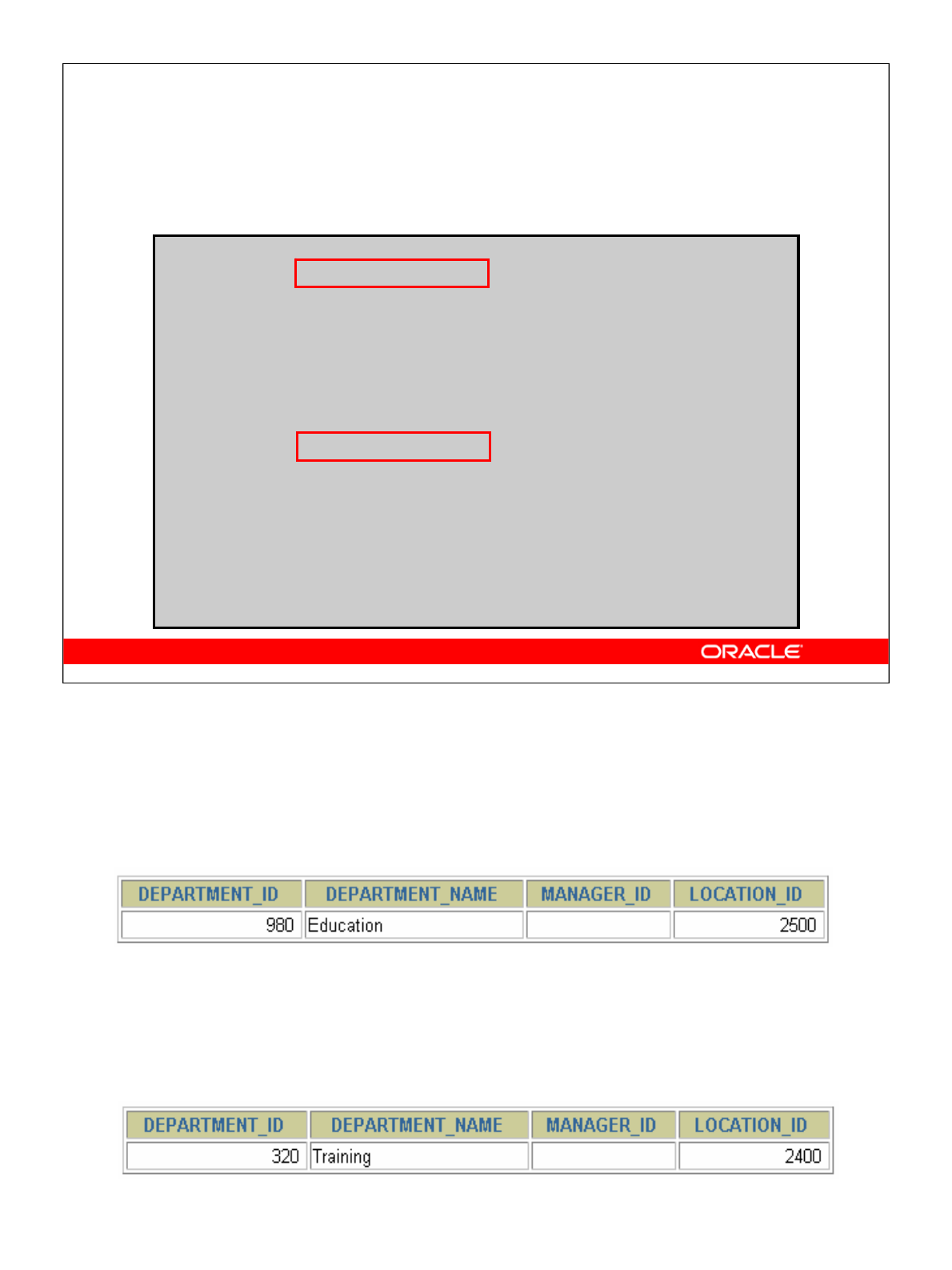
Oracle Database 10g: Develop PL/SQL Program Units 4-6
4-6 Copyright © 2004, Oracle. All rights reserved.
CREATE OR REPLACE PACKAGE BODY dept_pkg IS
PROCEDURE add_department (deptno NUMBER,
name VARCHAR2:='unknown', loc NUMBER:=1700) IS
BEGIN
INSERT INTO departments(department_id,
department_name, location_id)
VALUES (deptno, name, loc);
END add_department;
PROCEDURE add_department (
name VARCHAR2:='unknown', loc NUMBER:=1700) IS
BEGIN
INSERT INTO departments (department_id,
department_name, location_id)
VALUES (departments_seq.NEXTVAL, name, loc);
END add_department;
END dept_pkg;
/
Overloading: Example
Overloading: Example (continued)
If you call add_department with an explicitly provided department ID, then PL/SQL
uses the first version of the procedure. Consider the following example:
EXECUTE dept_pkg.add_department(980,'Education',2500)
SELECT * FROM departments
WHERE department_id = 980;
If you call add_department with no department ID, then PL/SQL uses the second
version:
EXECUTE dept_pkg.add_department ('Training', 2400)
SELECT * FROM departments
WHERE department_name = 'Training';

Oracle Database 10g: Develop PL/SQL Program Units 4-7
4-7 Copyright © 2004, Oracle. All rights reserved.
Overloading and the STANDARD Package
•A package named STANDARD defines the PL/SQL
environment and built-in functions.
•Most built-in functions are overloaded. An
example is the TO_CHAR function:
•A PL/SQL subprogram with the same name as a
built-in subprogram overrides the standard
declaration in the local context, unless you qualify
the built-in subprogram with its package name.
FUNCTION TO_CHAR (p1 DATE) RETURN VARCHAR2;
FUNCTION TO_CHAR (p2 NUMBER) RETURN VARCHAR2;
FUNCTION TO_CHAR (p1 DATE, P2 VARCHAR2) RETURN
VARCHAR2;
FUNCTION TO_CHAR (p1 NUMBER, P2 VARCHAR2) RETURN
VARCHAR2;
Overloading and the STANDARD Package
A package named STANDARD defines the PL/SQL environment and globally declares
types, exceptions, and subprograms that are available automatically to PL/SQL programs.
Most of the built-in functions that are found in the STANDARD package are overloaded.
For example, the TO_CHAR function has four different declarations, as shown in the slide.
The TO_CHAR function can take either the DATE or the NUMBER data type and convert it
to the character data type. The format to which the date or number has to be converted can
also be specified in the function call.
If you redeclare a built-in subprogram in another PL/SQL program, then your local
declaration overrides the standard or built-in subprogram. To be able to access the built-in
subprogram, you must qualify it with its package name. For example, if you redeclare the
TO_CHAR function to access the built-in function, then you refer to it as
STANDARD.TO_CHAR.
If you redeclare a built-in subprogram as a stand-alone subprogram, then to access your
subprogram you must qualify it with your schema name: for example, SCOTT.TO_CHAR.
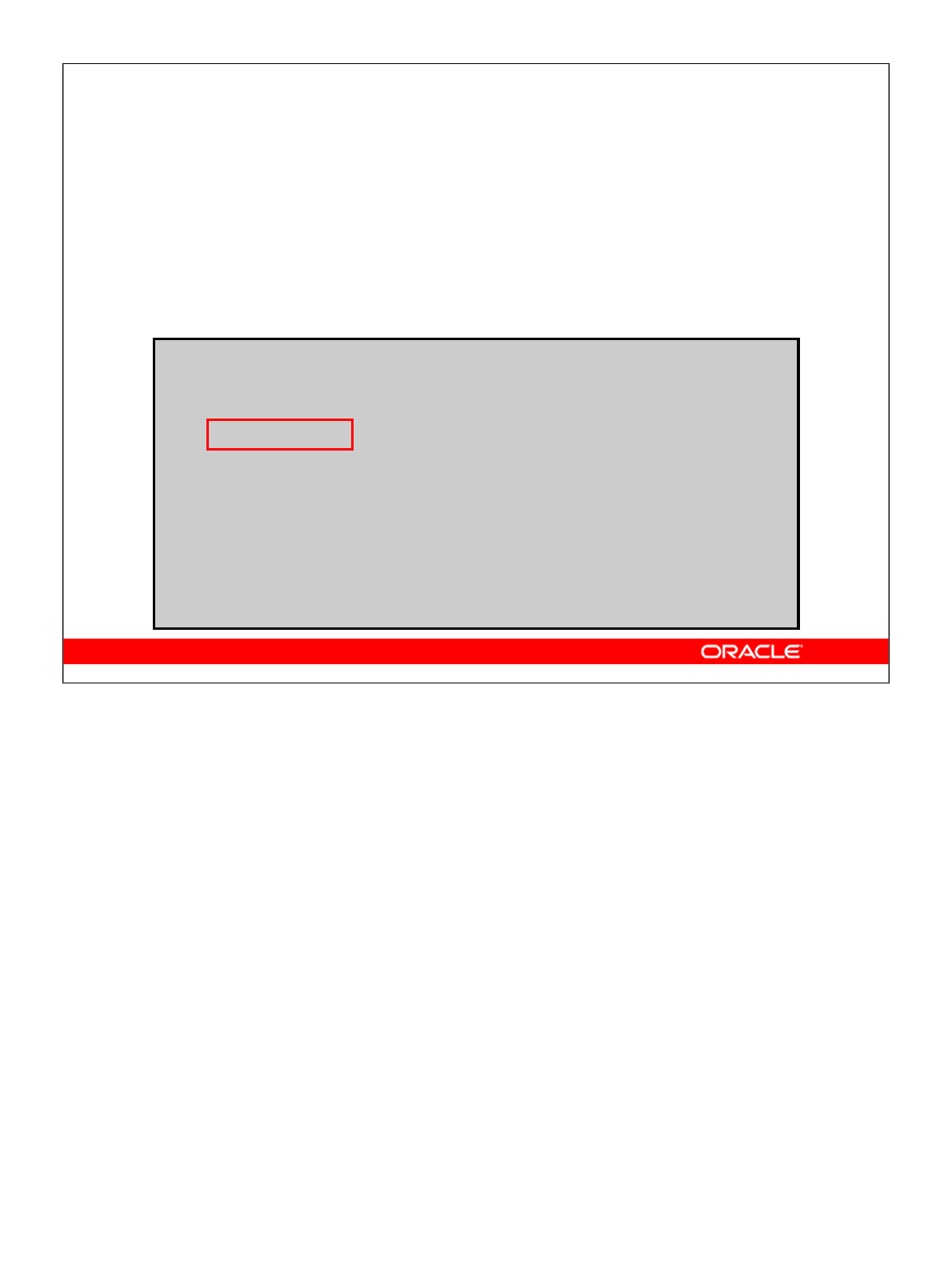
Oracle Database 10g: Develop PL/SQL Program Units 4-8
4-8 Copyright © 2004, Oracle. All rights reserved.
CREATE OR REPLACE PACKAGE BODY forward_pkg IS
PROCEDURE award_bonus(. . .) IS
BEGIN
calc_rating (. . .); --illegal reference
END;
PROCEDURE calc_rating (. . .) IS
BEGIN
...
END;
END forward_pkg;
/
Using Forward Declarations
•Block-structured languages (such as PL/SQL)
must declare identifiers before referencing them.
•Example of a referencing problem:
Using Forward Declarations
In general, PL/SQL is like other block-structured languages and does not allow forward
references. You must declare an identifier before using it. For example, a subprogram
must be declared before you can call it.
Coding standards often require that subprograms be kept in alphabetical sequence to make
them easy to find. In this case, you may encounter problems, as shown in the slide
example, where the calc_rating procedure cannot be referenced because it has not yet
been declared.
You can solve the illegal reference problem by reversing the order of the two procedures.
However, this easy solution does not work if the coding rules require subprograms to be
declared in alphabetical order.
The solution in this case is to use forward declarations provided in PL/SQL. A forward
declaration enables you to declare the heading of a subprogram, that is, the subprogram
specification terminated by a semicolon.
Note: The compilation error for calc_rating occurs only if calc_rating is a
private packaged procedure. If calc_rating is declared in the package specification,
then it is already declared as if it was a forward declaration, and its reference can be
resolved by the compiler.
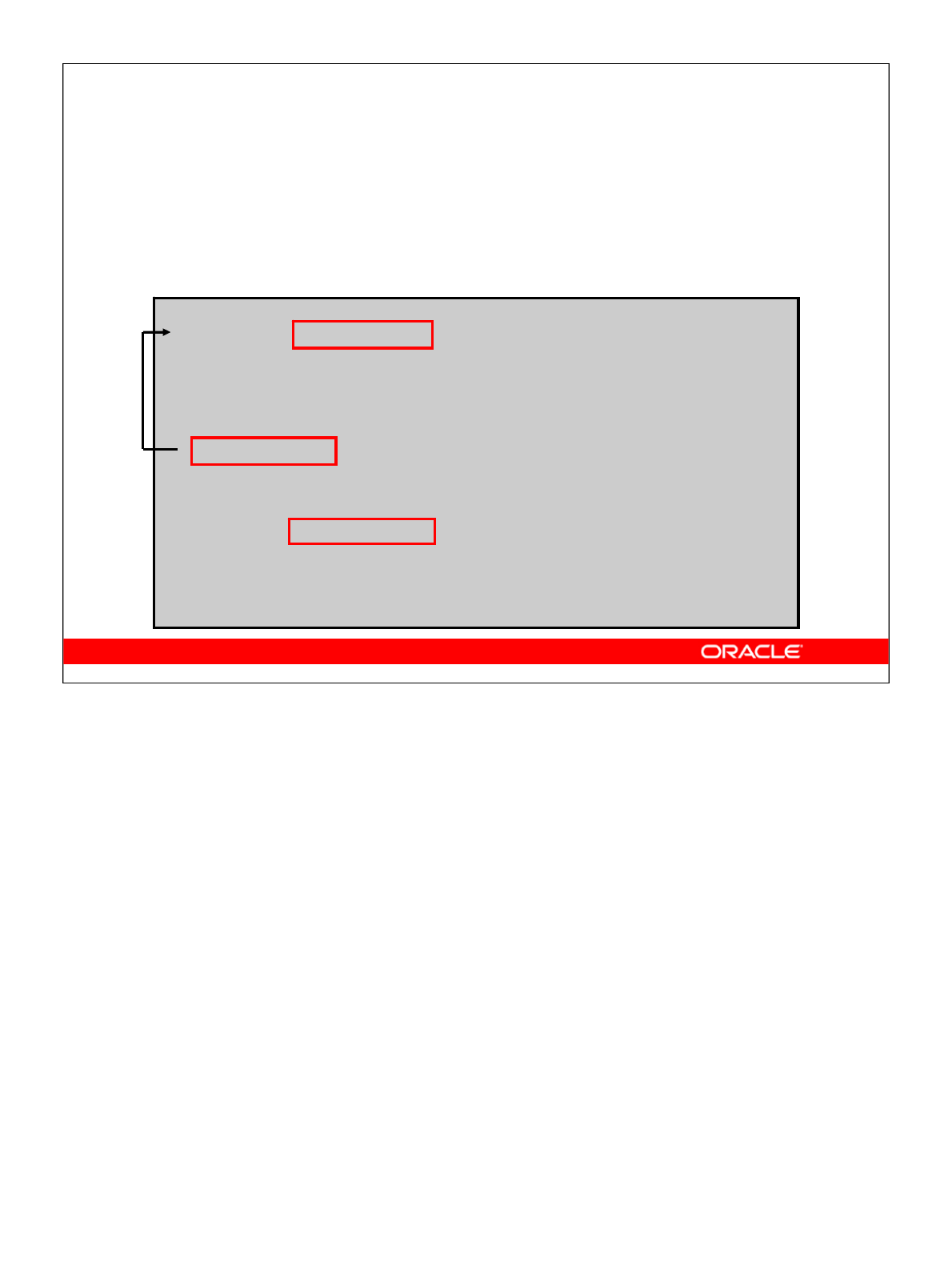
Oracle Database 10g: Develop PL/SQL Program Units 4-9
4-9 Copyright © 2004, Oracle. All rights reserved.
CREATE OR REPLACE PACKAGE BODY forward_pkg IS
PROCEDURE calc_rating (...);-- forward declaration
-- Subprograms defined in alphabetical order
PROCEDURE award_bonus(...) IS
BEGIN
calc_rating (...); -- reference resolved!
. . .
END;
PROCEDURE calc_rating (...) IS -- implementation
BEGIN
. . .
END;
END forward_pkg;
Using Forward Declarations
In the package body, a forward declaration is a private
subprogram specification terminated by a semicolon.
Using Forward Declarations (continued)
As previously mentioned, PL/SQL enables you to create a special subprogram declaration
called a forward declaration. A forward declaration may be required for private
subprograms in the package body, and consists of the subprogram specification terminated
by a semicolon. Forward declarations help to:
• Define subprograms in logical or alphabetical order
• Define mutually recursive subprograms. Mutually recursive programs are programs
that call each other directly or indirectly.
• Group and logically organize subprograms in a package body
When creating a forward declaration:
• The formal parameters must appear in both the forward declaration and the
subprogram body
• The subprogram body can appear anywhere after the forward declaration, but both
must appear in the same program unit
Forward Declarations and Packages
Typically, the subprogram specifications go in the package specification, and the
subprogram bodies go in the package body. The public subprogram declarations in the
package specification do not require forward declarations.
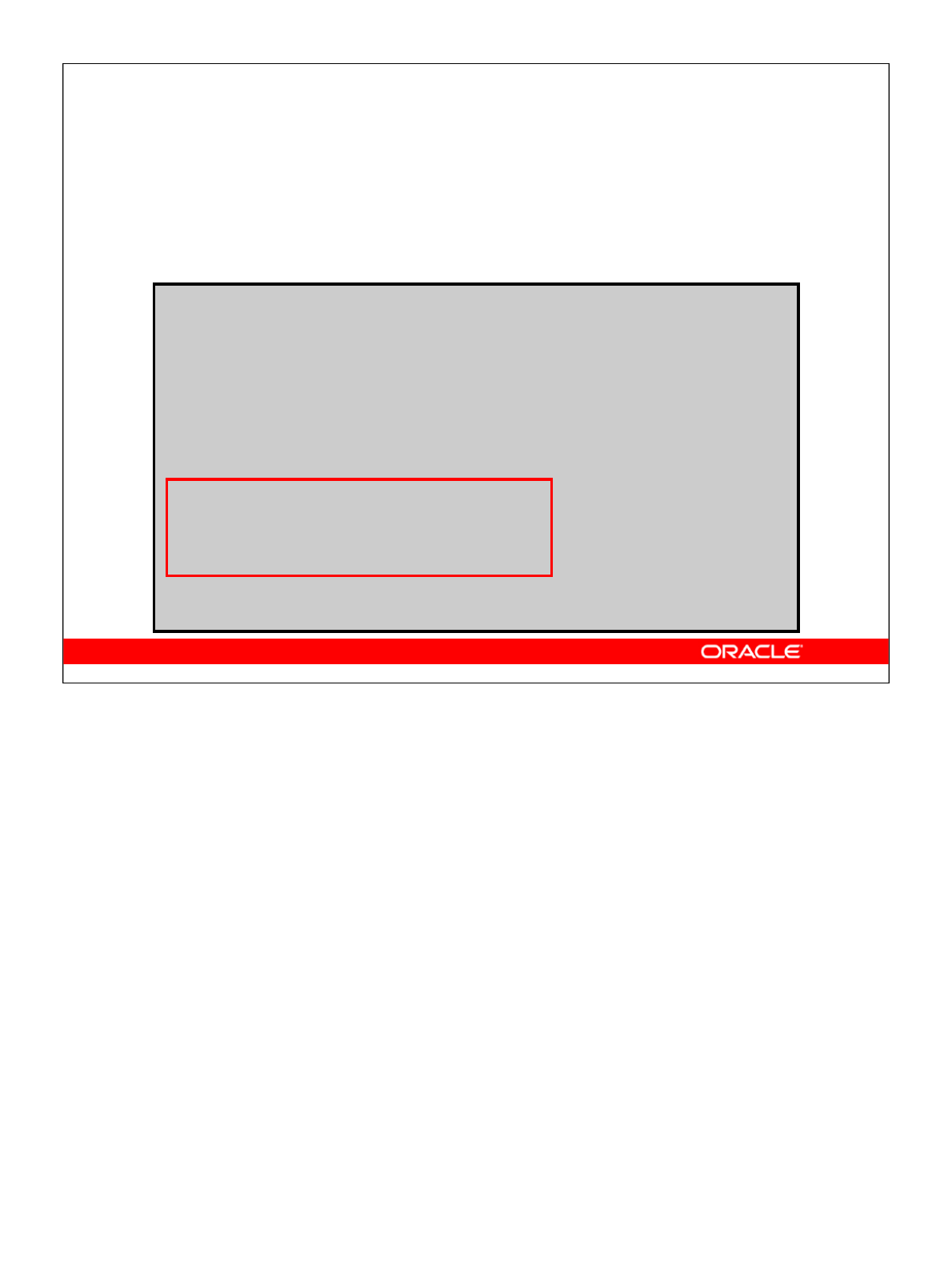
Oracle Database 10g: Develop PL/SQL Program Units 4-10
4-10 Copyright © 2004, Oracle. All rights reserved.
CREATE OR REPLACE PACKAGE taxes IS
tax NUMBER;
... -- declare all public procedures/functions
END taxes;
/
CREATE OR REPLACE PACKAGE BODY taxes IS
... -- declare all private variables
... -- define public/private procedures/functions
BEGIN
SELECT rate_value INTO tax
FROM tax_rates
WHERE rate_name = 'TAX';
END taxes;
/
Package Initialization Block
The block at the end of the package body executes
once and is used to initialize public and private
package variables.
Package Initialization Block
The first time a component in a package is referenced, the entire package is loaded into
memory for the user session. By default, the initial value of variables is NULL (if not
explicitly initialized). To initialize package variables, you can:
• Use assignment operations in their declarations for simple initialization tasks
• Add code block to the end of a package body for more complex initialization tasks
Consider the block of code at the end of a package body as a package initialization block
that executes once, when the package is first invoked within the user session.
The example in the slide shows the tax public variable being initialized to the value in
the tax_rates table the first time the taxes package is referenced.
Note: If you initialize the variable in the declaration by using an assignment operation, it
is overwritten by the code in the initialization block at the end of the package body. The
initialization block is terminated by the END keyword for the package body.

Oracle Database 10g: Develop PL/SQL Program Units 4-11
4-11 Copyright © 2004, Oracle. All rights reserved.
Using Package Functions in SQL and
Restrictions
•Package functions can be used in SQL
statements.
•Functions called from:
–A query or DML statement must not end the current
transaction, create or roll back to a savepoint, or
alter the system or session
–A query or a parallelized DML statement cannot
execute a DML statement or modify the database
–A DML statement cannot read or modify the table
being changed by that DML statement
Note: A function calling subprograms that break
the preceding restrictions is not allowed.
Using Package Functions in SQL and Restrictions
When executing a SQL statement that calls a stored function, the Oracle server must know
the purity level of stored functions, that is, whether the functions are free of the restrictions
listed in the slide. In general, restrictions are changes to database tables or public package
variables (those declared in a package specification). Restrictions can delay the execution
of a query, yield order-dependent (therefore indeterminate) results, or require that the
package state variables be maintained across user sessions. Various restrictions are not
allowed when a function is called from a SQL query or a DML statement. Therefore, the
following restrictions apply to stored functions called from SQL expressions:
• A function called from a query or DML statement cannot end the current transaction,
create or roll back to a savepoint, or alter the system or session.
• A function called from a query statement or from a parallelized DML statement
cannot execute a DML statement or otherwise modify the database.
• A function called from a DML statement cannot read or modify the particular table
being modified by that DML statement.
Note: Prior to Oracle8i, the purity level was checked at compilation time by including
PRAGMA RESTRICT_REFERENCES in the package specification. Since Oracle8i, the
purity level of functions is checked at run time.

Oracle Database 10g: Develop PL/SQL Program Units 4-12
4-12 Copyright © 2004, Oracle. All rights reserved.
CREATE OR REPLACE PACKAGE taxes_pkg IS
FUNCTION tax (value IN NUMBER) RETURN NUMBER;
END taxes_pkg;
/
CREATE OR REPLACE PACKAGE BODY taxes_pkg IS
FUNCTION tax (value IN NUMBER) RETURN NUMBER IS
rate NUMBER := 0.08;
BEGIN
RETURN (value * rate);
END tax;
END taxes_pkg;
/
Package Function in SQL: Example
SELECT taxes_pkg.tax(salary), salary, last_name
FROM employees;
Package Function in SQL: Example
The first code box shows how to create the package specification and the body
encapsulating the tax function in the taxes_pkg package. The second code box shows
how to call the packaged tax function in the SELECT statement. The output results are
similar to:
Note: If you are using Oracle versions prior to 8i, then you must assert the purity level of
the function in the package specification by using PRAGMA RESTRICT_REFERENCES.
If this is not specified, you get an error message saying that the TAX function does not
guarantee that it will not update the database while invoking the package function in a
query.
…

Oracle Database 10g: Develop PL/SQL Program Units 4-13
4-13 Copyright © 2004, Oracle. All rights reserved.
Persistent State of Packages
The collection of package variables and the values
define the package state. The package state is:
•Initialized when the package is first loaded
•Persistent (by default) for the life of the session
–Stored in the User Global Area (UGA)
–Unique to each session
–Subject to change when package subprograms are
called or public variables are modified
•Not persistent for the session, but for the life of a
subprogram call, when using PRAGMA
SERIALLY_REUSABLE in the package specification
Persistent State of Packages
The collection of public and private package variables represents the package state for the
user session. That is, the package state is the set of values stored in all the package
variables at a given point in time. In general, the package state exists for the life of the user
session.
Package variables are initialized the first time a package is loaded into memory for a user
session. The package variables are, by default, unique to each session and hold their values
until the user session is terminated. In other words, the variables are stored in the UGA
memory allocated by the database for each user session.
The package state changes when a package subprogram is invoked and its logic modifies
the variable state. Public package state can be directly modified by operations appropriate
to its type.
Note: If you add PRAGMA SERIALLY_RESUABLE to the package specification, then
the database stores package variables in the System Global Area (SGA) shared across user
sessions. In this case, the package state is maintained for the life of a subprogram call or a
single reference to a package construct. The SERIALLY_REUSABLE directive is useful if
you want to conserve memory and if the package state does not need to persist for each
user session.
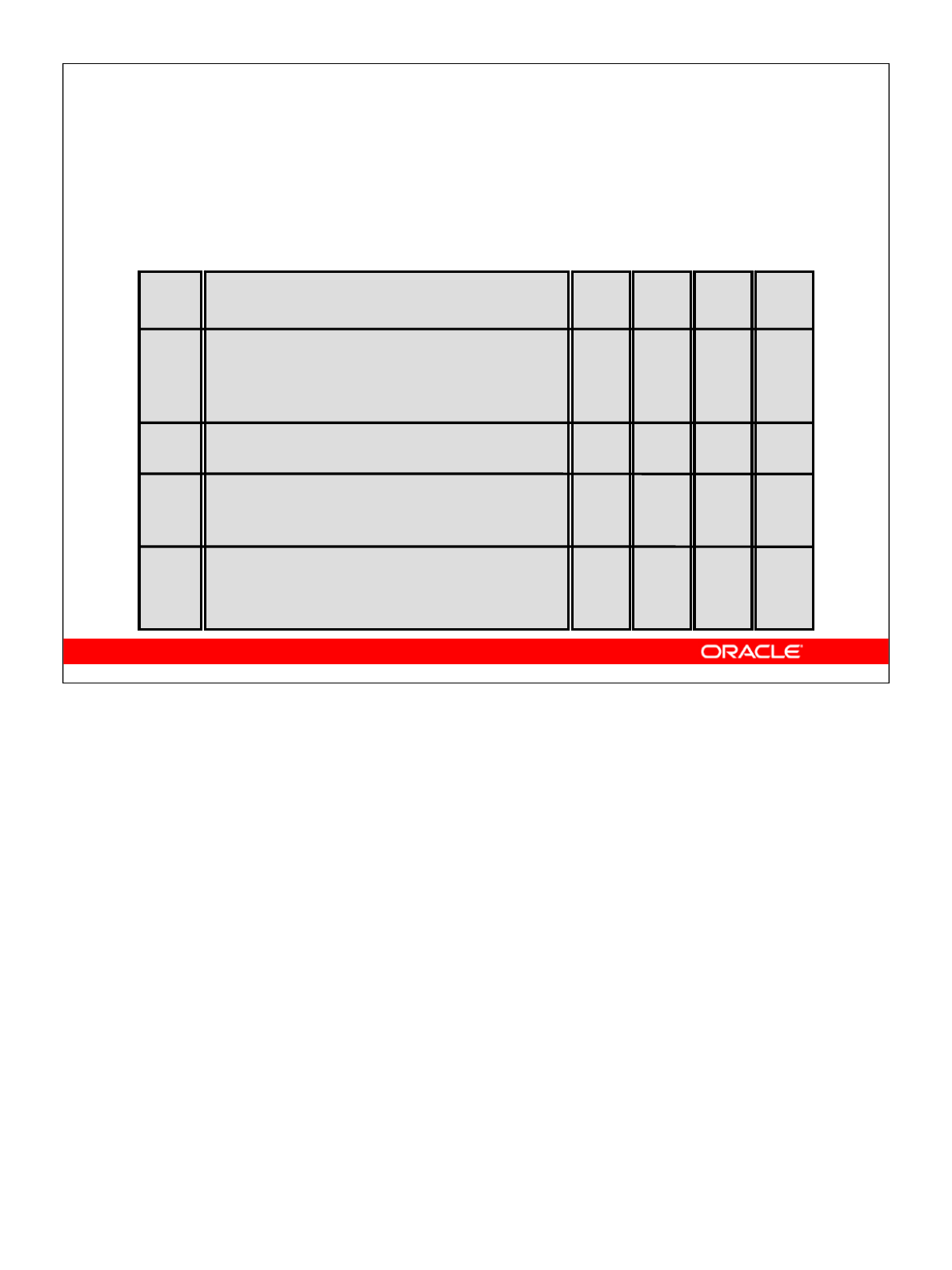
Oracle Database 10g: Develop PL/SQL Program Units 4-14
4-14 Copyright © 2004, Oracle. All rights reserved.
Persistent State of Package
Variables: Example
State for: -Scott- -Jones-
Time Events STD MAX STD MAX
Scott> EXECUTE
comm_pkg.reset_comm(0.25)
Jones> INSERT
INTO employees(
last_name,commission_pct)
VALUES('Madonna', 0.8);
Jones> EXECUTE
comm_pkg.reset_comm (0.5)
Scott> EXECUTE
comm_pkg.reset_comm(0.6)
Err –20210 'Bad Commission'
Jones> ROLLBACK;
EXIT ...
EXEC comm_pkg.reset_comm(0.2)
9:00
9:30
9:35
10:00
11:00
11:01
12:00
0.4
0.4
0.4
0.4
0.4
0.4
0.4
-
0.1
0.5
0.5
0.5
-
0.2
0.4
0.8
0.8
0.8
0.4
0.4
0.4
0.10
0.25
0.25
0.25
0.25
0.25
0.25
0.25
Persistent State of Package Variables: Example
The slide sequence is based on two different users, Scott and Jones, executing comm_pkg
(covered in the lesson titled “Creating Packages”), in which the reset_comm procedure
invokes the validate function to check the new commission. The example shows how
the persistent state of the std_comm package variable is maintained in each user session.
At 9:00: Scott calls reset_comm with a new commission value of 0.25, the package
state for std_comm is initialized to 0.10 and then set to 0.25, which is validated because
it is less than the database maximum value of 0.4.
At 9:30: Jones inserts a new row into the EMPLOYEES table with a new maximum
commission_pct value of 0.8. This is not committed, so it is visible to Jones only.
Scott’s state is unaffected.
At 9:35: Jones calls reset_comm with a new commission value of 0.5. The state for
Jones’s std_comm is first initialized to 0.10 and then set to the new value 0.5 that is valid
for his session with the database maximum value of 0.8.
At 10:00: Scott calls with reset_comm with a new commission value of 0.6, which is
greater than the maximum database commission visible to his session, that is, 0.4 (Jones
did not commit the 0.8 value.)
Between 11:00 and 12:00: Jones rolls back the transaction and exits the session. Jones
logs in at 11:45 and successfully executes the procedure, setting his state to 0.2.
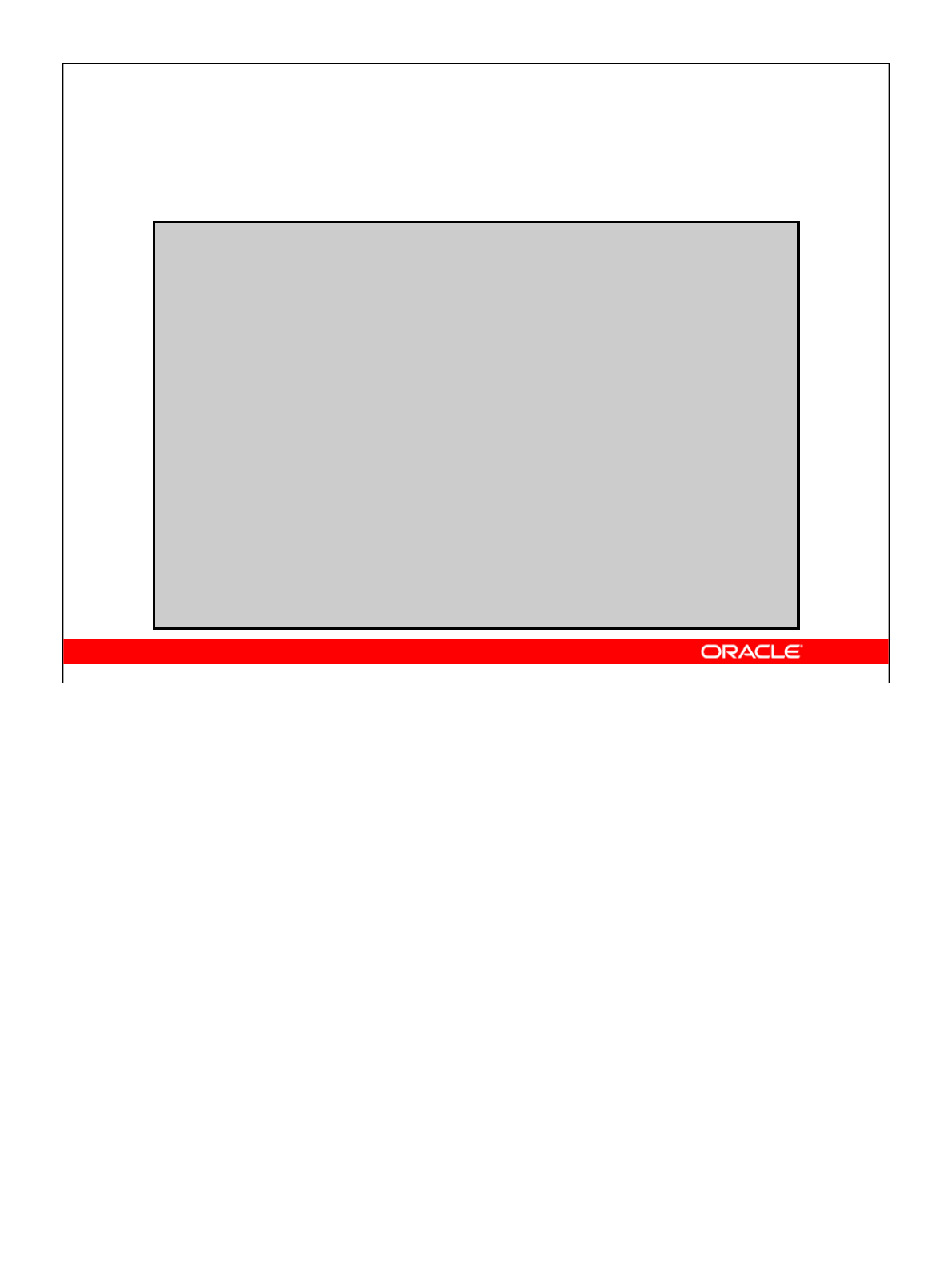
Oracle Database 10g: Develop PL/SQL Program Units 4-15
4-15 Copyright © 2004, Oracle. All rights reserved.
CREATE OR REPLACE PACKAGE BODY curs_pkg IS
CURSOR c IS SELECT employee_id FROM employees;
PROCEDURE open IS
BEGIN
IF NOT c%ISOPEN THEN OPEN c; END IF;
END open;
FUNCTION next(n NUMBER := 1) RETURN BOOLEAN IS
emp_id employees.employee_id%TYPE;
BEGIN
FOR count IN 1 .. n LOOP
FETCH c INTO emp_id;
EXIT WHEN c%NOTFOUND;
DBMS_OUTPUT.PUT_LINE('Id: ' ||(emp_id));
END LOOP;
RETURN c%FOUND;
END next;
PROCEDURE close IS BEGIN
IF c%ISOPEN THEN CLOSE c; END IF;
END close;
END curs_pkg;
Persistent State of a Package Cursor
Persistent State of a Package Cursor
The code in the slide shows the package body for CURS_PKG to support the following
package specification:
CREATE OR REPLACE PACKAGE curs_pkg IS
PROCEDURE open;
FUNCTION next(n NUMBER := 1) RETURN BOOLEAN;
PROCEDURE close;
END curs_pkg;
To use this package, perform the following steps to process the rows:
• Call the open procedure to open the cursor.
• Call the next procedure to fetch one or a specified number of rows. If you request
more rows than actually exist, the procedure successfully handles termination. It
returns TRUE if more rows need to be processed; otherwise it returns FALSE.
• Call the close procedure to close the cursor, before or at the end of processing the
rows.
Note: The cursor declaration is private to the package. Therefore the cursor state can be
influenced by invoking the package procedure and functions listed in the slide.
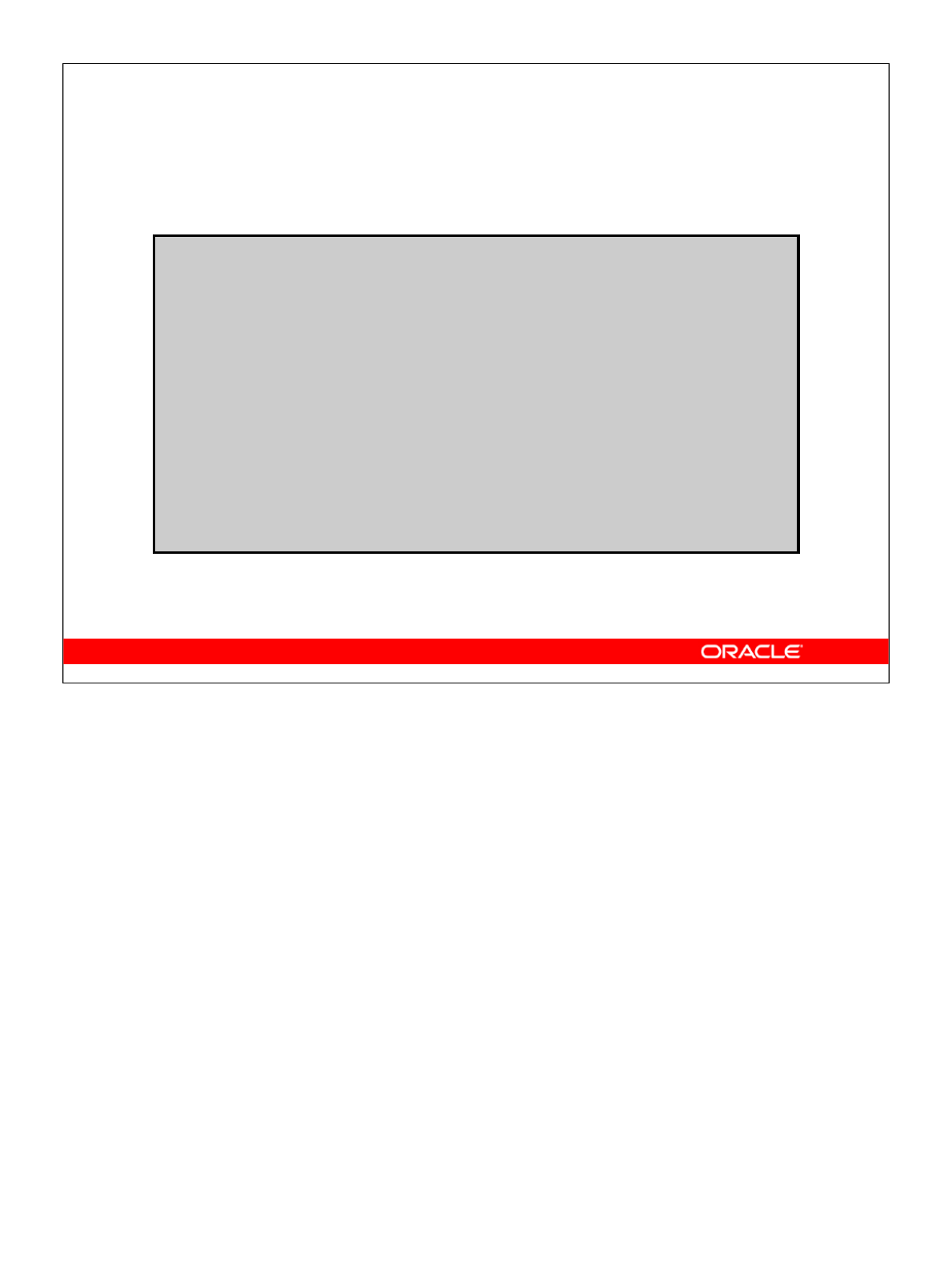
Oracle Database 10g: Develop PL/SQL Program Units 4-16
4-16 Copyright © 2004, Oracle. All rights reserved.
Executing CURS_PKG
SET SERVEROUTPUT ON
EXECUTE curs_pkg.open
DECLARE
more BOOLEAN := curs_pkg.next(3);
BEGIN
IF NOT more THEN
curs_pkg.close;
END IF;
END;
/
RUN -- repeats execution on the anonymous block
EXECUTE curs_pkg.close
Executing CURS_PKG
Recall that the state of a package variable or cursor persists across transactions within a
session. However, the state does not persist across different sessions for the same user. The
database tables hold data that persists across sessions and users. The SET
SERVEROUTPUT ON command prepares iSQL*Plus to display output results. The call to
curs_pkg.open opens the cursor, which remains open until the session is terminated,
or the cursor is explicitly closed. The anonymous block executes the next function in the
Declaration section, initializing the BOOLEAN variable more to TRUE, as there are
more than three rows in the employees table. The block checks for the end of the result set
and closes the cursor, if appropriate. When the block executes, it displays the first three
rows: Id :103
Id :104
Id :105
The RUN command executes the anonymous block again, and the next three rows are
displayed: Id :106
Id :107
Id :108
The EXECUTE curs_pkg.close command closes the cursor in the package.

Oracle Database 10g: Develop PL/SQL Program Units 4-17
4-17 Copyright © 2004, Oracle. All rights reserved.
Using PL/SQL Tables
of Records in Packages
CREATE OR REPLACE PACKAGE BODY emp_pkg IS
PROCEDURE get_employees(emps OUT emp_table_type) IS
i BINARY_INTEGER := 0;
BEGIN
FOR emp_record IN (SELECT * FROM employees)
LOOP
emps(i) := emp_record;
i:= i+1;
END LOOP;
END get_employees;
END emp_pkg;
/
CREATE OR REPLACE PACKAGE emp_pkg IS
TYPE emp_table_type IS TABLE OF employees%ROWTYPE
INDEX BY BINARY_INTEGER;
PROCEDURE get_employees(emps OUT emp_table_type);
END emp_pkg;
/
Using Tables of Records of Procedures or Functions in Packages
The emp_pkg package contains a get_employees procedure that reads rows from the
EMPLOYEES table and returns the rows using the OUT parameter, which is a PL/SQL
table of records. The key points include the following:
•employee_table_type is declared as a public type.
•employee_table_type is used for a formal output parameter in the procedure,
and the employees variable in the calling block (shown below).
In iSQL*Plus, you can invoke the get_employees procedure in an anonymous
PL/SQL block by using the employees variable as shown in the following example:
DECLARE
employees emp_pkg.emp_table_type;
BEGIN
emp_pkg.get_employees(employees);
DBMS_OUTPUT.PUT_LINE('Emp 4:
'||employees(4).last_name);
END;
/
This results in the following output:
Emp 4: Ernst

Oracle Database 10g: Develop PL/SQL Program Units 4-18
4-18 Copyright © 2004, Oracle. All rights reserved.
PL/SQL Wrapper
•The PL/SQL wrapper is a stand-alone utility that
hides application internals by converting PL/SQL
source code into portable object code.
•Wrapping has the following features:
–Platform independence
–Dynamic loading
–Dynamic binding
–Dependency checking
–Normal importing and exporting when invoked
What Is the PL/SQL Wrapper?
The PL/SQL wrapper is a stand-alone utility that converts PL/SQL source code into
portable object code. Using it, you can deliver PL/SQL applications without exposing your
source code, which may contain proprietary algorithms and data structures. The wrapper
converts the readable source code into unreadable code. By hiding application internals, it
prevents misuse of your application.
Wrapped code, such as PL/SQL stored programs, has several features:
• It is platform independent, so you do not need to deliver multiple versions of the
same compilation unit.
• It permits dynamic loading, so users need not shut down and relink to add a new
feature.
• It permits dynamic binding, so external references are resolved at load time.
• It offers strict dependency checking, so that invalidated program units are recompiled
automatically when they are invoked.
• It supports normal importing and exporting, so the import/export utility can process
wrapped files.

Oracle Database 10g: Develop PL/SQL Program Units 4-19
4-19 Copyright © 2004, Oracle. All rights reserved.
Running the Wrapper
The command-line syntax is:
•The INAME argument is required.
•The default extension for the input file is .sql,
unless it is specified with the name.
•The ONAME argument is optional.
•The default extension for output file is .plb,
unless specified with the ONAME argument.
Examples:
WRAP INAME=input_file_name [ONAME=output_file_name]
WRAP INAME=student.sql
WRAP INAME=student
WRAP INAME=student.sql ONAME=student.plb
Running the Wrapper
The wrapper is an operating system executable called WRAP. To run the wrapper, enter the
following command at your operating system prompt:
WRAP INAME=input_file_name [ONAME=output_file_name]
Each of the examples shown in the slide takes a file called student.sql as input and
creates an output file called student.plb.
After the wrapped file is created, execute the .plb file from iSQL*Plus to compile and
store the wrapped version of the source code, as you would execute SQL script files.
Note
• Only the INAME argument is required. If the ONAME argument is not specified, then
the output file acquires the same name as the input file with an extension of .plb.
• Do not put spaces around the equal signs in the command-line arguments.
• The input file can have any extension, but the default is .sql.
• Case sensitivity of the INAME and ONAME values depends on the operating system.
• Generally, the output file is much larger than the input file.
• Do not put spaces around the equal signs in the INAME and ONAME arguments and
values.

Oracle Database 10g: Develop PL/SQL Program Units 4-20
4-20 Copyright © 2004, Oracle. All rights reserved.
Results of Wrapping
•Original PL/SQL source code in input file:
•Wrapped code in output file:
CREATE PACKAGE banking IS
min_bal := 100;
no_funds EXCEPTION;
...
END banking;
/
CREATE PACKAGE banking
wrapped
012abc463e ...
/
Results of Wrapping
When it is wrapped, an object type, package, or subprogram has this form: header,
followed by the word wrapped, followed by the encrypted body.
The input file can contain any combination of SQL statements. However, the PL/SQL
wrapper wraps only the following CREATE statements:
•CREATE [OR REPLACE] TYPE
•CREATE [OR REPLACE] TYPE BODY
•CREATE [OR REPLACE] PACKAGE
•CREATE [OR REPLACE] PACKAGE BODY
•CREATE [OR REPLACE] FUNCTION
•CREATE [OR REPLACE] PROCEDURE
All other SQL CREATE statements are passed intact to the output file.

Oracle Database 10g: Develop PL/SQL Program Units 4-21
4-21 Copyright © 2004, Oracle. All rights reserved.
Guidelines for Wrapping
•You must wrap only the package body, not the
package specification.
•The wrapper can detect syntactic errors but
cannot detect semantic errors.
•The output file should not be edited. You maintain
the original source code and wrap again as
required.
Guidelines for Wrapping
Guidelines include the following:
• When wrapping a package or object type, wrap only the body, not the specification.
Thus, you give other developers the information they need to use the package
without exposing its implementation.
• If your input file contains syntactic errors, the PL/SQL wrapper detects and reports
them. However, the wrapper cannot detect semantic errors because it does not
resolve external references. For example, the wrapper does not report an error if the
table or view amp does not exist:
CREATE PROCEDURE raise_salary (emp_id INTEGER, amount
NUMBER) AS
BEGIN
UPDATE amp -- should be emp
SET sal = sal + amount WHERE empno = emp_id;
END;
However, the PL/SQL compiler resolves external references. Therefore, semantic
errors are reported when the wrapper output file (.plb file) is compiled.
• The output file should not be edited, because its contents are not readable. To change
a wrapped object, you need to modify the original source code and wrap the code
again.

Oracle Database 10g: Develop PL/SQL Program Units 4-22
4-22 Copyright © 2004, Oracle. All rights reserved.
Summary
In this lesson, you should have learned how to:
•Create and call overloaded subprograms
•Use forward declarations for subprograms
•Write package initialization blocks
•Maintain persistent package state
•Use the PL/SQL wrapper to wrap code
Summary
Overloading is a feature that enables you to define different subprograms with the same
name. It is logical to give two subprograms the same name when the processing in both the
subprograms is the same but the parameters passed to them vary.
PL/SQL allows for a special subprogram declaration called a forward declaration. A
forward declaration enables you to define subprograms in logical or alphabetical order,
define mutually recursive subprograms, and group subprograms in a package.
A package initialization block is executed only when the package is first invoked within
the other user session. You can use this feature to initialize variables only once per session.
You can keep track of the state of a package variable or cursor, which persists throughout
the user session, from the time the user first references the variable or cursor to the time
the user disconnects.
Using the PL/SQL wrapper, you can obscure the source code stored in the database to
protect your intellectual property.

Oracle Database 10g: Develop PL/SQL Program Units 4-23
4-23 Copyright © 2004, Oracle. All rights reserved.
Practice 4: Overview
This practice covers the following topics:
•Using overloaded subprograms
•Creating a package initialization block
•Using a forward declaration
•Using the WRAP utility to prevent the source code
from being deciphered by humans
Practice 4: Overview
In this practice, you modify an existing package to contain overloaded subprograms, and
you use forward declarations. You also create a package initialization block within a
package body to populate a PL/SQL table. You use the WRAP command-line utility to
prevent the source code from being readable in the data dictionary tables.

Oracle Database 10g: Develop PL/SQL Program Units 4-24
Practice 4
1. Copy and modify the code for the EMP_PKG package that you created in Practice 3,
Exercise 2, and overload the ADD_EMPLOYEE procedure.
a. In the package specification, add a new procedure called ADD_EMPLOYEE that
accepts three parameters: the first name, last name, and department ID. Save and
compile the changes.
b. Implement the new ADD_EMPLOYEE procedure in the package body so that it
formats the e-mail address in uppercase characters, using the first letter of the first
name concatenated with the first seven letters of the last name. The procedure should
call the existing ADD_EMPLOYEE procedure to perform the actual INSERT
operation using its parameters and formatted e-mail to supply the values. Save and
compile the changes.
c. Invoke the new ADD_EMPLOYEE procedure using the name Samuel Joplin to
be added to department 30.
2. In the EMP_PKG package, create two overloaded functions called GET_EMPLOYEE.
a. In the specification, add a GET_EMPLOYEE function that accepts the parameter
called emp_id based on the employees.employee_id%TYPE type, and a
second GET_EMPLOYEE function that accepts the parameter called family_name
of type employees.last_name%TYPE. Both functions should return an
EMPLOYEES%ROWTYPE. Save and compile the changes.
b. In the package body, implement the first GET_EMPLOYEE function to query an
employee by his or her ID, and the second to use the equality operator on the value
supplied in the family_name parameter. Save and compile the changes.
c. Add a utility procedure PRINT_EMPLOYEE to the package that accepts an
EMPLOYEES%ROWTYPE as a parameter and displays the department_id,
employee_id, first_name, last_name, job_id, and salary for an
employee on one line, using DBMS_OUTPUT. Save and compile the changes.
d. Use an anonymous block to invoke the EMP_PKG.GET_EMPLOYEE function with
an employee ID of 100 and family name of 'Joplin'. Use the
PRINT_EMPLOYEE procedure to display the results for each row returned.
3. Because the company does not frequently change its departmental data, you improve
performance of your EMP_PKG by adding a public procedure INIT_DEPARTMENTS to
populate a private PL/SQL table of valid department IDs. Modify the VALID_DEPTID
function to use the private PL/SQL table contents to validate department ID values.
a. In the package specification, create a procedure called INIT_DEPARTMENTS with
no parameters.
b. In the package body, implement the INIT_DEPARTMENTS procedure to store all
department IDs in a private PL/SQL index-by table named valid_departments
containing BOOLEAN values. Use the department_id column value as the index
to create the entry in the index-by table to indicate its presence, and assign the entry
a value of TRUE. Declare the valid_departments variable and its type
definition boolean_tabtype before all procedures in the body.

Oracle Database 10g: Develop PL/SQL Program Units 4-25
Practice 4 (continued)
c. In the body, create an initialization block that calls the INIT_DEPARTMENTS
procedure to initialize the table. Save and compile the changes.
4. Change VALID_DEPTID validation processing to use the private PL/SQL table of
department IDs.
a. Modify VALID_DEPTID to perform its validation by using the PL/SQL table of
department ID values. Save and compile the changes.
b. Test your code by calling ADD_EMPLOYEE using the name James Bond in
department 15. What happens?
c. Insert a new department with ID 15 and name Security, and commit the changes.
d. Test your code again, by calling ADD_EMPLOYEE using the name James Bond in
department 15. What happens?
e. Execute the EMP_PKG.INIT_DEPARTMENTS procedure to update the internal
PL/SQL table with the latest departmental data.
f. Test your code by calling ADD_EMPLOYEE using the employee name James
Bond, who works in department 15. What happens?
g. Delete employee James Bond and department 15 from their respective tables,
commit the changes, and refresh the department data by invoking the
EMP_PKG.INIT_DEPARTMENTS procedure.
5. Reorganize the subprograms in the package specification and the body so that they are in
alphabetical sequence.
a. Edit the package specification and reorganize subprograms alphabetically. In
iSQL*Plus, load and compile the package specification. What happens?
b. Edit the package body and reorganize all subprograms alphabetically. In iSQL*Plus,
load and compile the package specification. What happens?
c. Fix the compilation error using a forward declaration in the body for the offending
subprogram reference. Load and re-create the package body. What happens?
If you have time, complete the following exercise:
6. Wrap the EMP_PKG package body and re-create it.
a. Query the data dictionary to view the source for the EMP_PKG body.
b. Start a command window and execute the WRAP command-line utility to wrap the
body of the EMP_PKG package. Give the output file name a .plb extension.
Hint: Copy the file (which you saved in step 5c) containing the package body to a
file called emp_pkb_b.sql.
c. Using iSQL*Plus, load and execute the .plb file containing the wrapped source.
d. Query the data dictionary to display the source for the EMP_PKG package body
again. Are the original source code lines readable?

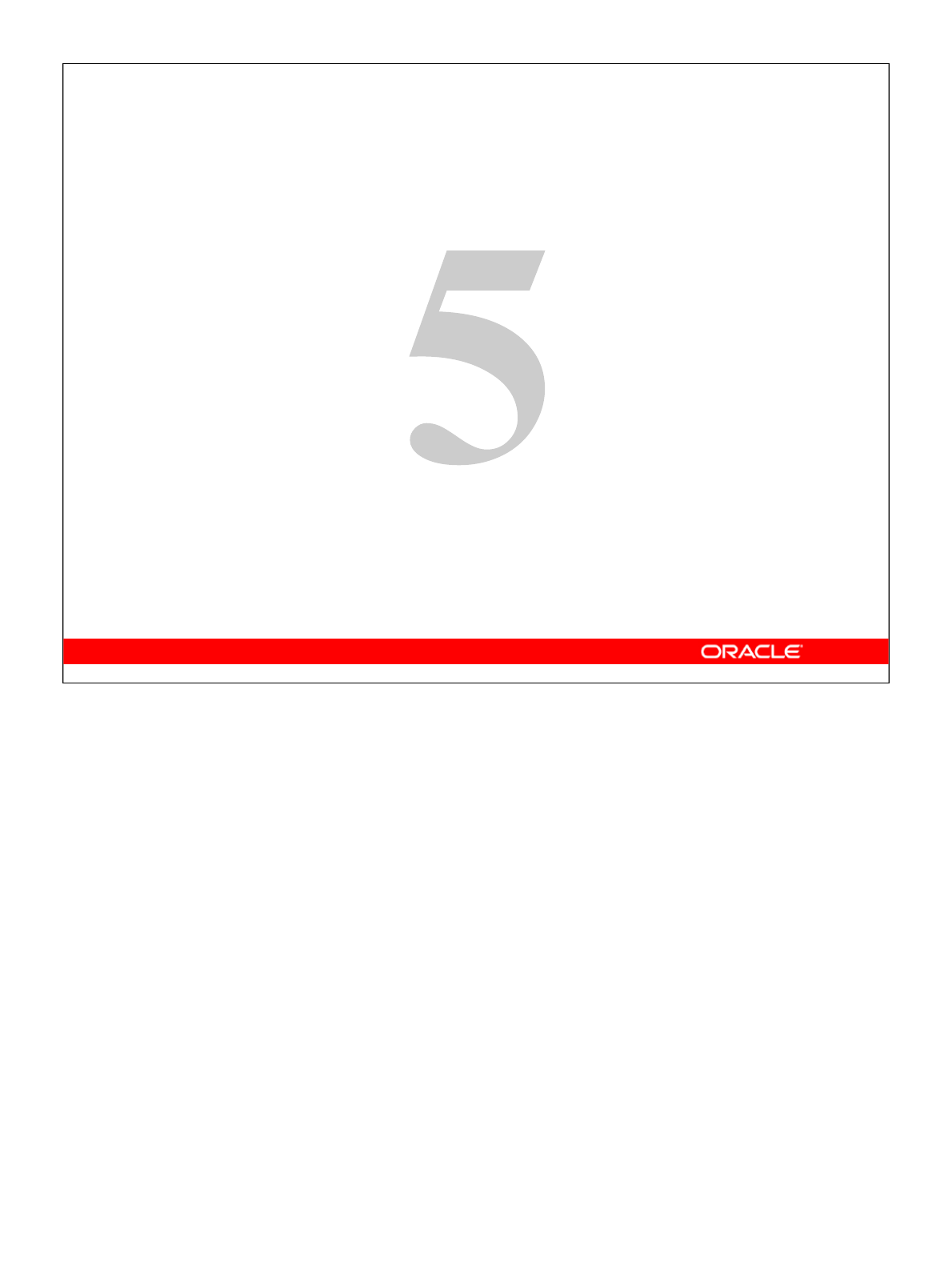
Copyright © 2004, Oracle. All rights reserved.
Utilizing Oracle-Supplied Packages
in Application Development

Oracle Database 10g: Develop PL/SQL Program Units 5-2
5-2 Copyright © 2004, Oracle. All rights reserved.
Objectives
After completing this lesson, you should be able to do
the following:
•Describe how the DBMS_OUTPUT package works
•Use UTL_FILE to direct output to operating
system files
•Use the HTP package to generate a simple Web
page
•Describe the main features of UTL_MAIL
•Call the DBMS_SCHEDULER package to schedule
PL/SQL code for execution
Lesson Aim
In this lesson, you learn how to use some of the Oracle-supplied packages and their
capabilities. This lesson focuses on the packages that generate text- or Web-based output,
e-mail processing, and the provided scheduling capabilities.

Oracle Database 10g: Develop PL/SQL Program Units 5-3
5-3 Copyright © 2004, Oracle. All rights reserved.
Using Oracle-Supplied Packages
The Oracle-supplied packages:
•Are provided with the Oracle server
•Extend the functionality of the database
•Enable access to certain SQL features that are
normally restricted for PL/SQL
For example, the DBMS_OUTPUT package was originally
designed to debug PL/SQL programs.
Using Oracle-Supplied Packages
Packages are provided with the Oracle server to allow either of the following:
• PL/SQL access to certain SQL features
• The extension of the functionality of the database
You can use the functionality provided by these packages when creating your application,
or you may simply want to use these packages as ideas when you create your own stored
procedures.
Most of the standard packages are created by running catproc.sql. The
DBMS_OUTPUT package is the one that you will be most familiar with during this course.
You should know about this package if you attended the Oracle Database 10g: PL/SQL
Fundamentals course.

Oracle Database 10g: Develop PL/SQL Program Units 5-4
5-4 Copyright © 2004, Oracle. All rights reserved.
List of Some Oracle-Supplied Packages
Here is an abbreviated list of some Oracle-supplied
packages:
•DBMS_ALERT
•DBMS_LOCK
•DBMS_SESSION
•DBMS_OUTPUT
•HTP
•UTL_FILE
•UTL_MAIL
•DBMS_SCHEDULER
List of Some Oracle-Supplied Packages
The list of PL/SQL packages provided with an Oracle database grows with the release of
new versions. It would be impossible to cover the exhaustive set of packages and their
functionality in this course. For more information, refer to the PL/SQL Packages and
Types Reference 10g manual (previously known as the PL/SQL Supplied Packages
Reference). This lesson covers the last five packages in this list.
The following is a brief description of all listed packages:
• The DBMS_ALERT package supports asynchronous notification of database events.
Messages or alerts are sent on a COMMIT command.
• The DBMS_LOCK package is used to request, convert, and release locks through
Oracle Lock Management services.
• The DBMS_SESSION package enables programmatic use of the ALTER SESSION
SQL statement and other session-level commands.
• The DBMS_OUTPUT package provides debugging and buffering of text data.
• The HTP package writes HTML-tagged data into database buffers.
• The UTL_FILE package enables reading and writing of operating system text files.
• The UTL_MAIL package enables composing and sending of e-mail messages.
• The DBMS_SCHEDULER package enables scheduling and automated execution of
PL/SQL blocks, stored procedures, and external procedures or executables.

Oracle Database 10g: Develop PL/SQL Program Units 5-5
5-5 Copyright © 2004, Oracle. All rights reserved.
How the DBMS_OUTPUT Package Works
The DBMS_OUTPUT package enables you to send
messages from stored subprograms and triggers.
•PUT and PUT_LINE place text in the buffer.
•GET_LINE and GET_LINES read the buffer.
•Messages are not sent until the sender completes.
•Use SET SERVEROUTPUT ON to display messages
in iSQL*Plus.
PUT_LINE
GET_LINE
PUT
NEW_LINE
GET_LINES
SET SERVEROUT ON [SIZE n]
EXEC proc Buffer
Output
Using the DBMS_OUTPUT Package
The DBMS_OUTPUT package sends textual messages from any PL/SQL block into a
buffer in the database. Procedures provided by the package include:
•PUT to append text from the procedure to the current line of the line output buffer
•NEW_LINE to place an end-of-line marker in the output buffer
•PUT_LINE to combine the action of PUT and NEW_LINE; to trim leadings spaces
•GET_LINE to retrieve the current line from the buffer into a procedure variable
•GET_LINES to retrieve an array of lines into a procedure-array variable
•ENABLE/DISABLE to enable or disable calls to the DBMS_OUTPUT procedures
The buffer size can be set by using:
• The SIZE n option appended to the SET SERVEROUTPUT ON command, where
nis between 2,000 (the default) and 1,000,000 (1 million characters)
• An integer parameter between 2,000 and 1,000,000 in the ENABLE procedure
Practical Uses
• You can output results to the window for debugging purposes.
• You can trace code execution path for a function or procedure.
• You can send messages between subprograms and triggers.
Note: There is no mechanism to flush output during the execution of a procedure.
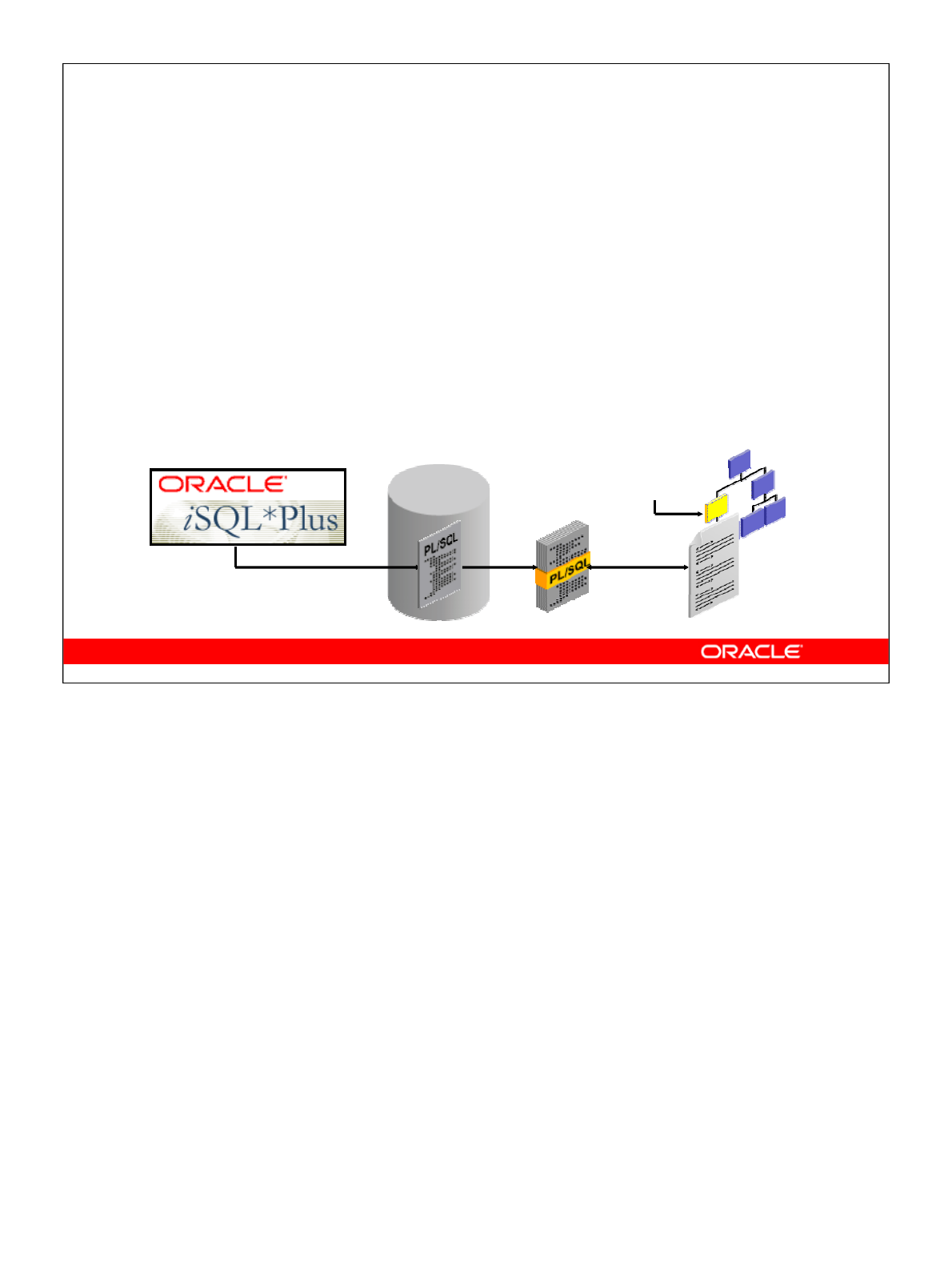
Oracle Database 10g: Develop PL/SQL Program Units 5-6
5-6 Copyright © 2004, Oracle. All rights reserved.
Interacting with Operating System Files
The UTL_FILE package extends PL/SQL programs to
read and write operating system text files. UTL_FILE:
•Provides a restricted version of operating system
stream file I/O for text files
•Can access files in operating system directories
defined by a CREATE DIRECTORY statement. You
can also use the utl_file_dir database
parameter.
EXEC proc
O/S file
UTL_FILE
CREATE DIRECTORY
my_dir AS '/dir'
Interacting with Operating System Files
The Oracle-supplied UTL_FILE package is used to access text files in the operating
system of the database server. The database provides read and write access to specific
operating system directories by using:
•A CREATE DIRECTORY statement that associates an alias with an operating system
directory. The database directory alias can be granted the READ and WRITE
privileges to control the type of access to files in the operating system. For example:
CREATE DIRECTORY my_dir AS '/temp/my_files';
GRANT READ, WRITE ON my_dir TO public.
• The paths specified in the utl_file_dir database initialization parameter
The preferred approach is to use the directory alias created by the CREATE DIRECTORY
statement, which does not require the database to be restarted. The operating system
directories specified by using either of these techniques should be accessible to and on the
same machine as the database server processes. The path (directory) names may be case
sensitive for some operating systems.
Note: The DBMS_LOB package can be used to read binary files on the operating system.
DBMS_LOB is covered in the lesson titled “Manipulating Large Objects.”

Oracle Database 10g: Develop PL/SQL Program Units 5-7
5-7 Copyright © 2004, Oracle. All rights reserved.
Yes
No
Close the
text file
File Processing Using the
UTL_FILE Package
•Reading a file
•Writing or appending to a file
Get lines from
the text file
Put lines into
the text file
Open for
reading
Open for
write/append
More to
read?
Yes
No
More to
write?
f:=FOPEN(dir,file,'r')
f:=FOPEN(dir,file,'w')
f:=FOPEN(dir,file,'a')
GET_LINE(f,buf,len)
PUT(f,buf)
PUT_LINE(f,buf) FCLOSE(f)
File Processing Using the UTL_FILE Package
Using the procedures and functions in the UTL_FILE package, open files with the FOPEN
function. You then either read from or write or append to the file until processing is done.
After completing processing the file, close the file by using the FCLOSE procedure. The
following are the subprograms:
• The FOPEN function opens a file in a specified directory for input/output (I/O) and
returns a file handle used in subsequent I/O operations.
• The IS_OPEN function returns a Boolean value whenever a file handle refers to an
open file. Use IS_OPEN to check if the file is already open before opening the file.
• The GET_LINE procedure reads a line of text from the file into an output buffer
parameter. (The maximum input record size is 1,023 bytes unless you specify a
larger size in the overloaded version of FOPEN.)
• The PUT and PUT_LINE procedures write text to the opened file.
• The PUTF procedure provides formatted output with two format specifiers: %s to
substitute a value into the output string and \n for a new line character.
• The NEW_LINE procedure terminates a line in an output file.
• The FFLUSH procedure writes all data buffered in memory to a file.
• The FCLOSE procedure closes an opened file.
• The FCLOSE_ALL procedure closes all opened file handles for the session.

Oracle Database 10g: Develop PL/SQL Program Units 5-8
5-8 Copyright © 2004, Oracle. All rights reserved.
Exceptions in the UTL_FILE Package
You may have to handle one of these exceptions when
using UTL_FILE subprograms:
•INVALID_PATH
•INVALID_MODE
•INVALID_FILEHANDLE
•INVALID_OPERATION
•READ_ERROR
•WRITE_ERROR
•INTERNAL_ERROR
The other exception not in the UTL_FILE package is:
•NO_DATA_FOUND and VALUE_ERROR
Exceptions in the UTL_FILE Package
The UTL_FILE package declares seven exceptions that indicate an error condition in the
operating system file processing. The UTL_FILE exceptions are:
•INVALID_PATH if the file location or file name was invalid
•INVALID_MODE if the OPEN_MODE parameter in FOPEN was invalid
•INVALID_FILEHANDLE if the file handle was invalid
•INVALID_OPERATION if the file could not be opened or operated on as requested
•READ_ERROR if an operating system error occurred during the read operation
•WRITE_ERROR if an operating system error occurred during the write operation
•INTERNAL_ERROR if an unspecified error occurred in PL/SQL
Note: These exceptions must always be prefaced with the package name. UTL_FILE
procedures can also raise predefined PL/SQL exceptions such as NO_DATA_FOUND or
VALUE_ERROR.
The NO_DATA_FOUND exception is raised when reading past the end of a file by using
UTL_FILE.GET_LINE or UTL_FILE.GET_LINES.

Oracle Database 10g: Develop PL/SQL Program Units 5-9
5-9 Copyright © 2004, Oracle. All rights reserved.
FUNCTION FOPEN (location IN VARCHAR2,
filename IN VARCHAR2,
open_mode IN VARCHAR2)
RETURN UTL_FILE.FILE_TYPE;
FUNCTION IS_OPEN (file IN FILE_TYPE)
RETURN BOOLEAN;
FOPEN and IS_OPEN Function Parameters
Example:
PROCEDURE read(dir VARCHAR2, filename VARCHAR2) IS
file UTL_FILE.FILE_TYPE;
BEGIN
IF NOT UTL_FILE.IS_OPEN(file) THEN
file := UTL_FILE.FOPEN (dir, filename, 'r');
END IF; ...
END read;
FOPEN and IS_OPEN Function Parameters
The parameters include the following:
•location parameter: Specifies the name of a directory alias defined by a CREATE
DIRECTORY statement, or an operating system–specific path specified by using the
utl_file_dir database parameter
•filename parameter: Specifies the name of the file, including the extension,
without any path information
•open_mode string: Specifies how the file is to be opened. Values are:
'r' for reading text (use GET_LINE)
'w' for writing text (PUT, PUT_LINE, NEW_LINE, PUTF, FFLUSH)
'a' for appending text (PUT, PUT_LINE, NEW_LINE, PUTF, FFLUSH)
The return value from FOPEN is a file handle whose type is UTL_FILE.FILE_TYPE.
The handle must be used on subsequent calls to routines that operate on the opened file.
The IS_OPEN function parameter is the file handle. The IS_OPEN function tests a file
handle to see if it identifies an opened file. It returns a Boolean value of TRUE if the file
has been opened; otherwise it returns a value of FALSE indicating that the file has not
been opened. The slide example shows how to combine the use of the two subprograms.
Note: For the full syntax, refer to PL/SQL Packages and Types Reference 10g.
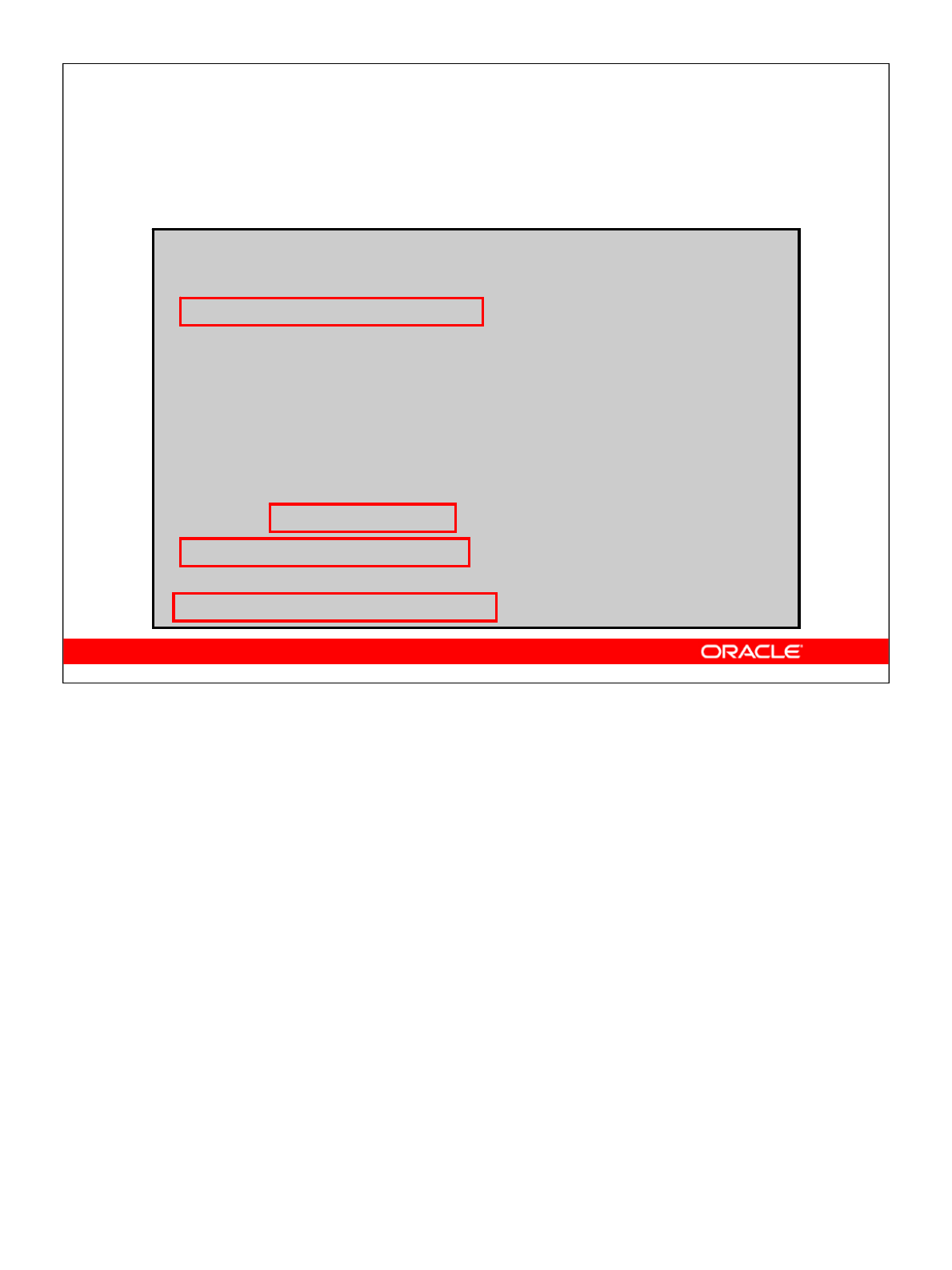
Oracle Database 10g: Develop PL/SQL Program Units 5-10
5-10 Copyright © 2004, Oracle. All rights reserved.
CREATE OR REPLACE PROCEDURE sal_status(
dir IN VARCHAR2, filename IN VARCHAR2) IS
file UTL_FILE.FILE_TYPE;
CURSOR empc IS
SELECT last_name, salary, department_id
FROM employees ORDER BY department_id;
newdeptno employees.department_id%TYPE;
olddeptno employees.department_id%TYPE := 0;
BEGIN
file:= UTL_FILE.FOPEN (dir, filename, 'w');
UTL_FILE.PUT_LINE(file,
'REPORT: GENERATED ON ' || SYSDATE);
UTL_FILE.NEW_LINE (file); ...
Using UTL_FILE: Example
Using UTL_FILE: Example
In the example, the sal_status procedure creates a report of employees for each
department, along with their salaries. The data is written to a text file by using the
UTL_FILE package. In the code example, the variable file is declared as
UTL_FILE.FILE_TYPE, a package type that is a record with a field called ID of the
BINARY_INTEGER data type. For example:
TYPE file_type IS RECORD (id BINARY_INTEGER);
The field of FILE_TYPE record is private to the UTL_FILE package and should never
be referenced or changed. The sal_status procedure accepts two parameters:
• The dir parameter for the name of the directory in which to write the text file
• The filename parameter to specify the name of the file
For example, to call the procedure, use:
EXECUTE sal_status('MY_DIR', 'salreport.txt')
Note: The directory location used (MY_DIR) must be in uppercase characters if it is a
directory alias created by a CREATE DIRECTORY statement. When reading a file in a
loop, the loop should exit when it detects the NO_DATA_FOUND exception. The
UTL_FILE output is sent synchronously. DBMS_OUTPUT procedures do not produce
output until the procedure is completed.
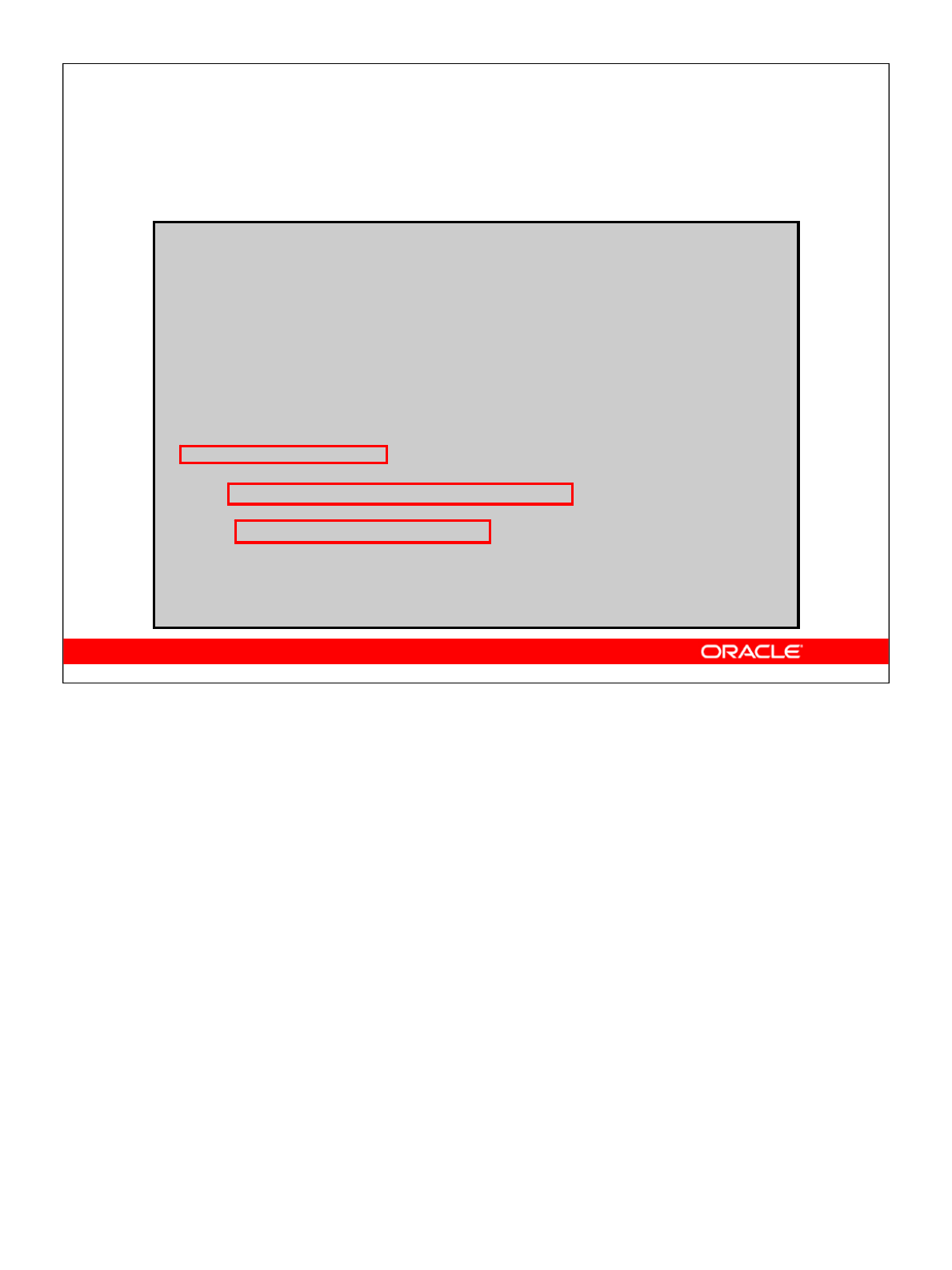
Oracle Database 10g: Develop PL/SQL Program Units 5-11
5-11 Copyright © 2004, Oracle. All rights reserved.
FOR emp_rec IN empc LOOP
IF emp_rec.department_id <> olddeptno THEN
UTL_FILE.PUT_LINE (file,
'DEPARTMENT: ' || emp_rec.department_id);
END IF;
UTL_FILE.PUT_LINE (file,
' EMPLOYEE: ' || emp_rec.last_name ||
' earns: ' || emp_rec.salary);
olddeptno := emp_rec.department_id;
END LOOP;
UTL_FILE.PUT_LINE(file,'*** END OF REPORT ***');
UTL_FILE.FCLOSE (file);
EXCEPTION
WHEN UTL_FILE.INVALID_FILEHANDLE THEN
RAISE_APPLICATION_ERROR(-20001,'Invalid File.');
WHEN UTL_FILE.WRITE_ERROR THEN
RAISE_APPLICATION_ERROR (-20002, 'Unable to
write to file');
END sal_status;
/
Using UTL_FILE: Example
Using UTL_FILE: Example (continued)
The output for this report in the salreport.txt file is as follows:
SALARY REPORT: GENERATED ON 08-MAR-01
DEPARTMENT: 10
EMPLOYEE: Whalen earns: 4400
DEPARTMENT: 20
EMPLOYEE: Hartstein earns: 13000
EMPLOYEE: Fay earns: 6000
DEPARTMENT: 30
EMPLOYEE: Raphaely earns: 11000
EMPLOYEE: Khoo earns: 3100
...
DEPARTMENT: 100
EMPLOYEE: Greenberg earns: 12000
...
DEPARTMENT: 110
EMPLOYEE: Higgins earns: 12000
EMPLOYEE: Gietz earns: 8300
EMPLOYEE: Grant earns: 7000
*** END OF REPORT ***
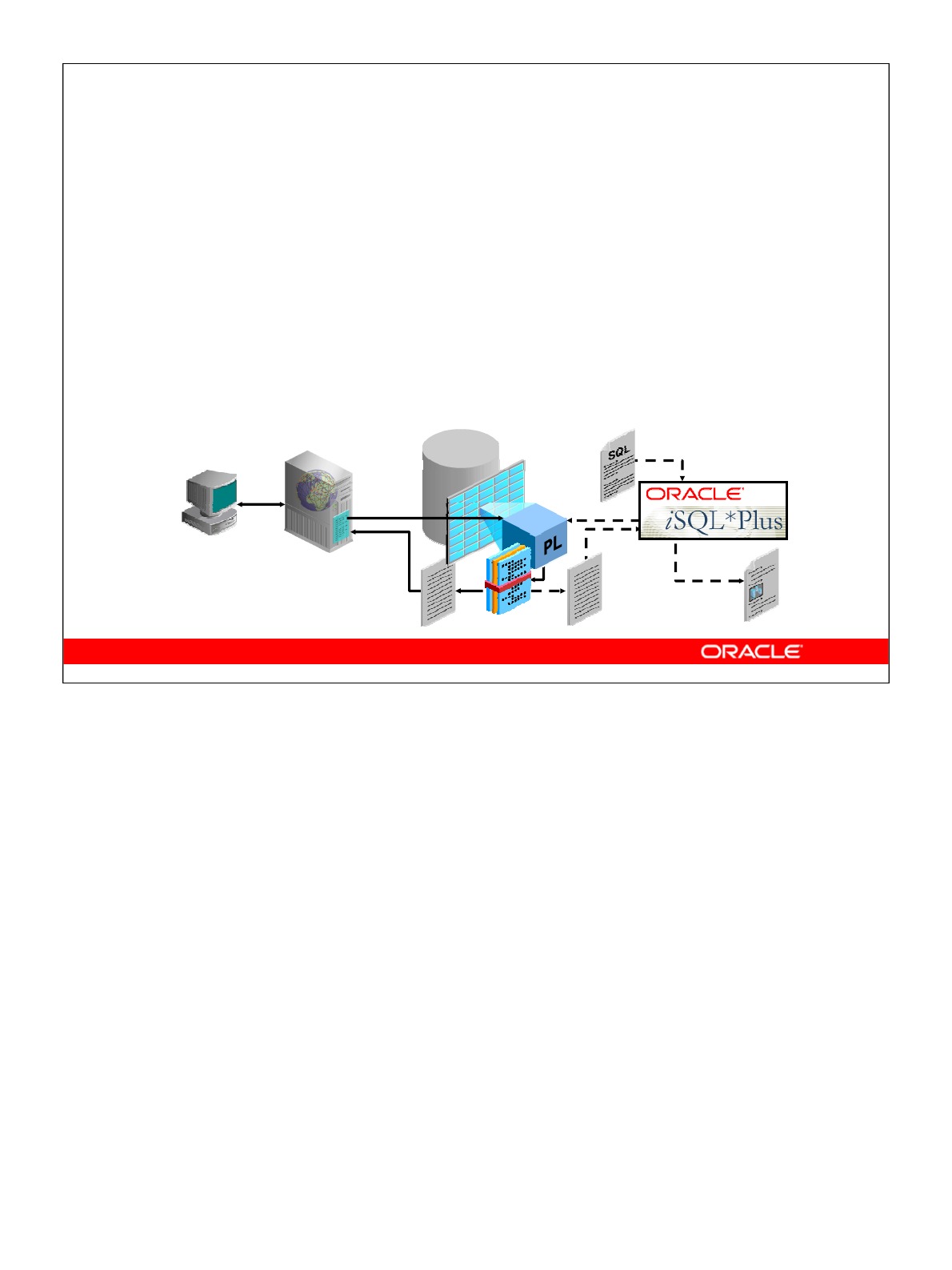
Oracle Database 10g: Develop PL/SQL Program Units 5-12
5-12 Copyright © 2004, Oracle. All rights reserved.
Generating Web Pages with the HTP
Package
•The HTP package procedures generate HTML tags.
•The HTP package is used to generate HTML
documents dynamically and can be invoked from:
–A browser using Oracle HTTP Server and PL/SQL
Gateway (mod_plsql) services
–An iSQL*Plus script to display HTML output
Web client
Oracle HTTP
Server
Buffer
SQL script
Generated
HTML
mod_plsql
Oracle
database
Buffer
HTP
Generating Web Pages with the HTP Package
The HTP package contains procedures that are used to generate HTML tags. The HTML
tags that are generated typically enclose the data provided as parameters to the various
procedures. The slide illustrates two ways in which the HTP package can be used:
• Most likely your procedures are invoked by the PL/SQL Gateway services, via the
mod_plsql component supplied with Oracle HTTP Server, which is part of the
Oracle Application Server product (represented by the solid lines in the graphic).
• Alternatively (as represented by the dotted lines in the graphic), your procedure can
be called from iSQL*Plus that can display the generated HTML output, which can be
copied and pasted to a file. This technique is used in this course because Oracle
Application Server software is not installed as a part of the course environment.
Note: The HTP procedures output information to a session buffer held in the database
server. In the Oracle HTTP Server context, when the procedure completes, the
mod_plsql component automatically receives the buffer contents, which are then
returned to the browser as the HTTP response. In SQL*Plus, you must manually execute:
•A SET SERVEROUTPUT ON command
• The procedure to generate the HTML into the buffer
• The OWA_UTIL.SHOWPAGE procedure to display the buffer contents
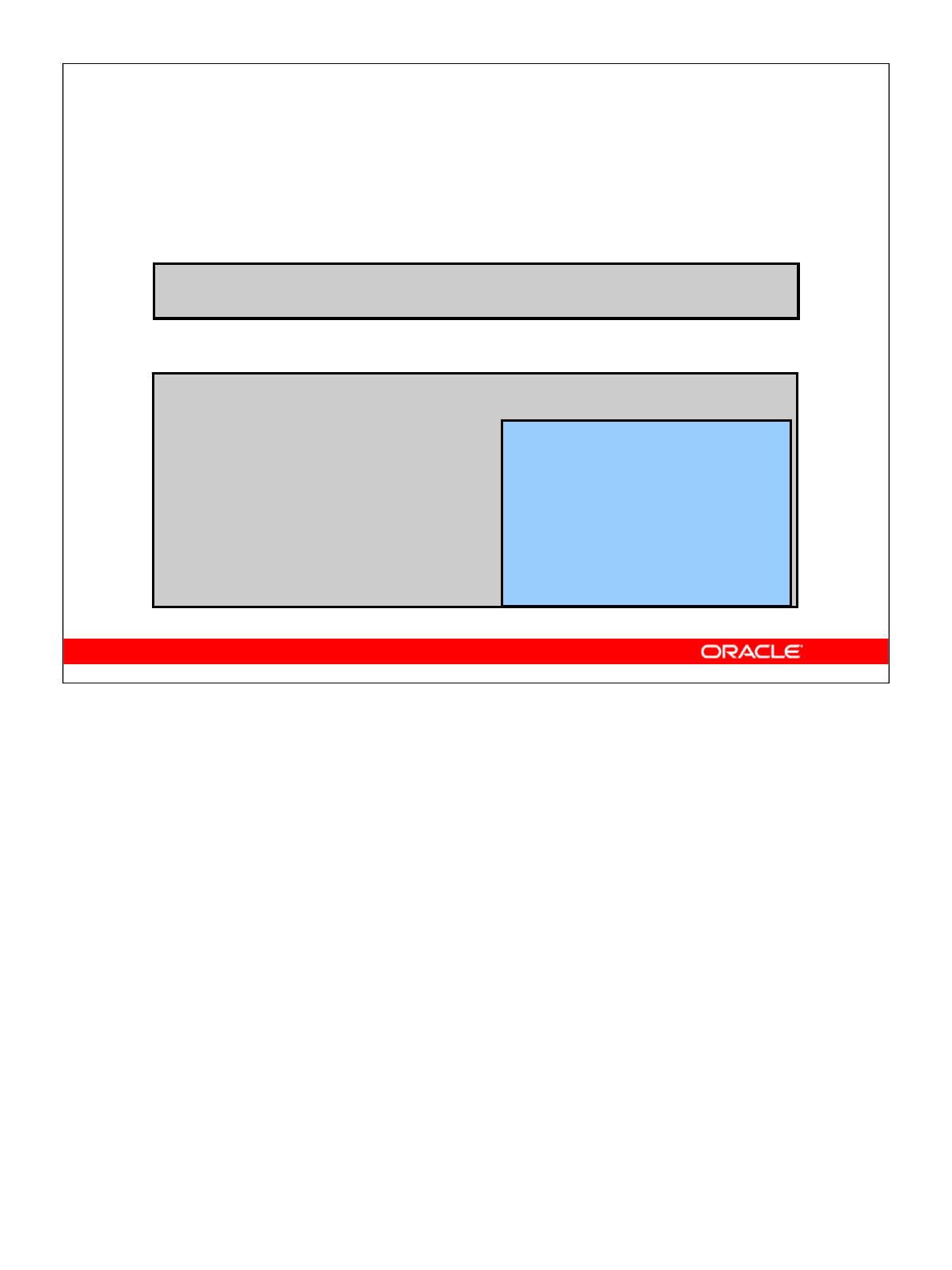
Oracle Database 10g: Develop PL/SQL Program Units 5-13
5-13 Copyright © 2004, Oracle. All rights reserved.
Using the HTP Package Procedures
•Generate one or more HTML tags. For example:
•Used to create a well-formed HTML document:
htp.bold('Hello'); -- <B>Hello</B>
htp.print('Hi <B>World</B>'); -- Hi <B>World</B>
BEGIN -- Generates:
htp.htmlOpen; --------->
htp.headOpen; --------->
htp.title('Welcome'); -->
htp.headClose; --------->
htp.bodyOpen; --------->
htp.print('My home page');
htp.bodyClose; --------->
htp.htmlClose; --------->
END;
<HTML>
<HEAD>
<TITLE>Welcome</TITLE>
</HEAD>
<BODY>
My home page
</BODY>
</HTML>
Using the HTP Package Procedures
The HTP package is structured to provide a one-to-one mapping of a procedure to standard
HTML tags. For example, to display bold text on a Web page, the text must be enclosed in
the HTML tag pair <B> and </B>. The first code box in the slide shows how to generate
the word Hello in HTML bold text by using the equivalent HTP package procedure, that
is, HTP.BOLD. The HTP.BOLD procedure accepts a text parameter and ensures that it is
enclosed in the appropriate HTML tags in the HTML output that is generated.
The HTP.PRINT procedure copies its text parameter to the buffer. The example in the
slide shows how the parameter supplied to the HTP.PRINT procedure can contain HTML
tags. This technique is only recommended if you need to use HTML tags that cannot be
generated by using the set of procedures provided in the HTP package.
The second example in the slide provides a PL/SQL block that generates the basic form of
an HTML document. The example serves to illustrate how each of the procedures
generates the corresponding HTML line in the enclosed text box on the right.
The benefit of using the HTP package is that you create well-formed HTML documents,
eliminating the need to manually type the HTML tags around each piece of data.
Note: For information about all the HTP package procedures, refer to the PL/SQL
Packages and Types Reference 10g manual.

Oracle Database 10g: Develop PL/SQL Program Units 5-14
5-14 Copyright © 2004, Oracle. All rights reserved.
Creating an HTML File with iSQL*Plus
To create an HTML file with iSQL*Plus, perform the
following steps:
1. Create a SQL script with the following commands:
2. Load and execute the script in iSQL*Plus,
supplying values for substitution variables.
3. Select, copy, and paste the HTML text that is
generated in the browser to an HTML file.
4. Open the HTML file in a browser.
SET SERVEROUTPUT ON
ACCEPT procname PROMPT "Procedure: "
EXECUTE &procname
EXECUTE owa_util.showpage
UNDEFINE proc
Creating an HTML File with iSQL*Plus
The slide example shows the steps for generating HTML by using any procedure and
saving the output into an HTML file. You should perform the following steps:
1. Turn on server output with the SET SERVEROUTPUT ON command. Without this,
you will receive exception messages when running procedures that have calls to the
HTP package.
2. Execute the procedure that contains calls to the HTP package.
Note: This will not produce any output, unless the procedure has calls to the
DBMS_OUTPUT package.
3. Execute the OWA_UTIL.SHOWPAGE procedure to display the text. This call
actually displays the HTML content that is generated from the buffer.
The ACCEPT command prompts for the name of the procedure to execute. The call to
OWA_UTIL.SHOWPAGE displays the HTML tags in the browser window. You can then
copy and paste the generated HTML tags from the browser window into an HTML file,
typically with an .htm or .html extension.
Note: If you are using SQL*Plus, then you can use the SPOOL command to direct the
HTML output directly to an HTML file. The SPOOL command is not supported in
iSQL*Plus; therefore, the copy-and-paste technique is the only option.

Oracle Database 10g: Develop PL/SQL Program Units 5-15
5-15 Copyright © 2004, Oracle. All rights reserved.
Using UTL_MAIL
The UTL_MAIL package:
•Is a utility for managing e-mail that includes such
commonly used e-mail features as attachments,
CC, BCC, and return receipt
•Requires the SMTP_OUT_SERVER database
initialization parameter to be set
•Provides the following procedures:
–SEND for messages without attachments
–SEND_ATTACH_RAW for messages with binary
attachments
–SEND_ATTACH_VARCHAR2 for messages with text
attachments
Using UTL_MAIL
The UTL_MAIL package is a utility for managing e-mail that includes commonly used e-
mail features such as attachments, CC, BCC, and return receipt.
The UTL_MAIL package is not installed by default because of the SMTP_OUT_SERVER
configuration requirement and the security exposure this involves. When installing
UTL_MAIL, you should take steps to prevent the port defined by SMTP_OUT_SERVER
being swamped by data transmissions. To install UTL_MAIL, log in as a DBA user in
iSQL*Plus and execute the following scripts:
@$ORACLE_HOME/rdbms/admin/utlmail.sql
@$ORACLE_HOME/rdbms/admin/prvtmail.plb
You should define the SMTP_OUT_SERVER parameter in the init.ora file
database initialization file:
SMTP_OUT_SERVER=mystmpserver.mydomain.com
The SMTP_OUT_SERVER parameter specifies the SMTP host and port to which
UTL_MAIL delivers out bound e-mail. Multiple servers can be specified, separated by
commas. If the first server in the list is unavailable, then UTL_MAIL tries the second
server, and so on. If SMTP_OUT_SERVER is not defined, then this invokes a default
setting derived from DB_DOMAIN, which is a database initialization parameter specifying
the logical location of the database within the network structure. For example:
db_domain=mydomain.com

Oracle Database 10g: Develop PL/SQL Program Units 5-16
5-16 Copyright © 2004, Oracle. All rights reserved.
Installing and Using UTL_MAIL
•As SYSDBA, using iSQL*Plus:
–Set the SMTP_OUT_SERVER (requires DBMS restart).
–Install the UTL_MAIL package.
•As a developer, invoke a UTL_MAIL procedure:
ALTER SYSTEM SET SMTP_OUT_SERVER='smtp.server.com'
SCOPE=SPFILE
@?/rdbms/admin/utlmail.sql
@?/rdbms/admin/prvtmail.plb
BEGIN
UTL_MAIL.SEND('otn@oracle.com','user@oracle.com',
message => 'For latest downloads visit OTN',
subject => 'OTN Newsletter');
END;
Installing and Using UTL_MAIL
The slide shows how to configure the SMTP_OUT_SERVER parameter to the name of the
SMTP host in your network, and how to install the UTL_MAIL package that is not
installed by default. Changing the SMTP_OUT_SERVER parameter requires restarting the
database instance. These tasks are performed by a user with SYSDBA capabilities.
The last example in the slide shows the simplest way to send a text message by using the
UTL_MAIL.SEND procedure with at least a subject and a message. The first two required
parameters are the following :
• The sender e-mail address (in this case, otn@oracle.com)
• The recipients e-mail address (for example, user@oracle.com). The value
can be a comma-separated list of addresses.
The UTL_MAIL.SEND procedure provides several other parameters, such as cc, bcc,
and priority with default values, if not specified. In the example, the message
parameter specifies the text for the e-mail, and the subject parameter contains the text for
the subject line. To send an HTML message with HTML tags, add the mime_type
parameter (for example, mime_type=>'text/html').
Note: For details about all the UTL_MAIL procedure parameters, refer to the PL/SQL
Packages and Types Reference 10g manual.
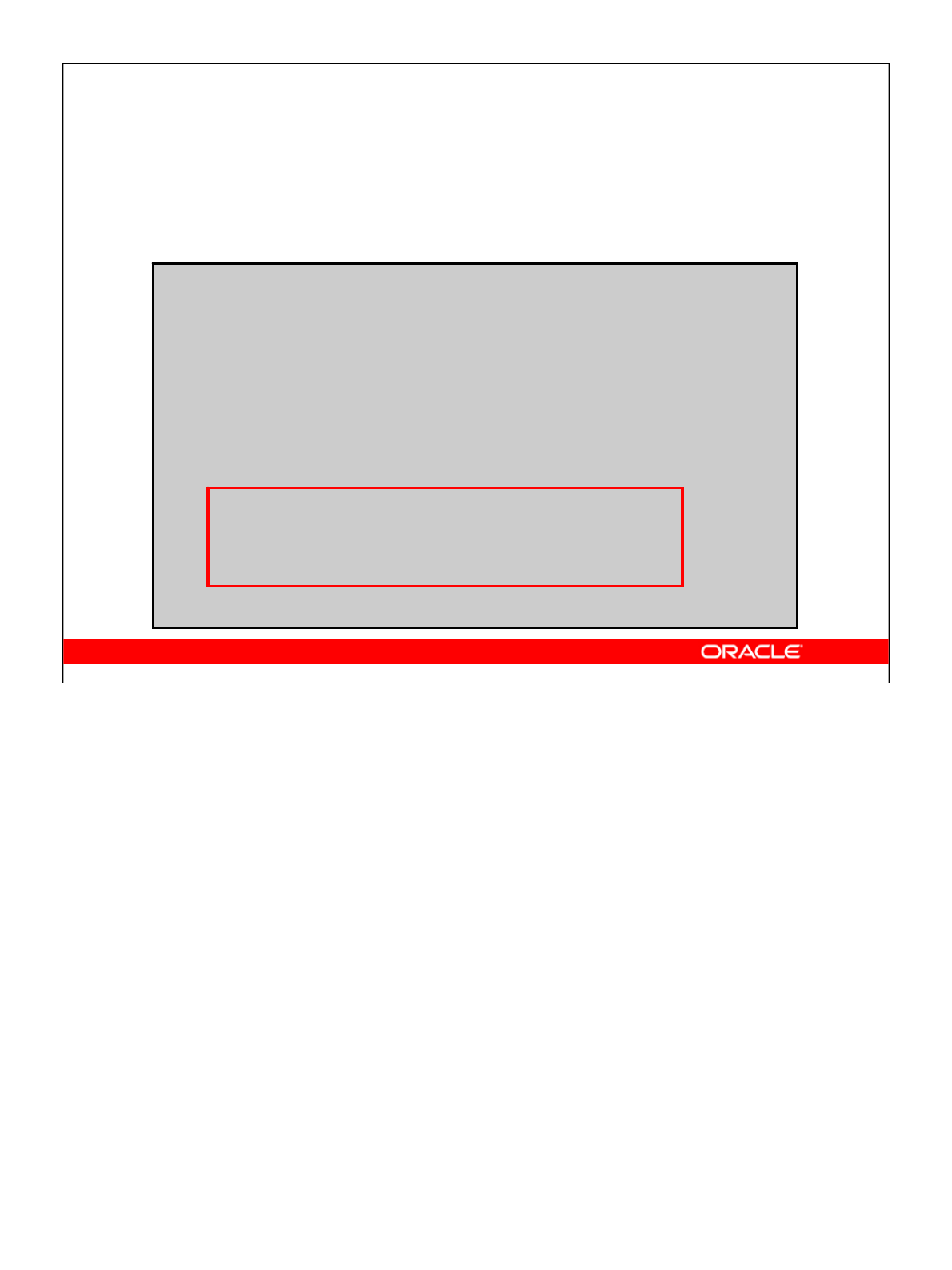
Oracle Database 10g: Develop PL/SQL Program Units 5-17
5-17 Copyright © 2004, Oracle. All rights reserved.
Sending E-Mail with a Binary Attachment
Use the UTL_MAIL.SEND_ATTACH_RAW procedure:
CREATE OR REPLACE PROCEDURE send_mail_logo IS
BEGIN
UTL_MAIL.SEND_ATTACH_RAW(
sender => 'me@oracle.com',
recipients => 'you@somewhere.net',
message =>
'<HTML><BODY>See attachment</BODY></HTML>',
subject => 'Oracle Logo',
mime_type => 'text/html'
attachment => get_image('oracle.gif'),
att_inline => true,
att_mime_type => 'image/gif',
att_filename => 'oralogo.gif');
END;
/
Sending E-Mail with a Binary Attachment
The slide shows a procedure calling the UTL_MAIL.SEND_ATTACH_RAW procedure to
send a textual or an HTML message with a binary attachment. In addition to the sender,
recipients, message, subject, and mime_type parameters that provide values
for the main part of the e-mail message, the SEND_ATTACH_RAW procedure has the
following highlighted parameters:
• The attachment parameter (required) accepts a RAW data type, with a maximum
size of 32,767 binary characters.
• The att_inline parameter (optional) is Boolean (default TRUE) to indicate that
the attachment is viewable with the message body.
• The att_mine_type parameter (optional) specifies the format of the attachment.
If not provided, it is set to application/octet.
• The att_filename parameter (optional) assigns any file name to the attachment.
It is NULL by default, in which case the name is assigned a default name.
The get_image function in the example uses a BFILE to read the image data. Using a
BFILE requires creating a logical directory name in the database by using the CREATE
DIRECTORY statement. The details of working with a BFILE are covered in the lesson
titled “Manipulating Large Objects.” The code for get_image is shown on the following
page.

Oracle Database 10g: Develop PL/SQL Program Units 5-18
Sending E-Mail with a Binary Attachment (continued)
The get_image function uses the DBMS_LOB package to read a binary file from the
operating system:
CREATE OR REPLACE FUNCTION get_image(
filename VARCHAR2, dir VARCHAR2 := 'TEMP')
RETURN RAW IS
image RAW(32767);
file BFILE := BFILENAME(dir, filename);
BEGIN
DBMS_LOB.FILEOPEN(file, DBMS_LOB.FILE_READONLY);
image := DBMS_LOB.SUBSTR(file);
DBMS_LOB.CLOSE(file);
RETURN image;
END;
/
To create the directory called TEMP, execute the following statement in iSQL*Plus:
CREATE DIRECTORY temp AS 'e:\temp';
Note: You require the CREATE ANY DIRECTORY system privilege to execute this
statement.
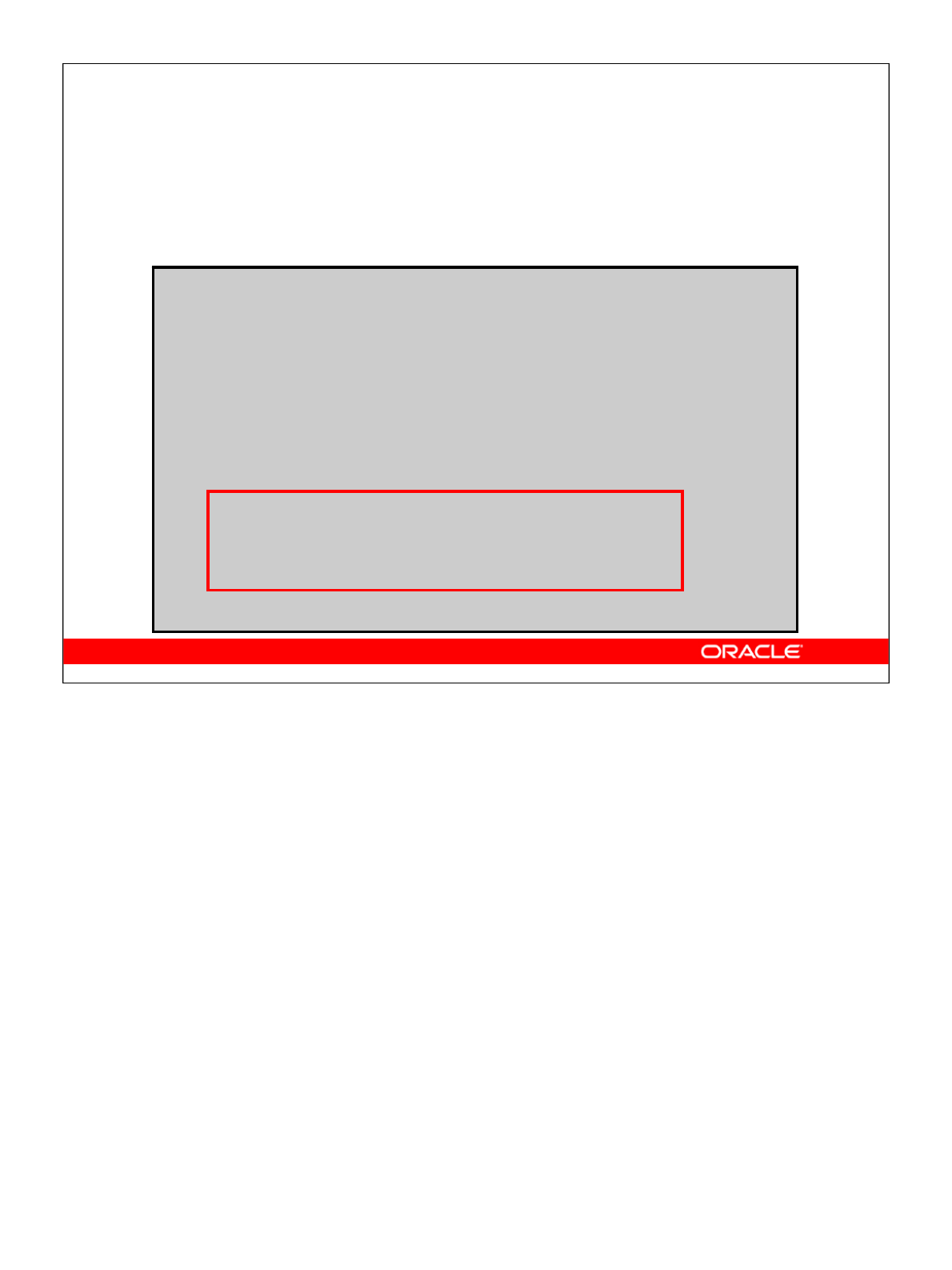
Oracle Database 10g: Develop PL/SQL Program Units 5-19
5-19 Copyright © 2004, Oracle. All rights reserved.
Sending E-Mail with a Text Attachment
Use the UTL_MAIL.SEND_ATTACH_VARCHAR2
procedure:
CREATE OR REPLACE PROCEDURE send_mail_file IS
BEGIN
UTL_MAIL.SEND_ATTACH_VARCHAR2(
sender => 'me@oracle.com',
recipients => 'you@somewhere.net',
message =>
'<HTML><BODY>See attachment</BODY></HTML>',
subject => 'Oracle Notes',
mime_type => 'text/html'
attachment => get_file('notes.txt'),
att_inline => false,
att_mime_type => 'text/plain',
att_filename => 'notes.txt');
END;
/
Sending E-Mail with a Text Attachment
The slide shows a procedure that calls the UTL_MAIL.SEND_ATTACH_VARCHAR2
procedure to send a textual or an HTML message with a text attachment. In addition to the
sender, recipients, message, subject, and mime_type parameters that
provide values for the main part of the e-mail message, the SEND_ATTACH_VARCHAR2
procedure has the following parameters highlighted:
• The attachment parameter (required) accepts a VARCHAR2 data type, maximum
size of 32767 binary characters.
• The att_inline parameter (optional) is a Boolean (default TRUE) to indicate that
the attachment is viewable with the message body.
• The att_mine_type parameter (optional) specifies the format of the attachment.
If not provided, it is set to application/octet.
• The att_filename parameter (optional) assigns any file name to the attachment.
It is NULL by default, in which case, the name is assigned a default name.
The get_file function in the example uses a BFILE to read a text file from the
operating system directories for the value of the attachment parameter, which could
simply be populated from a VARCHAR2 variable. The code for get_file is shown on
the following page.

Oracle Database 10g: Develop PL/SQL Program Units 5-20
Sending E-Mail with a Text Attachment (continued)
The get_file function uses the DBMS_LOB package to read a binary file from the
operating system, and uses the UTL_RAW package to convert the RAW binary data into
readable text data in the form of a VARCHAR2 data type:
CREATE OR REPLACE FUNCTION get_file(
filename VARCHAR2, dir VARCHAR2 := 'TEMP')
RETURN VARCHAR2 IS
contents VARCHAR2(32767);
file BFILE := BFILENAME(dir, filename);
BEGIN
DBMS_LOB.FILEOPEN(file, DBMS_LOB.FILE_READONLY);
contents := UTL_RAW.CAST_TO_VARCHAR2(
DBMS_LOB.SUBSTR(file));
DBMS_LOB.CLOSE(file);
RETURN contents;
END;
/
Note: Alternatively, you could read the contents of the text file into a VARCHAR2 variable
by using the UTL_FILE package functionality.
The preceding example requires the TEMP directory to be created similar to the following
statement in iSQL*Plus:
CREATE DIRECTORY temp AS 'e:\temp';
Note: The CREATE ANY DIRECTORY system privilege is required to execute this
statement.

Oracle Database 10g: Develop PL/SQL Program Units 5-21
5-21 Copyright © 2004, Oracle. All rights reserved.
DBMS_SCHEDULER Package
The database Scheduler comprises several
components to enable jobs to be run. Use the
DBMS_SCHEDULER package to create each job with:
•A unique job name
•A program (“what” should be executed)
•A schedule (“when” it should run)
Program
Window
Arguments Arguments
Job class
ScheduleJob
DBMS_SCHEDULER Package
Oracle Database 10gprovides a collection of subprograms in the DBMS_SCHEDULER
package to simplify management and to provide a rich set of functionality for complex
scheduling tasks. Collectively, these subprograms are called the Scheduler and can be
called from any PL/SQL program. The Scheduler enables database administrators and
application developers to control when and where various tasks take place. By ensuring
that many routine database tasks occur without manual intervention, you can lower
operating costs, implement more reliable routines, and minimize human error.
The diagram shows the following architectural components of the Scheduler:
•A job is the combination of a program and a schedule. Arguments required by the
program can be provided with the program or the job. All job names are of the form
[schema.]name. When you create a job, you specify the job name, a program, a
schedule, and (optionally) job characteristics that can be provided through a job
class.
•A program determines what should be run. Every automated job involves a
particular executable, whether it is a PL/SQL block, a stored procedure, a native
binary executable, or a shell script. A program provides metadata about a particular
executable and may require a list of arguments.
•A schedule specifies when and how many times a job is executed.

Oracle Database 10g: Develop PL/SQL Program Units 5-22
DBMS_SCHEDULER Package (continued)
•A job class defines a category of jobs that share common resource usage
requirements and other characteristics. At any given time, each job can belong to
only a single job class. A job class has the following attributes:
- A database service name. The jobs in the job class will have an affinity to the
particular service specified. That is, the jobs will run on the instances that cater
to the specified service.
-A resource consumer group, which classifies a set of user sessions that have
common resource-processing requirements. At any given time, a user session or
job class can belong to a single resource consumer group. The resource
consumer group that the job class associates with determines the resources that
are allocated to the job class.
•A window is represented by an interval of time with a well-defined beginning and
end, and is used to activate different resource plans at different times.
The slide focuses on the job component as the primary entity. However, a program, a
schedule, a window, and a job class are components that can be created as individual
entities that can be associated with a job to be executed by the Scheduler. When a job is
created, it may contain all the information needed in-line, that is, in the call that creates the
job. Alternatively, creating a job may reference a program or schedule component that was
previously defined. Examples of this are discussed in the next few pages.
For more information about the Scheduler, see the eStudy titled Oracle Database 10g:
Configure and Manage Jobs with the Scheduler.

Oracle Database 10g: Develop PL/SQL Program Units 5-23
5-23 Copyright © 2004, Oracle. All rights reserved.
Creating a Job
A job can be created in several ways by using a
combination of in-line parameters, named Programs,
and named Schedules. You can create a job with the
CREATE_JOB procedure by:
•Using in-line information with the “what” and the
schedule specified as parameters
•Using a named (saved) program and specifying
the schedule in-line
•Specifying what should be done in-line and using
a named Schedule
•Using named Program and Schedule components
Note: Creating a job requires the CREATE JOB system
privilege.
Creating a Job
The component that causes something to be executed at a specified time is called a job.
Use the DBMS_SCHEDULER.CREATE_JOB procedure of the DBMS_SCHEDULER
package to create a job, which is in a disabled state by default. A job becomes active and
scheduled when it is explicitly enabled. To create a job, you:
• Provide a name in the form [schema.]name
• Need the CREATE JOB privilege
Note: A user with the CREATE ANY JOB privilege can create a job in any schema
except the SYS schema. Associating a job with a particular class requires the EXECUTE
privilege for that class.
In simple terms, a job can be created by specifying all the job details—the program to be
executed (what) and its schedule (when)—in the arguments of the CREATE_JOB
procedure. Alternatively, you can use predefined Program and Schedule components. If
you have a named Program and Schedule, then these can be specified or combined with in-
line arguments for maximum flexibility in the way a job is created.
A simple logical check is performed on the schedule information (that is, checking the
date parameters when a job is created). The database checks whether the end date is after
the start date. If the start date refers to a time in the past, then the start date is changed to
the current date.
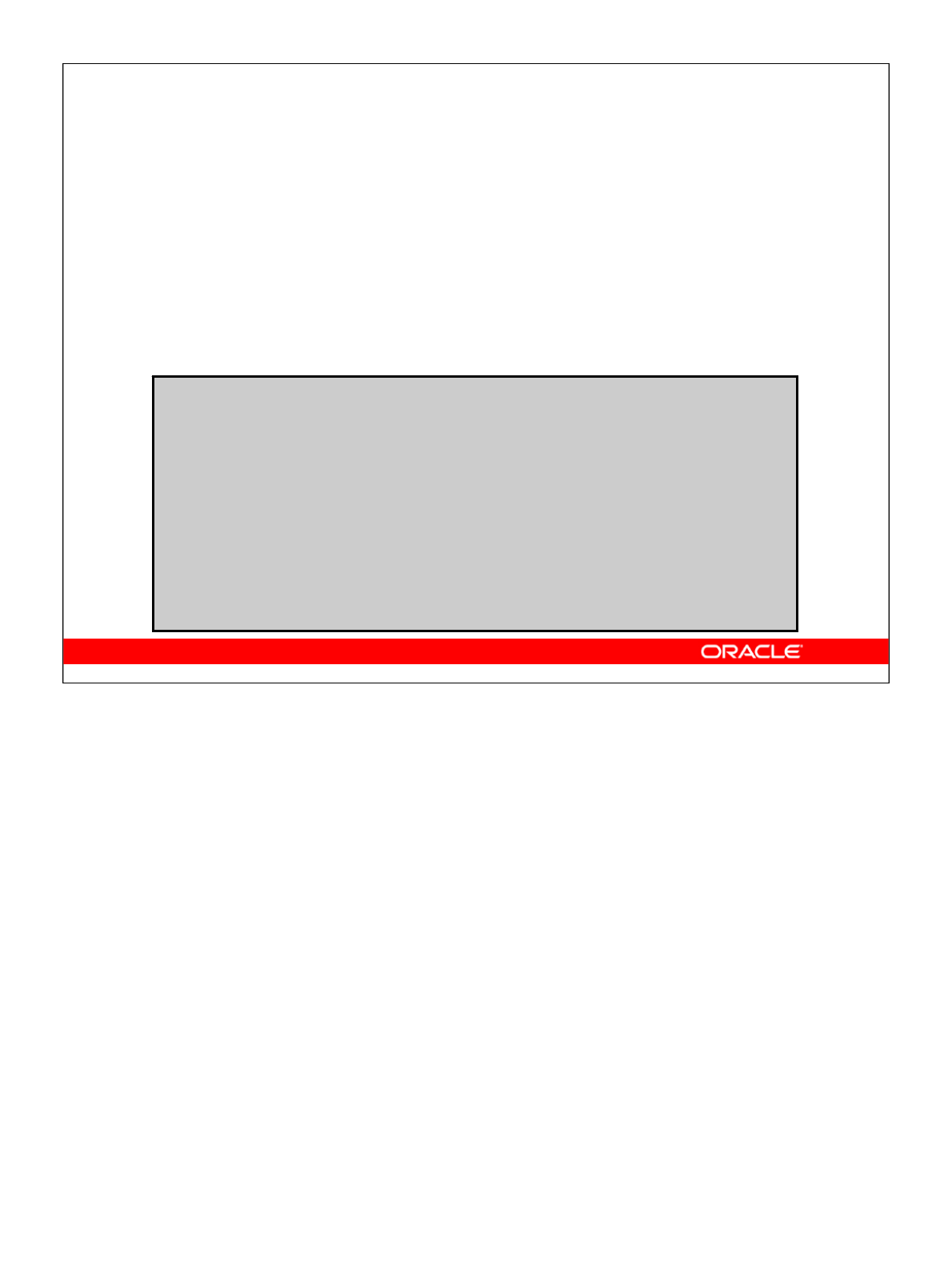
Oracle Database 10g: Develop PL/SQL Program Units 5-24
5-24 Copyright © 2004, Oracle. All rights reserved.
Creating a Job with In-Line Parameters
Specify the type of code, code, start time, and
frequency of the job to be run in the arguments of the
CREATE_JOB procedure.
Here is an example that schedules a PL/SQL block
every hour:
BEGIN
DBMS_SCHEDULER.CREATE_JOB(
job_name => 'JOB_NAME',
job_type => 'PLSQL_BLOCK',
job_action => 'BEGIN ...; END;',
start_date => SYSTIMESTAMP,
repeat_interval=>'FREQUENCY=HOURLY;INTERVAL=1',
enabled => TRUE);
END;
/
Creating a Job with In-Line Parameters
You can create a job to run a PL/SQL block, stored procedure, or external program by
using the DBMS_SCHEDULER.CREATE_JOB procedure. The CREATE_JOB procedure
can be used directly without requiring you to create Program or Schedule components.
The example in the slide shows how you can specify all the job details in-line. The
parameters of the CREATE_JOB procedure define “what” is to be executed, the schedule,
and other job attributes. The following parameters define what is to be executed:
• The job_type parameter can be one of three values:
-PLSQL_BLOCK for any PL/SQL block or SQL statement. This type of job
cannot accept arguments.
-STORED_PROCEDURE for any stored stand-alone or packaged procedure. The
procedures can accept arguments that are supplied with the job.
-EXECUTABLE for an executable command-line operating system application
• The schedule is specified by using the following parameters:
- The start_date accepts a time stamp, and the repeat_interval is
string-specified as a calendar or PL/SQL expression. An end_date can be
specified.
Note: String expressions that are specified for repeat_interval are discussed later.
The example specifies that the job should run every hour.
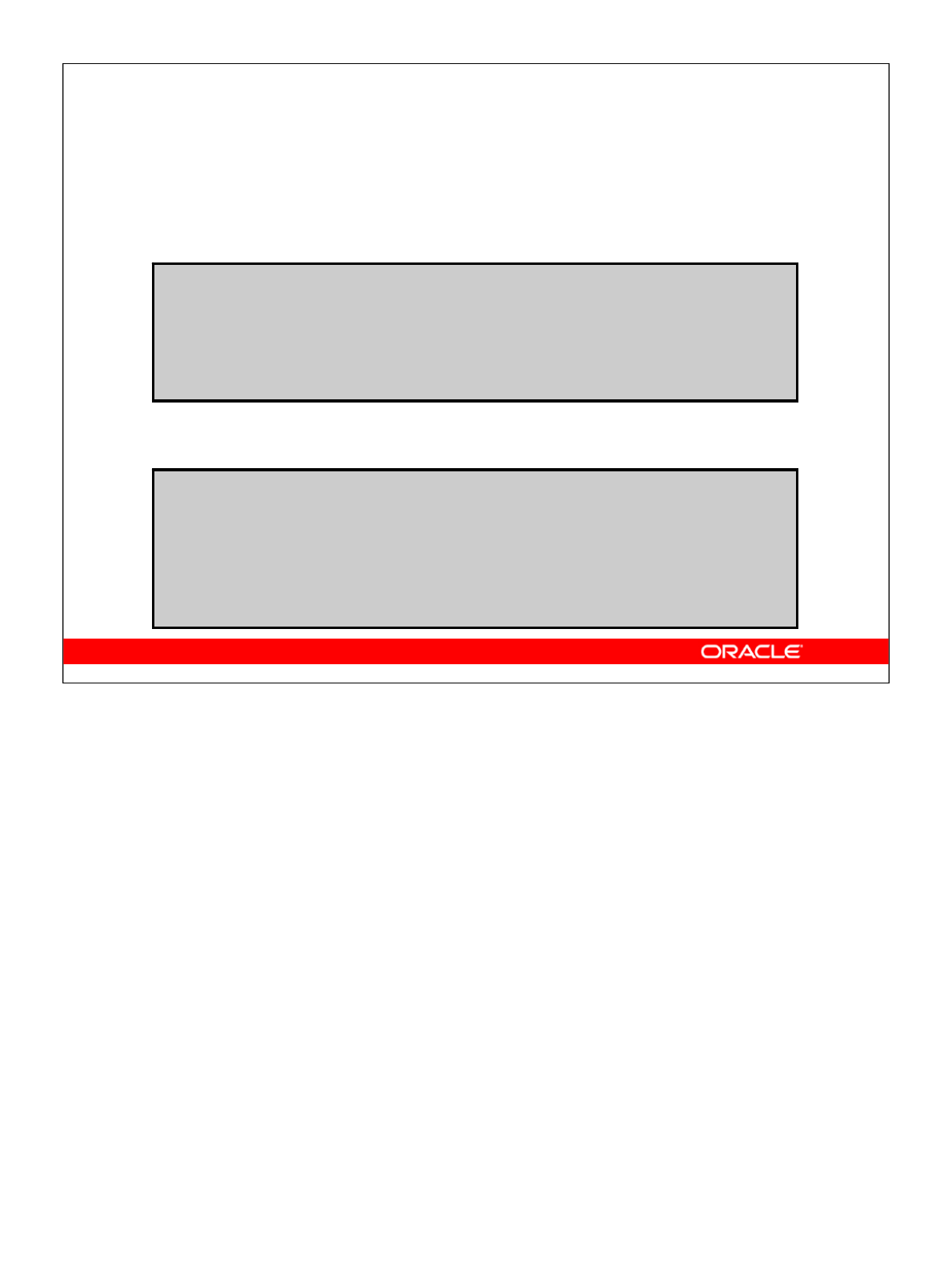
Oracle Database 10g: Develop PL/SQL Program Units 5-25
5-25 Copyright © 2004, Oracle. All rights reserved.
Creating a Job Using a Program
•Use CREATE_PROGRAM to create a program:
•Use overloaded CREATE_JOB procedure with its
program_name parameter:
BEGIN
DBMS_SCHEDULER.CREATE_JOB('JOB_NAME',
program_name => 'PROG_NAME',
start_date => SYSTIMESTAMP,
repeat_interval => 'FREQ=DAILY',
enabled => TRUE);
END;
BEGIN
DBMS_SCHEDULER.CREATE_PROGRAM(
program_name => 'PROG_NAME',
program_type => 'PLSQL_BLOCK',
program_action => 'BEGIN ...; END;');
END;
Creating a Job Using a Program
The DBMS_SCHEDULER.CREATE_PROGRAM procedure defines a program that must be
assigned a unique name. Creating the program separately for a job enables you to:
• Define the action once and then reuse this action within multiple jobs
• Change the schedule for a job without having to re-create the PL/SQL block
• Change the program executed without changing all the jobs
The program action string specifies a procedure, executable name, or PL/SQL block
depending on the value of the program_type parameter, which can be:
•PLSQL_BLOCK to execute an anonymous block or SQL statement
•STORED_PROCEDURE to execute a stored procedure, such as PL/SQL, Java, or C
•EXECUTABLE to execute operating system command-line programs
The example shown in the slide demonstrates calling an anonymous PL/SQL block. You
can also call an external procedure within a program, as in the following example:
DBMS_SCHEDULER.CREATE_PROGRAM(program_name =>
'GET_DATE',
program_action => '/usr/local/bin/date',
program_type => 'EXECUTABLE');
To create a job with a program, specify the program name in the program_name
argument in the call to the DBMS_SCHEDULER.CREATE_JOB procedure, as shown.

Oracle Database 10g: Develop PL/SQL Program Units 5-26
5-26 Copyright © 2004, Oracle. All rights reserved.
Creating a Job for a Program with
Arguments
•Create a program:
•Define an argument:
•Create a job specifying the number of arguments:
DBMS_SCHEDULER.DEFINE_PROGRAM_ARGUMENT(
program_name => 'PROG_NAME',
argument_name => 'DEPT_ID',
argument_position=> 1, argument_type=> 'NUMBER',
default_value => '50');
DBMS_SCHEDULER.CREATE_PROGRAM(
program_name => 'PROG_NAME',
program_type => 'STORED_PROCEDURE',
program_action => 'EMP_REPORT');
DBMS_SCHEDULER.CREATE_JOB('JOB_NAME', program_name
=> 'PROG_NAME', start_date => SYSTIMESTAMP,
repeat_interval => 'FREQ=DAILY',
number_of_arguments => 1, enabled => TRUE);
Creating a Job for a Program with Arguments
Programs, such as PL/SQL or external procedures, may require input arguments. Using the
DBMS_SCHEDULER.DEFINE_PROGRAM_ARGUMENT procedure, you can define an
argument for an existing program. The DEFINE_PROGRAM_ARGUMENT procedure
parameters include the following:
• The program_name specifies an existing program that is to be altered.
• The argument_name specifies a unique argument name for the program.
• The argument_position specifies the position in which the argument is passed
when the program is called.
• The argument_type specifies the data type of the argument value that is passed
to the called program.
• The default_value specifies a default value that is supplied to the program, if
the job that schedules the program does not provide a value.
The slide shows how to create a job executing a program with one argument. The program
argument default value is 50. To change the program argument value for a job, use:
DBMS_SCHEDULER.SET_JOB_ARGUMENT_VALUE(
job_name => 'JOB_NAME',
argument_name => 'DEPT_ID', argument_value => '80');
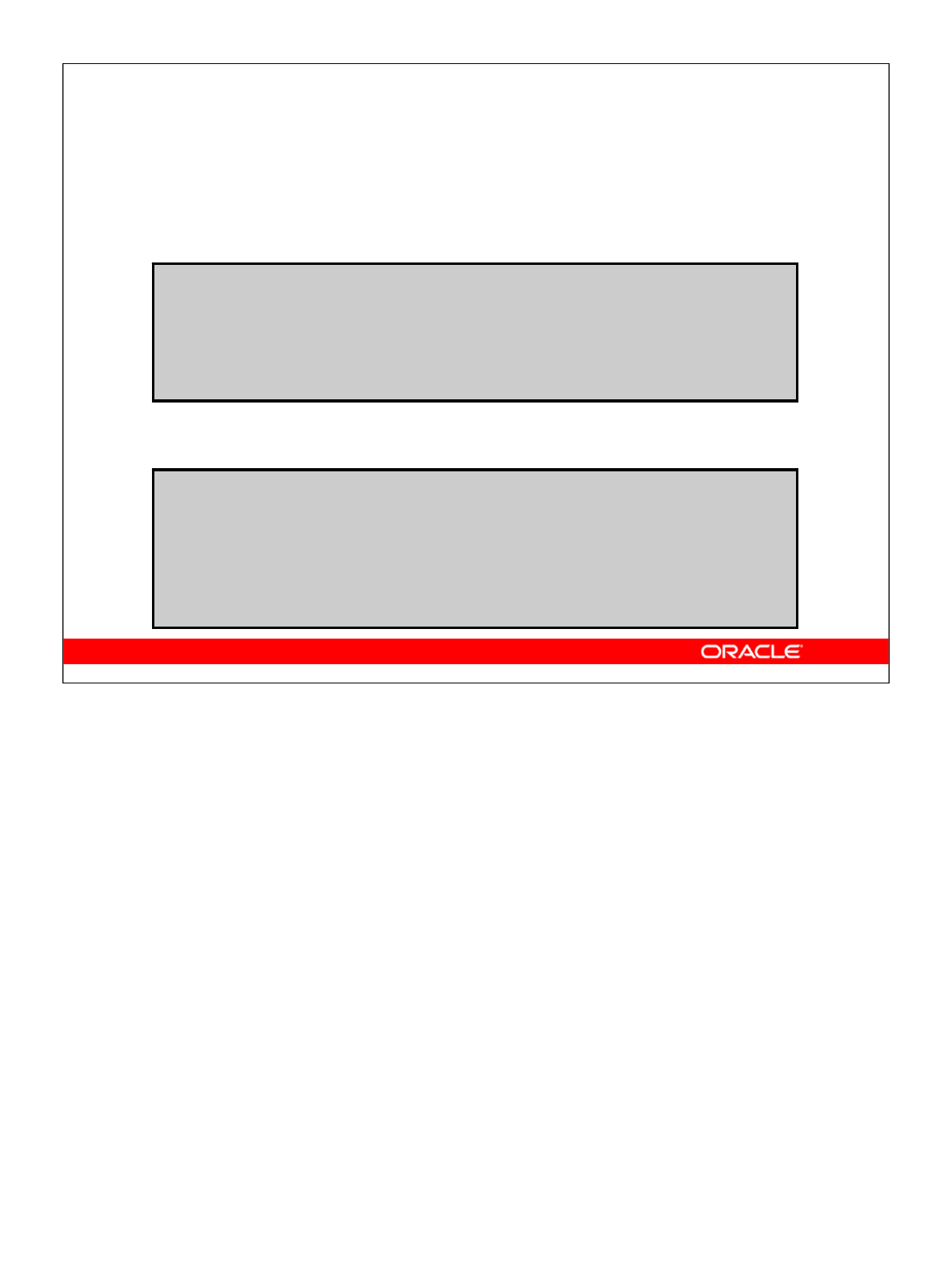
Oracle Database 10g: Develop PL/SQL Program Units 5-27
5-27 Copyright © 2004, Oracle. All rights reserved.
Creating a Job Using a Schedule
•Use CREATE_SCHEDULE, to create a schedule:
•Use CREATE_JOB referencing the schedule in the
schedule_name parameter:
BEGIN
DBMS_SCHEDULER.CREATE_JOB('JOB_NAME',
schedule_name => 'SCHED_NAME',
job_type => 'PLSQL_BLOCK',
job_action => 'BEGIN ...; END;',
enabled => TRUE);
END;
BEGIN
DBMS_SCHEDULER.CREATE_SCHEDULE('SCHED_NAME',
start_date => SYSTIMESTAMP,
repeat_interval => 'FREQ=DAILY',
end_date => SYSTIMESTAMP +15);
END;
Creating a Job Using a Schedule
You can create a common schedule that can be applied to different jobs without having to
specify the schedule details each time. The following are the benefits of creating a
schedule:
• It is reusable and can be assigned to different jobs.
• Changing the schedule affects all jobs using the schedule. The job schedules are
changed once, not multiple times.
A schedule is precise to only the nearest second. Although the TIMESTAMP data type is
more accurate, the scheduler rounds off anything with a higher precision to the nearest
second.
The start and end times for a schedule are specified by using the TIMESTAMP data type.
The end_date for a saved schedule is the date after which the schedule is no longer
valid. The schedule in the example is valid for 15 days after using it with a specified job.
The repeat_interval for a saved schedule must be created by using a calendaring
expression. A NULL value for repeat_interval specifies that the job runs only once.
Note: You cannot use PL/SQL expressions to express the repeat interval for a saved
schedule.
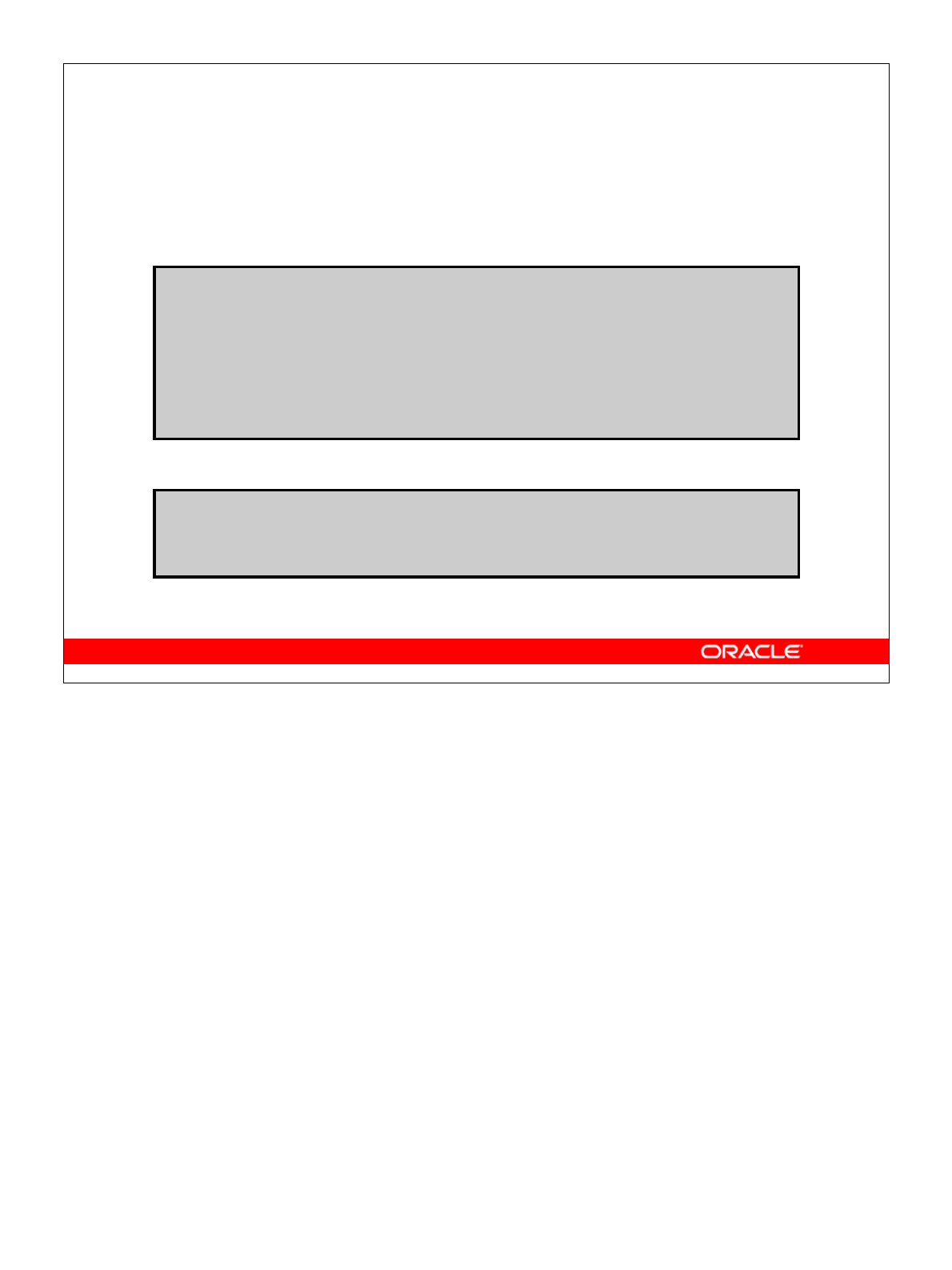
Oracle Database 10g: Develop PL/SQL Program Units 5-28
5-28 Copyright © 2004, Oracle. All rights reserved.
Setting the Repeat Interval for a Job
•Using a calendaring expression:
•Using a PL/SQL expression:
repeat_interval=> 'FREQ=HOURLY; INTERVAL=4'
repeat_interval=> 'FREQ=DAILY'
repeat_interval=> 'FREQ=MINUTELY;INTERVAL=15'
repeat_interval=> 'FREQ=YEARLY;
BYMONTH=MAR,JUN,SEP,DEC;
BYMONTHDAY=15'
repeat_interval=> 'SYSDATE + 36/24'
repeat_interval=> 'SYSDATE + 1'
repeat_interval=> 'SYSDATE + 15/(24*60)'
Setting the Repeat Interval for a Job
When scheduling repeat intervals for a job, you can specify either a PL/SQL expression (if
it is within a job argument) or a calendaring expression.
The examples in the slide include the following:
•FREQ=HOURLY;INTERVAL=4 indicates a repeat interval of every four hours.
•FREQ=DAILY indicates a repeat interval of every day, at the same time as the start
date of the schedule.
•FREQ=MINUTELY;INTERVAL=15 indicates a repeat interval of every 15 minutes.
•FREQ=YEARLY;BYMONTH=MAR,JUN,SEP,DEC;BYMONTHDAY=15 indicates a repeat
interval of every year on March 15, June 15, September 15, and December 15.
With a calendaring expression, the next start time for a job is calculated using the repeat
interval and the start date of the job.
Note: If no repeat interval is specified (in other words, if a NULL value is provided in the
argument), the job runs only once on the specified start date.
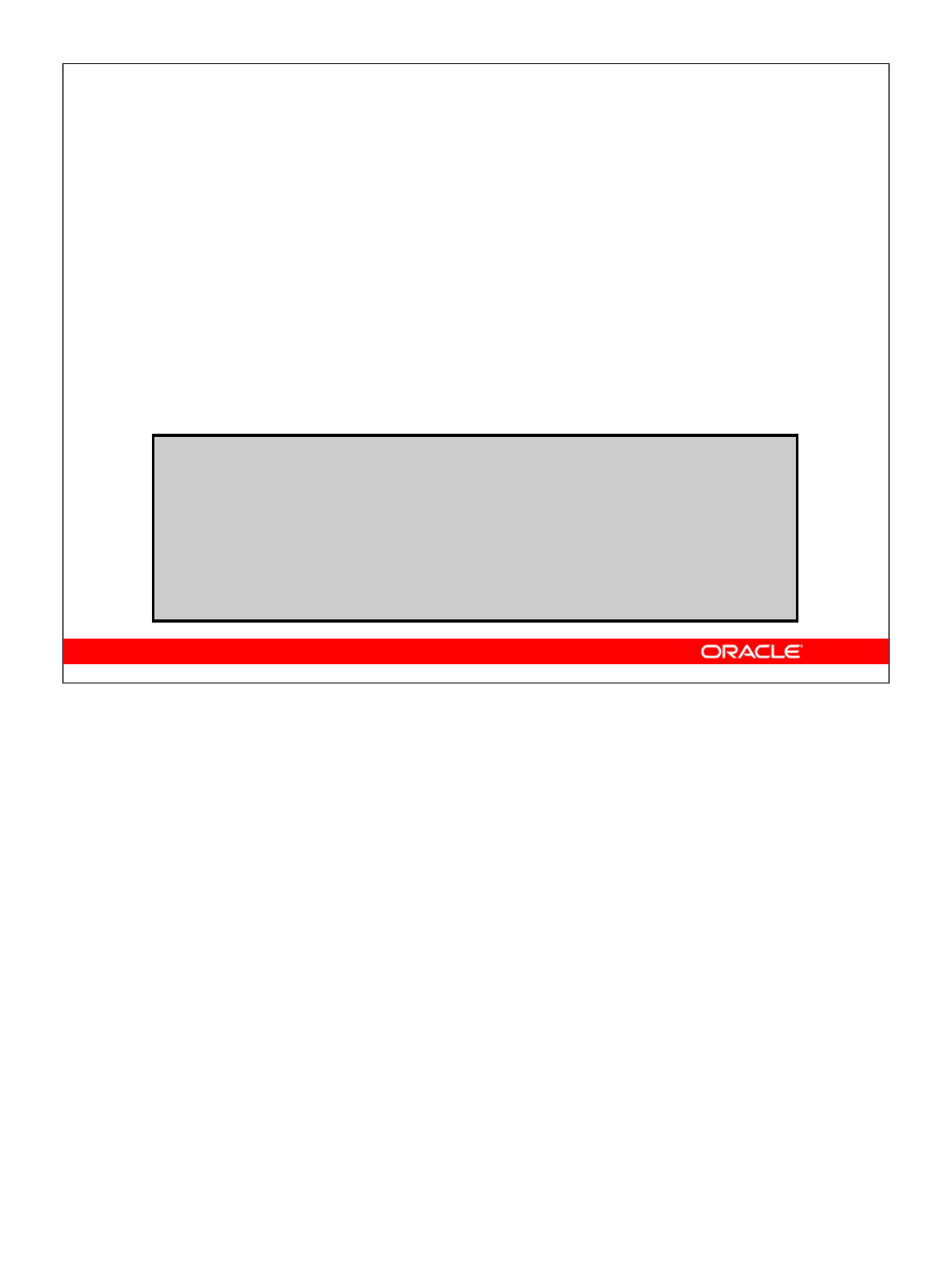
Oracle Database 10g: Develop PL/SQL Program Units 5-29
5-29 Copyright © 2004, Oracle. All rights reserved.
Creating a Job Using a Named Program
and Schedule
•Create a named program called PROG_NAME by
using the CREATE_PROGRAM procedure.
•Create a named schedule called SCHED_NAME by
using the CREATE_SCHEDULE procedure.
•Create a job referencing the named program and
schedule:
BEGIN
DBMS_SCHEDULER.CREATE_JOB('JOB_NAME',
program_name => 'PROG_NAME',
schedule_name => 'SCHED_NAME',
enabled => TRUE);
END;
/
Creating a Job Using a Named Program and Schedule
The example in the slide shows the final form for using the
DBMS_SCHEDULER.CREATE_JOB procedure. In this example, the named program
(PROG_NAME) and schedule (SCHED_NAME) are specified in their respective parameters
in the call to the DBMS_SCHEDULER.CREATE_JOB procedure.
With this example, you can see how easy it is to create jobs by using a predefined program
and schedule.
Some jobs and schedules can be too complex to cover in this course. For example, you can
create windows for recurring time plans and associate a resource plan with a window. A
resource plan defines attributes about the resources required during the period defined by
execution window.
For more information, refer to the eStudy titled Oracle Database 10g: Configure and
Manage Jobs with the Scheduler.
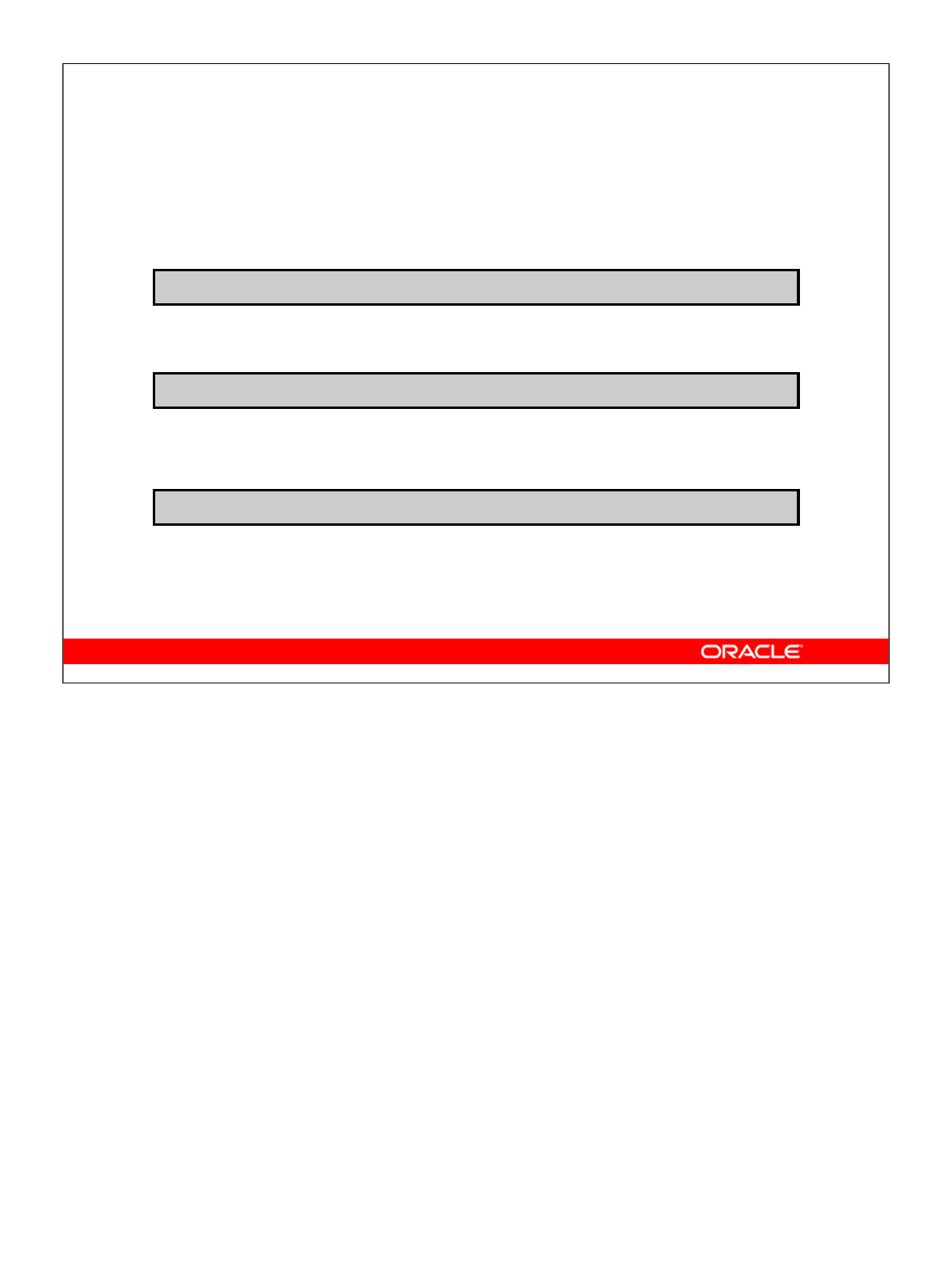
Oracle Database 10g: Develop PL/SQL Program Units 5-30
5-30 Copyright © 2004, Oracle. All rights reserved.
Managing Jobs
•Run a job:
•Stop a job:
•Drop a job, even if it is currently running:
DBMS_SCHEDULER.RUN_JOB('SCHEMA.JOB_NAME');
DBMS_SCHEDULER.STOP_JOB('SCHEMA.JOB_NAME');
DBMS_SCHEDULER.DROP_JOB('JOB_NAME', TRUE);
Managing Jobs
After a job has been created, you can:
• Run the job by calling the RUN_JOB procedure specifying the name of the job. The
job is immediately executed in your current session.
• Stop the job by using the STOP_JOB procedure. If the job is running currently, it is
stopped immediately. The STOP_JOB procedure has two arguments:
-job_name: Name of the job to be stopped
-force: Tries to gracefully terminate a job. If this fails and force is set to
TRUE, then the job slave is terminated. (Default value is FALSE). To use
force, you must have the MANAGE SCHEDULER system privilege.
• Drop the job with the DROP_JOB procedure. This procedure has two arguments:
-job_name: Name of the job to be dropped
-force: Whether the job should be stopped and dropped if it is currently
running (Default value is FALSE.)
If the DROP_JOB procedure is called and the job specified is currently running, then
the command fails unless the force option is set to TRUE. If the force option is set to
TRUE, then any instance of the job that is running is stopped and the job is dropped.
Note: To run, stop, or drop a job that belongs to another user, you need ALTER privileges
on that job or the CREATE ANY JOB system privilege.

Oracle Database 10g: Develop PL/SQL Program Units 5-31
5-31 Copyright © 2004, Oracle. All rights reserved.
Data Dictionary Views
•[DBA | ALL | USER]_SCHEDULER_JOBS
•[DBA | ALL | USER]_SCHEDULER_RUNNING_JOBS
•[DBA | ALL]_SCHEDULER_JOB_CLASSES
•[DBA | ALL | USER]_SCHEDULER_JOB_LOG
•[DBA | ALL | USER]_SCHEDULER_JOB_RUN_DETAILS
•[DBA | ALL | USER]_SCHEDULER_PROGRAMS
Data Dictionary Views
The DBA_SCHEDULER_JOB_LOG view shows all completed job instances, both
successful and failed.
To view the state of your jobs, use the following query:
SELECT job_name, program_name, job_type, state
FROM USER_SCHEDULER_JOBS;
To determine which instance a job is running on, use the following query:
SELECT owner, job_name, running_instance,
resource_consumer_group
FROM DBA_SCHEDULER_RUNNING_JOBS;
To determine information on how a job ran, use the following query:
SELECT job_name, instance_id, req_start_date,
actual_start_date, end_date, completion_status
FROM ALL_SCHEDULER_JOB_LOG;
To determine the status of your jobs, use the following query:
SELECT job_name, status, error#, run_duration, cpu_used
FROM USER_SCHEDULER_JOB_RUN_DETAILS;

Oracle Database 10g: Develop PL/SQL Program Units 5-32
5-32 Copyright © 2004, Oracle. All rights reserved.
Summary
In this lesson, you should have learned how to:
•Use various preinstalled packages that are
provided by the Oracle server
•Use the following packages:
–DBMS_OUTPUT to buffer and display text
–UTL_FILE to write operating system text files
–HTP to generate HTML documents
–UTL_MAIL to send messages with attachments
–DBMS_SCHEDULER to automate processing
•Create packages individually or by using the
catproc.sql script
Summary
This lesson covers a small subset of package provided with the Oracle database. You have
extensively used DBMS_OUTPUT for debugging purposes and displaying procedurally
generated information on the screen in iSQL*Plus.
In this lesson, you should have learned how to use the power features provided by the
database to create text files in the operating system using UTL_FILE, generate HTML
reports with the HTP package, send e-mail with or without binary or text attachments
using the UTL_MAIL package, and schedule PL/SQL and external code for execution with
the DBMS_SCHEDULER package.
Note: For more information about all PL/SQL packages and types, refer to the PL/SQL
Packages and Types Reference 10g manual.

Oracle Database 10g: Develop PL/SQL Program Units 5-33
5-33 Copyright © 2004, Oracle. All rights reserved.
Practice 5: Overview
This practice covers the following topics:
•Using UTL_FILE to generate a text report
•Using HTP to generate a Web page report
•Using DBMS_SCHEDULER to automate report
processing
Practice 5: Overview
In this practice, you use UTL_FILE to generate a text file report of employees in each
department. You create a procedure to generate an HTML version of the employee report,
and write a SQL script file to spool the results to a text file. You use the
DBMS_SCHEDULER to run the first report that creates a text file every 5 minutes.

Oracle Database 10g: Develop PL/SQL Program Units 5-34
Practice 5
1. Create a procedure called EMPLOYEE_REPORT that generates an employee report
in a file in the operating system, using the UTL_FILE package. The report should
generate a list of employees who have exceeded the average salary of their
departments.
a. Your program should accept two parameters. The first parameter is the output
directory. The second parameter is the name of the text file that is written.
Note: Use the directory location value UTL_FILE. Add an exception-handling
section to handle errors that may be encountered when using the UTL_FILE
package.
b. Invoke the program, using the second parameter with a name such as
sal_rptxx.txt where xx represents your user number (for example, 01,
15, and so on). The following is a sample output from the report file:
Employees who earn more than average salary:
REPORT GENERATED ON 26-FEB-04
Hartstein 20 $13,000.00
Raphaely 30 $11,000.00
Marvis 40 $6,500.00
...
*** END OF REPORT ***
Note: The data displays the employee’s last name, department ID, and salary.
Ask your instructor to provide instructions on how to obtain the report file from
the server using the Putty PSFTP utility.
2. Create a new procedure called WEB_EMPLOYEE_REPORT that generates the same
data as the EMPLOYEE_REPORT.
a. First execute SET SERVEROUTPUT ON, and then execute
htp.print('hello') followed by executing OWA_UTIL.SHOWPAGE.
The exception messages generated can be ignored.
b. Write the WEB_EMPLOYEE_REPORT procedure using the HTP package to
generate an HTML report of employees with a salary greater than the average
for their departments. If you know HTML, create an HTML table; otherwise,
create simple lines of data.
Hint: Copy the cursor definition and the FOR loop from the
EMPLOYEE_REPORT procedure for the basic structure for your Web report.
c. Execute the procedure using iSQL*Plus to generate the HTML data into a
server buffer, and execute the OWA_UTIL.SHOWPAGE procedure to display
contents of the buffer. Remember that SERVEROUTPUT should be ON before
you execute the code.
d. Create an HTML file called web_employee_report.htm containing the
output result text that you select and copy from the opening <HTML> tag to the
closing </HTML> tag. Paste the copied text into the file and save it to disk.
Double-click the file to display the results in your default browser.

Oracle Database 10g: Develop PL/SQL Program Units 5-35
Practice 5 (continued)
3. Your boss wants to run the employee report frequently. You create a procedure that
uses the DBMS_SCHEDULER package to schedule the EMPLOYEE_REPORT
procedure for execution. You should use parameters to specify a frequency, and an
optional argument to specify the number of minutes after which the scheduled job
should be terminated.
a. Create a procedure called SCHEDULE_REPORT that provides the following
two parameters:
-interval to specify a string indicating the frequency of the scheduled job
-minutes to specify the total life in minutes (default of 10) for the scheduled
job, after which it is terminated. The code divides the duration by the quantity
(24 ¯60) when it is added to the current date and time to specify the
termination time.
When the procedure creates a job, with the name of EMPSAL_REPORT by
calling DBMS_SCHEDULER.CREATE_JOB, the job should be enabled and
scheduled for the PL/SQL block to start immediately. You must schedule an
anonymous block to invoke the EMPLOYEE_REPORT procedure so that the
file name can be updated with a new time, each time the report is executed. The
EMPLOYEE_REPORT is given the directory name supplied by your instructor
for task 1, and the file name parameter is specified in the following format:
sal_rptxx_hh24-mi-ss.txt, where xx is your assigned user number
and hh24-mi-ss represents the hours, minutes, and seconds.
Use the following local PL/SQL variable to construct a PL/SQL block:
plsql_block VARCHAR2(200) :=
'BEGIN'||
' EMPLOYEE_REPORT(''UTL_FILE'','||
'''sal_rptXX_''||to_char(sysdate,''HH24-MI-S'')||''.txt'');'||
'END;';
This code is provided to help you because it is a nontrivial PL/SQL string to
construct. In the PL/SQL block, XX is your student number.
b. Test the SCHEDULE_REPORT procedure by executing it with a parameter
specifying a frequency of every 2 minutes and a termination time 10 minutes
after it starts.
Note: You must connect to the database server by using PSFTP to check
whether your files are created.
c. During and after the process, you can query the job_name and enabled
columns from the USER_SCHEDULER_JOBS table to check if the job still
exists.
Note: This query should return no rows after 10 minutes have elapsed.


Copyright © 2004, Oracle. All rights reserved.
Dynamic SQL and Metadata

Oracle Database 10g: Develop PL/SQL Program Units 6-2
6-2 Copyright © 2004, Oracle. All rights reserved.
Objectives
After completing this lesson, you should be able to do
the following:
•Describe the execution flow of SQL statements
•Build and execute SQL statements dynamically
using Native Dynamic SQL (that is, with EXECUTE
IMMEDIATE statements)
•Compare Native Dynamic SQL with the DBMS_SQL
package approach
•Use the DBMS_METADATA package to obtain
metadata from the data dictionary as XML or
creation DDL that can be used to re-create the
objects
Lesson Aim
In this lesson, you learn to construct and execute SQL statements dynamically—in other
words, at run time using the Native Dynamic SQL statements in PL/SQL. You compare
Native Dynamic SQL to the DBMS_SQL package, which provides similar capabilities.
You learn how to use the DBMS_METADATA package to retrieve metadata from the
database dictionary as XML or creation DDL and to submit the XML to re-create the
object.

Oracle Database 10g: Develop PL/SQL Program Units 6-3
6-3 Copyright © 2004, Oracle. All rights reserved.
Execution Flow of SQL
•All SQL statements go through various stages:
–Parse
–Bind
–Execute
–Fetch
•Some stages may not be relevant for all
statements—for example, the fetch phase is
applicable to queries.
Note: For embedded SQL statements (SELECT, DML,
COMMIT and ROLLBACK), the parse and bind phases are
done at compile time. For dynamic SQL statements, all
phases are performed at run time.
Steps to Process SQL Statements
All SQL statements have to go through various stages. However, some stages may not be
relevant for all statements. The following are the key stages:
•Parse: Every SQL statement must be parsed. Parsing the statement includes
checking the statement's syntax and validating the statement, ensuring that all
references to objects are correct and that the relevant privileges to those objects exist.
•Bind: After parsing, the Oracle server may need values from or for any bind variable
in the statement. The process of obtaining these values is called binding variables.
This stage may be skipped if the statement does not contain bind variables.
•Execute: At this point, the Oracle server has all necessary information and resources,
and the statement is executed. For nonquery statements, this is the last phase.
•Fetch: In the fetch stage, which is applicable to queries, the rows are selected and
ordered (if requested by the query), and each successive fetch retrieves another row
of the result, until the last row has been fetched.

Oracle Database 10g: Develop PL/SQL Program Units 6-4
6-4 Copyright © 2004, Oracle. All rights reserved.
Dynamic SQL
Use dynamic SQL to create a SQL statement whose
structure may change during run time. Dynamic SQL:
•Is constructed and stored as a character string
within the application
•Is a SQL statement with varying column data, or
different conditions with or without placeholders
(bind variables)
•Enables data-definition, data-control, or session-
control statements to be written and executed
from PL/SQL
•Is executed with Native Dynamic SQL statements
or the DBMS_SQL package
Dynamic SQL
The embedded SQL statements available in PL/SQL are limited to SELECT, INSERT,
UPDATE, DELETE, COMMIT, and ROLLBACK, all of which are parsed at compile time;
that is, they have a fixed structure. You need to use dynamic SQL functionality if you
require:
• The structure of a SQL statement to be altered at run time
• Access to DDL statements and other SQL functionality in PL/SQL
To perform these kinds of tasks in PL/SQL, you must construct SQL statements
dynamically in character strings and execute them using either of the following:
• Native Dynamic SQL statements with EXECUTE IMMEDIATE
•DBMS_SQL package
The process of using SQL statements that are not embedded in your source program and
are constructed in strings and executed at run time is known as “dynamic SQL.” Tthe SQL
statements are created dynamically at run time and can access and use PL/SQL variables.
For example, you create a procedure that uses dynamic SQL to operate on a table whose
name is not known until run time, or execute a data definition language (DDL) statement
(such as CREATE TABLE), a data control statement (such as GRANT), or a session control
statement (such as ALTER SESSION).

Oracle Database 10g: Develop PL/SQL Program Units 6-5
6-5 Copyright © 2004, Oracle. All rights reserved.
Native Dynamic SQL
•Provides native support for dynamic SQL directly
in the PL/SQL language
•Provides the ability to execute SQL statements
whose structure is unknown until execution time
•Is supported by the following PL/SQL statements:
–EXECUTE IMMEDIATE
–OPEN-FOR
–FETCH
–CLOSE
Native Dynamic SQL
In Oracle 8 and earlier releases, the only way to implement dynamic SQL in a PL/SQL
application was by using the DBMS_SQL package. With Oracle 8iand later releases, the
PL/SQL environment provides Native Dynamic SQL as an alternative.
Native Dynamic SQL provides the ability to dynamically execute SQL statements whose
structure is constructed at execution time. The following statements have been added or
extended in PL/SQL to support Native Dynamic SQL:
•EXECUTE IMMEDIATE:Prepares a statement, executes it, returns variables, and
then deallocates resources
•OPEN-FOR:Prepares and executes a statement using a cursor variable
•FETCH:Retrieves the results of an opened statement by using the cursor variable
•CLOSE:Closes the cursor used by the cursor variable and deallocates resources
You can use bind variables in the dynamic parameters in the EXECUTE IMMEDIATE and
OPEN statements. Native Dynamic SQL includes the following capabilities:
• Define a dynamic SQL statement
• Bind instances of any SQL data types supported in PL/SQL
• Handle IN, IN OUT, and OUT bind variables that are bound by position, not by
name
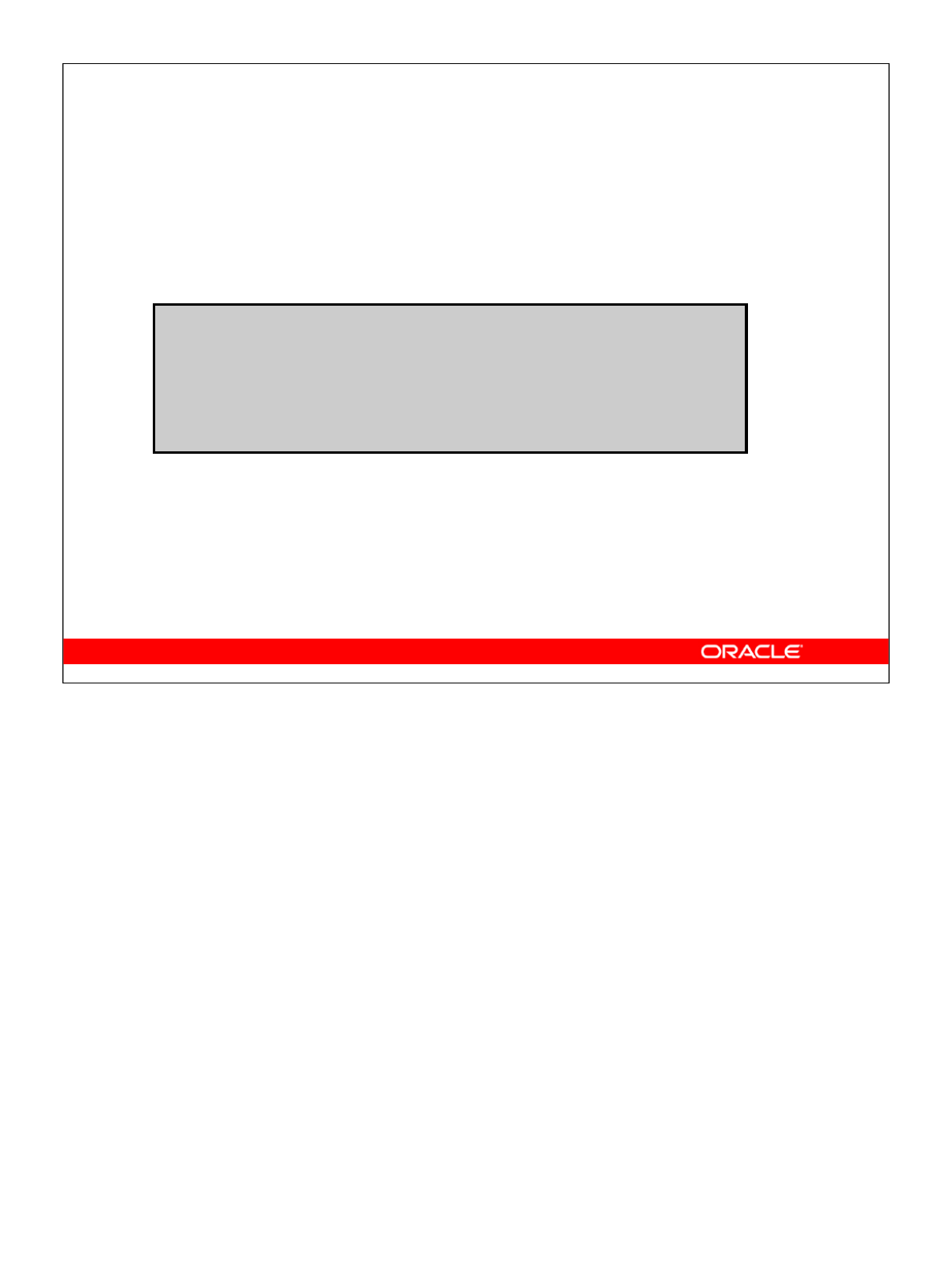
Oracle Database 10g: Develop PL/SQL Program Units 6-6
6-6 Copyright © 2004, Oracle. All rights reserved.
EXECUTE IMMEDIATE dynamic_string
[INTO {define_variable
[, define_variable] ... | record}]
[USING [IN|OUT|IN OUT] bind_argument
[, [IN|OUT|IN OUT] bind_argument] ... ];
Using the EXECUTE IMMEDIATE Statement
Use the EXECUTE IMMEDIATE statement for Native
Dynamic SQL or PL/SQL anonymous blocks:
•INTO is used for single-row queries and specifies
the variables or records into which column values
are retrieved.
•USING is used to hold all bind arguments. The
default parameter mode is IN, if not specified.
Using the EXECUTE IMMEDIATE Statement
The EXECUTE IMMEDIATE statement can be used to execute SQL statements or
PL/SQL anonymous blocks. The syntactical elements include the following:
•dynamic_string is a string expression that represents a dynamic SQL statement
(without terminator) or a PL/SQL block (with terminator).
•define_variable is a PL/SQL variable that stores the selected column value.
•record is a user-defined or %ROWTYPE record that stores a selected row.
•bind_argument is an expression whose value is passed to the dynamic SQL
statement or PL/SQL block.
•INTO clause specifies the variables or record into which column values are retrieved.
It is used only for single-row queries. For each value retrieved by the query, there
must be a corresponding, type-compatible variable or field in the INTO clause.
•USING clause holds all bind arguments. The default parameter mode is IN.
You can use numeric, character, and string literals as bind arguments, but you cannot use
Boolean literals (TRUE, FALSE, and NULL).
Note: Use OPEN-FOR, FETCH, and CLOSE for a multirow query. The syntax shown in
the slide is not complete as support exists for bulk-processing operations, which is a topic
that is not covered in this course.

Oracle Database 10g: Develop PL/SQL Program Units 6-7
6-7 Copyright © 2004, Oracle. All rights reserved.
Dynamic SQL with a DDL Statement
•Creating a table:
•Call example:
CREATE PROCEDURE create_table(
table_name VARCHAR2, col_specs VARCHAR2) IS
BEGIN
EXECUTE IMMEDIATE 'CREATE TABLE '||table_name||
' (' || col_specs || ')';
END;
/
BEGIN
create_table('EMPLOYEE_NAMES',
'id NUMBER(4) PRIMARY KEY, name VARCHAR2(40)');
END;
/
Dynamic SQL with a DDL Statement
The code examples show the creation of a create_table procedure that accepts the
table name and column definitions (specifications) as parameters.
The call shows the creation of a table called EMPLOYEE_NAMES with two columns:
• An ID column with a NUMBER data type used as a primary key
• A name column of up to 40 characters for the employee name
Any DDL statement can be executed by using the syntax shown in the slide, whether the
statement is dynamically constructed or specified as a literal string. You can create and
execute a statement that is stored in a PL/SQL string variable, as in the following example:
CREATE PROCEDURE add_col(table_name VARCHAR2,
col_spec VARCHAR2) IS
stmt VARCHAR2(100) := 'ALTER TABLE ' || table_name ||
' ADD '||col_spec;
BEGIN
EXECUTE IMMEDIATE stmt;
END;
/
To add a new column to a table, enter:
EXECUTE add_col('employee_names', 'salary number(8,2)')

Oracle Database 10g: Develop PL/SQL Program Units 6-8
6-8 Copyright © 2004, Oracle. All rights reserved.
Dynamic SQL with DML Statements
•Deleting rows from any table:
•Inserting a row into a table with two columns:
CREATE FUNCTION del_rows(table_name VARCHAR2)
RETURN NUMBER IS
BEGIN
EXECUTE IMMEDIATE 'DELETE FROM '||table_name;
RETURN SQL%ROWCOUNT;
END;
BEGIN DBMS_OUTPUT.PUT_LINE(
del_rows('EMPLOYEE_NAMES')|| ' rows deleted.');
END;
CREATE PROCEDURE add_row(table_name VARCHAR2,
id NUMBER, name VARCHAR2) IS
BEGIN
EXECUTE IMMEDIATE 'INSERT INTO '||table_name||
' VALUES (:1, :2)' USING id, name;
END;
Dynamic SQL with DML Statements
The examples in the slide demonstrate the following:
• The del_rows function deletes rows from a specified table and returns the number
of rows deleted by using the implicit SQL cursor %ROWCOUNT attribute. Executing
the function is shown below the example for creating a function.
• The add_row procedure shows how to provide input values to a dynamic SQL
statement with the USING clause. The bind variable names :1 and :2 are not
important, but the order of the variable names (id and name) in the USING clause
is associated to the bind variables by position, in the order of their respective
appearance. Therefore, the PL/SQL variable id is assigned to the :1 placeholder,
and the name variable is assigned to the :2 placeholder. Placeholder/bind variable
names can be alphanumeric but must be preceded with a colon.
Note: The EXECUTE IMMEDIATE statement prepares (parses) and immediately executes
the dynamic SQL statement. Dynamic SQL statements are always parsed.
Also, note that a COMMIT operation is not performed in either of the examples. Therefore,
the operations can be undone with a ROLLBACK statement.
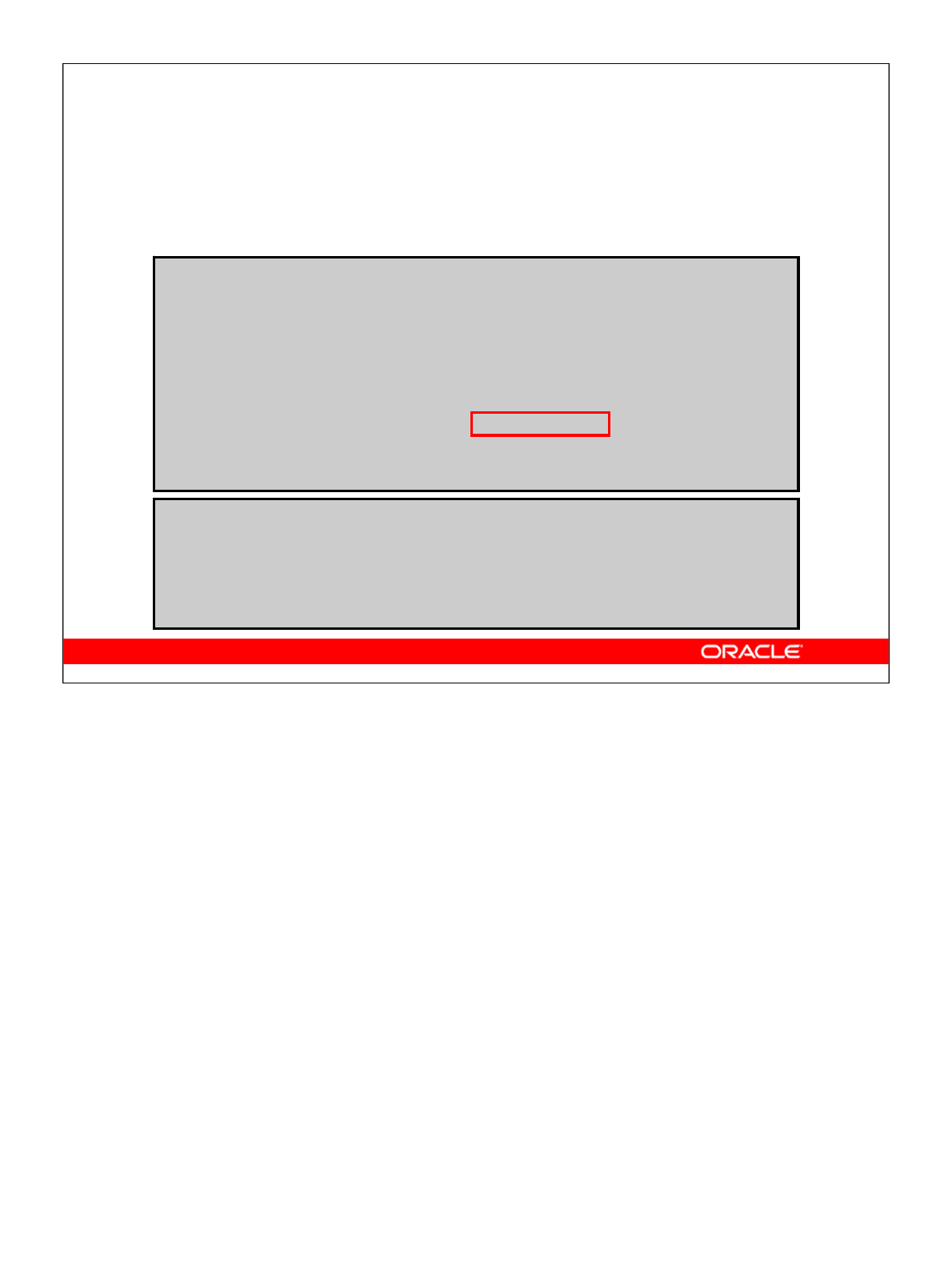
Oracle Database 10g: Develop PL/SQL Program Units 6-9
6-9 Copyright © 2004, Oracle. All rights reserved.
Dynamic SQL with a Single-Row Query
Example of a single-row query:
CREATE FUNCTION get_emp(emp_id NUMBER)
RETURN employees%ROWTYPE IS
stmt VARCHAR2(200);
emprec employees%ROWTYPE;
BEGIN
stmt := 'SELECT * FROM employees ' ||
'WHERE employee_id = :id';
EXECUTE IMMEDIATE stmt INTO emprec USING emp_id;
RETURN emprec;
END;
/
DECLARE
emprec employees%ROWTYPE := get_emp(100);
BEGIN
DBMS_OUTPUT.PUT_LINE('Emp: '||emprec.last_name);
END;
/
Dynamic SQL with a Single-Row Query
The single-row query example demonstrates the get_emp function that retrieves an
EMPLOYEES record into a variable specified in the INTO clause. It also shows how to
provide input values for the WHERE clause.
The anonymous block is used to execute the get_emp function and return the result into
a local EMPLOYEES record variable.
The example could be enhanced to provide alternative WHERE clauses depending on input
parameter values, making it more suitable for dynamic SQL processing.
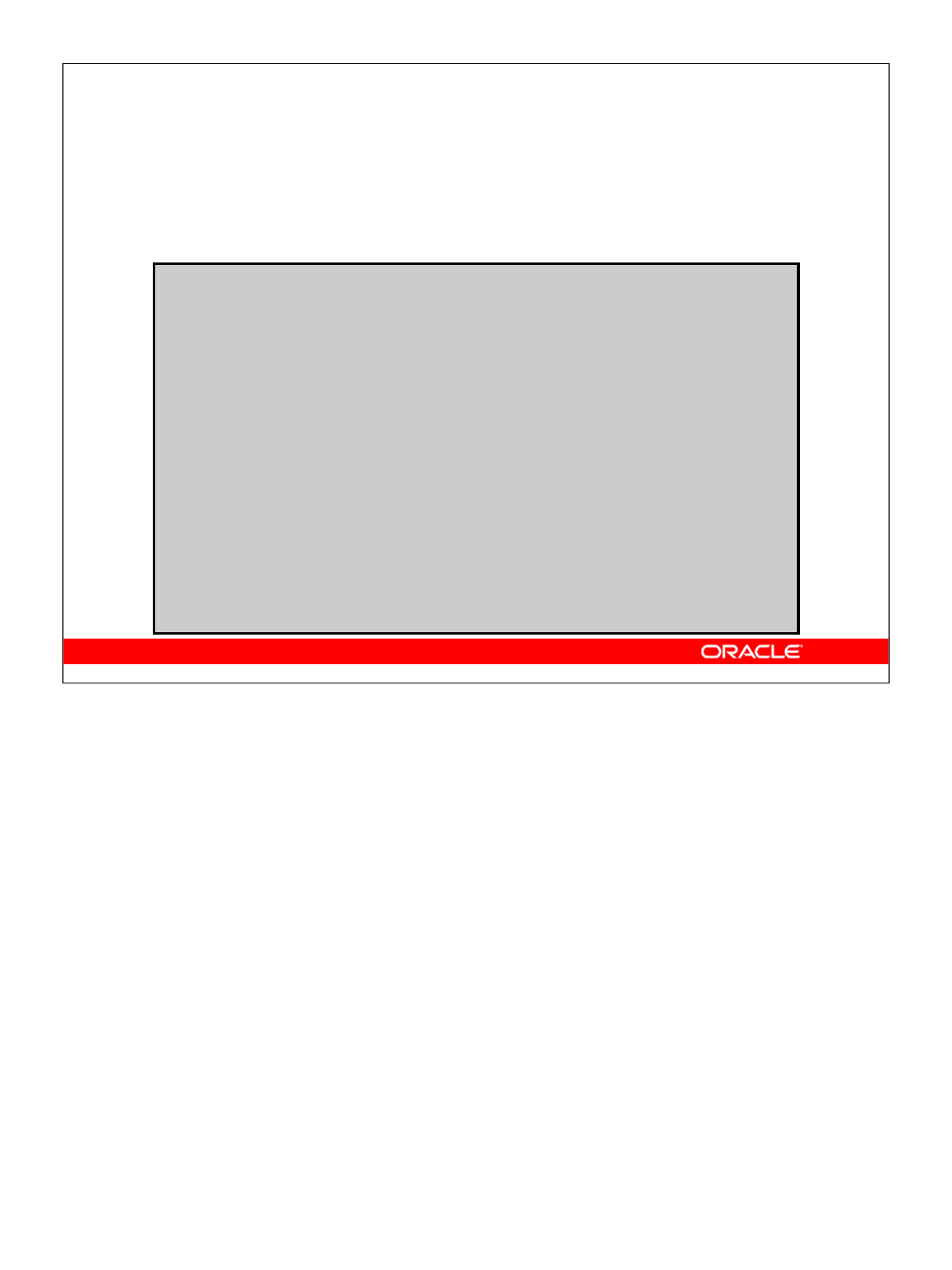
Oracle Database 10g: Develop PL/SQL Program Units 6-10
6-10 Copyright © 2004, Oracle. All rights reserved.
Dynamic SQL with a Multirow Query
Use OPEN-FOR, FETCH, and CLOSE processing:
CREATE PROCEDURE list_employees(deptid NUMBER) IS
TYPE emp_refcsr IS REF CURSOR;
emp_cv emp_refcsr;
emprec employees%ROWTYPE;
stmt varchar2(200) := 'SELECT * FROM employees';
BEGIN
IF deptid IS NULL THEN OPEN emp_cv FOR stmt;
ELSE
stmt := stmt || ' WHERE department_id = :id';
OPEN emp_cv FOR stmt USING deptid;
END IF;
LOOP
FETCH emp_cv INTO emprec;
EXIT WHEN emp_cv%NOTFOUND;
DBMS_OUTPUT.PUT_LINE(emprec.department_id||
' ' ||emprec.last_name);
END LOOP;
CLOSE emp_cv;
END;
Dynamic SQL with a Multirow Query
The example in the slide shows how to execute a multirow query by performing the
following programming steps:
• Declaring a REF CURSOR type
• Declaring a cursor variable based on the REF CURSOR type name that you declare
• Executing an OPEN-FOR statement that uses the cursor variable
• Using a FETCH statement referencing the cursor variable until all records are
processed
• Executing the CLOSE statement by using the cursor variable
This process is the same as using static cursor definitions. However, the OPEN-FOR
syntax accepts a string literal or variable specifying the SELECT statement, which can be
dynamically constructed.
Note: The next page provides a brief introduction to the REF CURSOR type and cursor
variables. An alternative to this is using the BULK COLLECT syntax supported by Native
Dynamic SQL statements (a topic that is not covered in this course).
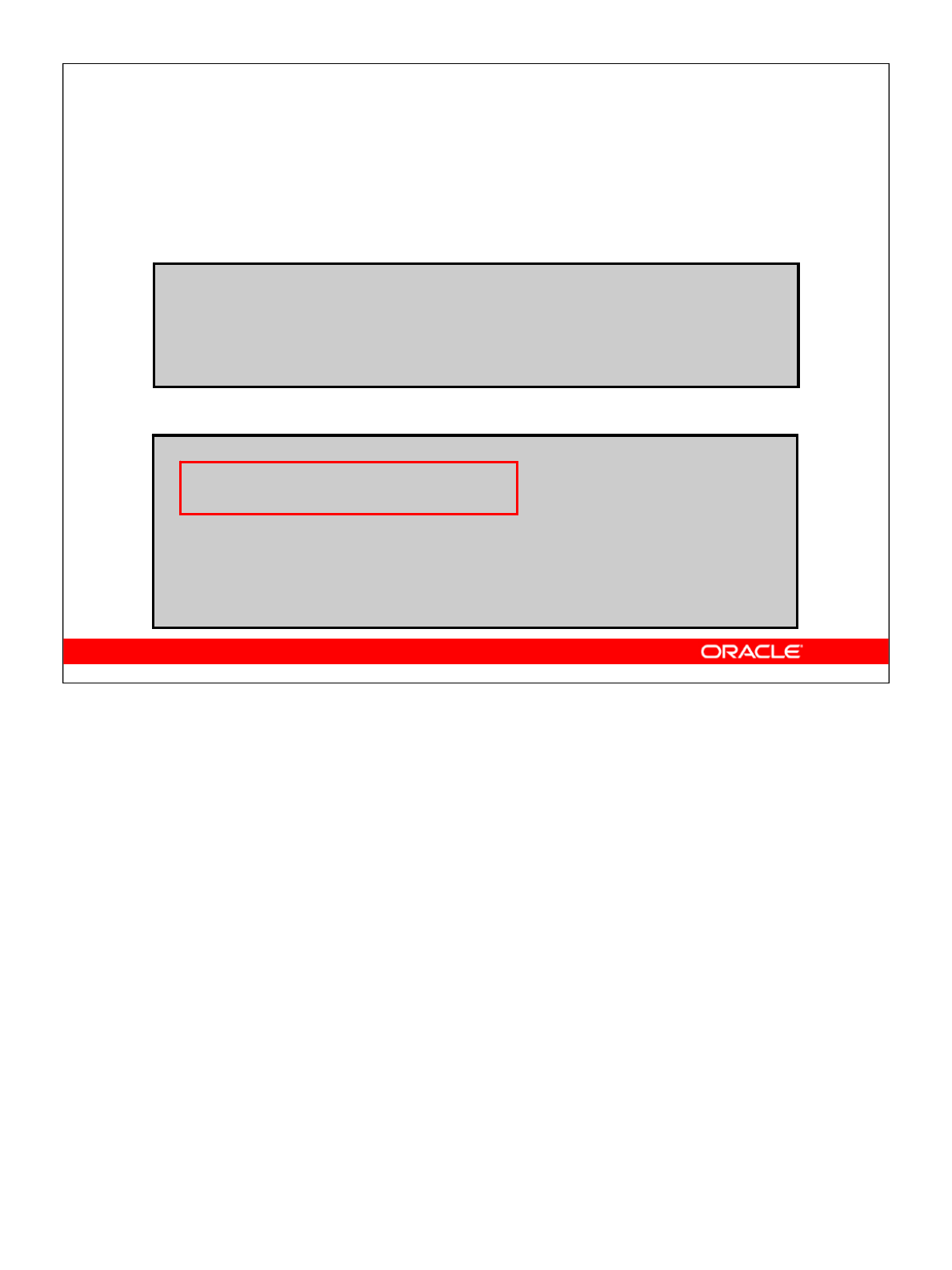
Oracle Database 10g: Develop PL/SQL Program Units 6-11
6-11 Copyright © 2004, Oracle. All rights reserved.
Declaring Cursor Variables
•Declare a cursor type as REF CURSOR:
•Declare a cursor variable using the cursor type:
CREATE PROCEDURE process_data IS
TYPE ref_ctype IS REF CURSOR; -- weak ref cursor
TYPE emp_ref_ctype IS REF CURSOR -- strong
RETURN employees%ROWTYPE;
:
:
dept_csrvar ref_ctype;
emp_csrvar emp_ref_ctype;
BEGIN
OPEN emp_csrvar FOR SELECT * FROM employees;
OPEN dept_csrvar FOR SELECT * from departments;
-- Then use as normal cursors
END;
Declaring Cursor Variables
A cursor variable is a PL/SQL identifier whose type name has been declared as a REF
CURSOR type. Creating a cursor variable involves two steps:
• Declaring a type name as a REF CURSOR type
• Declaring a PL/SQL variable by using the type name declared as a REF CURSOR
type
The slide examples create two reference cursor types:
• The ref_ctype is a generic reference cursor, known as a weak reference cursor. A
weak reference cursor can be associated with any query.
• The emp_ref_ctype is a strong reference cursor type that must be associated with
a type-compatible query: the query must return data that is compatible with the type
specified after the RETURN keyword (for example, an EMPLOYEES row type).
After a cursor variable is declared by using a reference cursor type name, the cursor
variable associated with a query is opened using the OPEN-FOR syntax shown. The
standard FETCH, cursor attributes, and CLOSE operations used with explicit cursors are
also applicable with cursor variables. To compare cursor variables with explicit cursors:
• A cursor variable can be associated with more than one query at run time
• An explicit cursor is associated with one query at compilation time

Oracle Database 10g: Develop PL/SQL Program Units 6-12
6-12 Copyright © 2004, Oracle. All rights reserved.
Dynamically Executing a PL/SQL Block
Executing a PL/SQL anonymous block dynamically:
CREATE FUNCTION annual_sal(emp_id NUMBER)
RETURN NUMBER IS
plsql varchar2(200) :=
'DECLARE '||
' emprec employees%ROWTYPE; '||
'BEGIN '||
' emprec := get_emp(:empid); ' ||
' :res := emprec.salary * 12; ' ||
'END;';
result NUMBER;
BEGIN
EXECUTE IMMEDIATE plsql
USING IN emp_id, OUT result;
RETURN result;
END;
/
EXECUTE DBMS_OUTPUT.PUT_LINE(annual_sal(100))
Dynamically Executing a PL/SQL Block
The annual_sal function dynamically constructs an anonymous PL/SQL block. The
PL/SQL block contains bind variables for:
• The input of the employee ID using the :empid placeholder
• The output result computing the annual employees salary using the placeholder
called :res
Note: This example demonstrates how to use the OUT result syntax (in the USING clause
of the EXECUTE IMMEDIATE statement) to obtain the result calculated by the PL/SQL
block. The procedure output variables and function return values can be obtained in a
similar way from a dynamically executed anonymous PL/SQL block.
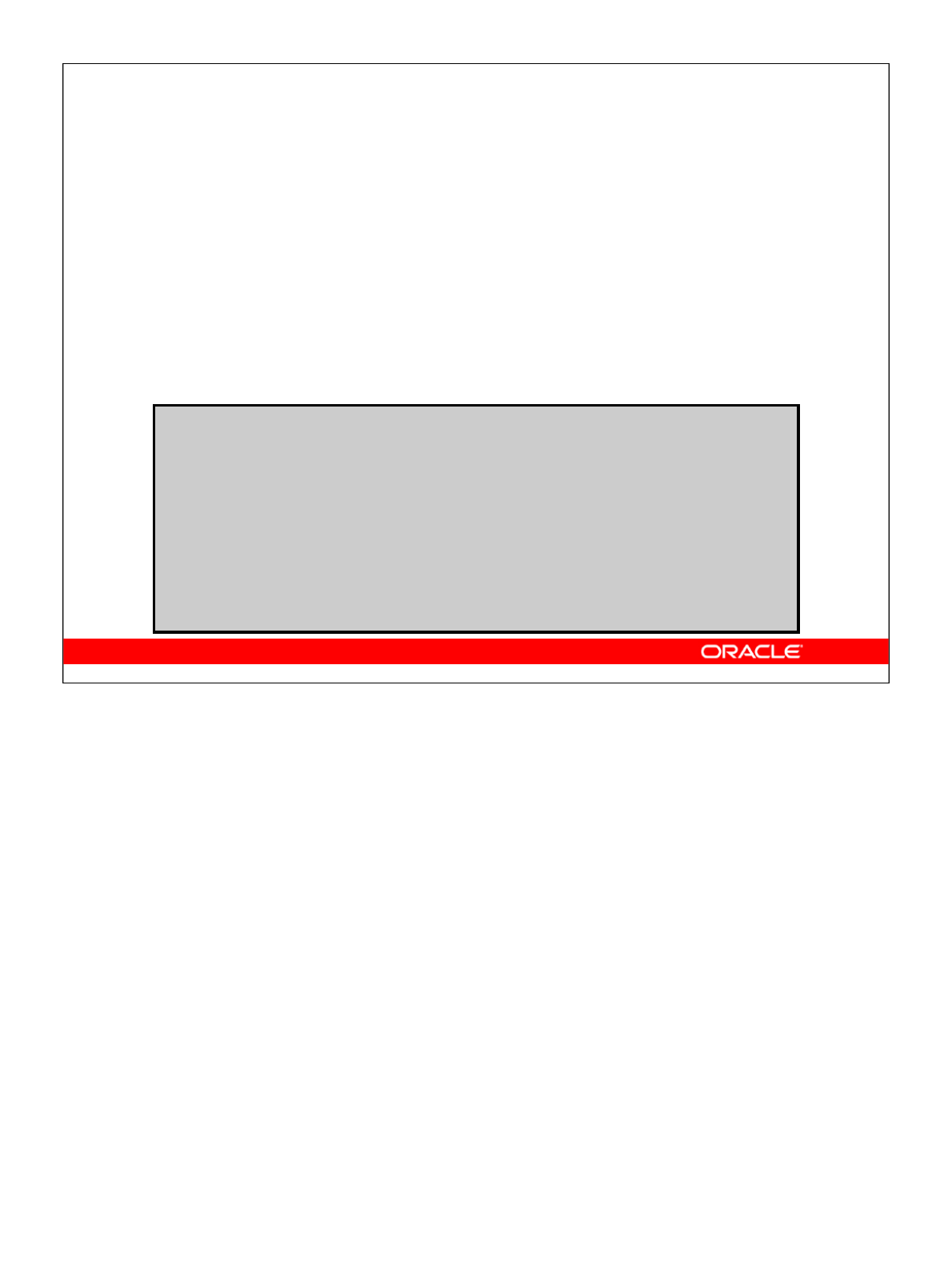
Oracle Database 10g: Develop PL/SQL Program Units 6-13
6-13 Copyright © 2004, Oracle. All rights reserved.
Using Native Dynamic SQL
to Compile PL/SQL Code
Compile PL/SQL code with the ALTER statement:
•ALTER PROCEDURE name COMPILE
•ALTER FUNCTION name COMPILE
•ALTER PACKAGE name COMPILE SPECIFICATION
•ALTER PACKAGE name COMPILE BODY
CREATE PROCEDURE compile_plsql(name VARCHAR2,
plsql_type VARCHAR2, options VARCHAR2 := NULL) IS
stmt varchar2(200) := 'ALTER '|| plsql_type ||
' '|| name || ' COMPILE';
BEGIN
IF options IS NOT NULL THEN
stmt := stmt || ' ' || options;
END IF;
EXECUTE IMMEDIATE stmt;
END;
/
Using Native Dynamic SQL to Compile PL/SQL Code
The compile_plsql procedure in the example can be used to compile different
PL/SQL code using the ALTER DDL statement. Four basic forms of the ALTER statement
are shown to compile:
• A procedure
• A function
• A package specification
• A package body
Note: If you leave out the keyword SPECIFICATION or BODY with the ALTER
PACKAGE statement, then the specification and body are both compiled.
Here are examples of calling the procedure in the slide for each of the four cases,
respectively:EXEC compile_plsql ('list_employees', 'procedure')
EXEC compile_plsql ('get_emp', 'function')
EXEC compile_plsql ('mypack', 'package',
'specification')
EXEC compile_plsql ('mypack', 'package', 'body')
Compiling with DEBUG enabled for the get_emp function:
EXEC compile_plsql ('get_emp', 'function', 'debug')

Oracle Database 10g: Develop PL/SQL Program Units 6-14
6-14 Copyright © 2004, Oracle. All rights reserved.
Using the DBMS_SQL Package
The DBMS_SQL package is used to write dynamic SQL
in stored procedures and to parse DDL statements.
Some of the procedures and functions of the package
include:
•OPEN_CURSOR
•PARSE
•BIND_VARIABLE
•EXECUTE
•FETCH_ROWS
•CLOSE_CURSOR
Using the DBMS_SQL Package
Using DBMS_SQL, you can write stored procedures and anonymous PL/SQL blocks that
use dynamic SQL, such as executing DDL statements in PL/SQL—for example, executing
a DROP TABLE statement. The operations provided by this package are performed under
the current user, not under the package owner SYS. The DBMS_SQL package provides the
following subprograms to execute dynamic SQL:
•OPEN_CURSOR to open a new cursor and return a cursor ID number
•PARSE to parse the SQL statement, that is, it checks the statement syntax and
associates it with the opened cursor. DDL statements are immediately executed when
parsed.
•BIND_VARIABLE to bind a given value to a bind variable identified by its name in
the statement being parsed. Not needed if the statement does not have bind variables.
•EXECUTE to execute the SQL statement and return the number of rows processed
•FETCH_ROWS to retrieve the next row for a query (use in a loop for multiple rows)
•CLOSE_CURSOR to close the specified cursor
Note: Using the DBMS_SQL package to execute DDL statements can result in a deadlock.
For example, the most likely reason is that the package is being used to drop a procedure
that you are still using.

Oracle Database 10g: Develop PL/SQL Program Units 6-15
6-15 Copyright © 2004, Oracle. All rights reserved.
BEGIN DBMS_OUTPUT.PUT_LINE('Rows Deleted: ' ||
delete_all_rows('employees'));
END;
CREATE OR REPLACE FUNCTION delete_all_rows
(table_name VARCHAR2) RETURN NUMBER IS
csr_id INTEGER;
rows_del NUMBER;
BEGIN
csr_id := DBMS_SQL.OPEN_CURSOR;
DBMS_SQL.PARSE(csr_id,
'DELETE FROM '||table_name, DBMS_SQL.NATIVE);
rows_del := DBMS_SQL.EXECUTE (csr_id);
DBMS_SQL.CLOSE_CURSOR(csr_id);
RETURN rows_del;
END;
/
Using DBMS_SQL with a DML Statement
Example of deleting rows:
Using DBMS_SQL with a DML Statement
In the slide, the table name is passed into the delete_all_rows function. The function
uses dynamic SQL to delete rows from the specified table, and returns a count representing
the number of rows that are deleted after successful execution of the statement.
To process a DML statement dynamically, perform the following steps:
1. Use OPEN_CURSOR to establish an area in memory to process a SQL statement.
2. Use PARSE to establish the validity of the SQL statement.
3. Use the EXECUTE function to run the SQL statement. This function returns the
number of rows processed.
4. Use CLOSE_CURSOR to close the cursor.
The steps to execute a DDL statement are similar; but step 3 is optional because a DDL
statement is immediately executed when the PARSE is successfully done, that is, the
statement syntax and semantics are correct. If you use the EXECUTE function with a DDL
statement, then it does not do anything and returns a value of 0for the number of rows
processed, as DDL statements do not process rows.
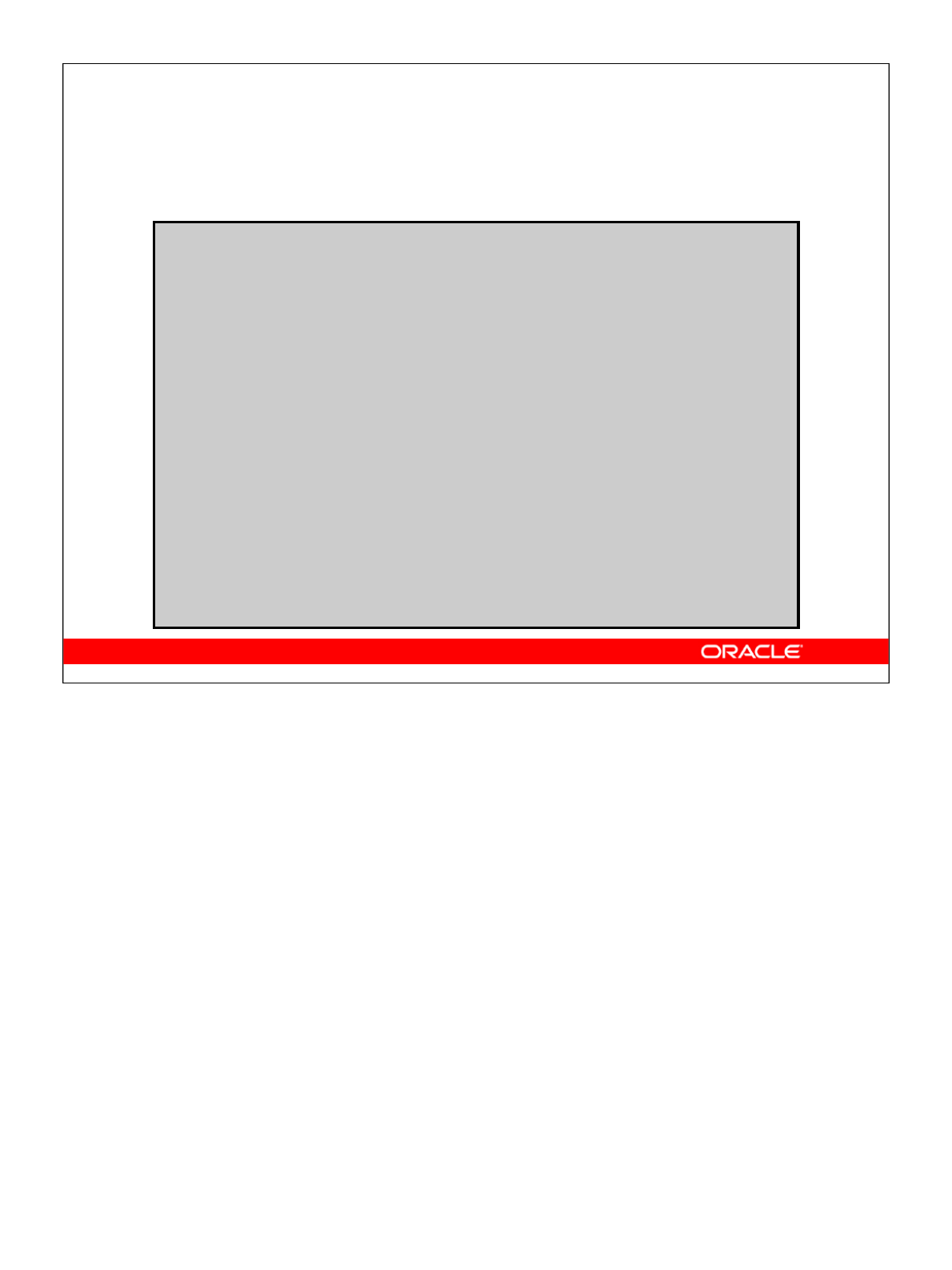
Oracle Database 10g: Develop PL/SQL Program Units 6-16
6-16 Copyright © 2004, Oracle. All rights reserved.
Using DBMS_SQL with a Parameterized
DML Statement
CREATE PROCEDURE insert_row (table_name VARCHAR2,
id VARCHAR2, name VARCHAR2, region NUMBER) IS
csr_id INTEGER;
stmt VARCHAR2(200);
rows_added NUMBER;
BEGIN
stmt := 'INSERT INTO '||table_name||
' VALUES (:cid, :cname, :rid)';
csr_id := DBMS_SQL.OPEN_CURSOR;
DBMS_SQL.PARSE(csr_id, stmt, DBMS_SQL.NATIVE);
DBMS_SQL.BIND_VARIABLE(csr_id, ':cid', id);
DBMS_SQL.BIND_VARIABLE(csr_id, ':cname', name);
DBMS_SQL.BIND_VARIABLE(csr_id, ':rid', region);
rows_added := DBMS_SQL.EXECUTE(csr_id);
DBMS_SQL.CLOSE_CURSOR(csr_id);
DBMS_OUTPUT.PUT_LINE(rows_added||' row added');
END;
/
Using DBMS_SQL with a Parameterized DML Statement
The example in the slide performs the DML operation to insert a row into a specified table.
The example demonstrates the extra step required to associate values to bind variables that
exist in the SQL statement. For example, a call to the above procedure is:
EXECUTE insert_row('countries', 'ZA', 'South Africa', 4)
After the statement is parsed, you must call the DBMS_SQL.BIND_VARIABLE
procedure to assign values for each bind variable that exists in the statement. The binding
of values must be done before executing the code. To process a SELECT statement
dynamically, perform the following steps after opening and before closing the cursor:
1. Execute DBMS_SQL.DEFINE_COLUMN for each column selected.
2. Execute DBMS_SQL.BIND_VARIABLE for each bind variable in the query.
3. For each row, do the following:
a. Execute DBMS_SQL.FETCH_ROWS to retrieve a row and return the number of
rows fetched. Stop additional processing when a zero value is returned.
b. Execute DBMS_SQL.COLUMN_VALUE to retrieve each selected column value
into PL/SQL variable for processing.
Although this coding process is not complex, it is more time consuming to write and is
prone to error compared with using the Native Dynamic SQL approach.

Oracle Database 10g: Develop PL/SQL Program Units 6-17
6-17 Copyright © 2004, Oracle. All rights reserved.
Comparison of Native Dynamic SQL and
the DBMS_SQL Package
Native Dynamic SQL:
•Is easier to use than DBMS_SQL
•Requires less code than DBMS_SQL
•Enhances performance because the PL/SQL
interpreter provides native support for it
•Supports all types supported by static SQL in
PL/SQL, including user-defined types
•Can fetch rows directly into PL/SQL records
Comparison of Native Dynamic SQL and the DBMS_SQL Package
Native Dynamic SQL provides the following advantages over the DBMS_SQL package.
Ease of use: Because Native Dynamic SQL is integrated with SQL, you can use it in the
same way that you currently use static SQL within PL/SQL code. The code is typically
more compact and readable compared with the code written with the DBMS_SQL package.
Performance improvement: Native Dynamic SQL performs significantly better than
DBMS_SQL, in most circumstances, due to native support provided by the PL/SQL
interpreter. The DBMS_SQL approach uses a procedural API and suffers from high
procedure call and data copy overhead.
Support for user-defined types: Native Dynamic SQL supports all the types supported by
static SQL in PL/SQL. Therefore, Native Dynamic SQL provides support for user-defined
types such as user-defined objects, collections, and REFs. The DBMS_SQL package does
not support these user-defined types. However, it has limited support for arrays.
Support for fetching into records: With Native Dynamic SQL, the rows resulting from a
query can be directly fetched into PL/SQL records. The DBMS_SQL package does not
support fetching into records structures.
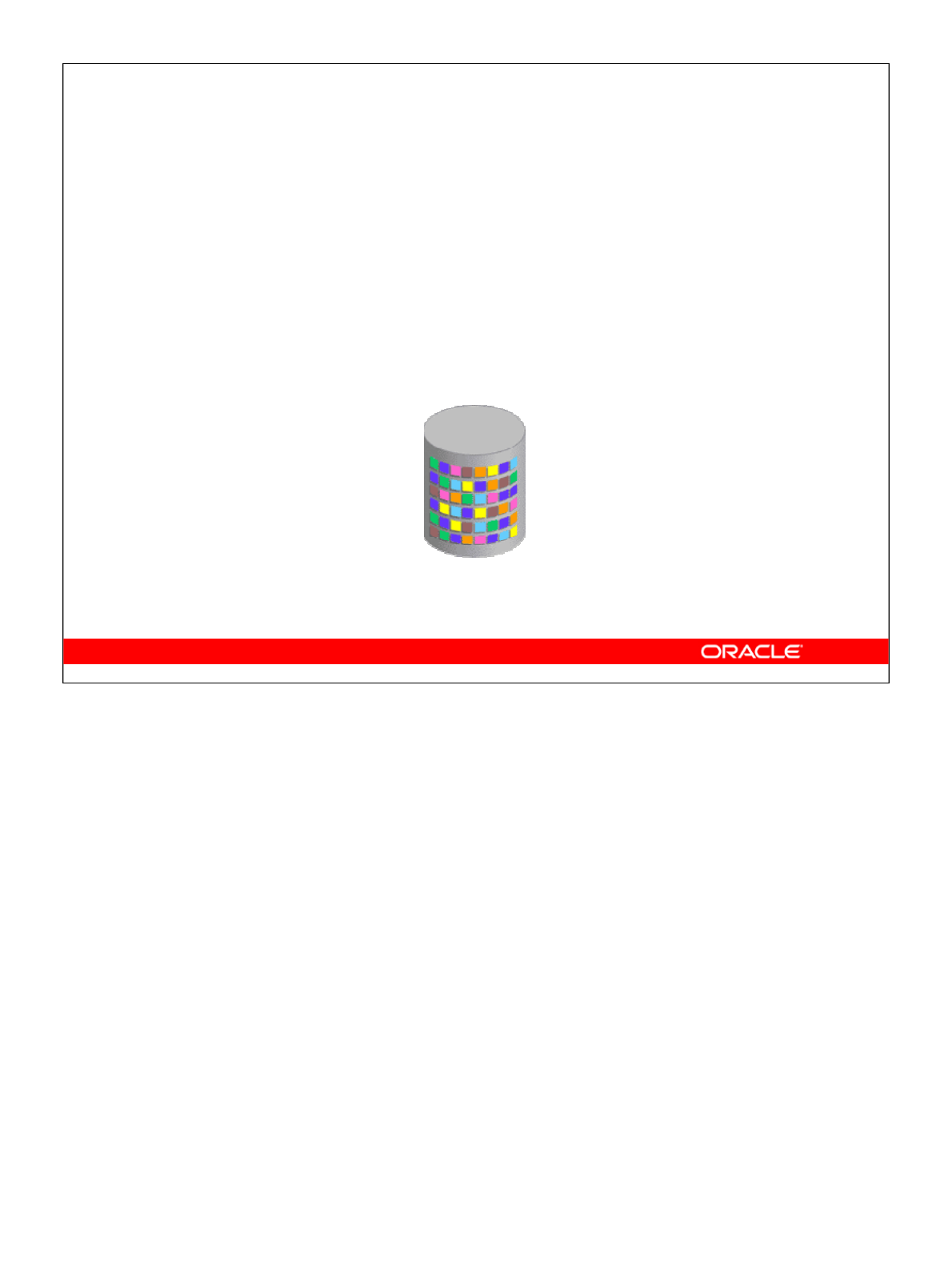
Oracle Database 10g: Develop PL/SQL Program Units 6-18
6-18 Copyright © 2004, Oracle. All rights reserved.
DBMS_METADATA Package
The DBMS_METADATA package provides a centralized
facility for the extraction, manipulation, and
resubmission of dictionary metadata.
DBMS_METADATA Package
You can invoke DBMS_METADATA to retrieve metadata from the database dictionary as
XML or creation DDL, and submit the XML to re-create the object.
You can use DBMS_METADATA for extracting metadata from the dictionary, manipulating
the metadata (adding columns, changing column data types, and so on), and then
converting the metadata to data definition language (DDL) so that the object can be re-
created on the same or another database. In the past, you needed to do this
programmatically with problems resulting in each new release.
The DBMS_METADATA functionality is used for the Oracle 10g Export/Import
replacement, commonly called “the Data Pump.”
This package was introduced in Oracle9iand is further enhanced in Oracle Database 10g.
Note: For more information about the DBMS_DATAPUMP package, refer to the eStudy
titled Oracle Database 10g: Reduce Management - Tools and Utilities.

Oracle Database 10g: Develop PL/SQL Program Units 6-19
6-19 Copyright © 2004, Oracle. All rights reserved.
Metadata API
Processing involves the following steps:
1. Fetch an object’s metadata as XML.
2. Transform the XML in a variety of ways (including
transforming it into SQL DDL).
3. Submit the XML to re-create the object.
Metadata API
Every entity in the database is modeled as an object that belongs to an object type. For
example, the EMPLOYEES table is an object; its object type is TABLE. When you fetch an
object's metadata, you must specify the object type.
Every object type is implemented by using three entities:
• A user-defined type (UDT) whose attributes comprise all the metadata for objects of
the type. An object's XML representation is a translation of a type instance into
XML, with the XML tag names derived from the type attribute names. (In the case of
tables, several UDTs are needed to represent the different varieties of the object
type.)
• An object view of the UDT that populates instances of the object type
• An XSL (Extensible Style Sheet Language) script that converts the XML
representation of an object into SQL DDL

Oracle Database 10g: Develop PL/SQL Program Units 6-20
6-20 Copyright © 2004, Oracle. All rights reserved.
Subprograms in DBMS_METADATA
Returns the text of the queries that will be used by FETCH_xxx
GET_QUERY
Enables output parsing and specifies an object attribute to be
parsed and returned
SET_PARSE_ITEM
Specifies a transform that FETCH_xxx applies to the XML
representation of the retrieved objects
ADD_TRANSFORM
Specifies parameters to the XSLT stylesheet identified by
transform_handle
SET_TRANSFORM_PARAM,
SET_REMAP_PARAM
Returns metadata for objects meeting the criteria established by
OPEN, SET_FILTER
FETCH_XXX
Specifies restrictions on the objects to be retrieved such as the
object name or schema
SET_FILTER
Specifies the maximum number of objects to be retrieved in a
single FETCH_xxx call
SET_COUNT
Invalidates the handle returned by OPEN and cleans up the
associated state
CLOSE
Specifies the type of object to be retrieved, the version of its
metadata, and the object model. The return value is an opaque
context handle for the set of objects.
OPEN
DescriptionName
Subprograms in DBMS_METADATA
The table provides an overview of the procedures and functions available in the
DBMS_METADATA package. To retrieve metadata, you can specify:
• The kind of object retrieved, either an object type (a table, index, procedure) or a
heterogeneous collection of object types forming a logical unit (such as database
export and schema export)
• Selection criteria (owner, name, and so on)
•“parse items” attributes of objects to be parsed and returned separately
• Transformations on the output, implemented by XSLT scripts
The package provides two types of retrieval interface for two types of usage:
• For programmatic use: OPEN, SET_FILTER, SET_COUNT, GET_QUERY,
SET_PARSE_ITEM, ADD_TRANSFORM, SET_TRANSFORM_PARAM,
SET_REMAP_PARAM (new in Oracle Database 10g), FETCH_xxx, and CLOSE.
These enable flexible selection criteria and the extraction of a stream of objects.
• For use in SQL queries and for ad hoc browsing: The GET_xxx interfaces
(GET_XML and GET_DDL) return metadata for a single named object. The
GET_DEPENDENT_xxx and GET_GRANTED_xxx interfaces return metadata for
one or more dependent or granted objects. None of these APIs support heterogeneous
object types.
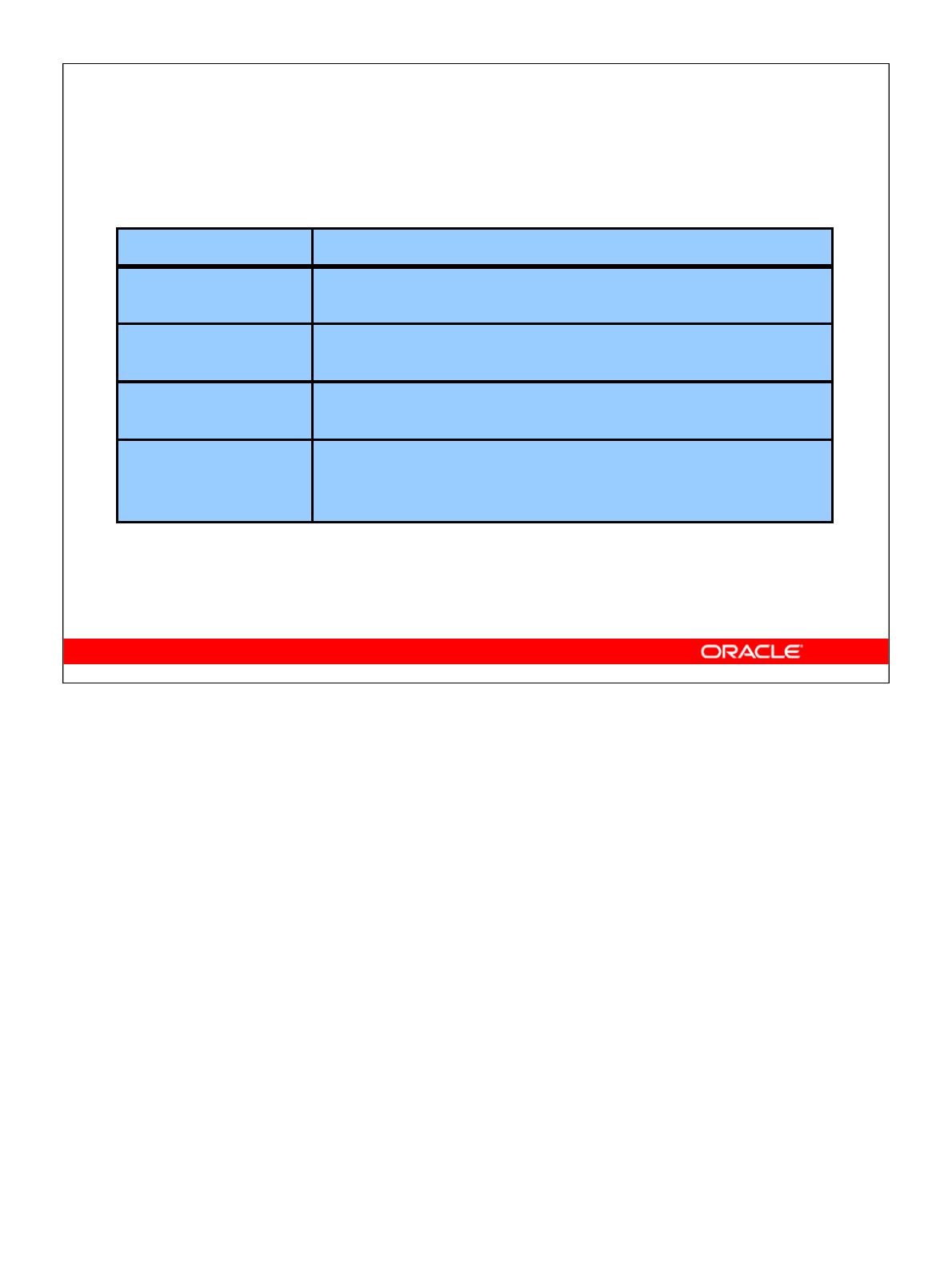
Oracle Database 10g: Develop PL/SQL Program Units 6-21
6-21 Copyright © 2004, Oracle. All rights reserved.
FETCH_xxx Subprograms
This procedure returns the XML metadata for the
objects as a CLOB in an IN OUT NOCOPY
parameter to avoid expensive LOB copies.
FETCH_XML_CLOB
This function returns the DDL (either to create or to
drop the object) into a predefined nested table.
FETCH_DDL
This function returns the objects, transformed or
not, as a CLOB.
FETCH_CLOB
This function returns the XML metadata for an
object as an XMLType.
FETCH_XML
DescriptionName
FETCH_xxx Subprograms
These functions and procedures return metadata for objects meeting the criteria established
by the call to the OPEN function that returned the handle, and the subsequent calls to
SET_FILTER, SET_COUNT, ADD_TRANSFORM, and so on. Each call to FETCH_xxx
returns the number of objects specified by SET_COUNT (or a smaller number, if fewer
objects remain in the current cursor) until all objects have been returned.
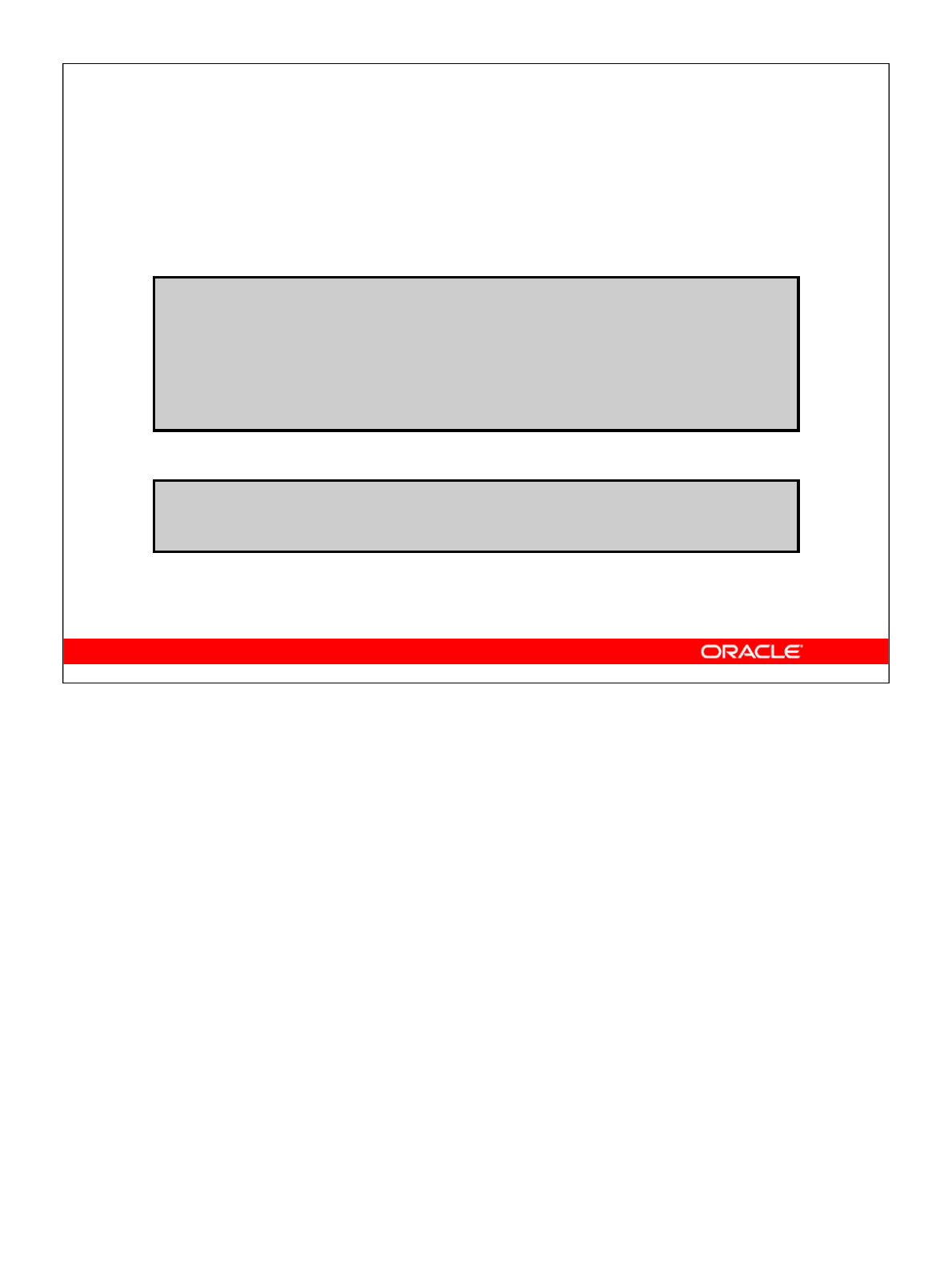
Oracle Database 10g: Develop PL/SQL Program Units 6-22
6-22 Copyright © 2004, Oracle. All rights reserved.
SET_FILTER Procedure
•Syntax:
•Example:
PROCEDURE set_filter
( handle IN NUMBER,
name IN VARCHAR2,
value IN VARCHAR2|BOOLEAN|NUMBER,
object_type_path VARCHAR2
);
...
DBMS_METADATA.SET_FILTER (handle, 'NAME', 'HR');
...
SET_FILTER Procedure
You use the SET_FILTER procedure to identify restrictions on objects that are to be
retrieved. For example, you can specify restrictions on an object or schema that is being
retrieved. This procedure is overloaded with the parameters having the following
meanings:
•handle is the handle returned from the OPEN function.
•name is the name of the filter. For each filter, the object type applies to its name,
data type (text or Boolean), and meaning or effect (including its default value, if
there is one).
•value is the value of the filter. It can be text, Boolean, or a numeric value.
•object_type_path is a path name designating the object types to which the
filter applies. By default, the filter applies to the object type of the OPEN handle.
If you use an expression filter, then it is placed to the right of a SQL comparison, and the
value is compared with it. The value must contain parentheses and quotation marks where
appropriate. A filter value is combined with a particular object attribute to produce a
WHERE condition in the query that fetches the objects.

Oracle Database 10g: Develop PL/SQL Program Units 6-23
6-23 Copyright © 2004, Oracle. All rights reserved.
Filters
There are over 70 filters, which are organized into
object type categories such as:
•Named objects
•Tables
•Objects dependent on tables
•Index
•Dependent objects
•Granted objects
•Table data
•Index statistics
•Constraints
•All object types
•Database export
Filters
There are over 70 filters that you can specify when using the SET_FILTER procedure.
These filters are organized into object type categories. Some of the new object type
categories in Oracle Database 10g are listed in the slide.
When using the SET_FILTER procedure, you specify the name of the filter and its
respective value.
For example, you can use the SCHEMA filter with a value to identify the schema whose
objects are selected. Then use a second call to the SET_FILTER procedure and use a
filter named INCLUDE_USER that has a Boolean data type for its value. If it is set to
TRUE, then objects containing privileged information about the user are retrieved.
DBMS_METADATA.SET_FILTER(handle, SCHEMA, 'HR');
DBMS_METADATA. SET_FILTER(handle, INCLUDE_USER, TRUE);
Each call to SET_FILTER causes a WHERE condition to be added to the underlying query
that fetches the set of objects. The WHERE conditions are combined using an AND
operator, so you can use multiple SET_FILTER calls to refine the set of objects to be
returned.
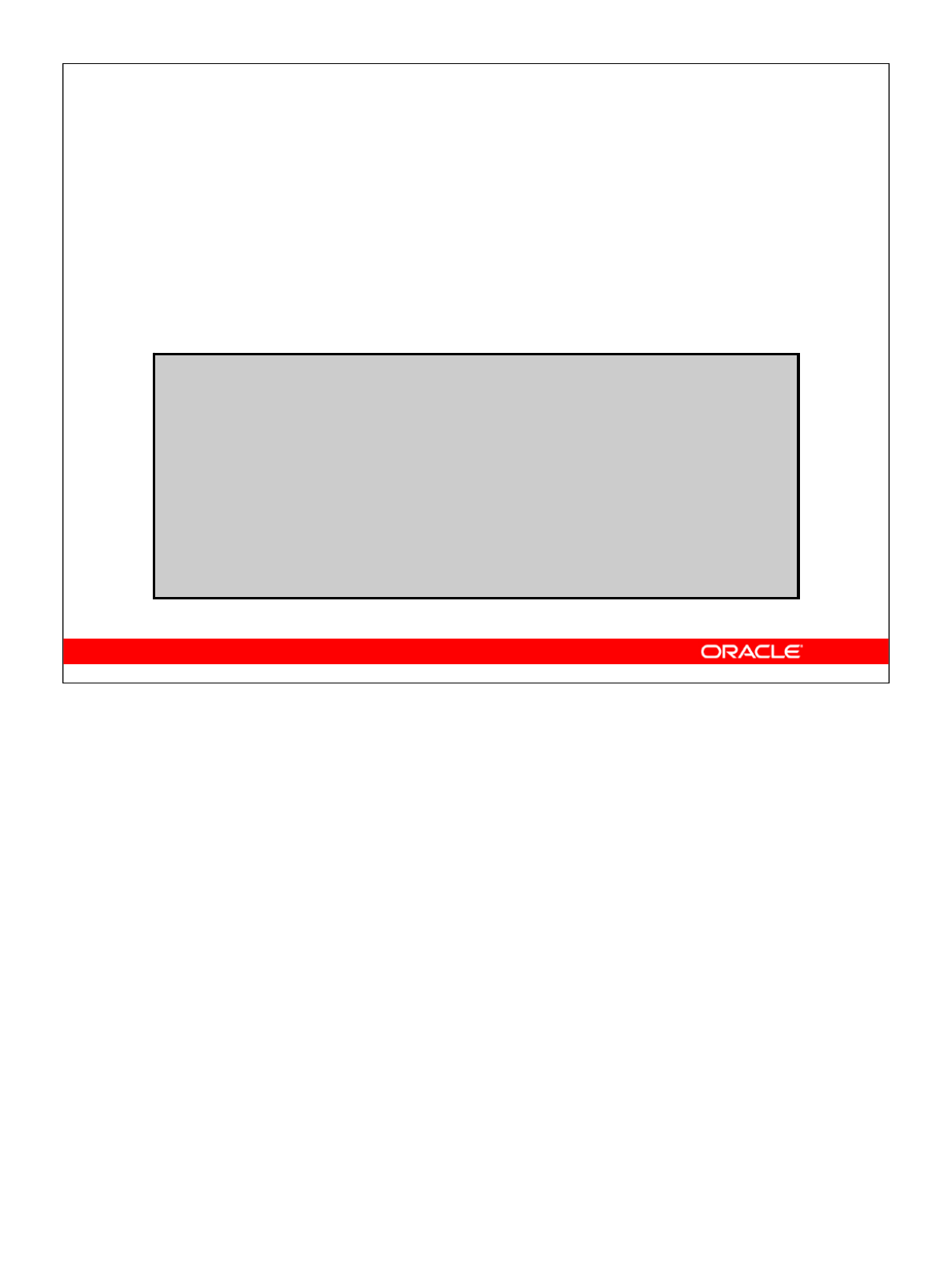
Oracle Database 10g: Develop PL/SQL Program Units 6-24
6-24 Copyright © 2004, Oracle. All rights reserved.
Examples of Setting Filters
To set up the filter to fetch the HR schema objects
excluding the object types of functions, procedures,
and packages, as well as any views that contain
PAYROLL in the start of the view name:
DBMS_METADATA.SET_FILTER(handle, 'SCHEMA_EXPR',
'IN (''PAYROLL'', ''HR'')');
DBMS_METADATA.SET_FILTER(handle, 'EXCLUDE_PATH_EXPR',
'=''FUNCTION''');
DBMS_METADATA.SET_FILTER(handle, 'EXCLUDE_PATH_EXPR',
'=''PROCEDURE''');
DBMS_METADATA.SET_FILTER(handle, 'EXCLUDE_PATH_EXPR',
'=''PACKAGE''');
DBMS_METADATA.SET_FILTER(handle, 'EXCLUDE_NAME_EXPR',
'LIKE ''PAYROLL%''', 'VIEW');
Examples of Setting Filters
The example shown in the slide calls the SET_FILTER procedure several times to create
a WHERE condition that identifies which object types are to be fetched. First, the objects in
the PAYROLL and HR schema are identified as object types to be fetched. Subsequently,
the SET_FILTER procedure identifies certain object types (functions, procedures, and
packages) and view object names to be excluded.
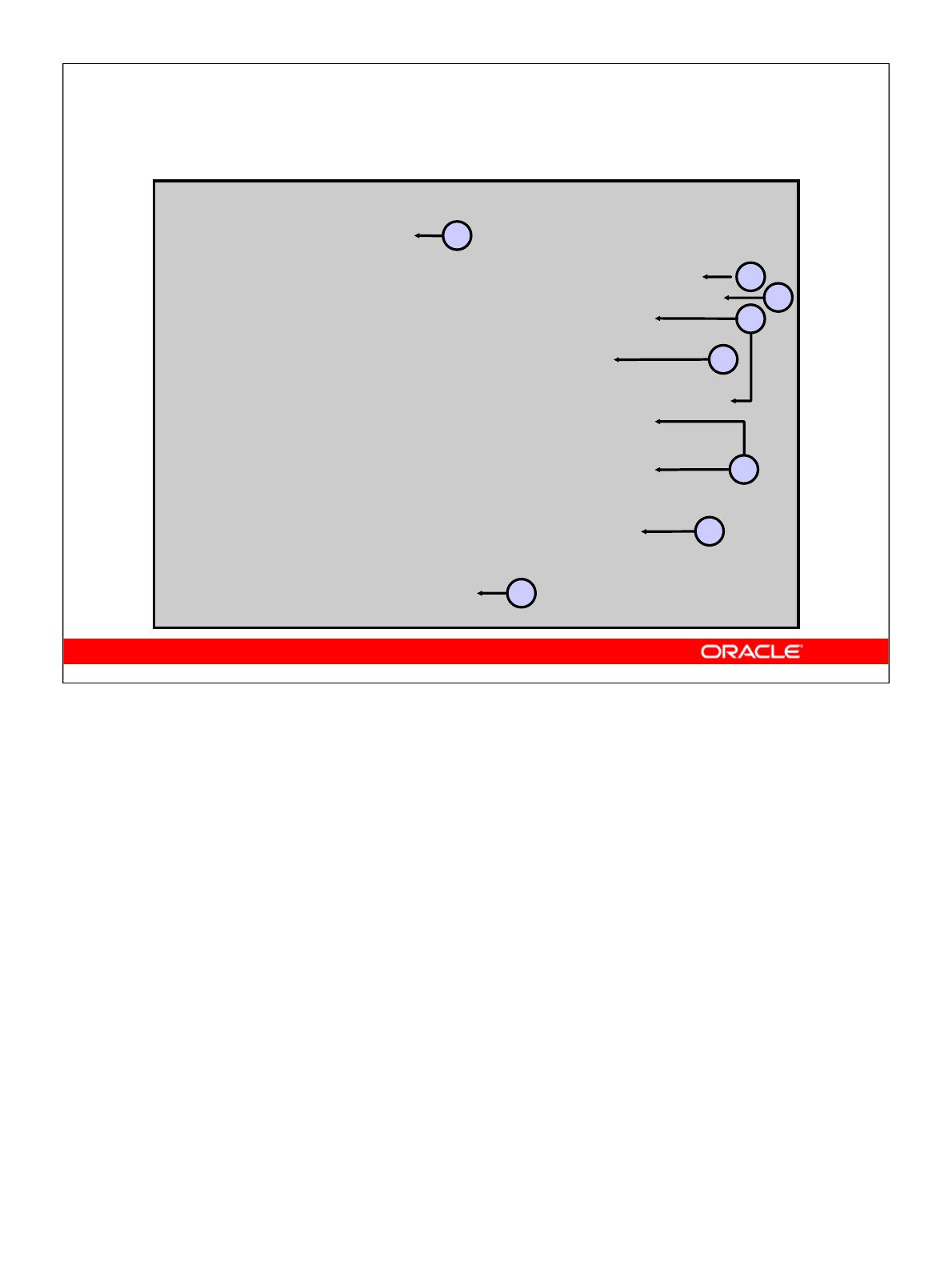
Oracle Database 10g: Develop PL/SQL Program Units 6-25
6-25 Copyright © 2004, Oracle. All rights reserved.
CREATE PROCEDURE example_one IS
h NUMBER; th1 NUMBER; th2 NUMBER;
doc sys.ku$_ddls;
BEGIN
h := DBMS_METADATA.OPEN('SCHEMA_EXPORT');
DBMS_METADATA.SET_FILTER (h,'SCHEMA','HR');
th1 := DBMS_METADATA.ADD_TRANSFORM (h,
'MODIFY', NULL, 'TABLE');
DBMS_METADATA.SET_REMAP_PARAM(th1,
'REMAP_TABLESPACE', 'SYSTEM', 'TBS1');
th2 :=DBMS_METADATA.ADD_TRANSFORM(h, 'DDL');
DBMS_METADATA.SET_TRANSFORM_PARAM(th2,
'SQLTERMINATOR', TRUE);
DBMS_METADATA.SET_TRANSFORM_PARAM(th2,
'REF_CONSTRAINTS', FALSE, 'TABLE');
LOOP
doc := DBMS_METADATA.FETCH_DDL(h);
EXIT WHEN doc IS NULL;
END LOOP;
DBMS_METADATA.CLOSE(h);
END;
Programmatic Use: Example 1
1
3
4
5
6
7
8
2
Programmatic Use: Example 1
In this example, all objects are retrieved from the HR schema as creation DDL. The
MODIFY transform is used to change the tablespaces for the tables.
1. The DBMS_METADATA package has several predefined types that are owned by
SYS. The type sys.ku_$ddls is defined in the DBMS_METADATA package. It is
a table type that holds CLOB type of data.
2. You use the OPEN function to specify the type of object to be retrieved, the version
of its metadata, and the object model. It returns a context handle for the set of
objects.
In this example, 'SCHEMA_EXPORT' is the object type, and it indicates all
metadata objects in a schema. There are 85 predefined types of objects for the model
that you can specify for this parameter. Both the version of metadata and the object
model parameters are not identified in this example. The version of metadata
parameter defaults to 'COMPATIBLE'. You can also specify 'LATEST' or a
specific database version. Currently, the model parameter only supports the Oracle
model in Oracle Database 10g. This is the default.
3. The SET_FILTER procedure identifies restrictions on the objects to be retrieved.

Oracle Database 10g: Develop PL/SQL Program Units 6-26
Programmatic Use: Example 1 (continued)
4. The ADD_TRANSFORM function specifies a transform that FETCH_XXX applies to the
XML representation of the retrieved objects. You can have more than one transform. In
the example, two transforms occur, one for each of the th1 and th2 program variables.
The ADD_TRANSFORM function accepts four parameters and returns a number
representing the opaque handle to the transform. The parameters are the handle returned
from the OPEN statement, the name of the transform (DDL, DROP, or MODIFY), the
encoding name which is the name of the NLS character set in which the style sheet
pointed to by the name is encoded, and the object type. If the object type is omitted, the
transform applies to all objects; otherwise, it applies only to the object type specified.
The first transform shown in the program code is the handle returned from the OPEN
function. The second transform shown in the code has two parameter values specified.
The first parameter is the handle identified from the OPEN function. The second
parameter value is DDL, which means the document is transformed to DDL that creates
the object. The output of this transform is not an XML document. The third and fourth
parameters are not specified. Both take the default values for the encoding and object
type parameters.
5. The SET_REMAP_PARAM procedure identifies the parameters to the XSLT style sheet
identified by the transform handle, which is the first parameter passed to the procedure.
In the example, the second parameter value 'REMAP_TABLESPACE' means that the
objects have their tablespaces renamed from an old value to a new value. In the
ADD_TRANSFORM function, the choices are DDL, DROP, or MODIFY. For each of these
values, the SET_REMAP_PARAM identifies the name of the parameter.
REMAP_TABLESPACE means the objects in the document will have their tablespaces
renamed from an old value to a new value.The third and fourth parameters identify the
old value and new value. In this example, the old tablespace name is SYSTEM, and the
new tablespace name is TBS1.
6. SET_TRANSFORM_PARAM works similarly to SET_REMAP_PARAM. In the code
shown, the first call to SET_TRANSFORM_PARAM identifies parameters for the th2
variable. The SQLTERMINATOR and TRUE parameter values cause the SQL terminator
(;or /) to be appended to each DDL statement.
The second call to SET_TRANSFORM_PARAM identifies more characteristics for the
th2 variable. REF_CONSTRAINTS, FALSE, TABLE means that referential constraints
on the tables are not copied to the document.
7. The FETCH_DDL function returns metadata for objects meeting the criteria established
by the OPEN, SET_FILTER, ADD_TRANSFORM, SET_REMAP_PARAM, and
SET_TRANSFORM_PARAM subroutines.
8. The CLOSE function invalidates the handle returned by the OPEN function and cleans
up the associated state. Use this function to terminate the stream of objects established
by the OPEN function.
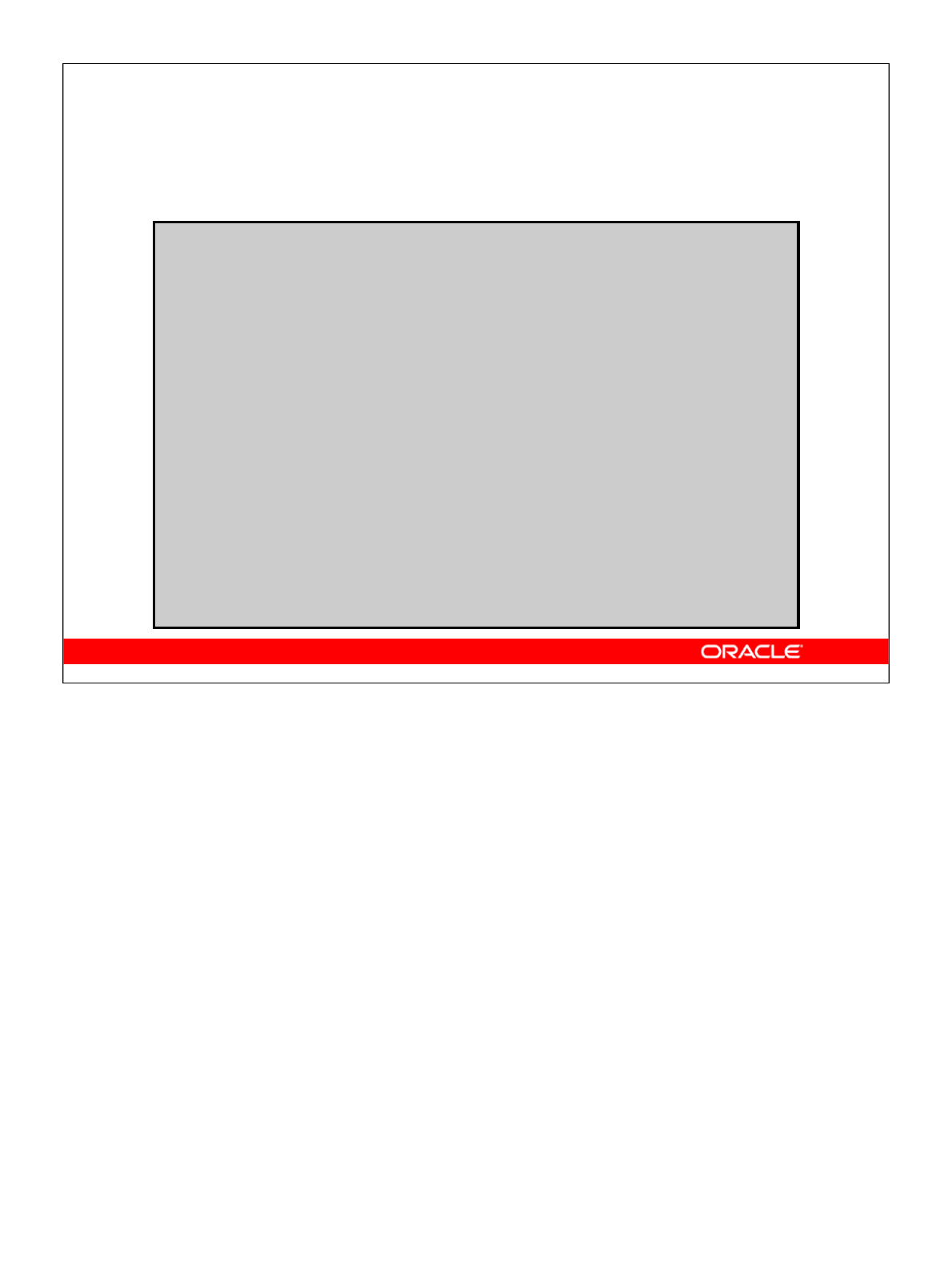
Oracle Database 10g: Develop PL/SQL Program Units 6-27
6-27 Copyright © 2004, Oracle. All rights reserved.
Programmatic Use: Example 2
CREATE FUNCTION get_table_md RETURN CLOB IS
h NUMBER; -- returned by 'OPEN'
th NUMBER; -- returned by 'ADD_TRANSFORM'
doc CLOB;
BEGIN
-- specify the OBJECT TYPE
h := DBMS_METADATA.OPEN('TABLE');
-- use FILTERS to specify the objects desired
DBMS_METADATA.SET_FILTER(h,'SCHEMA','HR');
DBMS_METADATA.SET_FILTER(h,'NAME','EMPLOYEES');
-- request to be TRANSFORMED into creation DDL
th := DBMS_METADATA.ADD_TRANSFORM(h,'DDL');
-- FETCH the object
doc := DBMS_METADATA.FETCH_CLOB(h);
-- release resources
DBMS_METADATA.CLOSE(h);
RETURN doc;
END;
/
Programmatic Use: Example 2
This example returns the metadata for the EMPLOYEES table. The result is:
set pagesize 0
set long 1000000
SELECT get_table_md FROM dual;
CREATE TABLE "HR"."EMPLOYEES"
( "EMPLOYEE_ID" NUMBER(6,0),
"FIRST_NAME" VARCHAR2(20),
"LAST_NAME" VARCHAR2(25) CONSTRAINT
"EMP_LAST_NAME_NN"
NOT NULL ENABLE,
"e-mail" VARCHAR2(25) CONSTRAINT "EMP_e-mail_NN"
NOT NULL ENABLE,
"PHONE_NUMBER" VARCHAR2(20),
"HIRE_DATE" DATE CONSTRAINT "EMP_HIRE_DATE_NN"
NOT NULL ENABLE,
"JOB_ID" VARCHAR2(10) CONSTRAINT "EMP_JOB_NN"
NOT NULL ENABLE,
"SALARY" NUMBER(8,2),
...

Oracle Database 10g: Develop PL/SQL Program Units 6-28
Programmatic Use: Example 2 (continued)
"COMMISSION_PCT" NUMBER(2,2),
"MANAGER_ID" NUMBER(6,0),
"DEPARTMENT_ID" NUMBER(4,0),
CONSTRAINT "EMP_SALARY_MIN" CHECK (salary > 0)
ENABLE,
CONSTRAINT "EMP_e-mail_UK" UNIQUE ("e-mail")
USING INDEX PCTFREE 10 INITRANS 2 MAXTRANS 255
STORAGE(INITIAL 65536 NEXT 65536 MINEXTENTS 1
MAXEXTENTS 2147483645
PCTINCREASE 0 FREELISTS 1 FREELIST GROUPS 1
BUFFER_POOL DEFAULT)
TABLESPACE "EXAMPLE" ENABLE,
CONSTRAINT "EMP_EMP_ID_PK" PRIMARY KEY
("EMPLOYEE_ID")
USING INDEX PCTFREE 10 INITRANS 2 MAXTRANS 255
STORAGE(INITIAL 65536 NEXT 65536 MINEXTENTS 1
MAXEXTENTS 2147483645
PCTINCREASE 0 FREELISTS 1 FREELIST GROUPS 1
BUFFER_POOL DEFAULT)
TABLESPACE "EXAMPLE" ENABLE,
CONSTRAINT "EMP_DEPT_FK" FOREIGN KEY
("DEPARTMENT_ID")
REFERENCES "HR"."DEPARTMENTS"
("DEPARTMENT_ID") ENABLE,
CONSTRAINT "EMP_JOB_FK" FOREIGN KEY ("JOB_ID")
REFERENCES "HR"."JOBS" ("JOB_ID") ENABLE,
CONSTRAINT "EMP_MANAGER_FK" FOREIGN KEY
("MANAGER_ID")
REFERENCES "HR"."EMPLOYEES" ("EMPLOYEE_ID")
ENABLE
) PCTFREE 0 PCTUSED 40 INITRANS 1 MAXTRANS 255 C
OMPRESS LOGGING
STORAGE(INITIAL 65536 NEXT 65536 MINEXTENTS 1
MAXEXTENTS 2147483645
PCTINCREASE 0 FREELISTS 1 FREELIST GROUPS 1
BUFFER_POOL DEFAULT)
TABLESPACE "EXAMPLE"
You can accomplish the same effect with the browsing
interface:
SELECT dbms_metadata.get_ddl
('TABLE','EMPLOYEES','HR')
FROM dual;

Oracle Database 10g: Develop PL/SQL Program Units 6-29
6-29 Copyright © 2004, Oracle. All rights reserved.
Browsing APIs
This function returns metadata for a
dependent object.
GET_DEPENDENT_XXX
This function returns metadata for a
granted object.
GET_GRANTED_XXX
The GET_XML and GET_DDL functions return
metadata for a single named object.
GET_XXX
DescriptionName
DDL or XMLWhere xxx is:
Browsing APIs
The browsing APIs are designed for use in SQL queries and ad hoc browsing. These
functions allow you to fetch metadata for objects with a single call. They encapsulate calls
to OPEN, SET_FILTER, and so on. Which function you use depends on the
characteristics of the object type and whether you want XML or DDL.
For some object types, you can use more than one function. You can use GET_XXX to
fetch an index by name, or GET_DEPENDENT_XXX to fetch the same index by specifying
the table on which it is defined.
GET_XXX returns a single object name.
For GET_DEPENDENT_XXX and GET_GRANTED_XXX, an arbitrary number of granted
or dependent object may match the input criteria. You can specify an object count when
fetching these objects.
If you invoke these functions from iSQL*Plus, then you should use the SET LONG and
SET PAGESIZE commands to retrieve complete, uninterrupted output.
SET LONG 2000000
SET PAGESIZE 300
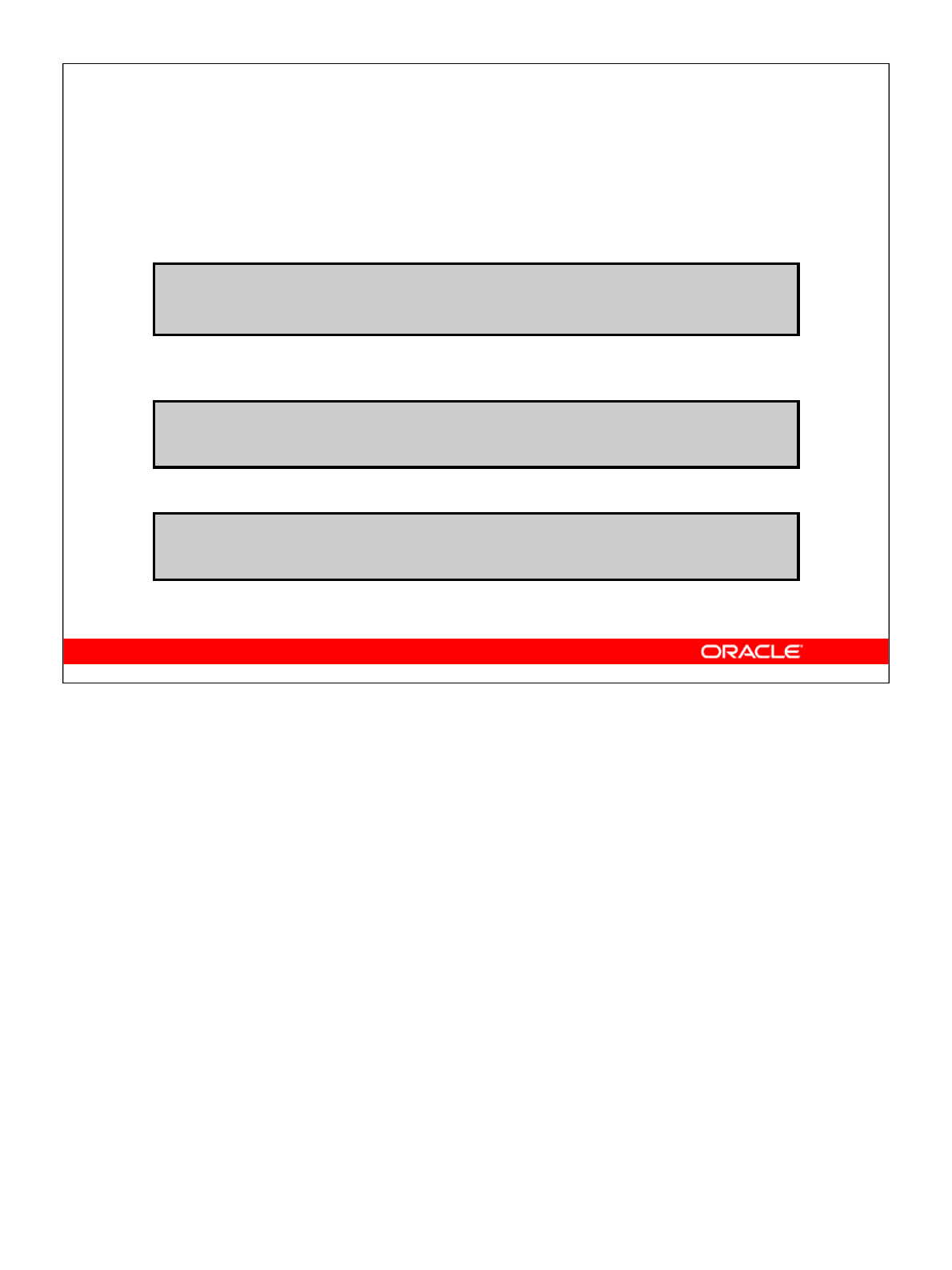
Oracle Database 10g: Develop PL/SQL Program Units 6-30
6-30 Copyright © 2004, Oracle. All rights reserved.
Browsing APIs: Examples
1. Get XML representation of HR.EMPLOYEES:
2. Fetch the DDL for all object grants on
HR.EMPLOYEES:
3. Fetch the DDL for all system grants granted to HR:
SELECT DBMS_METADATA.GET_XML
('TABLE', 'EMPLOYEES', 'HR')
FROM dual;
SELECT DBMS_METADATA.GET_GRANTED_DDL
('SYSTEM_GRANT', 'HR')
FROM dual;
SELECT DBMS_METADATA.GET_DEPENDENT_DDL
('OBJECT_GRANT', 'EMPLOYEES', 'HR')
FROM dual;
Browsing APIs: Examples
1. Results for fetching the XML representation of HR.EMPLOYEES are:
DBMS_METADATA.GET_XML('TABLE','EMPLOYEES','HR')
-----------------------------------------------
<?xml version="1.0"?>
<ROWSET>
<ROW>
<TABLE_T>
<VERS_MAJOR>1</VERS_MAJOR>
2. Results for fetching the DDL for all object grants on HR.EMPLOYEES are:
DBMS_METADATA.GET_DEPENDENT_DDL
('OBJECT_GRANT','EMPLOYEES','HR')
------------------------------------------------
GRANT SELECT ON "HR"."EMPLOYEES" TO "OE"
GRANT REFERENCES ON "HR"."EMPLOY
3. Results for fetching the DDL for all system grants granted to HR are:
DBMS_METADATA.GET_GRANTED_DDL('SYSTEM_GRANT','HR')
------------------------------------------------------
-
GRANT UNLIMITED TABLESPACE TO "HR"
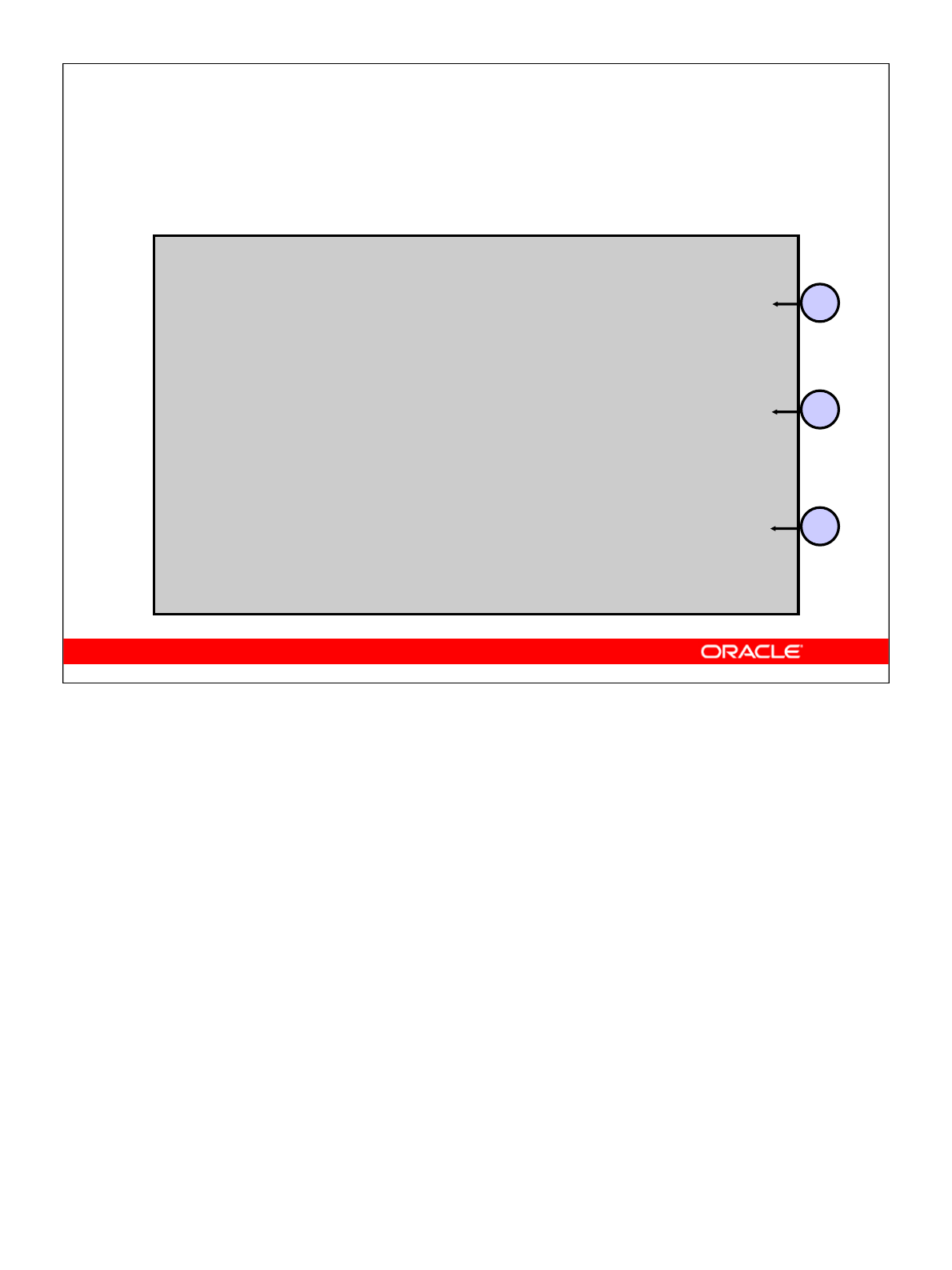
Oracle Database 10g: Develop PL/SQL Program Units 6-31
6-31 Copyright © 2004, Oracle. All rights reserved.
BEGIN
DBMS_METADATA.SET_TRANSFORM_PARAM(
DBMS_METADATA.SESSION_TRANSFORM,
'STORAGE', false);
END;
/
SELECT DBMS_METADATA.GET_DDL('TABLE',u.table_name)
FROM user_all_tables u
WHERE u.nested = 'NO'
AND (u.iot_type IS NULL OR u.iot_type = 'IOT');
BEGIN
DBMS_METADATA.SET_TRANSFORM_PARAM(
DBMS_METADATA.SESSION_TRANSFORM, 'DEFAULT'):
END;
/
1
3
2
Browsing APIs: Examples
Browsing APIs: Examples (continued)
The example in the slide shows how to fetch creation DDL for all “complete” tables in the
current schema, filtering out nested tables and overflow segments. The steps shown in the
slide are as follows:
1. The SET_TRANSFORM_PARAM function specifies that the storage clauses are not to
be returned in the SQL DDL. The SESSION_TRANSFORM function is interpreted to
mean “for the current session.”
2. Use the GET_DDL function to retrieve DDL on all non-nested and non-IOT tables.
CREATE TABLE "HR"."COUNTRIES"
( "COUNTRY_ID" CHAR(2)
CONSTRAINT "COUNTRY_ID_NN" NOT NULL ENABLE,
"COUNTRY_NAME" VARCHAR2(40),
"REGION_ID" NUMBER,
CONSTRAINT "COUNTRY_C_ID_PK"
PRIMARY KEY ("COUNTRY_ID") ENABLE,
CONSTRAINT "COUNTR_REG_FK" FOREIGN KEY
...
3. Reset the session-level parameters to their defaults.

Oracle Database 10g: Develop PL/SQL Program Units 6-32
6-32 Copyright © 2004, Oracle. All rights reserved.
Summary
In this lesson, you should have learned how to:
•Explain the execution flow of SQL statements
•Create SQL statements dynamically and execute
them using either Native Dynamic SQL statements
or the DBMS_SQL package
•Recognize the advantages of using Native
Dynamic SQL compared to the DBMS_SQL package
•Use DBMS_METADATA subprograms to
programmatically obtain metadata from the data
dictionary
Summary
In this lesson, you discovered how to dynamically create any SQL statement and execute it
using the Native Dynamic SQL statements. Dynamically executing SQL and PL/SQL code
extends the capabilities of PL/SQL beyond query and transactional operations. For earlier
releases of the database, you could achieve similar results with the DBMS_SQL package.
The lesson explored some differences and compared using Native Dynamic SQL to the
DBMS_SQL package. If you are using Oracle8ior later releases, you should use Native
Dynamic SQL for new projects.
The lesson also discussed using the DBMS_METADATA package to retrieve metadata from
the database dictionary with results presented in XML or creational DDL format. The
resulting XML data can be used for re-creating the object.

Oracle Database 10g: Develop PL/SQL Program Units 6-33
6-33 Copyright © 2004, Oracle. All rights reserved.
Practice 6: Overview
This practice covers the following topics:
•Creating a package that uses Native Dynamic SQL
to create or drop a table and to populate, modify,
and delete rows from a table
•Creating a package that compiles the PL/SQL code
in your schema
•Using DBMS_METADATA to display the statement to
regenerate a PL/SQL subprogram
Practice 6: Overview
In this practice, you write code to perform the following tasks:
• Create a package that uses Native Dynamic SQL to create or drop a table, and to
populate, modify, and delete rows from the table.
• Create a package that compiles the PL/SQL code in your schema, either all the
PL/SQL code or only code that has an INVALID status in the USER_OBJECTS
table.
•Use DBMS_METADATA to regenerate PL/SQL code for any procedure that you have
in your schema.

Oracle Database 10g: Develop PL/SQL Program Units 6-34
Practice 6
1. Create a package called TABLE_PKG that uses Native Dynamic SQL to create or drop
a table, and to populate, modify, and delete rows from the table.
a. Create a package specification with the following procedures:
PROCEDURE make(table_name VARCHAR2, col_specs VARCHAR2)
PROCEDURE add_row(table_name VARCHAR2, values VARCHAR2,
cols VARCHAR2 := NULL)
PROCEDURE upd_row(table_name VARCHAR2, values VARCHAR2,
conditions VARCHAR2 := NULL)
PROCEDURE del_row(table_name VARCHAR2,
conditions VARCHAR2 := NULL);
PROCEDURE remove(table_name VARCHAR2)
Ensure that subprograms manage optional default parameters with NULL values.
b. Create the package body that accepts the parameters and dynamically constructs
the appropriate SQL statements that are executed using Native Dynamic SQL,
except for the remove procedure that should be written using the DBMS_SQL
package.
c. Execute the package MAKE procedure to create a table as follows:
make('my_contacts', 'id number(4), name varchar2(40)');
d. Describe the MY_CONTACTS table structure.
e. Execute the ADD_ROW package procedure to add the following rows:
add_row('my_contacts','1,''Geoff Gallus''','id, name');
add_row('my_contacts','2,''Nancy''','id, name');
add_row('my_contacts','3,''Sunitha Patel''','id,name');
add_row('my_contacts','4,''Valli Pataballa''','id,name');
f. Query the MY_CONTACTS table contents.
g. Execute the DEL_ROW package procedure to delete a contact with ID value 1.
h. Execute the UPD_ROW procedure with following row data:
upd_row('my_contacts','name=''Nancy Greenberg''','id=2');
i. Select the data from the MY_CONTACTS table again to view the changes.
j. Drop the table by using the remove procedure and describe the MY_CONTACTS
table.
2. Create a COMPILE_PKG package that compiles the PL/SQL code in your schema.
a. In the specification, create a package procedure called MAKE that accepts the
name of a PL/SQL program unit to be compiled.
b. In the body, the MAKE procedure should call a private function named
GET_TYPE to determine the PL/SQL object type from the data dictionary, and
return the type name (use PACKAGE for a package with a body) if the object
exists; otherwise, it should return a NULL. If the object exists, MAKE dynamically
compiles it with the ALTER statement.
c. Use the COMPILE_PKG.MAKE procedure to compile the EMPLOYEE_REPORT
procedure, the EMP_PKG package, and a nonexistent object called EMP_DATA.

Oracle Database 10g: Develop PL/SQL Program Units 6-35
Practice 6 (continued)
3. Add a procedure to the COMPILE_PKG that uses the DBMS_METADATA to obtain a
DDL statement that can regenerate a named PL/SQL subprogram, and writes the DDL
to a file by using the UTL_FILE package.
a. In the package specification, create a procedure called REGENERATE that accepts
the name of a PL/SQL component to be regenerated. Declare a public VARCHAR2
variable called dir initialized with the directory alias value 'UTL_FILE'.
Compile the specification.
b. In the package body, implement the REGENERATE procedure so that it uses the
GET_TYPE function to determine the PL/SQL object type from the supplied
name. If the object exists, then obtain the DDL used to create the component
using the procedure DBMS_METADATA.GET_DDL, which must be provided with
the object name in uppercase text.
Save the DDL statement in a file by using the UTL_FILE.PUT procedure. Write
the file in the directory path stored in the public variable called dir (from the
specification). Construct a file name (in lowercase characters) by concatenating
the USER function, an underscore, and the object name with a .sql extension.
For example: ora1_myobject.sql. Compile the body.
c. Execute the COMPILE_PKG.REGENERATE procedure by using the name of the
TABLE_PKG created in the first task of this practice.
d. Use Putty FTP to get the generated file from the server to your local directory.
Edit the file to insert a /terminator character at the end of a CREATE statement
(if required). Cut and paste the results into the iSQL*Plus buffer and execute the
statement.


Copyright © 2004, Oracle. All rights reserved.
Design Considerations for PL/SQL Code

Oracle Database 10g: Develop PL/SQL Program Units 7-2
7-2 Copyright © 2004, Oracle. All rights reserved.
Objectives
After completing this lesson, you should be able to do
the following:
•Use package specifications to create standard
constants and exceptions
•Write and call local subprograms
•Set the AUTHID directive to control the run-time
privileges of a subprogram
•Execute subprograms to perform autonomous
transactions
•Use bulk binding and the RETURNING clause with
DML
•Pass parameters by reference using a NOCOPY hint
•Use the PARALLEL ENABLE hint for optimization
Lesson Aim
In this lesson, you learn to use package specifications to standardize names for constant
values and exceptions. You learn how to create subprograms in the Declaration
section of any PL/SQL block for using locally in the block. The AUTHID compiler
directive is discussed to show how you can manage run-time privileges of the PL/SQL
code, and create independent transactions by using the AUTONOMOUS TRANSACTION
directive for subprograms.
This lesson also covers some performance considerations that can be applied to PL/SQL
applications such as bulk binding operations with a single SQL statement, the
RETURNING clause, and the NOCOPY and PARALLEL ENABLE hints.

Oracle Database 10g: Develop PL/SQL Program Units 7-3
7-3 Copyright © 2004, Oracle. All rights reserved.
Standardizing Constants and Exceptions
Constants and exceptions are typically implemented
using a bodiless package (that is, in a package
specification).
•Standardizing helps to:
–Develop programs that are consistent
–Promote a higher degree of code reuse
–Ease code maintenance
–Implement company standards across entire
applications
•Start with standardization of:
–Exception names
–Constant definitions
Standardizing Constants and Exceptions
When several developers are writing their own exception handlers in an application, there
could be inconsistencies in the handling of error situations. Unless certain standards are
adhered to, the situation can become confusing because of the different approaches
followed in handling the same error or because of the display of conflicting error messages
that confuse users. To overcome these, you can:
• Implement company standards that use a consistent approach to error handling across
the entire application
• Create predefined, generic exception handlers that produce consistency in the
application
• Write and call programs that produce consistent error messages
All good programming environments promote naming and coding standards. In PL/SQL, a
good place to start implementing naming and coding standards is with commonly used
constants and exceptions that occur in the application domain.
The PL/SQL package specification construct is an excellent component to support
standardization, because all identifiers declared in the package specification are public.
They are visible to the subprograms that are developed by the owner of the package and all
code with EXECUTE rights to the package specification.

Oracle Database 10g: Develop PL/SQL Program Units 7-4
7-4 Copyright © 2004, Oracle. All rights reserved.
Standardizing Exceptions
Create a standardized error-handling package that
includes all named and programmer-defined
exceptions to be used in the application.
CREATE OR REPLACE PACKAGE error_pkg IS
fk_err EXCEPTION;
seq_nbr_err EXCEPTION;
PRAGMA EXCEPTION_INIT (fk_err, -2292);
PRAGMA EXCEPTION_INIT (seq_nbr_err, -2277);
...
END error_pkg;
/
Standardizing Exceptions
In the example in the slide, the error_pkg package is a standardized exception package.
It declares a set of programmer-defined exception identifiers. Because many of the Oracle
database predefined exceptions do not have identifying names, the example package
shown uses the PRAGMA EXCEPTION_INIT directive to associate selected exception
names with an Oracle database error number. This enables you to refer to any of the
exceptions in a standard way in your applications. For example:
BEGIN
DELETE FROM departments
WHERE department_id = deptno;
...
EXCEPTION
WHEN error_pkg.fk_err THEN
...
WHEN OTHERS THEN
...
END;
/

Oracle Database 10g: Develop PL/SQL Program Units 7-5
7-5 Copyright © 2004, Oracle. All rights reserved.
Standardizing Exception Handling
Consider writing a subprogram for common exception
handling to:
•Display errors based on SQLCODE and SQLERRM
values for exceptions
•Track run-time errors easily by using parameters
in your code to identify:
–The procedure in which the error occurred
–The location (line number) of the error
–RAISE_APPLICATION_ERROR using stack trace
capabilities, with the third argument set to TRUE
Standardizing Exception Handling
Standardized exception handling can be implemented either as a stand-alone subprogram
or a subprogram added to the package that defines the standard exceptions. Consider
creating a package with:
• Every named exception that is to be used in the application
• All unnamed, programmer-defined exceptions that are used in the application. These
are error numbers –20000 through –20999.
• A program to call RAISE_APPLICATION_ERROR based on package exceptions
• A program to display an error based on the values of SQLCODE and SQLERRM
• Additional objects, such as error log tables, and programs to access the tables
A common practice is to use parameters that identify the name of the procedure and the
location in which the error has occurred. This enables you to keep track of run-time errors
more easily. An alternative is to use the RAISE_APPLICATION_ERROR built-in
procedure to keep a stack trace of exceptions that can be used to track the call sequence
leading to the error. To do this, set the third optional argument to TRUE. For example:
RAISE_APPLICATION_ERROR(-20001, 'My first error', TRUE);
This is meaningful when more than one exception is raised in this manner.
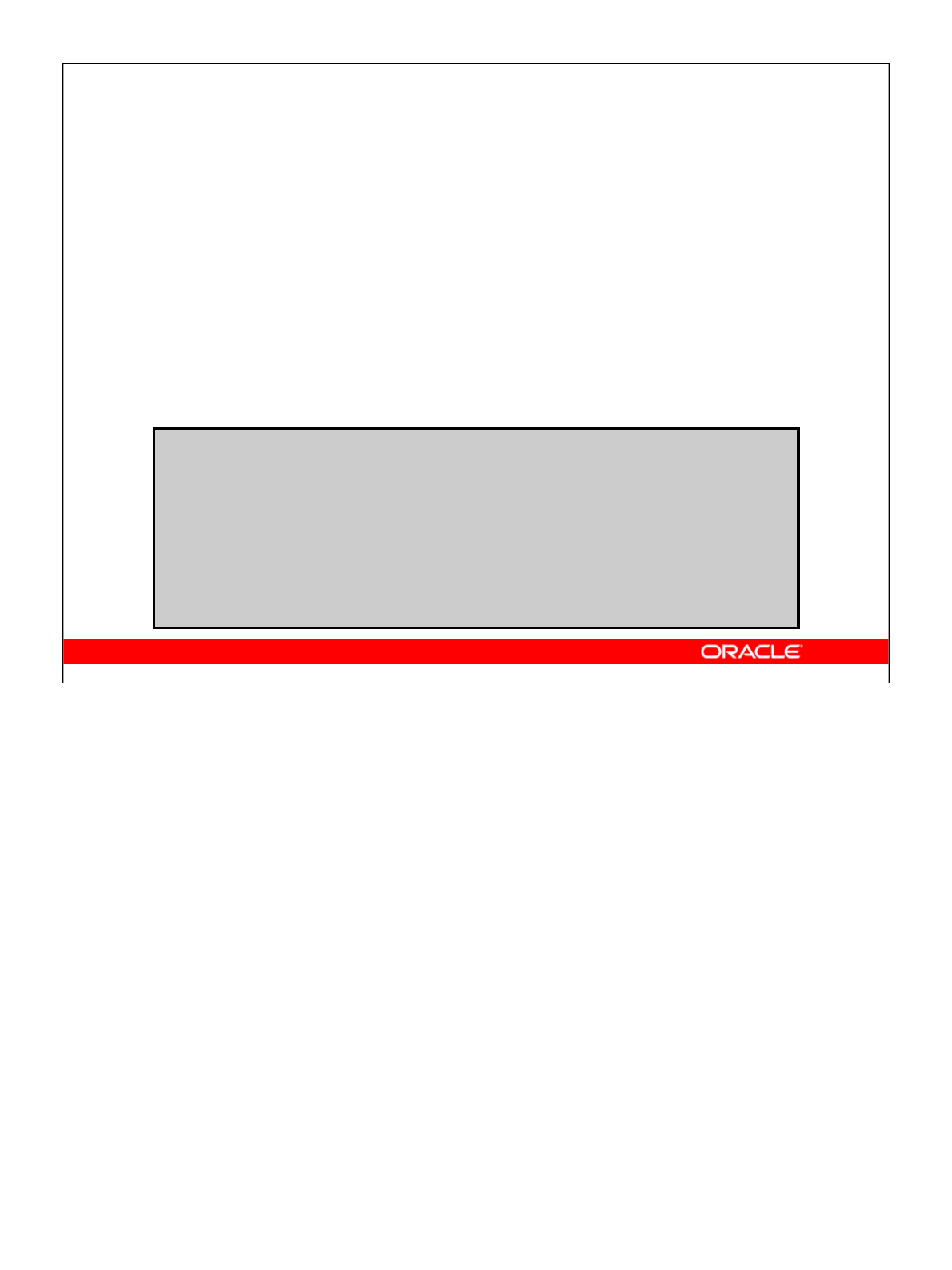
Oracle Database 10g: Develop PL/SQL Program Units 7-6
7-6 Copyright © 2004, Oracle. All rights reserved.
Standardizing Constants
For programs that use local variables whose values
should not change:
•Convert the variables to constants to reduce
maintenance and debugging
•Create one central package specification and
place all constants in it
CREATE OR REPLACE PACKAGE constant_pkg IS
c_order_received CONSTANT VARCHAR(2) := 'OR';
c_order_shipped CONSTANT VARCHAR(2) := 'OS';
c_min_sal CONSTANT NUMBER(3) := 900;
...
END constant_pkg;
Standardizing Constants
By definition, a variable’s value changes, whereas a constant’s value cannot be changed. If
you have programs that use local variables whose values should not and do not change,
then convert the variables to constants. This can help with the maintenance and debugging
of your code.
Consider creating a single shared package with all your constants in it. This makes
maintenance and change of the constants much easier. This procedure or package can be
loaded on system startup for better performance.
The example in the slide shows the constant_pkg package containing a few constants.
Refer to any of the package constants in your application as required. For example:
BEGIN
UPDATE employees
SET salary = salary + 200
WHERE salary <= constant_pkg.c_min_sal;
...
END;
/

Oracle Database 10g: Develop PL/SQL Program Units 7-7
7-7 Copyright © 2004, Oracle. All rights reserved.
Local Subprograms
•A local subprogram is a PROCEDURE or FUNCTION
defined in the declarative section.
•The local subprogram must be defined at the end
of the declarative section.
CREATE PROCEDURE employee_sal(id NUMBER) IS
emp employees%ROWTYPE;
FUNCTION tax(salary VARCHAR2) RETURN NUMBER IS
BEGIN
RETURN salary * 0.825;
END tax;
BEGIN
SELECT * INTO emp
FROM EMPLOYEES WHERE employee_id = id;
DBMS_OUTPUT.PUT_LINE('Tax: '||tax(emp.salary));
END;
Local Subprograms
Local subprograms can drive top-down design. They reduce the size of a module by
removing redundant code. This is one of the main reasons for creating a local subprogram.
If a module needs the same routine several times, but only this module needs the routine,
then define it as a local subprogram.
You can define a named PL/SQL block in the declarative section of any PL/SQL program,
procedure, function, or anonymous block provided that it is declared at the end of the
Declaration section. Local subprograms have the following characteristics:
• They are only accessible to the block in which they are defined.
• They are compiled as part of their enclosing blocks.
The benefits of local subprograms are:
• Reduction of repetitive code
• Improved code readability and ease of maintenance
• Less administration because there is one program to maintain instead of two
The concept is simple. The example shown in the slide illustrates this with a basic example
of an income tax calculation of an employee’s salary.

Oracle Database 10g: Develop PL/SQL Program Units 7-8
7-8 Copyright © 2004, Oracle. All rights reserved.
Definer’s Rights Versus Invoker’s Rights
Definer’s rights:
•Used prior to Oracle8i
•Programs execute with
the privileges of the
creating user.
•User does not require
privileges on underlying
objects that the
procedure accesses.
User requires privilege
only to execute a
procedure.
Invoker’s rights:
•Introduced in Oracle8i
•Programs execute with
the privileges of the
calling user.
•User requires privileges
on the underlying
objects that the
procedure accesses.
Definer’s Rights Versus Invoker’s Rights
Definer’s Rights Model
Prior to Oracle8i, all programs executed with the privileges of the user who created the
subprogram. This is known as the definer’s rights model, which:
• Allows a caller of the program the privilege to execute the procedure, but no
privileges on the underlying objects that the procedure accesses
• Requires the owner to have all the necessary object privileges for the objects that the
procedure references
For example, if user Scott creates a PL/SQL subprogram get_employees that is
subsequently invoked by Sarah, then the get_employees procedure runs with the
privileges of the definer Scott.
Invoker’s Rights Model
In the invoker’s rights model, which was introduced in Oracle8i, programs are executed
with the privileges of the calling user. A user of a procedure running with invoker’s rights
requires privileges on the underlying objects that the procedure references.
For example, if Scott’s PL/SQL subprogram get_employees is invoked by Sarah, then
the get_employees procedure runs with the privileges of the invoker Sarah.
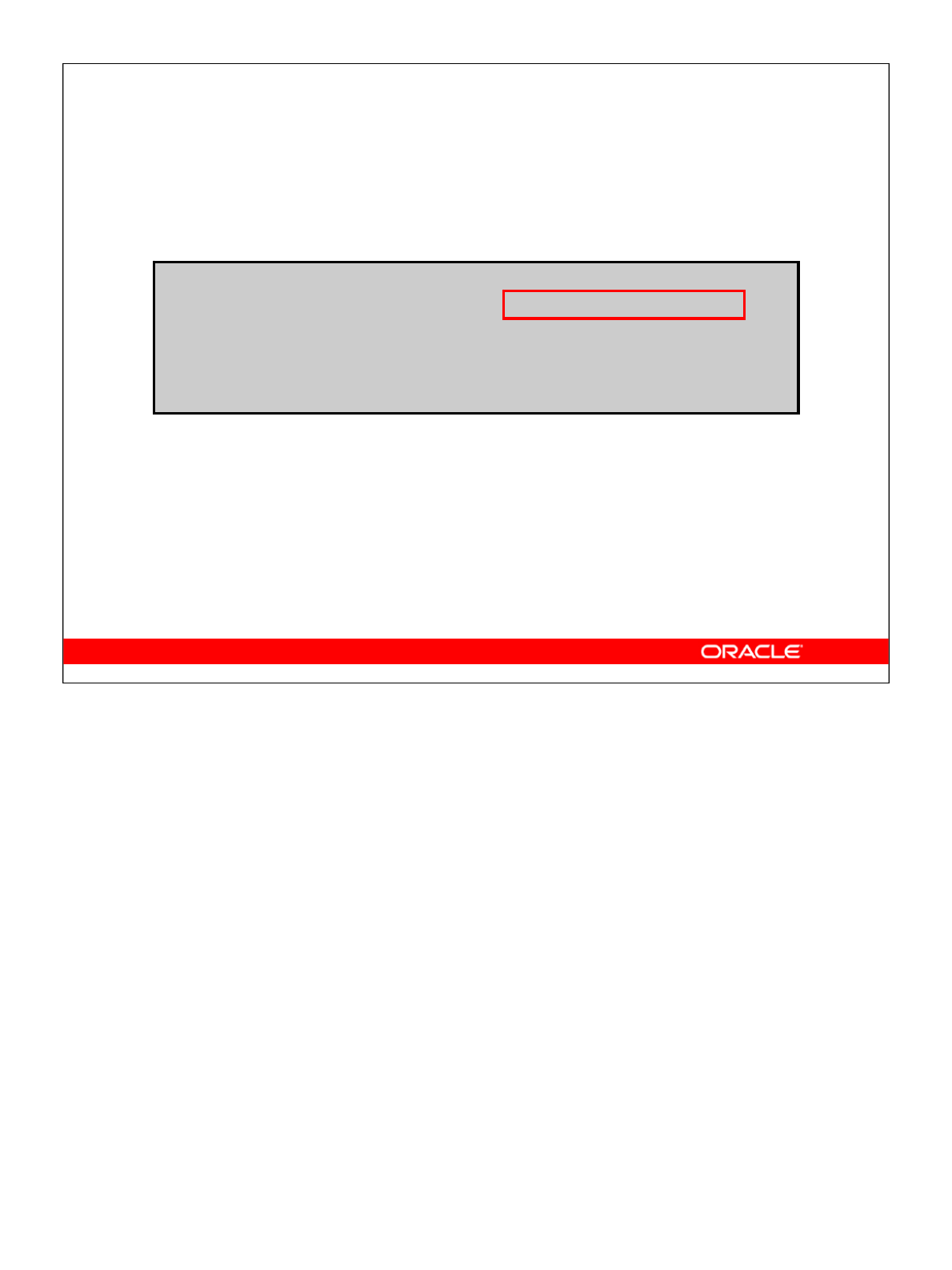
Oracle Database 10g: Develop PL/SQL Program Units 7-9
7-9 Copyright © 2004, Oracle. All rights reserved.
Specifying Invoker’s Rights
Set AUTHID to CURRENT_USER:
When used with stand-alone functions, procedures, or
packages:
•Names used in queries, DML, Native Dynamic
SQL, and DBMS_SQL package are resolved in the
invoker’s schema
•Calls to other packages, functions, and
procedures are resolved in the definer’s schema
CREATE OR REPLACE PROCEDURE add_dept(
id NUMBER, name VARCHAR2) AUTHID CURRENT_USER IS
BEGIN
INSERT INTO departments
VALUES (id,name,NULL,NULL);
END;
Specifying Invoker’s Rights
Setting Invoker’s Rights
The following is the syntax for setting invoker’s rights for different PL/SQL subprogram
constructs: CREATE FUNCTION name RETURN type AUTHID CURRENT_USER
IS...
CREATE PROCEDURE name AUTHID CURRENT_USER IS…
CREATE PACKAGE name AUTHID CURRENT_USER IS…
CREATE TYPE name AUTHID CURRENT_USER IS OBJECT…
In these statements, set AUTHID to DEFINER, or do not use it for default behavior.
Name Resolution
For a definer’s rights procedure, all external references are resolved in the definer’s
schema. For an invoker’s rights procedure, the resolution of external references depends
on the kind of statement in which they appear:
• Names used in queries, DML statements, dynamic SQL, and DBMS_SQL are
resolved in the invoker’s schema.
• All other statements, such as calls to packages, functions, and procedures, are
resolved in the definer’s schema.
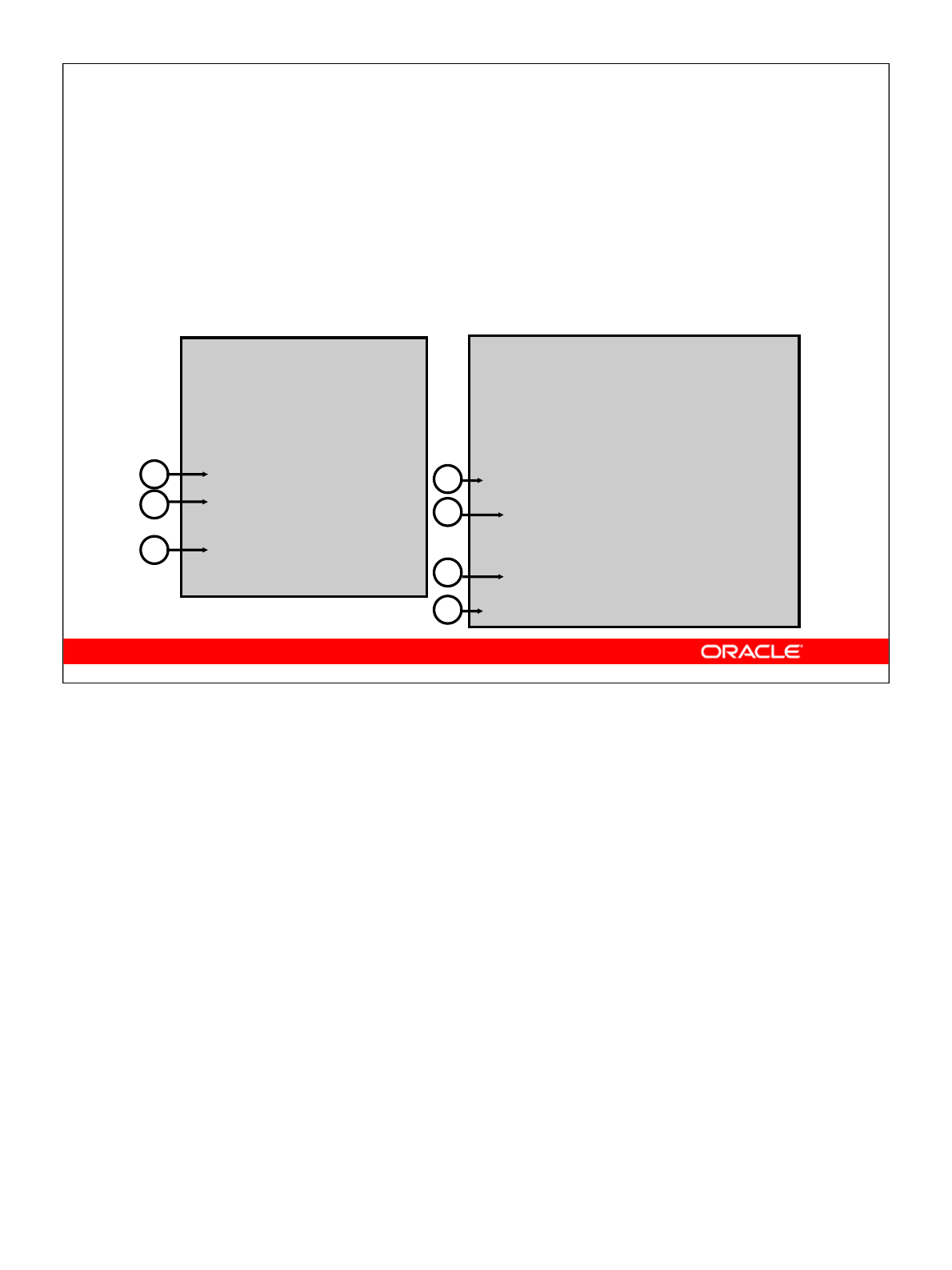
Oracle Database 10g: Develop PL/SQL Program Units 7-10
7-10 Copyright © 2004, Oracle. All rights reserved.
PROCEDURE proc1 IS
emp_id NUMBER;
BEGIN
emp_id := 1234;
COMMIT;
INSERT ...
proc2;
DELETE ...
COMMIT;
END proc1;
PROCEDURE proc2 IS
PRAGMA
AUTONOMOUS_TRANSACTION;
dept_id NUMBER := 90;
BEGIN
UPDATE ...
INSERT ...
COMMIT; -- Required
END proc2;
Autonomous Transactions
•Are independent transactions started by another
main transaction.
•Are specified with PRAGMA
AUTONOMOUS_TRANSACTION
1
7
23
4
5
6
Autonomous Transactions
A transaction is a series of statements that does a logical unit of work that completes or
fails as an integrated unit. Often, one transaction starts another that may need to operate
outside the scope of the transaction that started it. In other words, in an existing
transaction, a required independent transaction may need to commit or roll back changes
without affecting the outcome of the starting transaction. For example, in a stock purchase
transaction, the customer’s information must be committed regardless of whether the
overall stock purchase completes. Or, while running that same transaction, you want to log
messages to a table even if the overall transaction rolls back.
Since Oracle8i, the autonomous transactions were added to make it possible to create an
independent transaction. An autonomous transaction (AT) is an independent transaction
started by another main transaction (MT). The slide depicts the behavior of an AT:
1. The main transaction begins.
2. A proc2 procedure is called to start the autonomous transaction.
3. The main transaction is suspended.
4. The autonomous transactional operation begins.
5. The autonomous transaction ends with a commit or roll back operation.
6. The main transaction is resumed.
7. The main transaction ends.

Oracle Database 10g: Develop PL/SQL Program Units 7-11
7-11 Copyright © 2004, Oracle. All rights reserved.
Features of Autonomous Transactions
Autonomous transactions:
•Are independent of the main transaction
•Suspend the calling transaction until it is
completed
•Are not nested transactions
•Do not roll back if the main transaction rolls back
•Enable the changes to become visible to other
transactions upon a commit
•Are demarcated (started and ended) by individual
subprograms, and not nested or anonymous
PL/SQL block
Features of Autonomous Transactions
Autonomous transactions exhibit the following features:
• Although called within a transaction, autonomous transactions are independent of
that transaction. In other words, they are not nested transactions.
• If the main transaction rolls back, autonomous transactions do not.
• Changes made by an autonomous transaction become visible to other transactions
when the autonomous transaction commits.
• With their stack-like functionality, only the “top” transaction is accessible at any
given time. After completion, the autonomous transaction is popped, and the calling
transaction is resumed.
• There are no limits other than resource limits on how many autonomous transactions
can be recursively called.
• Autonomous transactions must be explicitly committed or rolled back; otherwise, an
error is returned when attempting to return from the autonomous block.
• You cannot use the PRAGMA to mark all subprograms in a package as autonomous.
Only individual routines can be marked autonomous.
• You cannot mark a nested or anonymous PL/SQL block as autonomous.
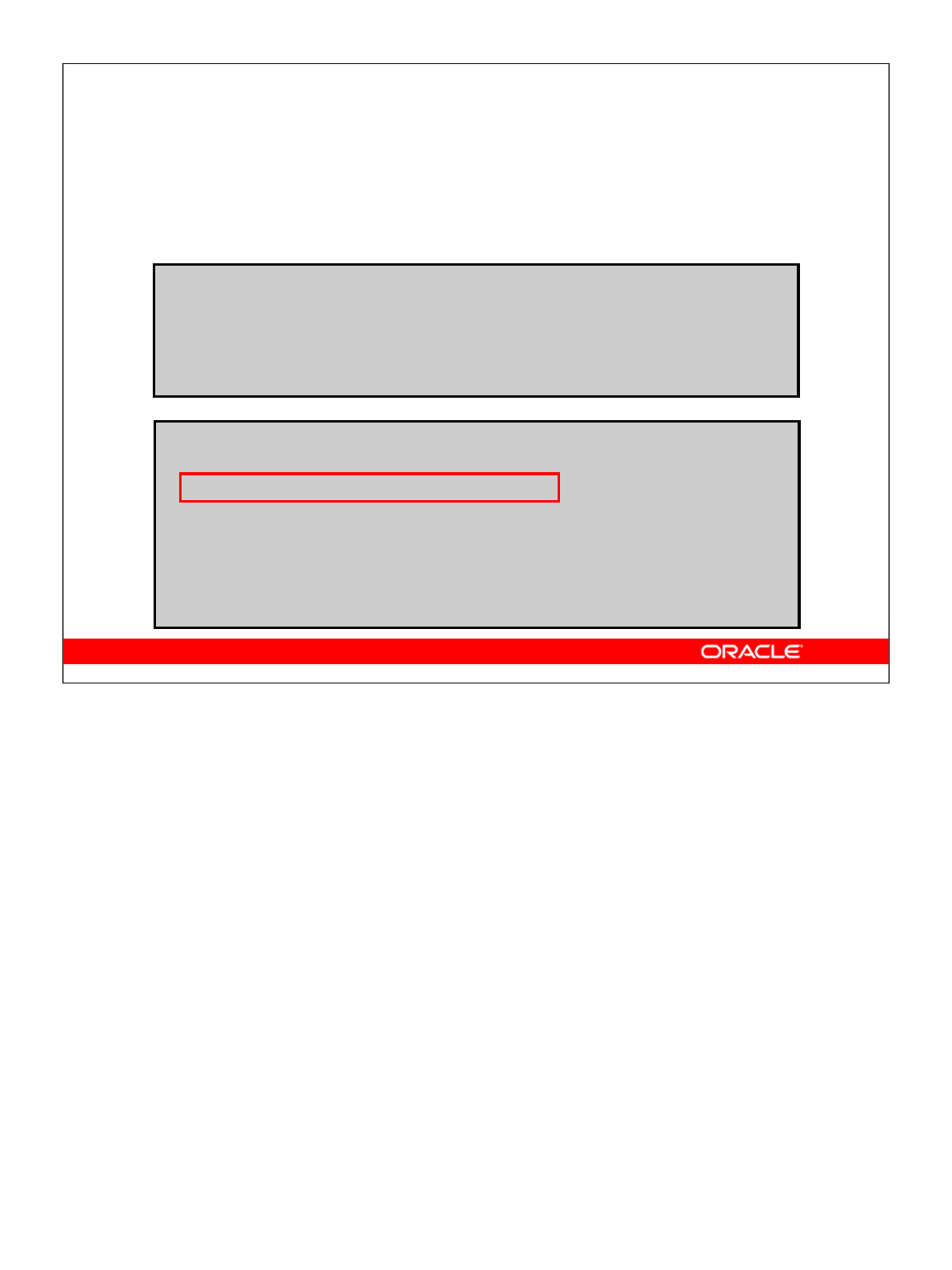
Oracle Database 10g: Develop PL/SQL Program Units 7-12
7-12 Copyright © 2004, Oracle. All rights reserved.
Using Autonomous Transactions
Example:
PROCEDURE bank_trans(cardnbr NUMBER,loc NUMBER) IS
BEGIN
log_usage (cardnbr, loc);
INSERT INTO txn VALUES (9001, 1000,...);
END bank_trans;
PROCEDURE log_usage (card_id NUMBER, loc NUMBER)
IS
PRAGMA AUTONOMOUS_TRANSACTION;
BEGIN
INSERT INTO usage
VALUES (card_id, loc);
COMMIT;
END log_usage;
Using Autonomous Transactions
To define autonomous transactions, you use PRAGMA AUTONOMOUS_TRANSACTION.
PRAGMA instructs the PL/SQL compiler to mark a routine as autonomous (independent).
In this context, the term “routine” includes top-level (not nested) anonymous PL/SQL
blocks; local, stand-alone, and packaged functions and procedures; methods of a SQL
object type; and database triggers. You can code PRAGMA anywhere in the declarative
section of a routine. However, for readability, it is best placed at the top of the
Declaration section.
In the example in the slide, you track where the bank card is used, regardless of whether
the transaction is successful. The following are the benefits of autonomous transactions:
• After starting, an autonomous transaction is fully independent. It shares no locks,
resources, or commit dependencies with the main transaction, so you can log events,
increment retry counters, and so on even if the main transaction rolls back.
• More important, autonomous transactions help you build modular, reusable software
components. For example, stored procedures can start and finish autonomous
transactions on their own. A calling application need not know about a procedure’s
autonomous operations, and the procedure need not know about the application’s
transaction context. That makes autonomous transactions less error-prone than
regular transactions and easier to use.
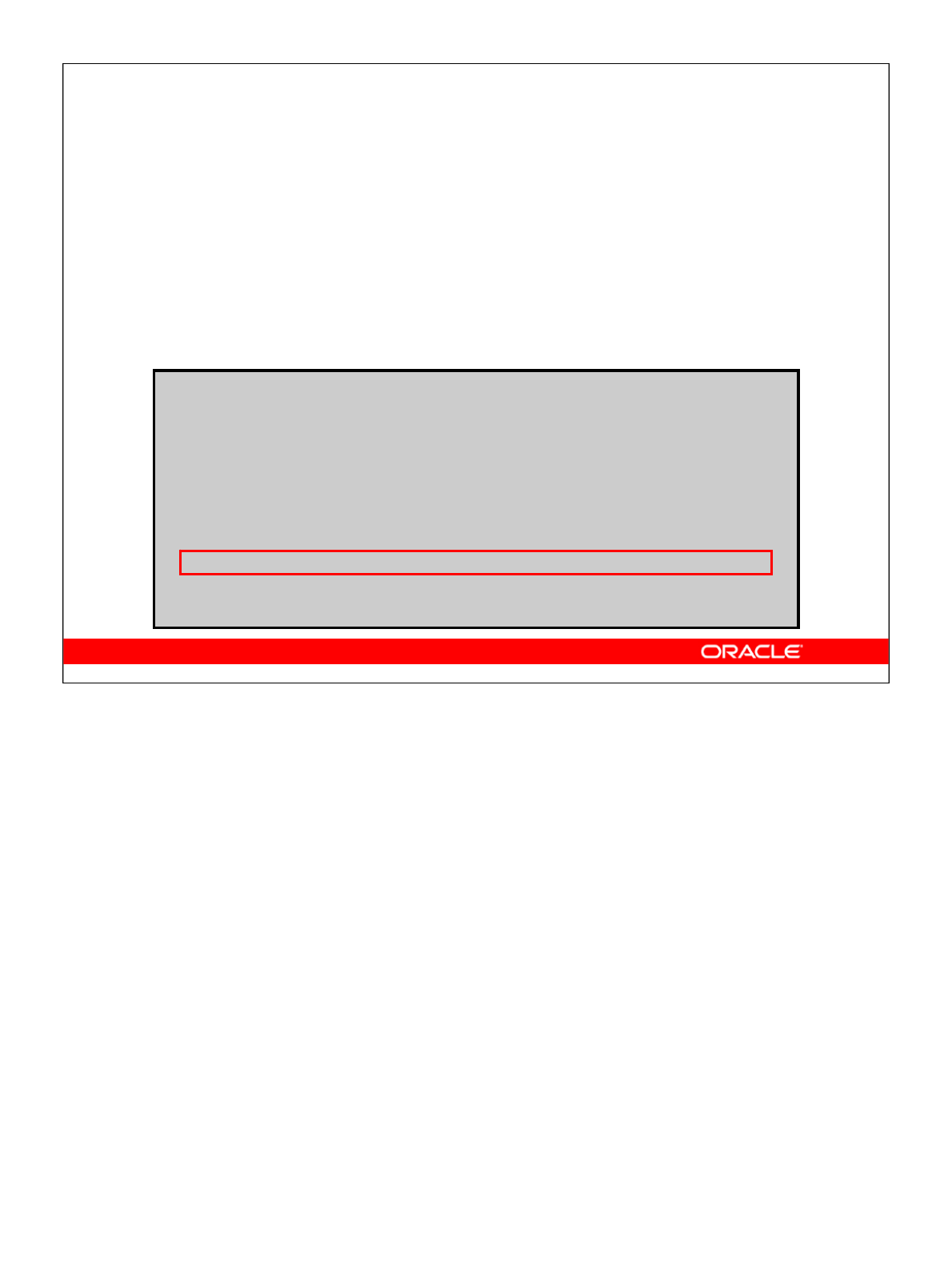
Oracle Database 10g: Develop PL/SQL Program Units 7-13
7-13 Copyright © 2004, Oracle. All rights reserved.
CREATE PROCEDURE update_salary(emp_id NUMBER) IS
name employees.last_name%TYPE;
new_sal employees.salary%TYPE;
BEGIN
UPDATE employees
SET salary = salary * 1.1
WHERE employee_id = emp_id
RETURNING last_name, salary INTO name, new_sal;
END update_salary;
/
RETURNING Clause
The RETURNING clause:
•Improves performance by returning column values
with INSERT, UPDATE, and DELETE statements
•Eliminates the need for a SELECT statement
RETURNING Clause
Often, applications need information about the row affected by a SQL operation—for
example, to generate a report or to take a subsequent action. The INSERT, UPDATE, and
DELETE statements can include a RETURNING clause, which returns column values from
the affected row into PL/SQL variables or host variables. This eliminates the need to
SELECT the row after an INSERT or UPDATE, or before a DELETE. As a result, fewer
network round trips, less server CPU time, fewer cursors, and less server memory are
required.
The example in the slide shows how to update the salary of an employee, and at the same
time retrieve the employee’s last name and new salary into a local PL/SQL variable.
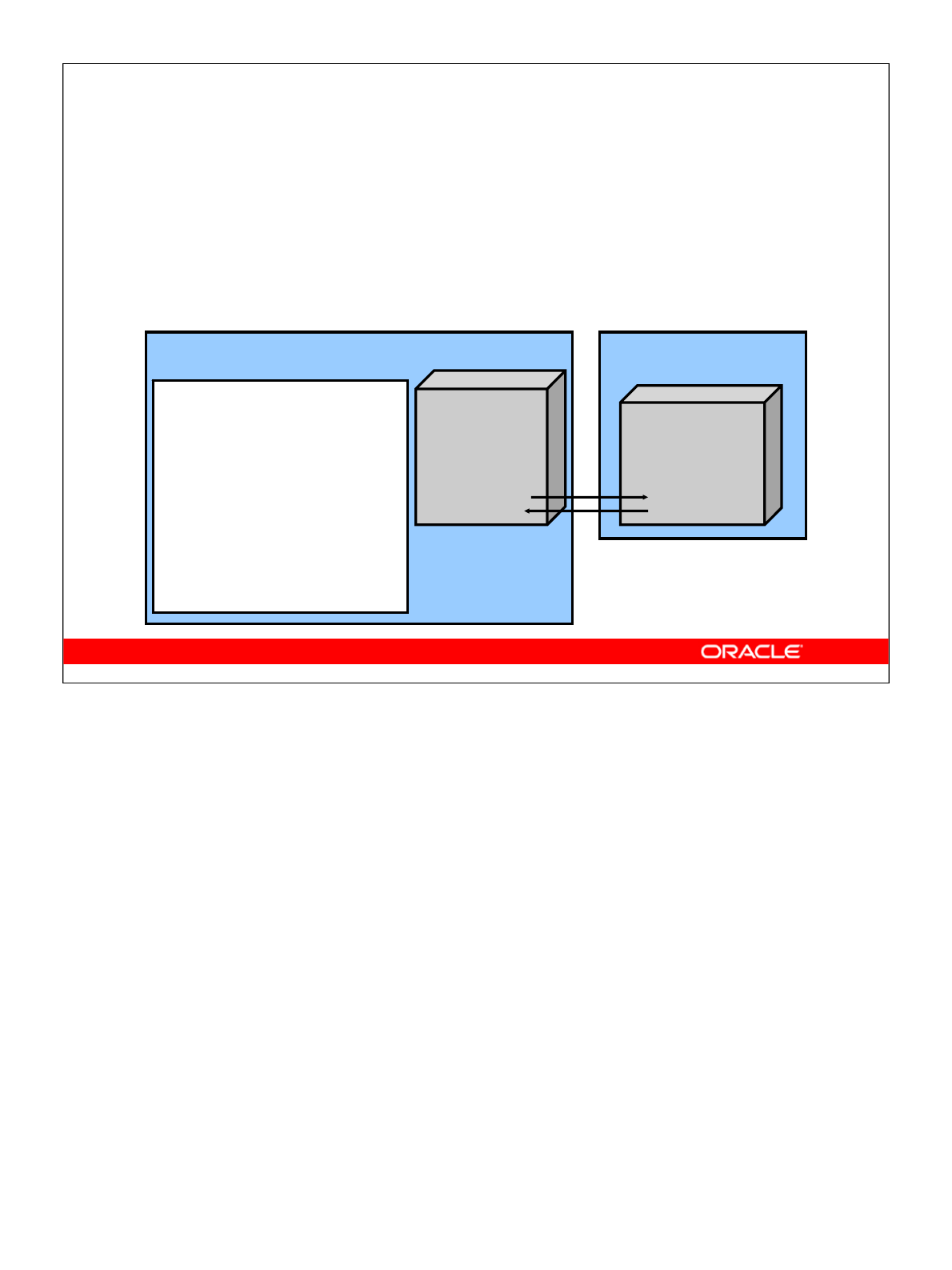
Oracle Database 10g: Develop PL/SQL Program Units 7-14
7-14 Copyright © 2004, Oracle. All rights reserved.
SQL engine
Bulk Binding
Binds whole arrays of values in a single operation,
rather than using a loop to perform a FETCH, INSERT,
UPDATE, and DELETE operation multiple times
PL/SQL run-time engine
SQL
statement
executor
Procedural
statement
executor
PL/SQL block
FORALL j IN 1..1000
INSERT (id,
dates)
VALUES (ids(j),
dates(j));
...
Bulk Binding
The Oracle server uses two engines to run PL/SQL blocks and subprograms:
• The PL/SQL run-time engine, which runs procedural statements but passes the SQL
statements to the SQL engine
• The SQL engine, which parses and executes the SQL statement and, in some cases,
returns data to the PL/SQL engine
During execution, every SQL statement causes a context switch between the two engines,
which results in a performance penalty for excessive amounts of SQL processing. This is
typical of applications that have a SQL statement in a loop that uses indexed collection
elements values. Collections include nested tables, varying arrays, index-by tables, and
host arrays.
Performance can be substantially improved by minimizing the number of context switches
through the use of bulk binding. Bulk binding causes an entire collection to be bound in
one call, a context switch, to the SQL engine. That is, a bulk bind process passes the entire
collection of values back and forth between the two engines in a single context switch,
compared with incurring a context switch for each collection element in an iteration of a
loop. The more rows affected by a SQL statement, the greater is the performance gain with
bulk binding.
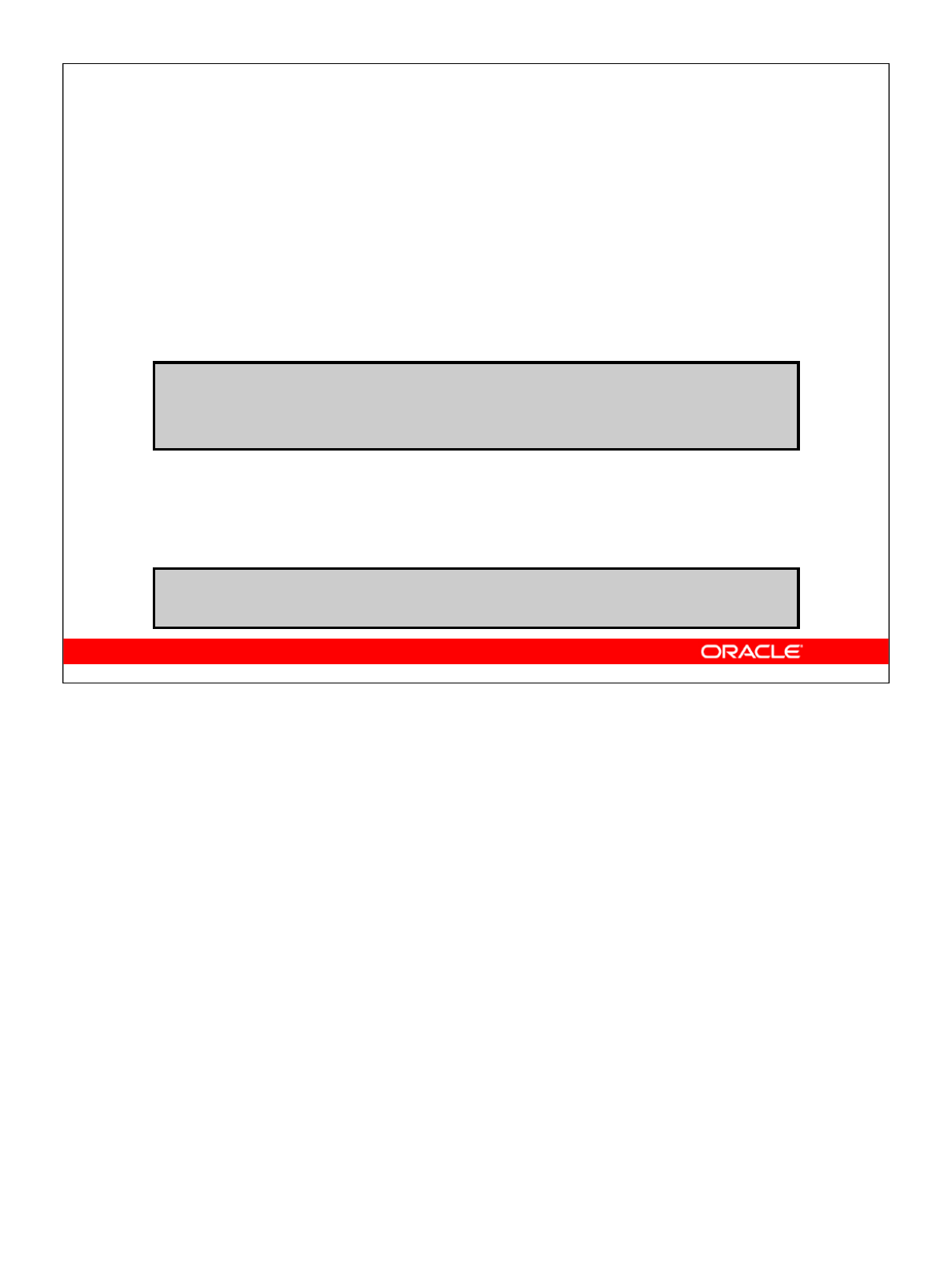
Oracle Database 10g: Develop PL/SQL Program Units 7-15
7-15 Copyright © 2004, Oracle. All rights reserved.
Using Bulk Binding
Keywords to support bulk binding:
•The FORALL keyword instructs the PL/SQL engine
to bulk bind input collections before sending them
to the SQL engine.
•The BULK COLLECT keyword instructs the SQL
engine to bulk bind output collections before
returning them to the PL/SQL engine.
FORALL index IN lower_bound .. upper_bound
[SAVE EXCEPTIONS]
sql_statement;
... BULK COLLECT INTO
collection_name[,collection_name] ...
Using Bulk Binding
Use bulk binds to improve the performance of:
• DML statements that reference collection elements
•SELECT statements that reference collection elements
•Cursor FOR loops that reference collections and the RETURNING INTO clause
Keywords to Support Bulk Binding
The FORALL keyword instructs the PL/SQL engine to bulk bind input collections before
sending them to the SQL engine. Although the FORALL statement contains an iteration
scheme, it is not a FOR loop.
The BULK COLLECT keyword instructs the SQL engine to bulk bind output collections,
before returning them to the PL/SQL engine. This allows you to bind locations into which
SQL can return the retrieved values in bulk. Thus, you can use these keywords in the
SELECT INTO, FETCH INTO, and RETURNING INTO clauses.
The SAVE EXCEPTIONS keyword is optional. However, if some of the DML operations
succeed and some fail, you will want to track or report on those that fail. Using the SAVE
EXCEPTIONS keyword causes failed operations to be stored in a cursor attribute called
%BULK_EXCEPTIONS, which is a collection of records indicating the bulk DML iteration
number and corresponding error code.
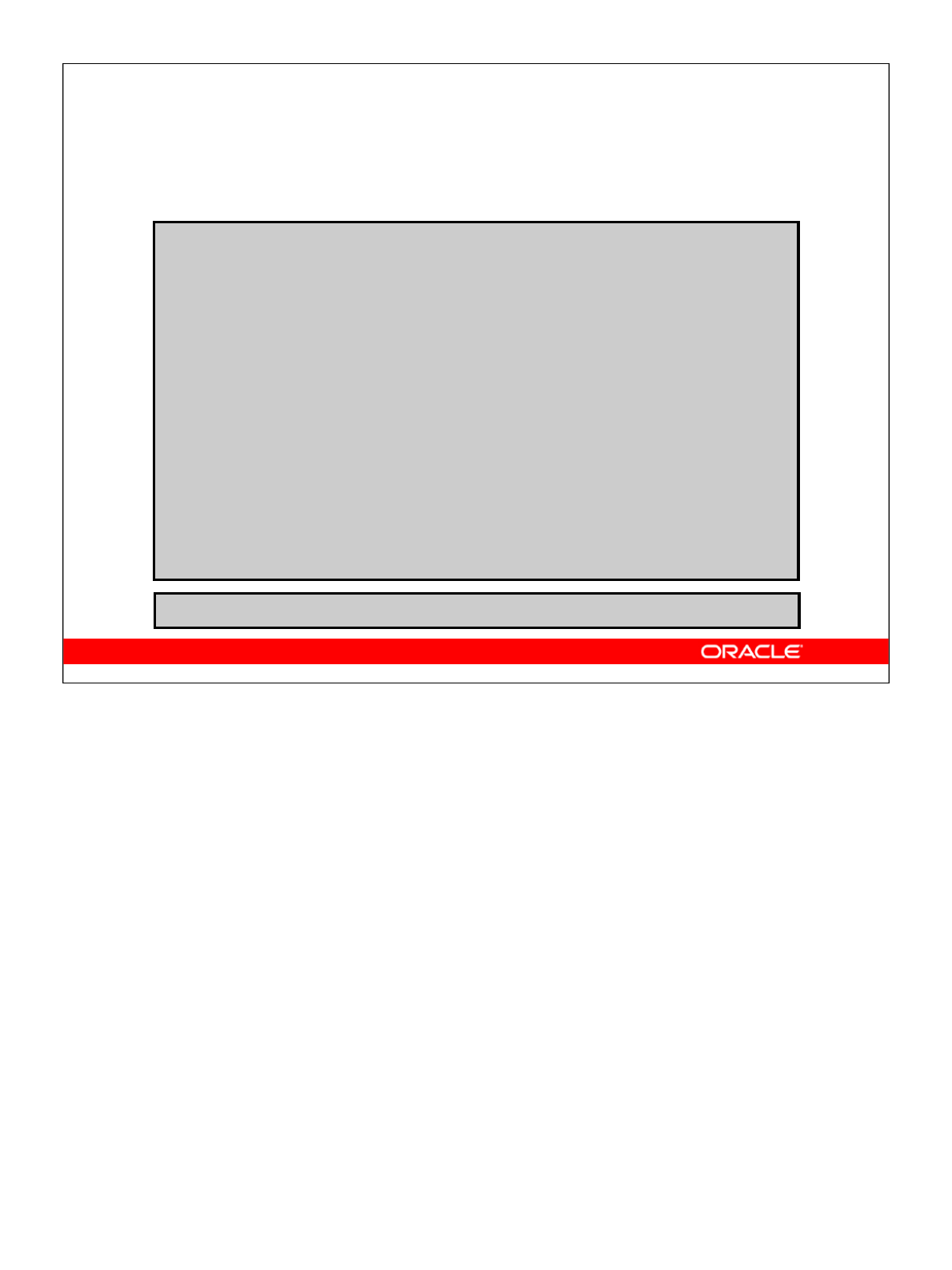
Oracle Database 10g: Develop PL/SQL Program Units 7-16
7-16 Copyright © 2004, Oracle. All rights reserved.
Bulk Binding FORALL: Example
CREATE PROCEDURE raise_salary(percent NUMBER) IS
TYPE numlist IS TABLE OF NUMBER
INDEX BY BINARY_INTEGER;
id numlist;
BEGIN
id(1) := 100; id(2) := 102;
id(3) := 106; id(3) := 110;
-- bulk-bind the PL/SQL table
FORALL i IN id.FIRST .. id.LAST
UPDATE employees
SET salary = (1 + percent/100) * salary
WHERE manager_id = id(i);
END;
/
EXECUTE raise_salary(10)
Bulk Binding FORALL: Example
In the example in the slide, the PL/SQL block increases the salary for employees whose
manager’s ID is 100, 102, 104, or 110. It uses the FORALL keyword to bulk bind the
collection. Without bulk binding, the PL/SQL block would have sent a SQL statement to
the SQL engine for each employee that is updated. If there are many employees to update,
then the large number of context switches between the PL/SQL engine and the SQL
engine can affect performance. However, the FORALL keyword bulk binds the collection
to improve performance.
Note: A looping construct is no longer required when using this feature.
To manage exceptions and have the bulk bind complete despite errors, add the SAVE
EXCEPTIONS keyword to your FORALL statement after the bounds, before the DML
statement. Use the new cursor attribute %BULK_EXCEPTIONS, which stores a collection
of records with two fields:
• %BULK_EXCEPTIONS(i).ERROR_INDEX holds the "iteration" of the statement
during which the exception was raised.
• %BULK_EXCEPTIONS(i).ERROR_CODE holds the corresponding error code.
Values stored in %BULK_EXCEPTIONS refer to the most recently executed FORALL
statement. Its subscripts range from 1 to %BULK_EXCEPTIONS.COUNT.

Oracle Database 10g: Develop PL/SQL Program Units 7-17
Bulk Binding FORALL: Example (continued)
An Additional Cursor Attribute for DML Operations
Another cursor attribute added to support bulk operations is %BULK_ROWCOUNT. The
%BULK_ROWCOUNT attribute is a composite structure designed for use with the
FORALL statement. This attribute acts like an index-by table. Its ith element stores
the number of rows processed by the ith execution of an UPDATE or DELETE
statement. If the ith execution affects no rows, then %BULK_ROWCOUNT(i)returns
zero.
For example:
CREATE TABLE num_table (n NUMBER);
DECLARE
TYPE NumList IS TABLE OF NUMBER
INDEX BY BINARY_INTEGER;
nums NumList;
BEGIN
nums(1) := 1;
nums(2) := 3;
nums(3) := 5;
nums(4) := 7;
nums(5) := 11;
FORALL i IN nums.FIRST .. nums.LAST
INSERT INTO num_table (n) VALUES (nums(i));
FOR i IN nums.FIRST .. nums.LAST
LOOP
dbms_output.put_line('Inserted ' ||
SQL%BULK_ROWCOUNT(i) || ' row(s)'
|| ' on iteration ' || i);
END LOOP;
END;
/
DROP TABLE num_table;
The following results are produced by this example:
Inserted 1 row(s) on iteration 1
Inserted 1 row(s) on iteration 2
Inserted 1 row(s) on iteration 3
Inserted 1 row(s) on iteration 4
Inserted 1 row(s) on iteration 5
PL/SQL procedure successfully completed.
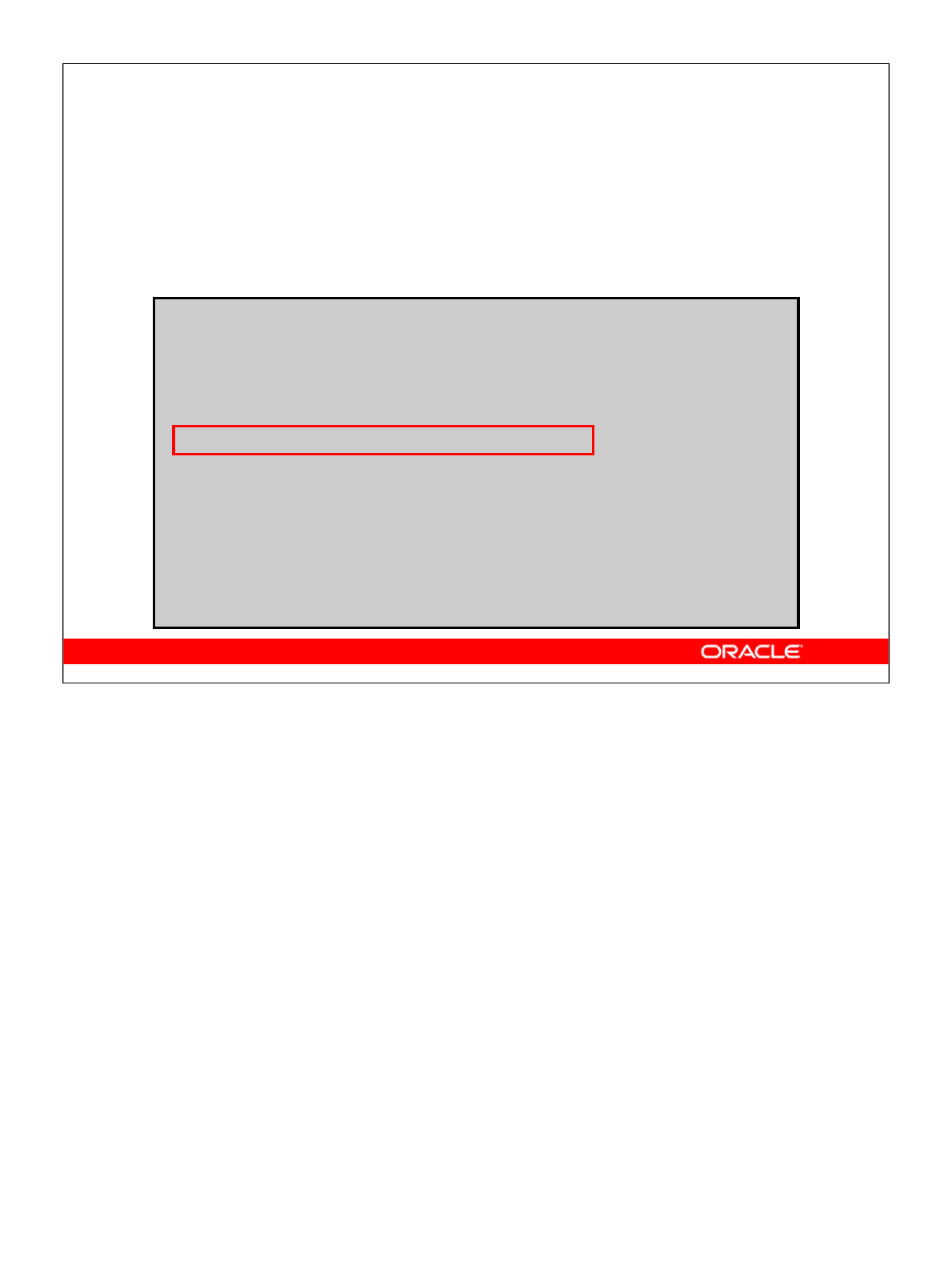
Oracle Database 10g: Develop PL/SQL Program Units 7-18
7-18 Copyright © 2004, Oracle. All rights reserved.
CREATE PROCEDURE get_departments(loc NUMBER) IS
TYPE dept_tabtype IS
TABLE OF departments%ROWTYPE;
depts dept_tabtype;
BEGIN
SELECT * BULK COLLECT INTO depts
FROM departments
WHERE location_id = loc;
FOR I IN 1 .. depts.COUNT LOOP
DBMS_OUTPUT.PUT_LINE(depts(i).department_name
||' '||depts(i).department_name);
END LOOP;
END;
Using BULK COLLECT INTO with Queries
The SELECT statement has been enhanced to support
BULK COLLECT INTO syntax. For example:
Using BULK COLLECT INTO with Queries
In Oracle Database 10g, when using a SELECT statement in PL/SQL, you can use the bulk
collection syntax shown in the example in the slide. Thus, you can quickly obtain a set of
rows without using a cursor mechanism.
The example reads all the department rows for a specified region into a PL/SQL table,
whose contents are displayed with the FOR loop that follows the SELECT statement.
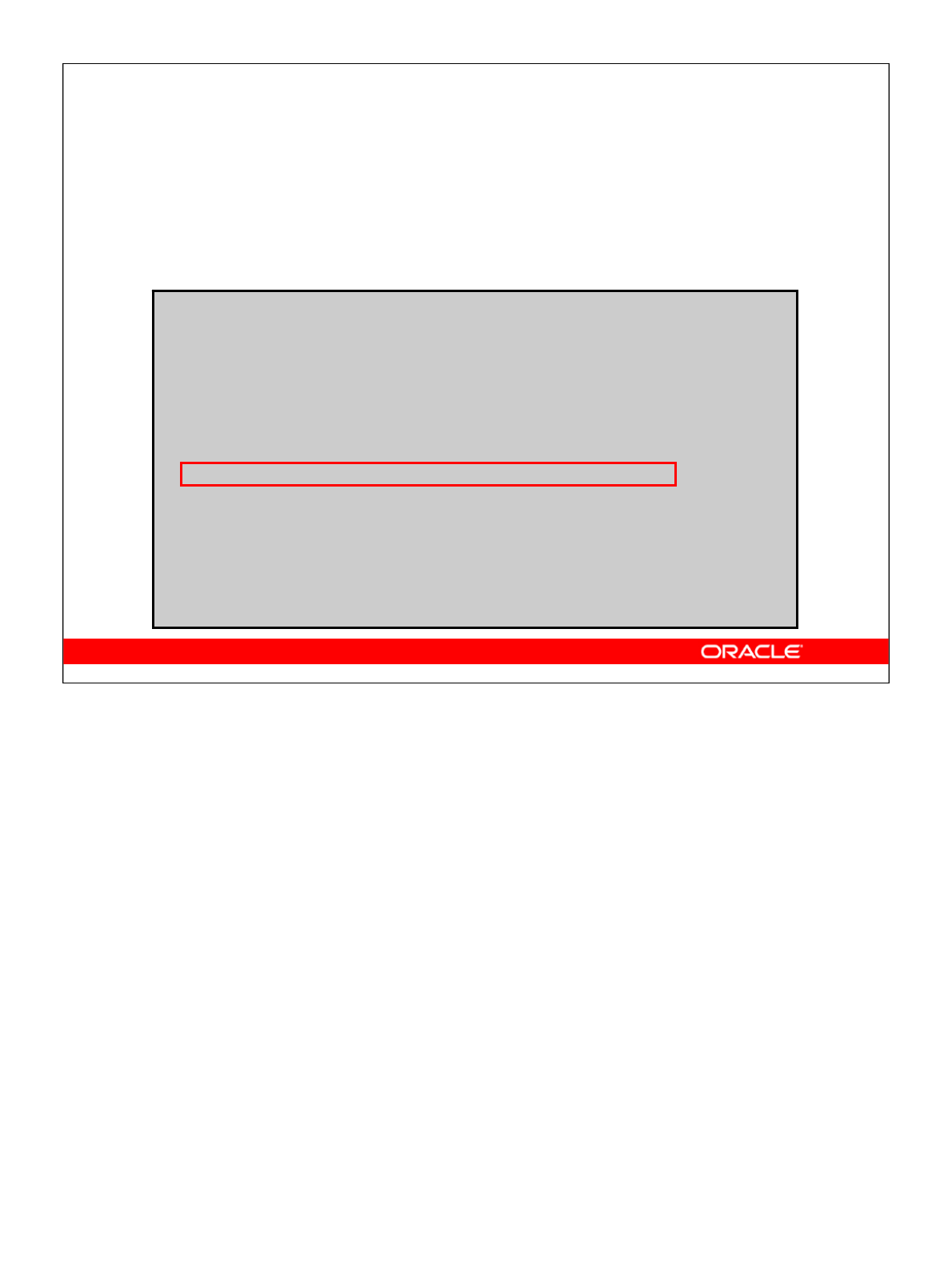
Oracle Database 10g: Develop PL/SQL Program Units 7-19
7-19 Copyright © 2004, Oracle. All rights reserved.
Using BULK COLLECT INTO with Cursors
The FETCH statement has been enhanced to support
BULK COLLECT INTO syntax. For example:
CREATE PROCEDURE get_departments(loc NUMBER) IS
CURSOR dept_csr IS SELECT * FROM departments
WHERE location_id = loc;
TYPE dept_tabtype IS TABLE OF dept_csr%ROWTYPE;
depts dept_tabtype;
BEGIN
OPEN dept_csr;
FETCH dept_csr BULK COLLECT INTO depts;
CLOSE dept_csr;
FOR I IN 1 .. depts.COUNT LOOP
DBMS_OUTPUT.PUT_LINE(depts(i).department_name
||' '||depts(i).department_name);
END LOOP;
END;
Using BULK COLLECT INTO with Cursors
In Oracle Database 10g, when using cursors in PL/SQL, you can use a form of the FETCH
statement that supports the bulk collection syntax shown in the example in the slide.
This example shows how BULK COLLECT INTO can be used with cursors.
You can also add a LIMIT clause to control the number of rows fetched in each operation.
The code example in the slide could be modified as follows:
CREATE PROCEDURE get_departments(loc NUMBER,
nrows NUMBER) IS
CURSOR dept_csr IS SELECT * FROM departments
W
HERE location
_
id = loc;
TYPE dept_tabtype IS TABLE OF dept_csr%ROWTYPE;
depts dept_tabtype;
BEGIN
OPEN dept_csr;
FETCH dept_csr BULK COLLECT INTO depts LIMIT nrows;
CLOSE dept_csr;
DBMS_OUTPUT.PUT_LINE(depts.COUNT||' rows read');
END;

Oracle Database 10g: Develop PL/SQL Program Units 7-20
7-20 Copyright © 2004, Oracle. All rights reserved.
CREATE PROCEDURE raise_salary(rate NUMBER) IS
TYPE emplist IS TABLE OF NUMBER;
TYPE numlist IS TABLE OF employees.salary%TYPE
INDEX BY BINARY_INTEGER;
emp_ids emplist := emplist(100,101,102,104);
new_sals numlist;
BEGIN
FORALL i IN emp_ids.FIRST .. emp_ids.LAST
UPDATE employees
SET commission_pct = rate * salary
WHERE employee_id = emp_ids(i)
RETURNING salary BULK COLLECT INTO new_sals;
FOR i IN 1 .. new_sals.COUNT LOOP ...
END;
Using BULK COLLECT INTO
with a RETURNING Clause
Example:
Using BULK COLLECT INTO with a RETURNING Clause
Bulk binds can be used to improve the performance of FOR loops that reference
collections and return DML. If you have, or plan to have, PL/SQL code that does this, then
you can use the FORALL keyword along with the RETURNING and BULK COLLECT
INTO keywords to improve performance.
In the example shown in the slide, the salary information is retrieved from the
EMPLOYEES table and collected into the new_sals array. The new_sals collection is
returned in bulk to the PL/SQL engine.
The example in the slide shows an incomplete FOR loop that is used to iterate through the
new salary data received from the UPDATE operation, and process the results.
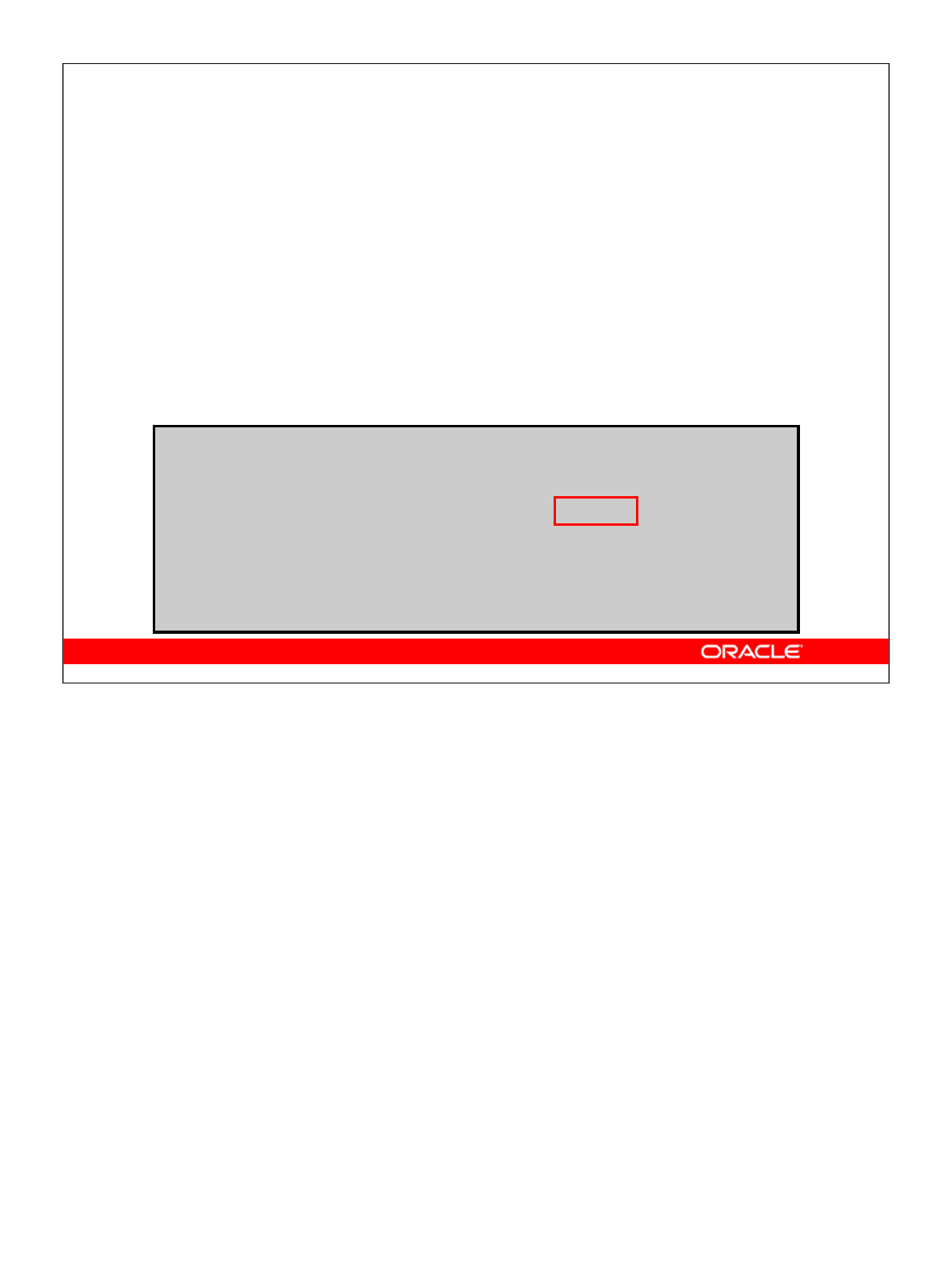
Oracle Database 10g: Develop PL/SQL Program Units 7-21
7-21 Copyright © 2004, Oracle. All rights reserved.
The NOCOPY hint:
•Is a request to the PL/SQL compiler to pass OUT
and IN OUT parameters by reference rather than
by value
•Enhances performance by reducing overhead
when passing parameters
Using the NOCOPY Hint
DECLARE
TYPE emptabtype IS TABLE OF employees%ROWTYPE;
emp_tab emptabtype;
PROCEDURE populate(tab IN OUT NOCOPY emptabtype)
IS BEGIN ... END;
BEGIN
populate(emp_tab);
END;
/
Using the NOCOPY Hint
Note that PL/SQL subprograms supports three parameter passing modes: IN, OUT, and IN
OUT. By default:
• The IN parameter is passed by reference. A pointer to the IN actual parameter is
passed to the corresponding formal parameter. So both parameters reference the
same memory location, which holds the value of the actual parameter.
• The OUT and IN OUT parameters are passed by value. The value of the OUT or IN
OUT actual parameter is copied into the corresponding formal parameter. Then, if the
subprogram exits normally, the values assigned to the OUT and IN OUT formal
parameters are copied into the corresponding actual parameters.
Using NOCOPY with OUT or IN OUT parameters that represent large data structures (such
as collections, records, and instances of object types), all this copying with OUT and IN
OUT parameters, slows down execution and uses up memory. To prevent this overhead,
you can specify the NOCOPY hint, which enables the PL/SQL compiler to pass OUT and
IN OUT parameters by reference.
The slide shows an example of declaring an IN OUT parameter with the NOCOPY hint.

Oracle Database 10g: Develop PL/SQL Program Units 7-22
7-22 Copyright © 2004, Oracle. All rights reserved.
Effects of the NOCOPY Hint
•If the subprogram exits with an exception that is
not handled:
–You cannot rely on the values of the actual
parameters passed to a NOCOPY parameter
–Any incomplete modifications are not “rolled back”
•The remote procedure call (RPC) protocol enables
you to pass parameters only by value.
Effects of the NOCOPY Hint
As a trade-off for better performance, the NOCOPY hint enables you to trade well-defined
exception semantics for better performance. Its use affects exception handling in the
following ways:
• Because NOCOPY is a hint, not a directive, the compiler can pass NOCOPY
parameters to a subprogram by value or by reference. So, if the subprogram exits
with an unhandled exception, you cannot rely on the values of the NOCOPY actual
parameters.
• By default, if a subprogram exits with an unhandled exception, the values assigned to
its OUT and IN OUT formal parameters are not copied to the corresponding actual
parameters, and changes appear to roll back. However, when you specify NOCOPY,
assignments to the formal parameters immediately affect the actual parameters as
well. So, if the subprogram exits with an unhandled exception, the (possibly
unfinished) changes are not “rolled back.”
• Currently, the RPC protocol enables you to pass parameters only by value. So
exception semantics can change without notification when you partition applications.
For example, if you move a local procedure with NOCOPY parameters to a remote
site, those parameters are no longer passed by reference.

Oracle Database 10g: Develop PL/SQL Program Units 7-23
7-23 Copyright © 2004, Oracle. All rights reserved.
NOCOPY Hint Can Be Ignored
The NOCOPY hint has no effect if:
•The actual parameter:
–Is an element of an index-by table
–Is constrained (for example, by scale or NOT NULL)
–And formal parameter are records, where one or
both records were declared by using %ROWTYPE or
%TYPE, and constraints on corresponding fields in
the records differ
–Requires an implicit data type conversion
•The subprogram is involved in an external or
remote procedure call
NOCOPY Hint Can Be Ignored
In the following cases, the PL/SQL compiler ignores the NOCOPY hint and uses the by-
value parameter-passing method (with no error generated):
• The actual parameter is an element of an index-by table. This restriction does not
apply to entire index-by tables.
• The actual parameter is constrained (by scale or NOT NULL). This restriction does
not extend to constrained elements or attributes. Also, it does not apply to size-
constrained character strings.
• The actual and formal parameters are records; one or both records were declared by
using %ROWTYPE or %TYPE, and constraints on corresponding fields in the records
differ.
• The actual and formal parameters are records; the actual parameter was declared
(implicitly) as the index of a cursor FOR loop, and constraints on corresponding
fields in the records differ.
• Passing the actual parameter requires an implicit data type conversion.
• The subprogram is involved in an external or remote procedure call.
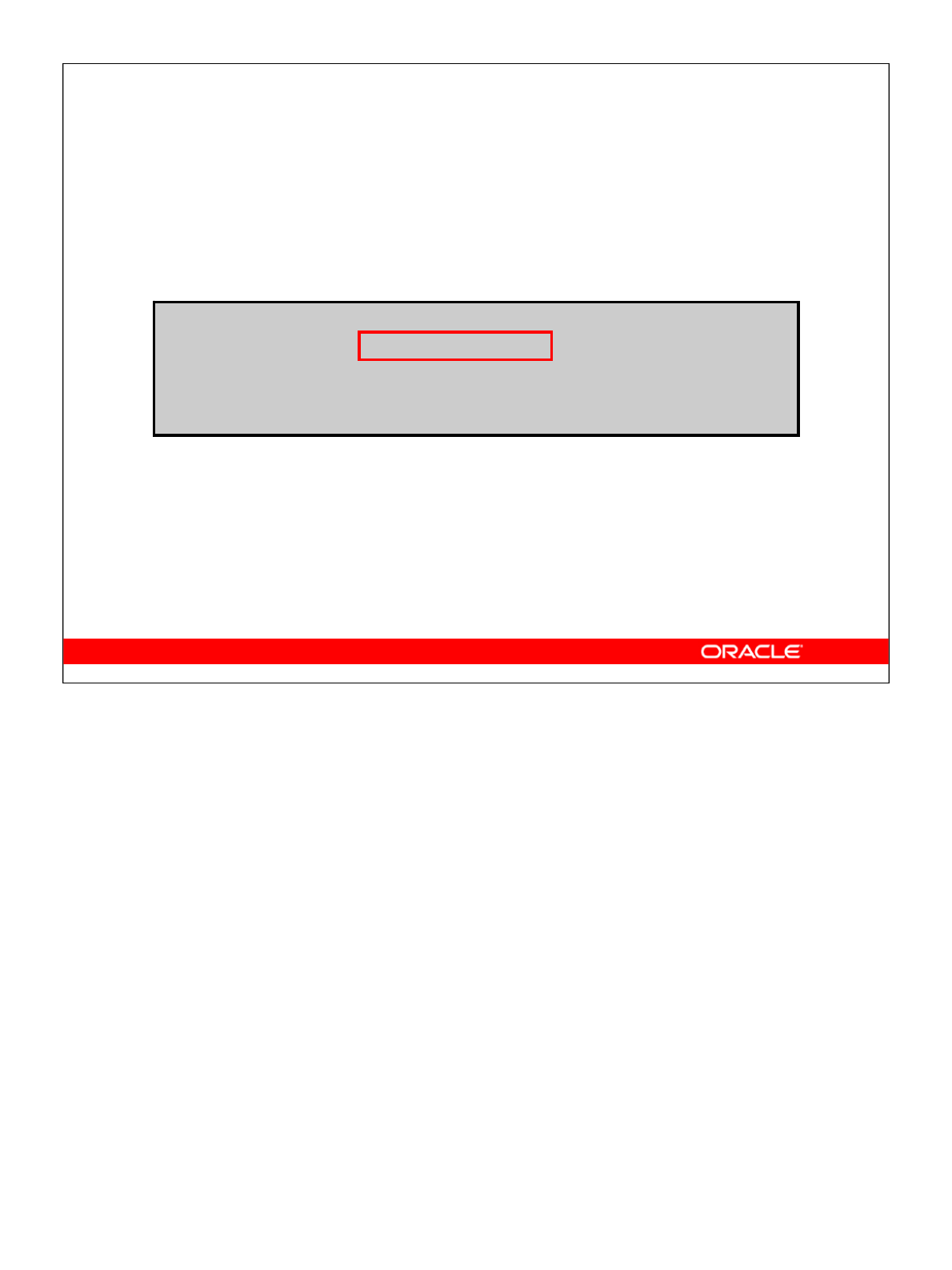
Oracle Database 10g: Develop PL/SQL Program Units 7-24
7-24 Copyright © 2004, Oracle. All rights reserved.
PARALLEL_ENABLE Hint
The PARALLEL_ENABLE hint:
•Can be used in functions as an optimization hint
•Indicates that a function can be used in a
parallelized query or parallelized DML statement
CREATE OR REPLACE FUNCTION f2 (p1 NUMBER)
RETURN NUMBER PARALLEL_ENABLE IS
BEGIN
RETURN p1 * 2;
END f2;
PARALLEL_ENABLE Hint
The PARALLEL_ENABLE keyword can be used in the syntax for declaring a function. It
is an optimization hint that indicates that the function can be used in a parallelized query
or parallelized DML statement. Oracle’s parallel execution feature divides the work of
executing a SQL statement across multiple processes. Functions called from a SQL
statement that is run in parallel can have a separate copy run in each of these processes,
with each copy called for only the subset of rows that are handled by that process.
For DML statements, prior to Oracle8ithe parallelization optimization looked to see if a
function was noted as having all four of RNDS, WNDS, RNPS, and WNPS specified in a
PRAGMA RESTRICT_REFERENCES declaration; those functions that were marked as
neither reading nor writing to either the database or package variables could run in
parallel. Again, those functions defined with a CREATE FUNCTION statement had their
code implicitly examined to determine if they were actually pure enough; parallelized
execution might occur even though a PRAGMA cannot be specified on these functions.
The PARALLEL_ENABLE keyword is placed after the return value type in the declaration
of the function, as shown in the example in the slide.
Note: The function should not use session state, such as package variables, because those
variables may not be shared among the parallel execution servers.

Oracle Database 10g: Develop PL/SQL Program Units 7-25
7-25 Copyright © 2004, Oracle. All rights reserved.
Summary
In this lesson, you should have learned how to:
•Create standardized constants and exceptions
using packages
•Develop and invoke local subprograms
•Control the run-time privileges of a subprogram by
setting the AUTHID directive
•Execute autonomous transactions
•Use the RETURNING clause with DML statements,
and bulk binding collections with the FORALL and
BULK COLLECT INTO clauses
•Pass parameters by reference using a NOCOPY hint
•Enable optimization with PARALLEL ENABLE hints
Summary
The lesson provides insights into managing your PL/SQL code by defining constants and
exceptions in a package specification. This enables a high degree of reuse and
standardization of code.
Local subprograms can be used to simplify and modularize a block of code where the
subprogram functionality is repeatedly used in the local block.
The run-time security privileges of a subprogram can be altered by using definer’s or
invoker’s rights.
Autonomous transactions can be executed without affecting an existing main transaction.
You should understand how to obtain performance gains by using the NOCOPY hint, bulk
binding and the RETURNING clauses in SQL statements, and the PARALLEL_ENABLE
hint for optimization of functions.

Oracle Database 10g: Develop PL/SQL Program Units 7-26
7-26 Copyright © 2004, Oracle. All rights reserved.
Practice 7: Overview
This practice covers the following topics:
•Creating a package that uses bulk fetch
operations
•Creating a local subprogram to perform an
autonomous transaction to audit a business
operation
•Testing AUTHID functionality
Practice 7: Overview
In this practice, you create a package that performs a bulk fetch of employees in a
specified department. The data is stored in a PL/SQL table in the package. You also
provide a procedure to display the contents of the table.
You add a procedure add_employee to the package that inserts new employees. The
procedure uses a local autonomous subprogram to write a log record each time the
add_employee procedure is called, whether it successfully adds a record or not.
Finally, you make the package use AUTHID of CURRENT_USER and test the behavior
with any other student. You test the code first with definer’s rights, and then with
invoker’s rights.

Oracle Database 10g: Develop PL/SQL Program Units 7-27
Practice 7
1. Update EMP_PKG with a new procedure to query employees in a specified
department.
a. In the specification, declare a procedure get_employees, with its parameter
called dept_id based on the employees.department_id column type.
Define an index-by PL/SQL type as a TABLE OF EMPLOYEES%ROWTYPE.
b. In the body of the package, define a private variable called emp_table based
on the type defined in the specification to hold employee records. Implement
the get_employees procedure to bulk fetch the data into the table.
c. Create a new procedure in the specification and body, called
show_employees, that does not take arguments and displays the contents of
the private PL/SQL table variable (if any data exists).
Hint: Use the print_employee procedure.
d. Invoke the emp_pkg.get_employees procedure for department 30, and
then invoke emp_pkg.show_employees. Repeat this for department 60.
2. Your manager wants to keep a log whenever the add_employee procedure in the
package is invoked to insert a new employee into the EMPLOYEES table.
a. First, load and execute the script
E:\labs\PLPU\labs\lab_07_02_a.sql to create a log table called
LOG_NEWEMP, and a sequence called log_newemp_seq.
b. In the package body, modify the add_employee procedure, which performs
the actual INSERT operation, to have a local procedure called
audit_newemp. The audit_newemp procedure must use an autonomous
transaction to insert a log record into the LOG_NEWEMP table. Store the USER,
the current time, and the new employee name in the log table row. Use
log_newemp_seq to set the entry_id column.
Note: Remember to perform a COMMIT operation in a procedure with an
autonomous transaction.
c. Modify the add_employee procedure to invoke audit_emp before it
performs the insert operation.
d. Invoke the add_employee procedure for these new employees: Max
Smart in department 20 and Clark Kent in department 10. What happens?
e. Query the two EMPLOYEES records added, and the records in LOG_NEWEMP
table. How many log records are present?
f. Execute a ROLLBACK statement to undo the insert operations that have not
been committed. Use the same queries from Exercise 2e: the first to check
whether the employee rows for Smart and Kent have been removed, and the
second to check the log records in the LOG_NEWEMP table. How many log
records are present? Why?

Oracle Database 10g: Develop PL/SQL Program Units 7-28
Practice 7 (continued)
If you have time, complete the following exercise:
3. Modify the EMP_PKG package to use AUTHID of CURRENT_USER and test the
behavior with any other student.
Note: Verify whether the LOG_NEWEMP table exists from Exercise 2 in this practice.
a. Grant EXECUTE privilege on your EMP_PKG package to another student.
b. Ask the other student to invoke your add_employee procedure to insert
employee Jaco Pastorius in department 10. Remember to prefix the
package name with the owner of the package. The call should operate with
definer’s rights.
c. Now, execute a query of the employees in department 10. In which user’s
employee table did the new record get inserted?
d. Modify your package EMP_PKG specification to use an AUTHID
CURRENT_USER. Compile the body of EMP_PKG.
e. Ask the same student to execute the add_employee procedure again, to add
employee Joe Zawinal in department 10.
f. Query your employees in department 10. In which table was the new employee
added?
g. Write a query to display the records added in the LOG_NEWEMP tables. Ask the
other student to query his or her own copy of the table.

Copyright © 2004, Oracle. All rights reserved.
Managing Dependencies

Oracle Database 10g: Develop PL/SQL Program Units 8-2
8-2 Copyright © 2004, Oracle. All rights reserved.
Objectives
After completing this lesson, you should be able to do
the following:
•Track procedural dependencies
•Predict the effect of changing a database object
on stored procedures and functions
•Manage procedural dependencies
Lesson Aim
This lesson introduces you to object dependencies and implicit and explicit recompilation of
invalid objects.

Oracle Database 10g: Develop PL/SQL Program Units 8-3
8-3 Copyright © 2004, Oracle. All rights reserved.
Understanding Dependencies
Table
View
Database trigger
Procedure
Function
Package body
Package specification
User-defined object
and collection types
Function
Package specification
Procedure
Sequence
Synonym
Table
View
User-defined object
and collection types
Referenced objectsDependent objects
Dependent and Referenced Objects
Some objects reference other objects as part of their definitions. For example, a stored
procedure could contain a SELECT statement that selects columns from a table. For this
reason, the stored procedure is called a dependent object, whereas the table is called a
referenced object.
Dependency Issues
If you alter the definition of a referenced object, dependent objects may or may not continue
to work properly. For example, if the table definition is changed, the procedure may or may
not continue to work without error.
The Oracle server automatically records dependencies among objects. To manage
dependencies, all schema objects have a status (valid or invalid) that is recorded in the data
dictionary, and you can view the status in the USER_OBJECTS data dictionary view.
Status Significance
VALID The schema object has been compiled and can be immediately used when
referenced.
INVALID The schema object must be compiled before it can be used.
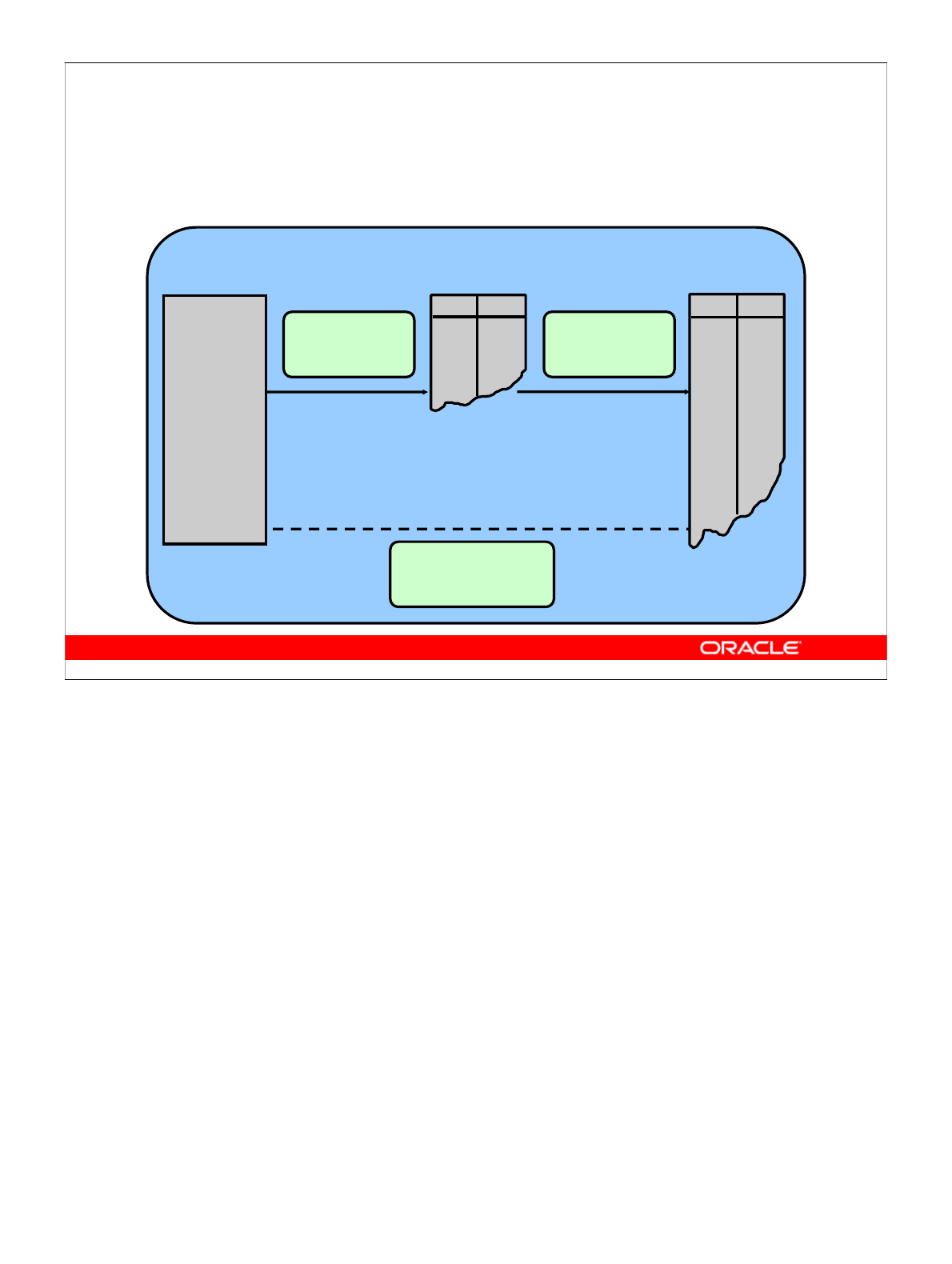
Oracle Database 10g: Develop PL/SQL Program Units 8-4
8-4 Copyright © 2004, Oracle. All rights reserved.
Dependencies
View or
procedure
Direct
dependency
Referenced
Indirect
dependency
Direct
dependency
Dependent
Table
Referenced
xxxxxxxxxxxxxx
vvvvvvvvvvvvvv
xxxxxxxxxxxxxx
vvvvvvvvvvvvvv
xxxxxxxxxxxxxx
vvvvvvvvvvvvvv
xxxxxxxxxxxxxx
vvvvvvvvvvvvvv
xxxxxxxxxxxxxx
vvvvvvvvvvvvvv
Procedure
Dependent
Dependent and Referenced Objects (continued)
A procedure or function can directly or indirectly (through an intermediate view, procedure,
function, or packaged procedure or function) reference the following objects:
•Tables
•Views
• Sequences
• Procedures
• Functions
• Packaged procedures or functions

Oracle Database 10g: Develop PL/SQL Program Units 8-5
8-5 Copyright © 2004, Oracle. All rights reserved.
Local Dependencies
xxxxxxxxxxxxxx
vvvvvvvvvvvvvv
xxxxxxxxxxxxxx
vvvvvvvvvvvvvv
xxxxxxxxxxxxxx
vvvvvvvvvvvvvv
vvvvvvvvvvvvvv
Procedure View
Local references
Procedure Table
vvvvvvvvvvvvvv
xxxxxxxxxxxxxx
vvvvvvvvvvvvvv
xxxxxxxxxxxxxx
vvvvvvvvvvvvvv
xxxxxxxxxxxxxx
vvvvvvvvvvvvvv
Direct local
dependency
Managing Local Dependencies
In the case of local dependencies, the objects are on the same node in the same database.
The Oracle server automatically manages all local dependencies, using the database’s
internal “depends-on” table. When a referenced object is modified, the dependent objects are
invalidated. The next time an invalidated object is called, the Oracle server automatically
recompiles it.
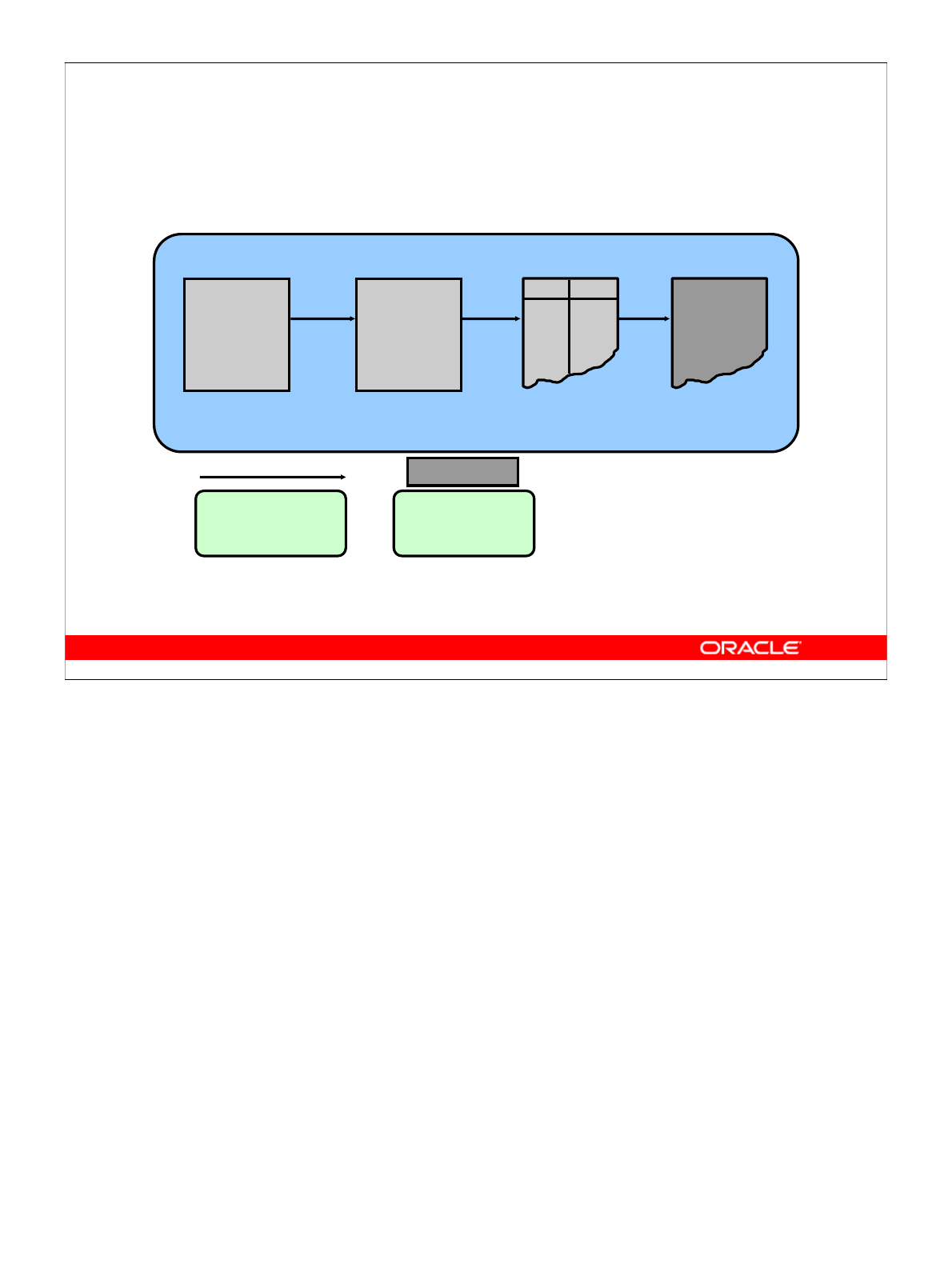
Oracle Database 10g: Develop PL/SQL Program Units 8-6
8-6 Copyright © 2004, Oracle. All rights reserved.
xxxxxxxxxxxxxx
vvvvvvvvvvvvvv
xxxxxxxxxxxxxx
vvvvvvvvvvvvvv
xxxxxxxxxxxxxx
vvvvvvvvvvvvvv
vvvvvvvvvvvvvv
Procedure View
Local references
Procedure Table
vvvvvvvvvvvvvv
xxxxxxxxxxxxxx
vvvvvvvvvvvvvv
xxxxxxxxxxxxxx
vvvvvvvvvvvvvv
xxxxxxxxxxxxxx
vvvvvvvvvvvvvv
Direct local
dependency
Local Dependencies
The Oracle server implicitly recompiles any INVALID
object when the object is next called.
Definition
change
INVALIDINVALIDINVALID
Managing Local Dependencies (continued)
Assume that the structure of the table on which a view is based is modified. When you
describe the view by using the iSQL*Plus DESCRIBE command, you get an error message
that states that the object is invalid to describe. This is because the command is not a SQL
command and, at this stage, the view is invalid because the structure of its base table is
changed. If you query the view now, then the view is recompiled automatically and you can
see the result if it is successfully recompiled.
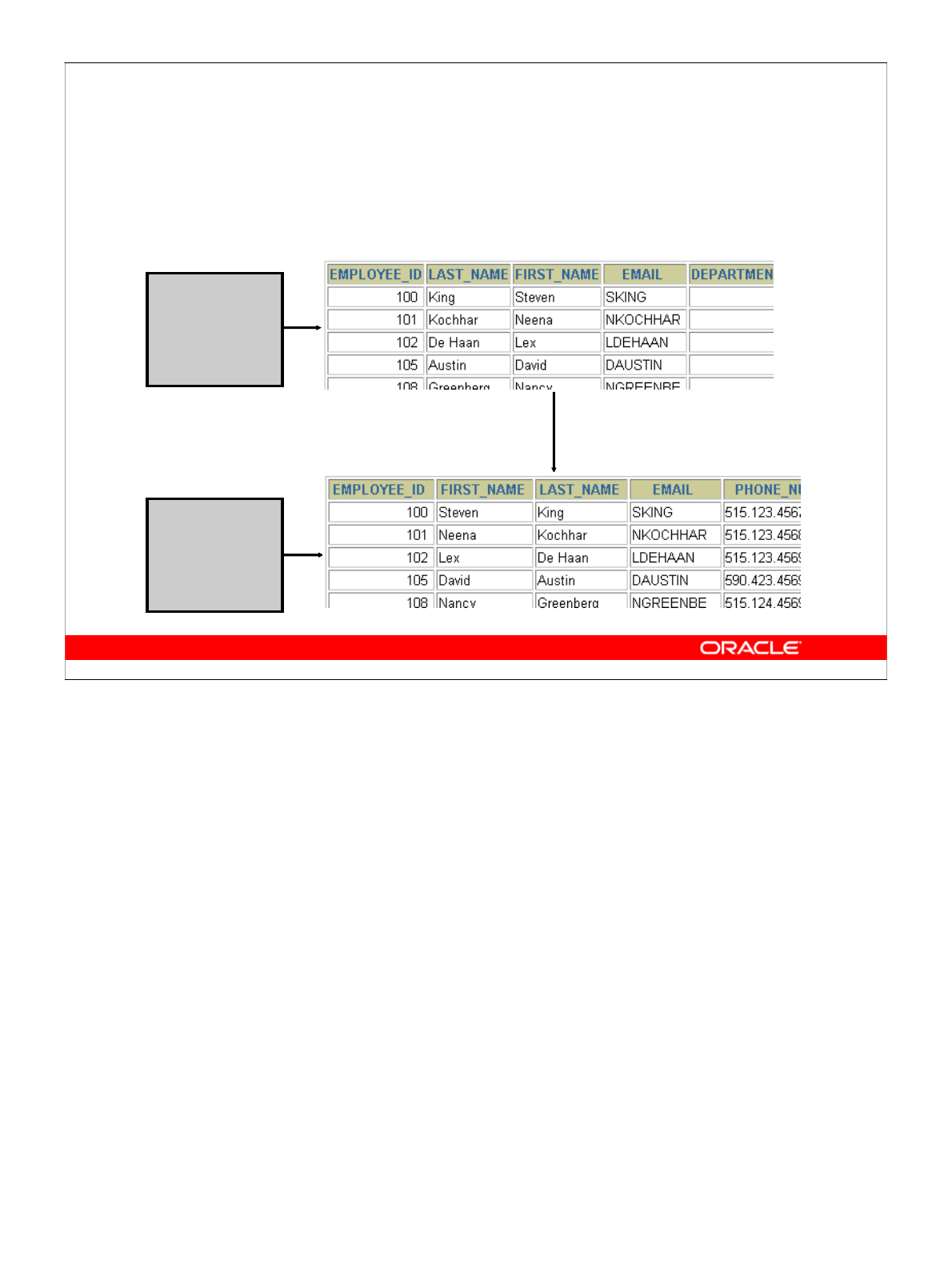
Oracle Database 10g: Develop PL/SQL Program Units 8-7
8-7 Copyright © 2004, Oracle. All rights reserved.
xxxxxxxxxxxxxxxxxxxxx
vvvvvvvvvvvvvvvvvvvvv
vvvvvvvvvvvvvvvvv
vvvvvvvvvvvvvvvvvvvvv
vvvvvvvvvvvvvvvvvvvvv
vvvvvvxxxxxxxxxxxxxxx
xxxxxxxxxxxxxxxxxxxxx
vvvvvvvvvvvvvvvvvvvvv
xxxxxxxxxxxxxxxxxxxxx
vvvvvvvvvvvvvvvvvvvvv
vvvvvvvvvvvvvvvvv
vvvvvvvvvvvvvvvvvvvvv
vvvvvvvvvvvvvvvvvvvvv
vvvvvvxxxxxxxxxxxxxxx
xxxxxxxxxxxxxxxxxxxxx
vvvvvvvvvvvvvvvvvvvvv
ADD_EMP
procedure
QUERY_EMP
procedure EMPLOYEES table
EMP_VW view
A Scenario of Local Dependencies
…
…
Example
The QUERY_EMP procedure directly references the EMPLOYEES table. The ADD_EMP
procedure updates the EMPLOYEES table indirectly by using the EMP_VW view.
In each of the following cases, will the ADD_EMP procedure be invalidated, and will it
successfully recompile?
1. The internal logic of the QUERY_EMP procedure is modified.
2. A new column is added to the EMPLOYEES table.
3. The EMP_VW view is dropped.
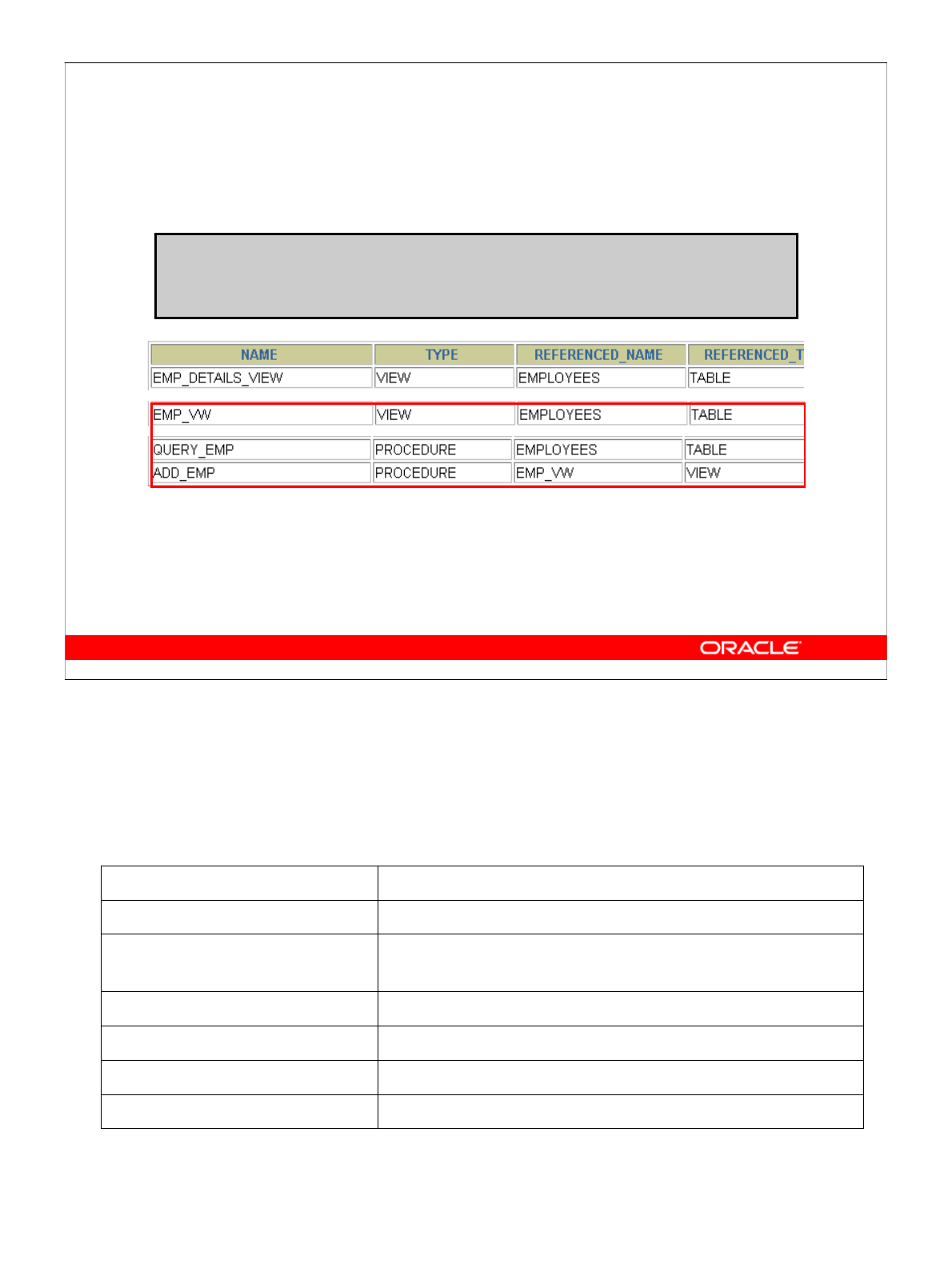
Oracle Database 10g: Develop PL/SQL Program Units 8-8
8-8 Copyright © 2004, Oracle. All rights reserved.
Displaying Direct Dependencies by Using
USER_DEPENDENCIES
SELECT name, type, referenced_name, referenced_type
FROM user_dependencies
WHERE referenced_name IN ('EMPLOYEES','EMP_VW' );
…
…
Displaying Direct Dependencies by Using USER_DEPENDENCIES
Determine which database objects to recompile manually by displaying direct dependencies
from the USER_DEPENDENCIES data dictionary view.
Examine the ALL_DEPENDENCIES and DBA_DEPENDENCIES views, each of which
contains the additional column OWNER, which references the owner of the object.
Column Column Description
NAME The name of the dependent object
TYPE The type of the dependent object (PROCEDURE, FUNCTION,
PACKAGE, PACKAGE BODY, TRIGGER, or VIEW)
REFERENCED_OWNER The schema of the referenced object
REFERENCED_NAME The name of the referenced object
REFERENCED_TYPE The type of the referenced object
REFERENCED_LINK_NAME The database link used to access the referenced object

Oracle Database 10g: Develop PL/SQL Program Units 8-9
8-9 Copyright © 2004, Oracle. All rights reserved.
Displaying Direct and Indirect
Dependencies
1. Run the script utldtree.sql that creates the
objects that enable you to display the direct and
indirect dependencies.
2. Execute the DEPTREE_FILL procedure.
EXECUTE deptree_fill('TABLE','SCOTT','EMPLOYEES')
Displaying Direct and Indirect Dependencies by Using Views Provided
by Oracle
Display direct and indirect dependencies from additional user views called DEPTREE and
IDEPTREE; these views are provided by Oracle.
Example
1. Make sure that the utldtree.sql script has been executed. This script is located in
the $ORACLE_HOME/rdbms/admin folder. (This script is supplied in the lab
folder of your class files.)
2. Populate the DEPTREE_TEMPTAB table with information for a particular referenced
object by invoking the DEPTREE_FILL procedure. There are three parameters for
this procedure:
object_type Type of the referenced object
object_owner Schema of the referenced object
object_name Name of the referenced object
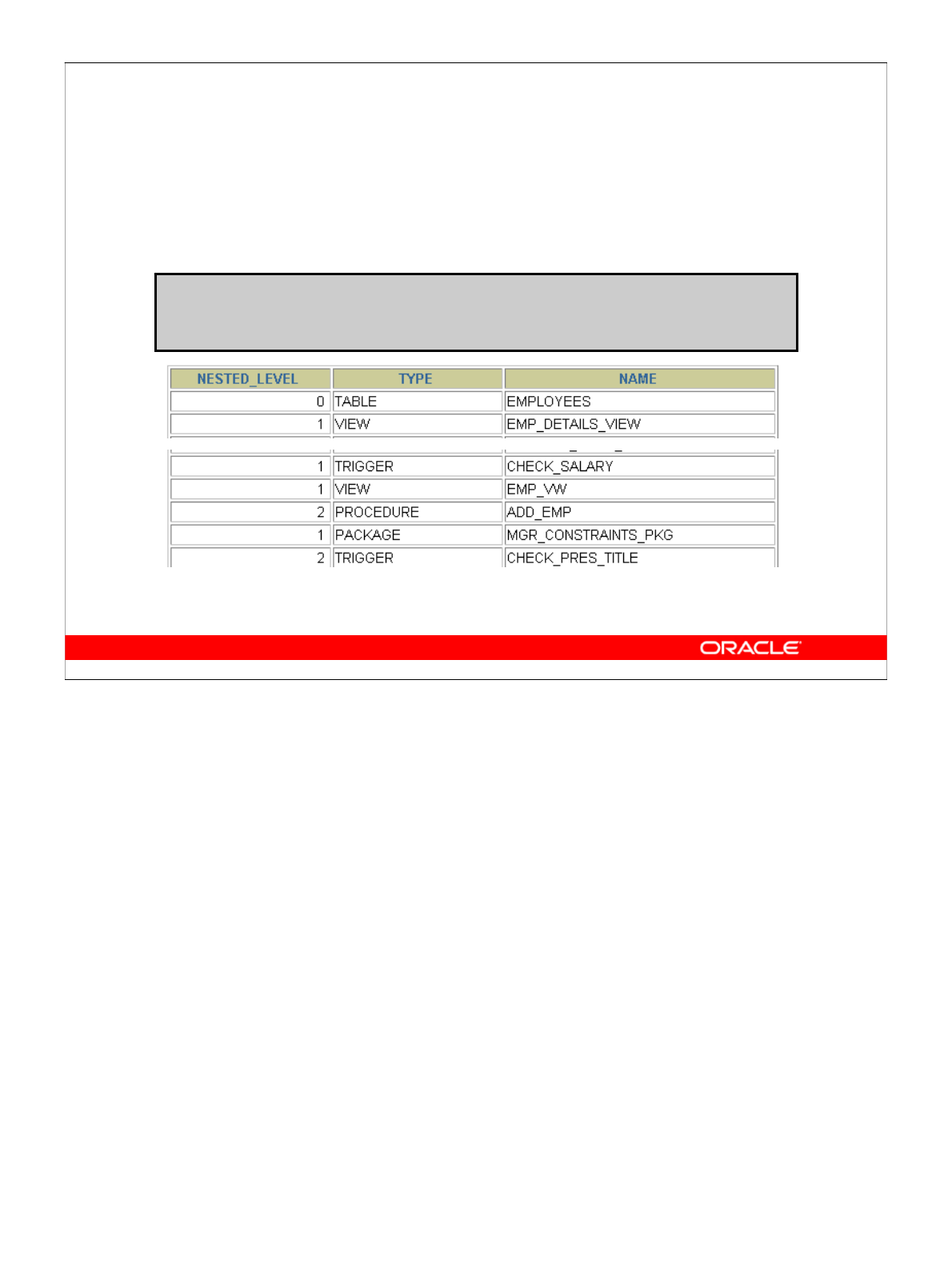
Oracle Database 10g: Develop PL/SQL Program Units 8-10
8-10 Copyright © 2004, Oracle. All rights reserved.
Displaying Dependencies
DEPTREE view
SELECT nested_level, type, name
FROM deptree
ORDER BY seq#;
…
…
Displaying Dependencies
Example
Display a tabular representation of all dependent objects by querying the DEPTREE view.
Display an indented representation of the same information by querying the IDEPTREE
view, which consists of a single column named DEPENDENCIES.
For example,
SELECT *
FROM ideptree;
provides a single column of indented output of the dependencies in a hierarchical structure.
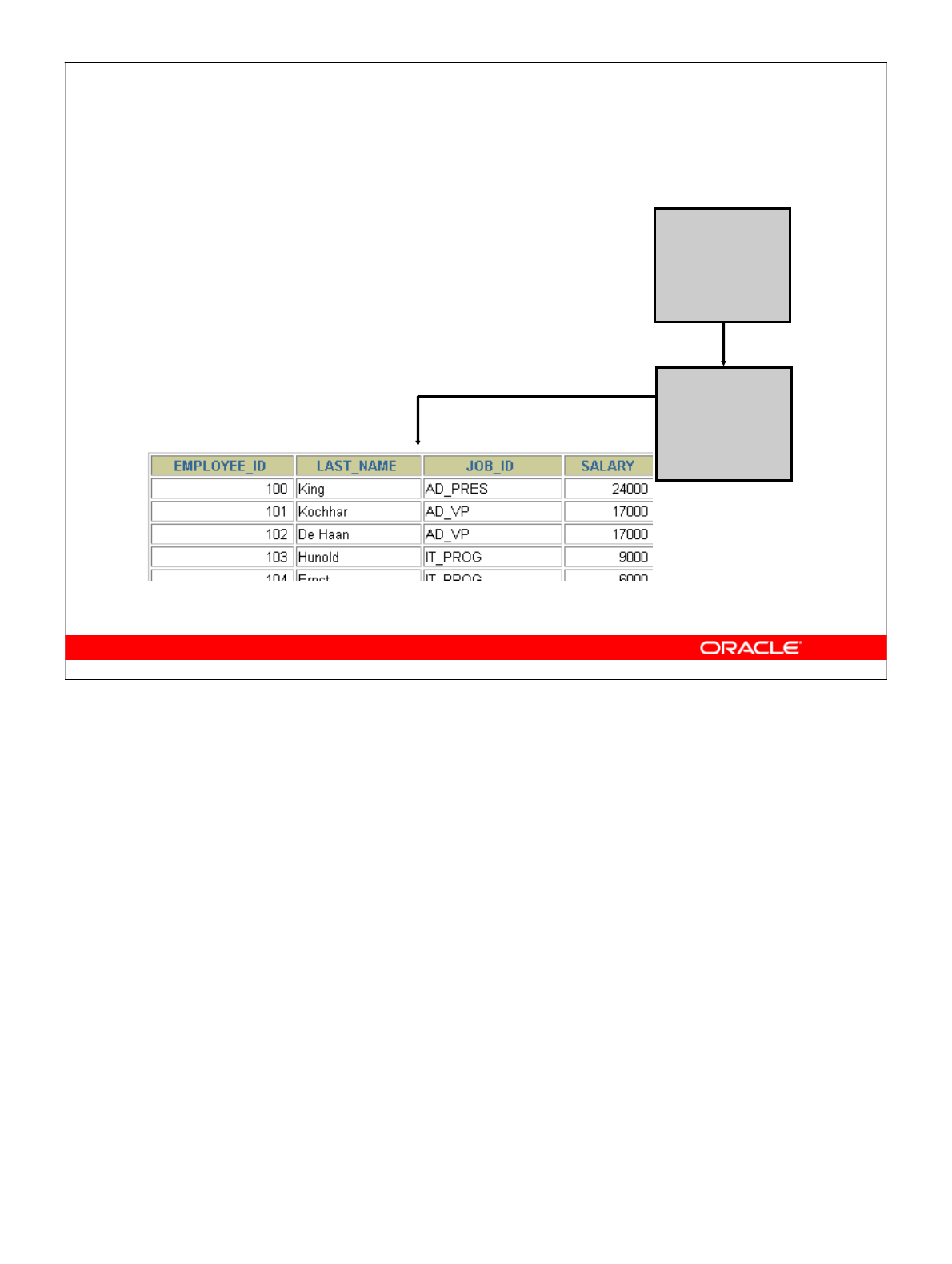
Oracle Database 10g: Develop PL/SQL Program Units 8-11
8-11 Copyright © 2004, Oracle. All rights reserved.
EMPLOYEES table
REDUCE_SAL
procedure
RAISE_SAL
procedure
Another Scenario of Local Dependencies
xxxxxxxxxxxxxxxxxxxxx
vvvvvvvvvvvvvvvvvvvvv
vvvvvvvvvvvvvvvvv
vvvvvvvvvvvvvvvvvvvvv
vvvvvvvvvvvvvvvvvvvvv
vvvvvvxxxxxxxxxxxxxxx
xxxxxxxxxxxxxxxxxxxxx
vvvvvvvvvvvvvvvvvvvvv
xxxxxxxxxxxxxxxxxxxxx
vvvvvvvvvvvvvvvvvvvvv
vvvvvvvvvvvvvvvvv
vvvvvvvvvvvvvvvvvvvvv
vvvvvvvvvvvvvvvvvvvvv
vvvvvvxxxxxxxxxxxxxxx
xxxxxxxxxxxxxxxxxxxxx
vvvvvvvvvvvvvvvvvvvvv
…
Another Scenario of Local Dependencies
Example 1
Predict the effect that a change in the definition of a procedure has on the recompilation of a
dependent procedure.
Suppose that the RAISE_SAL procedure updates the EMPLOYEES table directly, and that
the REDUCE_SAL procedure updates the EMPLOYEES table indirectly by way of
RAISE_SAL.
In each of the following cases, will the REDUCE_SAL procedure successfully recompile?
1. The internal logic of the RAISE_SAL procedure is modified.
2. One of the formal parameters to the RAISE_SAL procedure is eliminated.

Oracle Database 10g: Develop PL/SQL Program Units 8-12
8-12 Copyright © 2004, Oracle. All rights reserved.
QUERY_EMP
procedure EMPLOYEES public synonym
A Scenario of Local Naming Dependencies
EMPLOYEES
table
…
…
xxxxxxxxxxxxxxxxxxxxx
vvvvvvvvvvvvvvvvvvvvv
vvvvvvvvvvvvvvvvv
vvvvvvvvvvvvvvvvvvvvv
vvvvvvvvvvvvvvvvvvvvv
vvvvvvxxxxxxxxxxxxxxx
xxxxxxxxxxxxxxxxxxxxx
vvvvvvvvvvvvvvvvvvvvv
A Scenario of Local Naming Dependencies
Example 2
Be aware of the subtle case in which the creation of a table, view, or synonym may
unexpectedly invalidate a dependent object because it interferes with the Oracle server
hierarchy for resolving name references.
Predict the effect that the name of a new object has upon a dependent procedure.
Suppose that your QUERY_EMP procedure originally referenced a public synonym called
EMPLOYEES. However, you have just created a new table called EMPLOYEES within your
own schema. Does this change invalidate the procedure? Which of the two EMPLOYEES
objects does QUERY_EMP reference when the procedure recompiles?
Now suppose that you drop your private EMPLOYEES table. Does this invalidate the
procedure? What happens when the procedure recompiles?
You can track security dependencies in the USER_TAB_PRIVS data dictionary view.
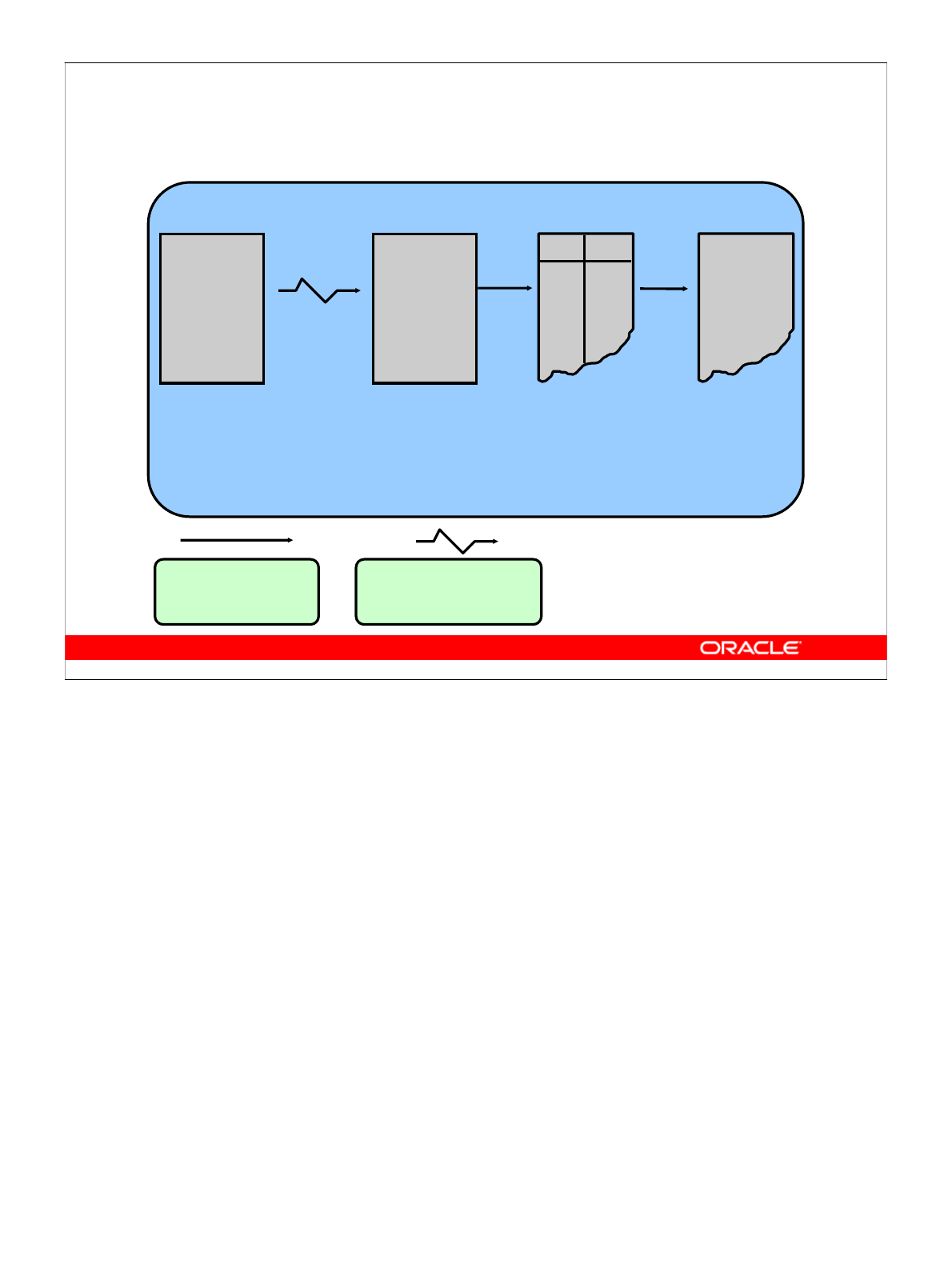
Oracle Database 10g: Develop PL/SQL Program Units 8-13
8-13 Copyright © 2004, Oracle. All rights reserved.
Understanding Remote Dependencies
xxxxxxxxxxxxxx
vvvvvvvvvvvvvv
xxxxxxxxxxxxxx
vvvvvvvvvvvvvv
xxxxxxxxxxxxxx
vvvvvvvvvvvvvv
xxxxxxxxxxxxxx
vvvvvvvvvvvvvv
xxxxxxxxxxxxxx
vvvvvvvvvvvvvv
Procedure View
Procedure Table
vvvvvvvvvvvvvv
xxxxxxxxxxxxxx
vvvvvvvvvvvvvv
xxxxxxxxxxxxxx
vvvvvvvvvvvvvv
xxxxxxxxxxxxxx
vvvvvvvvvvvvvv
Direct local
dependency Direct remote
dependency
Local and remote references
Network
Understanding Remote Dependencies
In the case of remote dependencies, the objects are on separate nodes. The Oracle server
does not manage dependencies among remote schema objects other than local-procedure-to-
remote-procedure dependencies (including functions, packages, and triggers). The local
stored procedure and all its dependent objects are invalidated but do not automatically
recompile when called for the first time.
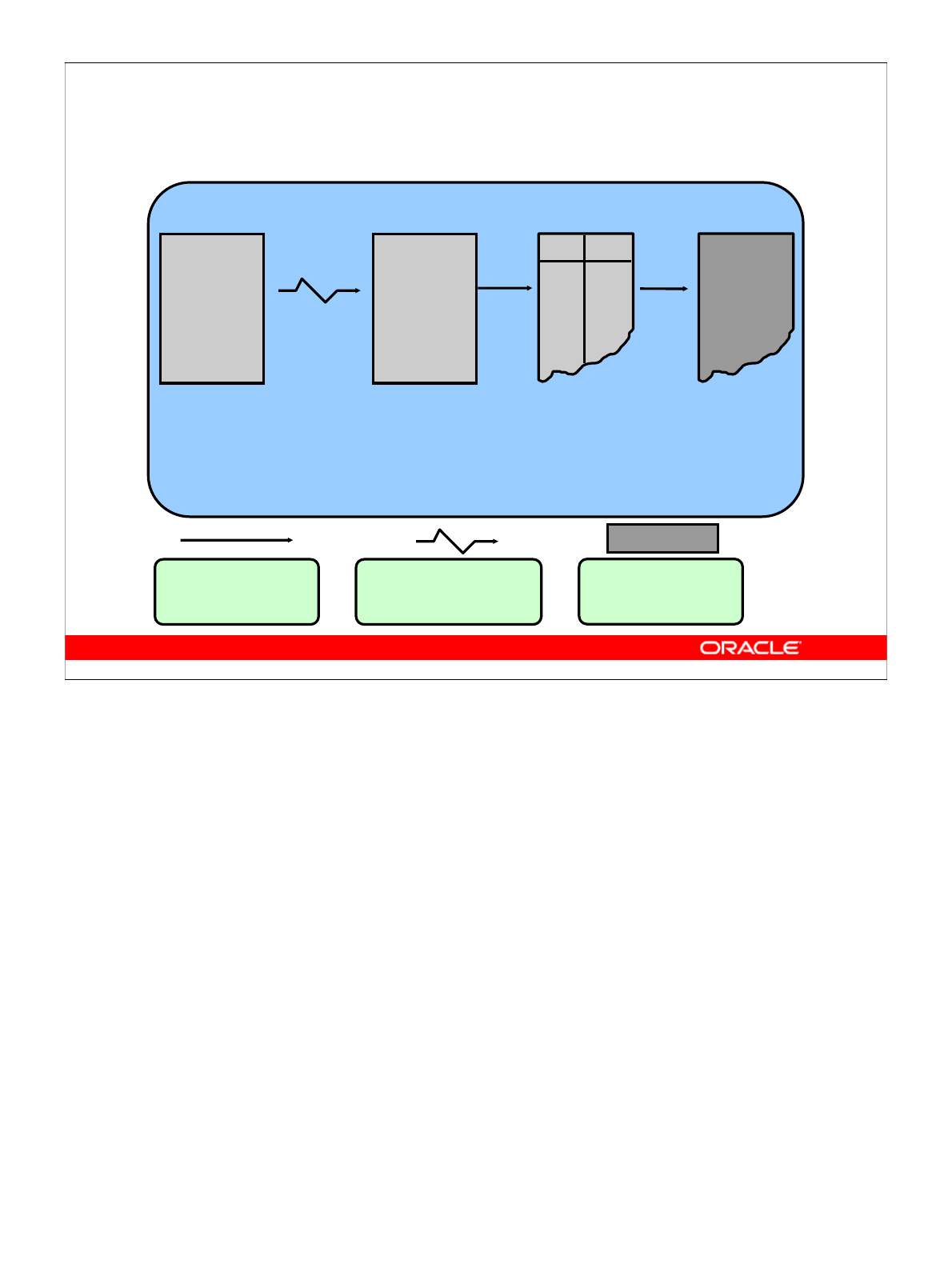
Oracle Database 10g: Develop PL/SQL Program Units 8-14
8-14 Copyright © 2004, Oracle. All rights reserved.
Understanding Remote Dependencies
xxxxxxxxxxxxxx
vvvvvvvvvvvvvv
xxxxxxxxxxxxxx
vvvvvvvvvvvvvv
xxxxxxxxxxxxxx
vvvvvvvvvvvvvv
xxxxxxxxxxxxxx
vvvvvvvvvvvvvv
xxxxxxxxxxxxxx
vvvvvvvvvvvvvv
Procedure View
Procedure Table
vvvvvvvvvvvvvv
xxxxxxxxxxxxxx
vvvvvvvvvvvvvv
xxxxxxxxxxxxxx
vvvvvvvvvvvvvv
xxxxxxxxxxxxxx
vvvvvvvvvvvvvv
Direct local
dependency Direct remote
dependency
Local and remote references
Network
Definition
change
INVALIDINVALIDVALID
Understanding Remote Dependencies (continued)
Recompilation of Dependent Objects: Local and Remote
• Verify successful explicit recompilation of the dependent remote procedures and
implicit recompilation of the dependent local procedures by checking the status of
these procedures within the USER_OBJECTS view.
• If an automatic implicit recompilation of the dependent local procedures fails, the
status remains invalid and the Oracle server issues a run-time error. Therefore, to avoid
disrupting production, it is strongly recommended that you recompile local dependent
objects manually, rather than relying on an automatic mechanism.

Oracle Database 10g: Develop PL/SQL Program Units 8-15
8-15 Copyright © 2004, Oracle. All rights reserved.
Concepts of Remote Dependencies
Remote dependencies are governed by the mode that
is chosen by the user:
•TIMESTAMP checking
•SIGNATURE checking
Concepts of Remote Dependencies
TIMESTAMP Checking
Each PL/SQL program unit carries a time stamp that is set when it is created or recompiled.
Whenever you alter a PL/SQL program unit or a relevant schema object, all its dependent
program units are marked as invalid and must be recompiled before they can execute. The
actual time stamp comparison occurs when a statement in the body of a local procedure calls
a remote procedure.
SIGNATURE Checking
For each PL/SQL program unit, both the time stamp and the signature are recorded. The
signature of a PL/SQL construct contains information about the following:
• The name of the construct (procedure, function, or package)
• The base types of the parameters of the construct
• The modes of the parameters (IN, OUT, or IN OUT)
• The number of the parameters
The recorded time stamp in the calling program unit is compared with the current time
stamp in the called remote program unit. If the time stamps match, the call proceeds. If they
do not match, then the remote procedure call (RPC) layer performs a simple comparison of
the signature to determine whether the call is safe or not. If the signature has not been
changed in an incompatible manner, then execution continues; otherwise, an error is
returned.

Oracle Database 10g: Develop PL/SQL Program Units 8-16
8-16 Copyright © 2004, Oracle. All rights reserved.
REMOTE_DEPENDENCIES_MODE Parameter
Setting REMOTE_DEPENDENCIES_MODE:
•As an init.ora parameter
REMOTE_DEPENDENCIES_MODE = value
•At the system level
ALTER SYSTEM SET
REMOTE_DEPENDENCIES_MODE = value
•At the session level
ALTER SESSION SET
REMOTE_DEPENDENCIES_MODE = value
REMOTE_DEPENDENCIES_MODE Parameter
Setting the REMOTE_DEPENDENCIES_MODE
value TIMESTAMP
SIGNATURE
Specify the value of the REMOTE_DEPENDENCIES_MODE parameter using one of the
three methods described in the slide.
Note: The calling site determines the dependency model.
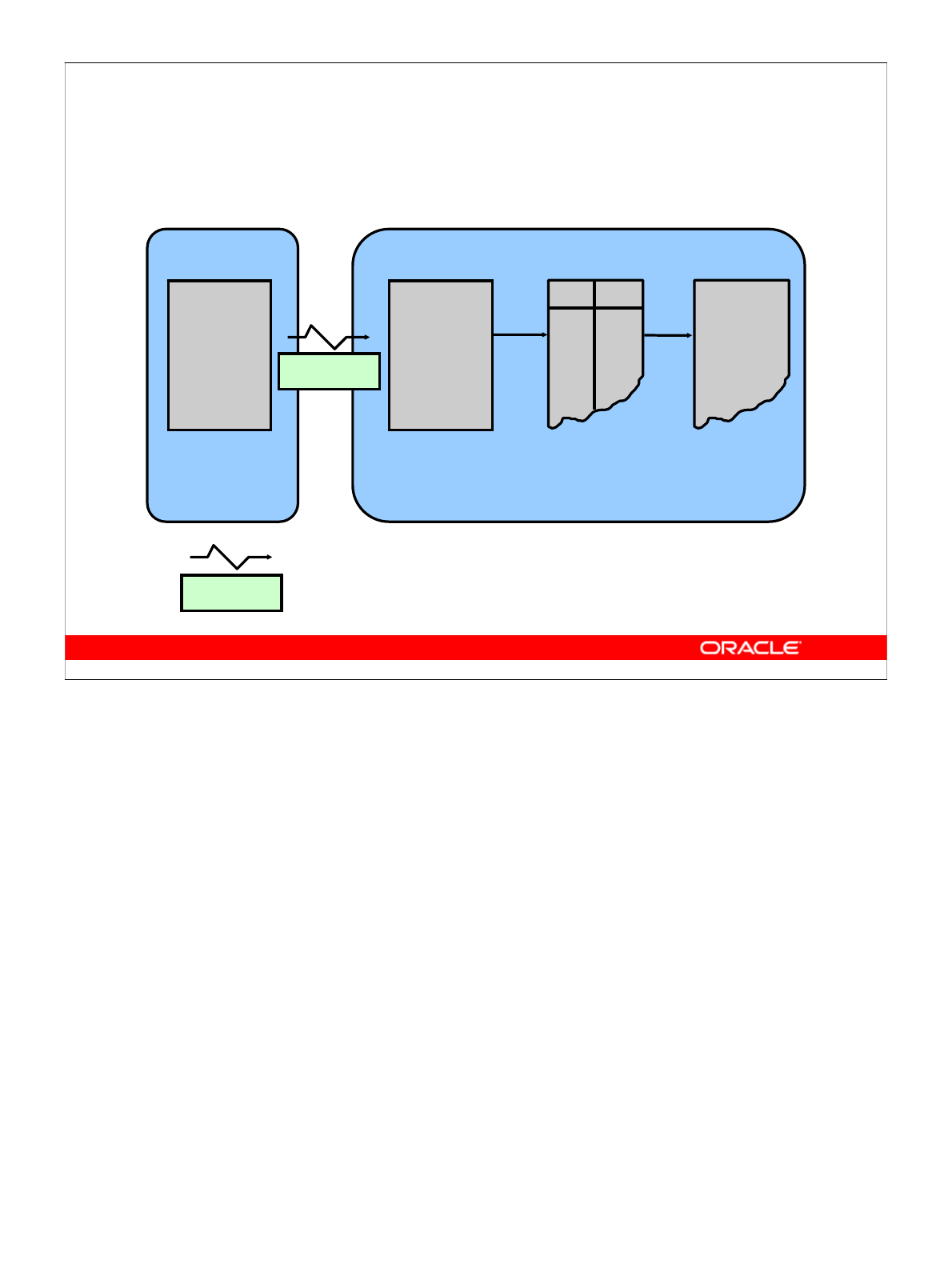
Oracle Database 10g: Develop PL/SQL Program Units 8-17
8-17 Copyright © 2004, Oracle. All rights reserved.
Remote Dependencies and
Time Stamp Mode
xxxxxxxxxxxxxx
vvvvvvvvvvvvvv
xxxxxxxxxxxxxx
vvvvvvvvvvvvvv
xxxxxxxxxxxxxx
vvvvvvvvvvvvvv
xxxxxxxxxxxxxx
vvvvvvvvvvvvvv
xxxxxxxxxxxxxx
vvvvvvvvvvvvvv
Procedure View
Procedure Table
vvvvvvvvvvvvvv
xxxxxxxxxxxxxx
vvvvvvvvvvvvvv
xxxxxxxxxxxxxx
vvvvvvvvvvvvvv
xxxxxxxxxxxxxx
vvvvvvvvvvvvvv
Network
Network
Using Time Stamp Mode for Automatic Recompilation of Local and
Remote Objects
If time stamps are used to handle dependencies among PL/SQL program units, then
whenever you alter a program unit or a relevant schema object, all its dependent units are
marked as invalid and must be recompiled before they can be run.

Oracle Database 10g: Develop PL/SQL Program Units 8-18
8-18 Copyright © 2004, Oracle. All rights reserved.
xxxxxxxxxxxxxx
vvvvvvvvvvvvvv
xxxxxxxxxxxxxx
vvvvvvvvvvvvvv
xxxxxxxxxxxxxx
vvvvvvvvvvvvvv
xxxxxxxxxxxxxx
vvvvvvvvvvvvvv
xxxxxxxxxxxxxx
vvvvvvvvvvvvvv
Procedure View
Procedure Table
vvvvvvvvvvvvvv
xxxxxxxxxxxxxx
vvvvvvvvvvvvvv
xxxxxxxxxxxxxx
vvvvvvvvvvvvvv
xxxxxxxxxxxxxx
vvvvvvvvvvvvvv
Network
Network
Remote Dependencies and
Time Stamp Mode
Definition
change
INVALIDINVALIDVALID
Using Time Stamp Mode for Automatic Recompilation of Local and
Remote Objects (continued)
In the example in the slide, the definition of the table changes. Therefore, all its dependent
units are marked as invalid and must be recompiled before they can be run.
• When remote objects change, it is strongly recommended that you recompile local
dependent objects manually in order to avoid disrupting production.
• The remote dependency mechanism is different from the automatic local dependency
mechanism already discussed. The first time a recompiled remote subprogram is
invoked by a local subprogram, you get an execution error and the local subprogram is
invalidated; the second time it is invoked, implicit automatic recompilation takes
place.

Oracle Database 10g: Develop PL/SQL Program Units 8-19
8-19 Copyright © 2004, Oracle. All rights reserved.
Remote Procedure B Compiles
at 8:00 a.m.
Remote procedure B
Valid
Compiles
Local Procedures Referencing Remote Procedures
A local procedure that references a remote procedure is invalidated by the Oracle server if
the remote procedure is recompiled after the local procedure is compiled.
Automatic Remote Dependency Mechanism
When a procedure compiles, the Oracle server records the time stamp of that compilation
within the Pcode of the procedure.
In the slide, when the remote procedure B is successfully compiled at 8:00 a.m., this time is
recorded as its time stamp.
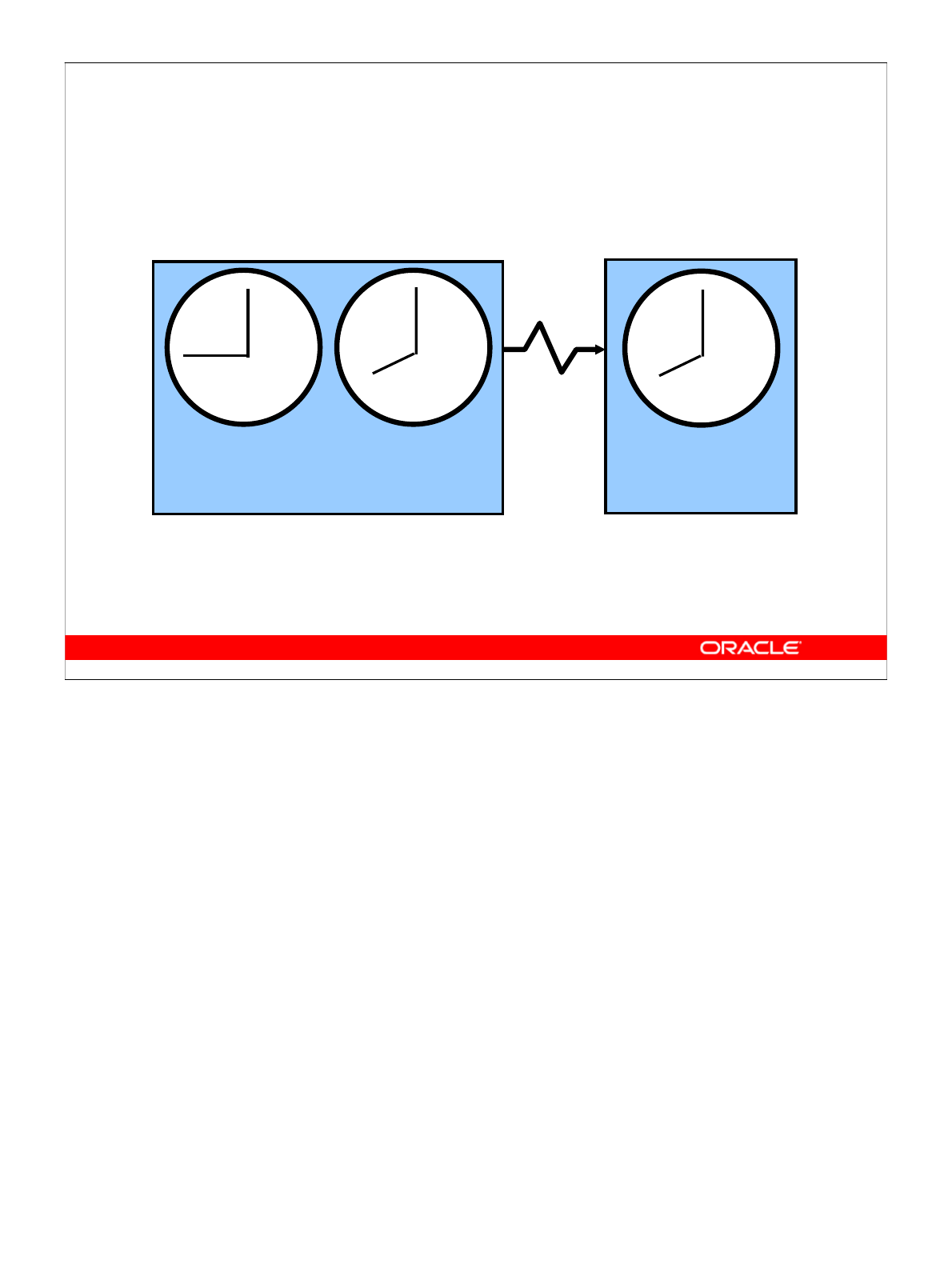
Oracle Database 10g: Develop PL/SQL Program Units 8-20
8-20 Copyright © 2004, Oracle. All rights reserved.
Local Procedure A Compiles
at 9:00 a.m.
Local procedure A
Valid
Remote procedure B
Time stamp
of B
Valid
Time stamp
of A Record time
stamp of B
Local Procedures Referencing Remote Procedures (continued)
Automatic Remote Dependency Mechanism (continued)
When a local procedure referencing a remote procedure compiles, the Oracle server also
records the time stamp of the remote procedure in the Pcode of the local procedure.
In the slide, local procedure A (which is dependent on remote procedure B) is compiled at
9:00 a.m. The time stamps of both procedure A and remote procedure B are recorded in the
Pcode of procedure A.
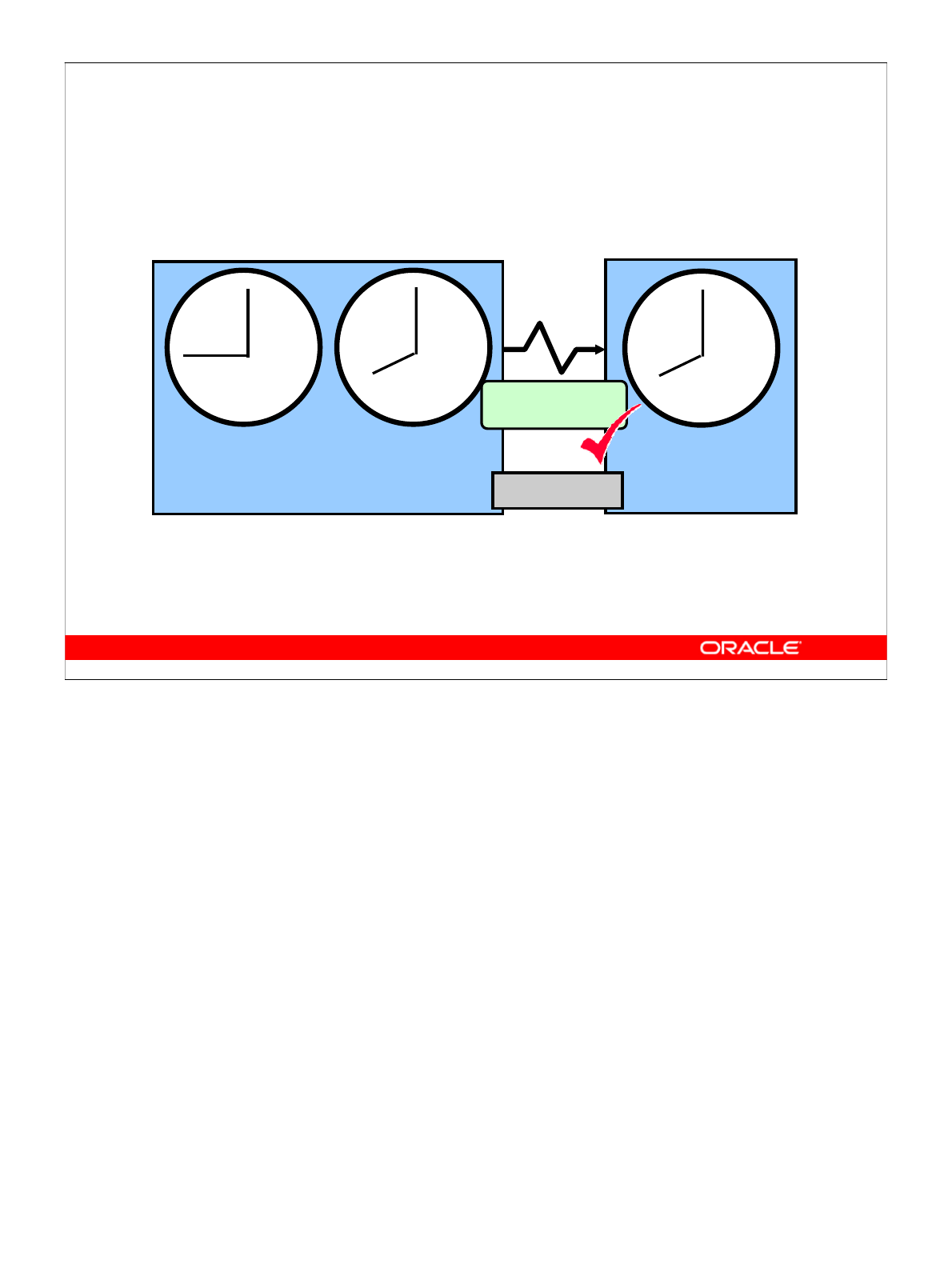
Oracle Database 10g: Develop PL/SQL Program Units 8-21
8-21 Copyright © 2004, Oracle. All rights reserved.
Execute Procedure A
Local procedure A
Valid
Remote procedure B
Time stamp
of B
Valid
Time stamp
of A Time stamp
of B
Time stamp
comparison
Execute B
Automatic Remote Dependency
When the local procedure is invoked, at run time the Oracle server compares the two time
stamps of the referenced remote procedure.
If the time stamps are equal (indicating that the remote procedure has not recompiled), the
Oracle server executes the local procedure.
In the example in the slide, the time stamp recorded with Pcode of remote procedure B is
the same as that recorded with local procedure A. Therefore, local procedure A is valid.

Oracle Database 10g: Develop PL/SQL Program Units 8-22
8-22 Copyright © 2004, Oracle. All rights reserved.
Remote Procedure B Recompiled
at 11:00 a.m.
Valid
Compiles
Remote procedure B
Local Procedures Referencing Remote Procedures
Assume that the remote procedure B is successfully recompiled at 11:00 a.m. The new time
stamp is recorded along with its Pcode.

Oracle Database 10g: Develop PL/SQL Program Units 8-23
8-23 Copyright © 2004, Oracle. All rights reserved.
Local procedure A
Valid
Remote procedure B
Time stamp
of B
Valid
Time stamp
of A Time stamp
of B
Time stamp
comparison
ERROR
Invalid
Execute Procedure A
Automatic Remote Dependency
If the time stamps are not equal (indicating that the remote procedure has recompiled), then
the Oracle server invalidates the local procedure and returns a run-time error. If the local
procedure (which is now tagged as invalid) is invoked a second time, then the Oracle server
recompiles it before executing, in accordance with the automatic local dependency
mechanism.
Note: If a local procedure returns a run-time error the first time it is invoked (indicating that
the remote procedure’s time stamp has changed), then you should develop a strategy to
reinvoke the local procedure.
In the example in the slide, the remote procedure is recompiled at 11:00 a.m. and this time is
recorded as its time stamp in the Pcode. The Pcode of local procedure A still has 8:00 a.m.
as the time stamp for remote procedure B. Because the time stamp recorded with the Pcode
of local procedure A is different from that recorded with the remote procedure B, the local
procedure is marked invalid. When the local procedure is invoked for the second time, it can
be successfully compiled and marked valid.
A disadvantage of time stamp mode is that it is unnecessarily restrictive. Recompilation of
dependent objects across the network is often performed when not strictly necessary, leading
to performance degradation.

Oracle Database 10g: Develop PL/SQL Program Units 8-24
8-24 Copyright © 2004, Oracle. All rights reserved.
Signature Mode
•The signature of a procedure is:
–The name of the procedure
–The data types of the parameters
–The modes of the parameters
•The signature of the remote procedure is saved in
the local procedure.
•When executing a dependent procedure, the
signature of the referenced remote procedure is
compared.
Signatures
To alleviate some of the problems with the time stamp–only dependency model, you can use
the signature model. This allows the remote procedure to be recompiled without affecting
the local procedures. This is important if the database is distributed.
The signature of a subprogram contains the following information:
• The name of the subprogram
• The data types of the parameters
• The modes of the parameters
• The number of parameters
• The data type of the return value for a function
If a remote program is changed and recompiled but the signature does not change, then the
local procedure can execute the remote procedure. With the time stamp method, an error
would have been raised because the time stamps would not have matched.

Oracle Database 10g: Develop PL/SQL Program Units 8-25
8-25 Copyright © 2004, Oracle. All rights reserved.
Recompiling a PL/SQL
Program Unit
Recompilation:
•Is handled automatically through implicit run-time
recompilation
•Is handled through explicit recompilation with the
ALTER statement
ALTER PROCEDURE [SCHEMA.]procedure_name COMPILE;
ALTER FUNCTION [SCHEMA.]function_name COMPILE;
ALTER PACKAGE [SCHEMA.]package_name
COMPILE [PACKAGE | SPECIFICATION | BODY];
ALTER TRIGGER trigger_name [COMPILE[DEBUG]];
Recompiling PL/SQL Objects
If the recompilation is successful, the object becomes valid. If not, the Oracle server returns
an error and the object remains invalid. When you recompile a PL/SQL object, the Oracle
server first recompiles any invalid object on which it depends.
Procedure: Any local objects that depend on a procedure (such as procedures that call the
recompiled procedure or package bodies that define the procedures that call the recompiled
procedure) are also invalidated.
Packages: The COMPILE PACKAGE option recompiles both the package specification and
the body, regardless of whether it is invalid. The COMPILE SPECIFICATION option
recompiles the package specification. Recompiling a package specification invalidates any
local objects that depend on the specification, such as subprograms that use the package.
Note that the body of a package also depends on its specification. The COMPILE BODY
option recompiles only the package body.
Triggers: Explicit recompilation eliminates the need for implicit run-time recompilation
and prevents associated run-time compilation errors and performance overhead.
The DEBUG option instructs the PL/SQL compiler to generate and store the code for use by
the PL/SQL debugger.

Oracle Database 10g: Develop PL/SQL Program Units 8-26
8-26 Copyright © 2004, Oracle. All rights reserved.
Unsuccessful Recompilation
Recompiling dependent procedures and functions is
unsuccessful when:
•The referenced object is dropped or renamed
•The data type of the referenced column is
changed
•The referenced column is dropped
•A referenced view is replaced by a view with
different columns
•The parameter list of a referenced procedure is
modified
Unsuccessful Recompilation
Sometimes a recompilation of dependent procedures is unsuccessful (for example, when a
referenced table is dropped or renamed).
The success of any recompilation is based on the exact dependency. If a referenced view is
re-created, any object that is dependent on the view needs to be recompiled. The success of
the recompilation depends on the columns that the view now contains, as well as the
columns that the dependent objects require for their execution. If the required columns are
not part of the new view, then the object remains invalid.

Oracle Database 10g: Develop PL/SQL Program Units 8-27
8-27 Copyright © 2004, Oracle. All rights reserved.
Successful Recompilation
Recompiling dependent procedures and functions is
successful if:
•The referenced table has new columns
•The data type of referenced columns has not
changed
•A private table is dropped, but a public table that
has the same name and structure exists
•The PL/SQL body of a referenced procedure has
been modified and recompiled successfully
Successful Recompilation
The recompilation of dependent objects is successful if:
• New columns are added to a referenced table
• All INSERT statements include a column list
• No new column is defined as NOT NULL
When a private table is referenced by a dependent procedure and the private table is
dropped, the status of the dependent procedure becomes invalid. When the procedure is
recompiled (either explicitly or implicitly) and a public table exists, the procedure can
recompile successfully but is now dependent on the public table. The recompilation is
successful only if the public table contains the columns that the procedure requires;
otherwise, the status of the procedure remains invalid.

Oracle Database 10g: Develop PL/SQL Program Units 8-28
8-28 Copyright © 2004, Oracle. All rights reserved.
Recompilation of Procedures
Minimize dependency failures by:
•Declaring records with the %ROWTYPE attribute
•Declaring variables with the %TYPE attribute
•Querying with the SELECT * notation
•Including a column list with INSERT statements
Recompilation of Procedures
You can minimize recompilation failure by following the guidelines that are shown in the
slide.

Oracle Database 10g: Develop PL/SQL Program Units 8-29
8-29 Copyright © 2004, Oracle. All rights reserved.
Packages and Dependencies
Package body
Procedure A
definition
Definition changed
Procedure A
declaration
Package specification
Valid
Stand-alone
procedure
Valid
Managing Dependencies
You can simplify dependency management with packages when referencing a package
procedure or function from a stand-alone procedure or function.
• If the package body changes and the package specification does not change, then the
stand-alone procedure that references a package construct remains valid.
• If the package specification changes, then the outside procedure referencing a package
construct is invalidated, as is the package body.
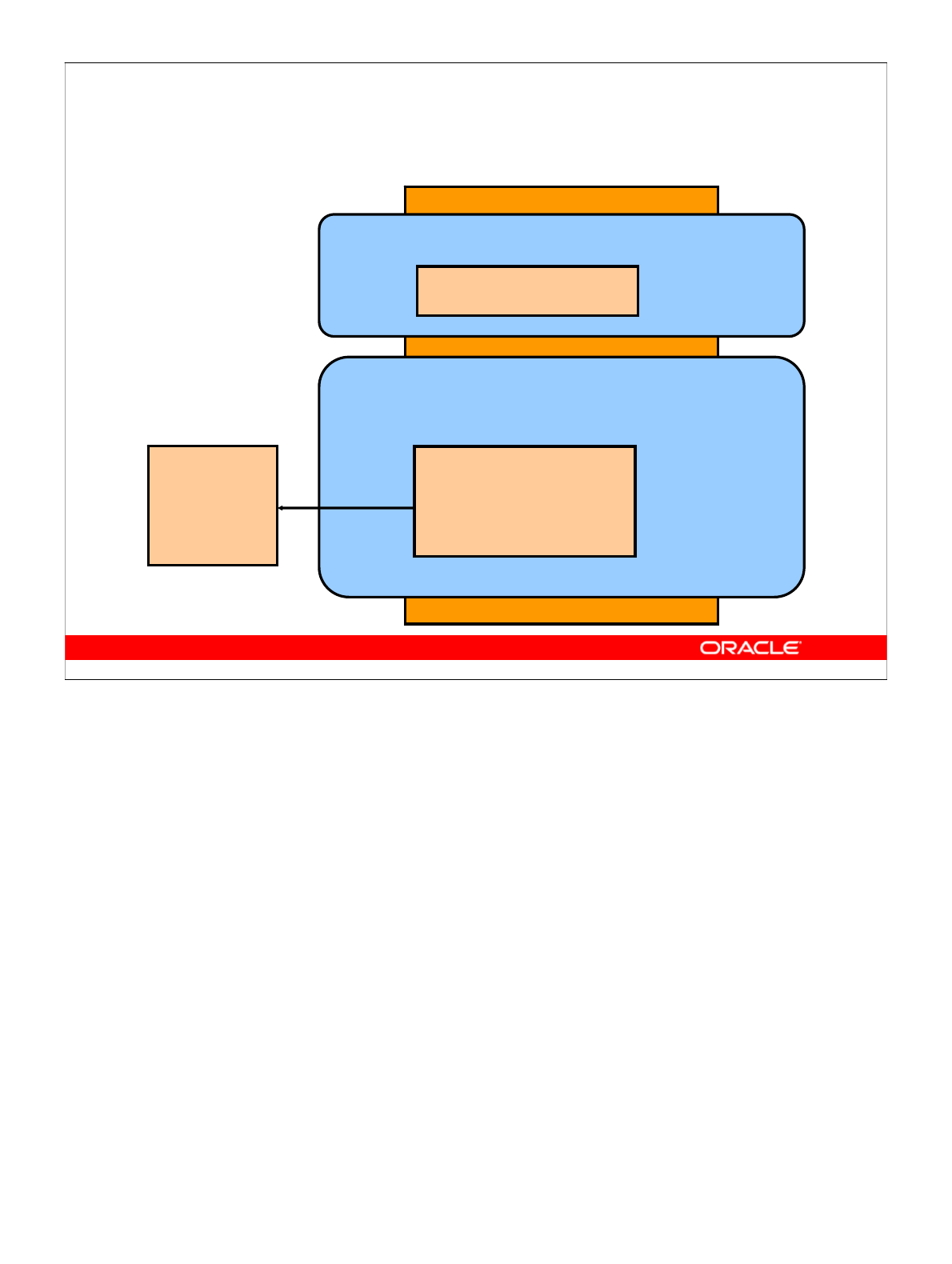
Oracle Database 10g: Develop PL/SQL Program Units 8-30
8-30 Copyright © 2004, Oracle. All rights reserved.
Package body
Procedure A
definition
Procedure A
declaration
Package specification
Valid
Packages and Dependencies
Stand-alone
procedure
Definition
changed
Invalid
Managing Dependencies (continued)
If a stand-alone procedure that is referenced within the package changes, then the entire
package body is invalidated, but the package specification remains valid. Therefore, it is
recommended that you bring the procedure into the package.

Oracle Database 10g: Develop PL/SQL Program Units 8-31
8-31 Copyright © 2004, Oracle. All rights reserved.
Summary
In this lesson, you should have learned how to:
•Keep track of dependent procedures
•Recompile procedures manually as soon as
possible after the definition of a database object
changes
Summary
Avoid disrupting production by keeping track of dependent procedures and recompiling
them manually as soon as possible after the definition of a database object changes.
Situation Automatic Recompilation
Procedure depends on a local object Yes, at first reexecution
Procedure depends on a remote procedure Yes, but at second reexecution. Use manual
recompilation for first reexecution, or reinvoke it a
second time.
Procedure depends on a remote object other
than a procedure No

Oracle Database 10g: Develop PL/SQL Program Units 8-32
8-32 Copyright © 2004, Oracle. All rights reserved.
Practice 8: Overview
This practice covers the following topics:
•Using DEPTREE_FILL and IDEPTREE to view
dependencies
•Recompiling procedures, functions, and packages
Practice 8: Overview
In this practice, you use the DEPTREE_FILL procedure and the IDEPTREE view to
investigate dependencies in your schema. In addition, you recompile invalid procedures,
functions, packages, and views.

Oracle Database 10g: Develop PL/SQL Program Units 8-33
Practice 8
1. Answer the following questions:
a. Can a table or a synonym be invalidated?
b. Consider the following dependency example:
The stand-alone procedure MY_PROC depends on the
MY_PROC_PACK package procedure. The MY_PROC_PACK
procedure’s definition is changed by recompiling the
package body. The MY_PROC_PACK procedure’s declaration is
not altered in the package specification.
In this scenario, is the stand-alone procedure MY_PROC invalidated?
2. Create a tree structure showing all dependencies involving your add_employee
procedure and your valid_deptid function.
Note: add_employee and valid_deptid were created in Lesson 2 (“Creating
Stored Functions”). You can run the solution scripts for Practice 2 if you need to create
the procedure and function.
a. Load and execute the utldtree.sql script, which is located in the
E:\lab\PLPU\labs folder.
b. Execute the deptree_fill procedure for the add_employee procedure.
c. Query the IDEPTREE view to see your results.
d. Execute the deptree_fill procedure for the valid_deptid function.
e. Query the IDEPTREE view to see your results.
If you have time, complete the following exercise:
3. Dynamically validate invalid objects.
a. Make a copy of your EMPLOYEES table, called EMPS.
b. Alter your EMPLOYEES table and add the column TOTSAL with data type
NUMBER(9,2).
c. Create and save a query to display the name, type, and status of all invalid
objects.
d. In the compile_pkg (created in Practice 6 in the lesson titled “Dynamic SQL
and Metadata”), add a procedure called recompile that recompiles all invalid
procedures, functions, and packages in your schema. Use Native Dynamic SQL
to ALTER the invalid object type and COMPILE it.
e. Execute the compile_pkg.recompile procedure.
f. Run the script file that you created in step 3c to check the status column value.
Do you still have objects with an INVALID status?


Copyright © 2004, Oracle. All rights reserved.
Manipulating Large Objects

Oracle Database 10g: Develop PL/SQL Program Units 9-2
9-2 Copyright © 2004, Oracle. All rights reserved.
Objectives
After completing this lesson, you should be able to do
the following:
•Compare and contrast LONG and LOB (large object)
data types
•Create and maintain LOB data types
•Differentiate between internal and external LOBs
•Use the DBMS_LOB PL/SQL package
•Describe the use of temporary LOBs
Lesson Aim
Databases have long been used to store large objects. However, the mechanisms built into
databases have never been as useful as the large object (LOB) data types that have been
provided since Oracle8. This lesson describes the characteristics of the new data types,
comparing and contrasting them with earlier data types. Examples, syntax, and issues
regarding the LOB types are also presented.
Note: A LOB is a data type and should not be confused with an object type.
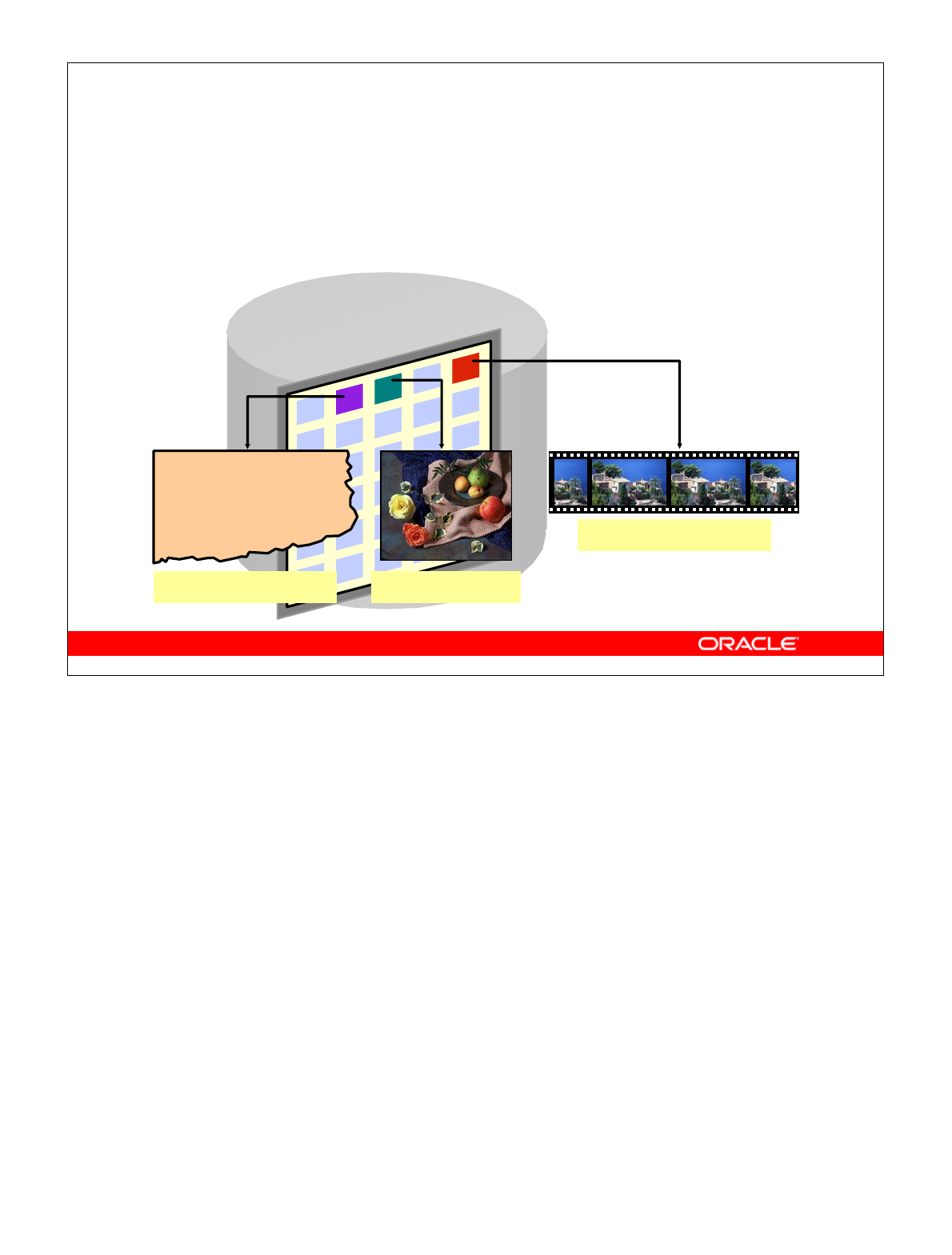
Oracle Database 10g: Develop PL/SQL Program Units 9-3
9-3 Copyright © 2004, Oracle. All rights reserved.
What Is a LOB?
LOBs are used to store large unstructured data such as
text, graphic images, films, and sound waveforms.
Photo (BLOB)
“Four score and seven years
ago our fathers brought forth
upon this continent, a new
nation, conceived in LIBERTY,
and dedicated to the
proposition that all men are
created equal.”
Text (CLOB)
Movie (BFILE)
LOB:Overview
A LOB is a data type that is used to store large, unstructured data such as text, graphic
images, video clippings, and so on. Structured data, such as a customer record, may be a few
hundred bytes, but even small amounts of multimedia data can be thousands of times larger.
Also, multimedia data may reside in operating system (OS) files, which may need to be
accessed from a database.
There are four large object data types:
•BLOB represents a binary large object, such as a video clip.
•CLOB represents a character large object.
•NCLOB represents a multibyte character large object.
•BFILE represents a binary file stored in an OS binary file outside the database. The
BFILE column or attribute stores a file locator that points to the external file.
LOBs are characterized in two ways, according to their interpretations by the Oracle server
(binary or character) and their storage aspects. LOBs can be stored internally (inside the
database) or in host files. There are two categories of LOBs:
• Internal LOBs (CLOB, NCLOB, BLOB): Stored in the database
• External files (BFILE): Stored outside the database

Oracle Database 10g: Develop PL/SQL Program Units 9-4
LOB: Overview (continued)
Oracle Database 10gperforms implicit conversion between CLOB and VARCHAR2 data
types. The other implicit conversions between LOBs are not possible. For example, if the
user creates a table Twith a CLOB column and a table Swith a BLOB column, the data is not
directly transferable between these two columns.
BFILEs can be accessed only in read-only mode from an Oracle server.

Oracle Database 10g: Develop PL/SQL Program Units 9-5
9-5 Copyright © 2004, Oracle. All rights reserved.
Contrasting LONG and LOB Data Types
LONG and LONG RAW
Single LONG column per table
Up to 2 GB
SELECT returns data
Data stored in-line
Sequential access to data
LOB
Multiple LOB columns per table
Up to 4 GB
SELECT returns locator
Data stored in-line or out-of-line
Random access to data
LONG and LOB Data Types
LONG and LONG RAW data types were previously used for unstructured data such as binary
images, documents, or geographical information. These data types are superseded by the
LOB data types. Oracle Database 10gprovides a LONG-to-LOB application programming
interface (API) to migrate from LONG columns to LOB columns. The following bulleted list
compares LOB functionality with the older types, where LONGs refer to LONG and LONG
RAW, and LOBs refer to all LOB data types:
• A table can have multiple LOB columns and object type attributes. A table can have
only one LONG column.
• The maximum size of LONGs is 2 GB; LOBs can be up to 4 GB.
•LOBs return the locator; LONGs return the data.
•LOBs store a locator in the table and the data in a different segment, unless the data is
less than 4,000 bytes; LONGs store all data in the same data block. In addition, LOBs
allow data to be stored in a separate segment and tablespace, or in a host file.
•LOBs can be object type attributes; LONGs cannot.
•LOBs support random piecewise access to the data through a file-like interface; LONGs
are restricted to sequential piecewise access.
The TO_LOB function can be used to convert LONG and LONG RAW values in a column to
LOB values. You use this in the SELECT list of a subquery in an INSERT statement.
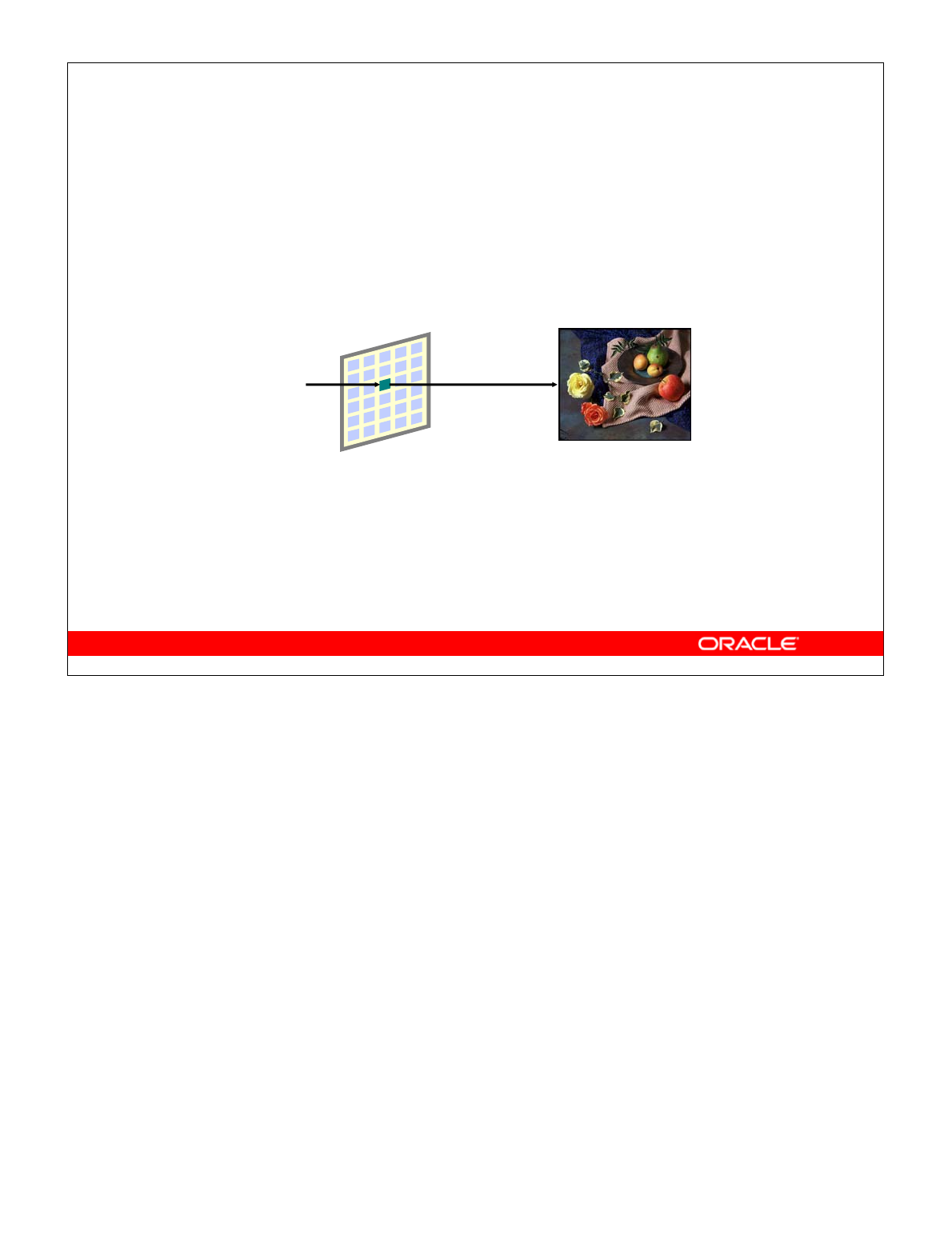
Oracle Database 10g: Develop PL/SQL Program Units 9-6
9-6 Copyright © 2004, Oracle. All rights reserved.
Anatomy of a LOB
The LOB column stores a locator to the LOB’s value.
LOB locator
LOB column
of a table LOB value
Components of a LOB
There are two distinct parts to a LOB:
•LOB value: The data that constitutes the real object being stored
•LOB locator: A pointer to the location of the LOB value stored in the database
Regardless of where the value of LOB is stored, a locator is stored in the row. You can think
of a LOB locator as a pointer to the actual location of the LOB value.
A LOB column does not contain the data; it contains the locator of the LOB value.
When a user creates an internal LOB, the value is stored in the LOB segment and a locator to
the out-of-line LOB value is placed in the LOB column of the corresponding row in the table.
External LOBs store the data outside the database, so only a locator to the LOB value is
stored in the table.
To access and manipulate LOBs without SQL DML, you must create a LOB locator. The
programmatic interfaces operate on the LOB values, using these locators in a manner similar
to OS file handles.

Oracle Database 10g: Develop PL/SQL Program Units 9-7
9-7 Copyright © 2004, Oracle. All rights reserved.
Internal LOBs
The LOB value is stored in the database.
“Four score and seven years ago
our fathers brought forth upon
this continent, a new nation,
conceived in LIBERTY, and dedicated
to the proposition that all men
are created equal.”
CLOB BLOB
Features of Internal LOBs
The internal LOB is stored in the Oracle server. A BLOB, NCLOB, or CLOB can be one of the
following:
• An attribute of a user-defined type
• A column in a table
• A bind or host variable
• A PL/SQL variable, parameter, or result
Internal LOBs can take advantage of Oracle features such as:
• Concurrency mechanisms
• Redo logging and recovery mechanisms
• Transactions with COMMIT or ROLLBACK
The BLOB data type is interpreted by the Oracle server as a bitstream, similar to the LONG
RAW data type.
The CLOB data type is interpreted as a single-byte character stream.
The NCLOB data type is interpreted as a multiple-byte character stream, based on the byte
length of the database national character set.

Oracle Database 10g: Develop PL/SQL Program Units 9-8
9-8 Copyright © 2004, Oracle. All rights reserved.
Managing Internal LOBs
•To interact fully with LOB, file-like interfaces are
provided in:
–PL/SQL package DBMS_LOB
–Oracle Call Interface (OCI)
–Oracle Objects for object linking and embedding
(OLE)
–Pro*C/C++ and Pro*COBOL precompilers
–JDBC (Java Database Connectivity)
•The Oracle server provides some support for LOB
management through SQL.
How to Manage LOBs
To manage an internal LOB, perform the following steps:
1. Create and populate the table containing the LOB data type.
2. Declare and initialize the LOB locator in the program.
3. Use SELECT FOR UPDATE to lock the row containing the LOB into the LOB locator.
4. Manipulate the LOB with DBMS_LOB package procedures, OCI calls, Oracle Objects
for OLE, Oracle precompilers, or JDBC using the LOB locator as a reference to the
LOB value.
You can also manage LOBs through SQL.
5. Use the COMMIT command to make any changes permanent.

Oracle Database 10g: Develop PL/SQL Program Units 9-9
9-9 Copyright © 2004, Oracle. All rights reserved.
What Are BFILEs?
The BFILE data type supports an external or file-based
large object as:
•Attributes in an object type
•Column values in a table
Movie (BFILE)
What Are BFILEs?
BFILEs are external large objects (LOBs) stored in OS files that are external to database
tables. The BFILE data type stores a locator to the physical file. A BFILE can be in GIF,
JPEG, MPEG, MPEG2, text, or other formats. The external LOBs may be located on hard
disks, CDROMs, photo CDs, or other media, but a single LOB cannot extend from one
medium or device to another. The BFILE data type is available so that database users can
access the external file system. Oracle Database 10gprovides:
• Definition of BFILE objects
• Association of BFILE objects to corresponding external files
• Security for BFILEs
The remaining operations that are required for using BFILEs are possible through the
DBMS_LOB package and OCI. BFILEs are read-only; they do not participate in transactions.
Support for integrity and durability must be provided by the operating system. The file must
be created and placed in the appropriate directory, giving the Oracle process privileges to
read the file. When the LOB is deleted, the Oracle server does not delete the file.
Administration of the files and the OS directory structures can be managed by the database
administrator (DBA), system administrator, or user. The maximum size of an external large
object depends on the operating system but cannot exceed four GB.
Note: BFILEs are available with the Oracle8 database and later releases.
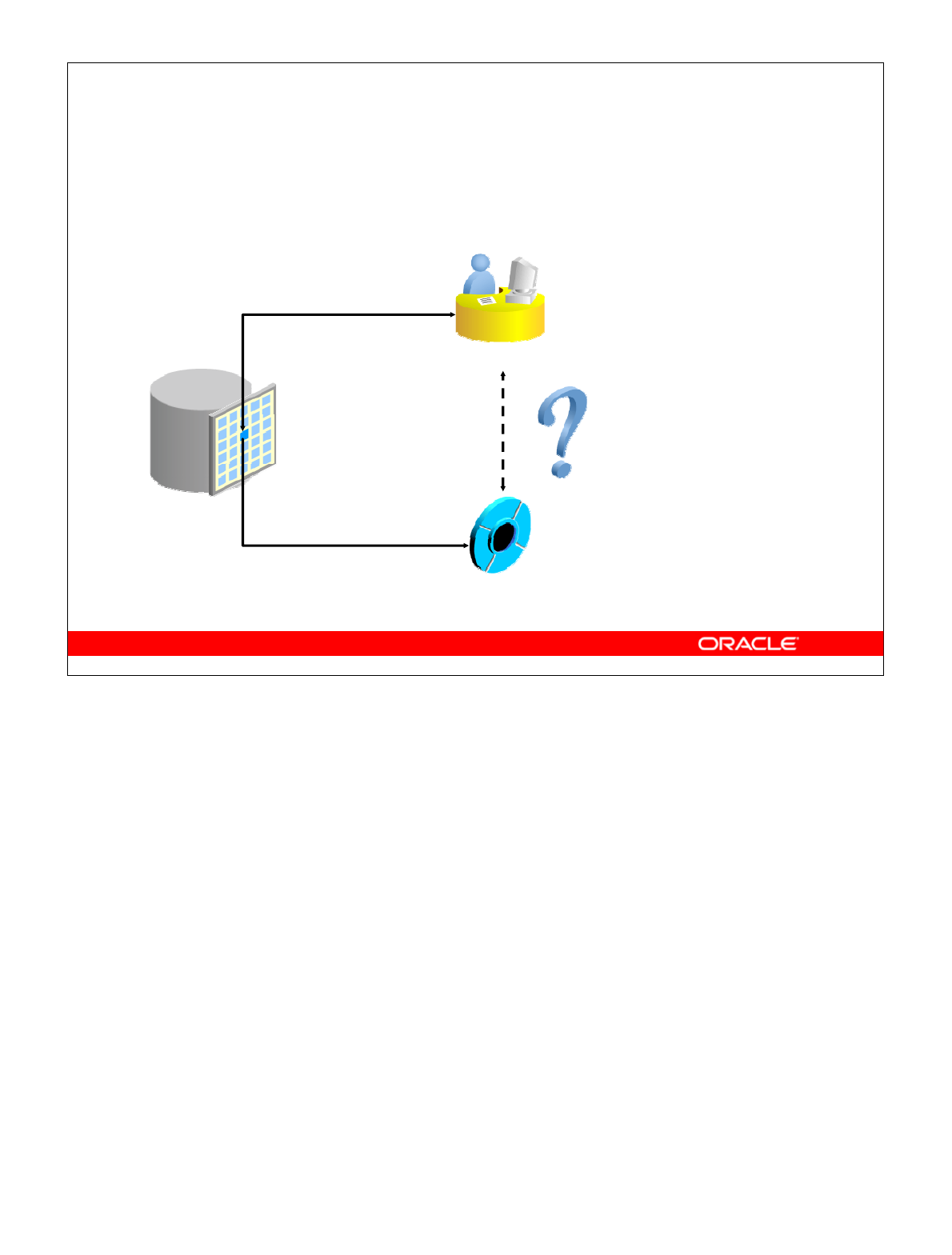
Oracle Database 10g: Develop PL/SQL Program Units 9-10
9-10 Copyright © 2004, Oracle. All rights reserved.
Securing BFILEs
Access
permissions
User
Movie (BFILE)
Securing BFILEs
Unauthenticated access to files on a server presents a security risk. Oracle Database 10gcan
act as a security mechanism to shield the operating system from unsecured access while
removing the need to manage additional user accounts on an enterprise computer system.
File Location and Access Privileges
The file must reside on the machine where the database exists. A time-out to read a
nonexistent BFILE is based on the OS value.
You can read a BFILE in the same way as you read an internal LOB. However, there could
be restrictions related to the file itself, such as:
• Access permissions
• File system space limits
• Non-Oracle manipulations of files
• OS maximum file size
Oracle Database 10gdoes not provide transactional support on BFILEs. Any support for
integrity and durability must be provided by the underlying file system and the OS. Oracle
backup and recovery methods support only the LOB locators, not the physical BFILEs.
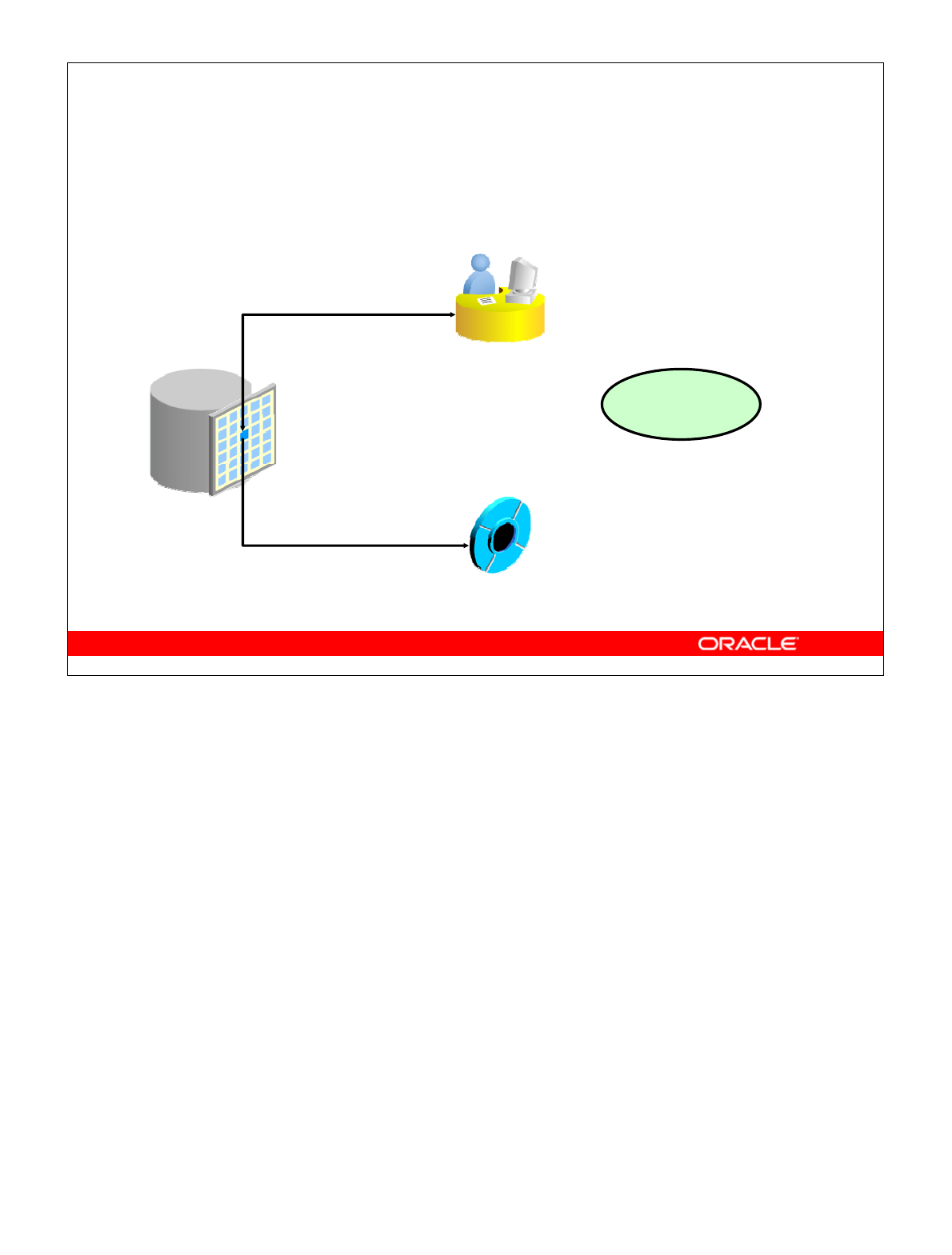
Oracle Database 10g: Develop PL/SQL Program Units 9-11
9-11 Copyright © 2004, Oracle. All rights reserved.
A New Database Object: DIRECTORY
DIRECTORY
LOB_PATH =
'/oracle/lob/'
User
Movie (BFILE)
A New Database Object: DIRECTORY
A DIRECTORY is a nonschema database object that enables administration of access and
usage of BFILEs in Oracle Database 10g.
A DIRECTORY specifies an alias for a directory on the file system of the server under which
a BFILE is located. By granting suitable privileges for these items to users, you can provide
secure access to files in the corresponding directories on a user-by-user basis (certain
directories can be made read-only, inaccessible, and so on).
Furthermore, these directory aliases can be used while referring to files (open, close, read,
and so on) in PL/SQL and OCI.This provides application abstraction from hard-coded path
names and gives flexibility in portably managing file locations.
The DIRECTORY object is owned by SYS and created by the DBA (or a user with the
CREATE ANY DIRECTORY privilege). The directory objects have object privileges, unlike
any other nonschema object. Privileges to the DIRECTORY object can be granted and
revoked. Logical path names are not supported.
The permissions for the actual directory depend on the operating system. They may differ
from those defined for the DIRECTORY object and could change after the creation of the
DIRECTORY object.

Oracle Database 10g: Develop PL/SQL Program Units 9-12
9-12 Copyright © 2004, Oracle. All rights reserved.
Guidelines for Creating
DIRECTORY Objects
•Do not create DIRECTORY objects on paths with
database files.
•Limit the number of people who are given the
following system privileges:
–CREATE ANY DIRECTORY
–DROP ANY DIRECTORY
•All DIRECTORY objects are owned by SYS.
•Create directory paths and properly set
permissions before using the DIRECTORY object
so that the Oracle server can read the file.
Guidelines for Creating DIRECTORY Objects
To associate an OS file with a BFILE, you should first create a DIRECTORY object that is
an alias for the full pathname to the OS file.
Create DIRECTORY objects by using the following guidelines:
• Directories should point to paths that do not contain database files, because tampering
with these files could corrupt the database. Currently, only the READ privilege can be
given for a DIRECTORY object.
• The CREATE ANY DIRECTORY and DROP ANY DIRECTORY system privileges
should be used carefully and not granted to users indiscriminately.
•DIRECTORY objects are not schema objects; all are owned by SYS.
• Create the directory paths with appropriate permissions on the OS before creating the
DIRECTORY object. Oracle does not create the OS path.
If you migrate the database to a different OS, then you may need to change the path value of
the DIRECTORY object.
The DIRECTORY object information that you create by using the CREATE DIRECTORY
command is stored in the DBA_DIRECTORIES and ALL_DIRECTORIES data dictionary
views.
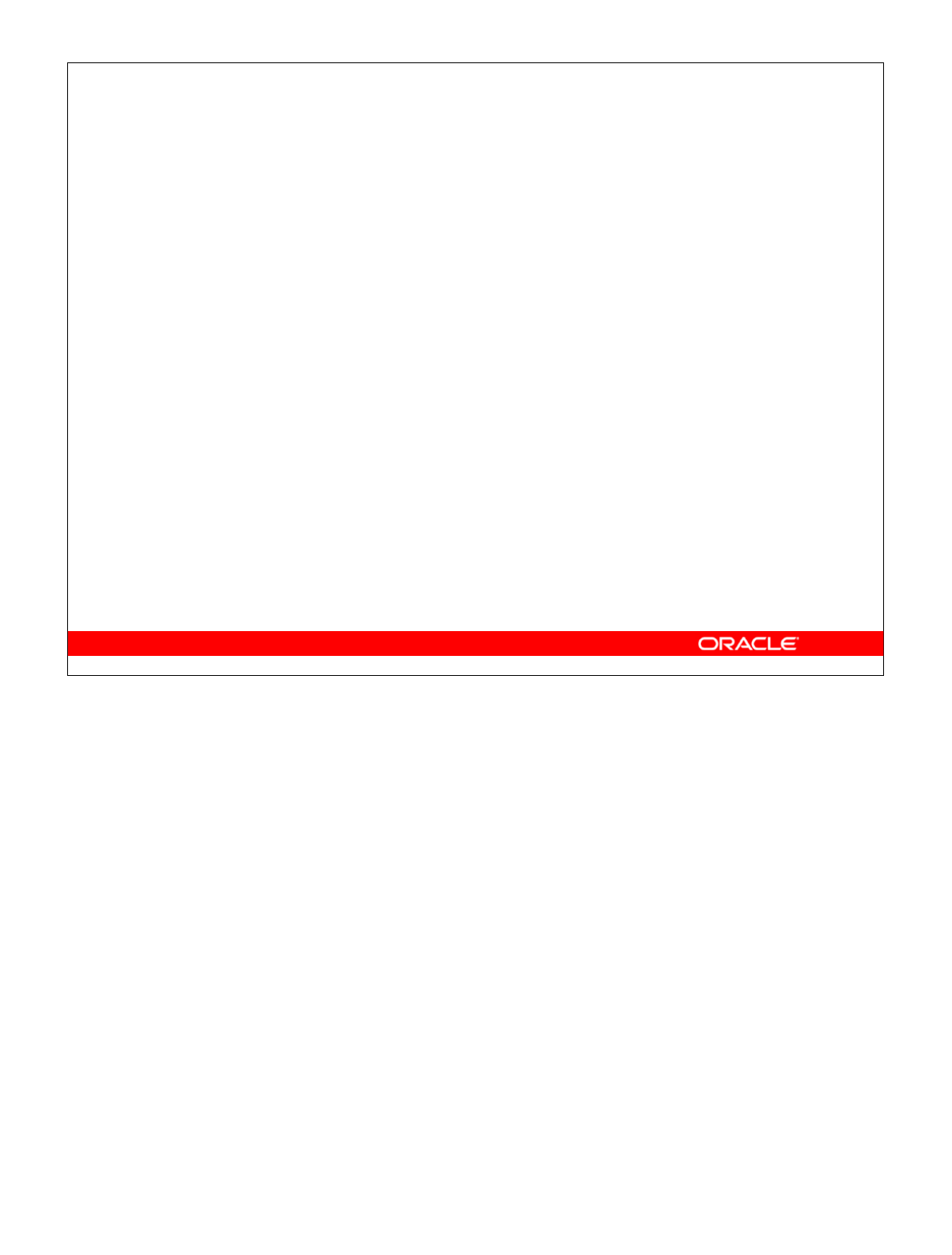
Oracle Database 10g: Develop PL/SQL Program Units 9-13
9-13 Copyright © 2004, Oracle. All rights reserved.
Managing BFILEs
The DBA or the system administrator:
1. Creates an OS directory and supplies files
2. Creates a DIRECTORY object in the database
3. Grants the READ privilege on the DIRECTORY
object to appropriate database users
The developer or the user:
4. Creates an Oracle table with a column defined as a
BFILE data type
5. Inserts rows into the table using the BFILENAME
function to populate the BFILE column
6. Writes a PL/SQL subprogram that declares and
initializes a LOB locator, and reads BFILE
How to Manage BFILEs
Managing BFILEs requires cooperation between the database and system administrator and
the between the developer and user of the files.
The database or system administrator should perform the following privileged tasks:
1. Create the operating system (OS) directory (as an Oracle user), and set permissions so
that the Oracle server can read the contents of the OS directory. Load files into the OS
directory.
2. Create a database DIRECTORY object that references the OS directory.
3. Grant the READ privilege on the database DIRECTORY object to database users
requiring access to it.
The designer, application developer, or user should perform the following tasks:
4. Create a database table containing a column defined as the BFILE data type.
5. Insert rows into the table using the BFILENAME function to populate the BFILE
column associating the field to an OS file in the named DIRECTORY.
6. Write PL/SQL subprograms that:
a. Declare and initialize the BFILE LOB locator
b. Select the row and column containing the BFILE into the LOB locator
c. Read the BFILE with a DBMS_LOB function, using the locator file reference

Oracle Database 10g: Develop PL/SQL Program Units 9-14
9-14 Copyright © 2004, Oracle. All rights reserved.
Preparing to Use BFILEs
1. Create an OS directory to store the physical data
files.
2. Create a DIRECTORY object by using the CREATE
DIRECTORY command.
3. Grant the READ privilege on the DIRECTORY object
to appropriate users.
mkdir /temp/data_files
CREATE DIRECTORY data_files
AS '/temp/data_files';
GRANT READ ON DIRECTORY data_files
TO SCOTT, MANAGER_ROLE, PUBLIC;
Preparing to Use BFILEs
To use a BFILE within an Oracle table, you must have a table with a column of BFILE
type. For the Oracle server to access an external file, the server needs to know the physical
location of the file in the OS directory structure.
The database DIRECTORY object provides the means to specify the location of the BFILEs.
Use the CREATE DIRECTORY command to specify the pointer to the location where your
BFILEs are stored. You need the CREATE ANY DIRECTORY privilege.
Syntax definition: CREATE DIRECTORY dir_name AS os_path;
In this syntax, dir_name is the name of the directory database object, and os_path is the
location of the BFILEs.
The slide examples show the commands to set up:
• The physical directory, for example /temp/data_files, in the OS
• A named DIRECTORY object, called data_files, that points to the physical
directory in the OS
• The READ access right on the directory to be granted to users in the database,
providing the privilege to read the BFILEs from the directory
Note: The value of the SESSION_MAX_OPEN_FILES database initialization parameter,
which is set to 10 by default, limits the number of BFILEs that can be opened in a session.
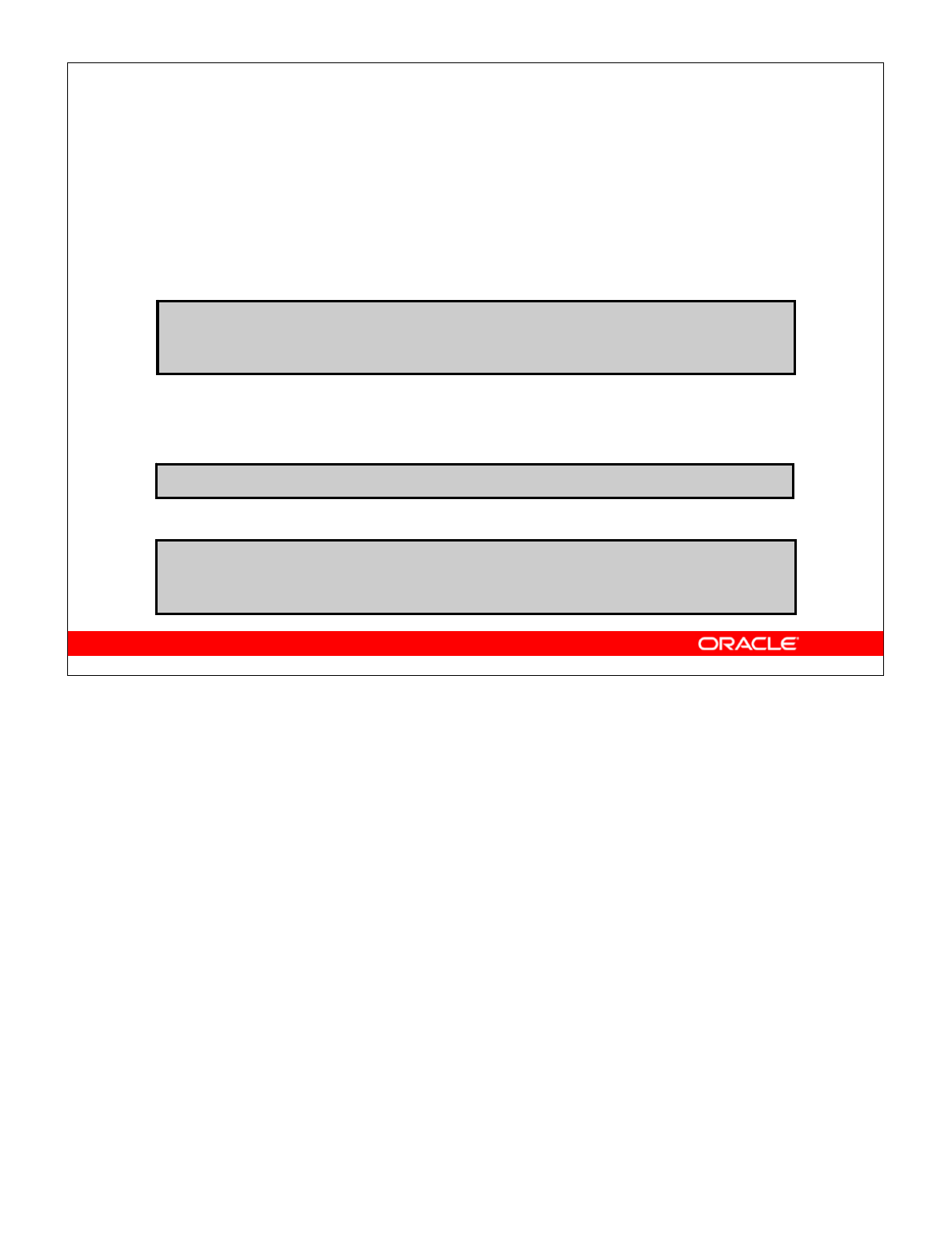
Oracle Database 10g: Develop PL/SQL Program Units 9-15
9-15 Copyright © 2004, Oracle. All rights reserved.
Populating BFILE Columns with SQL
•Use the BFILENAME function to initialize a BFILE
column. The function syntax is:
•Example:
–Add a BFILE column to a table.
–Update the column using the BFILENAME function.
FUNCTION BFILENAME(directory_alias IN VARCHAR2,
filename IN VARCHAR2)
RETURN BFILE;
UPDATE employees
SET video = BFILENAME('DATA_FILES', 'King.avi')
WHERE employee_id = 100;
ALTER TABLE employees ADD video BFILE;
Populating BFILE Columns with SQL
The BFILENAME function is a built-in function that you use to initialize a BFILE column,
using the following two parameters:
•directory_alias for the name of the DIRECTORY database object that
references the OS directory containing the files
•filename for the name of the BFILE to be read
The BFILENAME function creates a pointer (or LOB locator) to the external file stored in a
physical directory, which is assigned a directory alias name that is used in the first parameter
of the function. Populate the BFILE column using the BFILENAME function in either of the
following:
• The VALUES clause of an INSERT statement
• The SET clause of an UPDATE statement
An UPDATE operation can be used to change the pointer reference target of the BFILE. A
BFILE column can also be initialized to a NULL value and updated later with the
BFILENAME function, as shown in the slide.
After the BFILE columns have been associated with a file, subsequent read operations on
the BFILE can be performed by using the PL/SQL DBMS_LOB package and OCI. However,
these files are read-only when accessed through BFILEs. Therefore, they cannot be updated
or deleted through BFILEs.

Oracle Database 10g: Develop PL/SQL Program Units 9-16
9-16 Copyright © 2004, Oracle. All rights reserved.
CREATE PROCEDURE set_video(
dir_alias VARCHAR2, dept_id NUMBER) IS
filename VARCHAR2(40);
file_ptr BFILE;
CURSOR emp_csr IS
SELECT first_name FROM employees
WHERE department_id = dept_id FOR UPDATE;
BEGIN
FOR rec IN emp_csr LOOP
filename := rec.first_name || '.gif';
file_ptr := BFILENAME(dir_alias, filename);
DBMS_LOB.FILEOPEN(file_ptr);
UPDATE employees SET video = file_ptr
WHERE CURRENT OF emp_csr;
DBMS_OUTPUT.PUT_LINE('FILE: ' || filename ||
' SIZE: ' || DBMS_LOB.GETLENGTH(file_ptr));
DBMS_LOB.FILECLOSE(file_ptr);
END LOOP;
END set_video;
Populating a BFILE Column with PL/SQL
Populating a BFILE Column with PL/SQL
The example shows a PL/SQL procedure called set_video, which accepts the name of
the directory alias referencing the OS file system as a parameter, and a department ID. The
procedure performs the following tasks:
• Uses a cursor FOR loop to obtain each employee record
• Sets the filename by appending .gif to the employee’s last_name
• Creates an in-memory LOB locator for the BFILE in the file_ptr variable
• Calls the DBMS_LOB.FILEOPEN procedure to verify whether the file exists, and to
determine the size of the file using the DBMS_LOB.GETLENGTH function
• Executes an UPDATE statement to write the BFILE locator value to the video
BFILE column
• Displays the file size returned from the DBMS_LOB.GETLENGTH function
• Closes the file using the DBMS_LOB.FILECLOSE procedure
Executing with the following call:
EXECUTE set_video('DATA_FILE', 60)
Sample results are:
FILE: Alexander.gif SIZE: 5213
FILE: Bruce.gif SIZE: 26059
:
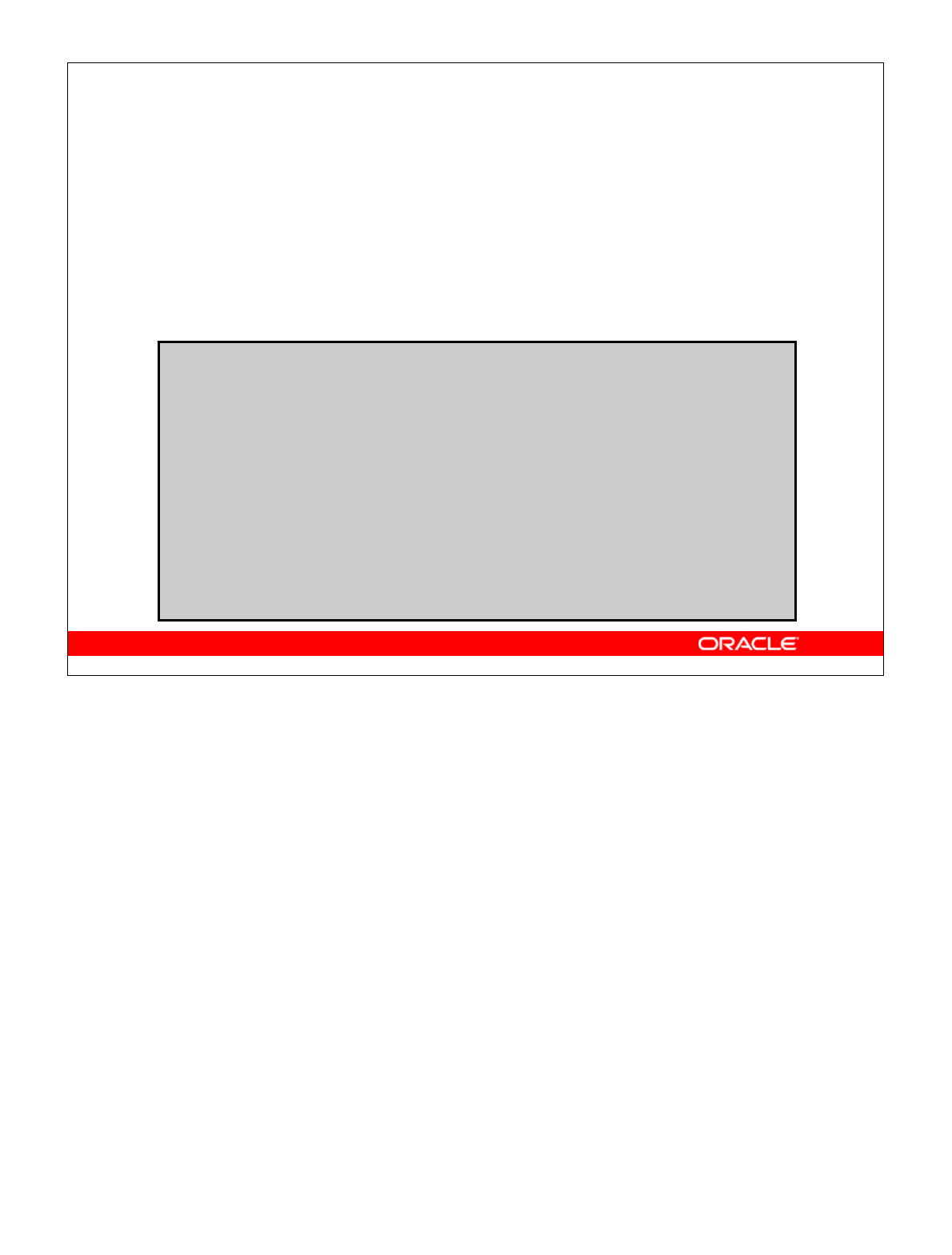
Oracle Database 10g: Develop PL/SQL Program Units 9-17
9-17 Copyright © 2004, Oracle. All rights reserved.
CREATE FUNCTION get_filesize(file_ptr BFILE)
RETURN NUMBER IS
file_exists BOOLEAN;
length NUMBER:= -1;
BEGIN
file_exists := DBMS_LOB.FILEEXISTS(file_ptr)=1;
IF file_exists THEN
DBMS_LOB.FILEOPEN(file_ptr);
length := DBMS_LOB.GETLENGTH(file_ptr);
DBMS_LOB.FILECLOSE(file_ptr);
END IF;
RETURN length;
END;
/
Using DBMS_LOB Routines with BFILEs
The DBMS_LOB.FILEEXISTS function can verify if the
file exists in the OS. The function:
•Returns 0 if the file does not exist
•Returns 1 if the file does exist
Using DBMS_LOB Routines with BFILEs
The set_video procedure in the previous page will terminate with an exception if a file
does not exist. To prevent the loop from prematurely terminating, you could create a
function, such as get_filesize, to determine whether a given BFILE locator references
a file that actually exists on the server’s file system. The DBMS_LOB.FILEEXISTS
function expects the BFILE locator as a parameter and returns an INTEGER with:
• A value 0 if the physical file does not exist
• A value 1 if the physical file exists
If the BFILE parameter is invalid, one of the three exceptions may be raised:
•NOEXIST_DIRECTORY if the directory does not exist
•NOPRIV_DIRECTORY if database processes do not have privileges for the directory
•INVALID_DIRECTORY if the directory was invalidated after the file was opened
In the get_filesize function, the output of the DBMS_LOB.FILEEXISTS function is
compared with value 1 and the result of the condition sets the BOOLEAN variable
file_exists. The DBMS_LOB.FILEOPEN call is performed only if the file does exist,
preventing unwanted exceptions from occurring. The get_filesize function returns a
value of –1 if a file does not exist; otherwise it returns the size of the file in bytes. The caller
can take appropriate action with this information.
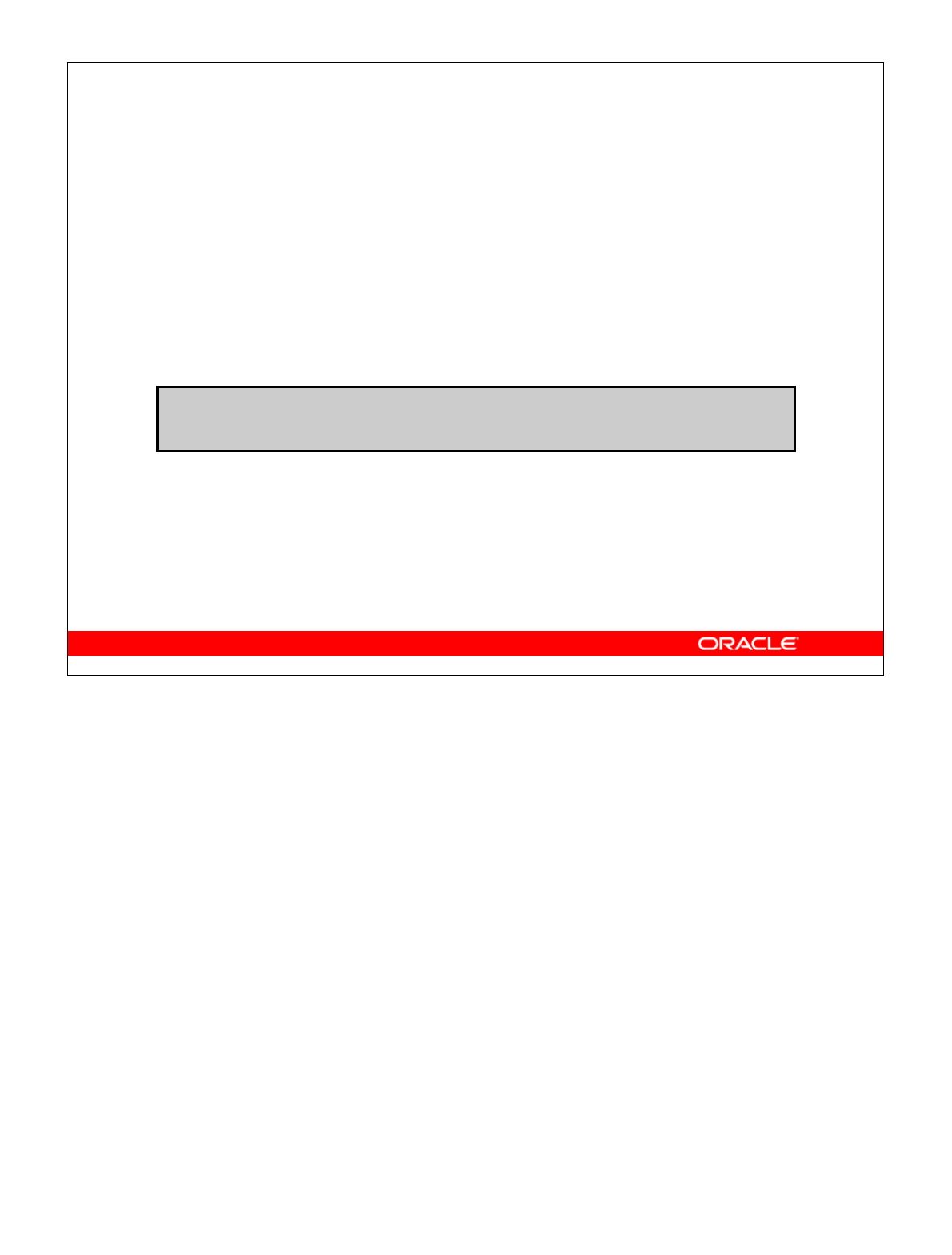
Oracle Database 10g: Develop PL/SQL Program Units 9-18
9-18 Copyright © 2004, Oracle. All rights reserved.
Migrating from LONG to LOB
Oracle Database 10genables migration of LONG
columns to LOB columns.
•Data migration consists of the procedure to move
existing tables containing LONG columns to use
LOBs:
•Application migration consists of changing
existing LONG applications for using LOBs.
ALTER TABLE [<schema>.] <table_name>
MODIFY (<long_col_name> {CLOB | BLOB | NCLOB}
Migrating from LONG to LOB
Oracle Database 10gsupports LONG-to-LOB migration using an API. In data migration,
existing tables that contain LONG columns need to be moved to use LOB columns. This can
be done by using the ALTER TABLE command. In Oracle8i, an operator named TO_LOB
had to be used to copy a LONG to a LOB. In Oracle Database 10g, this operation can be
performed using the syntax shown in the slide. You can use the syntax shown to:
•Modify a LONG column to a CLOB or an NCLOB column
•Modify a LONG RAW column to a BLOB column
The constraints of the LONG column (NULL and NOT NULL are the only allowed constraints)
are maintained for the new LOB columns. The default value specified for the LONG column
is also copied to the new LOB column. For example, suppose you have the following table:
CREATE TABLE long_tab (id NUMBER, long_col LONG);
To change the long_col column in table long_tab to the CLOB data type, use:
ALTER TABLE long_tab MODIFY ( long_col CLOB );
For information about the limitations on LONG-to-LOB migration, refer to Oracle Database
Application Developer’s Guide - Large Objects. In application migration, the existing LONG
applications change for using LOBs. You can use SQL and PL/SQL to access LONGs and
LOBs. The LONG-to-LOB migration API is provided for both OCI and PL/SQL.
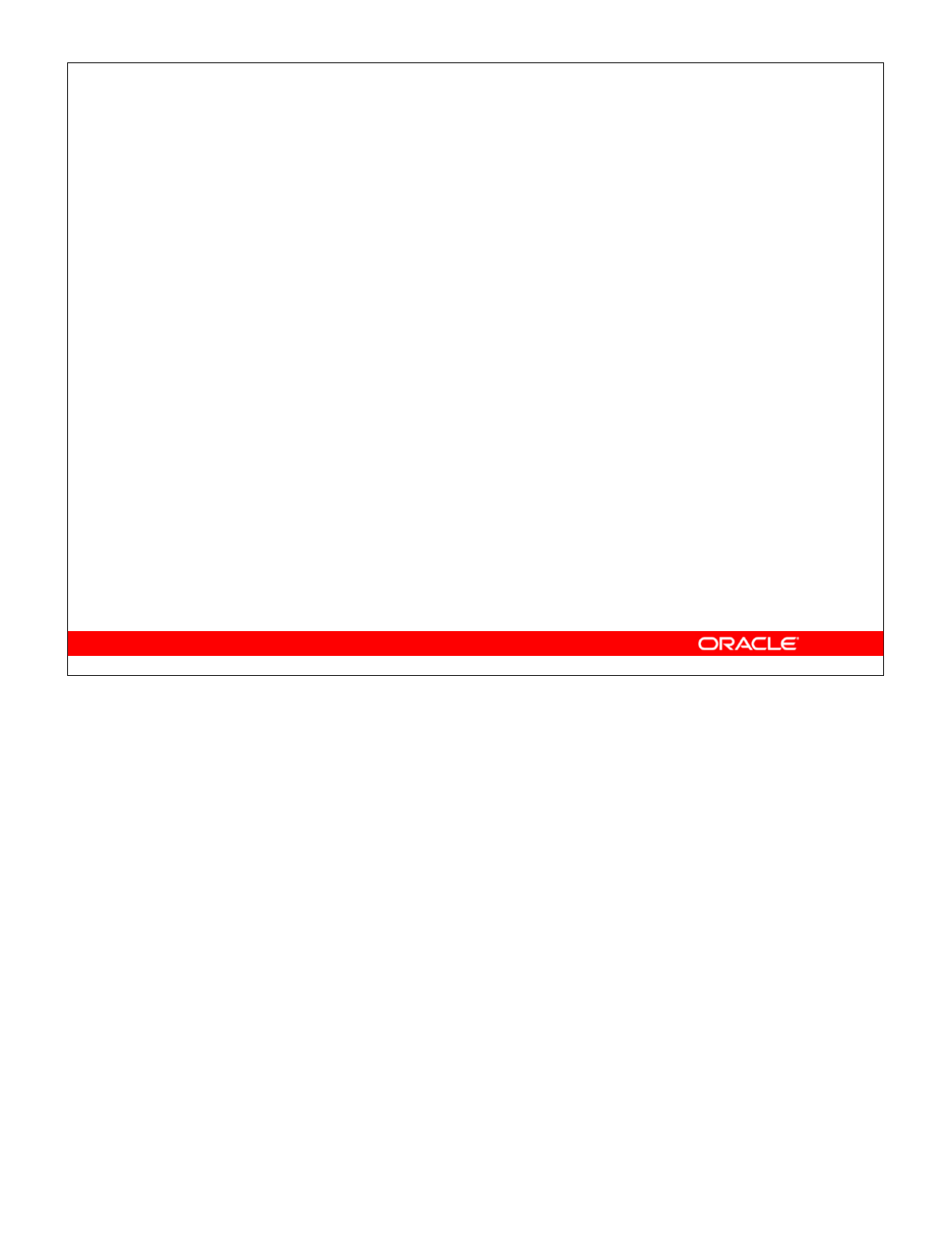
Oracle Database 10g: Develop PL/SQL Program Units 9-19
9-19 Copyright © 2004, Oracle. All rights reserved.
Migrating from LONG to LOB
•Implicit conversion: From LONG (LONG RAW) or a
VARCHAR2(RAW) variable to a CLOB (BLOB)
variable, and vice versa
•Explicit conversion:
–TO_CLOB() converts LONG, VARCHAR2, and CHAR to
CLOB.
–TO_BLOB() converts LONG RAW and RAW to BLOB.
•Function and procedure parameter passing:
–CLOBs and BLOBs as actual parameters
–VARCHAR2, LONG, RAW, and LONG RAW are formal
parameters, and vice versa.
•LOB data is acceptable in most of the SQL and
PL/SQL operators and built-in functions.
Migrating from LONG to LOB (continued)
With the new LONG-to-LOB API introduced in Oracle Database 10g, data from CLOB and
BLOB columns can be referenced by regular SQL and PL/SQL statements.
Implicit assignment and parameter passing: The LONG-to-LOB migration API supports
assigning a CLOB (BLOB) variable to a LONG (LONG RAW) or a VARCHAR2(RAW) variable,
and vice versa.
Explicit conversion functions: In PL/SQL, the following two new explicit conversion
functions have been added in Oracle Database 10gto convert other data types to CLOB and
BLOB as part of LONG-to-LOB migration:
•TO_CLOB() converts LONG, VARCHAR2, and CHAR to CLOB
•TO_BLOB() converts LONG RAW and RAW to BLOB
Note: TO_CHAR() is enabled to convert a CLOB to a CHAR type.
Function and procedure parameter passing: This enables the use of CLOBs and BLOBs
as actual parameters where VARCHAR2, LONG, RAW, and LONG RAW are formal parameters,
and vice versa. In SQL and PL/SQL built-in functions and operators, a CLOB can be passed
to SQL and PL/SQL VARCHAR2 built-in functions, behaving exactly like a VARCHAR2. Or
the VARCHAR2 variable can be passed into DBMS_LOB APIs acting like a LOB locator. For
more information, see “Migrating from LONGs to LOBs”in Application Developer’s Guide
- Large Objects.
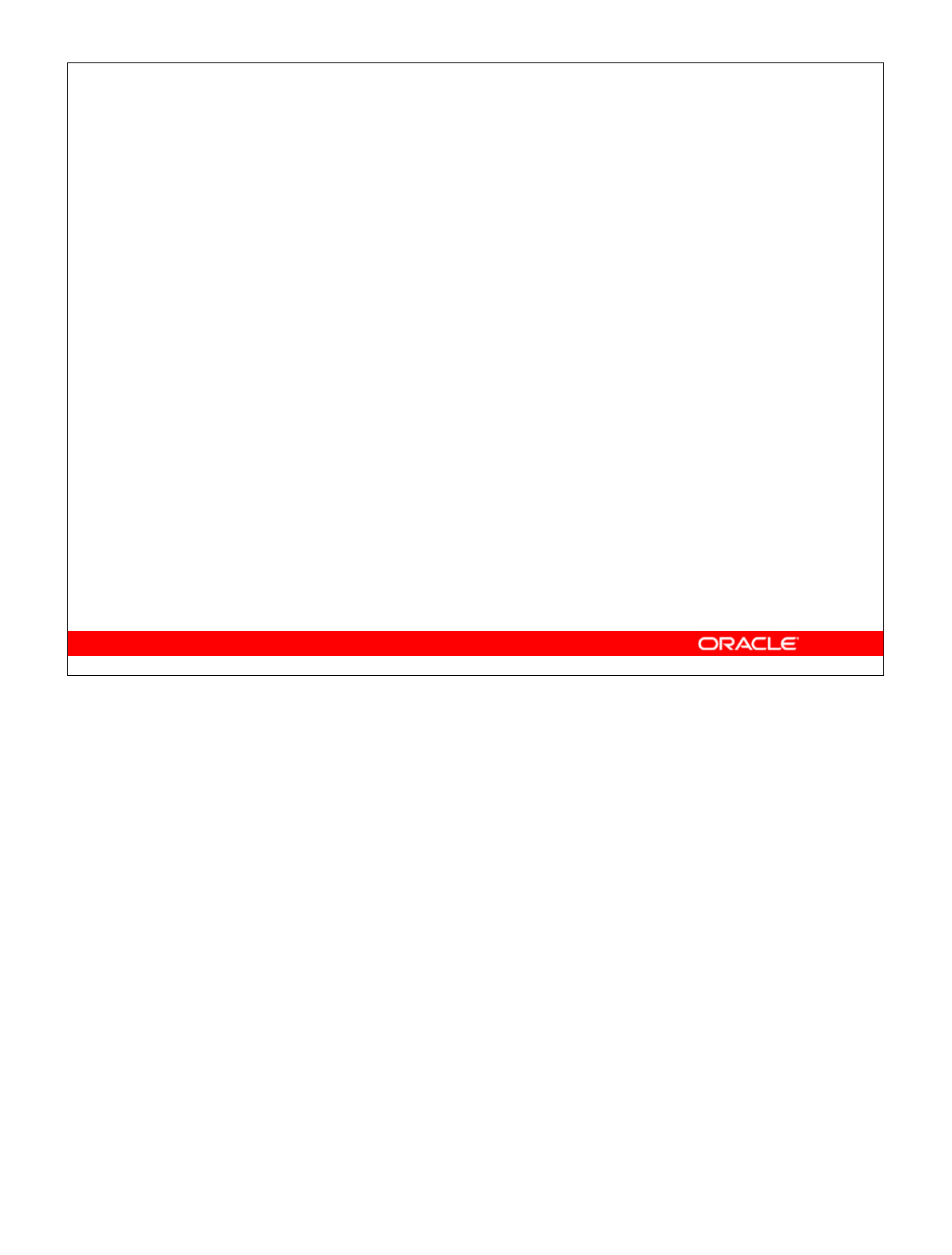
Oracle Database 10g: Develop PL/SQL Program Units 9-20
9-20 Copyright © 2004, Oracle. All rights reserved.
DBMS_LOB Package
•Working with LOBs often requires the use of the
Oracle-supplied DBMS_LOB package.
•DBMS_LOB provides routines to access and
manipulate internal and external LOBs.
•Oracle Database 10genables retrieving LOB data
directly using SQL without a special LOB API.
•In PL/SQL, you can define a VARCHAR2 for a CLOB
and a RAW for a BLOB.
DBMS_LOB Package
In releases prior to Oracle9i, you must use the DBMS_LOB package for retrieving data from
LOBs. To create the DBMS_LOB package, the dbmslob.sql and prvtlob.plb scripts
must be executed as SYS. The catproc.sql script executes the scripts. Then users can be
granted appropriate privileges to use the package.
The package does not support any concurrency control mechanism for BFILE operations.
The user is responsible for locking the row containing the destination internal LOB before
calling any subprograms that involve writing to the LOB value. These DBMS_LOB routines
do not implicitly lock the row containing the LOB.
The two constants, LOBMAXSIZE and FILE_READONLY, defined in the package
specification are also used in the procedures and functions of DBMS_LOB; for example, use
them to achieve the maximum level of purity to be used in SQL expressions.
The DBMS_LOB functions and procedures can be broadly classified into two types: mutators
and observers.
• The mutators can modify LOB values: APPEND, COPY, ERASE, TRIM, WRITE,
FILECLOSE, FILECLOSEALL, and FILEOPEN.
• The observers can read LOB values: COMPARE, FILEGETNAME, INSTR,
GETLENGTH, READ, SUBSTR, FILEEXISTS, and FILEISOPEN.
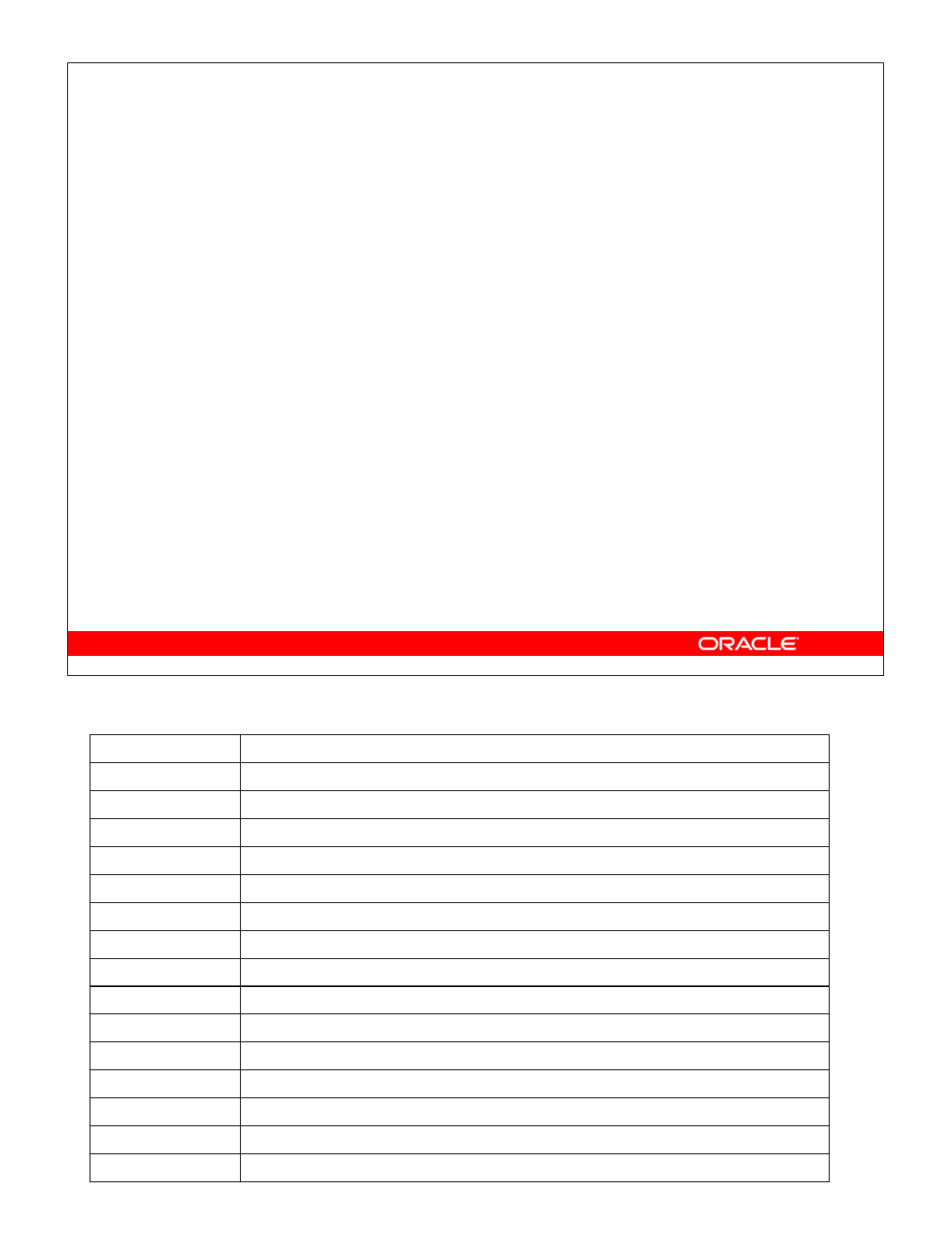
Oracle Database 10g: Develop PL/SQL Program Units 9-21
9-21 Copyright © 2004, Oracle. All rights reserved.
DBMS_LOB Package
•Modify LOB values:
APPEND, COPY, ERASE, TRIM, WRITE,
LOADFROMFILE
•Read or examine LOB values:
GETLENGTH, INSTR, READ, SUBSTR
•Specific to BFILEs:
FILECLOSE, FILECLOSEALL, FILEEXISTS,
FILEGETNAME, FILEISOPEN, FILEOPEN
DBMS_LOB Package (continued)
APPEND Appends the contents of the source LOB to the destination LOB
COPY Copies all or part of the source LOB to the destination LOB
ERASE Erases all or part of a LOB
LOADFROMFILE Loads BFILE data into an internal LOB
TRIM Trims the LOB value to a specified shorter length
WRITE Writes data to the LOB from a specified offset
GETLENGTH Gets the length of the LOB value
INSTR Returns the matching position of the nth occurrence of the pattern in the LOB
READ Reads data from the LOB starting at the specified offset
SUBSTR Returns part of the LOB value starting at the specified offset
FILECLOSE Closes the file
FILECLOSEALL Closes all previously opened files
FILEEXISTS Checks whether the file exists on the server
FILEGETNAME Gets the directory alias and file name
FILEISOPEN Checks if the file was opened using the input BFILE locators
FILEOPEN Opens a file
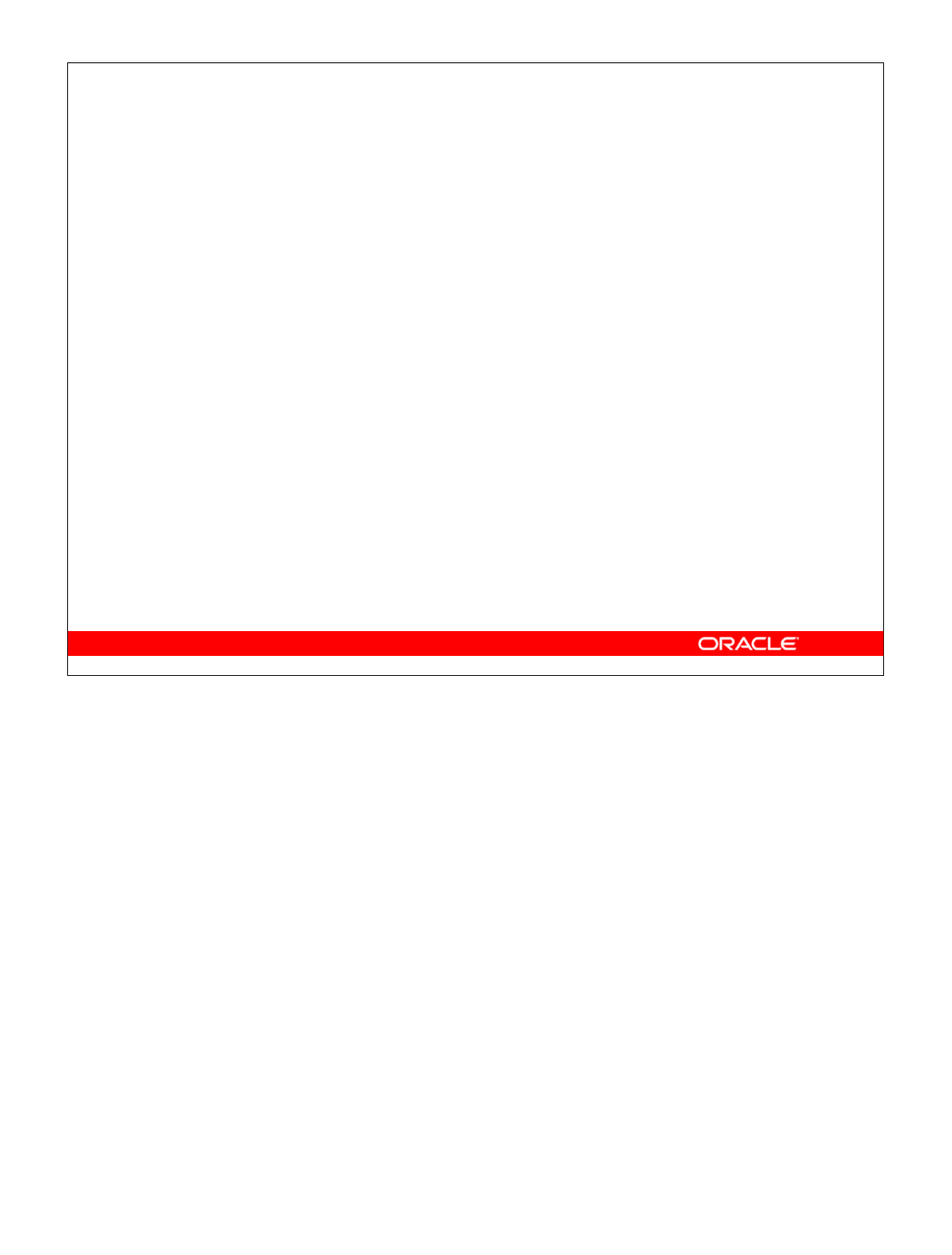
Oracle Database 10g: Develop PL/SQL Program Units 9-22
9-22 Copyright © 2004, Oracle. All rights reserved.
DBMS_LOB Package
•NULL parameters get NULL returns.
•Offsets:
–BLOB, BFILE: Measured in bytes
–CLOB, NCLOB: Measured in characters
•There are no negative values for parameters.
Using the DBMS_LOB Routines
All functions in the DBMS_LOB package return NULL if any input parameters are NULL. All
mutator procedures in the DBMS_LOB package raise an exception if the destination
LOB/BFILE is input as NULL.
Only positive, absolute offsets are allowed. They represent the number of bytes or characters
from the beginning of LOB data from which to start the operation. Negative offsets and
ranges observed in SQL string functions and operators are not allowed. Corresponding
exceptions are raised upon violation. The default value for an offset is 1, which indicates the
first byte or character in the LOB value.
Similarly, only natural number values are allowed for the amount (BUFSIZ) parameter.
Negative values are not allowed.
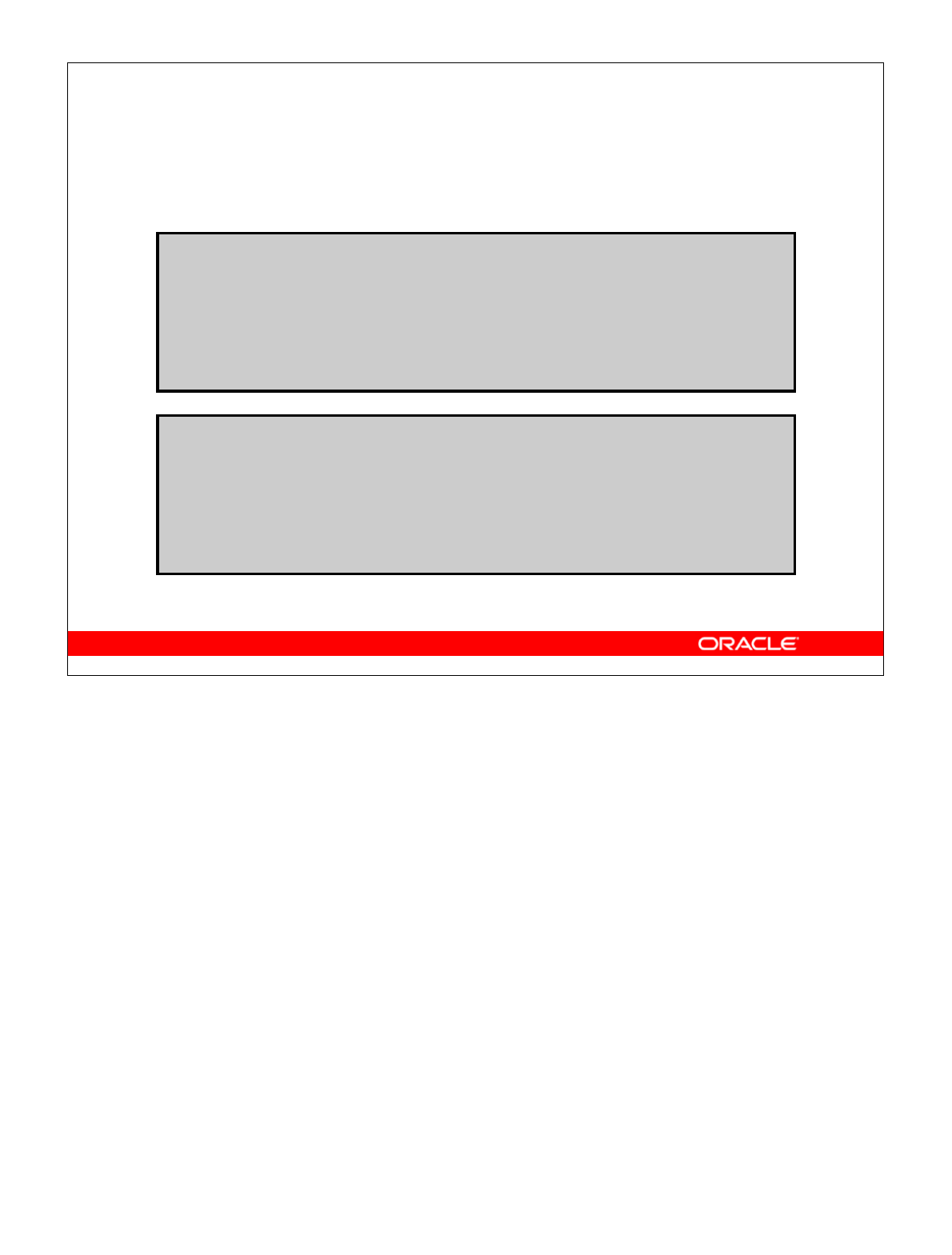
Oracle Database 10g: Develop PL/SQL Program Units 9-23
9-23 Copyright © 2004, Oracle. All rights reserved.
DBMS_LOB.READ and DBMS_LOB.WRITE
PROCEDURE READ (
lobsrc IN BFILE|BLOB|CLOB ,
amount IN OUT BINARY_INTEGER,
offset IN INTEGER,
buffer OUT RAW|VARCHAR2 )
PROCEDURE WRITE (
lobdst IN OUT BLOB|CLOB,
amount IN OUT BINARY_INTEGER,
offset IN INTEGER := 1,
buffer IN RAW|VARCHAR2 ) -- RAW for BLOB
DBMS_LOB.READ
Call the READ procedure to read and return piecewise a specified AMOUNT of data from a
given LOB, starting from OFFSET. An exception is raised when no more data remains to be
read from the source LOB. The value returned in AMOUNT is less than the one specified if the
end of the LOB is reached before the specified number of bytes or characters can be read. In
the case of CLOBs, the character set of data in BUFFER is the same as that in the LOB.
PL/SQL allows a maximum length of 32,767 for RAW and VARCHAR2 parameters. Ensure
that the allocated system resources are adequate to support buffer sizes for the given number
of user sessions. Otherwise, the Oracle server raises the appropriate memory exceptions.
Note: BLOB and BFILE return RAW; the others return VARCHAR2.
DBMS_LOB.WRITE
Call the WRITE procedure to write piecewise a specified AMOUNT of data into a given LOB,
from the user-specified BUFFER, starting from an absolute OFFSET from the beginning of
the LOB value.
Make sure (especially with multibyte characters) that the amount in bytes corresponds to the
amount of buffer data. WRITE has no means of checking whether they match, and it will
write AMOUNT bytes of the buffer contents into the LOB.
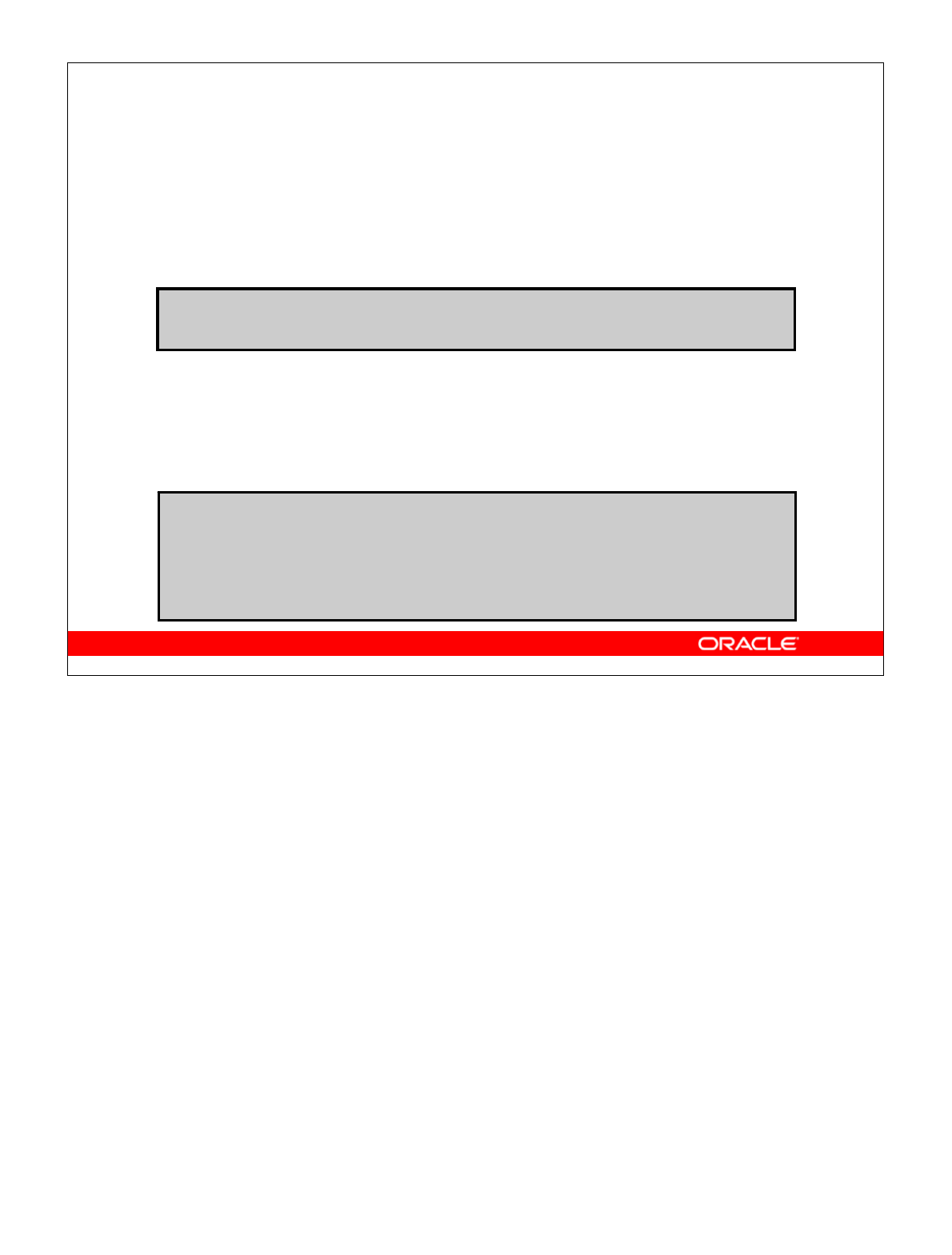
Oracle Database 10g: Develop PL/SQL Program Units 9-24
9-24 Copyright © 2004, Oracle. All rights reserved.
Initializing LOB Columns Added to a Table
•Create the table with columns using the LOB type,
or add the LOB columns using ALTER TABLE.
•Initialize the column LOB locator value with the
DEFAULT option or DML statements using:
–EMPTY_CLOB() function for a CLOB column
–EMPTY_BLOB() function for a BLOB column
ALTER TABLE employees
ADD (resume CLOB, picture BLOB);
CREATE TABLE emp_hiredata (
employee_id NUMBER(6),
full_name VARCHAR2(45),
resume CLOB DEFAULT EMPTY_CLOB(),
picture BLOB DEFAULT EMPTY_BLOB());
Initializing LOB Columns Added to a Table
LOB columns are defined by using SQL data definition language (DDL), as in the ALTER
TABLE statement in the slide. The contents of a LOB column are stored in the LOB segment,
whereas the column in the table contains only a reference to that specific storage area, called
the LOB locator. In PL/SQL, you can define a variable of type LOB, which contains only the
value of the LOB locator. You can initialize the LOB locators using:
•EMPTY_CLOB() function to a LOB locator for a CLOB column
•EMPTY_BLOB() function to a LOB locator for a BLOB column
Note: These functions create the LOB locator value and not the LOB content. In general, you
use the DBMS_LOB package subroutines to populate the content. The functions are available
in Oracle SQL DML, and are not part of the DBMS_LOB package.
The last example in the slide shows how you can use the EMPTY_CLOB() and
EMPTY_BLOB() functions in the DEFAULT option in a CREATE TABLE statement. In this
way, the LOB locator values are populated in their respective columns when a row is inserted
into the table and the LOB columns have not been specified in the INSERT statement.
The next page shows how to use the functions in INSERT and UPDATE statements to
initialize the LOB locator values.
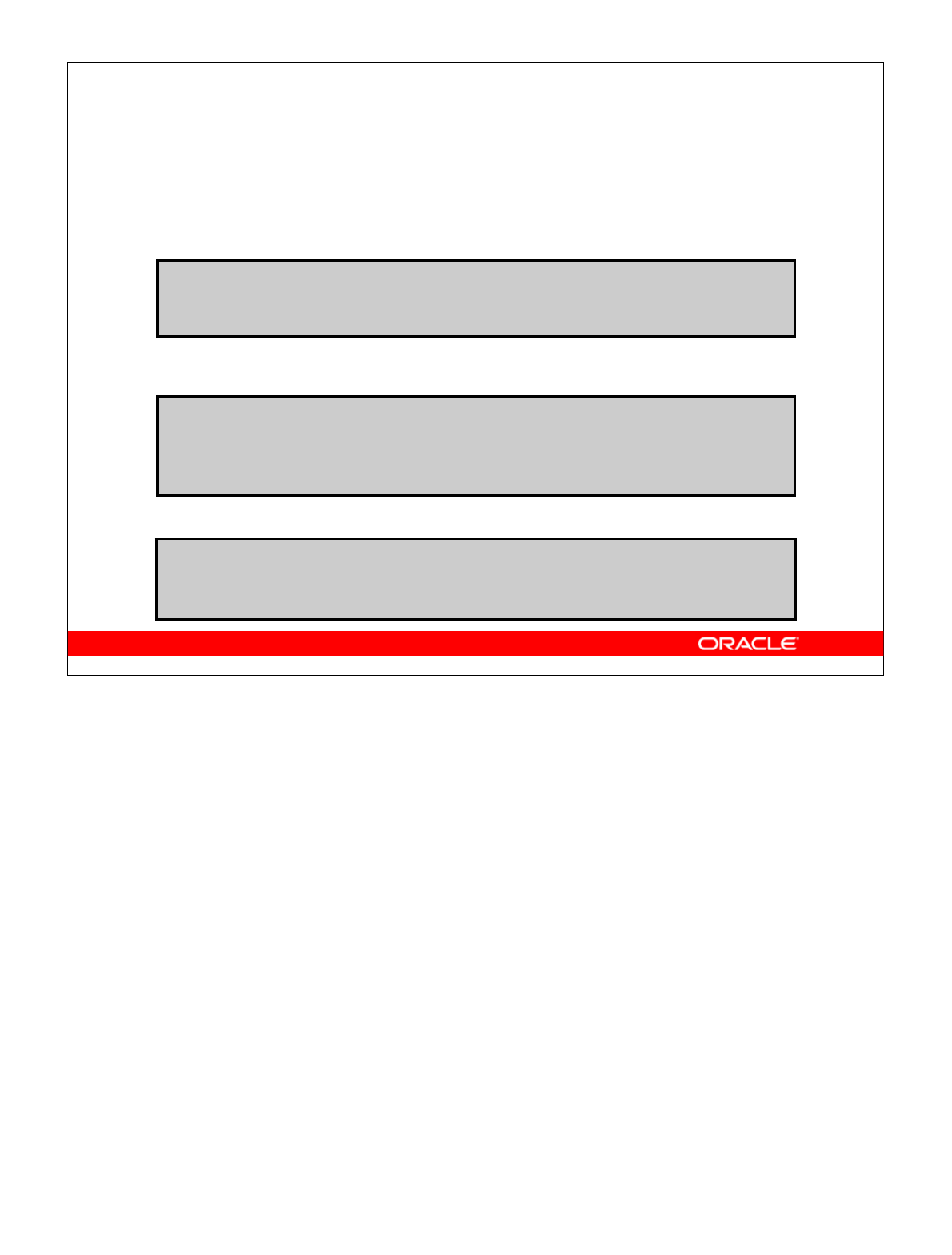
Oracle Database 10g: Develop PL/SQL Program Units 9-25
9-25 Copyright © 2004, Oracle. All rights reserved.
Populating LOB Columns
•Insert a row into a table with LOB columns:
•Initialize a LOB using the EMPTY_BLOB() function:
•Update a CLOB column:
INSERT INTO emp_hiredata
(employee_id, full_name, resume, picture)
VALUES (405, 'Marvin Ellis', EMPTY_CLOB(), NULL);
UPDATE emp_hiredata
SET resume = 'Date of Birth: 8 February 1951',
picture = EMPTY_BLOB()
WHERE employee_id = 405;
UPDATE emp_hiredata
SET resume = 'Date of Birth: 1 June 1956'
WHERE employee_id = 170;
Populating LOB Columns
You can insert a value directly into a LOB column by using host variables in SQL or in
PL/SQL, 3GL-embedded SQL, or OCI. You can use the special EMPTY_BLOB()and
EMPTY_CLOB() functions in INSERT or UPDATE statements of SQL DML to initialize a
NULL or non-NULL internal LOB to empty. To populate a LOB column, perform the
following steps:
1. Initialize the LOB column to a non-NULL value, that is, set a LOB locator pointing to
an empty or populated LOB value. This is done by using EMPTY_BLOB()and
EMPTY_BLOB() functions.
2. Populate the LOB contents by using the DBMS_LOB package routines.
However, as shown in the slide examples, the two UPDATE statements initialize the
resume LOB locator value and populate its contents by supplying a literal value. This can
also be done in an INSERT statement. A LOB column can be updated to:
•Another LOB value
•A NULL value
•A LOB locator with empty contents by using the EMPTY_*LOB() built-in function
You can update the LOB by using a bind variable in embedded SQL. When assigning one
LOB to another, a new copy of the LOB value is created. Use a SELECT FOR UPDATE
statement to lock the row containing the LOB column before updating a piece of the LOB
contents.
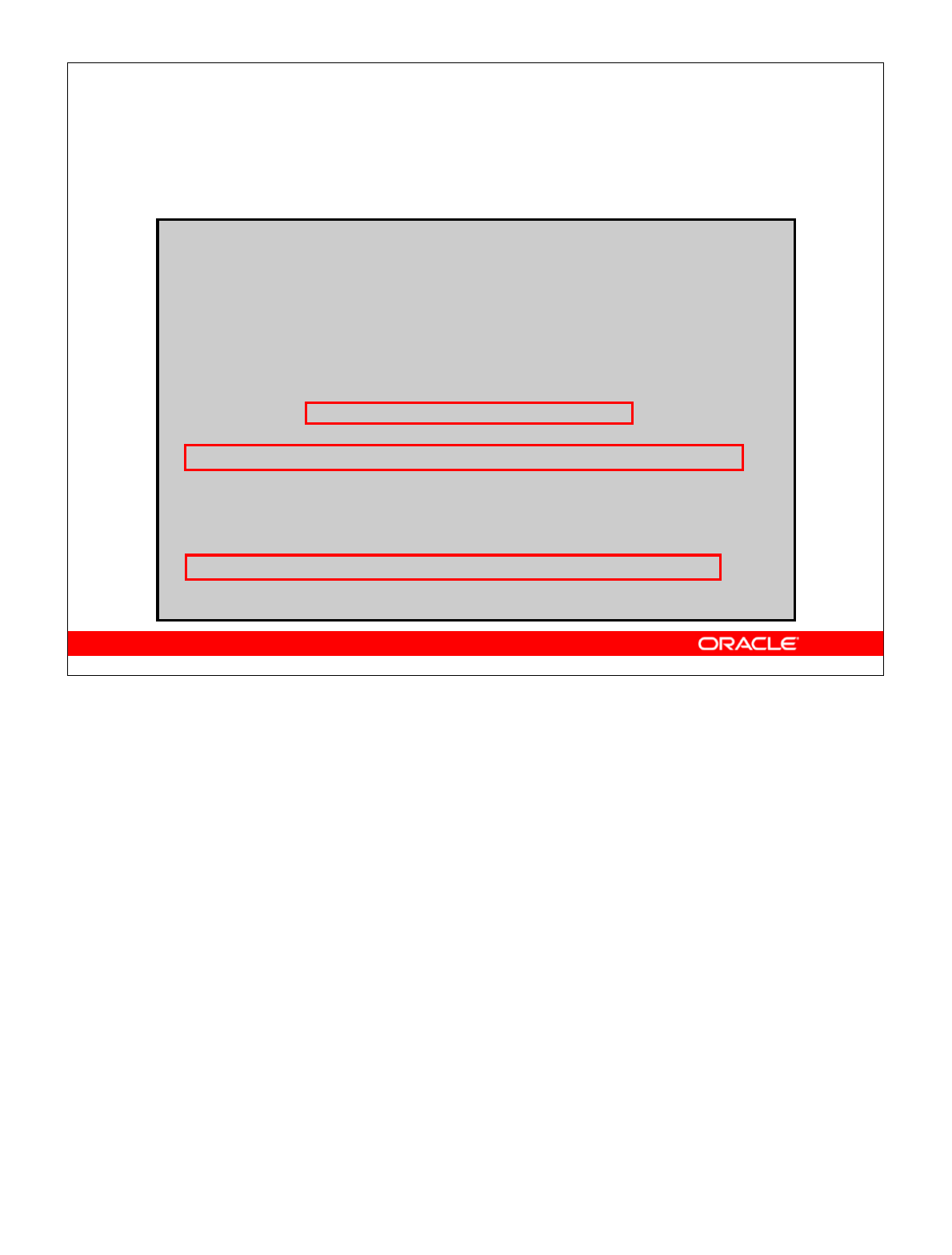
Oracle Database 10g: Develop PL/SQL Program Units 9-26
9-26 Copyright © 2004, Oracle. All rights reserved.
DECLARE
lobloc CLOB; -- serves as the LOB locator
text VARCHAR2(50) := 'Resigned = 5 June 2000';
amount NUMBER ; -- amount to be written
offset INTEGER; -- where to start writing
BEGIN
SELECT resume INTO lobloc FROM emp_hiredata
WHERE employee_id = 405 FOR UPDATE;
offset := DBMS_LOB.GETLENGTH(lobloc) + 2;
amount := length(text);
DBMS_LOB.WRITE (lobloc, amount, offset, text);
text := ' Resigned = 30 September 2000';
SELECT resume INTO lobloc FROM emp_hiredata
WHERE employee_id = 170 FOR UPDATE;
amount := length(text);
DBMS_LOB.WRITEAPPEND(lobloc, amount, text);
COMMIT;
END;
Updating LOB by Using DBMS_LOB in
PL/SQL
Updating LOB by Using DBMS_LOB in PL/SQL
In the example in the slide, the LOBLOC variable serves as the LOB locator, and the
AMOUNT variable is set to the length of the text you want to add. The SELECT FOR
UPDATE statement locks the row and returns the LOB locator for the RESUME LOB column.
Finally, the PL/SQL WRITE package procedure is called to write the text into the LOB value
at the specified offset. WRITEAPPEND appends to the existing LOB value.
The example shows how to fetch a CLOB column in releases before Oracle9i. In those
releases, it was not possible to fetch a CLOB column directly into a character column. The
column value needed to be bound to a LOB locator, which is accessed by the DBMS_LOB
package. An example later in this lesson shows that you can directly fetch a CLOB column
by binding it to a character variable.
Note: Versions prior to Oracle9idid not allow LOBs in the WHERE clause of UPDATE and
SELECT statements. Now SQL functions of LOBs are allowed in predicates of WHERE. An
example is shown later in this lesson.

Oracle Database 10g: Develop PL/SQL Program Units 9-27
9-27 Copyright © 2004, Oracle. All rights reserved.
Selecting CLOB Values by Using SQL
SELECT employee_id, full_name , resume -- CLOB
FROM emp_hiredata
WHERE employee_id IN (405, 170);
Selecting CLOB Values by Using SQL
It is possible to see the data in a CLOB column by using a SELECT statement. It is not
possible to see the data in a BLOB or BFILE column by using a SELECT statement in
iSQL*Plus. You have to use a tool that can display binary information for a BLOB, as well as
the relevant software for a BFILE; for example, you can use Oracle Forms.
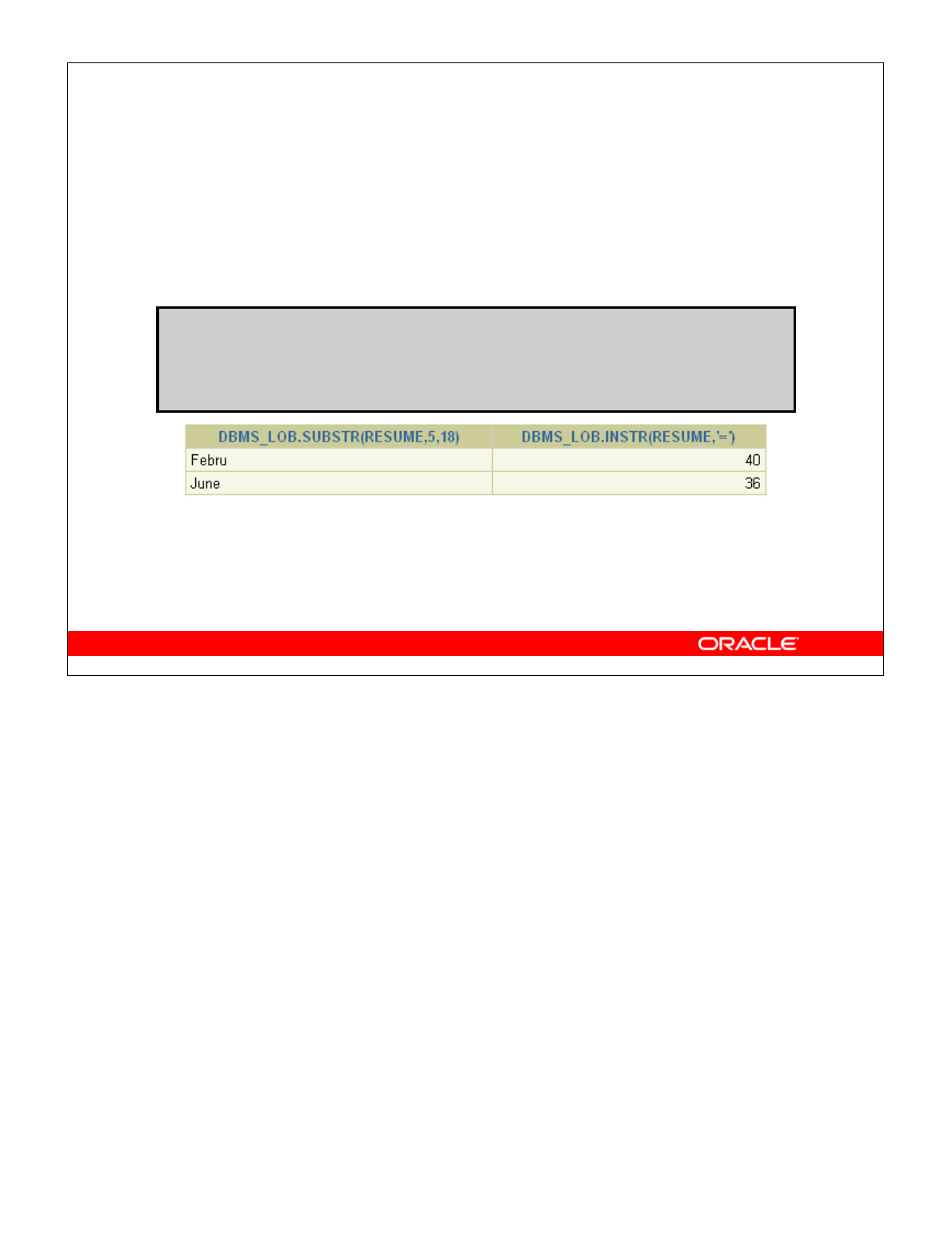
Oracle Database 10g: Develop PL/SQL Program Units 9-28
9-28 Copyright © 2004, Oracle. All rights reserved.
Selecting CLOB Values by Using DBMS_LOB
•DBMS_LOB.SUBSTR (lob, amount, start_pos)
•DBMS_LOB.INSTR (lob, pattern)
SELECT DBMS_LOB.SUBSTR (resume, 5, 18),
DBMS_LOB.INSTR (resume,' = ')
FROM emp_hiredata
WHERE employee_id IN (170, 405);
Selecting CLOB Values by Using DBMS_LOB
DBMS_LOB.SUBSTR
Use DBMS_LOB.SUBSTR to display a part of a LOB. It is similar in functionality to the
SUBSTR SQL function.
DBMS_LOB.INSTR
Use DBMS_LOB.INSTR to search for information within the LOB. This function returns the
numerical position of the information.
Note: Starting with Oracle9i, you can also use the SUBSTR and INSTR SQL functions to
perform the operations shown in the slide.
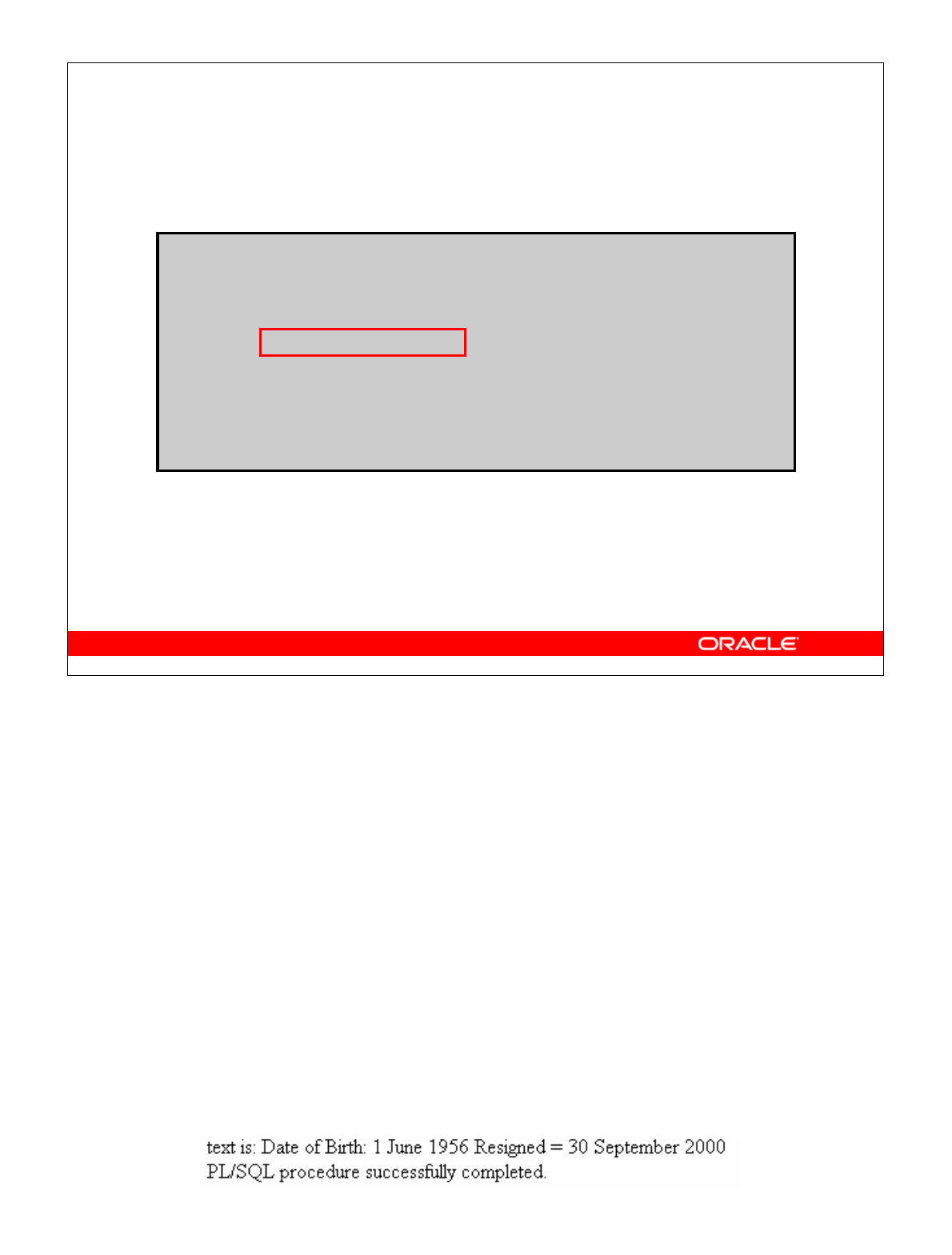
Oracle Database 10g: Develop PL/SQL Program Units 9-29
9-29 Copyright © 2004, Oracle. All rights reserved.
SET LINESIZE 50 SERVEROUTPUT ON FORMAT WORD_WRAP
DECLARE
text VARCHAR2(4001);
BEGIN
SELECT resume INTO text
FROM emp_hiredata
WHERE employee_id = 170;
DBMS_OUTPUT.PUT_LINE('text is: '|| text);
END;
/
Selecting CLOB Values in PL/SQL
text is: Date of Birth: 1 June 1956 Resigned = 30
September 2000
PL/SQL procedure successfully completed.
Selecting CLOB Values in PL/SQL
The slide shows the code for accessing CLOB values that can be implicitly converted to
VARCHAR2 in Oracle10g. When selected, the RESUME column value is implicitly converted
from a CLOB into a VARCHAR2 to be stored in the TEXT variable. Prior to Oracle9i, you
first retrieved the CLOB locator value into a CLOB variable, and then read the LOB contents
specifying the amount and offset in the DBMS_LOB.READ procedure:
DECLARE
rlob CLOB;
text VARCHAR2(4001);
amt NUMBER := 4001;
offset NUMBER := 1;
BEGIN
SELECT resume INTO rlob FROM emp_hirdata
WHERE employee_id = 170;
DBMS_LOB.READ(rlob, amt, offset, text);
DBMS_OUTPUT.PUT_LINE('text is: '|| text);
END;
/
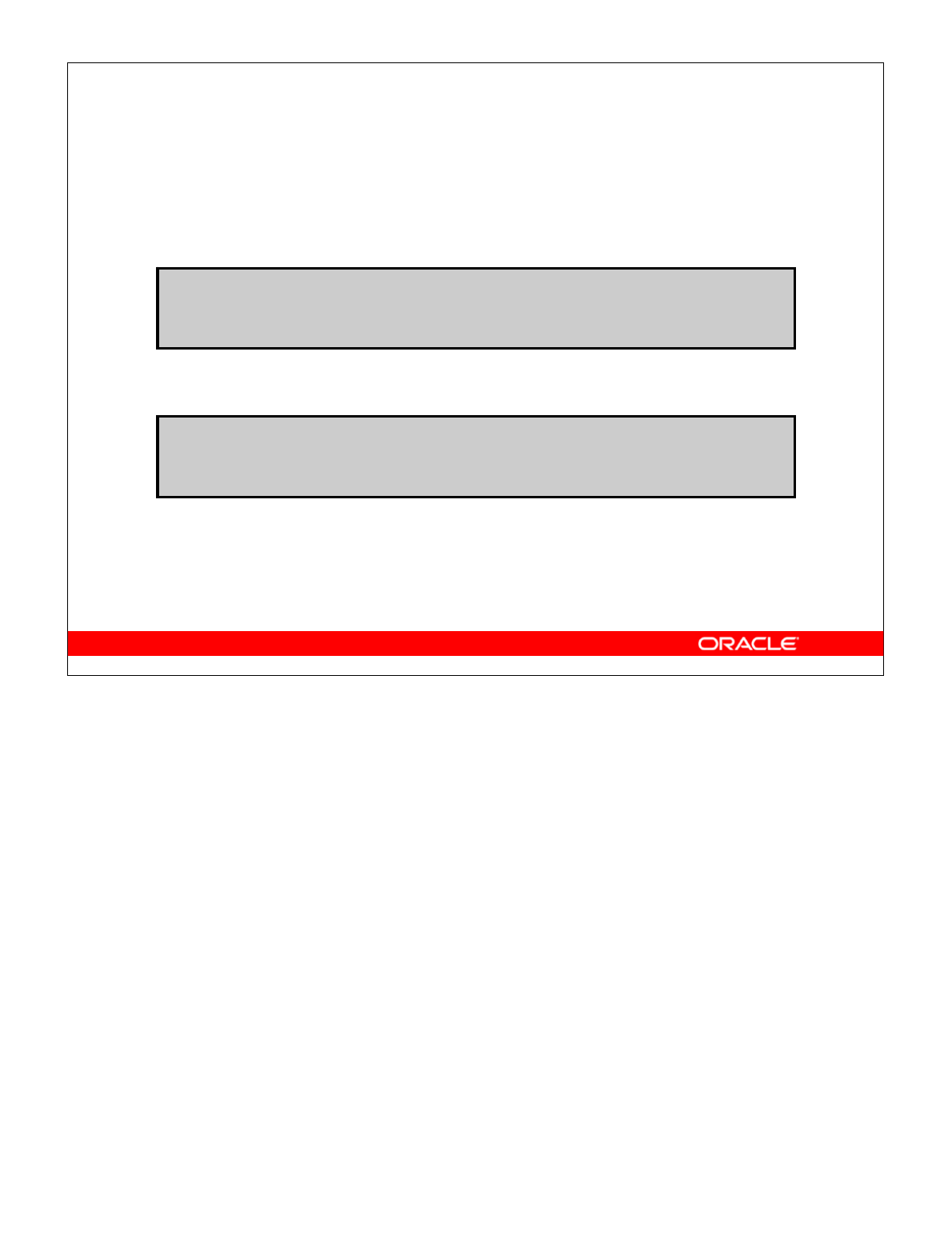
Oracle Database 10g: Develop PL/SQL Program Units 9-30
9-30 Copyright © 2004, Oracle. All rights reserved.
Removing LOBs
•Delete a row containing LOBs:
•Disassociate a LOB value from a row:
DELETE
FROM emp_hiredata
WHERE employee_id = 405;
UPDATE emp_hiredata
SET resume = EMPTY_CLOB()
WHERE employee_id = 170;
Removing LOBs
A LOB instance can be deleted (destroyed) using appropriate SQL DML statements. The
SQL statement DELETE deletes a row and its associated internal LOB value. To preserve the
row and destroy only the reference to the LOB, you must update the row by replacing the
LOB column value with NULL or an empty string, or by using the EMPTY_B/CLOB()
function.
Note: Replacing a column value with NULL and using EMPTY_B/CLOB are not the same.
Using NULL sets the value to null; using EMPTY_B/CLOB ensures that there is nothing in
the column.
A LOB is destroyed when the row containing the LOB column is deleted, when the table is
dropped or truncated, or when all the LOB data is updated.
You must explicitly remove the file associated with a BFILE using OS commands.
To erase part of an internal LOB, you can use DBMS_LOB.ERASE.
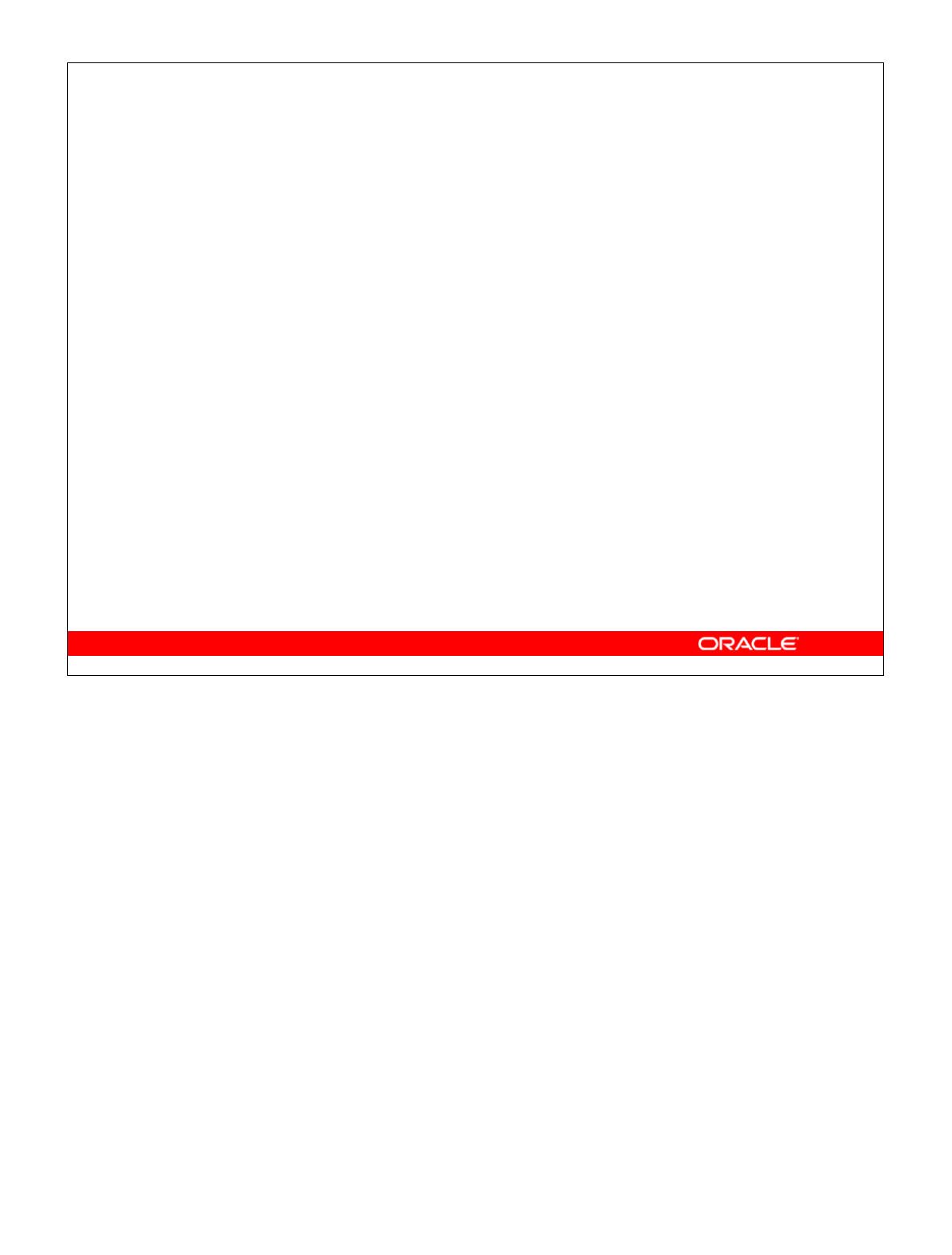
Oracle Database 10g: Develop PL/SQL Program Units 9-31
9-31 Copyright © 2004, Oracle. All rights reserved.
Temporary LOBs
•Temporary LOBs:
–Provide an interface to support creation of LOBs
that act like local variables
–Can be BLOBs, CLOBs, or NCLOBs
–Are not associated with a specific table
–Are created using the
DBMS_LOB.CREATETEMPORARY procedure
–Use DBMS_LOB routines
•The lifetime of a temporary LOB is a session.
•Temporary LOBs are useful for transforming data
in permanent internal LOBs.
Temporary LOBs
Temporary LOBs provide an interface to support the creation and deletion of LOBs that act
like local variables. Temporary LOBs can be BLOBs, CLOBs, or NCLOBs.
The following are the features of temporary LOBs:
• Data is stored in your temporary tablespace, not in tables.
• Temporary LOBs are faster than persistent LOBs because they do not generate any redo
or rollback information.
• Temporary LOBs lookup is localized to each user’s own session. Only the user who
creates a temporary LOB can access it, and all temporary LOBs are deleted at the end of
the session in which they were created.
• You can create a temporary LOB using DBMS_LOB.CREATETEMPORARY.
Temporary LOBs are useful when you want to perform some transformational operation on a
LOB (for example, changing an image type from GIF to JPEG). A temporary LOB is empty
when created and does not support the EMPTY_B/CLOB functions.
Use the DBMS_LOB package to use and manipulate temporary LOBs.
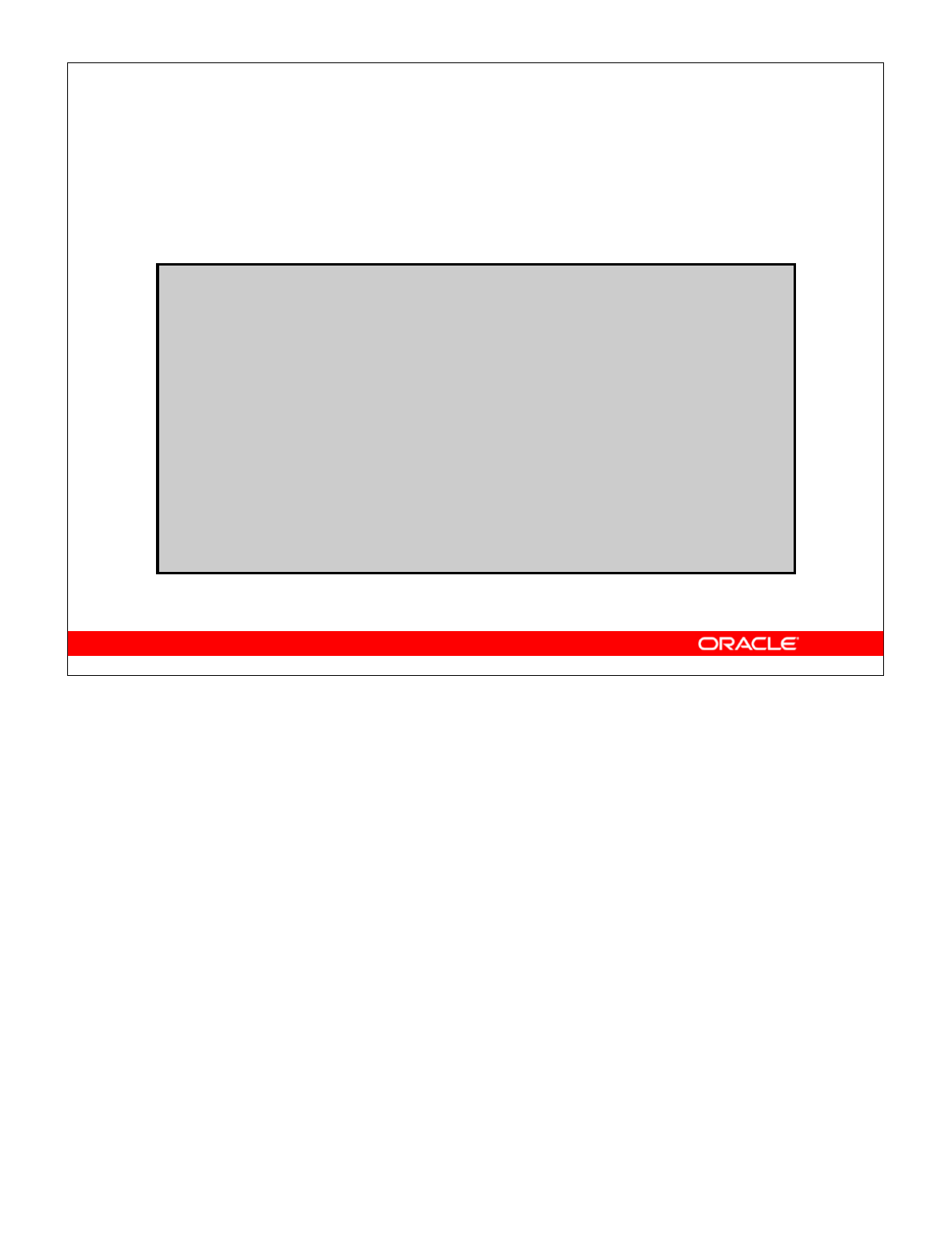
Oracle Database 10g: Develop PL/SQL Program Units 9-32
9-32 Copyright © 2004, Oracle. All rights reserved.
Creating a Temporary LOB
PL/SQL procedure to create and test a temporary LOB:
CREATE OR REPLACE PROCEDURE is_templob_open(
lob IN OUT BLOB, retval OUT INTEGER) IS
BEGIN
-- create a temporary LOB
DBMS_LOB.CREATETEMPORARY (lob, TRUE);
-- see if the LOB is open: returns 1 if open
retval := DBMS_LOB.ISOPEN (lob);
DBMS_OUTPUT.PUT_LINE (
'The file returned a value...' || retval);
-- free the temporary LOB
DBMS_LOB.FREETEMPORARY (lob);
END;
/
Creating a Temporary LOB
The example in the slide shows a user-defined PL/SQL procedure, is_templob_open,
that creates a temporary LOB. This procedure accepts a LOB locator as input, creates a
temporary LOB, opens it, and tests whether the LOB is open.
The IsTempLOBOpen procedure uses the procedures and functions from the DBMS_LOB
package as follows:
• The CREATETEMPORARY procedure is used to create the temporary LOB.
• The ISOPEN function is used to test whether a LOB is open: this function returns the
value 1 if the LOB is open.
• The FREETEMPORARY procedure is used to free the temporary LOB. Memory
increases incrementally as the number of temporary LOBs grows, and you can reuse
temporary LOB space in your session by explicitly freeing temporary LOBs.
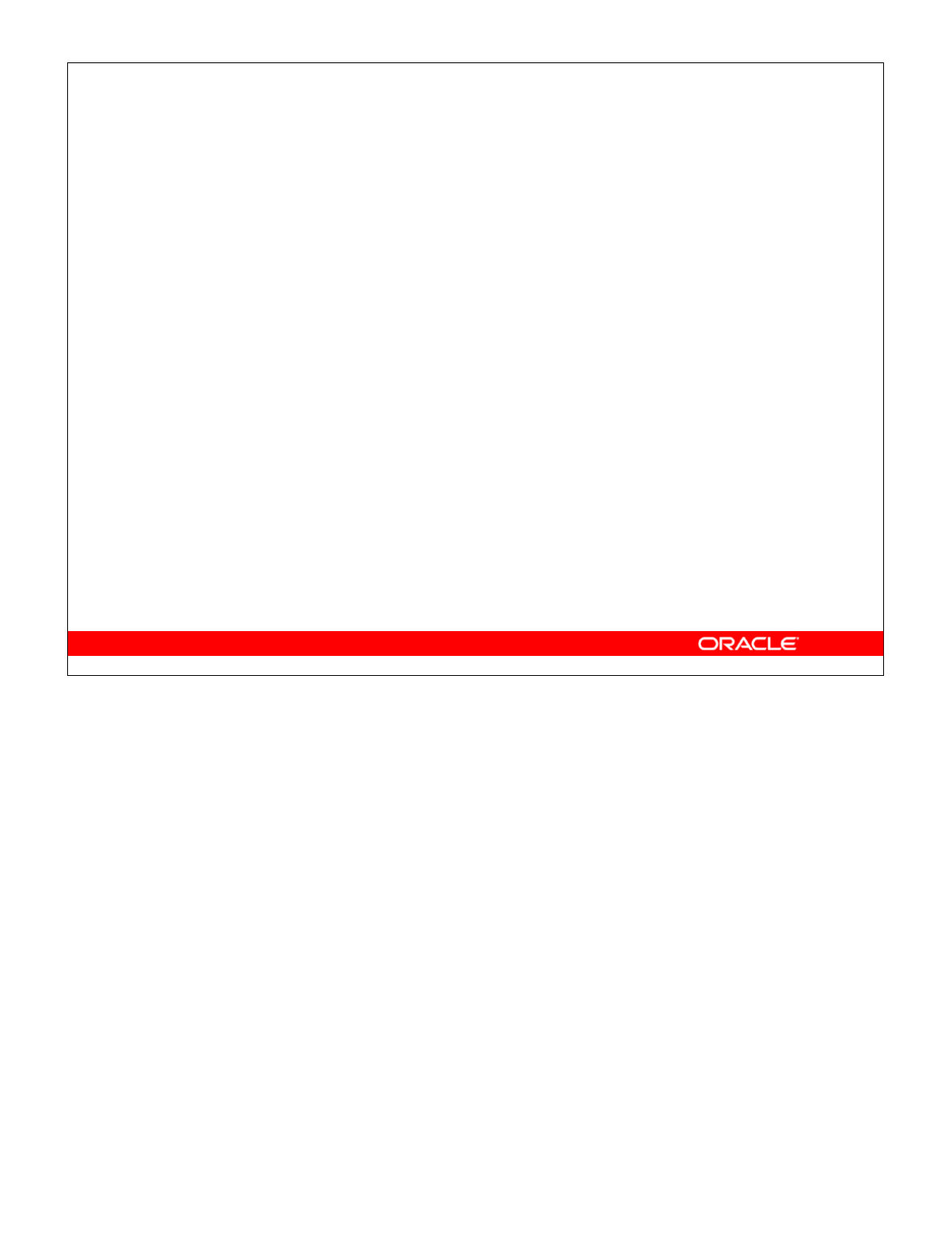
Oracle Database 10g: Develop PL/SQL Program Units 9-33
9-33 Copyright © 2004, Oracle. All rights reserved.
Summary
In this lesson, you should have learned how to:
•Identify four built-in types for large objects: BLOB,
CLOB, NCLOB, and BFILE
•Describe how LOBs replace LONG and LONG RAW
•Describe two storage options for LOBs:
–Oracle server (internal LOBs)
–External host files (external LOBs)
•Use the DBMS_LOB PL/SQL package to provide
routines for LOB management
•Use temporary LOBs in a session
Summary
There are four LOB data types:
•A BLOB is a binary large object.
•A CLOB is a character large object.
•A NCLOB stores multibyte national character set data.
•A BFILE is a large object stored in a binary file outside the database.
LOBs can be stored internally (in the database) or externally (in an OS file). You can
manage LOBs by using the DBMS_LOB package and its procedure.
Temporary LOBs provide an interface to support the creation and deletion of LOBs that act
like local variables.
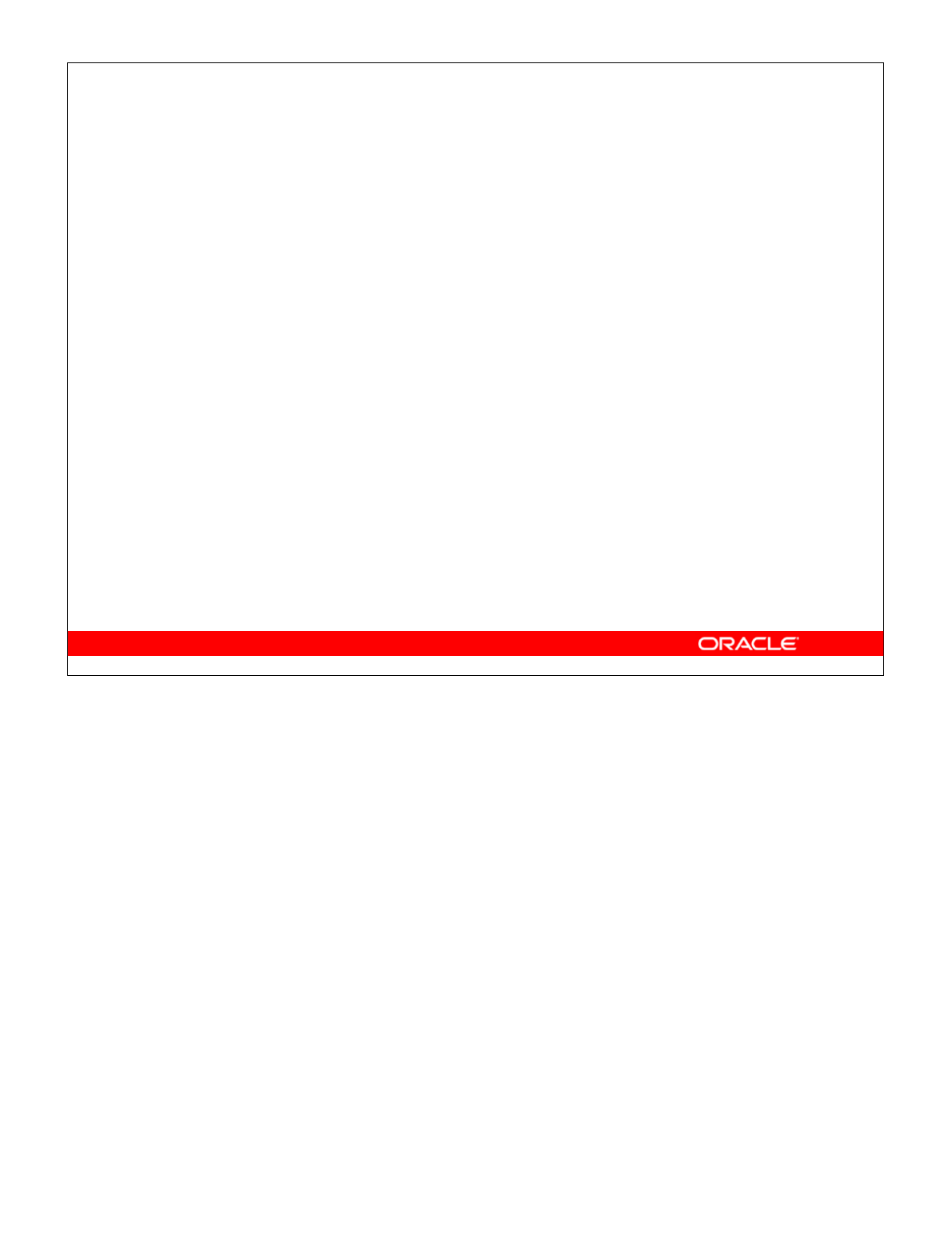
Oracle Database 10g: Develop PL/SQL Program Units 9-34
9-34 Copyright © 2004, Oracle. All rights reserved.
Practice 9: Overview
This practice covers the following topics:
•Creating object types using the CLOB and BLOB
data types
•Creating a table with LOB data types as columns
•Using the DBMS_LOB package to populate and
interact with the LOB data
Practice 9: Overview
In this practice, you create a table with both BLOB and CLOB columns. Then you use the
DBMS_LOB package to populate the table and manipulate the data.

Oracle Database 10g: Develop PL/SQL Program Units 9-35
Practice 9
1. Create a table called PERSONNEL by executing the script file
E:\labs\PLPU\labs\lab_09_01.sql. The table contains the following attributes
and data types:
2. Insert two rows into the PERSONNEL table, one each for employee 2034 (whose last
name is Allen) and for employee 2035 (whose last name is Bond). Use the empty
function for the CLOB, and provide NULL as the value for the BLOB.
3. Examine and execute the script E:\labs\PLPU\labs\lab_09_03.sql. The script
creates a table named REVIEW_TABLE. This table contains annual review information
for each employee. The script also contains two statements to insert review details for two
employees.
4. Update the PERSONNEL table.
a. Populate the CLOB for the first row, using this subquery in an UPDATE statement:
SELECT ann_review
FROM review_table
WHERE employee_id = 2034;
b. Populate the CLOB for the second row, using PL/SQL and the DBMS_LOB package.
Use the following SELECT statement to provide a value for the LOB locator.
SELECT ann_review
FROM review_table
WHERE employee_id = 2035;
If you have time, complete the following exercise:
5. Create a procedure that adds a locator to a binary file into the PICTURE column of the
COUNTRIES table. The binary file is a picture of the country flag. The image files are
named after the country IDs. You need to load an image file locator into all rows in
Europe region (REGION_ID = 1) in the COUNTRIES table. A DIRECTORY object called
COUNTRY_PIC referencing the location of the binary files has to be created for you.
a. Add the image column to the COUNTRIES table using:
ALTER TABLE countries ADD (picture BFILE);
Alternatively, use the E:\labs\PLPU\labs\Lab_09_05_a.sql file.
b. Create a PL/SQL procedure called load_country_image that uses
DBMS_LOB.FILEEXISTS to test if the country picture file exists. If the file exists,
then set the BFILE locator for the file in the PICTURE column; otherwise, display a
message that the file does not exist. Use the DBMS_OUTPUT package to report file
size information for each image associated with the PICTURE column.
c. Invoke the procedure by passing the name of the directory object COUNTRY_PIC as
a string literal parameter value.
Column Name Data Type Length
ID NUMBER 6
last_name VARCHAR2 35
review CLOB N/A
picture BLOB N/A

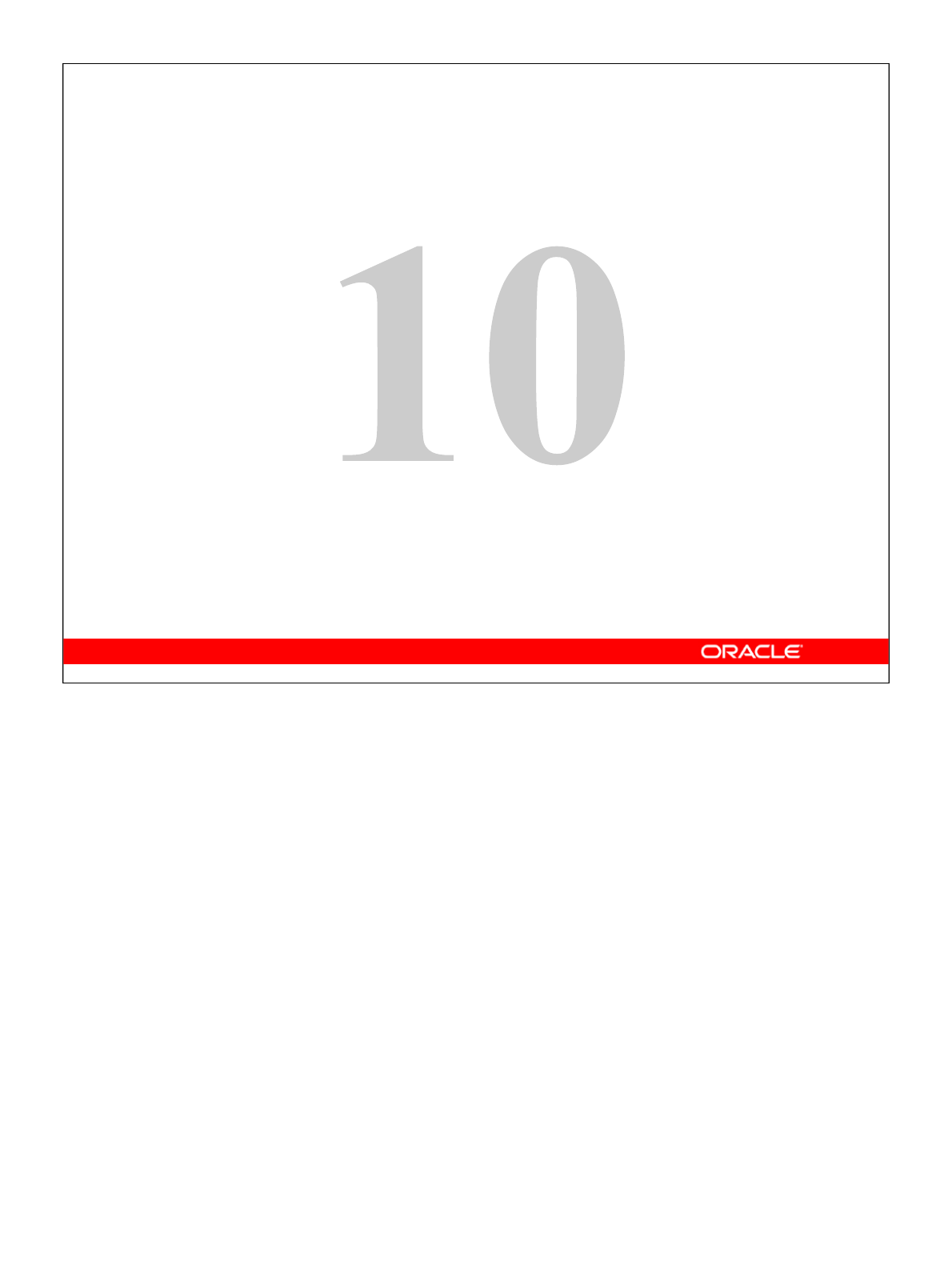
Copyright © 2004, Oracle. All rights reserved.
Creating Triggers

Oracle Database 10g: Develop PL/SQL Program Units 10-2
10-2 Copyright © 2004, Oracle. All rights reserved.
Objectives
After completing this lesson, you should be able to do
the following:
•Describe the different types of triggers
•Describe database triggers and their uses
•Create database triggers
•Describe database trigger-firing rules
•Remove database triggers
Lesson Aim
In this lesson, you learn how to create and use database triggers.

Oracle Database 10g: Develop PL/SQL Program Units 10-3
10-3 Copyright © 2004, Oracle. All rights reserved.
Types of Triggers
A trigger:
•Is a PL/SQL block or a PL/SQL procedure
associated with a table, view, schema, or database
•Executes implicitly whenever a particular event
takes place
•Can be either of the following:
–Application trigger: Fires whenever an event occurs
with a particular application
–Database trigger: Fires whenever a data event (such
as DML) or system event (such as logon or
shutdown) occurs on a schema or database
Types of Triggers
Application triggers execute implicitly whenever a particular data manipulation language
(DML) event occurs within an application. An example of an application that uses triggers
extensively is an application developed with Oracle Forms Developer.
Database triggers execute implicitly when any of the following events occur:
• DML operations on a table
• DML operations on a view, with an INSTEAD OF trigger
• DDL statements, such as CREATE and ALTER
This is the case no matter which user is connected or which application is used. Database
triggers also execute implicitly when some user actions or database system actions occur
(for example, when a user logs on or the DBA shut downs the database).
Note: Database triggers can be defined on tables and on views. If a DML operation is
issued on a view, then the INSTEAD OF trigger defines what actions take place. If these
actions include DML operations on tables, then any triggers on the base tables are fired.
Database triggers can be system triggers on a database or a schema. For databases, triggers
fire for each event for all users; for a schema, they fire for each event for that specific user.
This course explains how to create database triggers. Creating database triggers based on
system events is discussed in the lesson titled “More Trigger Concepts.”

Oracle Database 10g: Develop PL/SQL Program Units 10-4
10-4 Copyright © 2004, Oracle. All rights reserved.
Guidelines for Designing Triggers
•You can design triggers to:
–Perform related actions
–Centralize global operations
•You must not design triggers:
–Where functionality is already built into the Oracle
server
–That duplicate other triggers
•You can create stored procedures and invoke
them in a trigger, if the PL/SQL code is very
lengthy.
•The excessive use of triggers can result in
complex interdependencies, which may be difficult
to maintain in large applications.
Guidelines for Designing Triggers
• Use triggers to guarantee that related actions are performed for a specific operation.
• Use database triggers for centralized, global operations that should be fired for the
triggering statement, independent of the user or application issuing the statement.
• Do not define triggers to duplicate or replace the functionality already built into the
Oracle database. For example, implement integrity rules using declarative
constraints, not triggers. To remember the design order for a business rule:
- Use built-in constraints in the Oracle server, such as primary key, and so on.
- Develop a database trigger or an application, such as a servlet or Enterprise
JavaBean (EJB) on your middle tier.
- Use a presentation interface, such as Oracle Forms, HTML, JavaServer Pages
(JSP) and so on, for data presentation rules.
• Excessive use of triggers can result in complex interdependencies, which may be
difficult to maintain. Use triggers when necessary, and be aware of recursive and
cascading effects.
• Avoid lengthy trigger logic by creating stored procedures or packaged procedures
that are invoked in the trigger body.
• Database triggers fire for every user each time the event occurs on the trigger which
is created.

Oracle Database 10g: Develop PL/SQL Program Units 10-5
10-5 Copyright © 2004, Oracle. All rights reserved.
Creating DML Triggers
Create DML statement or row type triggers by using:
•A statement trigger fires once for a DML
statement.
•A row trigger fires once for each row affected.
Note: Trigger names must be unique with respect to
other triggers in the same schema.
CREATE [OR REPLACE] TRIGGER trigger_name
timing
event1 [OR event2 OR event3]
ON object_name
[[REFERENCING OLD AS old | NEW AS new]
FOR EACH ROW
[WHEN (condition)]]
trigger_body
Creating DML Triggers
The components of the trigger syntax are:
•trigger_name uniquely identifies the trigger.
•timing indicates when the trigger fires in relation to the triggering event. Values
are BEFORE, AFTER, or INSTEAD OF.
•event identifies the DML operation causing the trigger to fire.
Values are INSERT, UPDATE [OF column], and DELETE.
•object_name indicates the table or view associated with the trigger.
• For row triggers you can specify:
-A REFERENCING clause to choose a correlation names for referencing the old
and new values of the current row (default values are OLD and NEW)
-FOR EACH ROW to designate that the trigger is a row trigger
-A WHEN clause to apply a conditional predicate, in parentheses, which is
evaluated for each row to determine whether or not to execute the trigger body
• The trigger_body is the action performed by the trigger, implemented as either of the
following:
- An anonymous block with a DECLARE or BEGIN, and an END
-A CALL clause to invoke a stand-alone or packaged stored procedure, such as:
CALL my_procedure;

Oracle Database 10g: Develop PL/SQL Program Units 10-6
10-6 Copyright © 2004, Oracle. All rights reserved.
Types of DML Triggers
The trigger type determines if the body executes for
each row or only once for the triggering statement.
•A statement trigger:
–Executes once for the triggering event
–Is the default type of trigger
–Fires once even if no rows are affected at all
•A row trigger:
–Executes once for each row affected by the
triggering event
–Is not executed if the triggering event does not
affect any rows
–Is indicated by specifying the FOR EACH ROW clause
Types of DML Triggers
You can specify that the trigger will be executed once for every row affected by the
triggering statement (such as a multiple row UPDATE) or once for the triggering statement,
no matter how many rows it affects.
Statement Trigger
A statement trigger is fired once on behalf of the triggering event, even if no rows are
affected at all. Statement triggers are useful if the trigger action does not depend on the
data from rows that are affected or on data provided by the triggering event itself (for
example, a trigger that performs a complex security check on the current user).
Row Trigger
A row trigger fires each time the table is affected by the triggering event. If the triggering
event affects no rows, a row trigger is not executed. Row triggers are useful if the trigger
action depends on data of rows that are affected or on data provided by the triggering
event itself.
Note: Row triggers use correlation names to access the old and new column values of the
row being processed by the trigger.

Oracle Database 10g: Develop PL/SQL Program Units 10-7
10-7 Copyright © 2004, Oracle. All rights reserved.
Trigger Timing
When should the trigger fire?
•BEFORE: Execute the trigger body before the
triggering DML event on a table.
•AFTER: Execute the trigger body after the
triggering DML event on a table.
•INSTEAD OF: Execute the trigger body instead of
the triggering statement. This is used for views
that are not otherwise modifiable.
Note: If multiple triggers are defined for the same
object, then the order of firing triggers is arbitrary.
Trigger Timing
The BEFORE trigger timing is frequently used in the following situations:
• To determine whether the triggering statement should be allowed to complete (This
eliminates unnecessary processing and enables a rollback in cases where an
exception is raised in the triggering action.)
• To derive column values before completing an INSERT or UPDATE statement
• To initialize global variables or flags, and to validate complex business rules
The AFTER triggers are frequently used in the following situations:
• To complete the triggering statement before executing the triggering action
• To perform different actions on the same triggering statement if a BEFORE trigger is
already present
The INSTEAD OF triggers provide a transparent way of modifying views that cannot be
modified directly through SQL DML statements because a view is not always modifiable.
You can write appropriate DML statements inside the body of an INSTEAD OF trigger to
perform actions directly on the underlying tables of views.
Note: If multiple triggers are defined for a table, then the order in which multiple triggers
of the same type fire is arbitrary. To ensure that triggers of the same type are fired in a
particular order, consolidate the triggers into one trigger that calls separate procedures in
the desired order.

Oracle Database 10g: Develop PL/SQL Program Units 10-8
10-8 Copyright © 2004, Oracle. All rights reserved.
…
Trigger-Firing Sequence
Use the following firing sequence for a trigger on a
table when a single row is manipulated:
BEFORE statement
trigger
BEFORE row trigger
AFTER row trigger
AFTER statement trigger
DML statement
INSERT INTO departments
(department_id,department_name, location_id)
VALUES (400, 'CONSULTING', 2400);
Triggering action
Trigger-Firing Sequence
Create a statement trigger or a row trigger based on the requirement that the trigger must
fire once for each row affected by the triggering statement, or just once for the triggering
statement, regardless of the number of rows affected.
When the triggering DML statement affects a single row, both the statement trigger and
the row trigger fire exactly once.
Example
The SQL statement in the slide does not differentiate statement triggers from row triggers,
because exactly one row is inserted into the table using the syntax for the INSERT
statement shown.

Oracle Database 10g: Develop PL/SQL Program Units 10-9
10-9 Copyright © 2004, Oracle. All rights reserved.
UPDATE employees
SET salary = salary * 1.1
WHERE department_id = 30;
Trigger-Firing Sequence
Use the following firing sequence for a trigger on a
table when many rows are manipulated:
BEFORE statement trigger
BEFORE row trigger
AFTER row trigger
...
BEFORE row trigger
AFTER row trigger
...
AFTER statement trigger
Trigger-Firing Sequence (continued)
When the triggering DML statement affects many rows, the statement trigger fires exactly
once, and the row trigger fires once for every row affected by the statement.
Example
The SQL statement in the slide causes a row-level trigger to fire a number of times equal
to the number of rows that satisfy the WHERE clause, that is, the number of employees
reporting to department 30.

Oracle Database 10g: Develop PL/SQL Program Units 10-10
10-10 Copyright © 2004, Oracle. All rights reserved.
Trigger Event Types and Body
A trigger event:
•Determines which DML statement causes the
trigger to execute
•Types are:
–INSERT
–UPDATE [OF column]
–DELETE
A trigger body:
•Determines what action is performed
•Is a PL/SQL block or a CALL to a procedure
Triggering Event Types
The triggering event or statement can be an INSERT, UPDATE, or DELETE statement on
a table.
• When the triggering event is an UPDATE statement, you can include a column list to
identify which columns must be changed to fire the trigger. You cannot specify a
column list for an INSERT or for a DELETE statement, because it always affects
entire rows.
. . . UPDATE OF salary . . .
• The triggering event can contain one, two, or all three of these DML operations.
. . . INSERT or UPDATE or DELETE
. . . INSERT or UPDATE OF job_id . . .
The trigger body defines the action, that is, what needs to be done when the triggering
event is issued. The PL/SQL block can contain SQL and PL/SQL statements, and can
define PL/SQL constructs such as variables, cursors, exceptions, and so on. You can also
call a PL/SQL procedure or a Java procedure.
Note: The size of a trigger cannot be more than 32 KB.
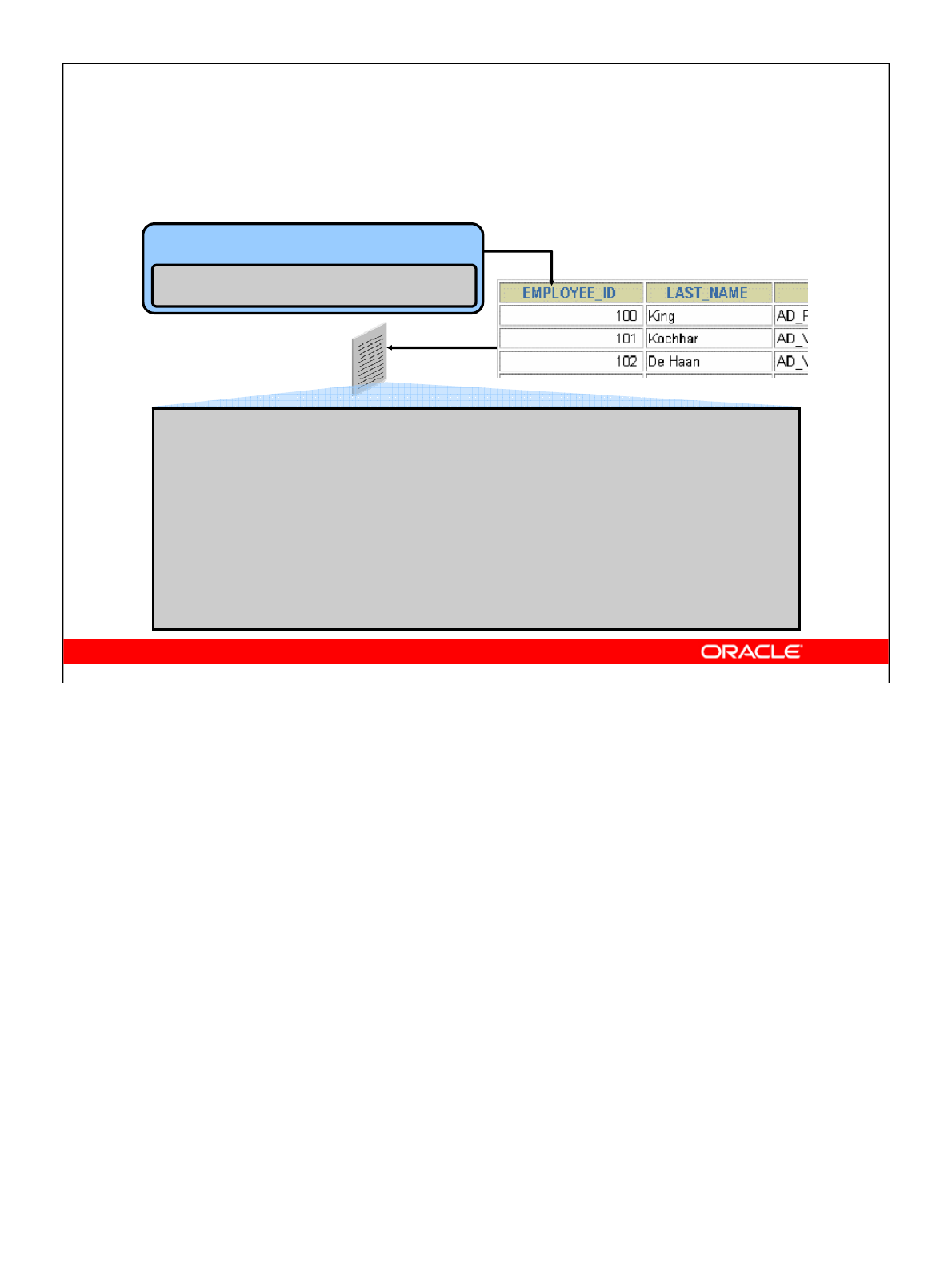
Oracle Database 10g: Develop PL/SQL Program Units 10-11
10-11 Copyright © 2004, Oracle. All rights reserved.
Application
INSERT INTO EMPLOYEES...; EMPLOYEES table
SECURE_EMP trigger
Creating a DML Statement Trigger
CREATE OR REPLACE TRIGGER secure_emp
BEFORE INSERT ON employees BEGIN
IF (TO_CHAR(SYSDATE,'DY') IN ('SAT','SUN')) OR
(TO_CHAR(SYSDATE,'HH24:MI')
NOT BETWEEN '08:00' AND '18:00') THEN
RAISE_APPLICATION_ERROR(-20500, 'You may insert'
||' into EMPLOYEES table only during '
||' business hours.');
END IF;
END;
Creating a DML Statement Trigger
In this example, the database trigger SECURE_EMP is a BEFORE statement trigger that
prevents the INSERT operation from succeeding if the business condition is violated. In
this case, the trigger restricts inserts into the EMPLOYEES table during certain business
hours, Monday through Friday.
If a user attempts to insert a row into the EMPLOYEES table on Saturday, then the user
sees an error message, the trigger fails, and the triggering statement is rolled back.
Remember that the RAISE_APPLICATION_ERROR is a server-side built-in procedure
that returns an error to the user and causes the PL/SQL block to fail.
When a database trigger fails, the triggering statement is automatically rolled back by the
Oracle server
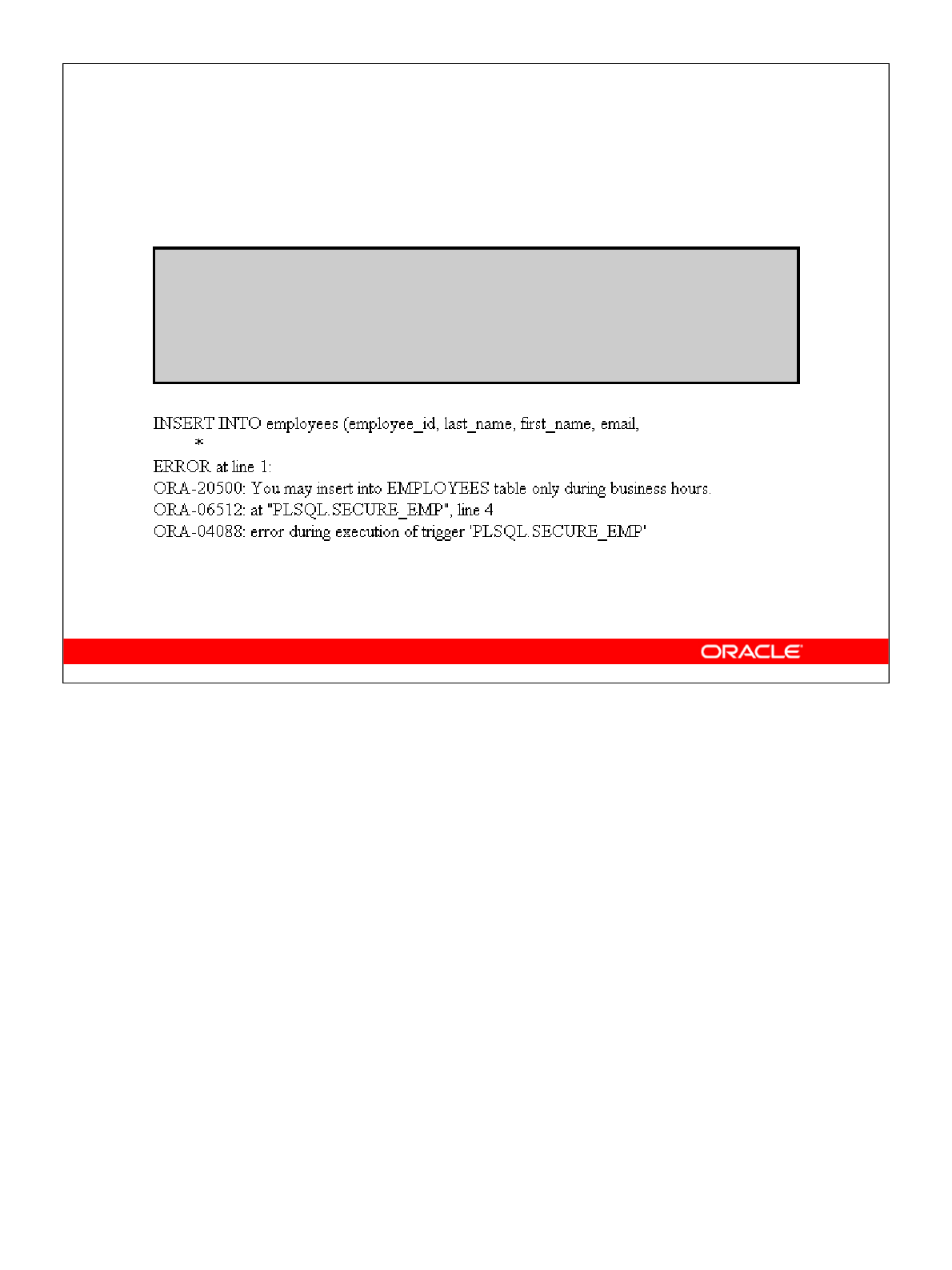
Oracle Database 10g: Develop PL/SQL Program Units 10-12
10-12 Copyright © 2004, Oracle. All rights reserved.
Testing SECURE_EMP
INSERT INTO employees (employee_id, last_name,
first_name, email, hire_date,
job_id, salary, department_id)
VALUES (300, 'Smith', 'Rob', 'RSMITH', SYSDATE,
'IT_PROG', 4500, 60);
Testing SECURE_EMP
Insert a row into the EMPLOYEES table during nonbusiness hours. When the date and time
are out of the business timings specified in the trigger, you get the error message as shown
in the slide.

Oracle Database 10g: Develop PL/SQL Program Units 10-13
10-13 Copyright © 2004, Oracle. All rights reserved.
Using Conditional Predicates
CREATE OR REPLACE TRIGGER secure_emp BEFORE
INSERT OR UPDATE OR DELETE ON employees BEGIN
IF (TO_CHAR(SYSDATE,'DY') IN ('SAT','SUN')) OR
(TO_CHAR(SYSDATE,'HH24')
NOT BETWEEN '08' AND '18') THEN
IF DELETING THEN RAISE_APPLICATION_ERROR(
-20502,'You may delete from EMPLOYEES table'||
'only during business hours.');
ELSIF INSERTING THEN RAISE_APPLICATION_ERROR(
-20500,'You may insert into EMPLOYEES table'||
'only during business hours.');
ELSIF UPDATING('SALARY') THEN
RAISE_APPLICATION_ERROR(-20503, 'You may '||
'update SALARY only during business hours.');
ELSE RAISE_APPLICATION_ERROR(-20504,'You may'||
' update EMPLOYEES table only during'||
' normal hours.');
END IF;
END IF;
END;
Combining Triggering Events
You can combine several triggering events into one by taking advantage of the special
conditional predicates INSERTING, UPDATING, and DELETING within the trigger
body.
Example
Create one trigger to restrict all data manipulation events on the EMPLOYEES table to
certain business hours, Monday through Friday.

Oracle Database 10g: Develop PL/SQL Program Units 10-14
10-14 Copyright © 2004, Oracle. All rights reserved.
Creating a DML Row Trigger
CREATE OR REPLACE TRIGGER restrict_salary
BEFORE INSERT OR UPDATE OF salary ON employees
FOR EACH ROW
BEGIN
IF NOT (:NEW.job_id IN ('AD_PRES', 'AD_VP'))
AND :NEW.salary > 15000 THEN
RAISE_APPLICATION_ERROR (-20202,
'Employee cannot earn more than $15,000.');
END IF;
END;
/
Creating a DML Row Trigger
You can create a BEFORE row trigger in order to prevent the triggering operation from
succeeding if a certain condition is violated.
In the example, a trigger is created to allow certain employees to be able to earn a salary of
more than 15,000. Suppose that a user attempts to execute the following UPDATE
statement: UPDATE employees
SET salary = 15500
WHERE last_name = 'Russell';
The trigger raises the following exception:
UPDATE EMPLOYEES
*
ERROR at line 1:
ORA-20202: Employee cannot earn more than $15,000.
ORA-06512: at "PLSQL.RESTRICT_SALARY", line 5
ORA-04088: error during execution of trigger
"PLSQL.RESTRICT_SALARY"

Oracle Database 10g: Develop PL/SQL Program Units 10-15
10-15 Copyright © 2004, Oracle. All rights reserved.
Using OLD and NEW Qualifiers
CREATE OR REPLACE TRIGGER audit_emp_values
AFTER DELETE OR INSERT OR UPDATE ON employees
FOR EACH ROW
BEGIN
INSERT INTO audit_emp(user_name, time_stamp, id,
old_last_name, new_last_name, old_title,
new_title, old_salary, new_salary)
VALUES (USER, SYSDATE, :OLD.employee_id,
:OLD.last_name, :NEW.last_name, :OLD.job_id,
:NEW.job_id, :OLD.salary, :NEW.salary);
END;
/
Using OLD and NEW Qualifiers
Within a ROW trigger, reference the value of a column before and after the data change by
prefixing it with the OLD and NEW qualifiers.
Usage notes:
• The OLD and NEW qualifiers are available only in ROW triggers.
• Prefix these qualifiers with a colon (:) in every SQL and PL/SQL statement.
• There is no colon (:) prefix if the qualifiers are referenced in the WHEN restricting
condition.
Note: Row triggers can decrease the performance if you do a lot of updates on larger
tables.
Data Operation Old Value New Value
INSERT NULL Inserted value
UPDATE Value before update Value after update
DELETE Value before delete NULL
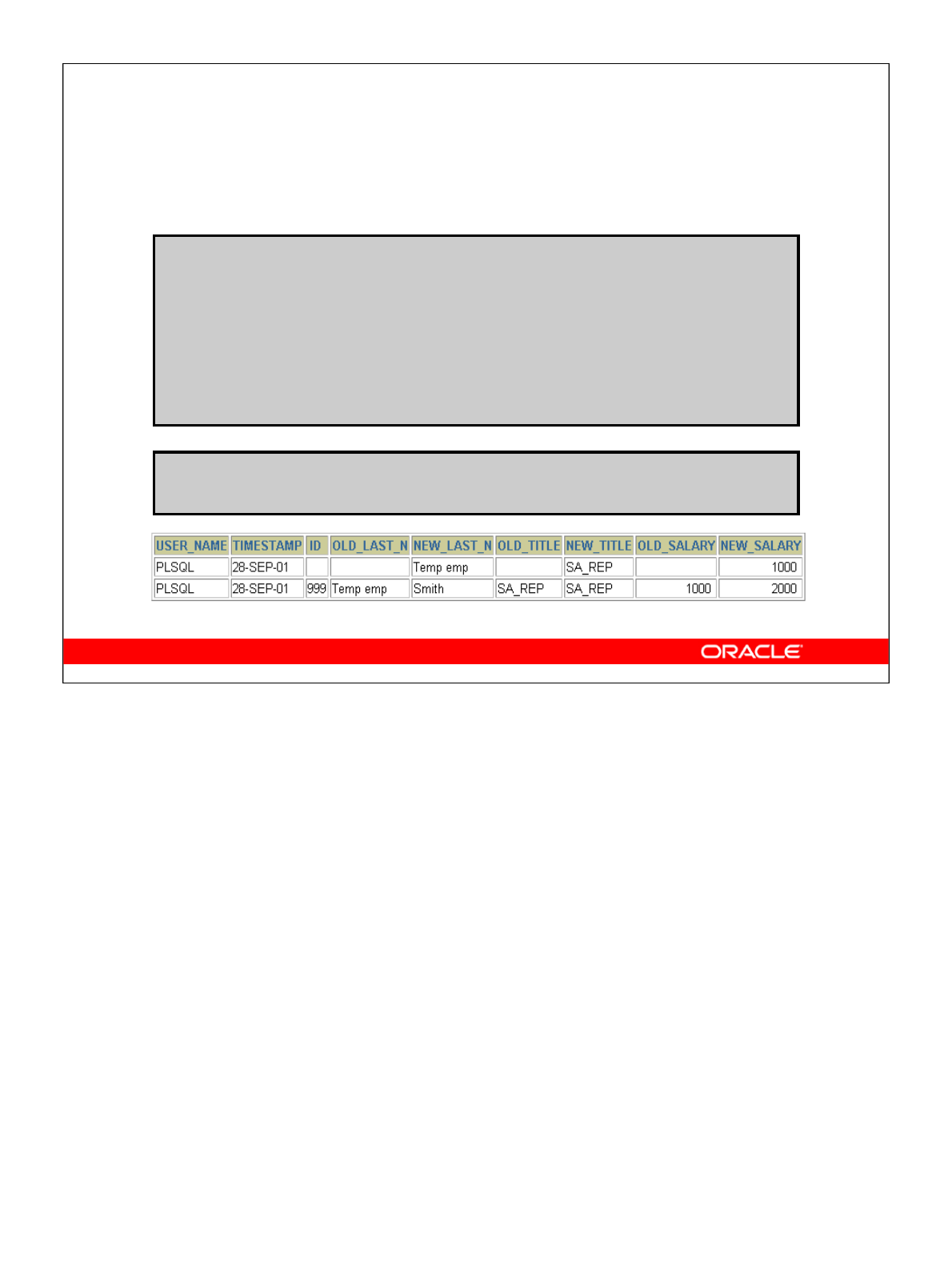
Oracle Database 10g: Develop PL/SQL Program Units 10-16
10-16 Copyright © 2004, Oracle. All rights reserved.
Using OLD and NEW Qualifiers:
Example Using audit_emp
INSERT INTO employees
(employee_id, last_name, job_id, salary, ...)
VALUES (999, 'Temp emp', 'SA_REP', 6000,...);
UPDATE employees
SET salary = 7000, last_name = 'Smith'
WHERE employee_id = 999;
SELECT user_name, timestamp, ...
FROM audit_emp;
Using OLD and NEW Qualifiers: Example Using AUDIT_EMP_TABLE
Create a trigger on the EMPLOYEES table to add rows to a user table, AUDIT_EMP,
logging a user’s activity against the EMPLOYEES table. The trigger records the values of
several columns both before and after the data changes by using the OLD and NEW
qualifiers with the respective column name.
There is an additional column named COMMENTS in AUDIT_EMP that is not shown in this
slide.
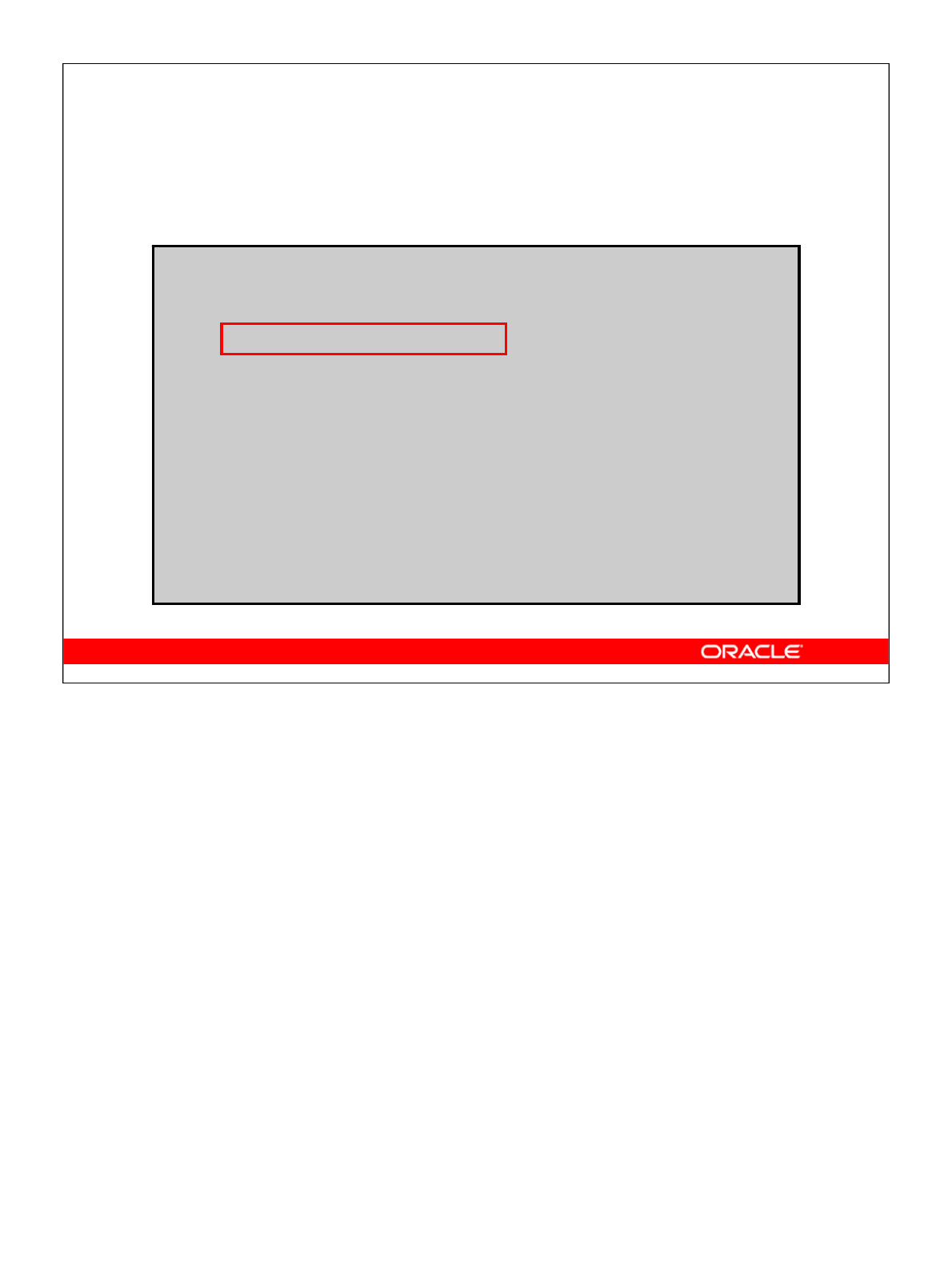
Oracle Database 10g: Develop PL/SQL Program Units 10-17
10-17 Copyright © 2004, Oracle. All rights reserved.
Restricting a Row Trigger: Example
CREATE OR REPLACE TRIGGER derive_commission_pct
BEFORE INSERT OR UPDATE OF salary ON employees
FOR EACH ROW
WHEN (NEW.job_id = 'SA_REP')
BEGIN
IF INSERTING THEN
:NEW.commission_pct := 0;
ELSIF :OLD.commission_pct IS NULL THEN
:NEW.commission_pct := 0;
ELSE
:NEW.commission_pct := :OLD.commission_pct+0.05;
END IF;
END;
/
Restricting a Row Trigger: Example
To restrict the trigger action to those rows that satisfy a certain condition, provide a WHEN
clause.
Create a trigger on the EMPLOYEES table to calculate an employee’s commission when a
row is added to the EMPLOYEES table, or when an employee’s salary is modified.
The NEW qualifier cannot be prefixed with a colon in the WHEN clause, because the WHEN
clause is outside the PL/SQL blocks.

Oracle Database 10g: Develop PL/SQL Program Units 10-18
10-18 Copyright © 2004, Oracle. All rights reserved.
Summary of Trigger Execution Model
1. Execute all BEFORE STATEMENT triggers.
2. Loop for each row affected:
a. Execute all BEFORE ROW triggers.
b. Execute the DML statement and perform integrity
constraint checking.
c. Execute all AFTER ROW triggers.
3. Execute all AFTER STATEMENT triggers.
Note: Integrity checking can be deferred until the
COMMIT operation is performed.
Trigger Execution Model
A single DML statement can potentially fire up to four types of triggers:
• The BEFORE and AFTER statement triggers
• The BEFORE and AFTER row triggers
A triggering event or a statement within the trigger can cause one or more integrity
constraints to be checked. However, you can defer constraint checking until a COMMIT
operation is performed.
Triggers can also cause other triggers—known as cascading triggers—to fire.
All actions and checks performed as a result of a SQL statement must succeed. If an
exception is raised within a trigger and the exception is not explicitly handled, then all
actions performed because of the original SQL statement are rolled back (including actions
performed by firing triggers). This guarantees that integrity constraints can never be
compromised by triggers.
When a trigger fires, the tables referenced in the trigger action may undergo changes by
other users' transactions. In all cases, a read-consistent image is guaranteed for the
modified values that the trigger needs to read (query) or write (update).
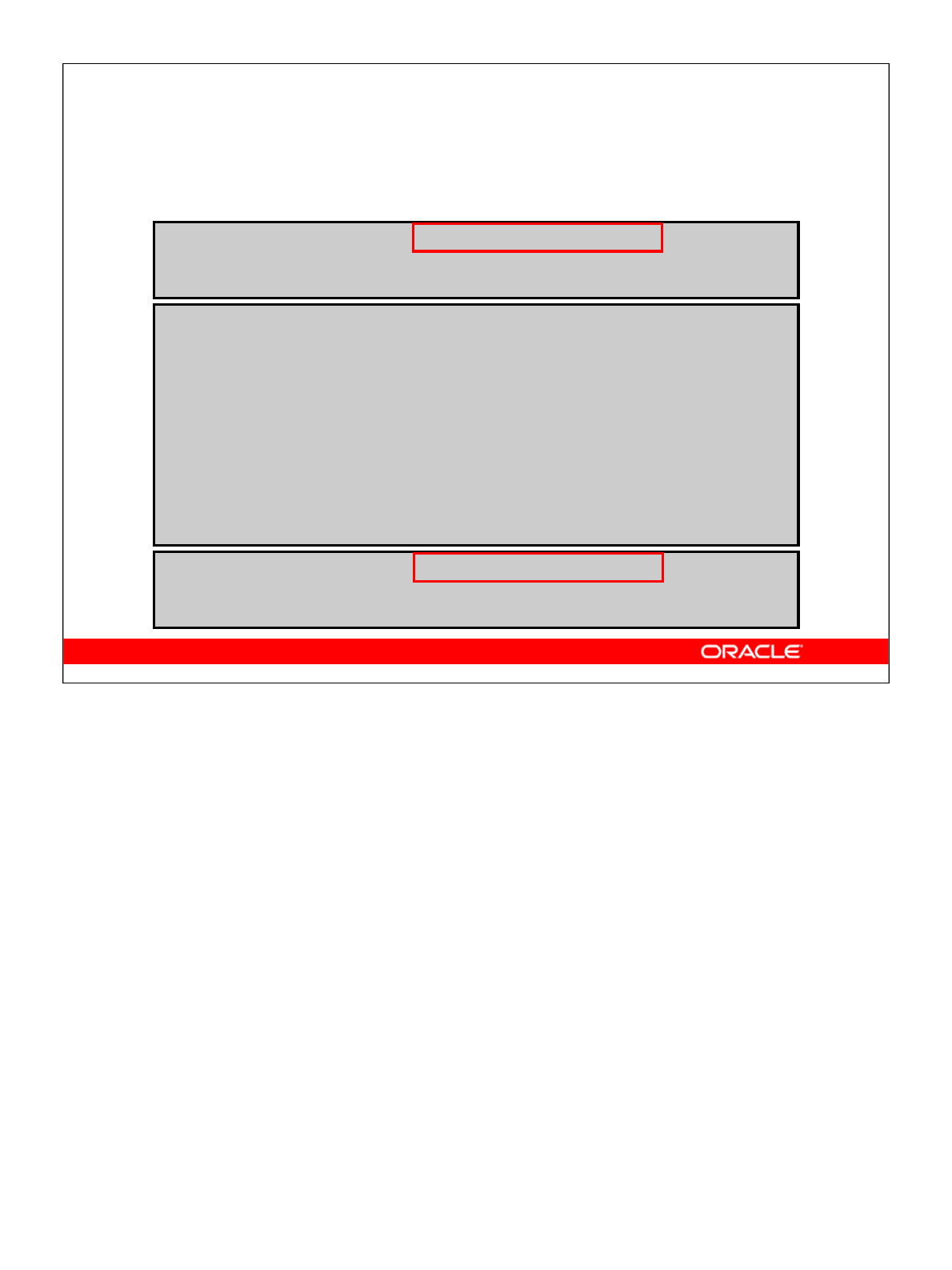
Oracle Database 10g: Develop PL/SQL Program Units 10-19
10-19 Copyright © 2004, Oracle. All rights reserved.
Implementing an Integrity Constraint
with a Trigger
CREATE OR REPLACE TRIGGER employee_dept_fk_trg
AFTER UPDATE OF department_id
ON employees FOR EACH ROW
BEGIN
INSERT INTO departments VALUES(:new.department_id,
'Dept '||:new.department_id, NULL, NULL);
EXCEPTION
WHEN DUP_VAL_ON_INDEX THEN
NULL; -- mask exception if department exists
END;
/
UPDATE employees SET department_id = 999
WHERE employee_id = 170;
-- Successful after trigger is fired
UPDATE employees SET department_id = 999
WHERE employee_id = 170;
-- Integrity constraint violation error
Implementing an Integrity Constraint with a Trigger
The example in the slide explains a situation in which the integrity constraint can be taken
care of by using a trigger. The EMPLOYEES table has a foreign key constraint on the
DEPARTMENT_ID column of the DEPARTMENTS table.
In the first SQL statement, the DEPARTMENT_ID of the employee 170 is modified to 999.
Because department 999 does not exist in the DEPARTMENTS table, the statement raises
the exception -2292 for the integrity constraint violation.
The EMPLOYEE_DEPT_FK_TRG trigger is created that inserts a new row into the
DEPARTMENTS table, using :NEW.DEPARTMENT_ID for the value of the new
department’s DEPARTMENT_ID. The trigger fires when the UPDATE statement modifies
the DEPARTMENT_ID of employee 170 to 999. When the foreign key constraint is
checked, it is successful, because the trigger inserted the department 999 into the
DEPARTMENTS table. Therefore, no exception occurs, unless the department already
exists when the trigger attempts to insert the new row. However, the EXCEPTION handler
traps and masks the exception allowing the operation to succeed.
Note: This example works with Oracle8iand later releases, but produces a run-time error
in releases prior to Oracle8i.

Oracle Database 10g: Develop PL/SQL Program Units 10-20
10-20 Copyright © 2004, Oracle. All rights reserved.
INSTEAD OF Triggers
Application
INSERT INTO my_view
. . .;
MY_VIEW
INSTEAD OF trigger
INSERT
TABLE1
UPDATE
TABLE2
INSTEAD OF Triggers
Use INSTEAD OF triggers to modify data in which the DML statement has been issued
against an inherently nonupdatable view. These triggers are called INSTEAD OF triggers
because, unlike other triggers, the Oracle server fires the trigger instead of executing the
triggering statement. This trigger is used to perform an INSERT, UPDATE, or DELETE
operation directly on the underlying tables. You can write INSERT, UPDATE, or DELETE
statements against a view, and the INSTEAD OF trigger works invisibly in the background
to make the right actions take place. A view cannot be modified by normal DML
statements if the view query contains set operators, group functions, clauses such as
GROUP BY, CONNECT BY, START, the DISTINCT operator, or joins. For example, if a
view consists of more than one table, an insert to the view may entail an insertion into one
table and an update to another. So, you write an INSTEAD OF trigger that fires when you
write an insert against the view. Instead of the original insertion, the trigger body executes,
which results in an insertion of data into one table and an update to another table.
Note: If a view is inherently updatable and has INSTEAD OF triggers, then the triggers
take precedence. INSTEAD OF triggers are row triggers. The CHECK option for views is
not enforced when insertions or updates to the view are performed by using INSTEAD OF
triggers. The INSTEAD OF trigger body must enforce the check.
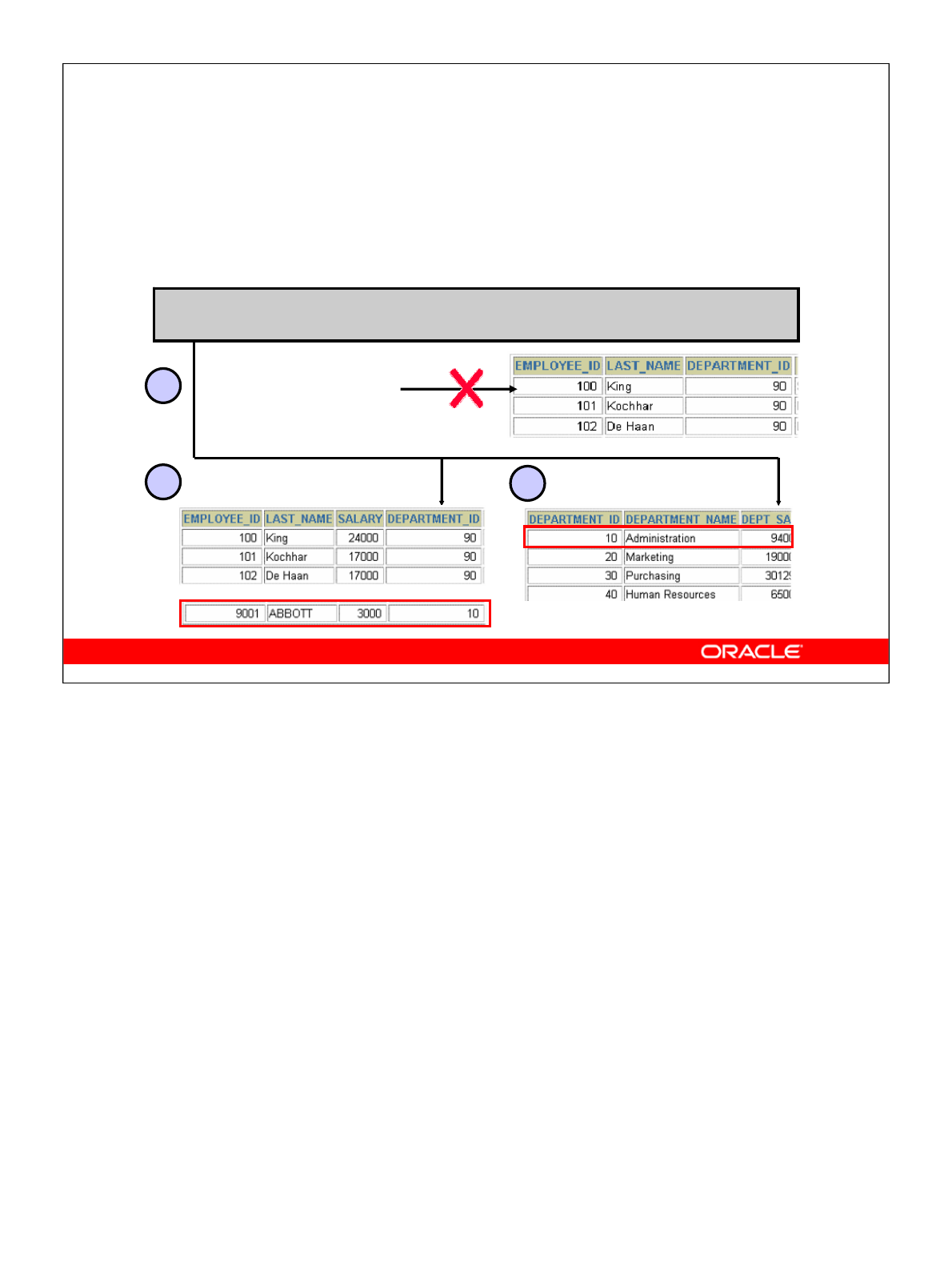
Oracle Database 10g: Develop PL/SQL Program Units 10-21
10-21 Copyright © 2004, Oracle. All rights reserved.
Creating an INSTEAD OF Trigger
Perform the INSERT into EMP_DETAILS that is based
on EMPLOYEES and DEPARTMENTS tables:
INSTEAD OF INSERT
into EMP_DETAILS
INSERT into NEW_EMPS UPDATE NEW_DEPTS
…
…
1
23
INSERT INTO emp_details
VALUES (9001,'ABBOTT',3000, 10, 'Administration');
Creating an INSTEAD OF Trigger
You can create an INSTEAD OF trigger in order to maintain the base tables on which a
view is based. The example illustrates an employee being inserted into view
EMP_DETAILS, whose query is based on the EMPLOYEES and DEPARTMENTS tables.
The NEW_EMP_DEPT (INSTEAD OF) trigger executes in place of the INSERT operation
that causes the trigger to fire. The INSTEAD OF trigger then issues the appropriate
INSERT and UPDATE to the base tables used by the EMP_DETAILS view. Therefore,
instead of inserting the new employee record into the EMPLOYEES table, the following
actions take place:
1. The NEW_EMP_DEPT INSTEAD OF trigger fires.
2. A row is inserted into the NEW_EMPS table.
3. The DEPT_SAL column of the NEW_DEPTS table is updated. The salary value
supplied for the new employee is added to the existing total salary of the department
to which the new employee has been assigned.
Note: The code for this scenario is shown in the next few pages.

Oracle Database 10g: Develop PL/SQL Program Units 10-22
10-22 Copyright © 2004, Oracle. All rights reserved.
Creating an INSTEAD OF Trigger
Use INSTEAD OF to perform DML on complex views:
CREATE TABLE new_emps AS
SELECT employee_id,last_name,salary,department_id
FROM employees;
CREATE TABLE new_depts AS
SELECT d.department_id,d.department_name,
sum(e.salary) dept_sal
FROM employees e, departments d
WHERE e.department_id = d.department_id;
CREATE VIEW emp_details AS
SELECT e.employee_id, e.last_name, e.salary,
e.department_id, d.department_name
FROM employees e, departments d
WHERE e.department_id = d.department_id
GROUP BY d.department_id,d.department_name;
Creating an INSTEAD OF Trigger (continued)
The example creates two new tables, NEW_EMPS and NEW_DEPTS, based on the
EMPLOYEES and DEPARTMENTS tables, respectively. It also creates an EMP_DETAILS
view from the EMPLOYEES and DEPARTMENTS tables.
If a view has a complex query structure, then it is not always possible to perform DML
directly on the view to affect the underlying tables. The example requires creation of an
INSTEAD OF trigger, called NEW_EMP_DEPT, shown on the next page. The
NEW_DEPT_EMP trigger handles DML in the following way:
• When a row is inserted into the EMP_DETAILS view, instead of inserting the row
directly into the view, rows are added into the NEW_EMPS and NEW_DEPTS tables,
using the data values supplied with the INSERT statement.
• When a row is modified or deleted through the EMP_DETAILS view, corresponding
rows in the NEW_EMPS and NEW_DEPTS tables are affected.
Note: INSTEAD OF triggers can be written only for views, and the BEFORE and AFTER
timing options are not valid.

Oracle Database 10g: Develop PL/SQL Program Units 10-23
Creating an INSTEAD OF Trigger (continued)
CREATE OR REPLACE TRIGGER new_emp_dept
INSTEAD OF INSERT OR UPDATE OR DELETE ON emp_details
FOR EACH ROW
BEGIN
IF INSERTING THEN
INSERT INTO new_emps
VALUES (:NEW.employee_id, :NEW.last_name,
:NEW.salary, :NEW.department_id);
UPDATE new_depts
SET dept_sal = dept_sal + :NEW.salary
WHERE department_id = :NEW.department_id;
ELSIF DELETING THEN
DELETE FROM new_emps
WHERE employee_id = :OLD.employee_id;
UPDATE new_depts
SET dept_sal = dept_sal - :OLD.salary
WHERE department_id = :OLD.department_id;
ELSIF UPDATING ('salary') THEN
UPDATE new_emps
SET salary = :NEW.salary
WHERE employee_id = :OLD.employee_id;
UPDATE new_depts
SET dept_sal = dept_sal +
(:NEW.salary - :OLD.salary)
WHERE department_id = :OLD.department_id;
ELSIF UPDATING ('department_id') THEN
UPDATE new_emps
SET department_id = :NEW.department_id
WHERE employee_id = :OLD.employee_id;
UPDATE new_depts
SET dept_sal = dept_sal - :OLD.salary
WHERE department_id = :OLD.department_id;
UPDATE new_depts
SET dept_sal = dept_sal + :NEW.salary
WHERE department_id = :NEW.department_id;
END IF;
END;
/
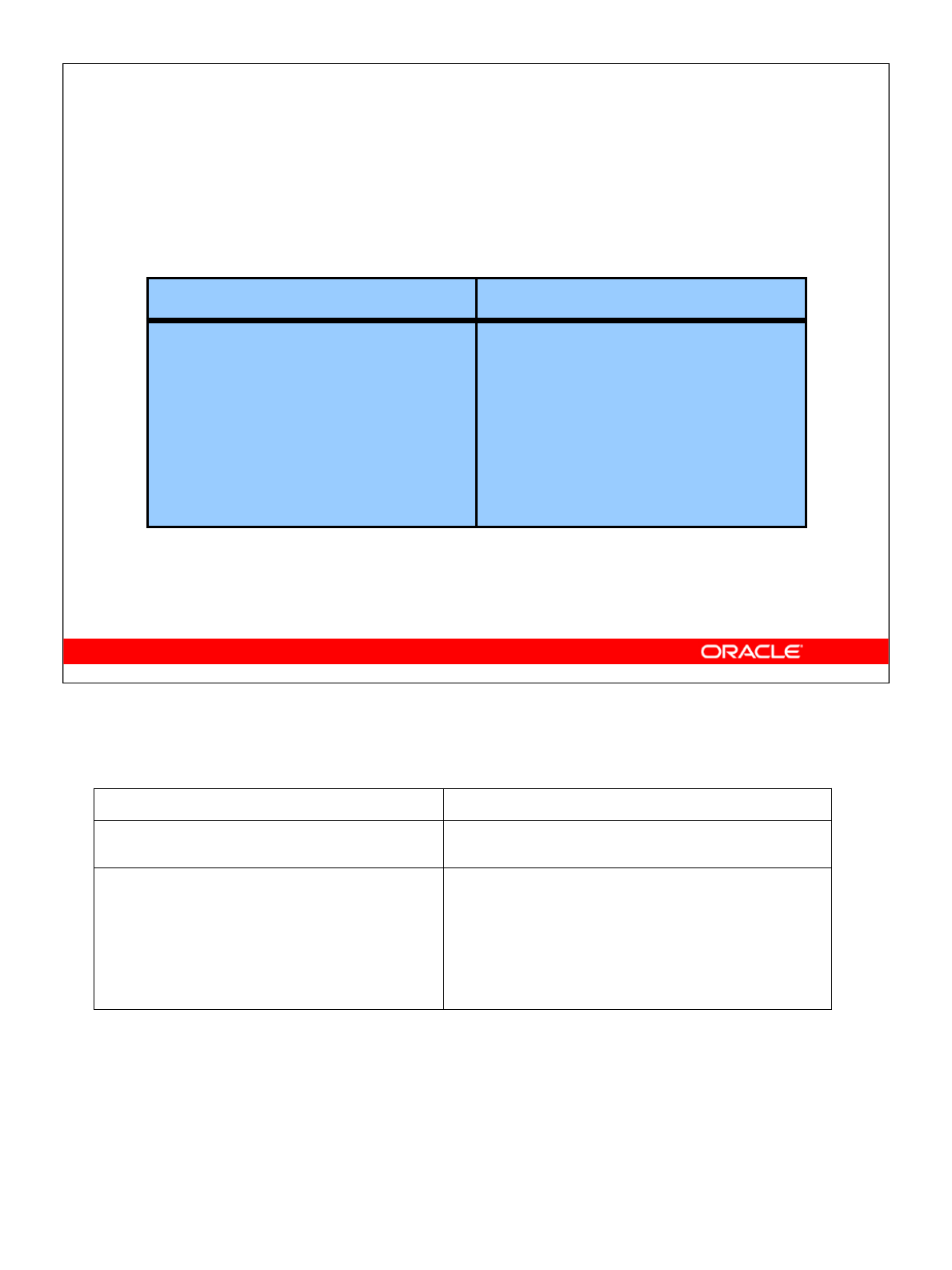
Oracle Database 10g: Develop PL/SQL Program Units 10-24
10-24 Copyright © 2004, Oracle. All rights reserved.
Comparison of Database Triggers and
Stored Procedures
Triggers
Defined with CREATE TRIGGER
Data dictionary contains source
code in USER_TRIGGERS.
Implicitly invoked by DML
COMMIT, SAVEPOINT, and
ROLLBACK are not allowed.
Procedures
Defined with CREATE PROCEDURE
Data dictionary contains source
code in USER_SOURCE.
Explicitly invoked
COMMIT, SAVEPOINT, and
ROLLBACK are allowed.
Comparison of Database Triggers and Stored Procedures
There are differences between database triggers and stored procedures:
Triggers are fully compiled when the CREATE TRIGGER command is issued and the
executable code is stored in the data dictionary.
Note: If errors occur during the compilation of a trigger, the trigger is still created.
Database Trigger Stored Procedure
Invoked implicitly Invoked explicitly
COMMIT, ROLLBACK, and
SAVEPOINT statements are not allowed
within the trigger body. It is possible to
commit or roll back indirectly by calling a
procedure, but it is not recommended
because of side effects to transactions.
COMMIT, ROLLBACK, and SAVEPOINT
statements are permitted within the procedure
body.
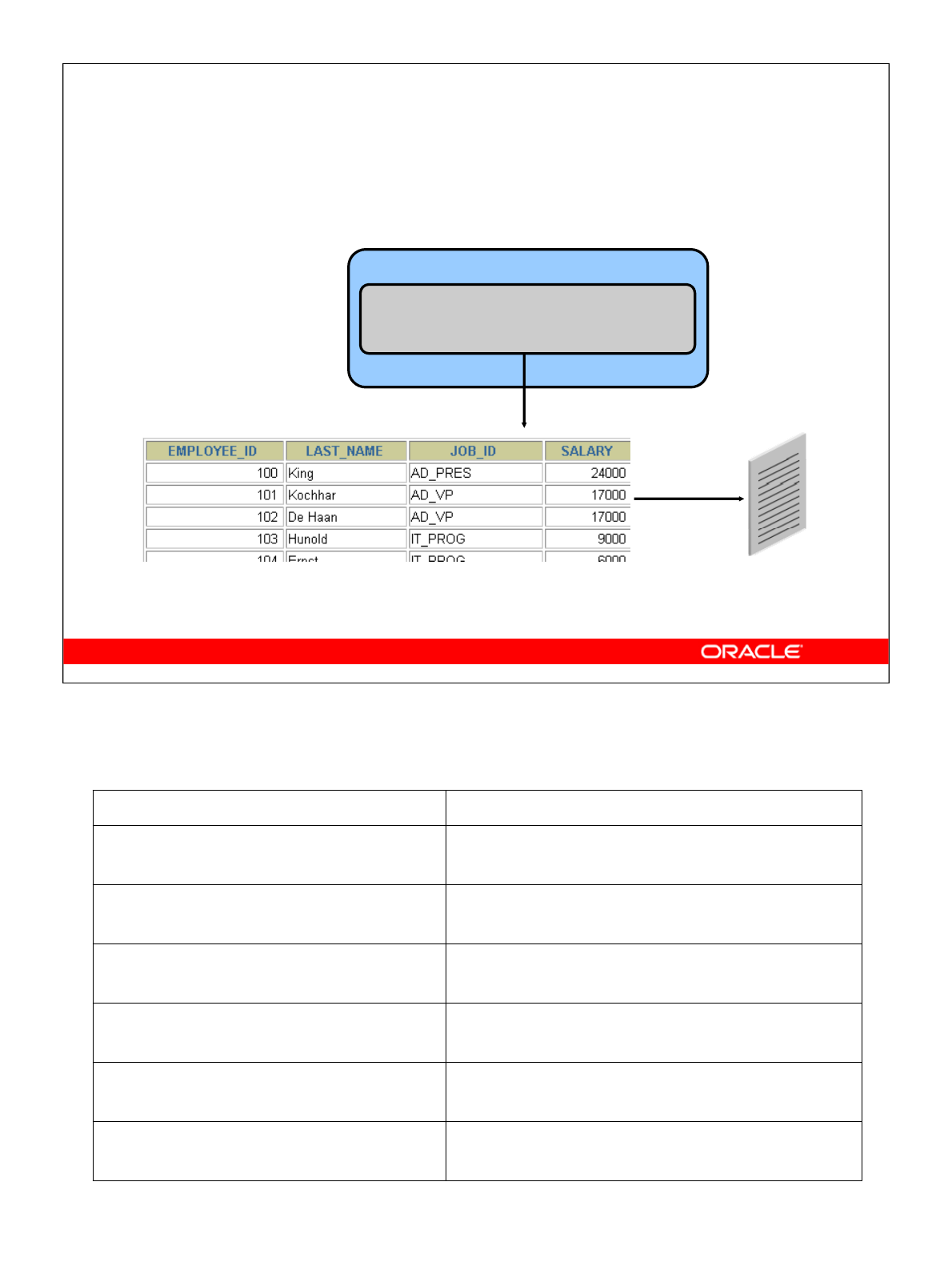
Oracle Database 10g: Develop PL/SQL Program Units 10-25
10-25 Copyright © 2004, Oracle. All rights reserved.
Comparison of Database Triggers
and Oracle Forms Triggers
INSERT INTO EMPLOYEES
. . .;
EMPLOYEES table CHECK_SAL trigger
BEFORE
INSERT
row
…
Comparison of Database Triggers and Oracle Forms Triggers
Database triggers are different from Forms Builder triggers.
Database Trigger Forms Builder Trigger
Executed by actions from any database tool
or application Executed only within a particular Forms Builder
application
Always triggered by a SQL DML, DDL, or a
certain database action Can be triggered by navigating from field to field, by
pressing a key, or by many other actions
Is distinguished as either a statement or row
trigger Is distinguished as a statement or row trigger
Upon failure, causes the triggering statement
to roll back Upon failure, causes the cursor to freeze and may
cause the entire transaction to roll back
Fires independently of, and in addition to,
Forms Builder triggers Fires independently of, and in addition to, database
triggers
Executes under the security domain of the
author of the trigger Executes under the security domain of the Forms
Builder user
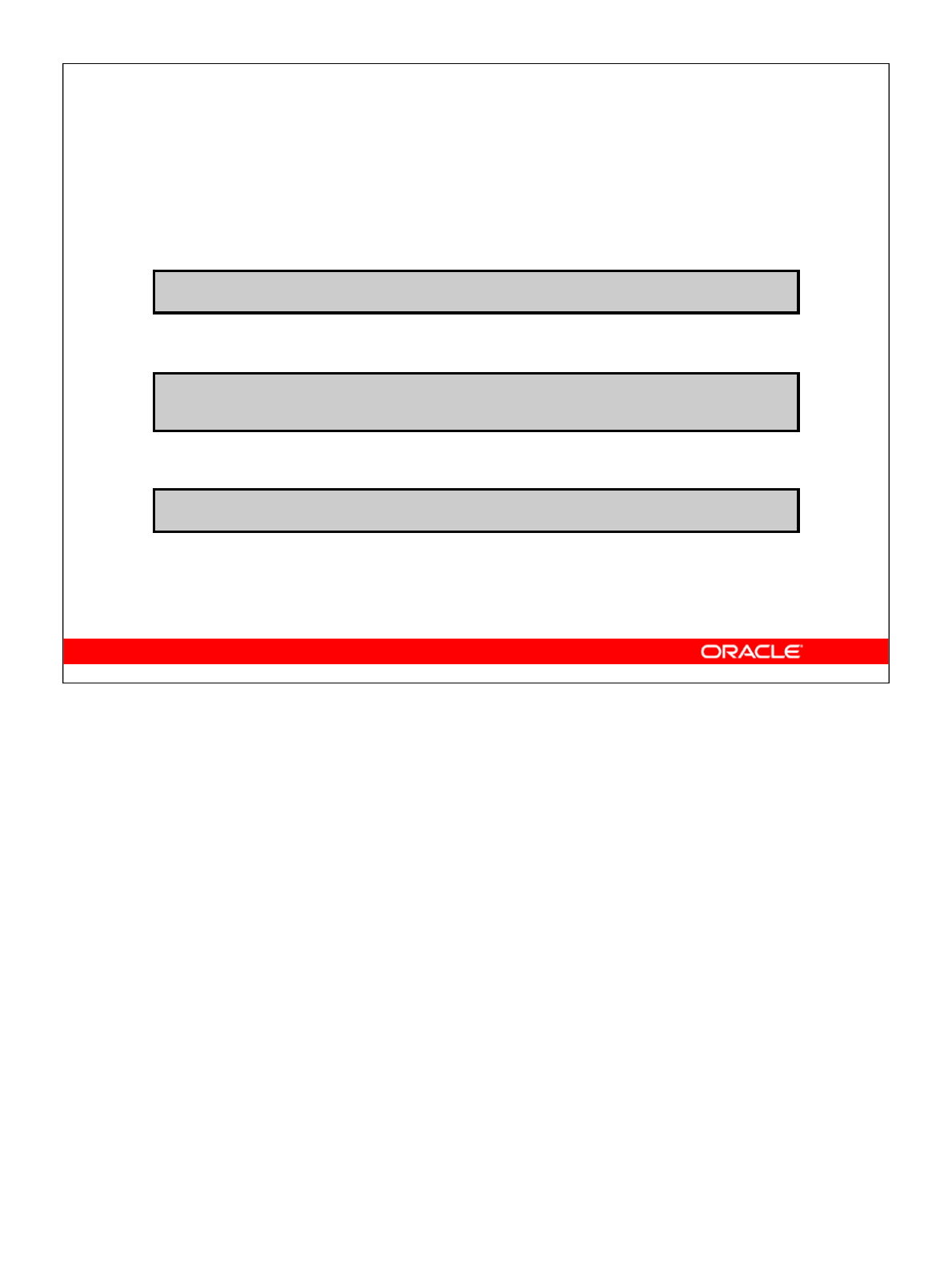
Oracle Database 10g: Develop PL/SQL Program Units 10-26
10-26 Copyright © 2004, Oracle. All rights reserved.
Managing Triggers
•Disable or reenable a database trigger:
•Disable or reenable all triggers for a table:
•Recompile a trigger for a table:
ALTER TRIGGER trigger_name DISABLE | ENABLE
ALTER TABLE table_name DISABLE | ENABLE
ALL TRIGGERS
ALTER TRIGGER trigger_name COMPILE
Managing Triggers
A trigger has two modes or states: ENABLED and DISABLED. When a trigger is first
created, it is enabled by default. The Oracle server checks integrity constraints for enabled
triggers and guarantees that triggers cannot compromise them. In addition, the Oracle
server provides read-consistent views for queries and constraints, manages the
dependencies, and provides a two-phase commit process if a trigger updates remote tables
in a distributed database.
Disabling a Trigger
• By using the ALTER TRIGGER syntax, or disable all triggers on a table by using the
ALTER TABLE syntax
• To improve performance or to avoid data integrity checks when loading massive
amounts of data with utilities such as SQL*Loader. Consider disabling a trigger
when it references a database object that is currently unavailable, due to a failed
network connection, disk crash, offline data file, or offline tablespace.
Recompiling a Trigger
• By using the ALTER TRIGGER command to explicitly recompile a trigger that is
invalid
• By issuing an ALTER TRIGGER statement with the COMPILE option, regardless of
whether it is valid or invalid

Oracle Database 10g: Develop PL/SQL Program Units 10-27
10-27 Copyright © 2004, Oracle. All rights reserved.
Removing Triggers
To remove a trigger from the database, use the DROP
TRIGGER statement:
Example:
Note: All triggers on a table are removed when the
table is removed.
DROP TRIGGER secure_emp;
DROP TRIGGER trigger_name;
Removing Triggers
When a trigger is no longer required, use a SQL statement in iSQL*Plus to remove it.

Oracle Database 10g: Develop PL/SQL Program Units 10-28
10-28 Copyright © 2004, Oracle. All rights reserved.
Testing Triggers
•Test each triggering data operation, as well as
nontriggering data operations.
•Test each case of the WHEN clause.
•Cause the trigger to fire directly from a basic data
operation, as well as indirectly from a procedure.
•Test the effect of the trigger on other triggers.
•Test the effect of other triggers on the trigger.
Testing Triggers
Testing code can be a time-consuming process. However, when testing triggers:
• Ensure that the trigger works properly by testing a number of cases separately:
- Test the most common success scenarios first.
- Test the most common failure conditions to see that they are properly managed.
• The more complex the trigger, the more detailed your testing is likely to be. For
example, if you have a row trigger with a WHEN clause specified, then you should
ensure that the trigger fires when the conditions are satisfied. Or, if you have
cascading triggers, you need to test the effect of one trigger on the other and ensure
that you end up with the desired results.
• Utilize the DBMS_OUTPUT package to debug triggers.

Oracle Database 10g: Develop PL/SQL Program Units 10-29
10-29 Copyright © 2004, Oracle. All rights reserved.
Summary
In this lesson, you should have learned how to:
•Create database triggers that are invoked by DML
operations
•Create statement and row trigger types
•Use database trigger-firing rules
•Enable, disable, and manage database triggers
•Develop a strategy for testing triggers
•Remove database triggers
Summary
This lesson covered creating database triggers that execute before, after, or instead of a
specified DML operation. Triggers are associated with database tables or views. The
BEFORE and AFTER timings apply to DML operations on tables. The INSTEAD OF
trigger is used as a way to replace DML operations on a view with appropriate DML
statements against other tables in the database.
Triggers are enabled by default but can be disabled to suppress their operation until
enabled again. If business rules change, then triggers can be removed or altered as
required.

Oracle Database 10g: Develop PL/SQL Program Units 10-30
10-30 Copyright © 2004, Oracle. All rights reserved.
Practice 10: Overview
This practice covers the following topics:
•Creating row triggers
•Creating a statement trigger
•Calling procedures from a trigger
Practice 10: Overview
You create statement and row triggers in this practice. You create procedures that will be
invoked from the triggers.

Oracle Database 10g: Develop PL/SQL Program Units 10-31
Practice 10
1. The rows in the JOBS table store a minimum and maximum salary allowed for
different JOB_ID values. You are asked to write code to ensure that employees’
salaries fall in the range allowed for their job type, for insert and update operations.
a. Write a procedure called CHECK_SALARY that accepts two parameters, one
for an employee’s job ID string and the other for the salary. The procedure uses
the job ID to determine the minimum and maximum salary for the specified
job. If the salary parameter does not fall within the salary range of the job,
inclusive of the minimum and maximum, then it should raise an application
exception, with the message “Invalid salary <sal>. Salaries
for job <jobid> must be between <min> and <max>”.
Replace the various items in the message with values supplied by parameters
and variables populated by queries.
b. Create a trigger called CHECK_SALARY_TRG on the EMPLOYEES table that
fires before an INSERT or UPDATE operation on each row. The trigger must
call the CHECK_SALARY procedure to carry out the business logic. The trigger
should pass the new job ID and salary to the procedure parameters.
2. Test the CHECK_SAL_TRG using the following cases:
a. Using your EMP_PKG.ADD_EMPLOYEE procedure, add employee Eleanor
Beh to department 30. What happens and why?
b. Update the salary of employee 115 to $2,000. In a separate update operation,
change the employee job ID to HR_REP. What happens in each case?
c. Update the salary of employee 115 to $2,800. What happens?
3. Update the CHECK_SALARY_TRG trigger to fire only when the job ID or salary
values have actually changed.
a. Implement the business rule using a WHEN clause to check if the JOB_ID or
SALARY values have changed.
Note: Make sure that the condition handles the NULL in the
OLD.column_name values if an INSERT operation is performed; otherwise,
an insert operation will fail.
b. Test the trigger by executing the EMP_PKG.ADD_EMPLOYEE procedure with
the following parameter values: first_name='Eleanor', last
name='Beh', email='EBEH', job='IT_PROG', sal=5000.
c. Update employees with the IT_PROG job by incrementing their salary by
$2,000. What happens?
d. Update the salary to $9,000 for Eleanor Beh.
Hint: Use an UPDATE statement with a subquery in the WHERE clause. What
happens?
e. Change the job of Eleanor Beh to ST_MAN using another UPDATE
statement with a subquery. What happens?
4. You are asked to prevent employees from being deleted during business hours.
a. Write a statement trigger called DELETE_EMP_TRG on the EMPLOYEES table
to prevent rows from being deleted during weekday business hours, which are
from 9:00 a.m. to 6:00 p.m.
b. Attempt to delete employees with JOB_ID of SA_REP who are not assigned
to a department.
Hint: This is employee Grant with ID 178.

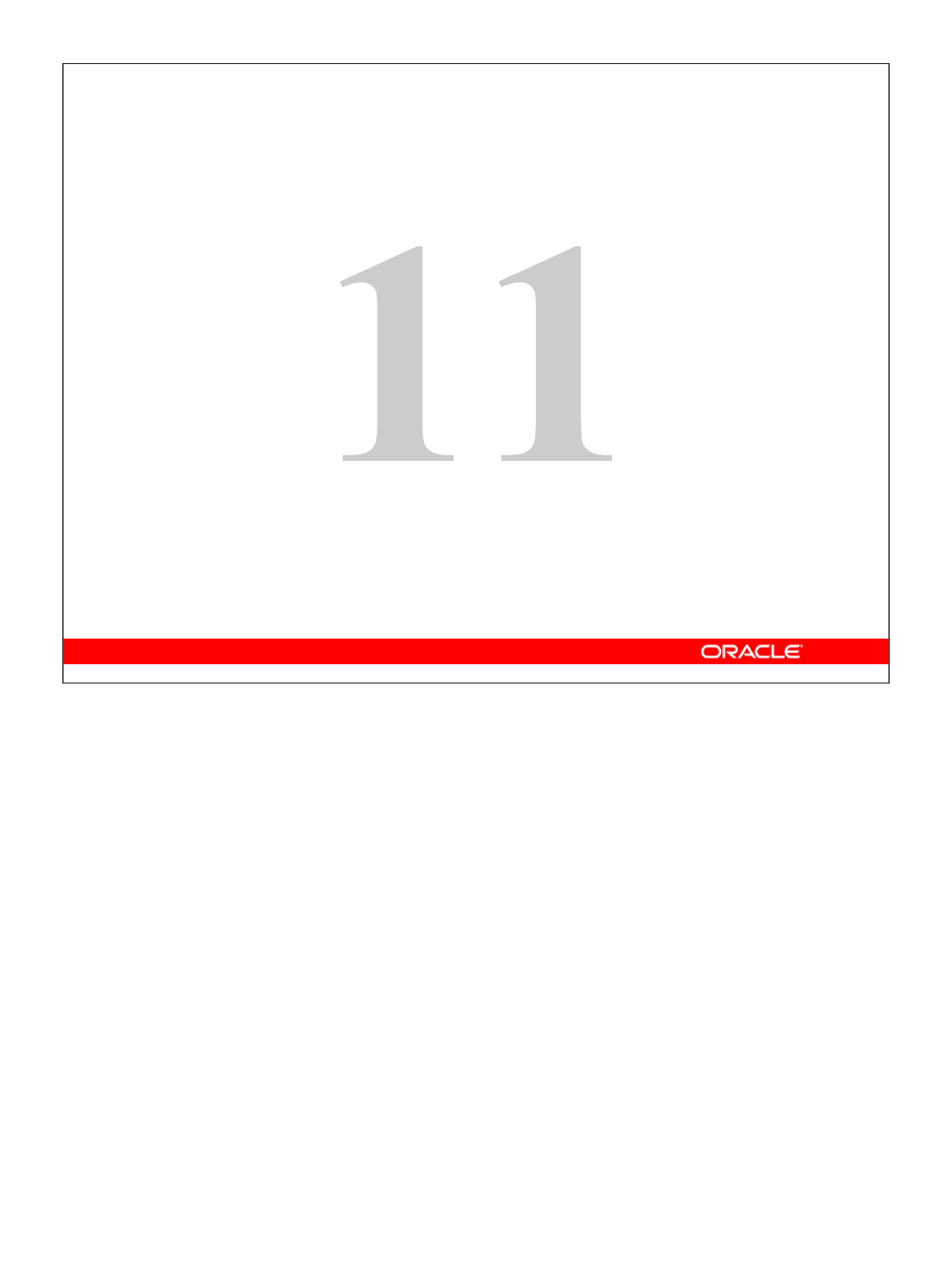
Copyright © 2004, Oracle. All rights reserved.
Applications for Triggers

Oracle Database 10g: Develop PL/SQL Program Units 11-2
11-2 Copyright © 2004, Oracle. All rights reserved.
Objectives
After completing this lesson, you should be able to do
the following:
•Create additional database triggers
•Explain the rules governing triggers
•Implement triggers
Lesson Aim
In this lesson, you learn how to create more database triggers and learn the rules governing
triggers. You also learn about the many applications of triggers.

Oracle Database 10g: Develop PL/SQL Program Units 11-3
11-3 Copyright © 2004, Oracle. All rights reserved.
Creating Database Triggers
•Triggering a user event:
–CREATE, ALTER, or DROP
–Logging on or off
•Triggering database or system event:
–Shutting down or starting up the database
–A specific error (or any error) being raised
Creating Database Triggers
Before coding the trigger body, decide on the components of the trigger.
Triggers on system events can be defined at the database or schema level. For example, a
database shutdown trigger is defined at the database level. Triggers on data definition
language (DDL) statements, or a user logging on or off, can also be defined at either the
database level or schema level. Triggers on DML statements are defined on a specific
table or a view.
A trigger defined at the database level fires for all users, and a trigger defined at the
schema or table level fires only when the triggering event involves that schema or table.
Triggering events that can cause a trigger to fire:
• A data definition statement on an object in the database or schema
• A specific user (or any user) logging on or off
• A database shutdown or startup
• Any error that occurs

Oracle Database 10g: Develop PL/SQL Program Units 11-4
11-4 Copyright © 2004, Oracle. All rights reserved.
Creating Triggers on DDL Statements
Syntax:
CREATE [OR REPLACE] TRIGGER trigger_name
Timing
[ddl_event1 [OR ddl_event2 OR ...]]
ON {DATABASE|SCHEMA}
trigger_body
Creating Triggers on DDL Statements
The trigger body represents a complete PL/SQL block.
You can create triggers for these events on DATABASE or SCHEMA. You also specify
BEFORE or AFTER for the timing of the trigger.
DDL triggers fire only if the object being created is a cluster, function, index, package,
procedure, role, sequence, synonym, table, tablespace, trigger, type, view, or user.
DDL_Event Possible Values
CREATE Causes the Oracle server to fire the trigger whenever a CREATE statement
adds a new database object to the dictionary
ALTER Causes the Oracle server to fire the trigger whenever an ALTER statement
modifies a database object in the data dictionary
DROP Causes the Oracle server to fire the trigger whenever a DROP statement
removes a database object in the data dictionary
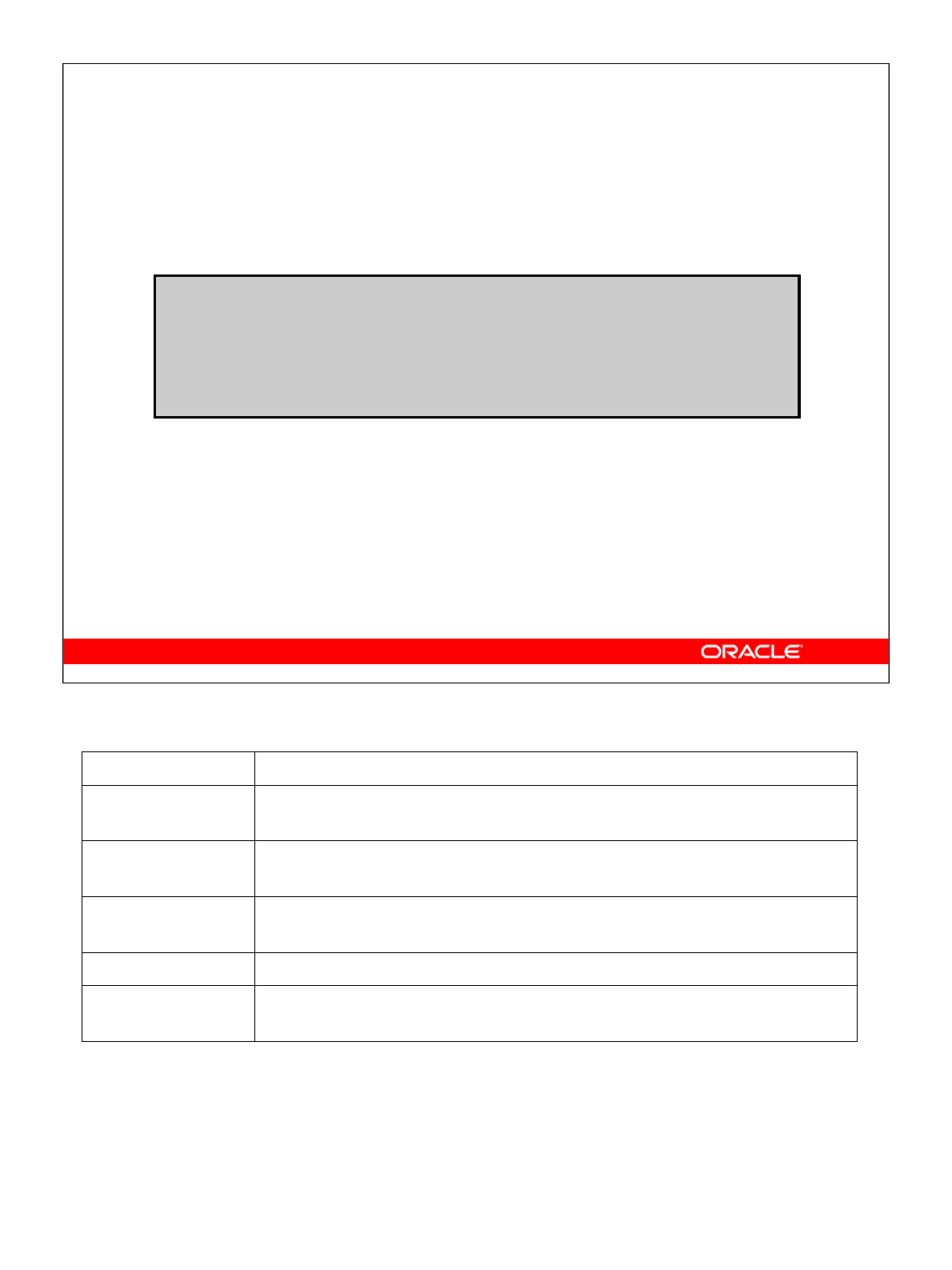
Oracle Database 10g: Develop PL/SQL Program Units 11-5
11-5 Copyright © 2004, Oracle. All rights reserved.
Creating Triggers on System Events
Syntax:
CREATE [OR REPLACE] TRIGGER trigger_name
timing
[database_event1 [OR database_event2 OR ...]]
ON {DATABASE|SCHEMA}
trigger_body
Create Trigger Syntax
You can create triggers for these events on DATABASE or SCHEMA, except SHUTDOWN
and STARTUP, which apply only to DATABASE.
Database_event Possible Values
AFTER
SERVERERROR
Causes the Oracle server to fire the trigger whenever a server error message is
logged
AFTER LOGON Causes the Oracle server to fire the trigger whenever a user logs on to the
database
BEFORE LOGOFF Causes the Oracle server to fire the trigger whenever a user logs off the
database
AFTER STARTUP Causes the Oracle server to fire the trigger whenever the database is opened
BEFORE
SHUTDOWN
Causes the Oracle server to fire the trigger whenever the database is shut down
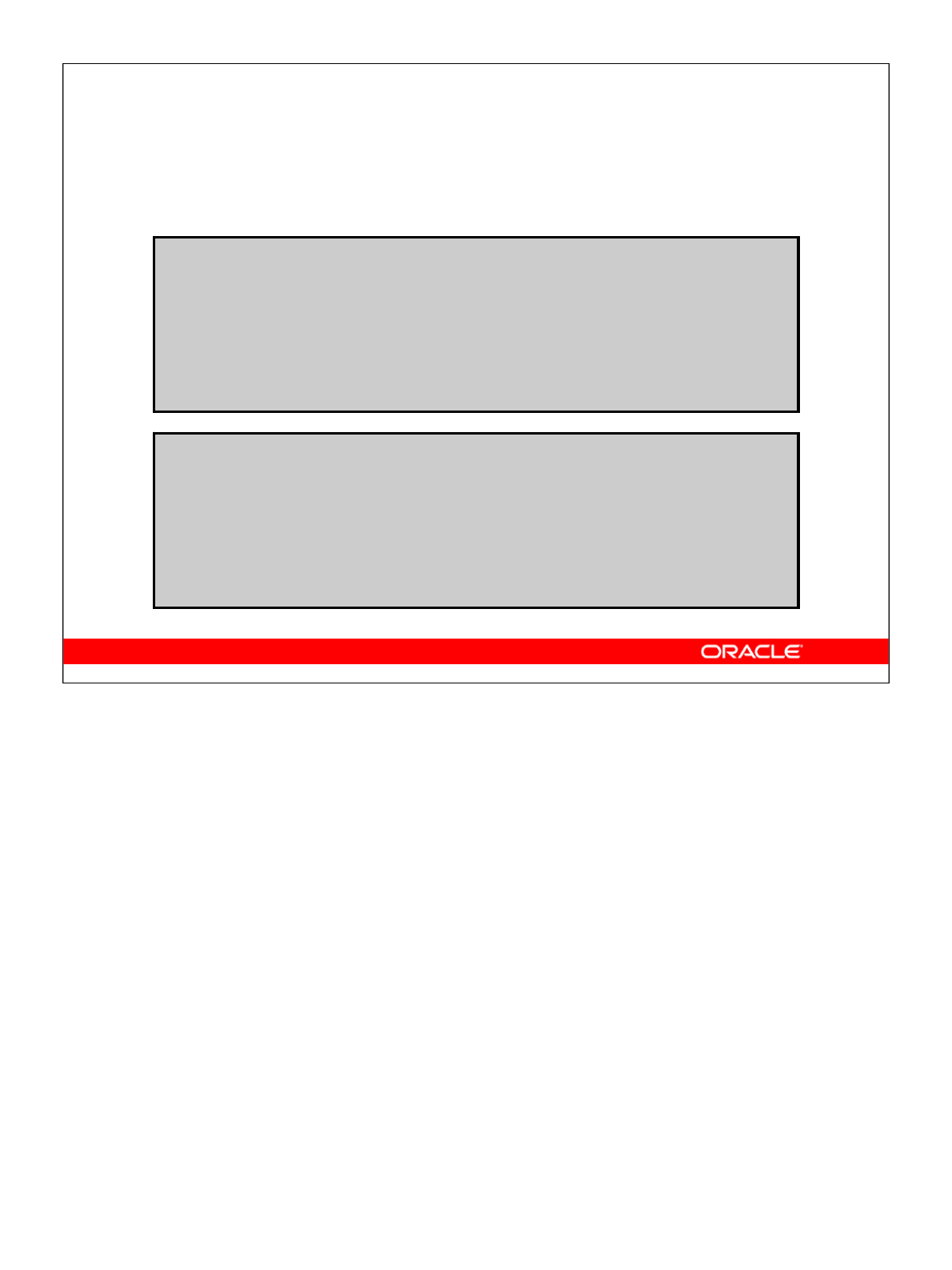
Oracle Database 10g: Develop PL/SQL Program Units 11-6
11-6 Copyright © 2004, Oracle. All rights reserved.
LOGON and LOGOFF Triggers: Example
CREATE OR REPLACE TRIGGER logon_trig
AFTER LOGON ON SCHEMA
BEGIN
INSERT INTO log_trig_table(user_id,log_date,action)
VALUES (USER, SYSDATE, 'Logging on');
END;
/
CREATE OR REPLACE TRIGGER logoff_trig
BEFORE LOGOFF ON SCHEMA
BEGIN
INSERT INTO log_trig_table(user_id,log_date,action)
VALUES (USER, SYSDATE, 'Logging off');
END;
/
LOGON and LOGOFF Triggers: Example
You can create these triggers to monitor how often you log on and off, or you may want to
write a report that monitors the length of time for which you are logged on. When you
specify ON SCHEMA, the trigger fires for the specific user. If you specify ON DATABASE,
the trigger fires for all users.
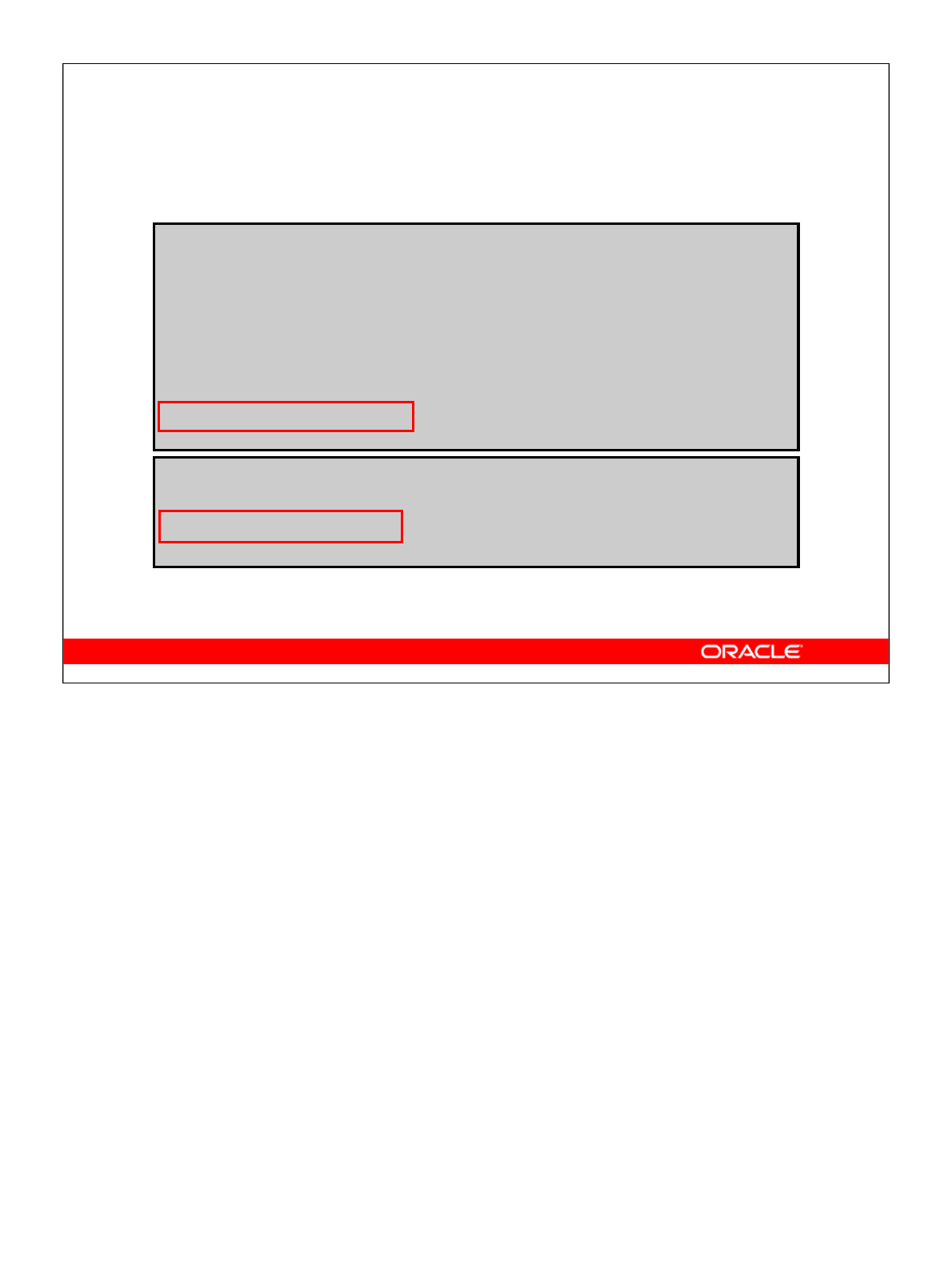
Oracle Database 10g: Develop PL/SQL Program Units 11-7
11-7 Copyright © 2004, Oracle. All rights reserved.
CALL Statements
Note: There is no semicolon at the end of the CALL
statement.
CREATE OR REPLACE TRIGGER log_employee
BEFORE INSERT ON EMPLOYEES
CALL log_execution
/
CREATE [OR REPLACE] TRIGGER trigger_name
timing
event1 [OR event2 OR event3]
ON table_name
[REFERENCING OLD AS old | NEW AS new]
[FOR EACH ROW]
[WHEN condition]
CALL procedure_name
/
CALL Statements
A CALL statement enables you to call a stored procedure, rather than code the PL/SQL
body in the trigger itself. The procedure can be implemented in PL/SQL, C, or Java.
The call can reference the trigger attributes :NEW and :OLD as parameters, as in the
following example:
CREATE TRIGGER salary_check
BEFORE UPDATE OF salary, job_id ON employees
FOR EACH ROW
WHEN (NEW.job_id <> 'AD_PRES')
CALL check_salary(:NEW.job_id, :NEW.salary)
/
Note: There is no semicolon at the end of the CALL statement.
In the preceding example, the trigger calls a check_salary procedure. The procedure
compares the new salary with the salary range for the new job ID from the JOBS table.
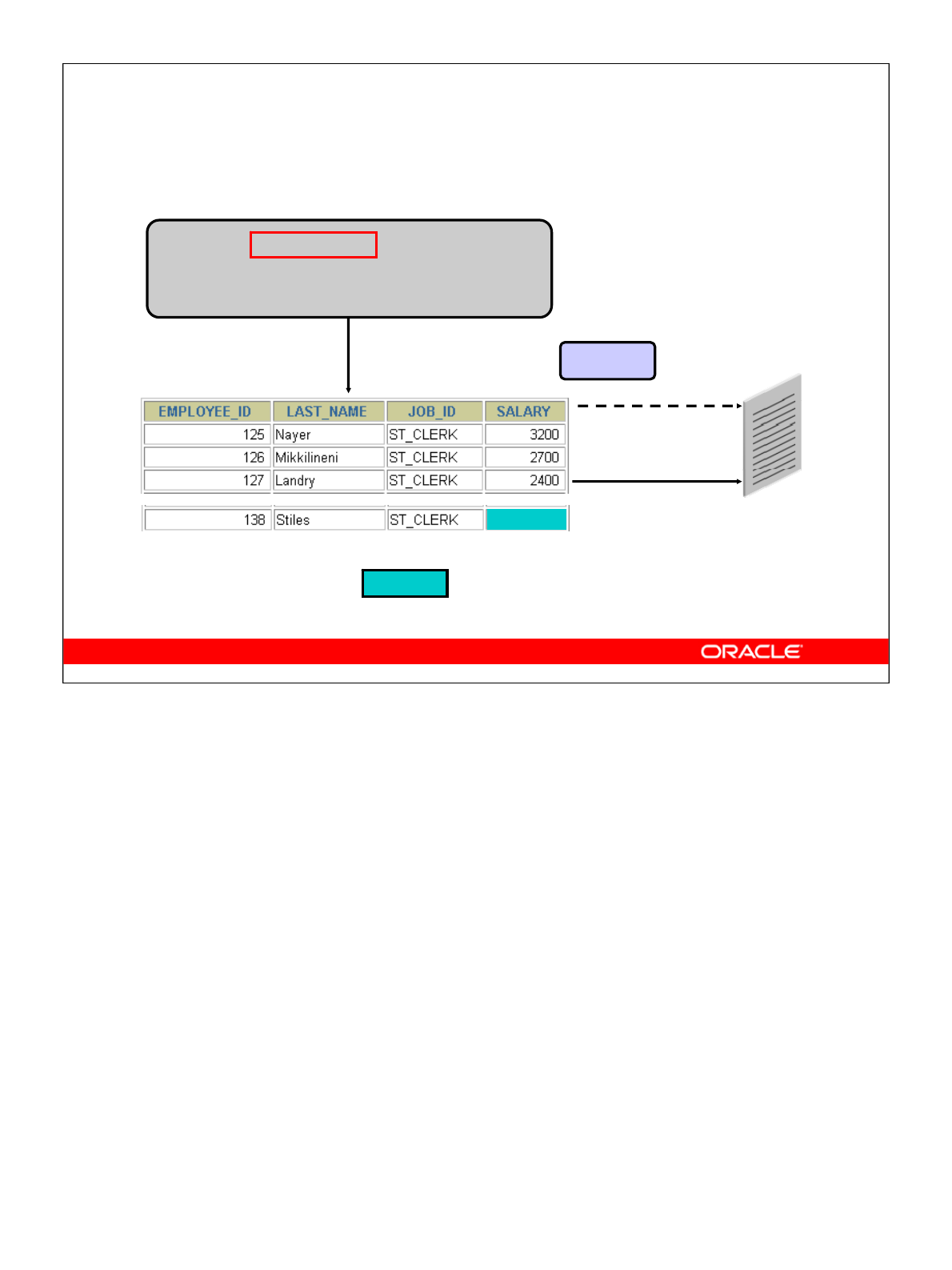
Oracle Database 10g: Develop PL/SQL Program Units 11-8
11-8 Copyright © 2004, Oracle. All rights reserved.
Trigger event
UPDATE employees
SET salary = 3400
WHERE last_name = 'Stiles';
EMPLOYEES table Failure
Triggered table/
mutating table
BEFORE UPDATE row
CHECK_SALARY
trigger
Reading Data from a Mutating Table
…
…3400
Rules Governing Triggers
Reading and writing data using triggers is subject to certain rules. The restrictions apply
only to row triggers, unless a statement trigger is fired as a result of ON DELETE
CASCADE.
Mutating Table
A mutating table is a table that is currently being modified by an UPDATE, DELETE, or
INSERT statement, or a table that might need to be updated by the effects of a declarative
DELETE CASCADE referential integrity action. For STATEMENT triggers, a table is not
considered a mutating table.
The triggered table itself is a mutating table, as well as any table referencing it with the
FOREIGN KEY constraint. This restriction prevents a row trigger from seeing an
inconsistent set of data.

Oracle Database 10g: Develop PL/SQL Program Units 11-9
11-9 Copyright © 2004, Oracle. All rights reserved.
Mutating Table: Example
CREATE OR REPLACE TRIGGER check_salary
BEFORE INSERT OR UPDATE OF salary, job_id
ON employees
FOR EACH ROW
WHEN (NEW.job_id <> 'AD_PRES')
DECLARE
minsalary employees.salary%TYPE;
maxsalary employees.salary%TYPE;
BEGIN
SELECT MIN(salary), MAX(salary)
INTO minsalary, maxsalary
FROM employees
WHERE job_id = :NEW.job_id;
IF :NEW.salary < minsalary OR
:NEW.salary > maxsalary THEN
RAISE_APPLICATION_ERROR(-20505,'Out of range');
END IF;
END;
/
Mutating Table: Example
The CHECK_SALARY trigger in the example attempts to guarantee that whenever a new
employee is added to the EMPLOYEES table or whenever an existing employee’s salary or
job ID is changed, the employee’s salary falls within the established salary range for the
employee’s job.
When an employee record is updated, the CHECK_SALARY trigger is fired for each row
that is updated. The trigger code queries the same table that is being updated. Therefore, it
is said that the EMPLOYEES table is a mutating table.

Oracle Database 10g: Develop PL/SQL Program Units 11-10
11-10 Copyright © 2004, Oracle. All rights reserved.
Mutating Table: Example
UPDATE employees
SET salary = 3400
WHERE last_name = 'Stiles';
Mutating Table: Example (continued)
In the example, the trigger code tries to read or select data from a mutating table.
If you restrict the salary within a range between the minimum existing value and the
maximum existing value, then you get a run-time error. The EMPLOYEES table is
mutating, or in a state of change; therefore, the trigger cannot read from it.
Remember that functions can also cause a mutating table error when they are invoked in a
DML statement.
Possible Solutions
Possible solutions to this mutating table problem include the following:
• Store the summary data (the minimum salaries and the maximum salaries) in another
summary table, which is kept up-to-date with other DML triggers.
• Store the summary data in a PL/SQL package, and access the data from the package.
This can be done in a BEFORE statement trigger.
Depending on the nature of the problem, a solution can become more convoluted and
difficult to solve. In this case, consider implementing the rules in the application or middle
tier and avoid using database triggers to perform overly complex business rules.

Oracle Database 10g: Develop PL/SQL Program Units 11-11
11-11 Copyright © 2004, Oracle. All rights reserved.
Benefits of Database Triggers
•Improved data security:
–Provide enhanced and complex security checks
–Provide enhanced and complex auditing
•Improved data integrity:
–Enforce dynamic data integrity constraints
–Enforce complex referential integrity constraints
–Ensure that related operations are performed
together implicitly
Benefits of Database Triggers
You can use database triggers:
• As alternatives to features provided by the Oracle server
• If your requirements are more complex or more simple than those provided by the
Oracle server
• If your requirements are not provided by the Oracle server at all

Oracle Database 10g: Develop PL/SQL Program Units 11-12
11-12 Copyright © 2004, Oracle. All rights reserved.
Managing Triggers
The following system privileges are required to
manage triggers:
•CREATE/ALTER/DROP (ANY) TRIGGER privilege:
enables you to create a trigger in any schema
•ADMINISTER DATABASE TRIGGER privilege:
enables you to create a trigger on DATABASE
•EXECUTE privilege (if your trigger refers to any
objects that are not in your schema)
Note: Statements in the trigger body use the privileges
of the trigger owner, not the privileges of the user
executing the operation that fires the trigger.
Managing Triggers
To create a trigger in your schema, you need the CREATE TRIGGER system privilege,
and you must either own the table specified in the triggering statement, have the ALTER
privilege for the table in the triggering statement, or have the ALTER ANY TABLE system
privilege. You can alter or drop your triggers without any further privileges being required.
If the ANY keyword is used, then you can create, alter, or drop your own triggers and those
in another schema and can be associated with any user’s table.
You do not need any privileges to invoke a trigger in your schema. A trigger is invoked by
DML statements that you issue. But if your trigger refers to any objects that are not in your
schema, the user creating the trigger must have the EXECUTE privilege on the referenced
procedures, functions, or packages, and not through roles. As with stored procedures,
statements in the trigger body use the privileges of the trigger owner, not the privileges of
the user executing the operation that fires the trigger.
To create a trigger on DATABASE, you must have the ADMINISTER DATABASE
TRIGGER privilege. If this privilege is later revoked, then you can drop the trigger but you
cannot alter it.
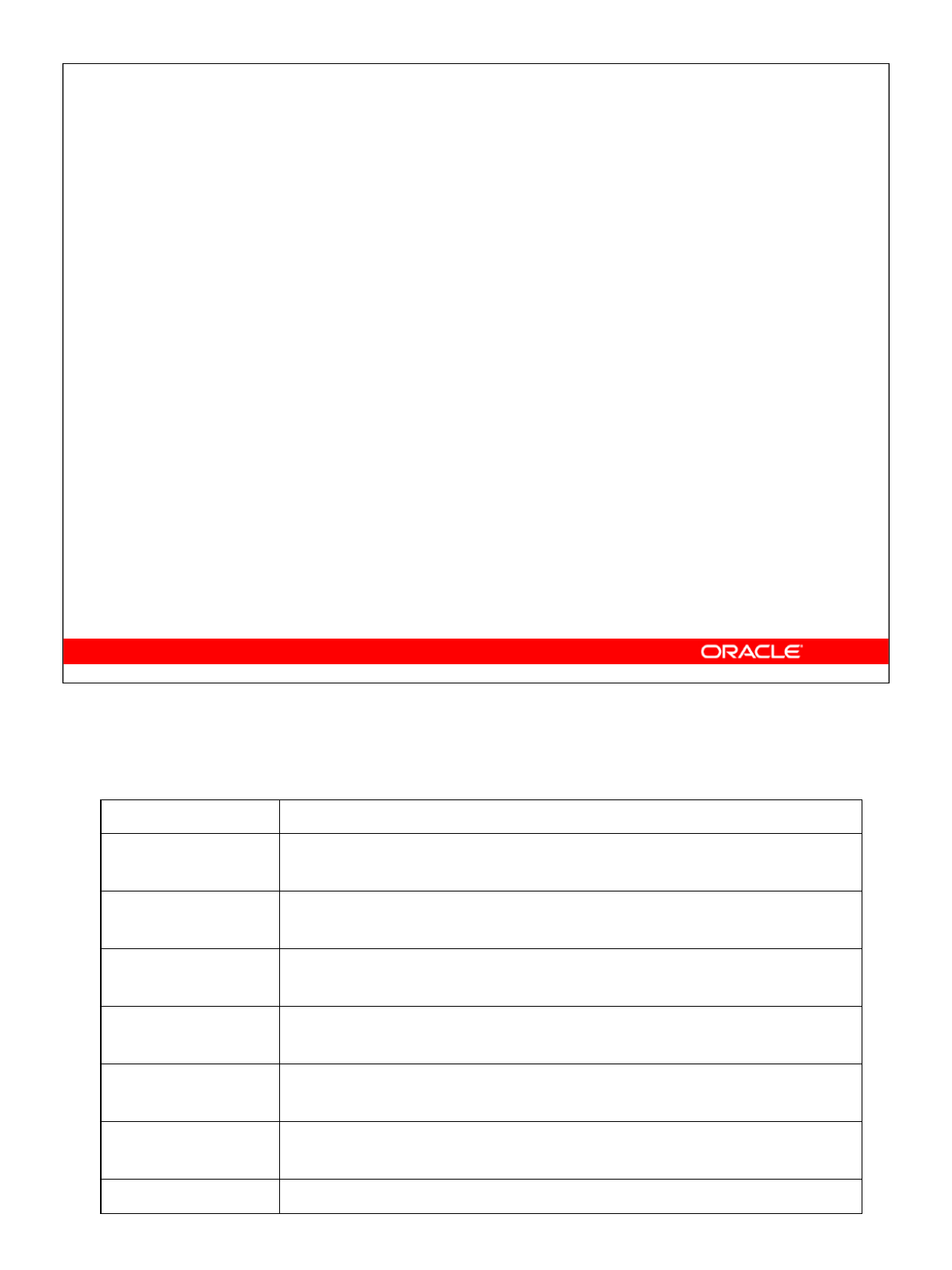
Oracle Database 10g: Develop PL/SQL Program Units 11-13
11-13 Copyright © 2004, Oracle. All rights reserved.
Business Application Scenarios for
Implementing Triggers
You can use triggers for:
•Security
•Auditing
•Data integrity
•Referential integrity
•Table replication
•Computing derived data automatically
•Event logging
Note: Appendix C covers each of these examples in
more detail.
Business Application Scenarios for Implementing Triggers
Develop database triggers in order to enhance features that cannot otherwise be
implemented by the Oracle server or as alternatives to those provided by the Oracle server.
Feature Enhancement
Security The Oracle server allows table access to users or roles. Triggers allow
table access according to data values.
Auditing The Oracle server tracks data operations on tables. Triggers track values
for data operations on tables.
Data integrity The Oracle server enforces integrity constraints. Triggers implement
complex integrity rules.
Referential integrity The Oracle server enforces standard referential integrity rules. Triggers
implement nonstandard functionality.
Table replication The Oracle server copies tables asynchronously into snapshots. Triggers
copy tables synchronously into replicas.
Derived data The Oracle server computes derived data values manually. Triggers
compute derived data values automatically.
Event logging The Oracle server logs events explicitly. Triggers log events transparently.

Oracle Database 10g: Develop PL/SQL Program Units 11-14
11-14 Copyright © 2004, Oracle. All rights reserved.
Viewing Trigger Information
You can view the following trigger information:
•USER_OBJECTS data dictionary view: object
information
•USER_TRIGGERS data dictionary view: text of the
trigger
•USER_ERRORS data dictionary view: PL/SQL syntax
errors (compilation errors) of the trigger
Viewing Trigger Information
The slide shows the data dictionary views that you can access to get information regarding
the triggers.
The USER_OBJECTS view contains the name and status of the trigger and the date and
time when the trigger was created.
The USER_ERRORS view contains the details of the compilation errors that occurred
while a trigger was compiling. The contents of these views are similar to those for
subprograms.
The USER_TRIGGERS view contains details such as name, type, triggering event, the
table on which the trigger is created, and the body of the trigger.
The SELECT Username FROM USER_USERS; statement gives the name of the
owner of the trigger, not the name of the user who is updating the table.
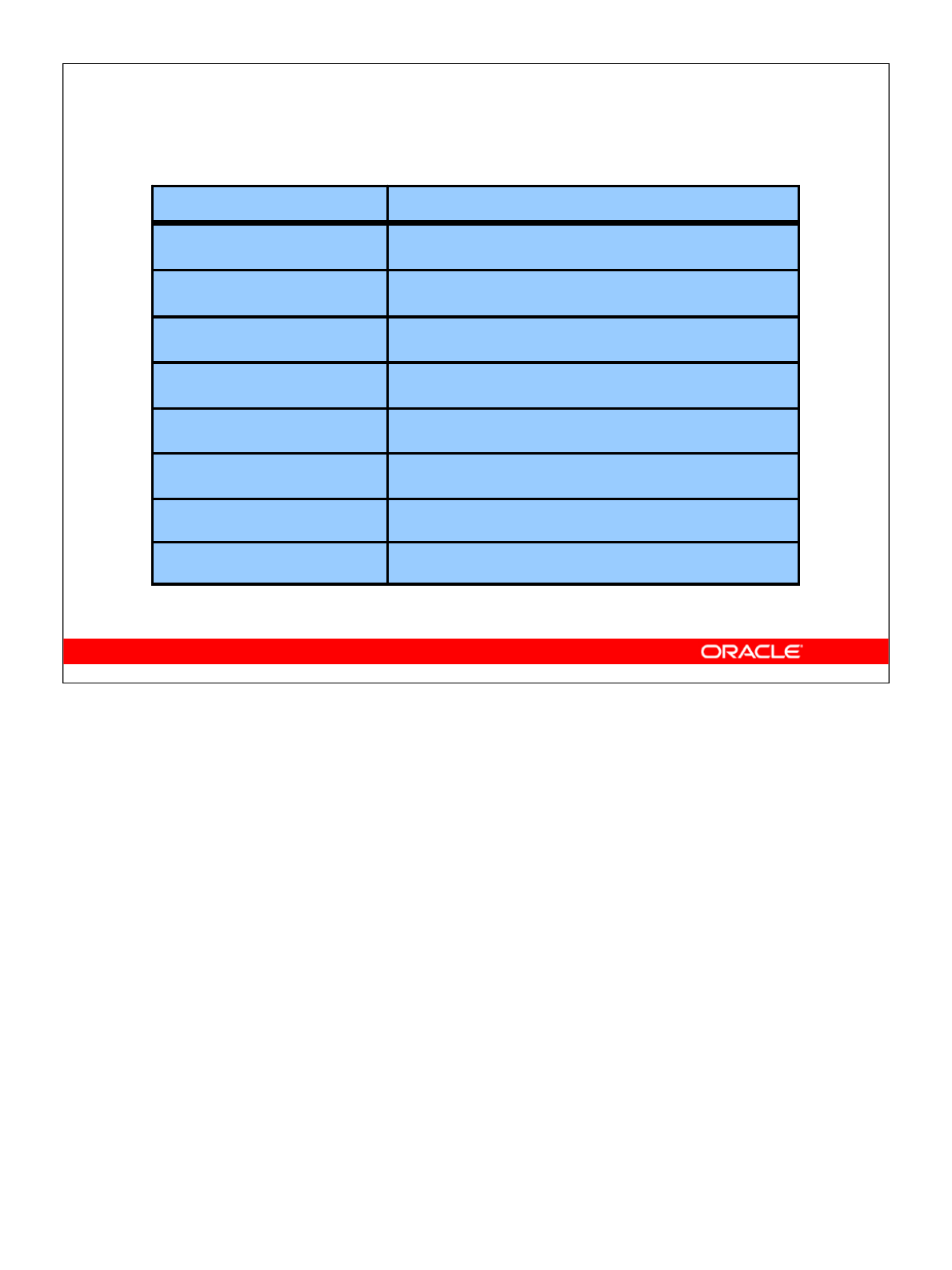
Oracle Database 10g: Develop PL/SQL Program Units 11-15
11-15 Copyright © 2004, Oracle. All rights reserved.
Column
TRIGGER_NAME
TRIGGER_TYPE
TRIGGERING_EVENT
TABLE_NAME
REFERENCING_NAMES
WHEN_CLAUSE
STATUS
TRIGGER_BODY
Column Description
Name of the trigger
The type is BEFORE, AFTER, INSTEAD OF
The DML operation firing the trigger
Name of the database table
Name used for :OLD and :NEW
The when_clause used
The status of the trigger
The action to take
Using USER_TRIGGERS
Abridged column list
*
Using USER_TRIGGERS
If the source file is unavailable, then you can use iSQL*Plus to regenerate it from
USER_TRIGGERS. You can also examine the ALL_TRIGGERS and DBA_TRIGGERS
views, each of which contains the additional column OWNER, for the owner of the object.

Oracle Database 10g: Develop PL/SQL Program Units 11-16
11-16 Copyright © 2004, Oracle. All rights reserved.
SELECT trigger_name, trigger_type, triggering_event,
table_name, referencing_names,
status, trigger_body
FROM user_triggers
WHERE trigger_name = 'RESTRICT_SALARY';
Listing the Code of Triggers
Example
Use the USER_TRIGGERS data dictionary view to display information about the
RESTRICT_SALARY trigger.

Oracle Database 10g: Develop PL/SQL Program Units 11-17
11-17 Copyright © 2004, Oracle. All rights reserved.
Summary
In this lesson, you should have learned how to:
•Use advanced database triggers
•List mutating and constraining rules for triggers
•Describe the real-world application of triggers
•Manage triggers
•View trigger information

Oracle Database 10g: Develop PL/SQL Program Units 11-18
11-18 Copyright © 2004, Oracle. All rights reserved.
Practice 11: Overview
This practice covers the following topics:
•Creating advanced triggers to manage data
integrity rules
•Creating triggers that cause a mutating table
exception
•Creating triggers that use package state to solve
the mutating table problem
Practice 11: Overview
In this practice, you implement a simple business rule for ensuring data integrity of
employees’ salaries with respect to the valid salary range for their job. You create a trigger
for this rule.
During this process, your new triggers cause a cascading effect with triggers created in the
previous lesson practice. The cascading effect results in a mutating table exception on the
JOBS table. You then create a PL/SQL package and additional triggers to solve the
mutating table issue.

Oracle Database 10g: Develop PL/SQL Program Units 11-19
Practice 11
1. Employees receive an automatic increase in salary if the minimum salary for a job is
increased to a value larger than their current salary. Implement this requirement
through a package procedure called by a trigger on the JOBS table. When you
attempt to update minimum salary in the JOBS table and try to update the employees
salary, the CHECK_SALARY trigger attempts to read the JOBS table, which is
subject to change, and you get a mutating table exception that is resolved by creating
a new package and additional triggers.
a. Update your EMP_PKG package (from Practice 7) by adding a procedure called
SET_SALARY that updates the employees’ salaries. The procedure accepts two
parameters: the job ID for those salaries that may have to be updated, and the
new minimum salary for the job ID. The procedure sets all the employee
salaries to the minimum for their job if their current salary is less than the new
minimum value.
b. Create a row trigger named UPD_MINSALARY_TRG on the JOBS table that
invokes the procedure EMP_PKG.SET_SALARY, when the minimum salary in
the JOBS table is updated for a specified job ID.
c. Write a query to display the employee ID, last name, job ID, current salary, and
minimum salary for employees who are programmers, that is, their JOB_ID is
'IT_PROG'. Then update the minimum salary in the JOBS table to increase it
by $1,000. What happens?
2. To resolve the mutating table issue, you create a JOBS_PKG to maintain in memory
a copy of the rows in the JOBS table. Then the CHECK_SALARY procedure is
modified to use the package data rather than issue a query on a table that is mutating
to avoid the exception. However, a BEFORE INSERT OR UPDATE statement
trigger must be created on the EMPLOYEES table to initialize the JOBS_PKG
package state before the CHECK_SALARY row trigger is fired.
a. Create a new package called JOBS_PKG with the following specification:
PROCEDURE initialize;
FUNCTION get_minsalary(jobid VARCHAR2) RETURN NUMBER;
FUNCTION get_maxsalary(jobid VARCHAR2) RETURN NUMBER;
PROCEDURE set_minsalary(jobid VARCHAR2,min_salary NUMBER);
PROCEDURE set_maxsalary(jobid VARCHAR2,max_salary NUMBER);
b. Implement the body of the JOBS_PKG, where:
You declare a private PL/SQL index-by table called jobs_tabtype that is
indexed by a string type based on the JOBS.JOB_ID%TYPE.
You declare a private variable called jobstab based on the
jobs_tabtype.
The INITIALIZE procedure reads the rows in the JOBS table by using a
cursor loop, and uses the JOB_ID value for the jobstab index that is
assigned its corresponding row. The GET_MINSALARY function uses a
jobid parameter as an index to the jobstab and returns the min_salary
for that element. The GET_MAXSALARY function uses a jobid parameter as
an index to the jobstab and returns the max_salary for that element.

Oracle Database 10g: Develop PL/SQL Program Units 11-20
Practice 11 (continued)
The SET_MINSALARY procedure uses its jobid as an index to the
jobstab to set the min_salary field of its element to the value in the
min_salary parameter.
The SET_MAXSALARY procedure uses its jobid as an index to the
jobstab to set the max_salary field of its element to the value in the
max_salary parameter.
c. Copy the CHECK_SALARY procedure from Practice 10, Exercise 1a, and
modify the code by replacing the query on the JOBS table with statements to
set the local minsal and maxsal variables with values from the JOBS_PKG
data by calling the appropriate GET_*SALARY functions. This step should
eliminate the mutating trigger exception.
d. Implement a BEFORE INSERT OR UPDATE statement trigger called
INIT_JOBPKG_TRG that uses the CALL syntax to invoke the
JOBS_PKG.INITIALIZE procedure, to ensure that the package state is
current before the DML operations are performed.
e. Test the code changes by executing the query to display the employees who are
programmers, then issue an update statement to increase the minimum salary of
the IT_PROG job type by 1000 in the JOBS table, followed by a query on the
employees with the IT_PROG job type to check the resulting changes. Which
employees’ salaries have been set to the minimum for their job?
3. Because the CHECK_SALARY procedure is fired by the CHECK_SALARY_TRG
before inserting or updating an employee, you must check if this still works as
expected.
a. Test this by adding a new employee using EMP_PKG.ADD_EMPLOYEE with
the following parameters: (‘Steve’, ‘Morse’, ‘SMORSE’, sal => 6500).
What happens?
b. To correct the problem encountered when adding or updating an employee,
create a BEFORE INSERT OR UPDATE statement trigger called
EMPLOYEE_INITJOBS_TRG on the EMPLOYEES table that calls the
JOBS_PKG.INITIALIZE procedure. Use the CALL syntax in the trigger
body.
c. Test the trigger by adding employee Steve Morse again. Confirm the inserted
record in the employees table by displaying the employee ID, first and last
names, salary, job ID, and department ID.
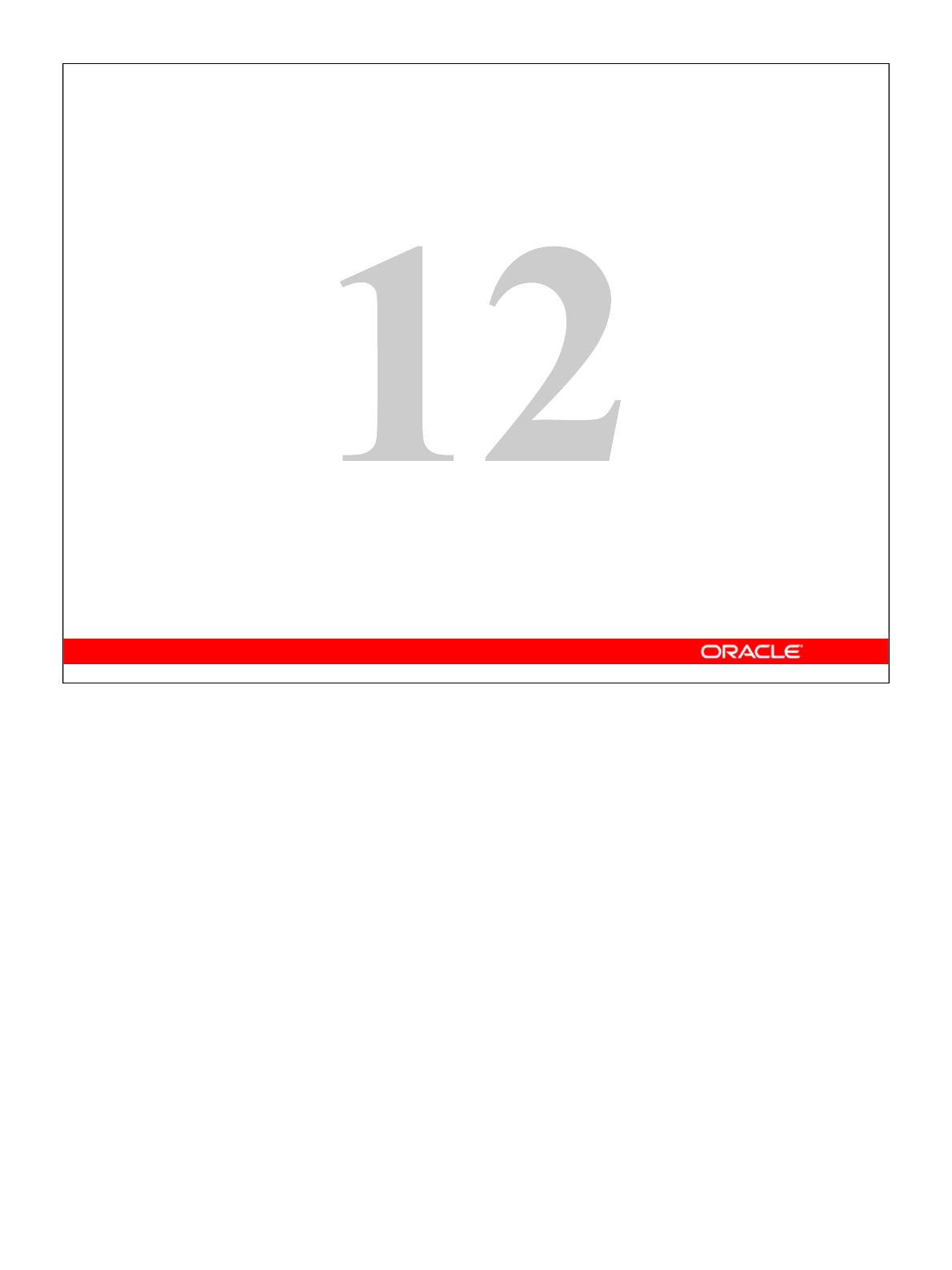
Copyright © 2004, Oracle. All rights reserved.
Understanding and Influencing the
PL/SQL Compiler

Oracle Database 10g: Develop PL/SQL Program Units 12-2
12-2 Copyright © 2004, Oracle. All rights reserved.
Objectives
After completing this lesson, you should be able to do
the following:
•Describe native and interpreted compilations
•List the features of native compilation
•Switch between native and interpreted
compilations
•Set parameters that influence PL/SQL compilation
•Query data dictionary views on how PL/SQL code
is compiled
•Use the compiler warning mechanism and the
DBMS_WARNING package to implement compiler
warnings
Lesson Aim
In this lesson, you learn to distinguish between native and interpreted compilation of
PL/SQL code. The lesson discusses how to use native compilation, which is the default,
for Oracle Database 10gwith the benefit of having faster execution time for your PL/SQL
code.
You also learn how to influence the compiler settings by setting variable session
parameters, or using the programmatic interface provided by the DBMS_WARNING
package. The lesson covers query compilation settings using the
USER_STORED_SETTINGS and USER_PLSQL_OBJECTS data dictionary views.
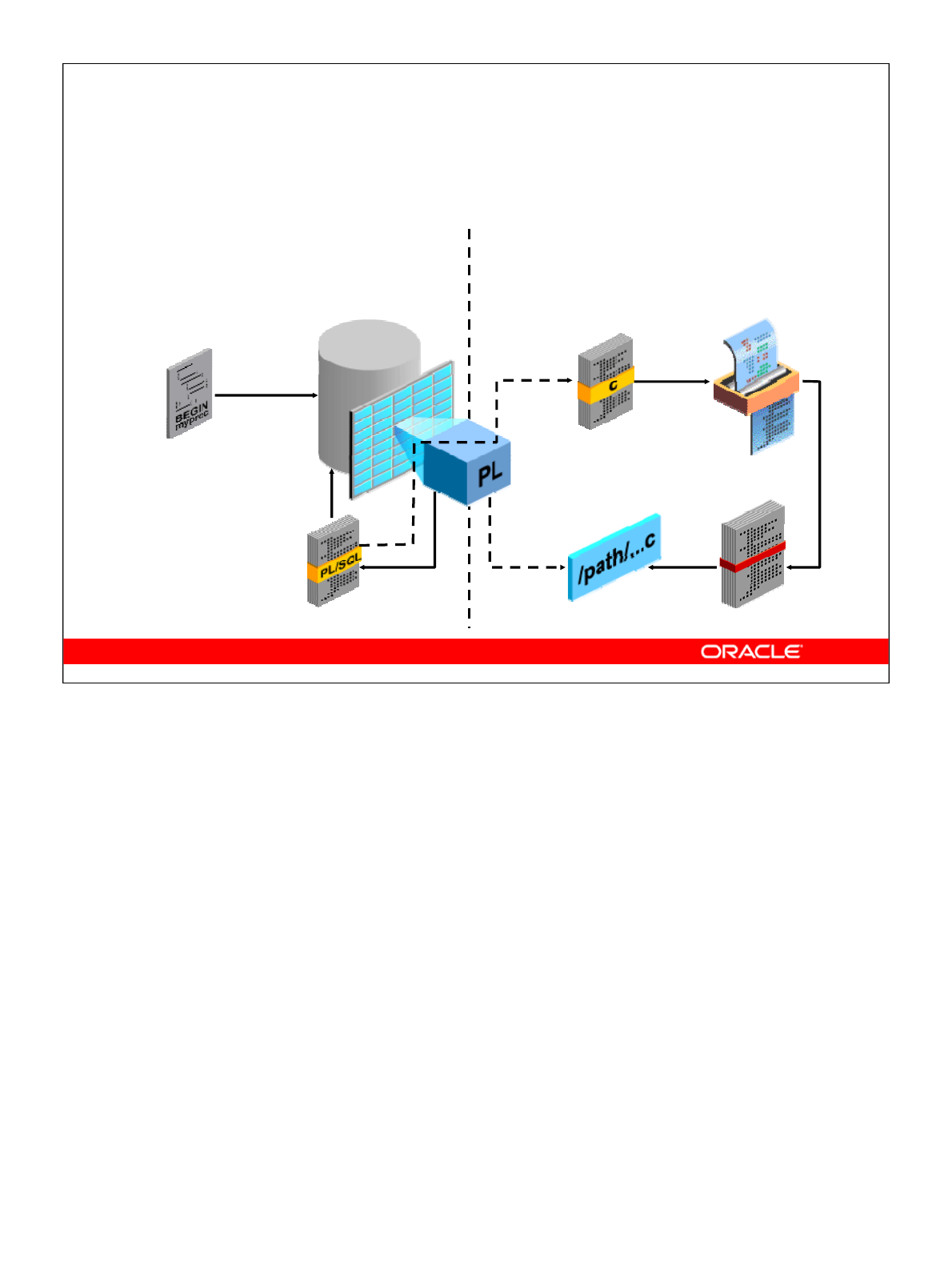
Oracle Database 10g: Develop PL/SQL Program Units 12-3
12-3 Copyright © 2004, Oracle. All rights reserved.
Native and Interpreted Compilation
Natively compiled code
•Translated C and compiled
•Copied to a code library
PL/SQL source
m-code Native code library in OS directory
C compiler
Translated
to C code
Interpreted code
•Compiled to m-code
•Stored in the database
Native and Interpreted Compilation
As depicted in the slide, on the left of the vertical dotted line, a program unit processed as
interpreted PL/SQL is compiled into machine-readable code (m-code), which is stored in
the database and interpreted at run time.
On the right of the vertical dotted line, the PL/SQL source is subjected to native
compilation, where the PL/SQL statements are compiled to m-code that is translated into
C code. The m-code is not retained. The C code is compiled with the usual C compiler and
linked to the Oracle process using native machine code library. The code library is stored
in the database but copied to a specified directory path in the operating system, from
which it is loaded at run time. Native code bypasses the typical run-time interpretation of
code.
Note: Native compilation cannot do much to speed up SQL statements called from
PL/SQL, but it is most effective for computation-intensive PL/SQL procedures that
do not spend most of their time executing SQL.
You can natively compile both the supplied Oracle packages and your own PL/SQL code.
Compiling all PL/SQL code in the database means that you see the speedup in your own
code and all the built-in PL/SQL packages. If you decide that you will have significant
performance gains in database operations using PL/SQL native compilation, Oracle
recommends that you compile the whole database using the NATIVE setting.

Oracle Database 10g: Develop PL/SQL Program Units 12-4
12-4 Copyright © 2004, Oracle. All rights reserved.
Features and Benefits
of Native Compilation
Native compilation:
•Uses a generic makefile that uses the following
operating system software:
–The C compiler
–The linker
–The Make utility
•Generates shared libraries that are copied to the
file system and loaded at run time
•Provides better performance, up to 30% faster
than interpreted code, for computation-intensive
procedural operations
Features and Benefits of Native Compilation
The PL/SQL native compilation process makes use of a makefile, called
spnc_makefile.mk, located in the $ORACLE_HOME/plsql directory. The
makefile is processed by the Make utility that invokes the C compiler, which is the
linker on the supported operating system, to compile and link the resulting C code into
shared libraries. The shared libraries are stored inside the database and are copied to the
file system. At run time, the shared libraries are loaded and run when the PL/SQL
subprogram is invoked.
In accordance with Optimal Flexible Architecture (OFA) recommendations, the shared
libraries should be stored near the data files. C code runs faster than PL/SQL, but it takes
longer to compile than m-code. PL/SQL native compilation provides the greatest
performance gains for computation-intensive procedural operations.
Examples of such operations are data warehouse applications and applications with
extensive server-side transformations of data for display. In such cases, expect speed
increases of up to 30%.

Oracle Database 10g: Develop PL/SQL Program Units 12-5
12-5 Copyright © 2004, Oracle. All rights reserved.
Considerations When Using
Native Compilation
Consider the following:
•Debugging tools for PL/SQL cannot debug
natively compiled code.
•Natively compiled code is slower to compile than
interpreted code.
•Large amounts of natively compiled subprograms
can affect performance due to operating system–
imposed limitations when handling shared
libraries. OS directory limitations can be managed
by setting database initialization parameters:
–PLSQL_NATIVE_LIBRARY_SUBDIR_COUNT and
–PLSQL_NATIVE_LIBRARY_DIR
Limitations of Native Compilation
As stated, the key benefit of natively compiled code is faster execution, particularly for
computationally intensive PL/SQL code, as much as 30% more. Consider that:
• Debugging tools for PL/SQL do not handle procedures compiled for native
execution. Therefore, use interpreted compilation in development environments, and
natively compile the code in a production environment.
• The compilation time increases when using native compilation, because of the
requirement to translate the PL/SQL statement to its C equivalent and execute the
Make utility to invoke the C compiler and linker for generating the resulting
compiled code library.
• If many procedures and packages (more than 5,000) are compiled for native
execution, a large number of shared objects in a single directory may affect
performance. The operating system directory limitations can be managed by
automatically distributing libraries across several subdirectories. To do this, perform
the following tasks before natively compiling the PL/SQL code:
- Set the PLSQL_NATIVE_LIBRARY_SUBDIR_COUNT database initialization
parameter to a large value, such as 1,000, before creating the database or
compiling the PL/SQL packages or procedures.
- Create PLSQL_NATIVE_LIBRARY_SUBDIR_COUNT subdirectories in the
path specified in the PLSQL_NATIVE_LIBRARY_DIR initialization
parameter.

Oracle Database 10g: Develop PL/SQL Program Units 12-6
12-6 Copyright © 2004, Oracle. All rights reserved.
Parameters Influencing Compilation
System parameters
•Set in the initSID.ora file or using the SPFILE
System or session parameters
PLSQL_NATIVE_LIBRARY_DIR = full-directory-path-name
PLSQL_NATIVE_LIBRARY_SUBDIR_COUNT = count
PLSQL_COMPILER_FLAGS = 'NATIVE' or 'INTERPRETED'
Parameters Influencing Compilation
In all circumstances, whether you intend to compile a database as NATIVE or you intend
to compile individual PL/SQL units at the session level, you must set all required
parameters.
The system parameters are set in the initSID.ora file by using the SPFILE
mechanism. Two parameters that are set as system-level parameters are the following:
• The PLSQL_NATIVE_LIBRARY_DIR value, which specifies the full path and
directory name used to store the shared libraries that contain natively compiled
PL/SQL code
• The PLSQL_NATIVE_LIBRARY_SUBDIR_COUNT value, which specifies the
number of subdirectories in the directory specified by the parameter
PLSQL_NATIVE_LIBRARY_DIR. Use a script to create directories with consistent
names (for example, d0, d1, d2, and so on), and then the libraries are automatically
distributed among these subdirectories by the PL/SQL compiler.
By default, PL/SQL program units are kept in one directory.
The PLSQL_COMPILER_FLAGS parameter can be set to a value of NATIVE or
INTERPRETED, either as a database initialization for a system-wide default or for each
session using an ALTER SESSION statement.
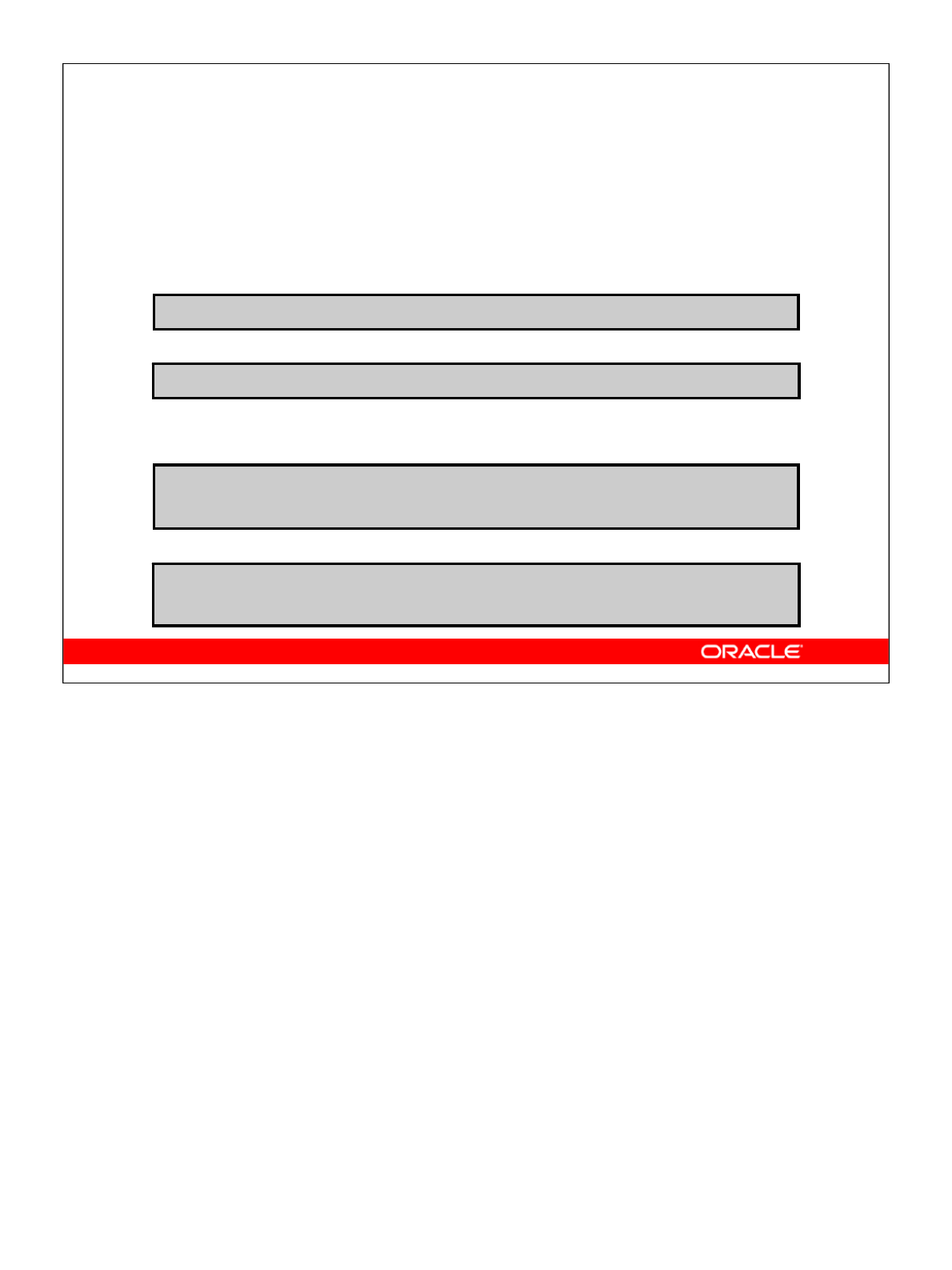
Oracle Database 10g: Develop PL/SQL Program Units 12-7
12-7 Copyright © 2004, Oracle. All rights reserved.
Switching Between Native
and Interpreted Compilation
•Setting native compilation
–For the system
–For the session
•Setting interpreted compilation
–For the system level
–For the session
ALTER SYSTEM SET plsql_compiler_flags='NATIVE';
ALTER SESSION SET plsql_compiler_flags='NATIVE';
ALTER SYSTEM
SET plsql_compiler_flags='INTERPRETED';
ALTER SESSION
SET plsql_compiler_flags='INTERPRETED';
Switching Between Native and Interpreted Compilation
The PLSQL_COMPILER_FLAGS parameter determines whether PL/SQL code is natively
compiled or interpreted, and determines whether debug information is included. The
default setting is INTERPRETED,NON_DEBUG. To enable PL/SQL native compilation,
you must set the value of PLSQL_COMPILER_FLAGS to NATIVE.
If you compile the whole database as NATIVE, then Oracle recommends that you set
PLSQL_COMPILER_FLAGS at the system level.
To set compilation type at the system level (usually done by a DBA), execute the
following statements:
ALTER SYSTEM SET plsql_compiler_flags='NATIVE'
ALTER SYSTEM SET plsql_compiler_flags='INTERPRETED'
To set compilation type at the session level, execute one of the following statements:
ALTER SESSION SET plsql_compiler_flags='NATIVE'
ALTER SESSION SET plsql_compiler_flags='INTERPRETED'

Oracle Database 10g: Develop PL/SQL Program Units 12-8
12-8 Copyright © 2004, Oracle. All rights reserved.
Viewing Compilation Information
in the Data Dictionary
Query information in the following views:
•USER_STORED_SETTINGS
•USER_PLSQL_OBJECTS
For example:
Note: The PARAM_VALUE column has a value of NATIVE
for procedures that are compiled for native execution;
otherwise, it has a value of INTERPRETED.
SELECT param_value
FROM user_stored_settings
WHERE param_name = 'PLSQL_COMPILER_FLAGS'
AND object_name = 'GET_EMPLOYEES';
Viewing Compilation Information in the Data Dictionary
To check whether an existing procedure is compiled for native execution or not, you can
query the following data dictionary views:
[USER | ALL | DBA]_STORED_SETTINGS
[USER | ALL | DBA ]_PLSQL_OBJECTS
The example in the slide shows how you can check the status of the procedure called
GET_EMPLOYEES. The PARAM_VALUE column has a value of NATIVE for procedures
that are compiled for native execution; otherwise, it has a value of INTERPRETED.
After procedures are natively compiled and turned into shared libraries, they are
automatically linked into the Oracle process. You do not need to restart the database, or
move the shared libraries to a different location. You can call back and forth between
stored procedures, whether they are all compiled interpreted (the default), all compiled for
native execution, or a mixture of both.
Because the PLSQL_COMPILER_FLAGS setting is stored inside the library unit for each
procedure, the procedures compiled for native execution are compiled the same way when
the procedure is recompiled automatically after being invalidated, such as when a table
that it depends on is re-created.

Oracle Database 10g: Develop PL/SQL Program Units 12-9
12-9 Copyright © 2004, Oracle. All rights reserved.
Using Native Compilation
To enable native compilation, perform the following
steps:
1. Edit the supplied makefile and enter appropriate
paths and other values for your system.
2. Set the parameter PLSQL_COMPILER_FLAGS (at
system or session level) to the value NATIVE. The
default is INTERPRETED.
3. Compile the procedures, functions, and packages.
4. Query the data dictionary to see that a procedure
is compiled for native execution.
Using Native Compilation
To enable native compilation, perform the following steps:
1. Check and edit the compiler, linker, utility paths, and other values, if required.
2. Set the PLSQL_COMPILER_FLAGS to NATIVE.
3. Compile the procedures, functions, and packages. Compiling can be done by:
- Using the appropriate ALTER PROCEDURE, ALTER FUNCTION, or ALTER
PACKAGE statements with the COMPILE option
- Dropping the procedure and re-creating it
- Running one of the SQL*Plus scripts that sets up a set of Oracle-supplied
packages
- Creating a database using a preconfigured initialization file with its
PLSQL_COMPILER_FLAGS set to NATIVE
4. Confirm the compilation type using the appropriate data dictionary tables.
Note: Dependencies between database objects are handled in the same manner as in
previous Oracle database versions. If an object on which a natively compiled PL/SQL
program unit depends changes, then the PL/SQL module is invalidated. The next time the
same program unit is executed, the RDBMS attempts to revalidate the module. When a
module is recompiled as part of revalidation, it is compiled using the setting that was used
the last time the module was compiled, and it is saved in the *_STORED_SETTINGS
view.

Oracle Database 10g: Develop PL/SQL Program Units 12-10
12-10 Copyright © 2004, Oracle. All rights reserved.
Compiler Warning Infrastructure
The PL/SQL compiler in Oracle Database 10ghas been
enhanced to produce warnings for subprograms. Warning
levels:
•Can be set:
–Declaratively with the PLSQL_WARNINGS initialization
parameter
–Programmatically using the DBMS_WARNINGS package
•Are arranged in three categories: severe, performance,
and informational
•Can be enabled and disabled by category or a specific
message
Examples of warning messages:
SP2-0804: Procedure created with compilation warnings
PLW-07203: Parameter 'IO_TBL' may benefit from use
of the NOCOPY compiler hint.
Compiler Warning Infrastructure
The Oracle PL/SQL compiler can issue warnings when you compile subprograms that
produce ambiguous results or use inefficient constructs. You can selectively enable and
disable these warnings:
• Declaratively by setting the PLSQL_WARNINGS initialization parameter
• Programmatically using the DBMS_WARNINGS package
The warning level is arranged in the following categories: severe, performance, and
informational. Warnings levels can be enabled or disabled by category or by a specific
warning message number.
Benefits of Compiler Warnings
Using compiler warnings can help to:
• Make your programs more robust and avoid problems at run time
• Identify potential performance problems
• Indicate factors that produce undefined results
Note: You can enable checking for certain warning conditions when these conditions are
not serious enough to produce an error and keep you from compiling a subprogram.
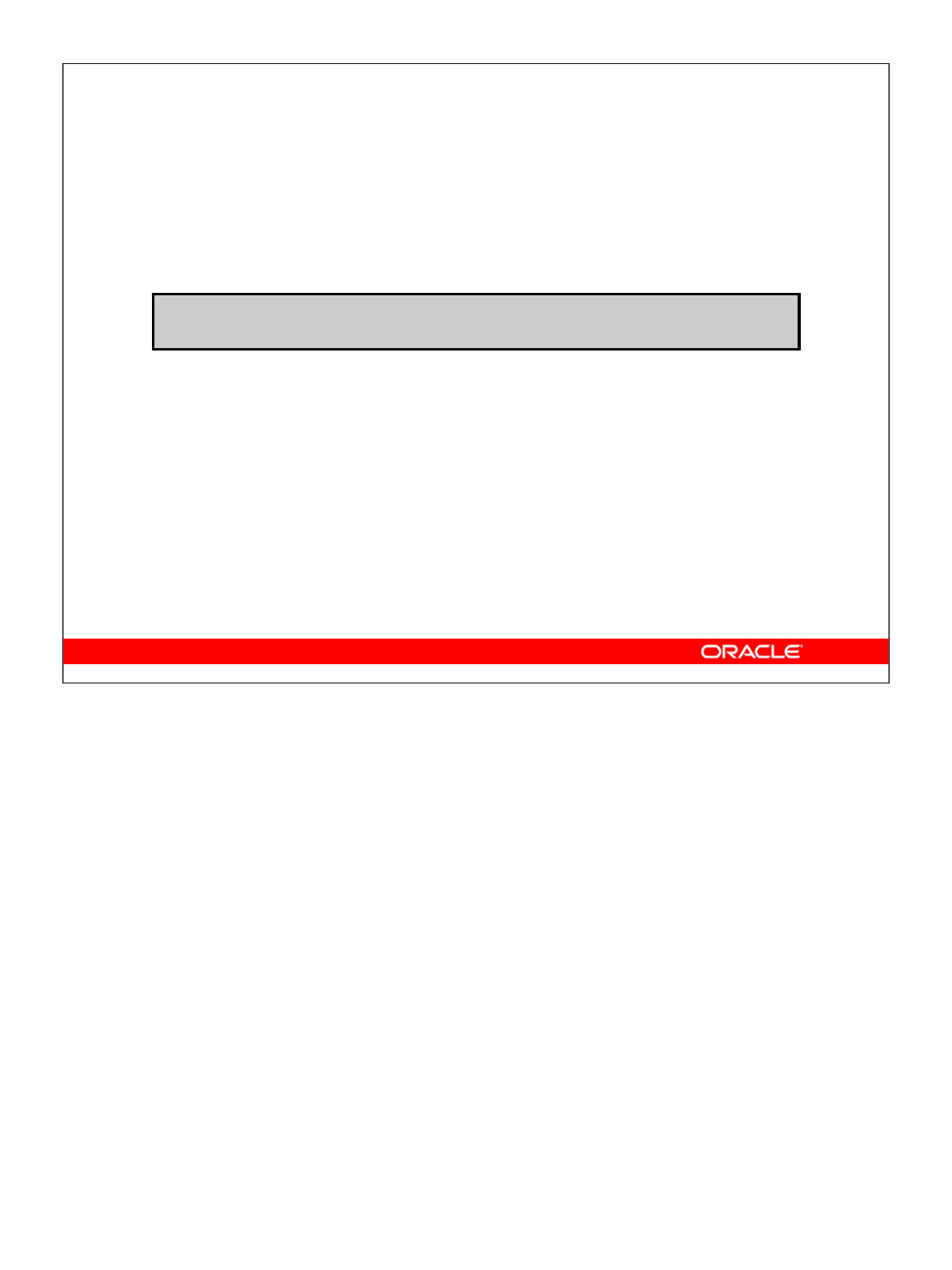
Oracle Database 10g: Develop PL/SQL Program Units 12-11
12-11 Copyright © 2004, Oracle. All rights reserved.
Setting Compiler Warning Levels
Set the PLSQL_WARNINGS initialization parameter to
enable the database to issue warning messages.
•The PLSQL_WARNINGS combine a qualifier value
ENABLE, DISABLE, or ERROR with a comma-
separated list of message numbers, or with one of
the following modifier values:
–ALL, SEVERE, INFORMATIONAL, or PERFORMANCE
•Warning messages use a PLW prefix.
PLW-07203: Parameter 'IO_TBL' may benefit from
use of the NOCOPY compiler hint.
ALTER SESSION SET PLSQL_WARNINGS = 'ENABLE:SEVERE',
'DISABLE:INFORMATIONAL';
Setting Compiler Warning Levels
The PLSQL_WARNINGS setting enables or disables the reporting of warning messages by
the PL/SQL compiler, and specifies which warning messages to show as errors. The
PLSQL_WARNINGS parameter can be set for the system using the initialization file or the
ALTER SYSTEM statement, or for the session using the ALTER SESSION statement as
shown in the example in the slide. By default, the value is set to DISABLE:ALL.
The parameter value comprises a comma-separated list of quoted qualifier and modifier
keywords, where the keywords are separated by colons. The qualifier values are:
•ENABLE: To enable a specific warning or a set of warnings
•DISABLE: To disable a specific warning or a set of warnings
•ERROR: To treat a specific warning or a set of warnings as errors
The modifier value ALL applies to all warning messages. SEVERE, INFORMATIONAL,
and PERFORMANCE apply to messages in their own category, and an integer list for
specific warning messages. For example:
PLSQL_WARNINGS='ENABLE:SEVERE','DISABLE:INFORMATIONAL';
PLSQL_WARNINGS='DISABLE:ALL';
PLSQL_WARNINGS='DISABLE:5000','ENABLE:5001','ERROR:5002';
PLSQL_WARNINGS='ENABLE:(5000,5001)','DISABLE:(6000)';

Oracle Database 10g: Develop PL/SQL Program Units 12-12
12-12 Copyright © 2004, Oracle. All rights reserved.
Guidelines for Using PLSQL_WARNINGS
The PLSQL_WARNINGS setting:
•Can be set to DEFERRED at the system level
•Is stored with each compiled subprogram
•That is current for the session is used, by default,
when recompiling with:
–A CREATE OR REPLACE statement
–An ALTER...COMPILE statement
•That is stored with the compiled subprogram is
used when REUSE SETTINGS is specified when
recompiling with an ALTER...COMPILE statement
Guidelines for Using PLSQL_WARNINGS
As already stated, the PLSQL_WARNINGS parameter can be set at the session level or the
system level. When setting it at the system level, you can include the value DEFERRED so
that it applies to future sessions but not the current one.
The settings for the PLSQL_WARNINGS parameter are stored along with each compiled
subprogram. If you recompile the subprogram with a CREATE OR REPLACE statement,
the current settings for that session are used. If you recompile the subprogram with an
ALTER...COMPILE statement, then the current session setting is used unless you
specify the REUSE SETTINGS clause in the statement, which uses the original setting
that is stored with the subprogram.

Oracle Database 10g: Develop PL/SQL Program Units 12-13
12-13 Copyright © 2004, Oracle. All rights reserved.
DBMS_WARNING Package
The DBMS_WARNING package provides a way to
programmatically manipulate the behavior of current
system or session PL/SQL warning settings. Using
DBMS_WARNING subprograms, you can:
•Query existing settings
•Modify the settings for specific requirements or
restore original settings
•Delete the settings
Example: Saving and restoring warning settings for a
development environment that calls your code that
compiles PL/SQL subprograms, and suppresses
warnings due to business requirements
DBMS_WARNING Package
The DBMS_WARNING package provides a way to manipulate the behavior of PL/SQL
warning messages, in particular by reading and changing the setting of the
PLSQL_WARNINGS initialization parameter to control what kinds of warnings are
suppressed, displayed, or treated as errors. This package provides the interface to query,
modify, and delete current system or session settings.
The DBMS_WARNINGS package is valuable if you are writing a development environment
that compiles PL/SQL subprograms. Using the package interface routines, you can control
PL/SQL warning messages programmatically to suit your requirements.
Here is an example: Suppose you write some code to compile PL/SQL code. You know
that the compiler will issue performance warnings when passing collection variables as
OUT or IN OUT parameters without specifying the NOCOPY hint. The general
environment that calls your compilation utility may or may not have appropriate warning
level settings. In any case, your business rules indicate that the calling environment set
must be preserved and that your compilation process should suppress the warnings. By
calling subprograms in the DBMS_WARNINGS package, you can detect the current
warning settings, change the setting to suit your business requirements, and restore the
original settings when your processing has completed.
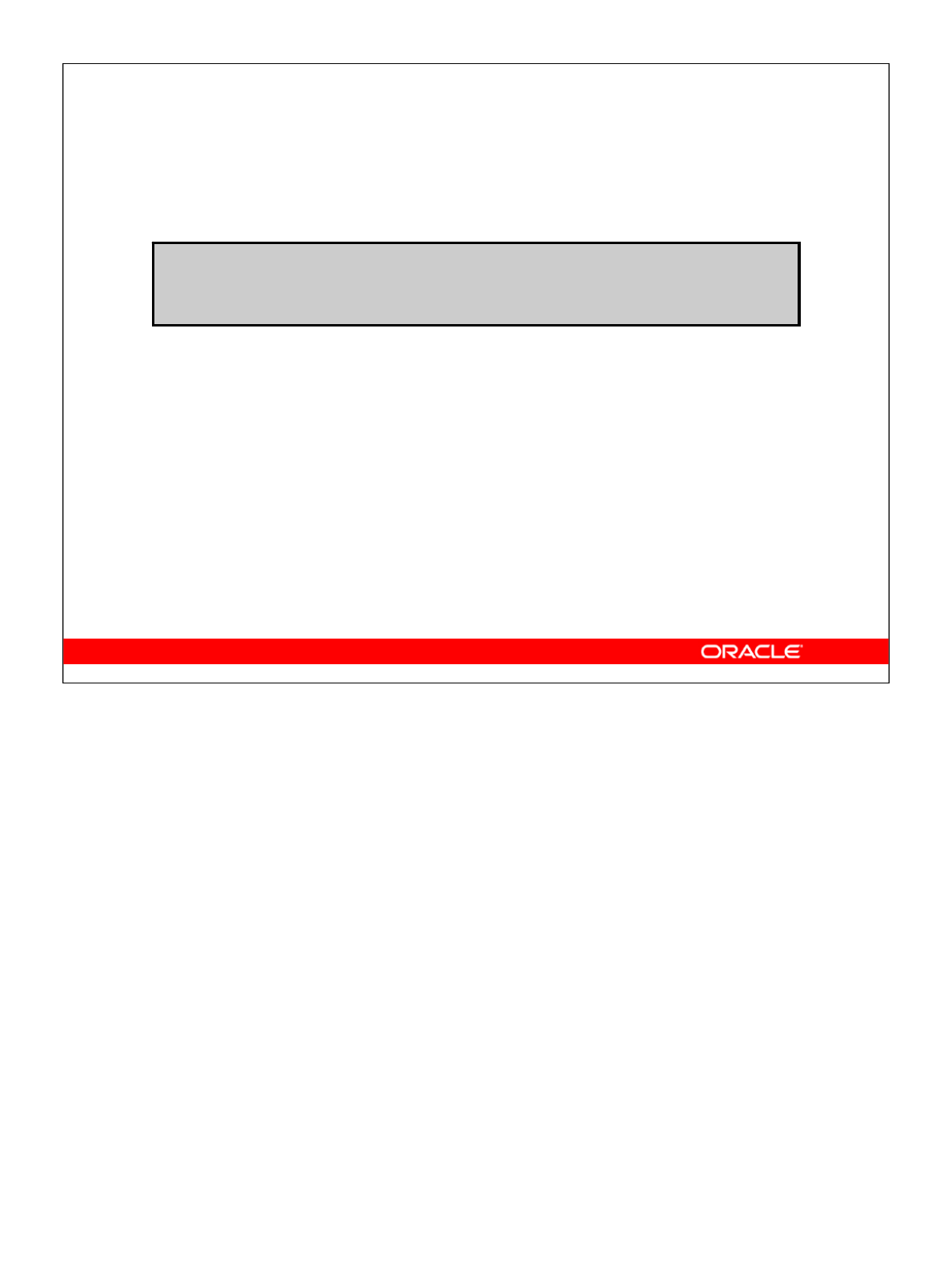
Oracle Database 10g: Develop PL/SQL Program Units 12-14
12-14 Copyright © 2004, Oracle. All rights reserved.
Using DBMS_WARNING Procedures
•Package procedures change PL/SQL warnings:
–All parameters are IN parameters and have the
VARCHAR2 data type. However, the w_number
parameter is a NUMBER data type.
–Parameter string values are not case sensitive.
–The w_value parameters values are ENABLE,
DISABLE, and ERROR.
–The w_category values are ALL, INFORMATIONAL,
SEVERE, and PERFORMANCE.
–The scope value is either SESSION or SYSTEM.
Using SYSTEM requires the ALTER SYSTEM privilege.
ADD_WARNING_SETTING_CAT(w_category,w_value,scope)
ADD_WARNING_SETTING_NUM(w_number,w_value,scope)
SET_WARNING_SETTING_STRING(w_value, scope)
Using DBMS_WARNING Procedures
The package procedures are the following:
•ADD_WARNING_SETTING_CAT: Modifies the current session or system warning
settings of the warning_category previously supplied
•ADD_WARNING_SETTING_NUM: Modifies the current session or system warning
settings of the warning_number previously supplied
•SET_WARNING_SETTING_STRING: Replaces previous settings with the new
value
Using the SET_WARNING_SETTING_STRING, you can set one warning setting. If you
have multiple warning settings, you should perform the following steps:
1. Call SET_WARNING_SETTING_STRING to set the initial warning setting string.
2. Call ADD_WARNING_SETTING_CAT (or ADD_WARNING_SETTING_NUM)
repeatedly to add additional settings to the initial string.
Here is an example to establish the following warning setting string in the current session:
ENABLE:INFORMATIONAL,DISABLE:PERFORMANCE,ENABLE:SEVERE
Execute the following two lines of code:
dbms_warning.set_warning_setting_string('ENABLE:ALL','session');
dbms_warning.add_warning_setting_cat('PERFORMANCE','disable',
'session');
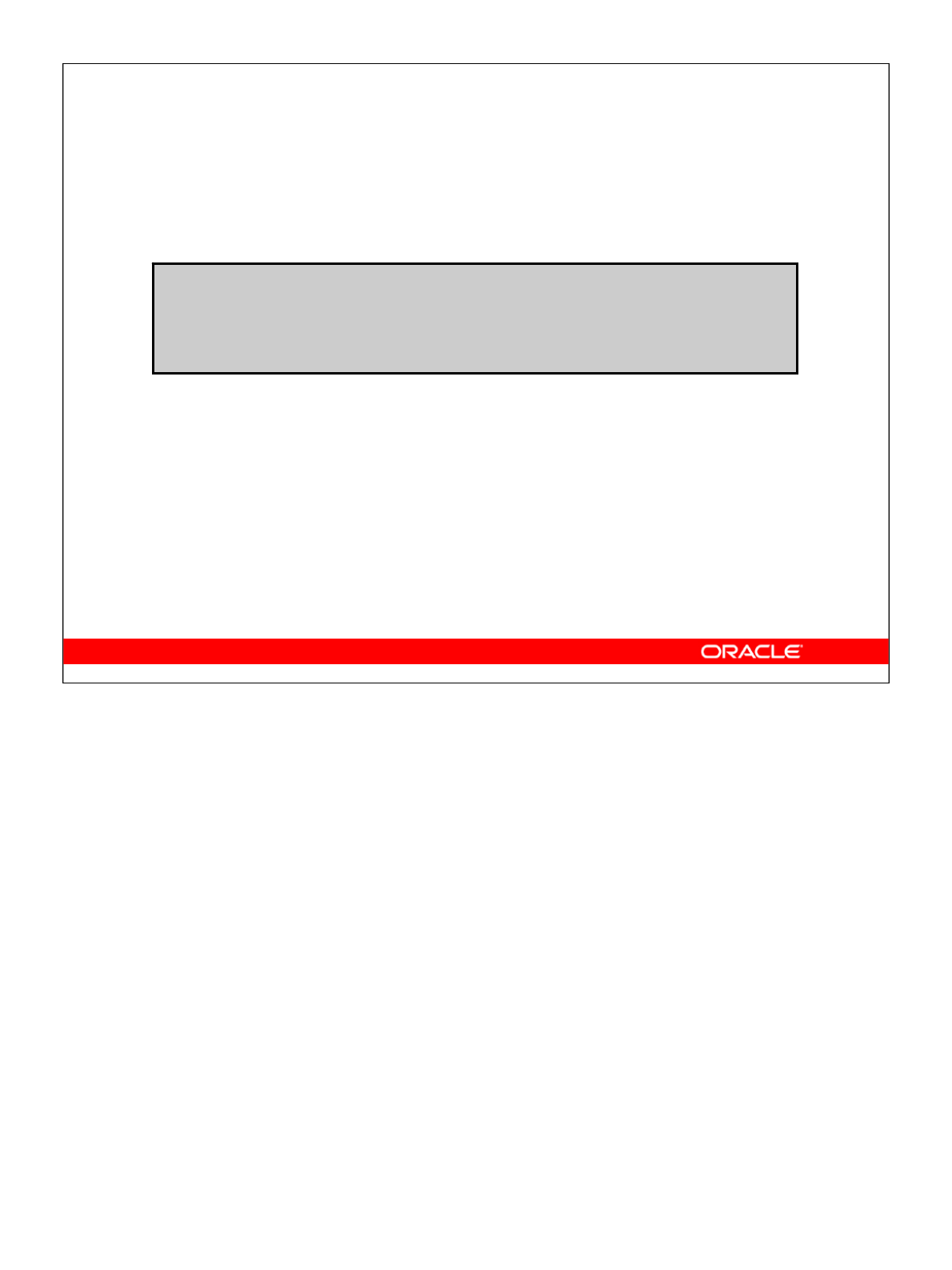
Oracle Database 10g: Develop PL/SQL Program Units 12-15
12-15 Copyright © 2004, Oracle. All rights reserved.
Using DBMS_WARNING Functions
•Package functions read PL/SQL warnings:
–GET_CATEGORY returns a value of ALL,
INFORMATIONAL, SEVERE, or PERFORMANCE for a
given message number.
–GET_WARNING_SETTING_CAT returns ENABLE,
DISABLE, or ERROR as the current warning value for
a category name, and GET_WARNING_SETTING_NUM
returns the value for a specific message number.
–GET_WARNING_SETTING_STRING returns the entire
warning string for the current session.
GET_CATEGORY(w_number) RETURN VARCHAR2
GET_WARNING_SETTING_CAT(w_category)RETURN VARCHAR2
GET_WARNING_SETTING_NUM(w_number) RETURN VARCHAR2
GET_WARNING_SETTING_STRING RETURN VARCHAR2
Using DBMS_WARNING Functions
The following is a list of package functions:
•GET_CATEGORY returns the category name for the given message number.
•GET_WARNING_SETTING_CAT returns the current session warning setting for the
specified category.
•GET_WARNING_SETTING_NUM returns the current session warning setting for the
specified message number.
•GET_WARNING_SETTING_STRING returns the entire warning string for the
current session.
To determine the current session warning settings, enter:
EXECUTE DBMS_OUTPUT.PUT_LINE( -
DBMS_WARNING.GET_WARNING_SETTING_STRING);
To determine the category for warning message number PLW-07203, use:
EXECUTE DBMS_OUTPUT.PUT_LINE( -
DBMS_WARNING.GET_CATEGORY(7203))
The result string should be PERFORMANCE.
Note: The message numbers must be specified as positive integers, because the data type
for the GET_CATEGORY parameter is PLS_INTEGER (allowing positive integer values).

Oracle Database 10g: Develop PL/SQL Program Units 12-16
12-16 Copyright © 2004, Oracle. All rights reserved.
Using DBMS_WARNING: Example
Consider the following scenario:
Save current warning settings, disable warnings for
the PERFORMANCE category, compile a PL/SQL
package, and restore the original warning setting.
CREATE PROCEDURE compile(pkg_name VARCHAR2) IS
warn_value VARCHAR2(200);
compile_stmt VARCHAR2(200) :=
'ALTER PACKAGE '|| pkg_name ||' COMPILE';
BEGIN
warn_value := -- Save current settings
DBMS_WARNING.GET_WARNING_SETTING_STRING;
DBMS_WARNING.ADD_WARNING_SETTING_CAT( -- change
'PERFORMANCE', 'DISABLE', 'SESSION');
EXECUTE IMMEDIATE compile_stmt;
DBMS_WARNING.SET_WARNING_SETTING_STRING(--restore
warn_value, 'SESSION');
END;
Using DBMS_WARNING: Example
In the slide, the example of the compile procedure is designed to compile a named
PL/SQL package. The business rules require the following:
• Warnings in the performance category are suppressed.
• The calling environment’s warning settings must be restored after the compilation is
performed.
The code does not know or care what the calling environment warning settings are; it
simply uses the DBMS_WARNING.GET_WARNING_SETTING_STRING function to
save the current setting.
This value is used to restore the calling environment setting using the
DBMS_WARNING.SET_WARNING_SETTING_STRING procedure in the last line of the
example code. Before compiling the package using Native Dynamic SQL, the compile
procedure alters the current session warning level by disabling warnings for the
PERFORMANCE category.
For example, the compiler will suppress warnings about PL/SQL parameters passed using
OUT or IN OUT modes that do not specify the NOCOPY hint to gain better performance.

Oracle Database 10g: Develop PL/SQL Program Units 12-17
12-17 Copyright © 2004, Oracle. All rights reserved.
Using DBMS_WARNING: Example
To test the compile procedure, you can use the
following script sequence in iSQL*Plus:
DECLARE
PROCEDURE print(s VARCHAR2) IS
BEGIN
DBMS_OUTPUT.PUT_LINE(s);
END;
BEGIN
print('Warning settings before: '||
DBMS_WARNING.GET_WARNING_SETTING_STRING);
compile('my_package');
print('Warning settings after: '||
DBMS_WARNING.GET_WARNING_SETTING_STRING);
END;
/
SHOW ERRORS PACKAGE MY_PACKAGE
Using DBMS_WARNING: Example (continued)
The slide shows an anonymous block that is used to display the current warning settings
for the session before compilation takes place, executes the compile procedure, and prints
the current warning settings for the session again. The before and after values for the
warning settings should be identical.
The last line containing the SHOW ERRORS PACKAGE MY_PACKAGE is used to verify
whether the warning messages in the performance category are suppressed (that is, no
performance-related warning messages are displayed).
To adequately test the compile procedure behavior, the package MY_PACKAGE should
contain a subprogram with a collection (PL/SQL table) specified as an OUT or IN OUT
argument without using the NOCOPY hint. Normally, with the PERFORMANCE category
enabled, a compiler warning will be issued. Using the code examples shown in the last two
slides, the warnings related to the NOCOPY hint are suppressed.

Oracle Database 10g: Develop PL/SQL Program Units 12-18
12-18 Copyright © 2004, Oracle. All rights reserved.
Summary
In this lesson, you should have learned how to:
•Switch between native and interpreted
compilations
•Set parameters that influence native compilation
of PL/SQL programs
•Query data dictionary views that provide
information on PL/SQL compilation settings
•Use the PL/SQL compiler warning mechanism:
–Declaratively by setting the PLSQL_WARNINGS
parameter
–Programmatically using the DBMS_WARNING
package
Summary
The lesson covers details of how native and interpreted compilations work and how to use
parameters that influence the way PL/SQL code is compiled.
The key recommendation is to enable native compilation by default, resulting in 30%
faster performance (in some cases) for your PL/SQL logic. Benchmarks have shown that
enabling native compilation in Oracle Database 10gresults in twice the performance when
compared to Oracle8iand Oracle9idatabases, and as much as three times the performance
of PL/SQL code executing in an Oracle8 database environment. For more information,
refer to the Oracle white paper titled “PL/SQL Just Got Faster,” by Bryn Llewellyn and
Charles Wetherell, from the Oracle Technology Network (OTN) Web site at
http://otn.oracle.com.
The lesson also covers the following two ways of influencing the new compiler warning
system that was added to Oracle Database 10g:
• Setting the PLSQL_WARNINGS parameter
• Using the DBMS_WARNING package programmatic interface

Oracle Database 10g: Develop PL/SQL Program Units 12-19
12-19 Copyright © 2004, Oracle. All rights reserved.
Practice 12: Overview
This practice covers the following topics:
•Enabling native compilation for your session and
compiling a procedure
•Creating a subprogram to compile a PL/SQL
procedure, function, or a package; suppressing
warnings for the PERFORMANCE compiler warning
category; and restoring the original session
warning settings
•Executing the procedure to compile a PL/SQL
package containing a procedure that uses a
PL/SQL table as an IN OUT parameter without
specifying the NOCOPY hint
Practice 12: Overview
In this practice, you enable native compilation for your session and compile a procedure.
You then create a subprogram to compile a PL/SQL procedure, function, or a package, and
you suppress warnings for the PERFORMANCE compiler warning category. The procedure
must restore the original session warning settings. You then execute the procedure to
compile a PL/SQL package that you create, where the package contains a procedure with
an IN OUT parameter without specifying the NOCOPY hint.

Oracle Database 10g: Develop PL/SQL Program Units 12-20
Practice 12
1. Alter the PLSQL_COMPILER_FLAGS parameter to enable native compilation for
your session, and compile any subprogram that you have written.
a. Execute the ALTER SESSION command to enable native compilation.
b. Compile the EMPLOYEE_REPORT procedure. What occurs during
compilation?
c. Execute the EMPLOYEE_REPORT with the value 'UTL_FILE' as the first
parameter, and 'native_salrepXX.txt' where XX is your student
number.
d. Switch compilation to use interpreted compilation.
2. In the COMPILE_PKG (from Practice 6), add an overloaded version of the procedure
called MAKE, which will compile a named procedure, function, or package.
a. In the specification, declare a MAKE procedure that accepts two string
arguments, one for the name of the PL/SQL construct and the other for the type
of PL/SQL program, such as PROCEDURE, FUNCTION, PACKAGE, or
PACKAGE BODY.
b. In the body, write the MAKE procedure to call the DBMS_WARNINGS package
to suppress the PERFORMANCE category. However, save the current compiler
warning settings before you alter them. Then write an EXECUTE IMMEDIATE
statement to compile the PL/SQL object using an appropriate
ALTER...COMPILE statement with the supplied parameter values. Finally,
restore the compiler warning settings that were in place for the calling
environment before the procedure is invoked.
3. Write a new PL/SQL package called TEST_PKG containing a procedure called
GET_EMPLOYEES that uses an IN OUT argument.
a. In the specification, declare the GET_EMPLOYEES procedure with two
parameters: an input parameter specifying a department ID, and an IN OUT
parameter specifying a PL/SQL table of employee rows.
Hint: You must declare a TYPE in the package specification for the PL/SQL
table parameter’s data type.
b. In the package body, implement the GET_EMPLOYEES procedure to retrieve
all the employee rows for a specified department into the PL/SQL table IN
OUT parameter.
Hint: Use the SELECT … BULK COLLECT INTO syntax to simplify the
code.
4. Use the ALTER SESSION statement to set the PLSQL_WARNINGS so that all
compiler warning categories are enabled.
5. Recompile the TEST_PKG that you created two steps earlier (in Exercise 3). What
compiler warnings are displayed, if any?
6. Write a PL/SQL anonymous block to compile the TEST_PKG package by using the
overloaded COMPILE_PKG.MAKE procedure with two parameters. The anonymous
block should display the current session warning string value before and after it
invokes the COMPILE_PKG.MAKE procedure. Do you see any warning messages?
Confirm your observations by executing the SHOW ERRORS PACKAGE command
for the TEST_PKG.

Copyright © 2004, Oracle. All rights reserved.
Table Descriptions and Data
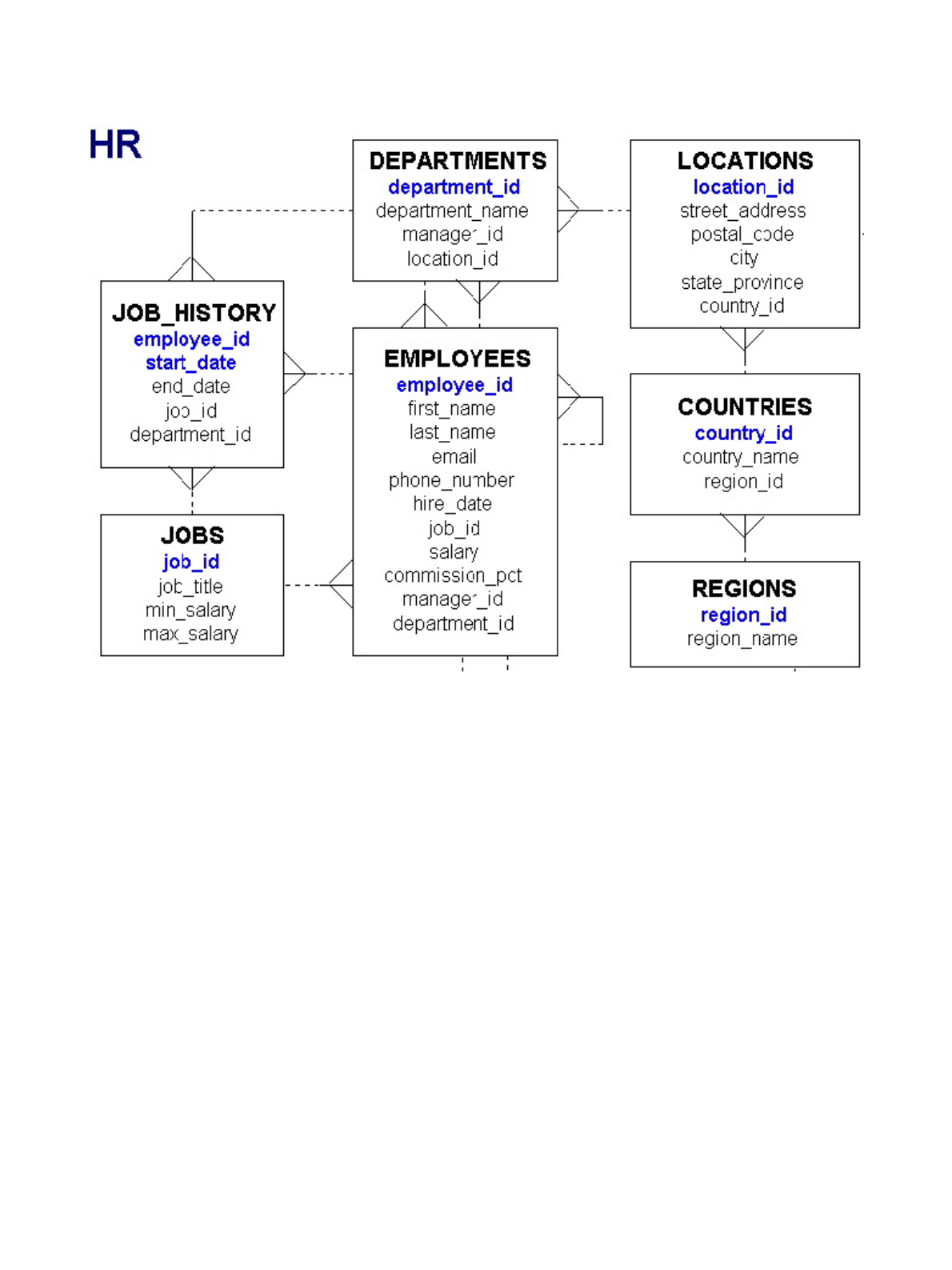
Oracle Database 10g: Develop PL/SQL Program Units B-2
Entity Relationship Diagram
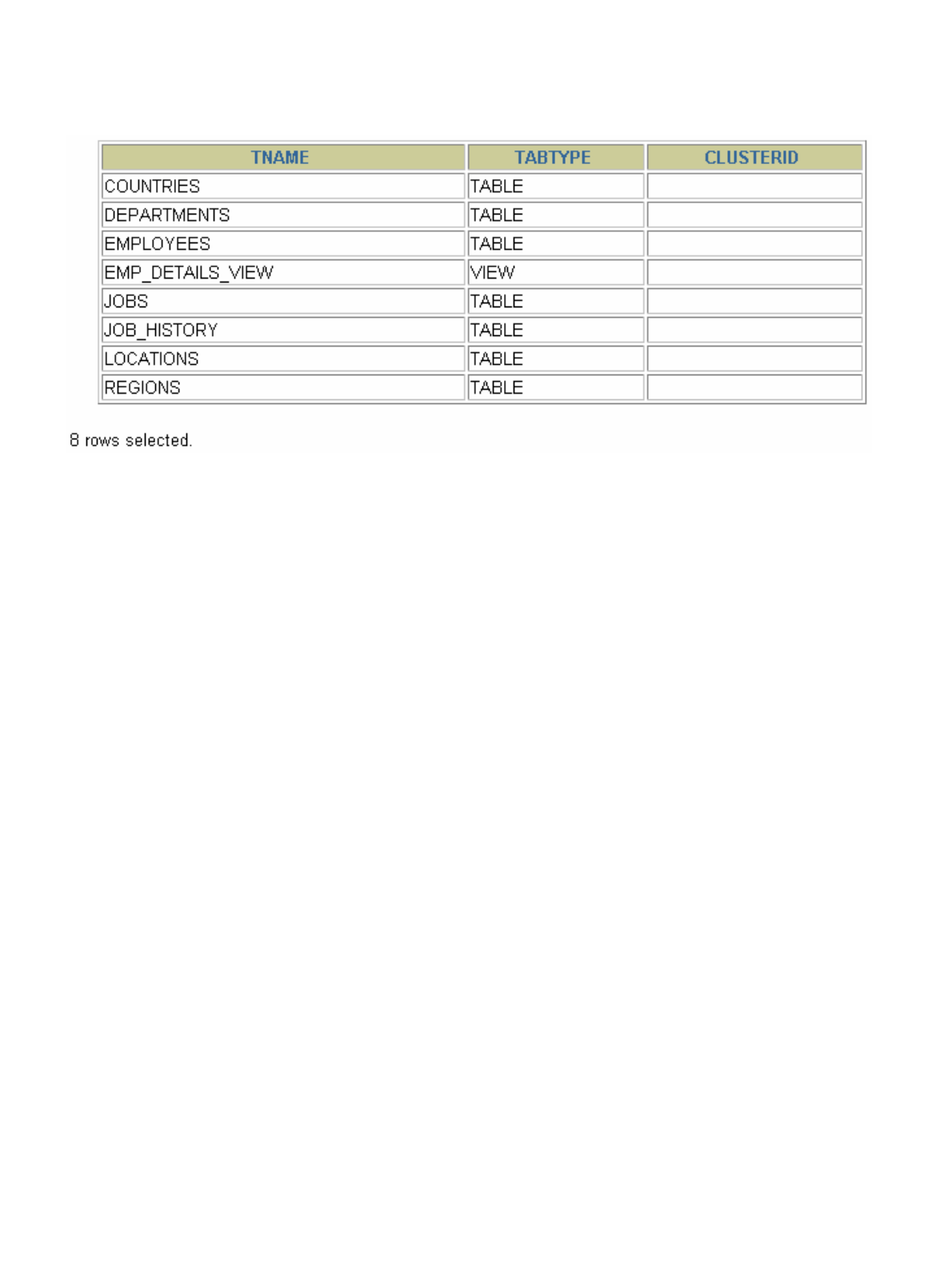
Oracle Database 10g: Develop PL/SQL Program Units B-3
Tables in the Schema
SELECT * FROM tab;

Oracle Database 10g: Develop PL/SQL Program Units B-4
REGIONS Table
DESCRIBE regions
SELECT * FROM regions;
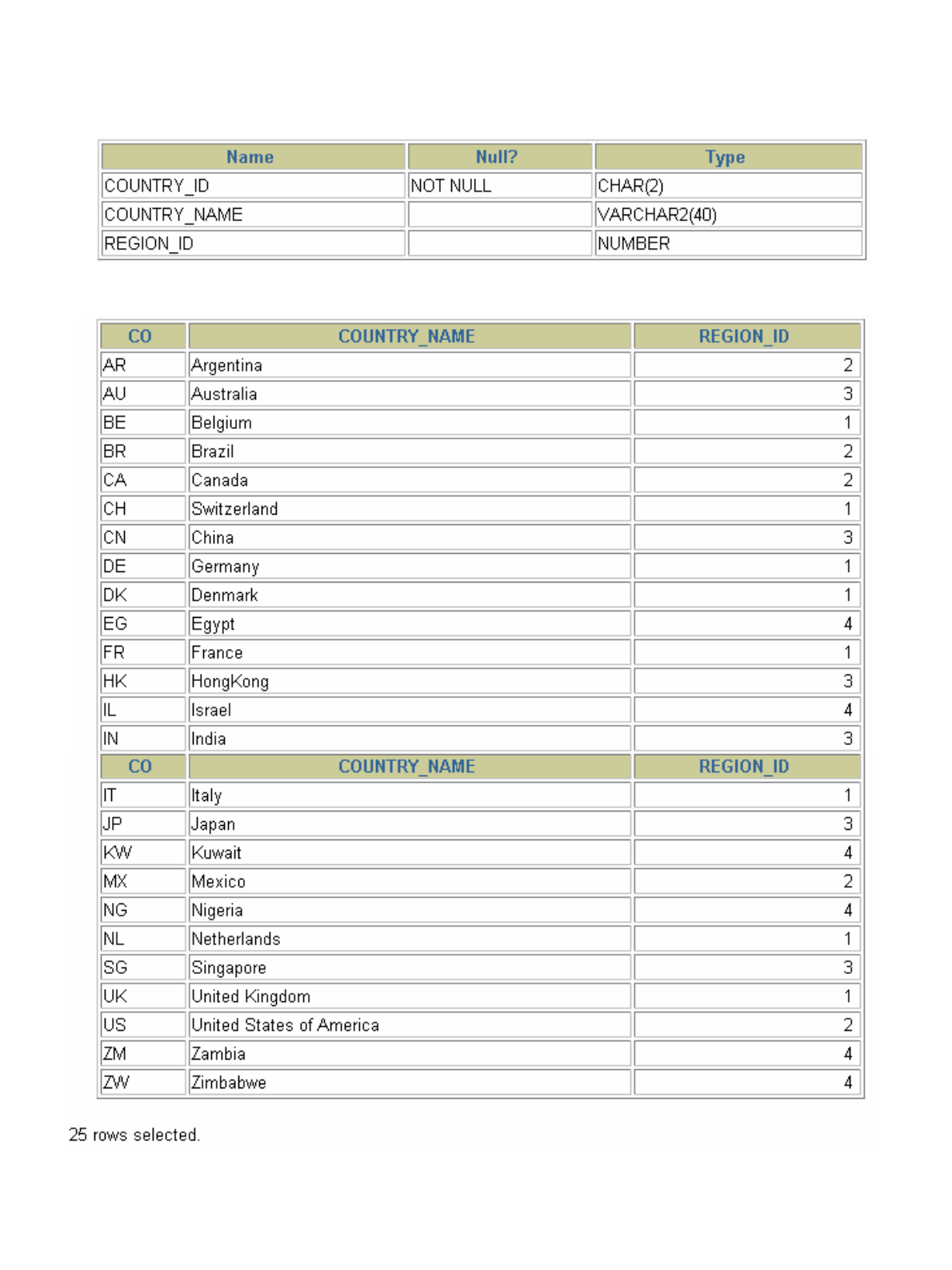
Oracle Database 10g: Develop PL/SQL Program Units B-5
COUNTRIES Table
DESCRIBE countries
SELECT * FROM countries;
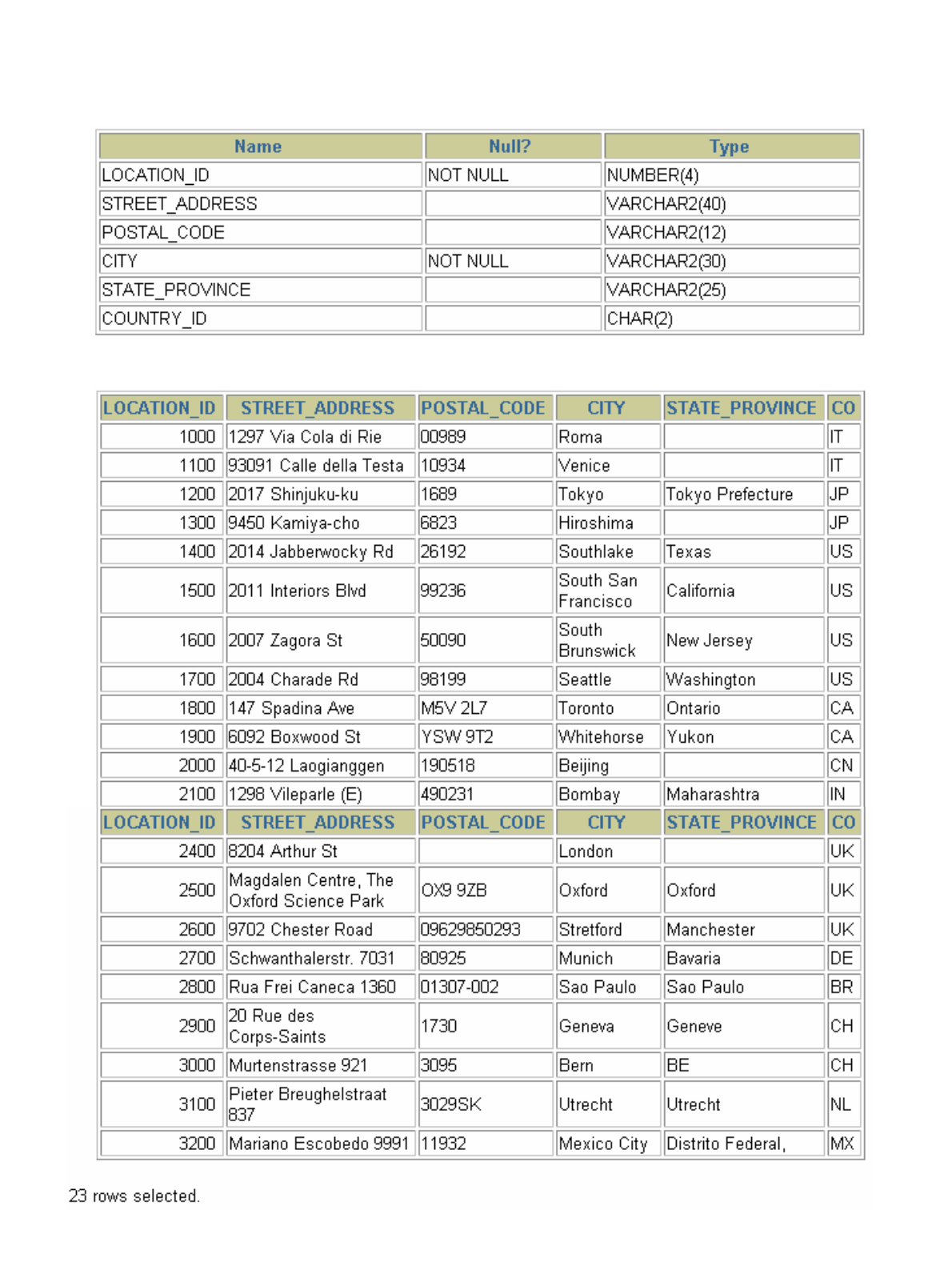
Oracle Database 10g: Develop PL/SQL Program Units B-6
LOCATIONS Table
DESCRIBE locations;
SELECT * FROM locations;

Oracle Database 10g: Develop PL/SQL Program Units B-7
DEPARTMENTS Table
DESCRIBE departments
SELECT * FROM departments;

Oracle Database 10g: Develop PL/SQL Program Units B-8
JOBS Table
DESCRIBE jobs
SELECT * FROM jobs;
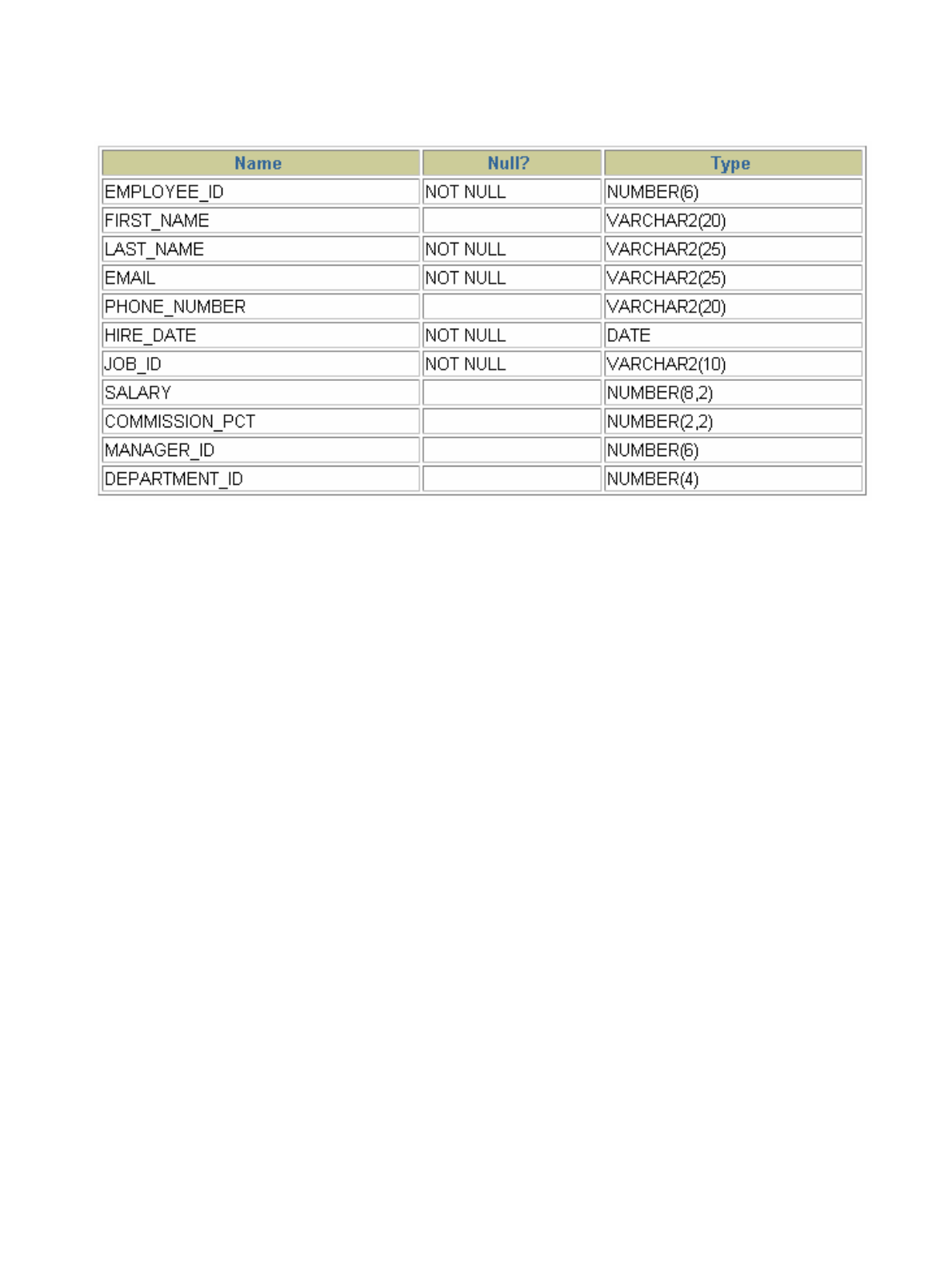
Oracle Database 10g: Develop PL/SQL Program Units B-9
EMPLOYEES Table
DESCRIBE employees

Oracle Database 10g: Develop PL/SQL Program Units B-10
EMPLOYEES Table
The headings for columns COMMISSION_PCT, MANAGER_ID, and DEPARTMENT_ID
are set to COMM, MGRID, and DEPTID in the following screenshot, to fit the table values
across the page.
SELECT * FROM employees;
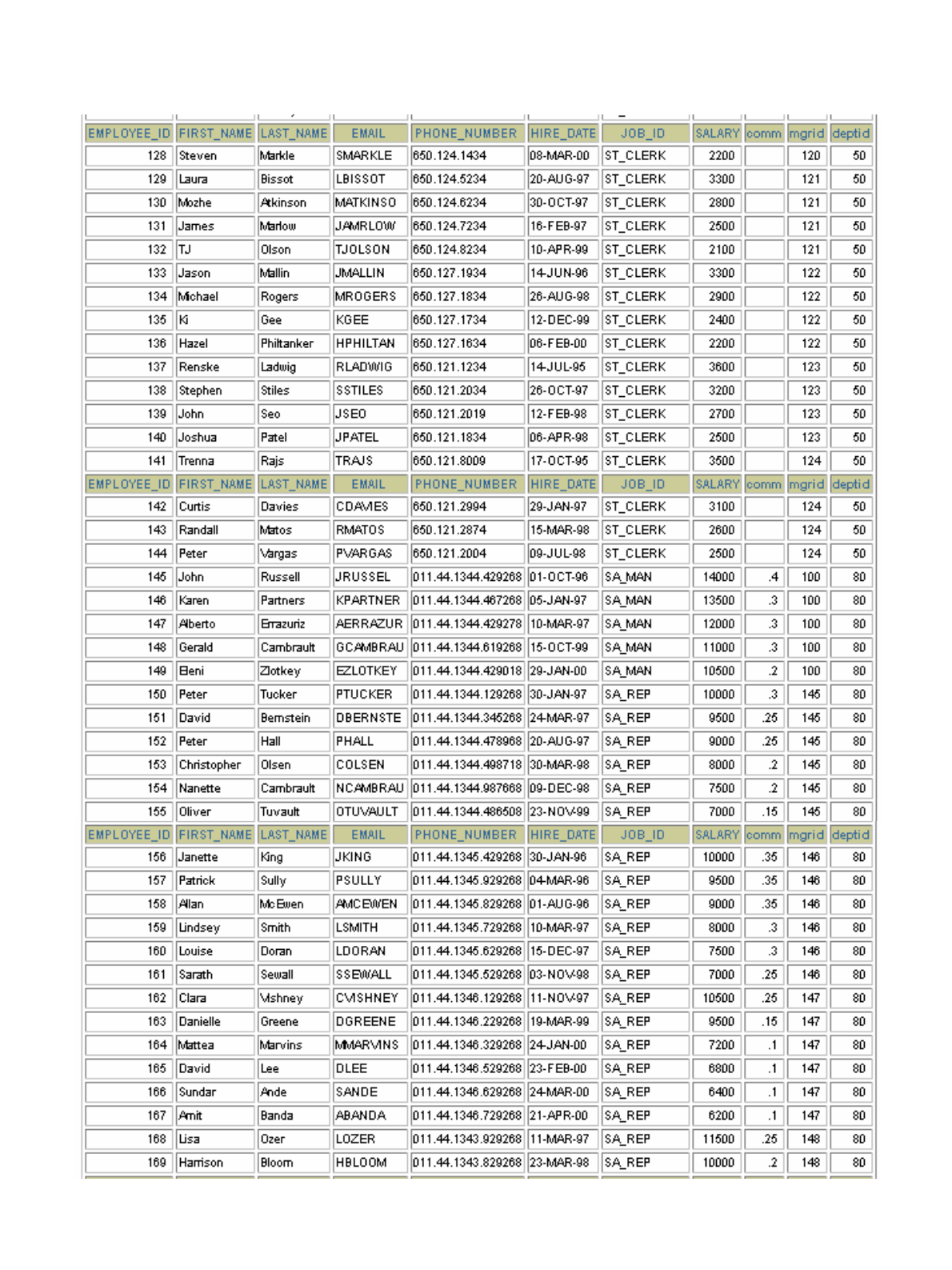
Oracle Database 10g: Develop PL/SQL Program Units B-11
EMPLOYEES Table (continued)

Oracle Database 10g: Develop PL/SQL Program Units B-12
EMPLOYEES Table (continued)
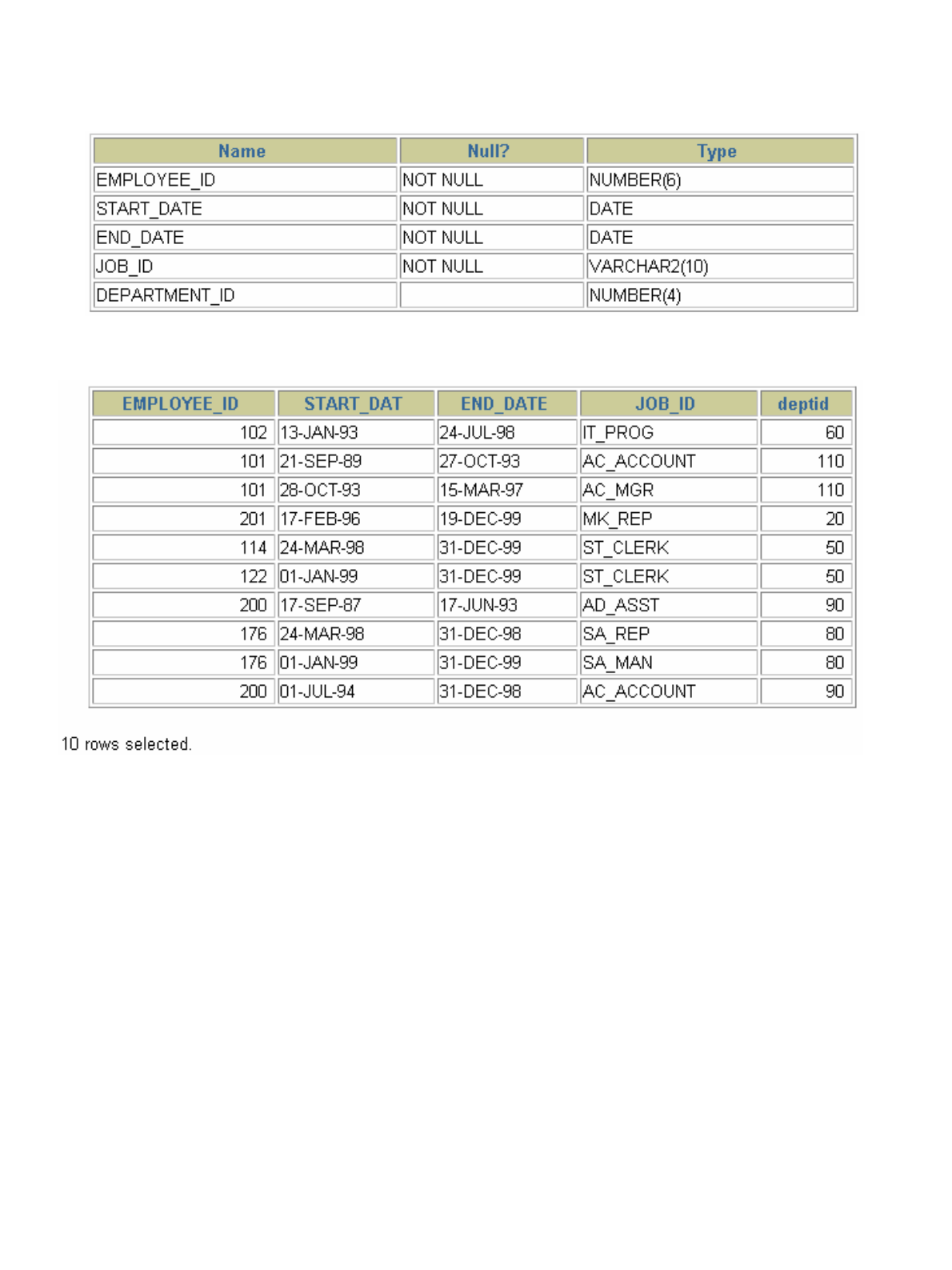
Oracle Database 10g: Develop PL/SQL Program Units B-13
JOB_HISTORY Table
DESCRIBE job_history
SELECT * FROM job_history;


Copyright © 2004, Oracle. All rights reserved.
Studies for Implementing Triggers

Oracle Database 10g: Develop PL/SQL Program Units C-2
C-2 Copyright © 2004, Oracle. All rights reserved.
Objectives
After completing this lesson, you should be able to do
the following:
•Enhance database security with triggers
•Audit data changes using DML triggers
•Enforce data integrity with DML triggers
•Maintain referential integrity using triggers
•Use triggers to replicate data between tables
•Use triggers to automate computation of derived
data
•Provide event-logging capabilities using triggers
Lesson Aim
In this lesson, you learn to develop database triggers in order to enhance features that
cannot otherwise be implemented by the Oracle server. In some cases, it may be sufficient
to refrain from using triggers and accept the functionality provided by the Oracle server.
This lesson covers the following business application scenarios:
• Security
• Auditing
• Data integrity
• Referential integrity
• Table replication
• Computing derived data automatically
• Event logging
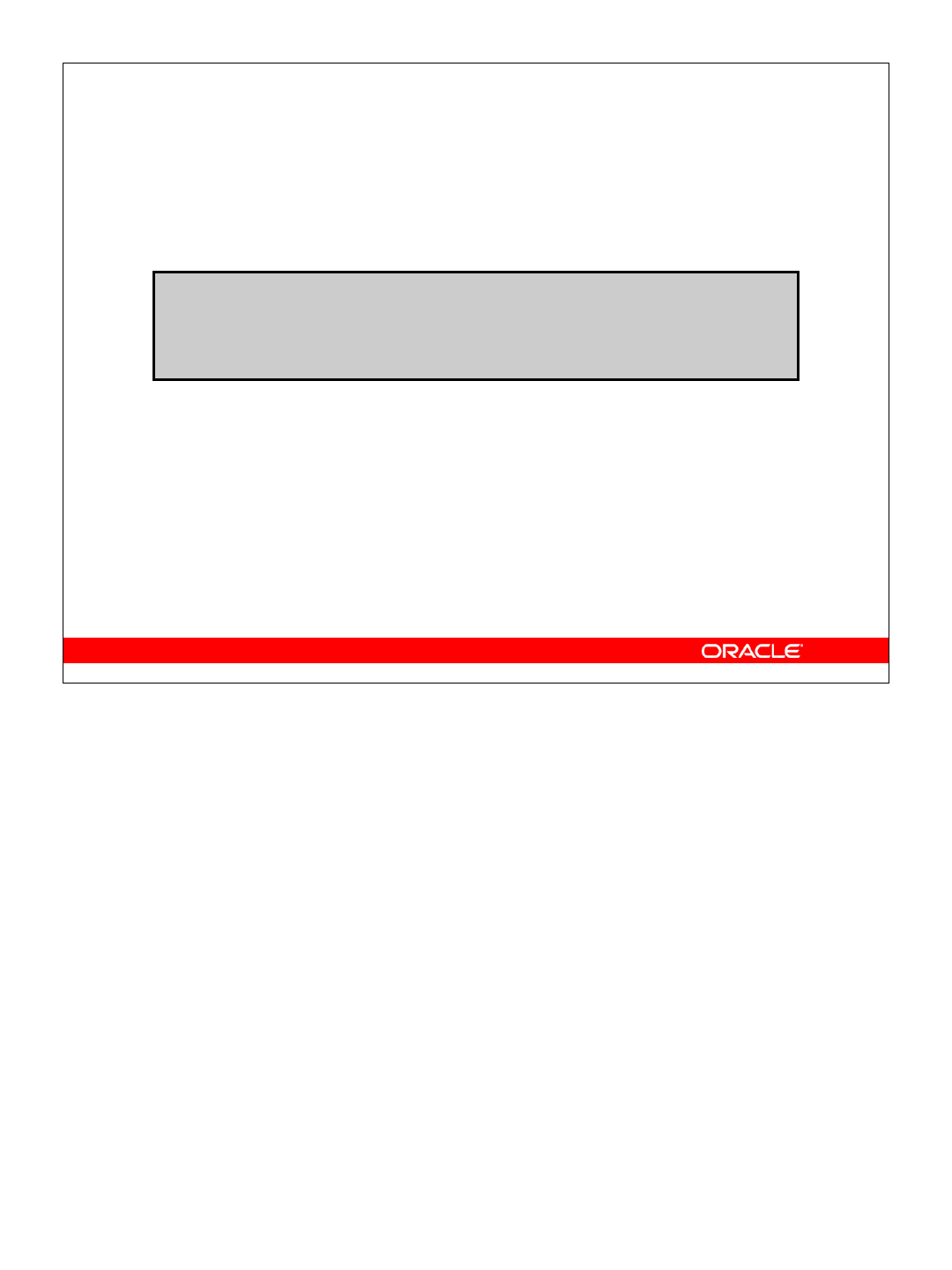
Oracle Database 10g: Develop PL/SQL Program Units C-3
C-3 Copyright © 2004, Oracle. All rights reserved.
Controlling Security Within the Server
Using database security with the GRANT statement.
GRANT SELECT, INSERT, UPDATE, DELETE
ON employees
TO clerk; -- database role
GRANT clerk TO scott;
Controlling Security Within the Server
Develop schemas and roles within the Oracle server to control the security of data
operations on tables according to the identity of the user.
• Base privileges upon the username supplied when the user connects to the database.
• Determine access to tables, views, synonyms, and sequences.
• Determine query, data-manipulation, and data-definition privileges.
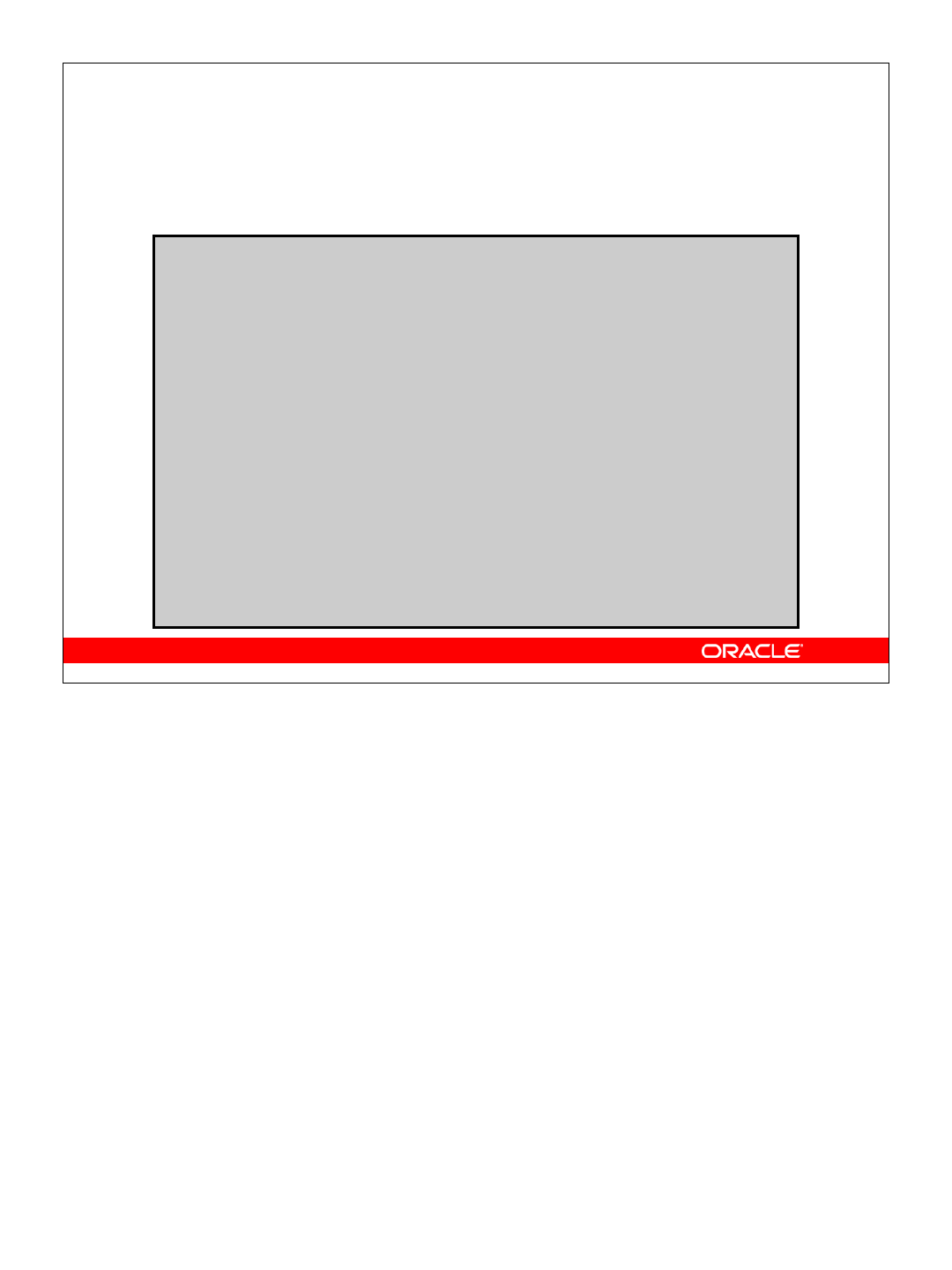
Oracle Database 10g: Develop PL/SQL Program Units C-4
C-4 Copyright © 2004, Oracle. All rights reserved.
CREATE OR REPLACE TRIGGER secure_emp
BEFORE INSERT OR UPDATE OR DELETE ON employees
DECLARE
dummy PLS_INTEGER;
BEGIN
IF (TO_CHAR (SYSDATE, 'DY') IN ('SAT','SUN')) THEN
RAISE_APPLICATION_ERROR(-20506,'You may only
change data during normal business hours.');
END IF;
SELECT COUNT(*) INTO dummy FROM holiday
WHERE holiday_date = TRUNC (SYSDATE);
IF dummy > 0 THEN
RAISE_APPLICATION_ERROR(-20507,
'You may not change data on a holiday.');
END IF;
END;
/
Controlling Security
with a Database Trigger
Controlling Security with a Database Trigger
Develop triggers to handle more complex security requirements.
• Base privileges on any database values, such as the time of day, the day of the week,
and so on.
• Determine access to tables only.
• Determine data-manipulation privileges only.
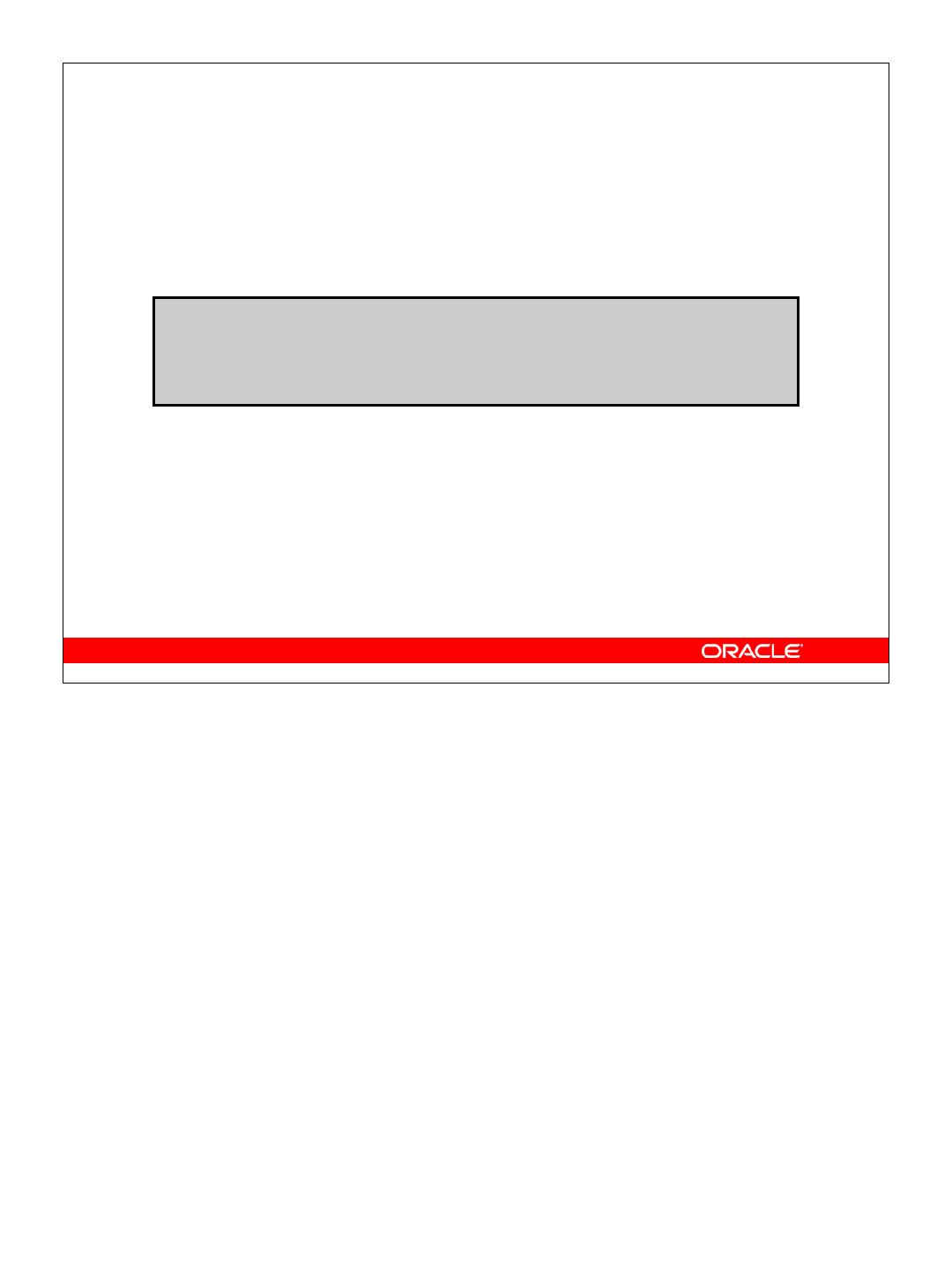
Oracle Database 10g: Develop PL/SQL Program Units C-5
C-5 Copyright © 2004, Oracle. All rights reserved.
AUDIT INSERT, UPDATE, DELETE
ON departments
BY ACCESS
WHENEVER SUCCESSFUL;
Using the Server Facility
to Audit Data Operations
The Oracle server stores the audit information in a
data dictionary table or an operating system file.
Audit succeeded.
Auditing Data Operations
You can audit data operations within the Oracle server. Database auditing is used to
monitor and gather data about specific database activities. The DBA can gather statistics
such as which tables are being updated, how many I/Os are performed, how many
concurrent users connect at peak time, and so on.
• Audit users, statements, or objects.
• Audit data retrieval, data-manipulation, and data-definition statements.
• Write the audit trail to a centralized audit table.
• Generate audit records once per session or once per access attempt.
• Capture successful attempts, unsuccessful attempts, or both.
• Enable and disable dynamically.
Executing SQL through PL/SQL program units may generate several audit records
because the program units may refer to other database objects.
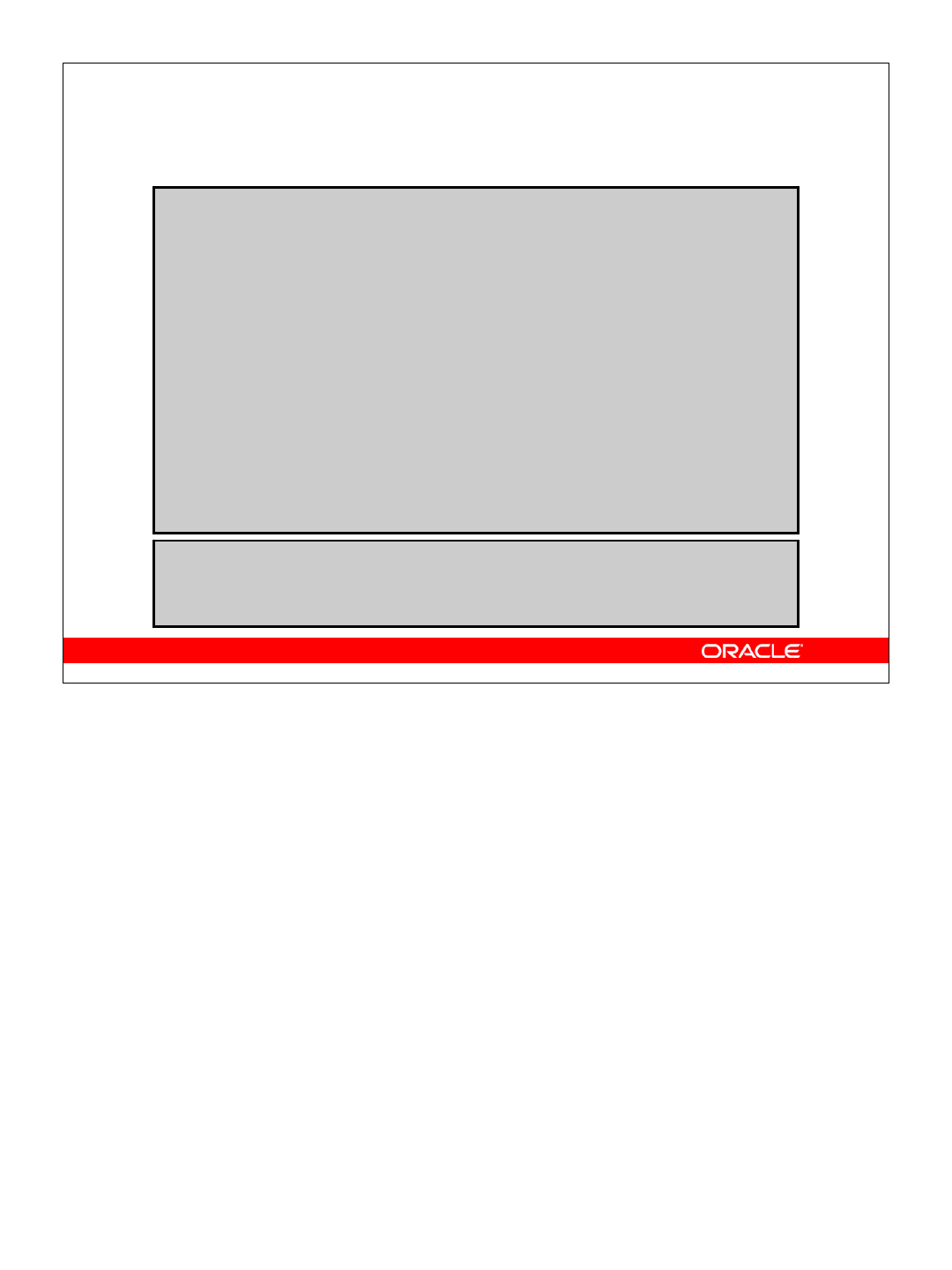
Oracle Database 10g: Develop PL/SQL Program Units C-6
C-6 Copyright © 2004, Oracle. All rights reserved.
CREATE OR REPLACE TRIGGER audit_emp_values
AFTER DELETE OR INSERT OR UPDATE
ON employees FOR EACH ROW
BEGIN
IF (audit_emp_pkg. reason IS NULL) THEN
RAISE_APPLICATION_ERROR (-20059, 'Specify a
reason for operation through the procedure
AUDIT_EMP_PKG.SET_REASON to proceed.');
ELSE
INSERT INTO audit_emp_table (user_name,
timestamp, id, old_last_name, new_last_name,
old_salary, new_salary, comments)
VALUES (USER, SYSDATE, :OLD.employee_id,
:OLD.last_name, :NEW.last_name,:OLD.salary,
:NEW.salary, audit_emp_pkg.reason);
END IF;
END;
CREATE OR REPLACE TRIGGER cleanup_audit_emp
AFTER INSERT OR UPDATE OR DELETE ON employees
BEGIN audit_emp_package.g_reason := NULL;
END;
Auditing by Using a Trigger
Auditing Data Values
Audit actual data values with triggers.
You can do the following:
• Audit data-manipulation statements only.
• Write the audit trail to a user-defined audit table.
• Generate audit records once for the statement or once for each row.
• Capture successful attempts only.
• Enable and disable dynamically.
Using the Oracle server, you can perform database auditing. Database auditing cannot
record changes to specific column values. If the changes to the table columns need to be
tracked and column values need to be stored for each change, then use application
auditing. Application auditing can be done either through stored procedures or database
triggers, as shown in the example in the slide.
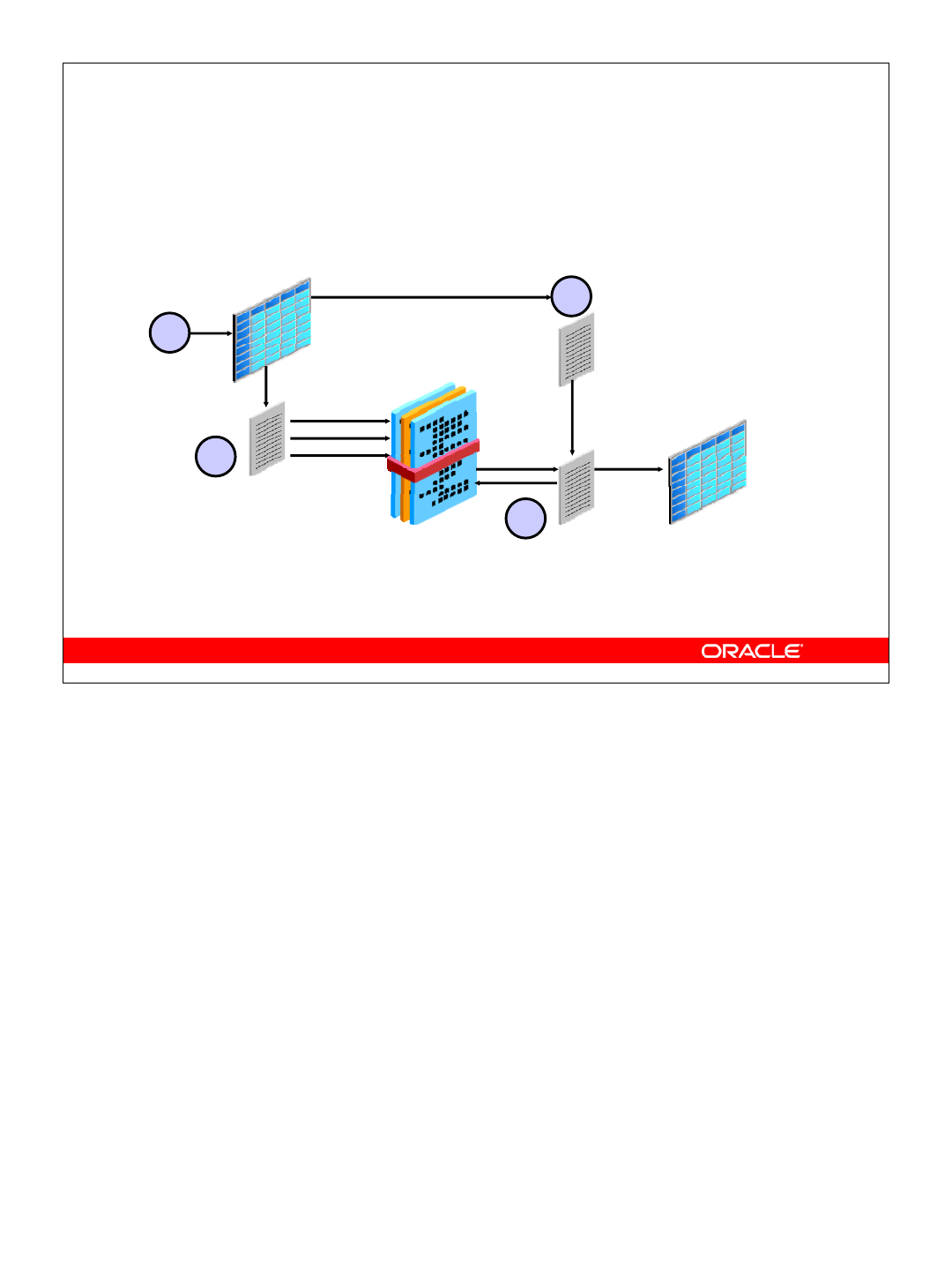
Oracle Database 10g: Develop PL/SQL Program Units C-7
C-7 Copyright © 2004, Oracle. All rights reserved.
AUDIT_EMP_TRG
FOR EACH ROW
increments
package variables
Auditing Triggers by Using
Package Constructs
AUDIT_EMPDML_TRG
AFTER STATEMENT
invokes AUDIT_EMP
procedure
DML into
EMPLOYEES table
AUDIT_TABLE
1
2
3
4
AUDIT_EMP procedure
reads package variables,
updates AUDIT_TABLE, and
resets package variables
AUDIT_EMP_PKG
with package
variables
Auditing Triggers by Using Package Constructs
The following pages cover PL/SQL subprograms with examples of the interaction of
triggers, package procedures, functions, and global variables.
The sequence of events:
1. Execute an INSERT, UPDATE, or DELETE command that can manipulate one or
many rows.
2. AUDIT_EMP_TRG (the AFTER ROW trigger) calls the package procedure to
increment the global variables in the package VAR_PACK. Because this is a row
trigger, the trigger fires once for each row that you updated.
3. When the statement has finished, AUDIT_EMP_TAB (the AFTER STATEMENT
trigger) calls the procedure AUDIT_EMP.
4. This procedure assigns the values of the global variables into local variables using
the package functions, updates the AUDIT_TABLE, and then resets the global
variables.
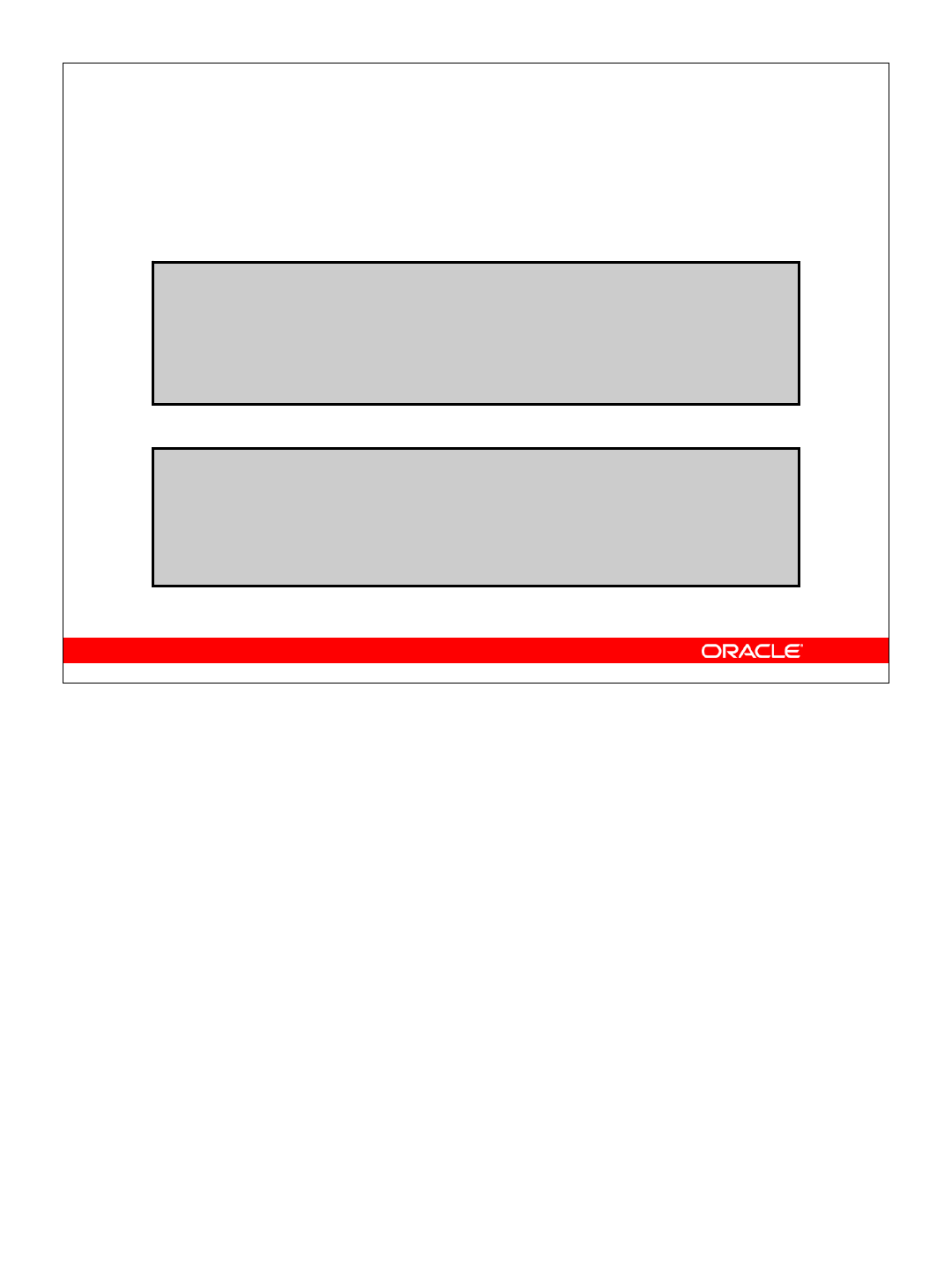
Oracle Database 10g: Develop PL/SQL Program Units C-8
C-8 Copyright © 2004, Oracle. All rights reserved.
Auditing Triggers by Using
Package Constructs
The AFTER statement trigger:
The AFTER row trigger:
CREATE OR REPLACE TRIGGER audit_emp_trg
AFTER UPDATE OR INSERT OR DELETE ON EMPLOYEES
FOR EACH ROW
-- Call Audit package to maintain counts
CALL audit_emp_pkg.set(INSERTING,UPDATING,DELETING);
/
CREATE OR REPLACE TRIGGER audit_empdml_trg
AFTER UPDATE OR INSERT OR DELETE on employees
BEGIN
audit_emp; -- write the audit data
END audit_emp_tab;
/
Auditing Triggers by Using Package Constructs (continued)
The AUDIT_EMP_TRIG trigger is a row trigger that fires after every row is manipulated.
This trigger invokes the package procedures depending on the type of DML performed.
For example, if the DML updates the salary of an employee, then the trigger invokes the
SET_G_UP_SAL procedure. This package procedure, in turn, invokes the G_UP_SAL
function. This function increments the GV_UP_SAL package variable that keeps account
of the number of rows being changed due to the update of the salary.
The AUDIT_EMP_TAB trigger fires after the statement has finished. This trigger invokes
the AUDIT_EMP procedure, which is explained on the following pages. The
AUDIT_EMP procedure updates the AUDIT_TABLE table. An entry is made into the
AUDIT_TABLE table with information such as the user who performed the DML, the
table on which DML is performed, and the total number of such data manipulations
performed so far on the table (indicated by the value of the corresponding column in the
AUDIT_TABLE table). At the end, the AUDIT_EMP procedure resets the package
variables to 0.

Oracle Database 10g: Develop PL/SQL Program Units C-9
C-9 Copyright © 2004, Oracle. All rights reserved.
AUDIT_PKG Package
CREATE OR REPLACE PACKAGE audit_emp_pkg IS
delcnt PLS_INTEGER := 0;
inscnt PLS_INTEGER := 0;
updcnt PLS_INTEGER := 0;
PROCEDURE init;
PROCEDURE set(i BOOLEAN,u BOOLEAN,d BOOLEAN);
END audit_emp_pkg;
/
CREATE OR REPLACE PACKAGE BODY audit_emp_pkg IS
PROCEDURE init IS
BEGIN
inscnt := 0; updcnt := 0; delcnt := 0;
END;
PROCEDURE set(i BOOLEAN,u BOOLEAN,d BOOLEAN) IS
BEGIN
IF i THEN inscnt := inscnt + 1;
ELSIF d THEN delcnt := delcnt + 1;
ELSE upd := updcnt + 1;
END IF;
END;
END audit_emp_pkg;
/
AUDIT_PKG Package
The AUDIT_PKG package declares public package variables (inscnt, updcnt,
delcnt) that are used to track the number of INSERT, UPDATE, and DELETE
operations performed. In the code example, they are declared publicly for simplicity.
However, it may be better to declare them as private variables to prevent them from being
directly modified. If the variables are declared privately, in the package body, you would
have to provide additional public subprograms to return their values to the user of the
package.
The init procedure is used to initialize the public package variables to zero.
The set procedure accepts three BOOLEAN arguments i, u, and dfor an INSERT,
UPDATE, or DELETE operation, respectively. The appropriate parameter value is set to
TRUE when the trigger that invokes the set procedure is fired during one of the DML
operations. A package variable is incremented by a value of 1, depending on which
argument value is TRUE when the set procedure is invoked.
Note: A DML trigger can fire once for each DML on each row. Therefore, only one of the
three variables passed to the set procedure can be TRUE at a given time. The remaining
two arguments will be set to the value FALSE.

Oracle Database 10g: Develop PL/SQL Program Units C-10
C-10 Copyright © 2004, Oracle. All rights reserved.
CREATE TABLE audit_table (
USER_NAME VARCHAR2(30),
TABLE_NAME VARCHAR2(30),
INS NUMBER,
UPD NUMBER,
DEL NUMBER)
/
CREATE OR REPLACE PROCEDURE audit_emp IS
BEGIN
IF delcnt + inscnt + updcnt <> 0 THEN
UPDATE audit_table
SET del = del + audit_emp_pkg.delcnt,
ins = ins + audit_emp_pkg.inscnt,
upd = upd + audit_emp_pkg.updcnt
WHERE user_name = USER
AND table_name = 'EMPLOYEES';
audit_emp_pkg.init;
END IF;
END audit_emp;
/
AUDIT_TABLE Table and
AUDIT_EMP Procedure
AUDIT_TABLE Table and AUDIT_EMP Procedure
The AUDIT_EMP procedure updates the AUDIT_TABLE table and calls the functions in
the AUDIT_EMP_PKG package that reset the package variables, ready for the next DML
statement.
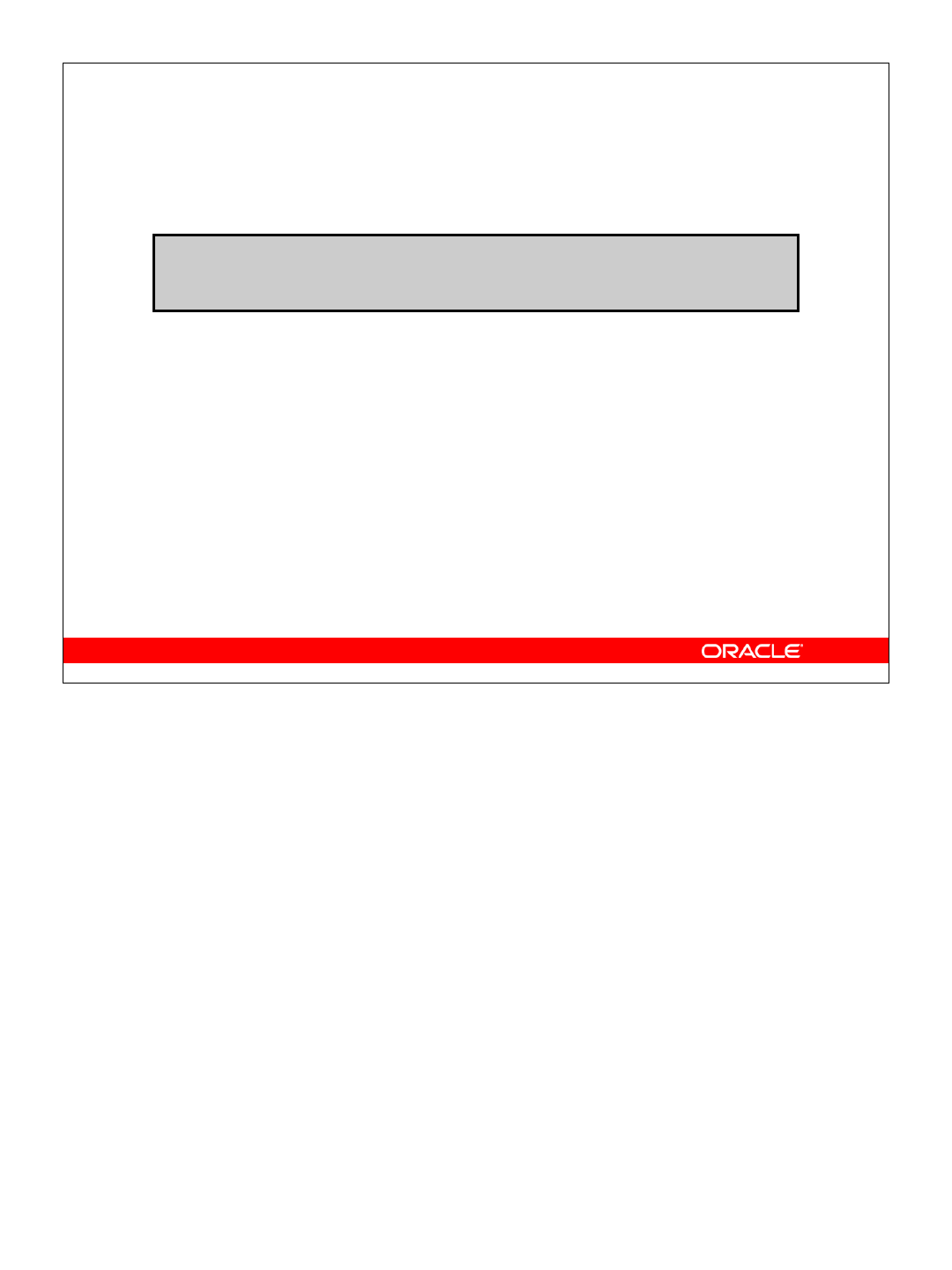
Oracle Database 10g: Develop PL/SQL Program Units C-11
C-11 Copyright © 2004, Oracle. All rights reserved.
ALTER TABLE employees ADD
CONSTRAINT ck_salary CHECK (salary >= 500);
Enforcing Data Integrity Within the Server
Table altered.
Enforcing Data Integrity Within the Server
You can enforce data integrity within the Oracle server and develop triggers to handle
more complex data integrity rules.
The standard data integrity rules are not null, unique, primary key, and foreign key.
Use these rules to:
• Provide constant default values
• Enforce static constraints
• Enable and disable dynamically
Example
The code sample in the slide ensures that the salary is at least $500.
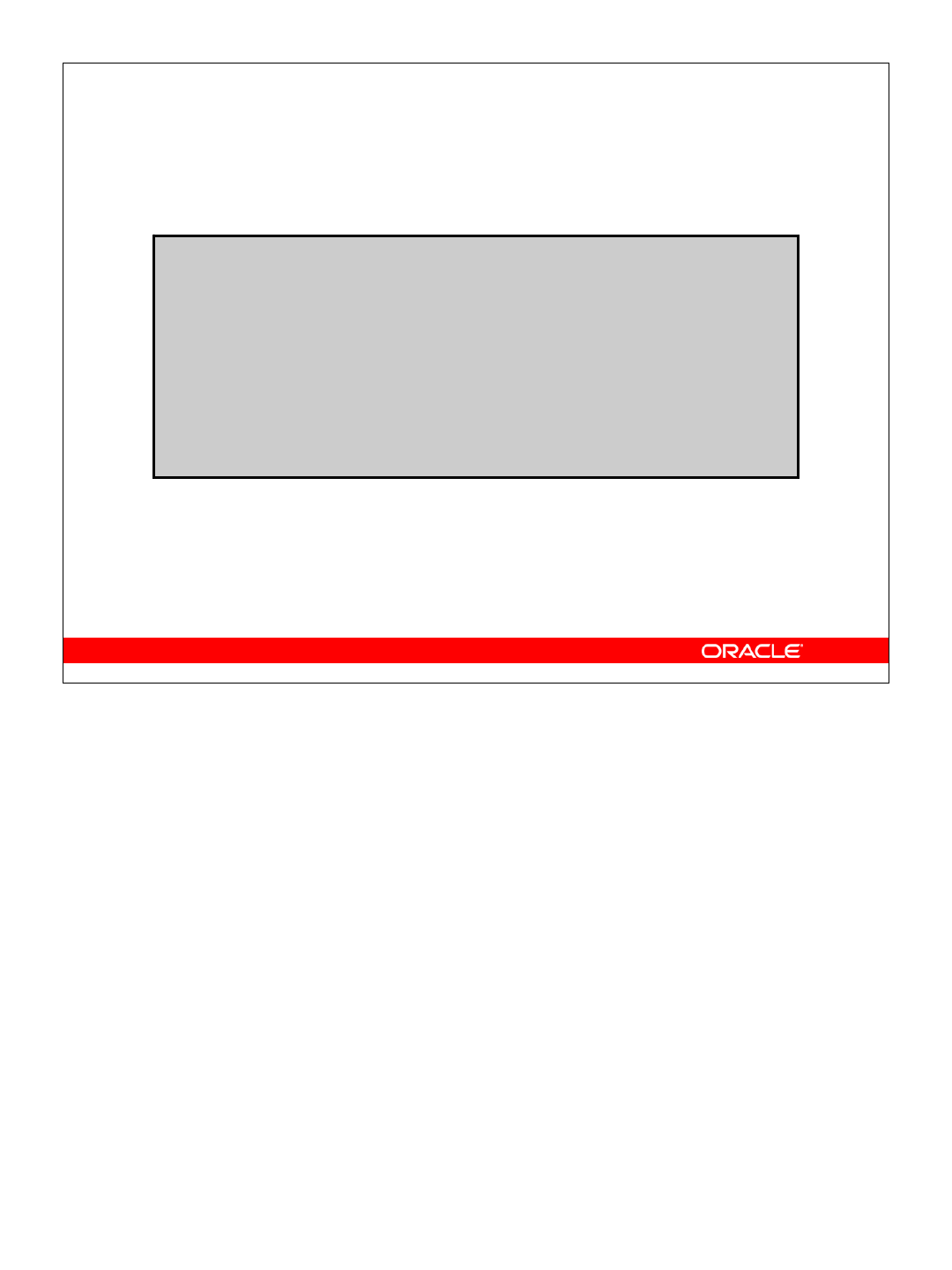
Oracle Database 10g: Develop PL/SQL Program Units C-12
C-12 Copyright © 2004, Oracle. All rights reserved.
CREATE OR REPLACE TRIGGER check_salary
BEFORE UPDATE OF salary ON employees
FOR EACH ROW
WHEN (NEW.salary < OLD.salary)
BEGIN
RAISE_APPLICATION_ERROR (-20508,
'Do not decrease salary.');
END;
/
Protecting Data Integrity with a Trigger
Protecting Data Integrity with a Trigger
Protect data integrity with a trigger and enforce nonstandard data integrity checks.
• Provide variable default values.
• Enforce dynamic constraints.
• Enable and disable dynamically.
• Incorporate declarative constraints within the definition of a table to protect data
integrity.
Example
The code sample in the slide ensures that the salary is never decreased.
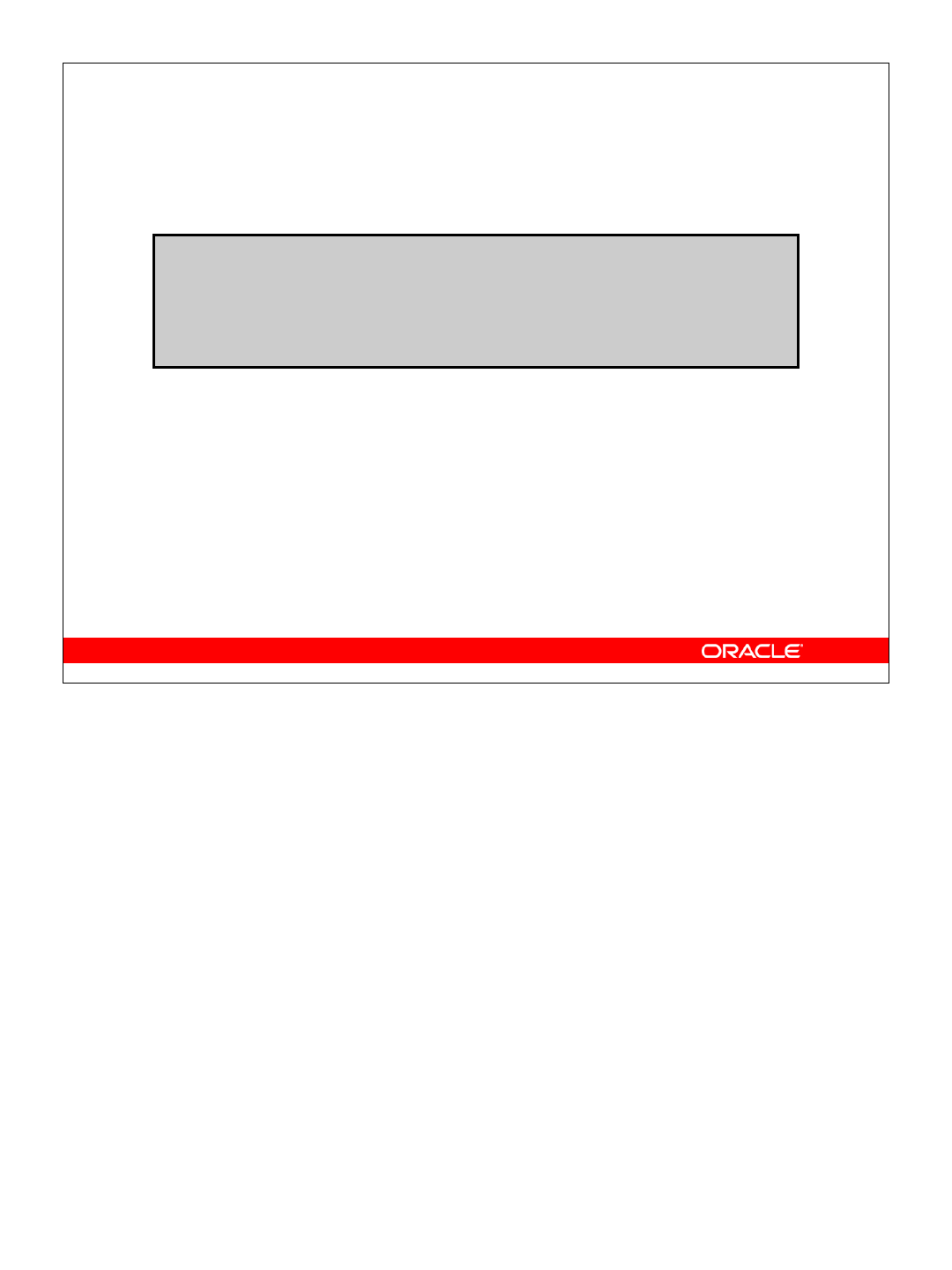
Oracle Database 10g: Develop PL/SQL Program Units C-13
C-13 Copyright © 2004, Oracle. All rights reserved.
ALTER TABLE employees
ADD CONSTRAINT emp_deptno_fk
FOREIGN KEY (department_id)
REFERENCES departments(department_id)
ON DELETE CASCADE;
Enforcing Referential Integrity
Within the Server
Enforcing Referential Integrity Within the Server
Incorporate referential integrity constraints within the definition of a table to prevent data
inconsistency and enforce referential integrity within the server.
• Restrict updates and deletes.
• Cascade deletes.
• Enable and disable dynamically.
Example
When a department is removed from the DEPARTMENTS parent table, cascade the
deletion to the corresponding rows in the EMPLOYEES child table.
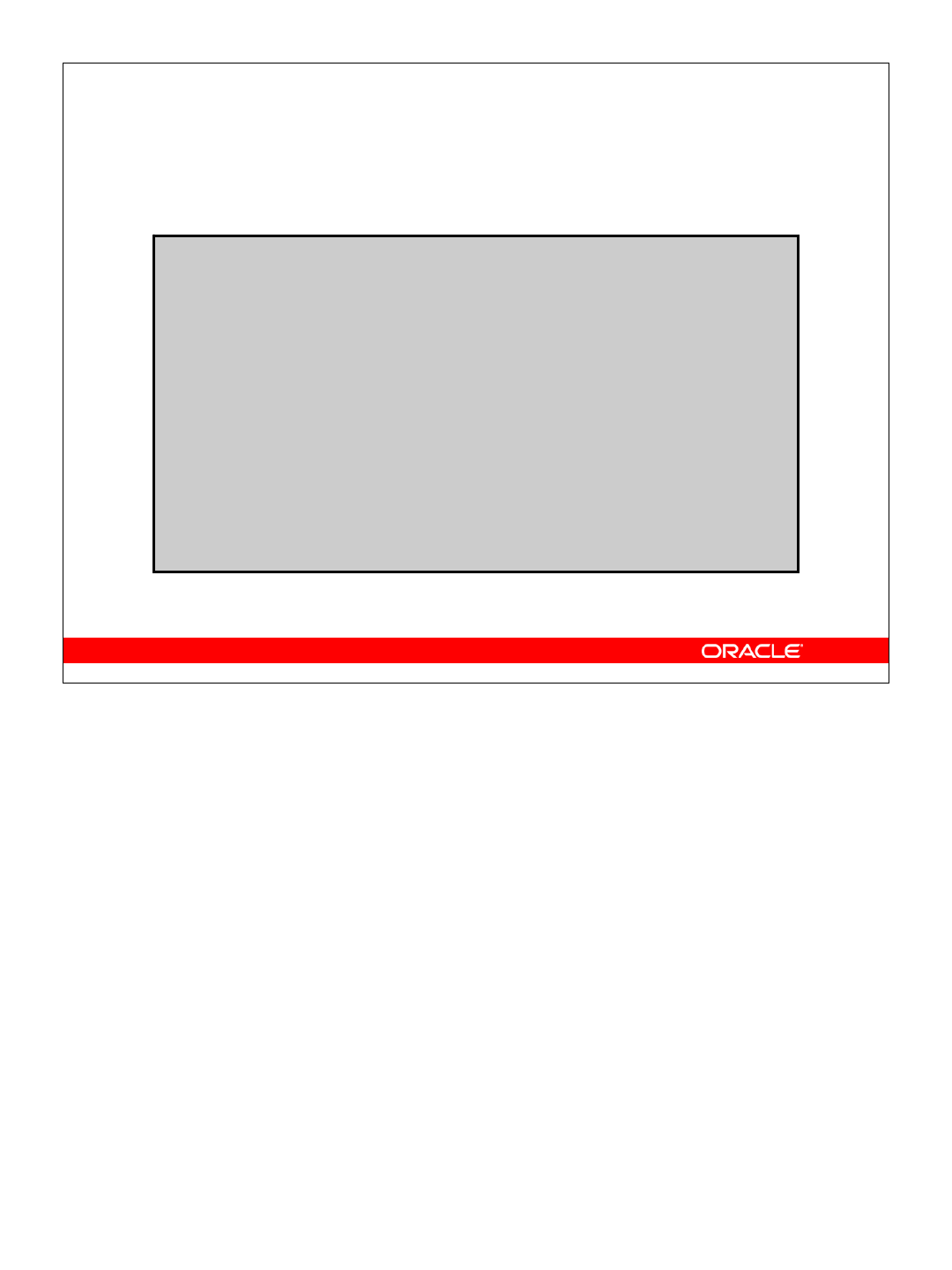
Oracle Database 10g: Develop PL/SQL Program Units C-14
C-14 Copyright © 2004, Oracle. All rights reserved.
CREATE OR REPLACE TRIGGER cascade_updates
AFTER UPDATE OF department_id ON departments
FOR EACH ROW
BEGIN
UPDATE employees
SET employees.department_id=:NEW.department_id
WHERE employees.department_id=:OLD.department_id;
UPDATE job_history
SET department_id=:NEW.department_id
WHERE department_id=:OLD.department_id;
END;
/
Protecting Referential Integrity
with a Trigger
Protecting Referential Integrity with a Trigger
The following referential integrity rules are not supported by declarative constraints:
• Cascade updates.
•Set to NULL for updates and deletions.
• Set to a default value on updates and deletions.
• Enforce referential integrity in a distributed system.
• Enable and disable dynamically.
You can develop triggers to implement these integrity rules.
Example
Enforce referential integrity with a trigger. When the value of DEPARTMENT_ID changes
in the DEPARTMENTS parent table, cascade the update to the corresponding rows in the
EMPLOYEES child table.
For a complete referential integrity solution using triggers, a single trigger is not enough.

Oracle Database 10g: Develop PL/SQL Program Units C-15
C-15 Copyright © 2004, Oracle. All rights reserved.
CREATE MATERIALIZED VIEW emp_copy
NEXT sysdate + 7
AS SELECT * FROM employees@ny;
Replicating a Table Within the Server
Creating a Materialized View
Materialized views enable you to maintain copies of remote data on your local node for
replication purposes. You can select data from a materialized view as you would from a
normal database table or view. A materialized view is a database object that contains the
results of a query, or a copy of some database on a query. The FROM clause of the query of
a materialized view can name tables, views, and other materialized views.
When a materialized view is used, replication is performed implicitly by the Oracle server.
This performs better than using user-defined PL/SQL triggers for replication. Materialized
views:
• Copy data from local and remote tables asynchronously, at user-defined intervals
• Can be based on multiple master tables
• Are read-only by default, unless using the Oracle Advanced Replication feature
• Improve the performance of data manipulation on the master table
Alternatively, you can replicate tables using triggers.
The example in the slide creates a copy of the remote EMPLOYEES table from New York.
The NEXT clause specifies a date time expression for the interval between automatic
refreshes.

Oracle Database 10g: Develop PL/SQL Program Units C-16
C-16 Copyright © 2004, Oracle. All rights reserved.
CREATE OR REPLACE TRIGGER emp_replica
BEFORE INSERT OR UPDATE ON employees FOR EACH ROW
BEGIN /* Proceed if user initiates data operation,
NOT through the cascading trigger.*/
IF INSERTING THEN
IF :NEW.flag IS NULL THEN
INSERT INTO employees@sf
VALUES(:new.employee_id,...,'B');
:NEW.flag := 'A';
END IF;
ELSE /* Updating. */
IF :NEW.flag = :OLD.flag THEN
UPDATE employees@sf
SET ename=:NEW.last_name,...,flag=:NEW.flag
WHERE employee_id = :NEW.employee_id;
END IF;
IF :OLD.flag = 'A' THEN :NEW.flag := 'B';
ELSE :NEW.flag := 'A';
END IF;
END IF;
END;
Replicating a Table with a Trigger
Replicating a Table with a Trigger
You can replicate a table with a trigger. By replicating a table, you can:
• Copy tables synchronously, in real time
• Base replicas on a single master table
• Read from replicas as well as write to them
Note: Excessive use of triggers can impair the performance of data manipulation on the
master table, particularly if the network fails.
Example
In New York, replicate the local EMPLOYEES table to San Francisco.
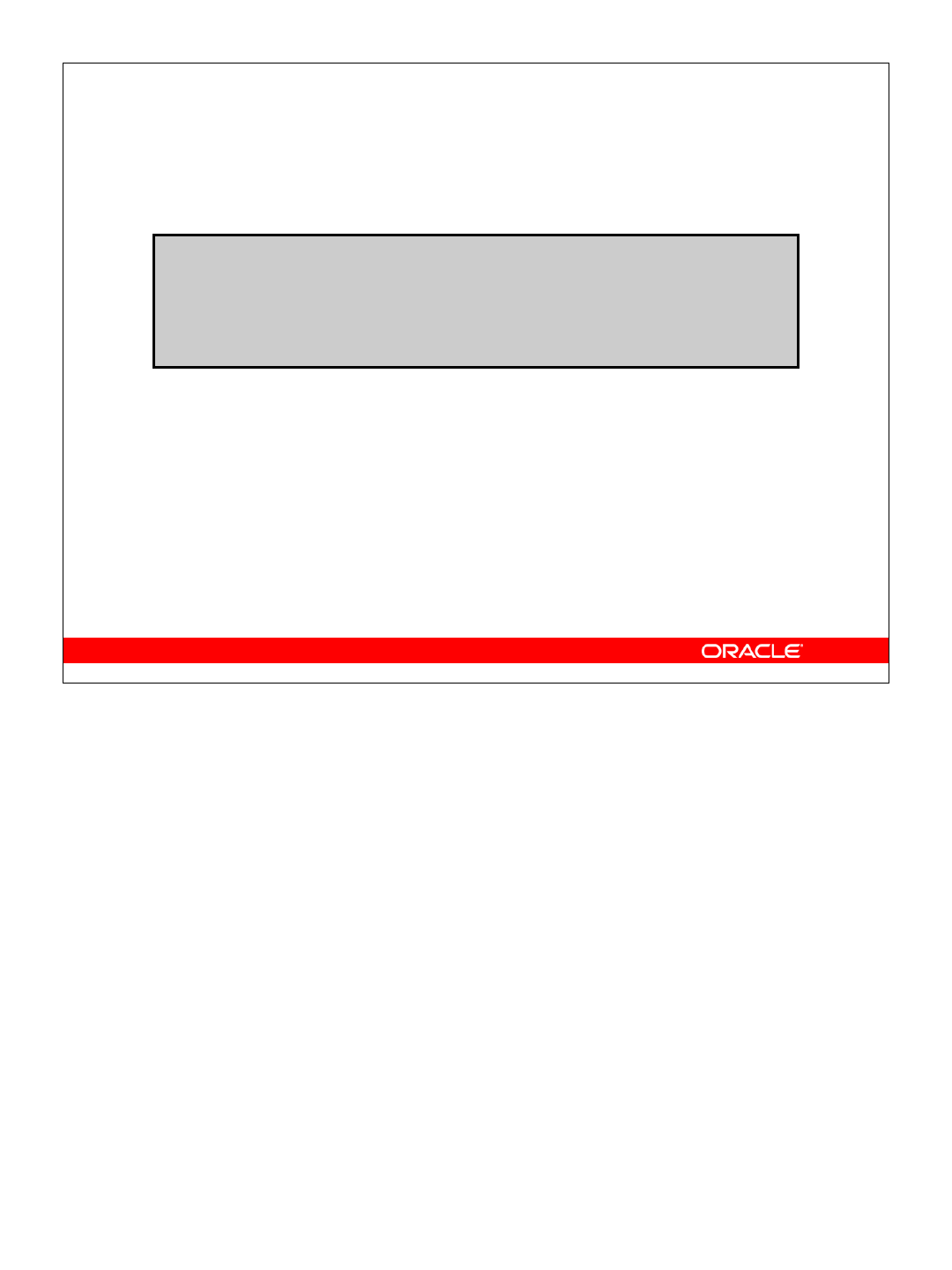
Oracle Database 10g: Develop PL/SQL Program Units C-17
C-17 Copyright © 2004, Oracle. All rights reserved.
Computing Derived Data Within the Server
UPDATE departments
SET total_sal=(SELECT SUM(salary)
FROM employees
WHERE employees.department_id =
departments.department_id);
Computing Derived Data Within the Server
By using the server, you can schedule batch jobs or use the database Scheduler for the
following scenarios:
• Compute derived column values asynchronously, at user-defined intervals.
• Store derived values only within database tables.
• Modify data in one pass to the database and calculate derived data in a second pass.
Alternatively, you can use triggers to keep running computations of derived data.
Example
Keep the salary total for each department within a special TOTAL_SALARY column of the
DEPARTMENTS table.

Oracle Database 10g: Develop PL/SQL Program Units C-18
C-18 Copyright © 2004, Oracle. All rights reserved.
CREATE PROCEDURE increment_salary
(id NUMBER, new_sal NUMBER) IS
BEGIN
UPDATE departments
SET total_sal = NVL (total_sal, 0)+ new_sal
WHERE department_id = id;
END increment_salary;
CREATE OR REPLACE TRIGGER compute_salary
AFTER INSERT OR UPDATE OF salary OR DELETE
ON employees FOR EACH ROW
BEGIN
IF DELETING THEN increment_salary(
:OLD.department_id,(-1*:OLD.salary));
ELSIF UPDATING THEN increment_salary(
:NEW.department_id,(:NEW.salary-:OLD.salary));
ELSE increment_salary(
:NEW.department_id,:NEW.salary); --INSERT
END IF;
END;
Computing Derived Values with a Trigger
Computing Derived Data Values with a Trigger
By using a trigger, you can perform the following tasks:
• Compute derived columns synchronously, in real time.
• Store derived values within database tables or within package global variables.
• Modify data and calculate derived data in a single pass to the database.
Example
Keep a running total of the salary for each department in the special TOTAL_SALARY
column of the DEPARTMENTS table.

Oracle Database 10g: Develop PL/SQL Program Units C-19
C-19 Copyright © 2004, Oracle. All rights reserved.
CREATE OR REPLACE TRIGGER notify_reorder_rep
BEFORE UPDATE OF quantity_on_hand, reorder_point
ON inventories FOR EACH ROW
DECLARE
dsc product_descriptions.product_description%TYPE;
msg_text VARCHAR2(2000);
BEGIN
IF :NEW.quantity_on_hand <=
:NEW.reorder_point THEN
SELECT product_description INTO dsc
FROM product_descriptions
WHERE product_id = :NEW.product_id;
_ msg_text := 'ALERT: INVENTORY LOW ORDER:'||
'Yours,' ||CHR(10) ||user || '.'|| CHR(10);
ELSIF :OLD.quantity_on_hand >=
:NEW.quantity_on_hand THEN
msg_text := 'Product #'||... CHR(10);
END IF;
UTL_MAIL.SEND('inv@oracle.com','ord@oracle.com',
message=>msg_text, subject=>'Inventory Notice');
END;
Logging Events with a Trigger
Logging Events with a Trigger
In the server, you can log events by querying data and performing operations manually.
This sends an e-mail message when the inventory for a particular product has fallen below
the acceptable limit. This trigger uses the Oracle-supplied package UTL_MAIL to send the
e-mail message.
Logging Events Within the Server
1. Query data explicitly to determine whether an operation is necessary.
2. Perform the operation, such as sending a message.
Using Triggers to Log Events
1. Perform operations implicitly, such as firing off an automatic electronic memo.
2. Modify data and perform its dependent operation in a single step.
3. Log events automatically as data is changing.

Oracle Database 10g: Develop PL/SQL Program Units C-20
Logging Events with a Trigger (continued)
Logging Events Transparently
In the trigger code:
• CHR(10) is a carriage return
•Reorder_point is not NULL
• Another transaction can receive and read the message in the pipe
Example
CREATE OR REPLACE TRIGGER notify_reorder_rep
BEFORE UPDATE OF amount_in_stock, reorder_point
ON inventory FOR EACH ROW
DECLARE
dsc product.descrip%TYPE;
msg_text VARCHAR2(2000);
BEGIN
IF :NEW.amount_in_stock <= :NEW.reorder_point THEN
SELECT descrip INTO dsc
FROM PRODUCT WHERE prodid = :NEW.product_id;
msg_text := 'ALERT: INVENTORY LOW ORDER:'||CHR(10)||
'It has come to my personal attention that, due to recent'
||CHR(10)||'transactions, our inventory for product # '||
TO_CHAR(:NEW.product_id)||'-- '|| dsc ||
' -- has fallen below acceptable levels.' || CHR(10) ||
'Yours,' ||CHR(10) ||user || '.'|| CHR(10)|| CHR(10);
ELSIF :OLD.amount_in_stock >= :NEW.amount_in_stock THEN
msg_text := 'Product #'|| TO_CHAR(:NEW.product_id)
||' ordered. '|| CHR(10)|| CHR(10);
END IF;
UTL_MAIL.SEND('inv@oracle.com', 'ord@oracle.com',
message => msg_text, subject => 'Inventory Notice');
END;

Oracle Database 10g: Develop PL/SQL Program Units C-21
C-21 Copyright © 2004, Oracle. All rights reserved.
Summary
In this lesson, you should have learned how to:
•Use database triggers or database server
functionality to:
–Enhance database security
–Audit data changes
–Enforce data integrity
–Maintain referential integrity
–Replicate data between tables
–Automate computation of derived data
–Provide event-logging capabilities
•Recognize when to use triggers to database
functionality
Summary
This lesson provides some detailed comparison of using the Oracle database server
functionality to implement security, auditing, data integrity, replication, and logging. The
lesson also covers how database triggers can be used to implement the same features but
go further to enhance the features that the database server provides. In some cases, you
must use a trigger to perform some activities (such as computation of derived data)
because the Oracle server cannot know how to implement this kind of business rule
without some programming effort.


Copyright © 2004, Oracle. All rights reserved.
Review of PL/SQL

Oracle Database 10g: Develop PL/SQL Program Units D-2
D-2 Copyright © 2004, Oracle. All rights reserved.
Block Structure for Anonymous
PL/SQL Blocks
•DECLARE (optional)
–Declare PL/SQL objects to be used within this block
•BEGIN (mandatory)
–Define the executable statements
•EXCEPTION (optional)
–Define the actions that take place if an error or
exception arises
•END; (mandatory)
Anonymous Blocks
Anonymous blocks do not have names. You declare them at the point in an application
where they are to be run, and they are passed to the PL/SQL engine for execution at run
time.
• The section between the keywords DECLARE and BEGIN is referred to as the
declaration section. In the declaration section, you define the PL/SQL objects such as
variables, constants, cursors, and user-defined exceptions that you want to reference
within the block. The DECLARE keyword is optional if you do not declare any
PL/SQL objects.
• The BEGIN and END keywords are mandatory and enclose the body of actions to be
performed. This section is referred to as the executable section of the block.
• The section between EXCEPTION and END is referred to as the exception section.
The exception section traps error conditions. In it, you define actions to take if a
specified condition arises. The exception section is optional.
The keywords DECLARE, BEGIN, and EXCEPTION are not followed by semicolons, but
END and all other PL/SQL statements do require semicolons.
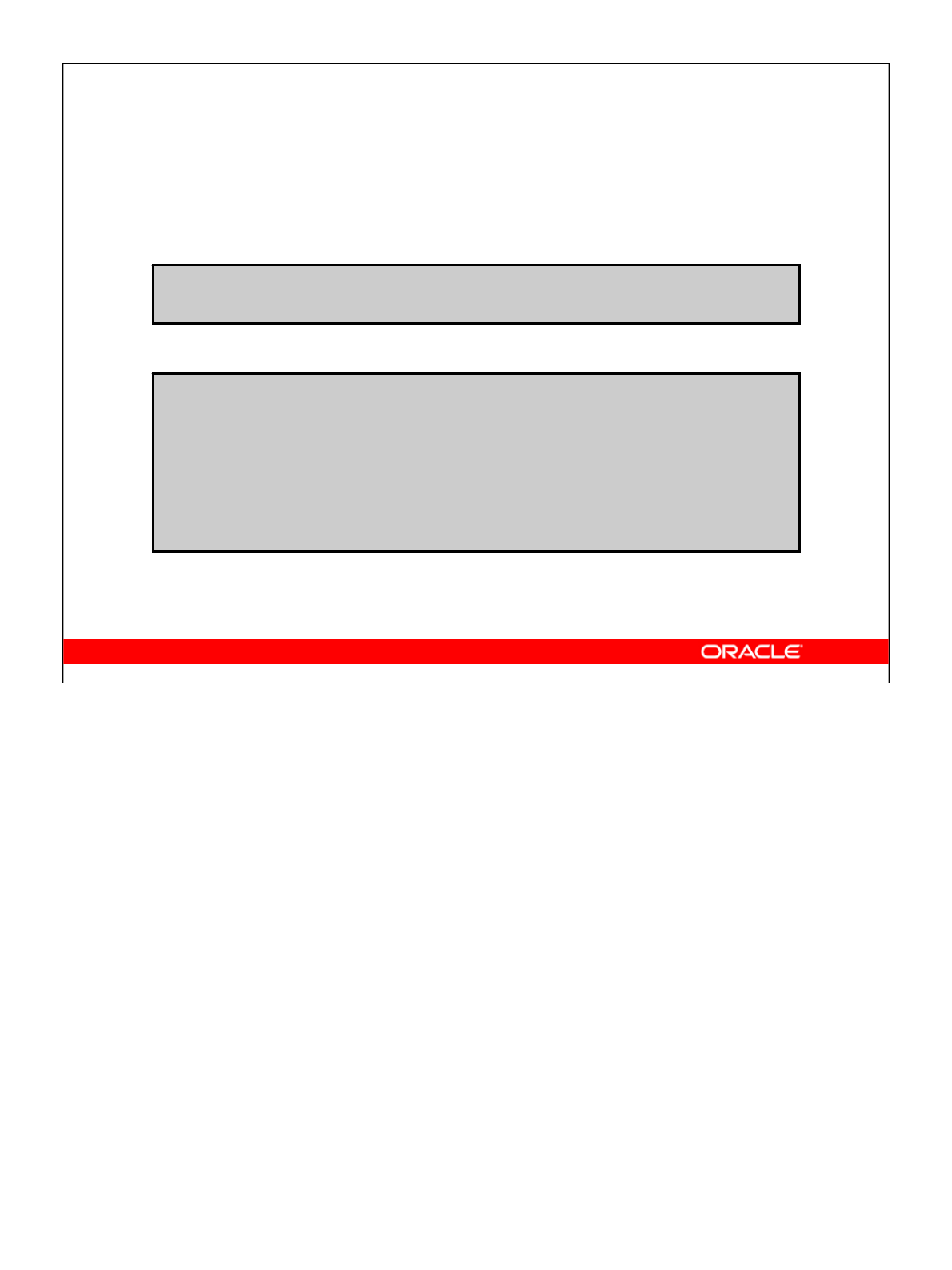
Oracle Database 10g: Develop PL/SQL Program Units D-3
D-3 Copyright © 2004, Oracle. All rights reserved.
Declaring PL/SQL Variables
•Syntax:
•Examples:
identifier [CONSTANT] datatype [NOT NULL]
[:= | DEFAULT expr];
Declare
v_hiredate DATE;
v_deptno NUMBER(2) NOT NULL := 10;
v_location VARCHAR2(13) := 'Atlanta';
c_ comm CONSTANT NUMBER := 1400;
v_count BINARY_INTEGER := 0;
v_valid BOOLEAN NOT NULL := TRUE;
Declaring PL/SQL Variables
You need to declare all PL/SQL identifiers within the declaration section before
referencing them within the PL/SQL block. You have the option to assign an initial value.
You do not need to assign a value to a variable in order to declare it. If you refer to other
variables in a declaration, you must be sure to declare them separately in a previous
statement.
In the syntax,
Identifier Is the name of the variable
CONSTANT Constrains the variable so that its value cannot change; constants
must be initialized.
datatype Is a scalar, composite, reference, or LOB data type (This course
covers only scalar and composite data types.)
NOT NULL Constrains the variable so that it must contain a value; NOT
NULL variables must be initialized.
expr Is any PL/SQL expression that can be a literal, another variable, or
an expression involving operators and functions

Oracle Database 10g: Develop PL/SQL Program Units D-4
D-4 Copyright © 2004, Oracle. All rights reserved.
Declaring Variables with the
%TYPE Attribute
Examples:
...
v_ename employees.last_name%TYPE;
v_balance NUMBER(7,2);
v_min_balance v_balance%TYPE := 10;
...
Declaring Variables with the %TYPE Attribute
Declare variables to store the name of an employee.
...
v_ename employees.last_name%TYPE;
...
Declare variables to store the balance of a bank account, as well as the minimum balance,
which starts out as 10.
...
v_balance NUMBER(7,2);
v_min_balance v_balance%TYPE := 10;
...
A NOT NULL column constraint does not apply to variables declared using %TYPE.
Therefore, if you declare a variable using the %TYPE attribute and a database column
defined as NOT NULL, then you can assign the NULL value to the variable.

Oracle Database 10g: Develop PL/SQL Program Units D-5
D-5 Copyright © 2004, Oracle. All rights reserved.
Creating a PL/SQL Record
Declare variables to store the name, job, and salary of
a new employee.
Example:
...
TYPE emp_record_type IS RECORD
(ename VARCHAR2(25),
job VARCHAR2(10),
sal NUMBER(8,2));
emp_record emp_record_type;
...
Creating a PL/SQL Record
Field declarations are like variable declarations. Each field has a unique name and a
specific data type. There are no predefined data types for PL/SQL records, as there are for
scalar variables. Therefore, you must create the data type first and then declare an
identifier using that data type.
The following example shows that you can use the %TYPE attribute to specify a field data
type:
DECLARE
TYPE emp_record_type IS RECORD
(empid NUMBER(6) NOT NULL := 100,
ename employees.last_name%TYPE,
job employees.job_id%TYPE);
emp_record emp_record_type;
...
Note: You can add the NOT NULL constraint to any field declaration and so prevent the
assigning of nulls to that field. Remember, fields declared as NOT NULL must be
initialized.
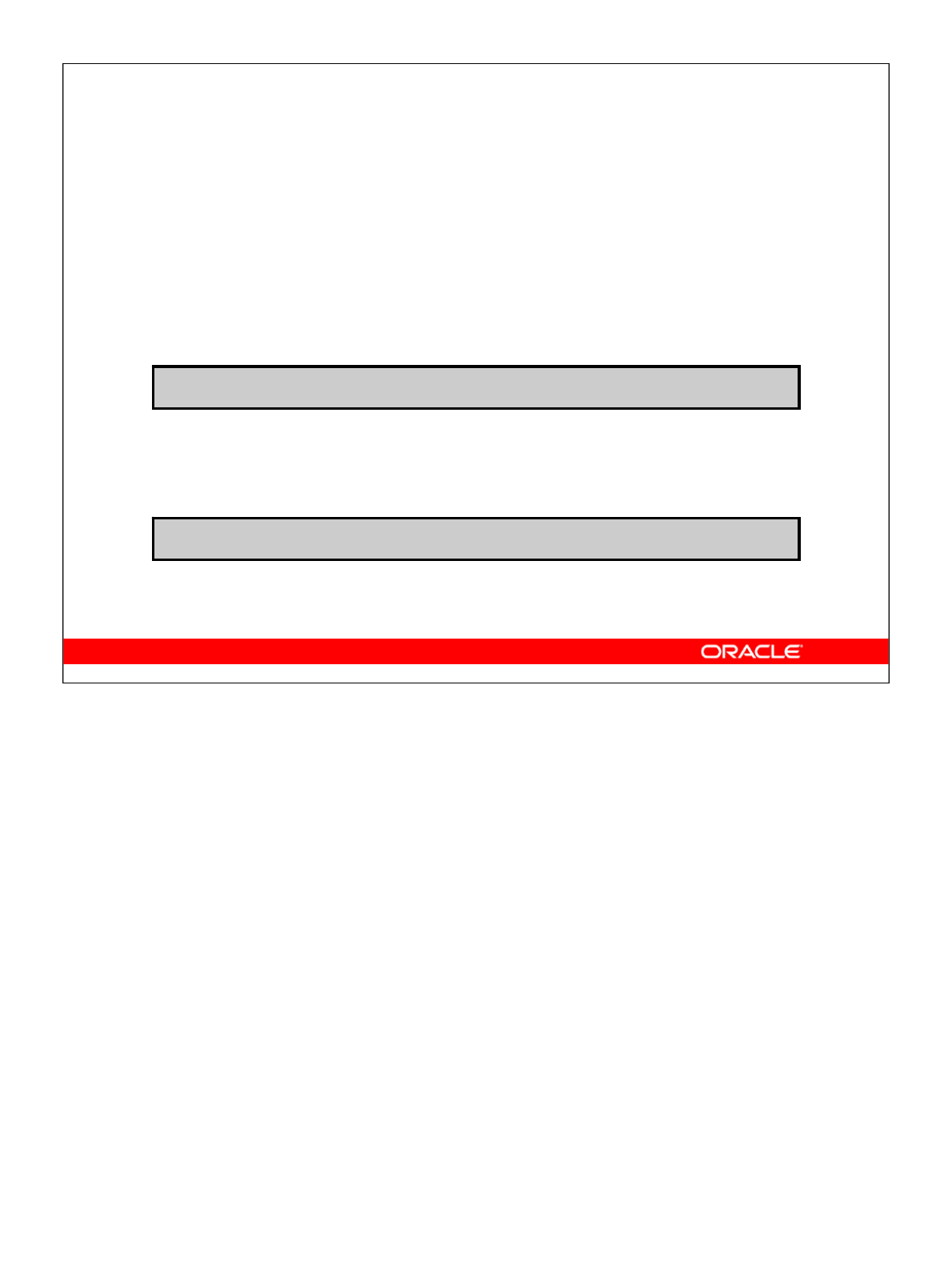
Oracle Database 10g: Develop PL/SQL Program Units D-6
D-6 Copyright © 2004, Oracle. All rights reserved.
%ROWTYPE Attribute
Examples:
•Declare a variable to store the same information
about a department as is stored in the
DEPARTMENTS table.
•Declare a variable to store the same information
about an employee as is stored in the EMPLOYEES
table.
dept_record departments%ROWTYPE;
emp_record employees%ROWTYPE;
Examples
The first declaration in the slide creates a record with the same field names and field data
types as a row in the DEPARTMENTS table. The fields are DEPARTMENT_ID,
DEPARTMENT_NAME, MANAGER_ID, and LOCATION_ID.
The second declaration in the slide creates a record with the same field names and field
data types as a row in the EMPLOYEES table. The fields are EMPLOYEE_ID,
FIRST_NAME, LAST_NAME, EMAIL, PHONE_NUMBER, HIRE_DATE, JOB_ID,
SALARY, COMMISSION_PCT, MANAGER_ID, and DEPARTMENT_ID.
In the following example, you select column values into a record named item_record.
DECLARE
job_record jobs%ROWTYPE;
...
BEGIN
SELECT * INTO job_record
FROM jobs
WHERE ...

Oracle Database 10g: Develop PL/SQL Program Units D-7
D-7 Copyright © 2004, Oracle. All rights reserved.
Creating a PL/SQL Table
DECLARE
TYPE ename_table_type IS TABLE OF
employees.last_name%TYPE
INDEX BY BINARY_INTEGER;
TYPE hiredate_table_type IS TABLE OF DATE
INDEX BY BINARY_INTEGER;
ename_table ename_table_type;
hiredate_table hiredate_table_type;
BEGIN
ename_table(1) := 'CAMERON';
hiredate_table(8) := SYSDATE + 7;
IF ename_table.EXISTS(1) THEN
INSERT INTO ...
...
END;
Creating a PL/SQL Table
There are no predefined data types for PL/SQL records, as there are for scalar variables.
Therefore, you must create the data type first and then declare an identifier using that data
type.
Referencing a PL/SQL Table
Syntax
pl/sql_table_name(primary_key_value)
In this syntax, primary_key_value belongs to type BINARY_INTEGER.
Reference the third row in a PL/SQL table ENAME_TABLE.
ename_table(3) ...
The magnitude range of a BINARY_INTEGER is –2147483647 to 2147483647. The
primary key value can therefore be negative. Indexing need not start with 1.
Note: The table.EXISTS(i)statement returns TRUE if at least one row with index i
is returned. Use the EXISTS statement to prevent an error that is raised in reference to a
nonexistent table element.

Oracle Database 10g: Develop PL/SQL Program Units D-8
D-8 Copyright © 2004, Oracle. All rights reserved.
SELECT Statements in PL/SQL
The INTO clause is mandatory.
Example:
DECLARE
v_deptid NUMBER(4);
v_loc NUMBER(4);
BEGIN
SELECT department_id, location_id
INTO v_deptno, v_loc
FROM departments
WHERE department_name = 'Sales';
...
END;
INTO Clause
The INTO clause is mandatory and occurs between the SELECT and FROM clauses. It is
used to specify the names of variables to hold the values that SQL returns from the
SELECT clause. You must give one variable for each item selected, and the order of
variables must correspond to the items selected.
You use the INTO clause to populate either PL/SQL variables or host variables.
Queries Must Return One and Only One Row
SELECT statements within a PL/SQL block fall into the ANSI classification of Embedded
SQL, for which the following rule applies:
Queries must return one and only one row. More than one row or no row generates an
error.
PL/SQL deals with these errors by raising standard exceptions, which you can trap in the
exception section of the block with the NO_DATA_FOUND and TOO_MANY_ROWS
exceptions. You should code SELECT statements to return a single row.
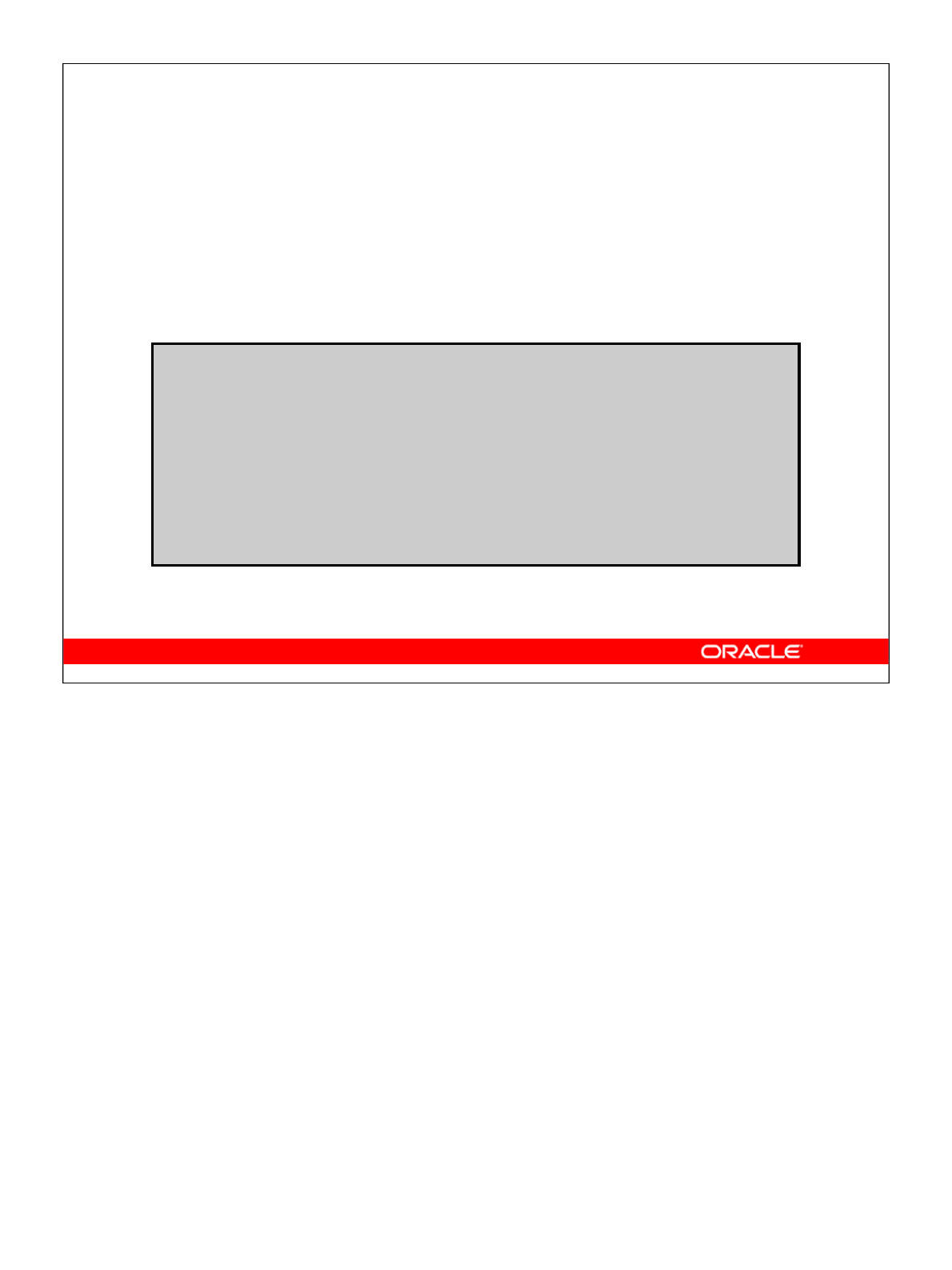
Oracle Database 10g: Develop PL/SQL Program Units D-9
D-9 Copyright © 2004, Oracle. All rights reserved.
Inserting Data
Add new employee information to the EMPLOYEES
table.
Example:
DECLARE
v_empid employees.employee_id%TYPE;
BEGIN
SELECT employees_seq.NEXTVAL
INTO v_empno
FROM dual;
INSERT INTO employees(employee_id, last_name,
job_id, department_id)
VALUES(v_empno, 'HARDING', 'PU_CLERK', 30);
END;
Inserting Data
• Use SQL functions, such as USER and SYSDATE.
• Generate primary key values by using database sequences.
• Derive values in the PL/SQL block.
• Add column default values.
Note: There is no possibility for ambiguity with identifiers and column names in the
INSERT statement. Any identifier in the INSERT clause must be a database column
name.
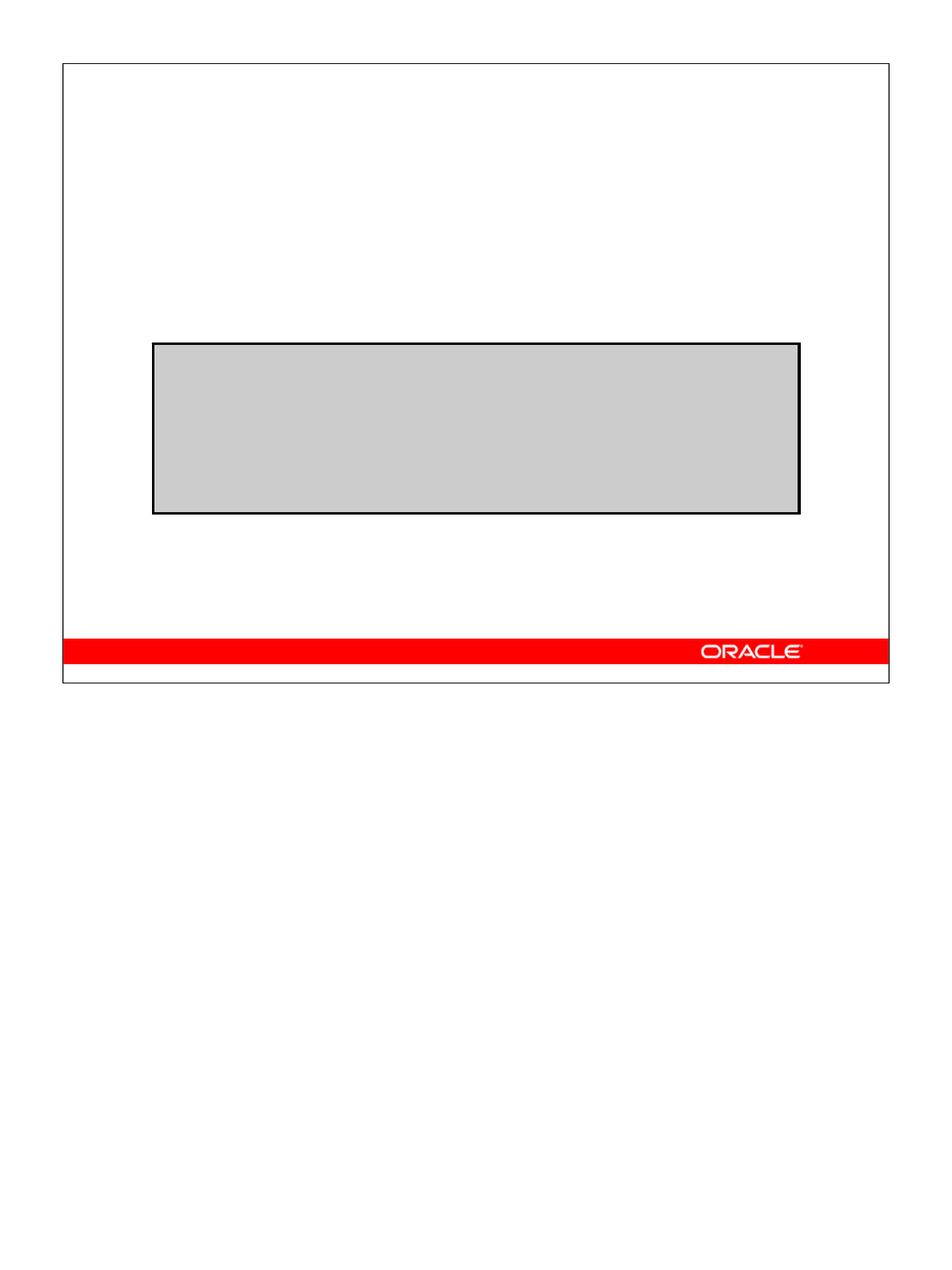
Oracle Database 10g: Develop PL/SQL Program Units D-10
D-10 Copyright © 2004, Oracle. All rights reserved.
Updating Data
Increase the salary of all employees in the EMPLOYEES
table who are purchasing clerks.
Example:
DECLARE
v_sal_increase employees.salary%TYPE := 2000;
BEGIN
UPDATE employees
SET salary = salary + v_sal_increase
WHERE job_id = 'PU_CLERK';
END;
Updating Data
There may be ambiguity in the SET clause of the UPDATE statement, because although
the identifier on the left of the assignment operator is always a database column, the
identifier on the right can be either a database column or a PL/SQL variable.
Remember that the WHERE clause is used to determine which rows are affected. If no rows
are modified, no error occurs (unlike the SELECT statement in PL/SQL).
Note: PL/SQL variable assignments always use := and SQL column assignments always
use =.. Remember that if column names and identifier names are identical in the WHERE
clause, the Oracle server looks to the database first for the name.
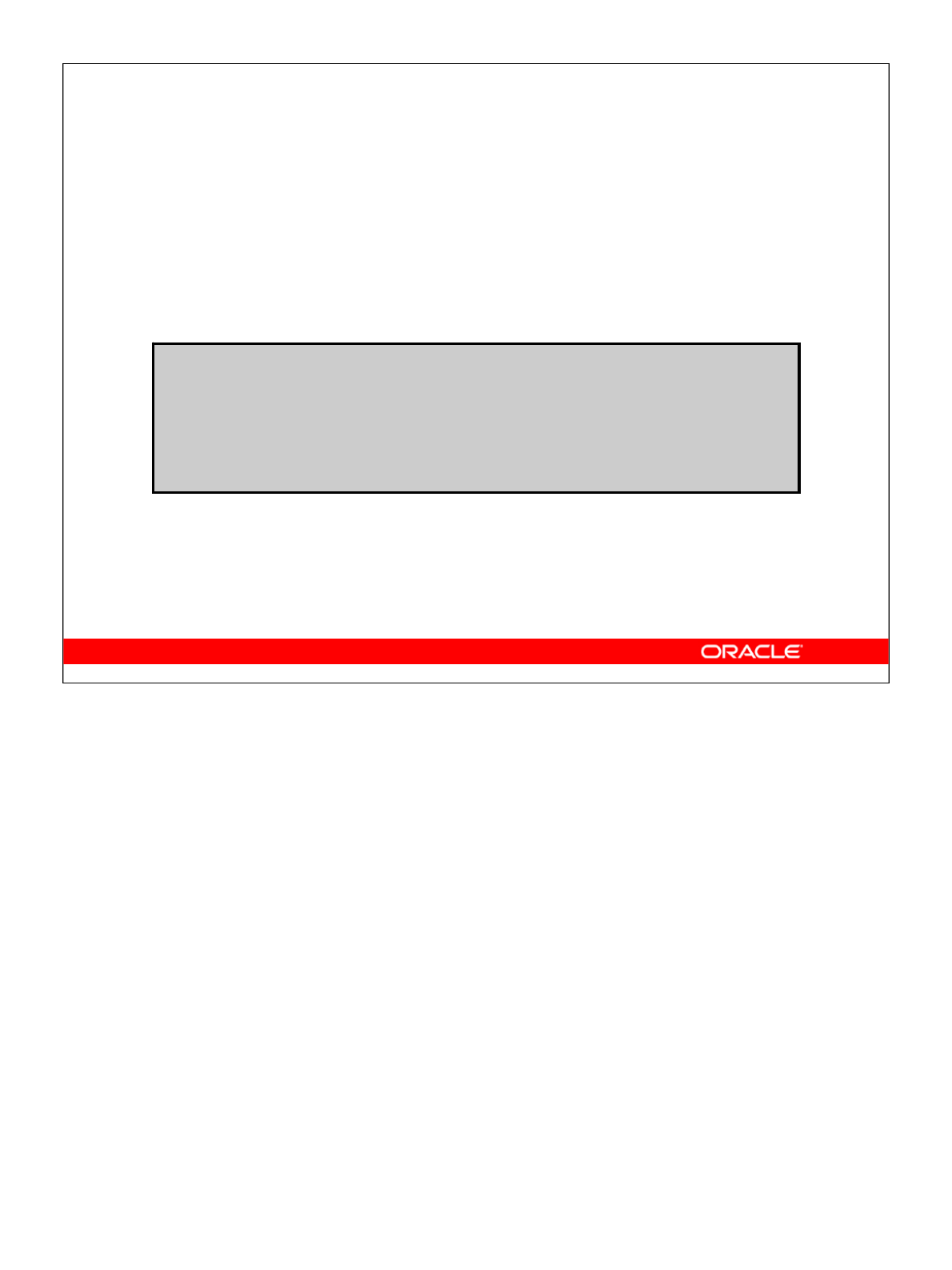
Oracle Database 10g: Develop PL/SQL Program Units D-11
D-11 Copyright © 2004, Oracle. All rights reserved.
Deleting Data
Delete rows that belong to department 190 from the
EMPLOYEES table.
Example:
DECLARE
v_deptid employees.department_id%TYPE := 190;
BEGIN
DELETE FROM employees
WHERE department_id = v_deptid;
END;
Deleting Data
Delete a specific job:
DECLARE
v_jobid jobs.job_id%TYPE := ‘PR_REP’;
BEGIN
DELETE FROM jobs
WHERE job_id = v_jobid;
END;

Oracle Database 10g: Develop PL/SQL Program Units D-12
D-12 Copyright © 2004, Oracle. All rights reserved.
COMMIT and ROLLBACK Statements
•Initiate a transaction with the first DML command
to follow a COMMIT or ROLLBACK statement.
•Use COMMIT and ROLLBACK SQL statements to
terminate a transaction explicitly.
Controlling Transactions
You control the logic of transactions with COMMIT and ROLLBACK SQL statements,
rendering some groups of database changes permanent while discarding others. As with
the Oracle server, DML transactions start at the first command to follow a COMMIT or
ROLLBACK and end on the next successful COMMIT or ROLLBACK. These actions may
occur within a PL/SQL block or as a result of events in the host environment. A COMMIT
ends the current transaction by making all pending changes to the database permanent.
Syntax COMMIT [WORK];
ROLLBACK [WORK];
In this syntax, WORK is for compliance with ANSI standards.
Note: The transaction control commands are all valid within PL/SQL, although the host
environment may place some restriction on their use.
You can also include explicit locking commands (such as LOCK TABLE and SELECT
... FOR UPDATE) in a block. They stay in effect until the end of the transaction. Also,
one PL/SQL block does not necessarily imply one transaction.

Oracle Database 10g: Develop PL/SQL Program Units D-13
D-13 Copyright © 2004, Oracle. All rights reserved.
SQL Cursor Attributes
Using SQL cursor attributes, you can test the outcome
of your SQL statements.
Number of rows affected by the most recent
SQL statement (an integer value)
Boolean attribute that evaluates to TRUE if
the most recent SQL statement affects one
or more rows
Boolean attribute that evaluates to TRUE if
the most recent SQL statement does not
affect any rows
Always evaluates to FALSE because PL/SQL
closes implicit cursors immediately after
they are executed
SQL%ROWCOUNT
SQL%FOUND
SQL%NOTFOUND
SQL%ISOPEN
SQL Cursor Attributes
SQL cursor attributes enable you to evaluate what happened when the implicit cursor was
last used. You use these attributes in PL/SQL statements such as functions. You cannot use
them in SQL statements.
You can use the attributes SQL%ROWCOUNT, SQL%FOUND, SQL%NOTFOUND, and
SQL%ISOPEN in the exception section of a block to gather information about the
execution of a DML statement. In PL/SQL, a DML statement that does not change any
rows is not seen as an error condition, whereas the SELECT statement will return an
exception if it cannot locate any rows.
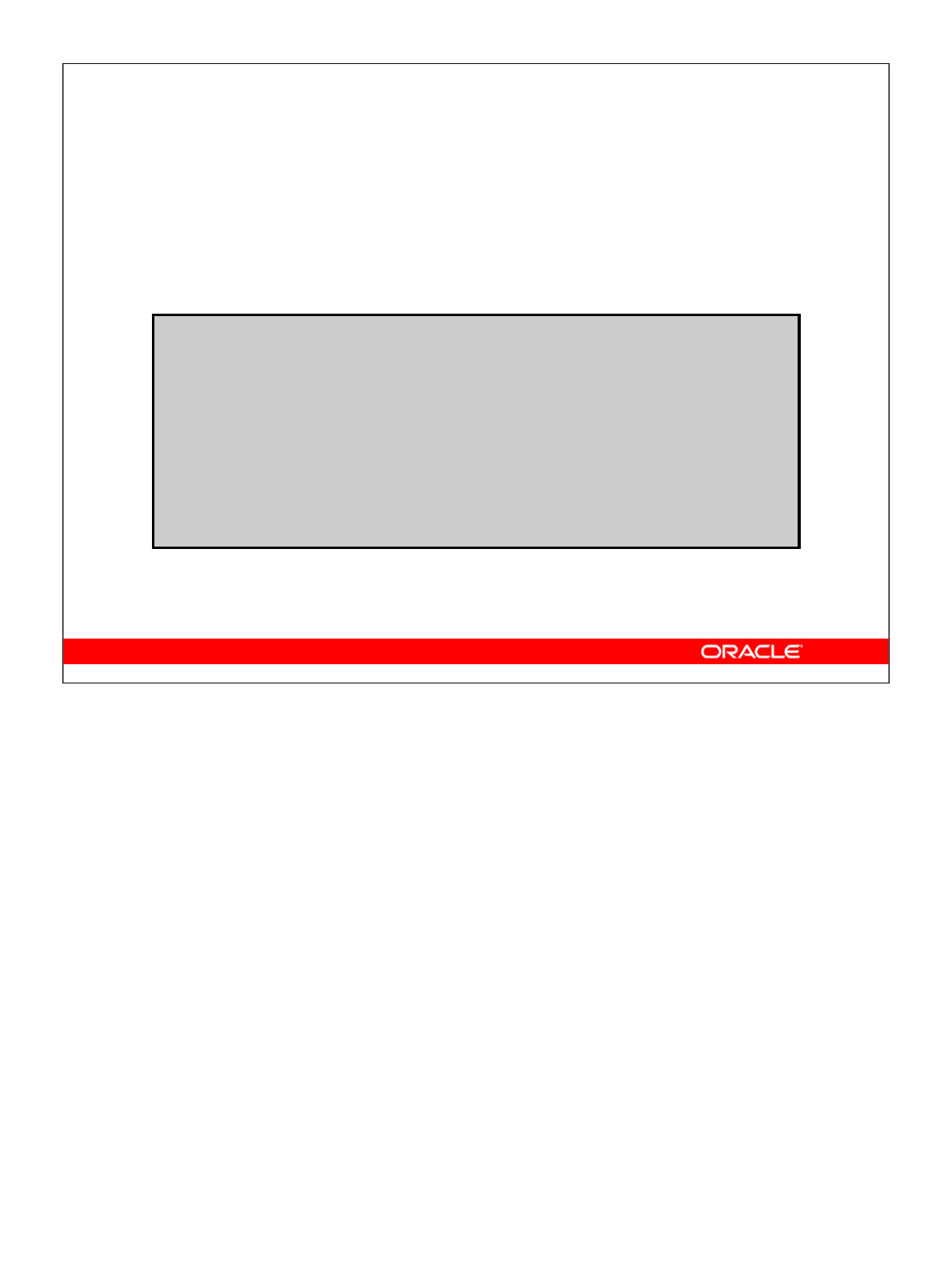
Oracle Database 10g: Develop PL/SQL Program Units D-14
D-14 Copyright © 2004, Oracle. All rights reserved.
IF, THEN, and ELSIF Statements
For a given value entered, return a calculated value.
Example:
. . .
IF v_start > 100 THEN
v_start := 2 * v_start;
ELSIF v_start >= 50 THEN
v_start := 0.5 * v_start;
ELSE
v_start := 0.1 * v_start;
END IF;
. . .
IF, THEN, and ELSIF Statements
When possible, use the ELSIF clause instead of nesting IF statements. The code is easier
to read and understand, and the logic is clearly identified. If the action in the ELSE clause
consists purely of another IF statement, it is more convenient to use the ELSIF clause.
This makes the code clearer by removing the need for nested END IFs at the end of each
further set of conditions and actions.
Example IF condition1 THEN
statement1;
ELSIF condition2 THEN
statement2;
ELSIF condition3 THEN
statement3;
END IF;
The IF, THEN, and ELSIF statement in the slide is further defined as follows:
For a given value entered, return a calculated value. If the entered value is over 100, then
the calculated value is two times the entered value. If the entered value is between 50 and
100, then the calculated value is 50% of the starting value. If the entered value is less than
50, then the calculated value is 10% of the starting value.
Note: Any arithmetic expression containing null values evaluates to null.

Oracle Database 10g: Develop PL/SQL Program Units D-15
D-15 Copyright © 2004, Oracle. All rights reserved.
Basic Loop
Example:
DECLARE
v_ordid order_items.order_id%TYPE := 101;
v_counter NUMBER(2) := 1;
BEGIN
LOOP
INSERT INTO order_items(order_id,line_item_id)
VALUES(v_ordid, v_counter);
v_counter := v_counter + 1;
EXIT WHEN v_counter > 10;
END LOOP;
END;
Basic Loop
The basic loop example shown in the slide is defined as follows:
Insert the first 10 new line items for order number 101.
Note: A basic loop enables execution of its statements at least once, even if the condition
has been met upon entering the loop.
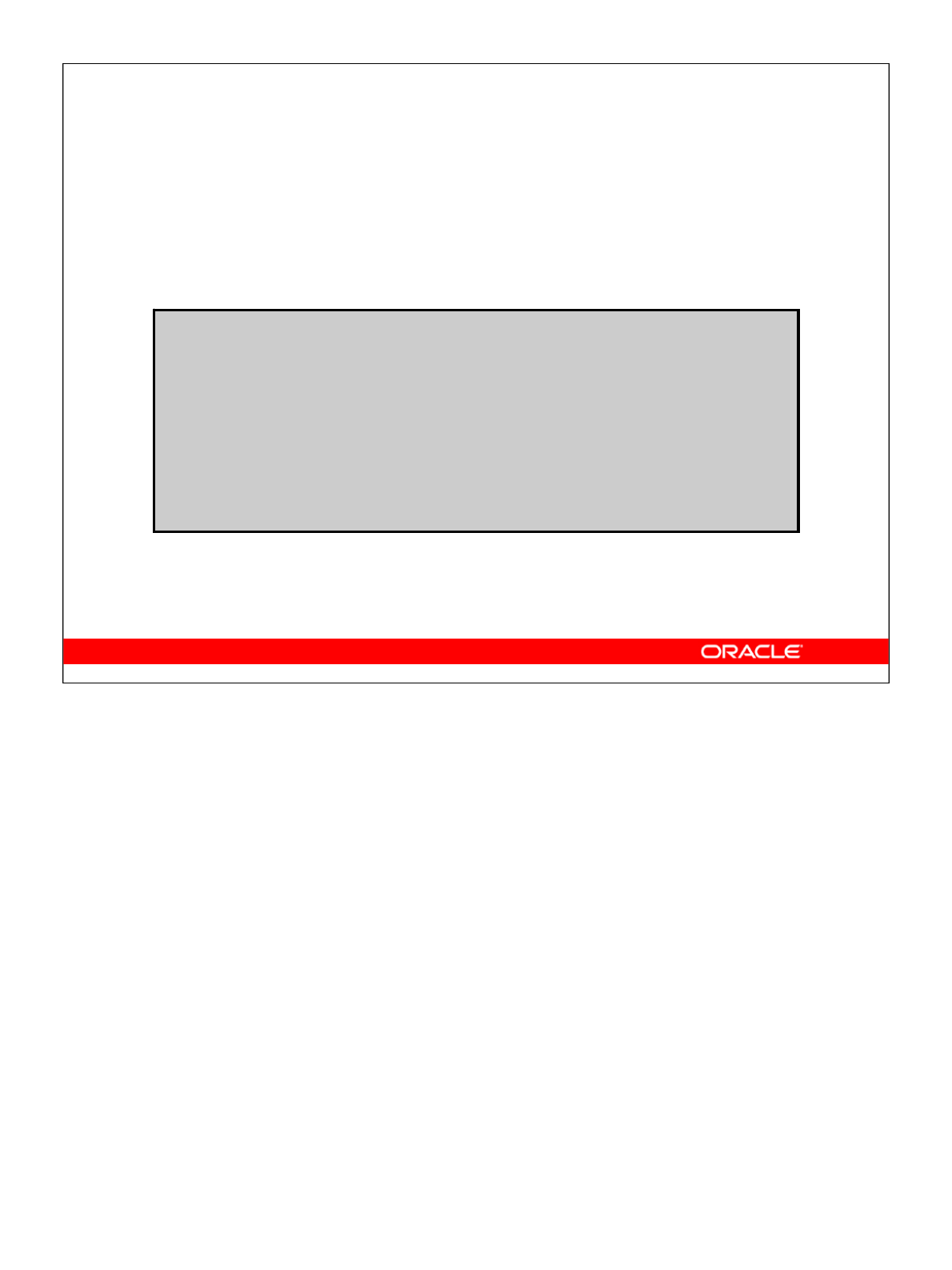
Oracle Database 10g: Develop PL/SQL Program Units D-16
D-16 Copyright © 2004, Oracle. All rights reserved.
FOR Loop
Insert the first 10 new line items for order number 101.
Example:
DECLARE
v_ordid order_items.order_id%TYPE := 101;
BEGIN
FOR i IN 1..10 LOOP
INSERT INTO order_items(order_id,line_item_id)
VALUES(v_ordid, i);
END LOOP;
END;
FOR Loop
The slide shows a FOR loop that inserts 10 rows into the order_items table.

Oracle Database 10g: Develop PL/SQL Program Units D-17
D-17 Copyright © 2004, Oracle. All rights reserved.
WHILE Loop
Example:
ACCEPT p_price PROMPT 'Enter the price of the item: '
ACCEPT p_itemtot -
PROMPT 'Enter the maximum total for purchase of item: '
DECLARE
...
v_qty NUMBER(8) := 1;
v_running_total NUMBER(7,2) := 0;
BEGIN
...
WHILE v_running_total < &p_itemtot LOOP
...
v_qty := v_qty + 1;
v_running_total := v_qty * &p_price;
END LOOP;
...
WHILE Loop
In the example in the slide, the quantity increases with each iteration of the loop until the
quantity is no longer less than the maximum price allowed for spending on the item.

Oracle Database 10g: Develop PL/SQL Program Units D-18
D-18 Copyright © 2004, Oracle. All rights reserved.
•Return to
FETCH if
rows found
No
Controlling Explicit Cursors
DECLARE
•Create a
named
SQL area
•Identify
the active
set
OPEN
•Test for
existing
rows
EMPTY?
•Release
the active
set
CLOSE
Yes
•Load the
current
row into
variables
FETCH
Explicit Cursors
Controlling Explicit Cursors Using Four Commands
1. Declare the cursor by naming it and defining the structure of the query to be
performed within it.
2. Open the cursor. The OPEN statement executes the query and binds any variables
that are referenced. Rows identified by the query are called the active set and are now
available for fetching.
3. Fetch data from the cursor. The FETCH statement loads the current row from the
cursor into variables. Each fetch causes the cursor to move its pointer to the next row
in the active set. Therefore, each fetch accesses a different row returned by the query.
In the flow diagram in the slide, each fetch tests the cursor for any existing rows. If
rows are found, it loads the current row into variables; otherwise, it closes the cursor.
4. Close the cursor. The CLOSE statement releases the active set of rows. It is now
possible to reopen the cursor to establish a fresh active set.
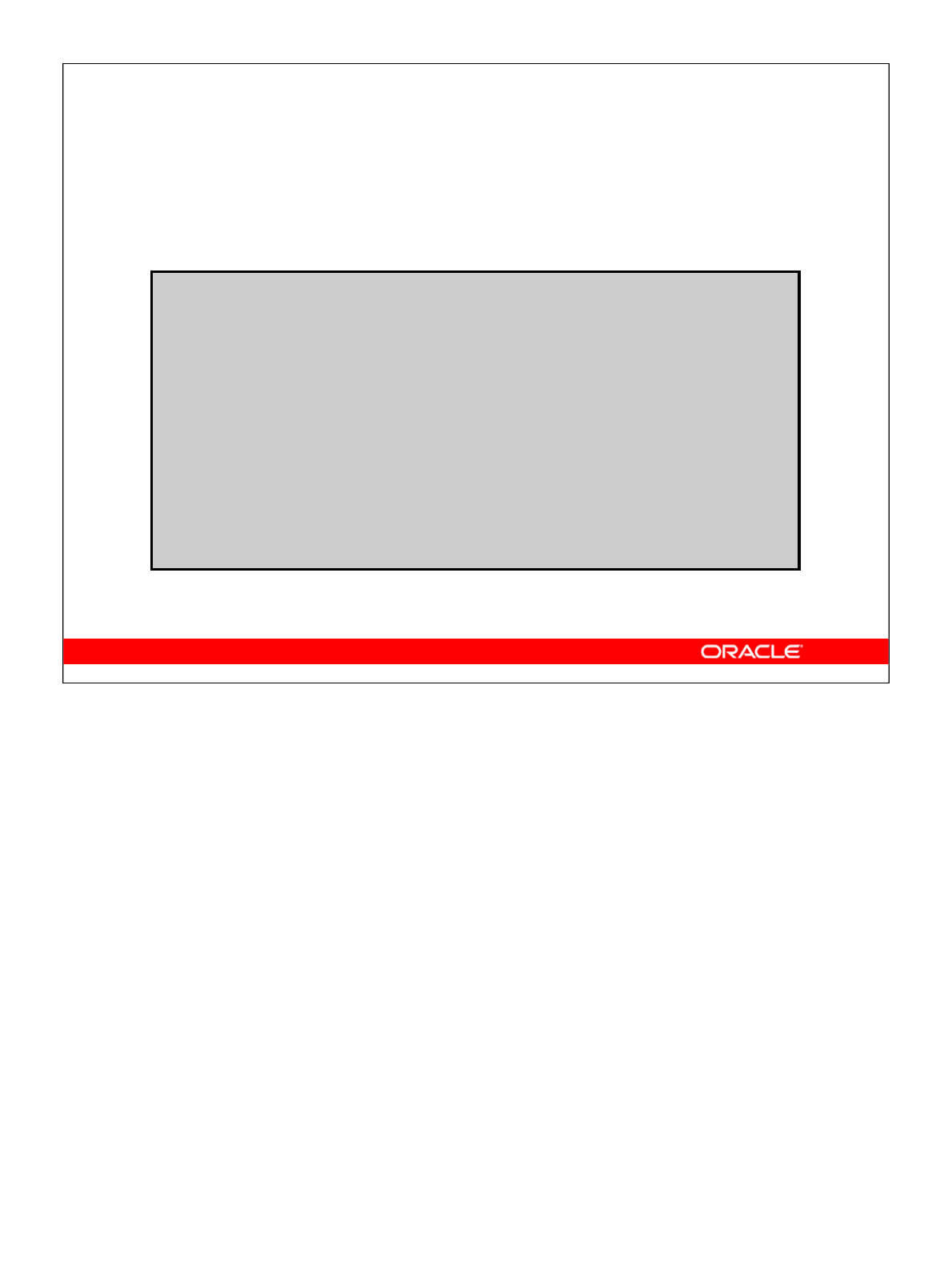
Oracle Database 10g: Develop PL/SQL Program Units D-19
D-19 Copyright © 2004, Oracle. All rights reserved.
Declaring the Cursor
Example:
DECLARE
CURSOR c1 IS
SELECT employee_id, last_name
FROM employees;
CURSOR c2 IS
SELECT *
FROM departments
WHERE department_id = 10;
BEGIN
...
Explicit Cursor Declaration
Retrieve the employees one by one.
DECLARE
v_empid employees.employee_id%TYPE;
v_ename employees.last_name%TYPE;
CURSOR c1 IS
SELECT employee_id, last_name
FROM employees;
BEGIN
...
Note: You can reference variables in the query, but you must declare them before the
CURSOR statement.
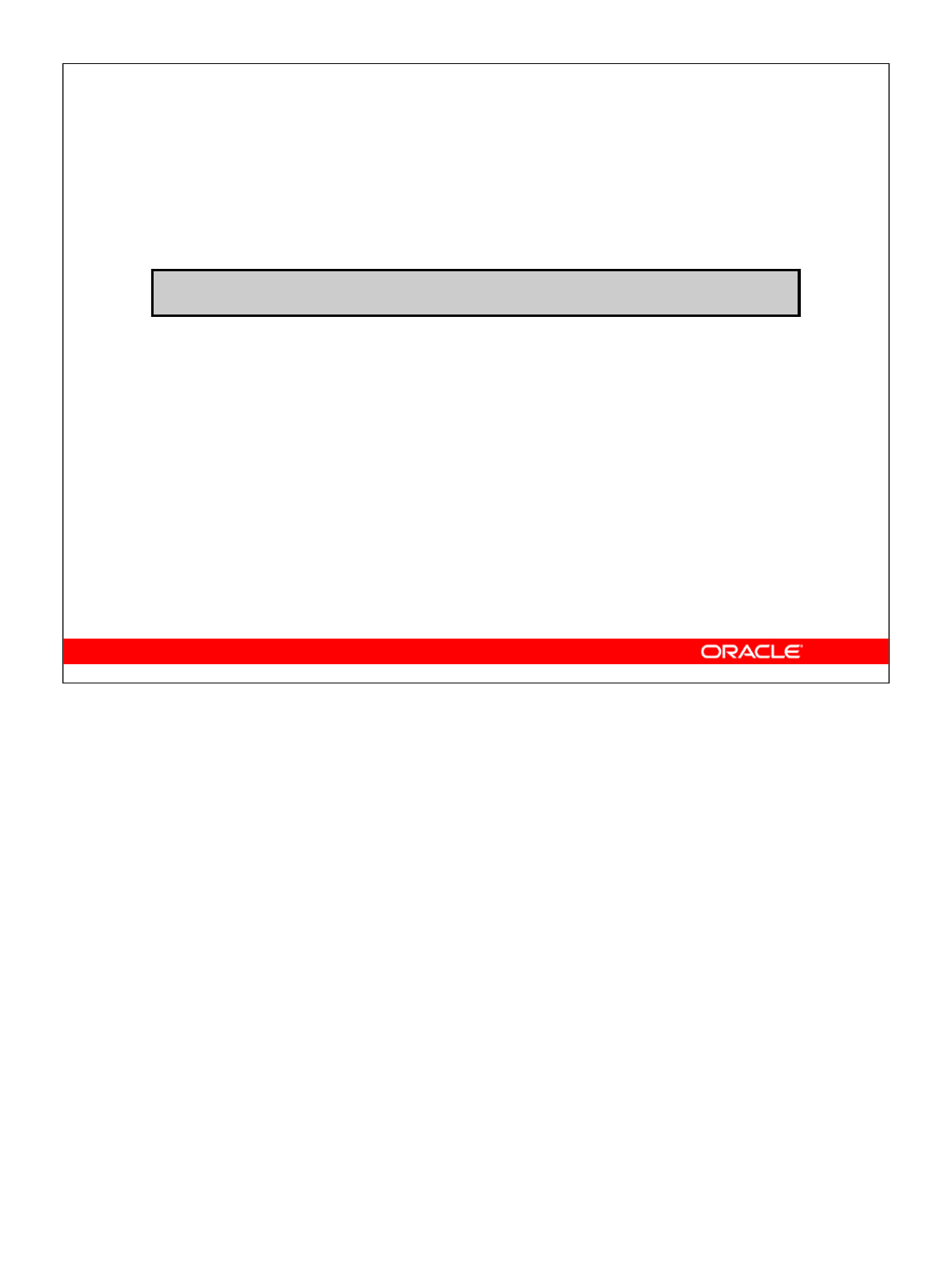
Oracle Database 10g: Develop PL/SQL Program Units D-20
D-20 Copyright © 2004, Oracle. All rights reserved.
Opening the Cursor
Syntax:
•Open the cursor to execute the query and identify
the active set.
•If the query returns no rows, no exception is
raised.
•Use cursor attributes to test the outcome after a
fetch.
OPEN cursor_name;
OPEN Statement
Open the cursor to execute the query and identify the result set, which consists of all rows
that meet the query search criteria. The cursor now points to the first row in the result set.
In the syntax, cursor_name is the name of the previously declared cursor.
OPEN is an executable statement that performs the following operations:
1. Dynamically allocates memory for a context area that eventually contains crucial
processing information
2. Parses the SELECT statement
3. Binds the input variables—that is, sets the value for the input variables by obtaining
their memory addresses
4. Identifies the result set—that is, the set of rows that satisfy the search criteria. Rows
in the result set are not retrieved into variables when the OPEN statement is executed.
Rather, the FETCH statement retrieves the rows.
5. Positions the pointer just before the first row in the active set
Note: If the query returns no rows when the cursor is opened, then PL/SQL does not raise
an exception. However, you can test the cursor’s status after a fetch.
For cursors declared by using the FOR UPDATE clause, the OPEN statement also locks
those rows.
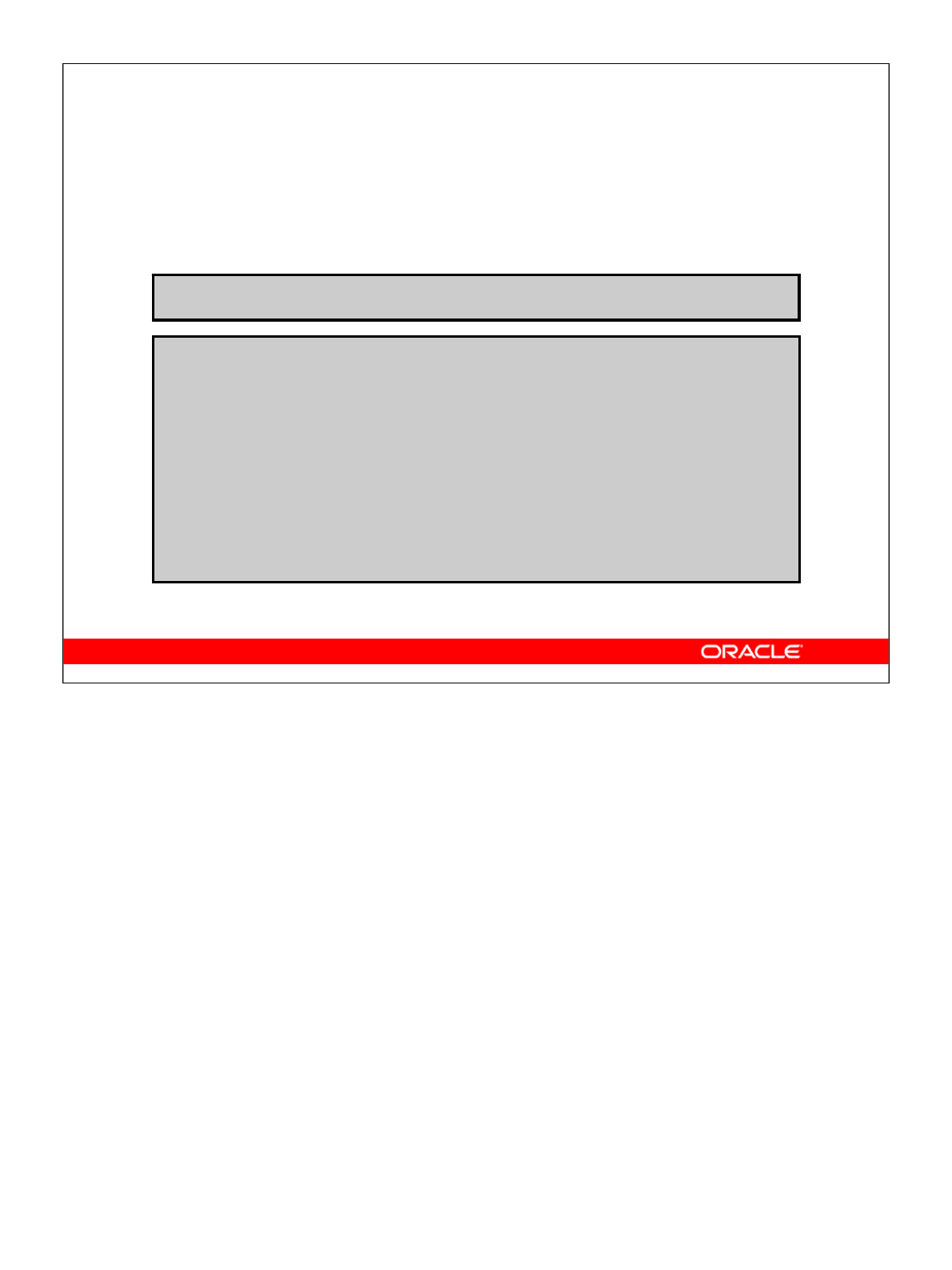
Oracle Database 10g: Develop PL/SQL Program Units D-21
D-21 Copyright © 2004, Oracle. All rights reserved.
Fetching Data from the Cursor
Examples:
FETCH c1 INTO v_empid, v_ename;
...
OPEN defined_cursor;
LOOP
FETCH defined_cursor INTO defined_variables
EXIT WHEN ...;
...
-- Process the retrieved data
...
END;
FETCH Statement
You use the FETCH statement to retrieve the current row values into output variables.
After the fetch, you can manipulate the variables by further statements. For each column
value returned by the query associated with the cursor, there must be a corresponding
variable in the INTO list. Also, their data types must be compatible. Retrieve the first 10
employees one by one:
DECLARE
v_empid employees.employee_id%TYPE;
v_ename employees.last_name%TYPE;
i NUMBER := 1;
CURSOR c1 IS
SELECT employee_id, last_name
FROM employees;
BEGIN
OPEN c1;
FOR i IN 1..10 LOOP
FETCH c1 INTO v_empid, v_ename;
...
END LOOP;
END;
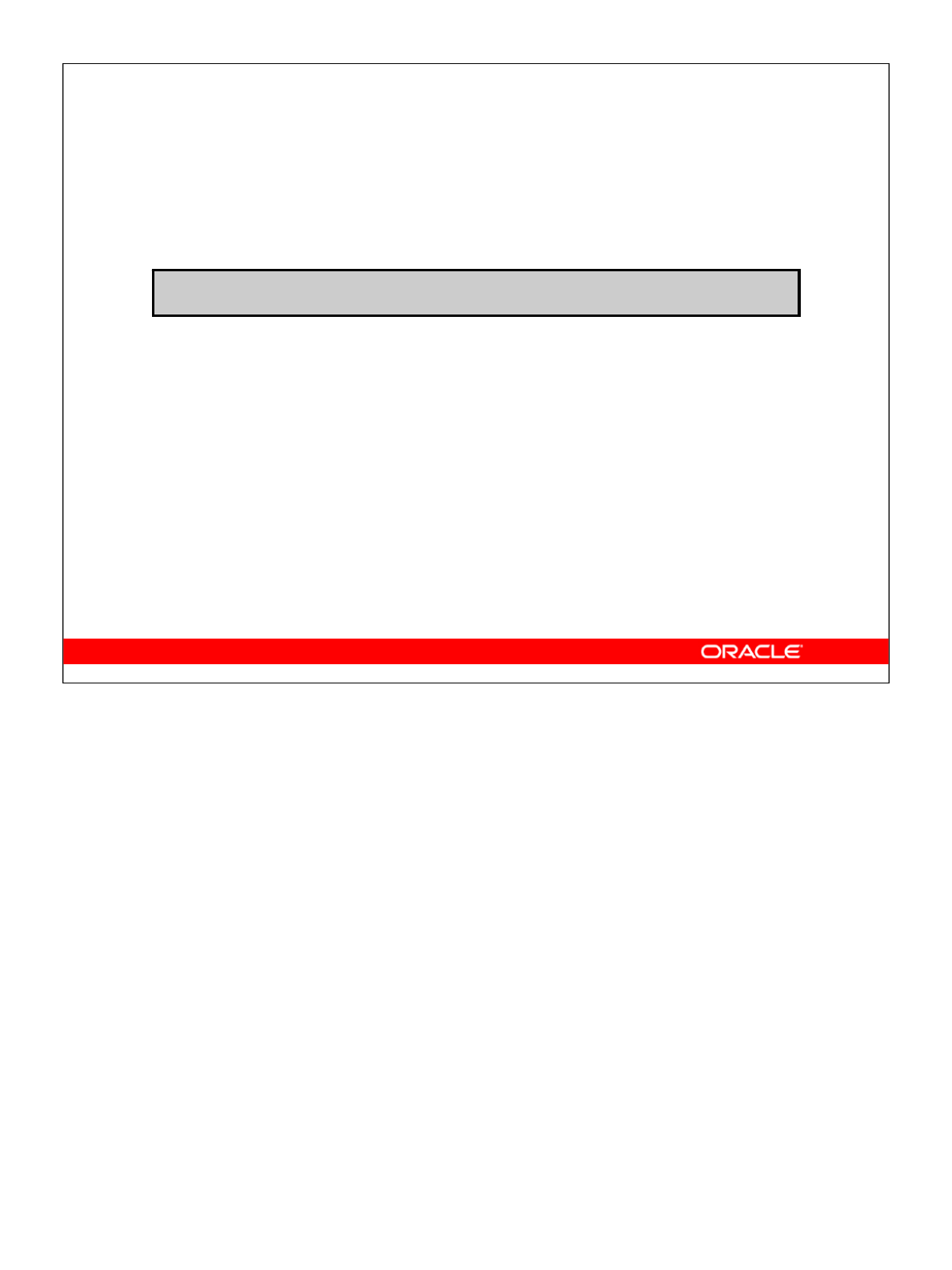
Oracle Database 10g: Develop PL/SQL Program Units D-22
D-22 Copyright © 2004, Oracle. All rights reserved.
Closing the Cursor
Syntax:
•Close the cursor after completing the processing
of the rows.
•Reopen the cursor, if required.
•Do not attempt to fetch data from a cursor after it
has been closed.
CLOSE cursor_name;
CLOSE Statement
The CLOSE statement disables the cursor, and the result set becomes undefined. Close the
cursor after completing the processing of the SELECT statement. This step allows the
cursor to be reopened, if required. Therefore, you can establish an active set several times.
In the syntax, cursor_name is the name of the previously declared cursor.
Do not attempt to fetch data from a cursor after it has been closed, or the
INVALID_CURSOR exception will be raised.
Note: The CLOSE statement releases the context area. Although it is possible to terminate
the PL/SQL block without closing cursors, you should always close any cursor that you
declare explicitly in order to free up resources. There is a maximum limit to the number of
open cursors per user, which is determined by the OPEN_CURSORS parameter in the
database parameter field. OPEN_CURSORS = 50 by default.
...
FOR i IN 1..10 LOOP
FETCH c1 INTO v_empid, v_ename; ...
END LOOP;
CLOSE c1;
END;
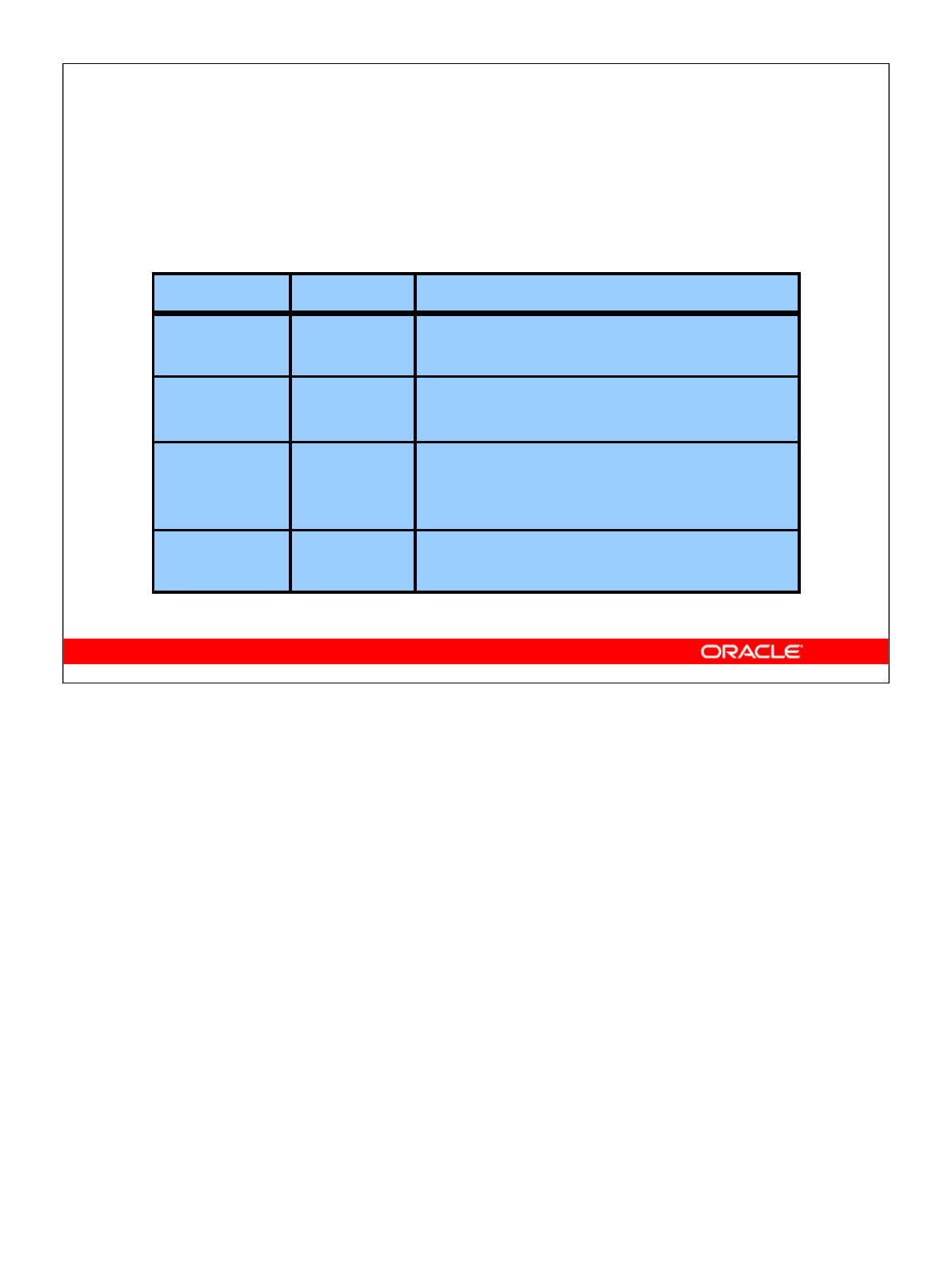
Oracle Database 10g: Develop PL/SQL Program Units D-23
D-23 Copyright © 2004, Oracle. All rights reserved.
Explicit Cursor Attributes
Obtain status information about a cursor.
Attribute Type Description
%ISOPEN BOOLEAN Evaluates to TRUE if the cursor
is open
%NOTFOUND BOOLEAN Evaluates to TRUE if the most recent
fetch does not return a row
%FOUND BOOLEAN Evaluates to TRUE if the most recent
fetch returns a row; complement
of %NOTFOUND
%ROWCOUNT NUMBER Evaluates to the total number of
rows returned so far
Explicit Cursor Attributes
As with implicit cursors, there are four attributes for obtaining status information about a
cursor. When appended to the cursor or cursor variable, these attributes return useful
information about the execution of a DML statement.
Note: Do not reference cursor attributes directly in a SQL statement.

Oracle Database 10g: Develop PL/SQL Program Units D-24
D-24 Copyright © 2004, Oracle. All rights reserved.
Cursor FOR Loops
Retrieve employees one by one until there are no more
left.
Example:
DECLARE
CURSOR c1 IS
SELECT employee_id, last_name
FROM employees;
BEGIN
FOR emp_record IN c1 LOOP
-- implicit open and implicit fetch occur
IF emp_record.employee_id = 134 THEN
...
END LOOP; -- implicit close occurs
END;
Cursor FOR Loops
A cursor FOR loop processes rows in an explicit cursor. The cursor is opened, rows are
fetched once for each iteration in the loop, and the cursor is closed automatically when all
rows have been processed. The loop itself is terminated automatically at the end of the
iteration where the last row was fetched.

Oracle Database 10g: Develop PL/SQL Program Units D-25
D-25 Copyright © 2004, Oracle. All rights reserved.
FOR UPDATE Clause
Retrieve the orders for amounts over $1,000 that were
processed today.
Example:
DECLARE
CURSOR c1 IS
SELECT customer_id, order_id
FROM orders
WHERE order_date = SYSDATE
AND order_total > 1000.00
ORDER BY customer_id
FOR UPDATE NOWAIT;
FOR UPDATE Clause
If the database server cannot acquire the locks on the rows it needs in a SELECT FOR
UPDATE, then it waits indefinitely. You can use the NOWAIT clause in the SELECT FOR
UPDATE statement and test for the error code that returns due to failure to acquire the
locks in a loop. Therefore, you can retry opening the cursor ntimes before terminating the
PL/SQL block.
If you intend to update or delete rows by using the WHERE CURRENT OF clause, you must
specify a column name in the FOR UPDATE OF clause.
If you have a large table, you can achieve better performance by using the LOCK TABLE
statement to lock all rows in the table. However, when using LOCK TABLE, you cannot
use the WHERE CURRENT OF clause and must use the notation WHERE column =
identifier.
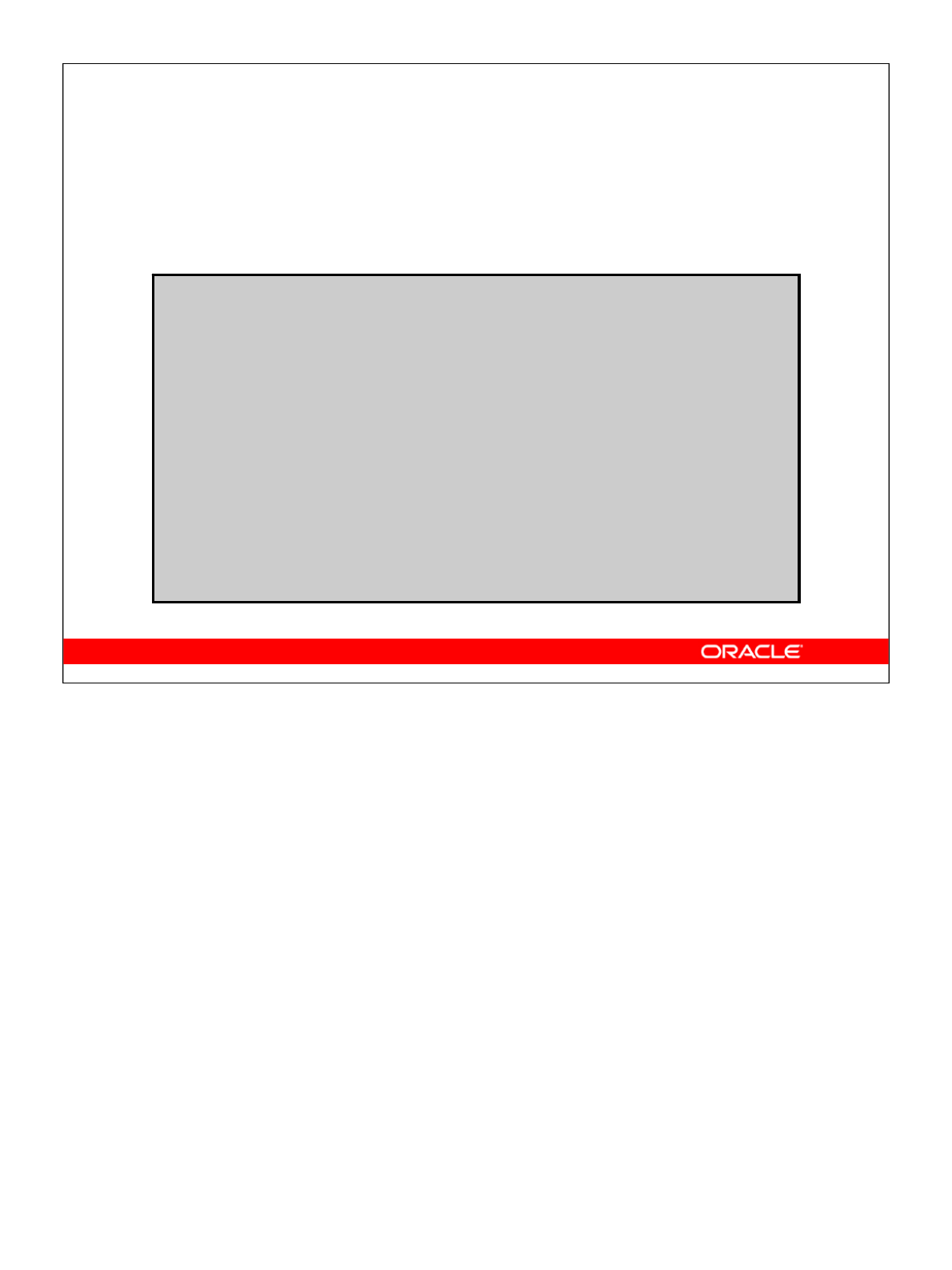
Oracle Database 10g: Develop PL/SQL Program Units D-26
D-26 Copyright © 2004, Oracle. All rights reserved.
WHERE CURRENT OF Clause
DECLARE
CURSOR c1 IS
SELECT salary FROM employees
FOR UPDATE OF salary NOWAIT;
BEGIN
...
FOR emp_record IN c1 LOOP
UPDATE ...
WHERE CURRENT OF c1;
...
END LOOP;
COMMIT;
END;
Example:
WHERE CURRENT OF Clause
You can update rows based on criteria from a cursor.
Additionally, you can write your DELETE or UPDATE statement to contain the WHERE
CURRENT OF cursor_name clause to refer to the latest row processed by the FETCH
statement. When you use this clause, the cursor you reference must exist and must contain
the FOR UPDATE clause in the cursor query; otherwise you will get an error. This clause
enables you to apply updates and deletes to the currently addressed row without the need
to explicitly reference the ROWID pseudocolumn.

Oracle Database 10g: Develop PL/SQL Program Units D-27
D-27 Copyright © 2004, Oracle. All rights reserved.
Trapping Predefined
Oracle Server Errors
•Reference the standard name in the exception-
handling routine.
•Sample predefined exceptions:
–NO_DATA_FOUND
–TOO_MANY_ROWS
–INVALID_CURSOR
–ZERO_DIVIDE
–DUP_VAL_ON_INDEX
Trapping Predefined Oracle Server Errors
Trap a predefined Oracle server error by referencing its standard name within the
corresponding exception-handling routine.
Note: PL/SQL declares predefined exceptions in the STANDARD package.
It is a good idea to always consider the NO_DATA_FOUND and TOO_MANY_ROWS
exceptions, which are the most common.

Oracle Database 10g: Develop PL/SQL Program Units D-28
D-28 Copyright © 2004, Oracle. All rights reserved.
Trapping Predefined
Oracle Server Errors: Example
Syntax:
BEGIN SELECT ... COMMIT;
EXCEPTION
WHEN NO_DATA_FOUND THEN
statement1;
statement2;
WHEN TOO_MANY_ROWS THEN
statement1;
WHEN OTHERS THEN
statement1;
statement2;
statement3;
END;
Trapping Predefined Oracle Server Exceptions: Example
In the example in the slide, a message is printed out to the user for each exception. Only
one exception is raised and handled at any time.
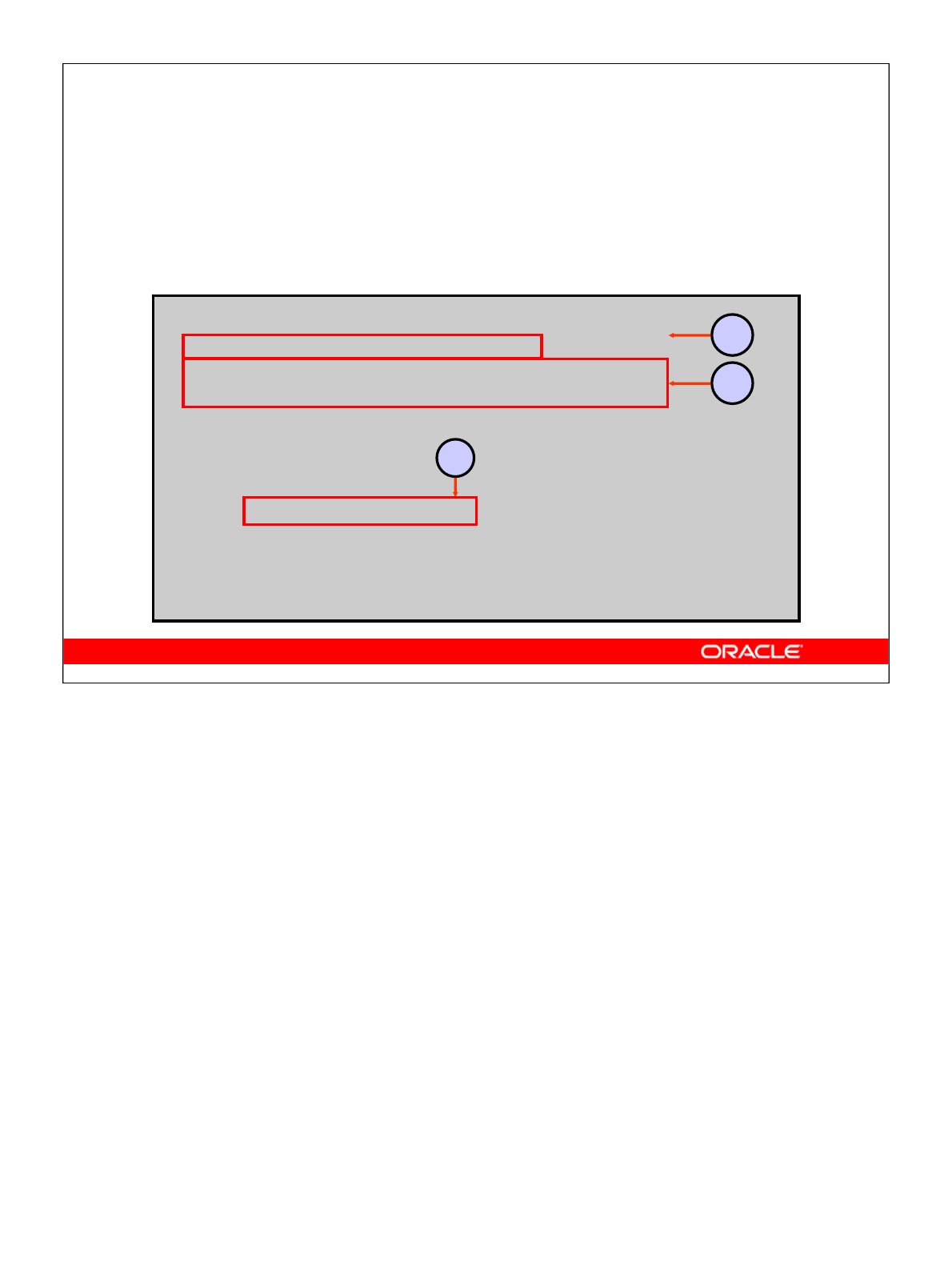
Oracle Database 10g: Develop PL/SQL Program Units D-29
D-29 Copyright © 2004, Oracle. All rights reserved.
DECLARE
e_products_invalidEXCEPTION;
PRAGMA EXCEPTION_INIT (
e_products_invalid, -2292);
v_message VARCHAR2(50);
BEGIN
. . .
EXCEPTION
WHEN e_products_invalid THEN
:g_message := 'Product ID
specified is not valid.';
. . .
END;
Non-Predefined Error
Trap for Oracle server error number –2292, which is an
integrity constraint violation.
2
1
3
Trapping a Non-Predefined Oracle Server Exception
1. Declare the name for the exception within the declarative section.
Syntax
exception EXCEPTION;
In this syntax, exception is the name of the exception.
2. Associate the declared exception with the standard Oracle server error number, using
the PRAGMA EXCEPTION_INIT statement.
Syntax
PRAGMA EXCEPTION_INIT(exception, error_number);
In this syntax: exception is the previously declared exception
error_number is a standard Oracle server error number
3. Reference the declared exception within the corresponding exception-handling
routine.
In the slide example: If there is product in stock, halt processing and print a message
to the user.

Oracle Database 10g: Develop PL/SQL Program Units D-30
D-30 Copyright © 2004, Oracle. All rights reserved.
User-Defined Exceptions
Example:
[DECLARE]
e_amount_remaining EXCEPTION;
. . .
BEGIN
. . .
RAISE e_amount_remaining;
. . .
EXCEPTION
WHEN e_amount_remaining THEN
:g_message := 'There is still an amount
in stock.';
. . .
END;
1
2
3
Trapping User-Defined Exceptions
You trap a user-defined exception by declaring it and raising it explicitly.
1. Declare the name for the user-defined exception within the declarative section.
Syntax: exception EXCEPTION;
where: exception is the name of the exception
2. Use the RAISE statement to raise the exception explicitly within the executable
section.
Syntax: RAISE exception;
where: exception is the previously declared exception
3. Reference the declared exception within the corresponding exception-handling
routine.
In the slide example: This customer has a business rule that states that a product cannot be
removed from its database if there is any inventory left in stock for this product. Because
there are no constraints in place to enforce this rule, the developer handles it explicitly in
the application. Before performing a DELETE on the PRODUCT_INFORMATION table,
the block queries the INVENTORIES table to see if there is any stock for the product in
question. If so, raise an exception.
Note: Use the RAISE statement by itself within an exception handler to raise the same
exception back to the calling environment.

Oracle Database 10g: Develop PL/SQL Program Units D-31
D-31 Copyright © 2004, Oracle. All rights reserved.
RAISE_APPLICATION_ERROR Procedure
Syntax:
•Enables you to issue user-defined error messages
from stored subprograms
•Called from an executing stored subprogram only
raise_application_error (error_number,
message[, {TRUE | FALSE}]);
RAISE_APPLICATION_ERROR Procedure
Use the RAISE_APPLICATION_ERROR procedure to communicate a predefined
exception interactively by returning a nonstandard error code and error message. With
RAISE_APPLICATION_ERROR, you can report errors to your application and avoid
returning unhandled exceptions.
In the syntax, error_number is a user-specified number for the exception between
–20000 and –20999. The message is the user-specified message for the exception. It is a
character string up to 2,048 bytes long.
TRUE | FALSE is an optional Boolean parameter. If TRUE, the error is placed on the stack
of previous errors. If FALSE (the default), the error replaces all previous errors.
Example ...
EXCEPTION
WHEN NO_DATA_FOUND THEN
RAISE_APPLICATION_ERROR (-20201,
'Manager is not a valid employee.');
END;

Oracle Database 10g: Develop PL/SQL Program Units D-32
D-32 Copyright © 2004, Oracle. All rights reserved.
RAISE_APPLICATION_ERROR Procedure
•Used in two different places:
–Executable section
–Exception section
•Returns error conditions to the user in a manner
consistent with other Oracle server errors
RAISE_APPLICATION_ERROR Procedure: Example
...
DELETE FROM employees
WHERE manager_id = v_mgr;
IF SQL%NOTFOUND THEN
RAISE_APPLICATION_ERROR(-20202,
'This is not a valid manager');
END IF;
...

Copyright © 2004, Oracle. All rights reserved.
JDeveloper

Oracle Database 10g: Develop PL/SQL Program Units E-2
E-2 Copyright © 2004, Oracle. All rights reserved.
JDeveloper
JDeveloper
Oracle JDeveloper 10gis an integrated development environment (IDE) for developing and
deploying Java applications and Web services. It supports every stage of the software
development life cycle (SDLC) from modeling to deploying. It has the features to use the latest
industry standards for Java, XML, and SQL while developing an application.
Oracle JDeveloper 10ginitiates a new approach to J2EE development with the features that
enables visual and declarative development. This innovative approach makes J2EE development
simple and efficient.

Oracle Database 10g: Develop PL/SQL Program Units E-3
E-3 Copyright © 2004, Oracle. All rights reserved.
Connection Navigator
Connection Navigator
Using Oracle JDeveloper 10g, you can store the information necessary to connect to a database
in an object called “connection.” A connection is stored as part of the IDE settings, and can be
exported and imported for easy sharing among groups of users. A connection serves several
purposes from browsing the database and building applications, all the way through to
deployment.
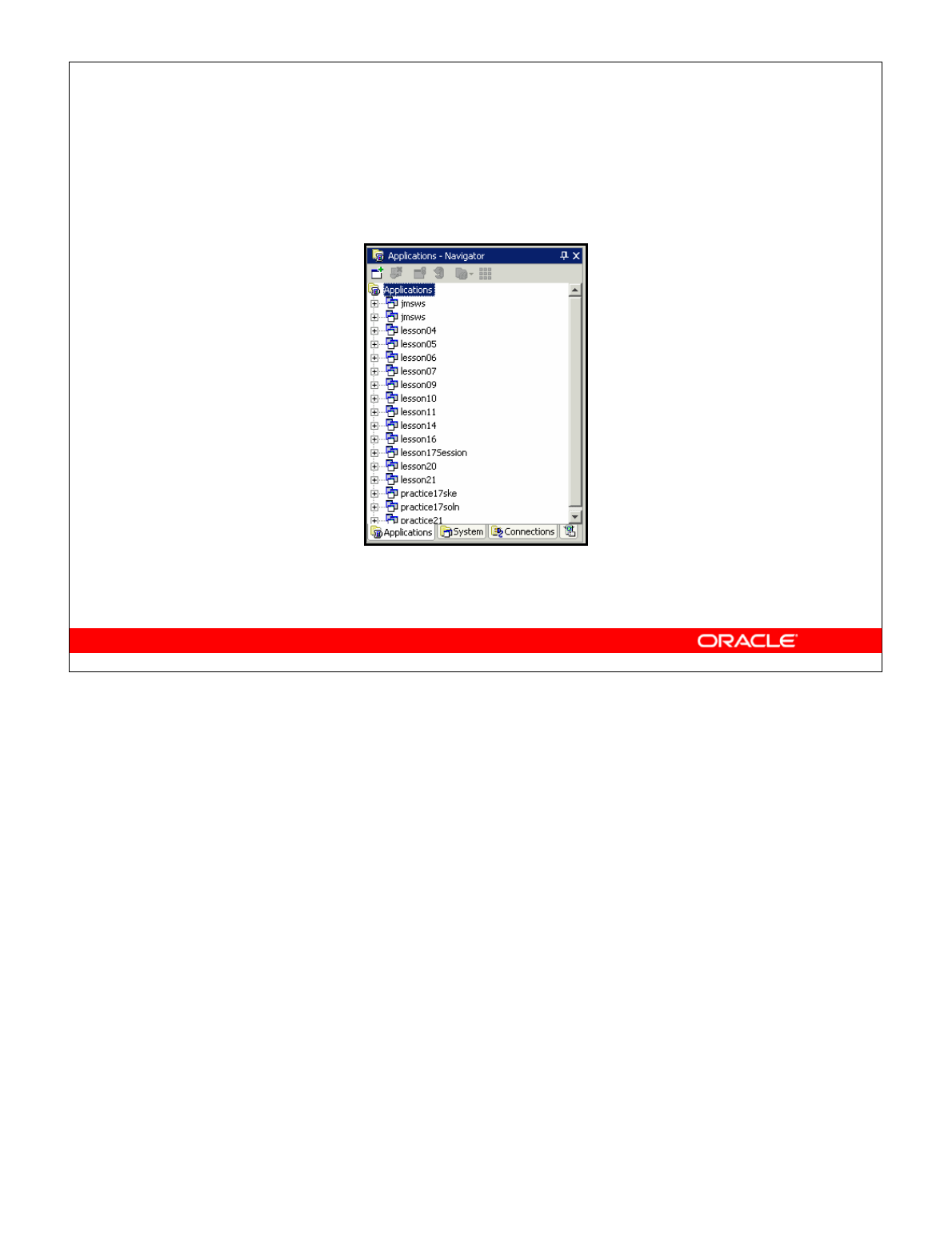
Oracle Database 10g: Develop PL/SQL Program Units E-4
E-4 Copyright © 2004, Oracle. All rights reserved.
Application Navigator
Application Navigator
The Application Navigator gives you a logical view of your application and the data it contains.
The Application Navigator provides an infrastructure that the different extensions can plug into
and use to organize their data and menus in a consistent, abstract manner. While the Application
Navigator can contain individual files (such as Java source files), it is designed to consolidate
complex data. Complex data types such as entity objects, UML diagrams, EJB, or Web services
appear in this navigator as single nodes. The raw files that make up these abstract nodes appear
in the Structure window.

Oracle Database 10g: Develop PL/SQL Program Units E-5
E-5 Copyright © 2004, Oracle. All rights reserved.
Structure Window
Structure Window
The Structure window offers a structural view of the data in the document currently selected in
the active window of those windows that participate in providing structure: the navigators, the
editors and viewers, and the Property Inspector.
In the Structure window, you can view the document data in a variety of ways. The structures
available for display are based upon document type. For a Java file, you can view code structure,
UI structure, or UI model data. For an XML file, you can view XML structure, design structure,
or UI model data.
The Structure window is dynamic, tracking always the current selection of the active window
(unless you freeze the window’s contents on a particular view), as is pertinent to the currently
active editor. When the current selection is a node in the navigator, the default editor is assumed.
To change the view on the structure for the current selection, select a different structure tab.
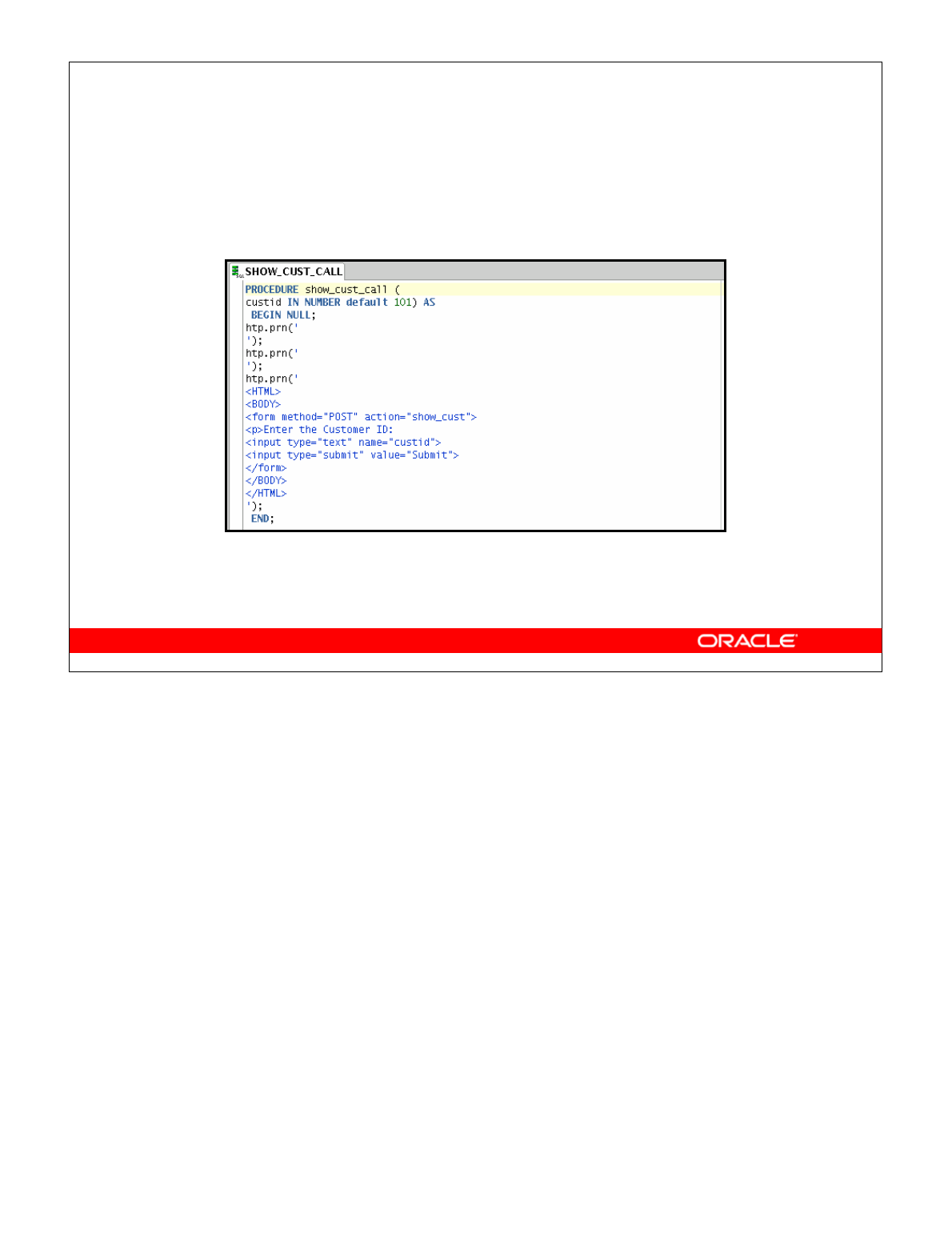
Oracle Database 10g: Develop PL/SQL Program Units E-6
E-6 Copyright © 2004, Oracle. All rights reserved.
Editor Window
Editor Window
You can view your project files all in one single editor window, you can open multiple views of
the same file, or you can open multiple views of different files.
The tabs at the top of the editor window are the document tabs. Selecting a document tab gives
that file focus, bringing it to the foreground of the window in the current editor.
The tabs at the bottom of the editor window for a given file are the editor tabs. Selecting an
editor tab opens the file in that editor.

Oracle Database 10g: Develop PL/SQL Program Units E-7
E-7 Copyright © 2004, Oracle. All rights reserved.
Deploying Java Stored Procedures
Before deploying Java stored procedures, perform the
following steps:
1. Create a database connection.
2. Create a deployment profile.
3. Deploy the objects.
123
Deploying Java Stored Procedures
Create a deployment profile for Java stored procedures, then deploy the classes and, optionally,
any public static methods in JDeveloper using the settings in the profile.
Deploying to the database uses the information provided in the Deployment Profile Wizard and
two Oracle Database utilities:
•loadjava loads the Java class containing the stored procedures to an Oracle database.
•publish generates the PL/SQL call specific wrappers for the loaded public static
methods. Publishing enables the Java methods to be called as PL/SQL functions or
procedures.
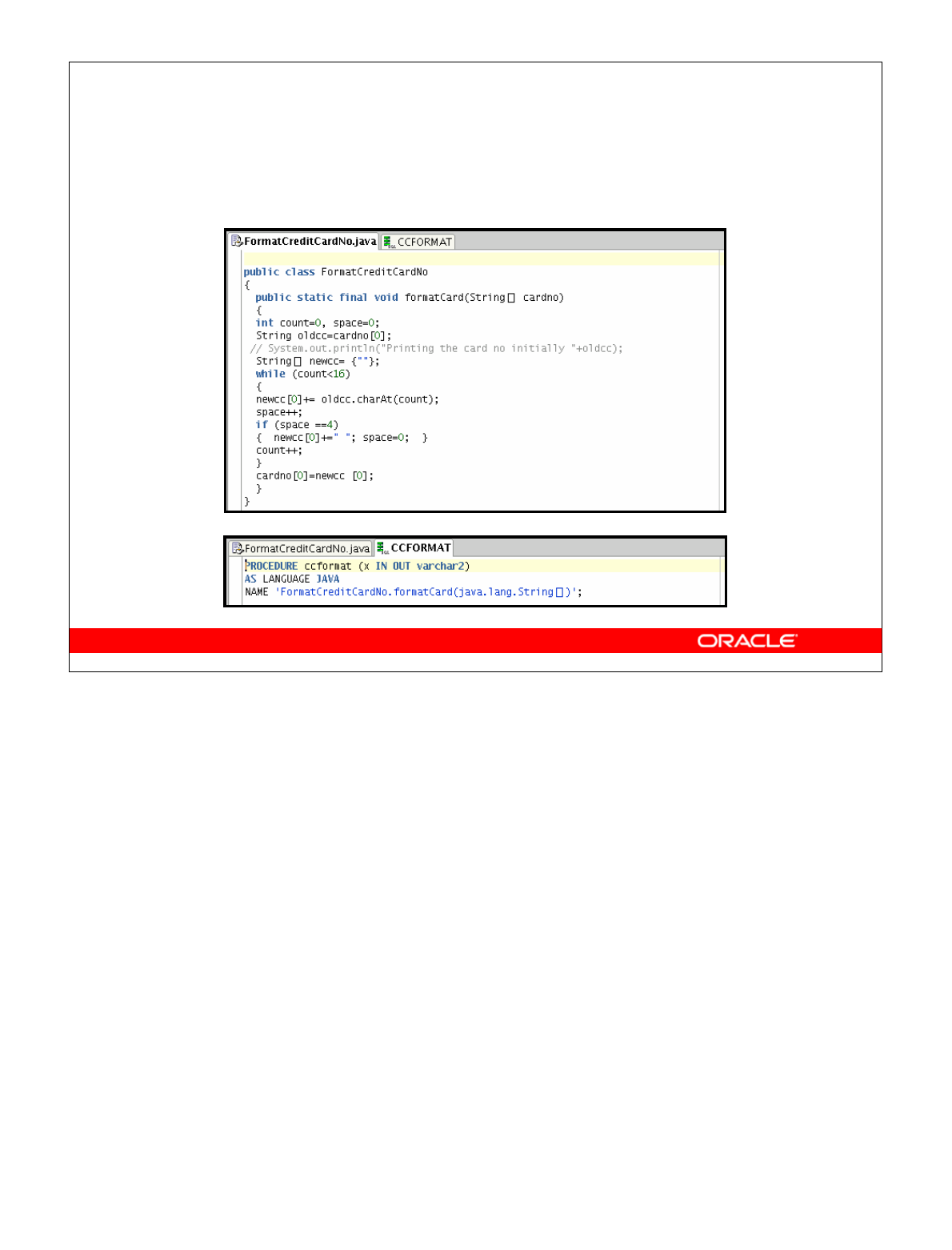
Oracle Database 10g: Develop PL/SQL Program Units E-8
E-8 Copyright © 2004, Oracle. All rights reserved.
Publishing Java to PL/SQL
Publishing Java to PL/SQL
The slide shows the Java code and how to publish the Java code in a PL/SQL procedure.

Oracle Database 10g: Develop PL/SQL Program Units E-9
E-9 Copyright © 2004, Oracle. All rights reserved.
Creating Program Units
Skeleton of the function
Creating Program Units
To create a PL/SQL program unit:
1. Select View > Connection Navigator.
2. Expand Database and select a database connection.
3. In the connection, expand a schema.
4. Right-click a folder corresponding to the object type (Procedures, Packages, Functions).
5. Choose New PL/SQL object_type. The Create PL/SQL dialog box appears for the function,
package, or procedure.
6. Enter a valid name for the function, package, or procedure and click OK.
A skeleton definition will be created and opened in the Code Editor. You can then edit the
subprogram to suit your need.

Oracle Database 10g: Develop PL/SQL Program Units E-10
E-10 Copyright © 2004, Oracle. All rights reserved.
Compiling
Compilation with errors
Compilation without errors
Compiling
After editing the skeleton definition, you need to compile the program unit. Right-click the
PL/SQL object that you need to compile in the Connection Navigator and then select Compile.
Alternatively you can also press CTRL + SHIFT + F9 to compile.
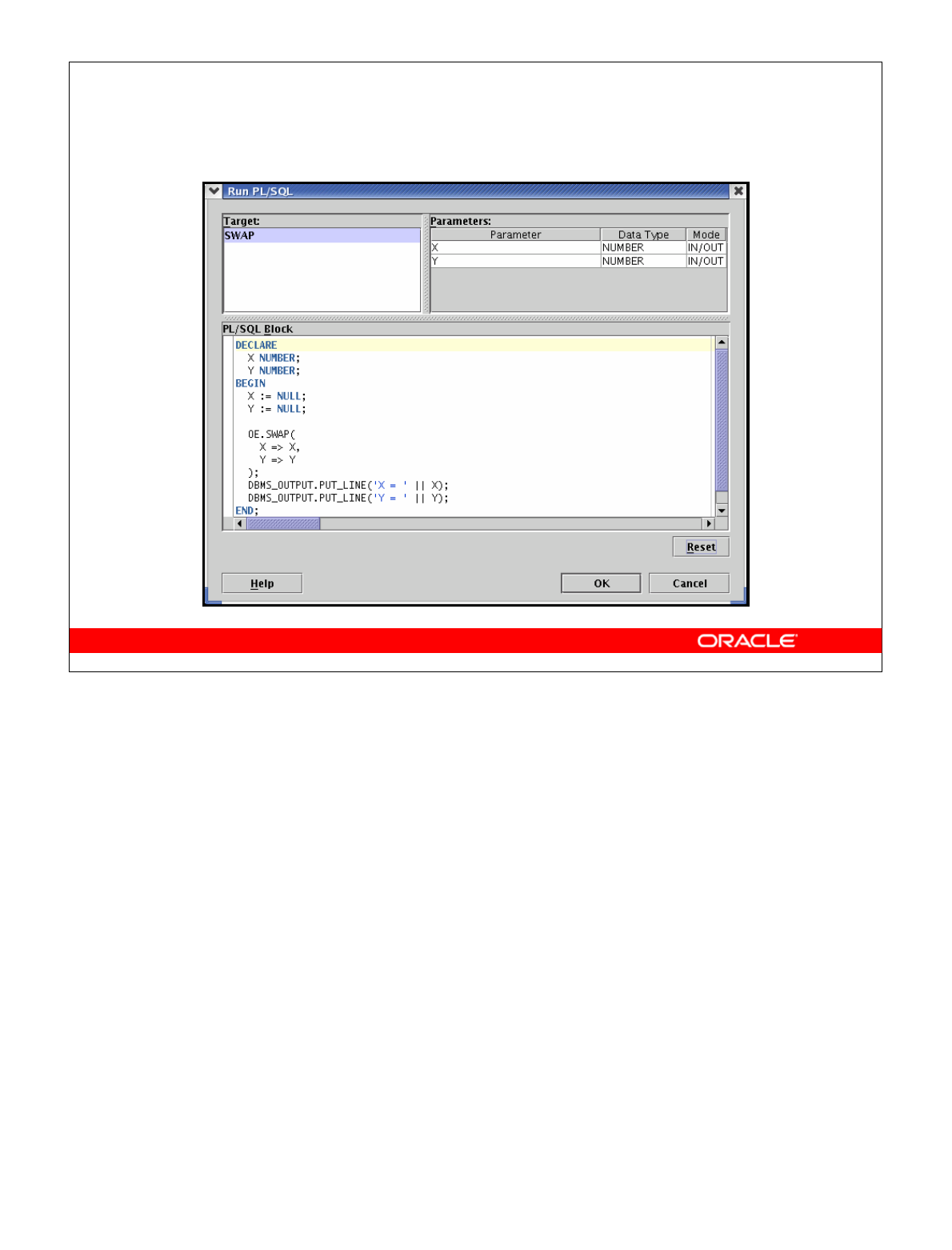
Oracle Database 10g: Develop PL/SQL Program Units E-11
E-11 Copyright © 2004, Oracle. All rights reserved.
Running a Program Unit
Running a Program Unit
To execute the program unit, right-click the object and click Run. The Run PL/SQL dialog box
will appear. You may need to change the NULL values with reasonable values that are passed
into the program unit. After you change the values, click OK. The output will be displayed in the
Message-Log window.

Oracle Database 10g: Develop PL/SQL Program Units E-12
E-12 Copyright © 2004, Oracle. All rights reserved.
Dropping a Program Unit
Dropping a Program Unit
To drop a program unit, right-click the object and select Drop. The Drop Confirmation dialog
box will appear; click Yes. The object will be dropped from the database.

Oracle Database 10g: Develop PL/SQL Program Units E-13
E-13 Copyright © 2004, Oracle. All rights reserved.
Debugging PL/SQL Programs
•JDeveloper support two types of debugging:
–Local
–Remote
•You need the following privileges to perform
PL/SQL debugging:
–DEBUG ANY PROCEDURE
–DEBUG CONNECT SESSION
Debugging PL/SQL Programs
JDeveloper offers both local and remote debugging. A local debugging session is started by
setting breakpoints in source files, and then starting the debugger. Remote debugging requires
two JDeveloper processes: a debugger and a debuggee which may reside on a different
platform.
To debug a PL/SQL program it must be compiled in INTERPRETED mode. You cannot debug a
PL/SQL program that is compiled in NATIVE mode. This mode is set in the database’s
init.ora file.
PL/SQL programs must be compiled with the DEBUG option enabled. This option can be enabled
using various ways. Using SQL*Plus, execute ALTER SESSION SET PLSQL_DEBUG =
true to enable the DEBUG option. Then you can create or recompile the PL/SQL program you
want to debug. Another way of enabling the DEBUG option is by using the following command
in SQL*Plus:
ALTER <procedure, function, package> <name> COMPILE DEBUG;
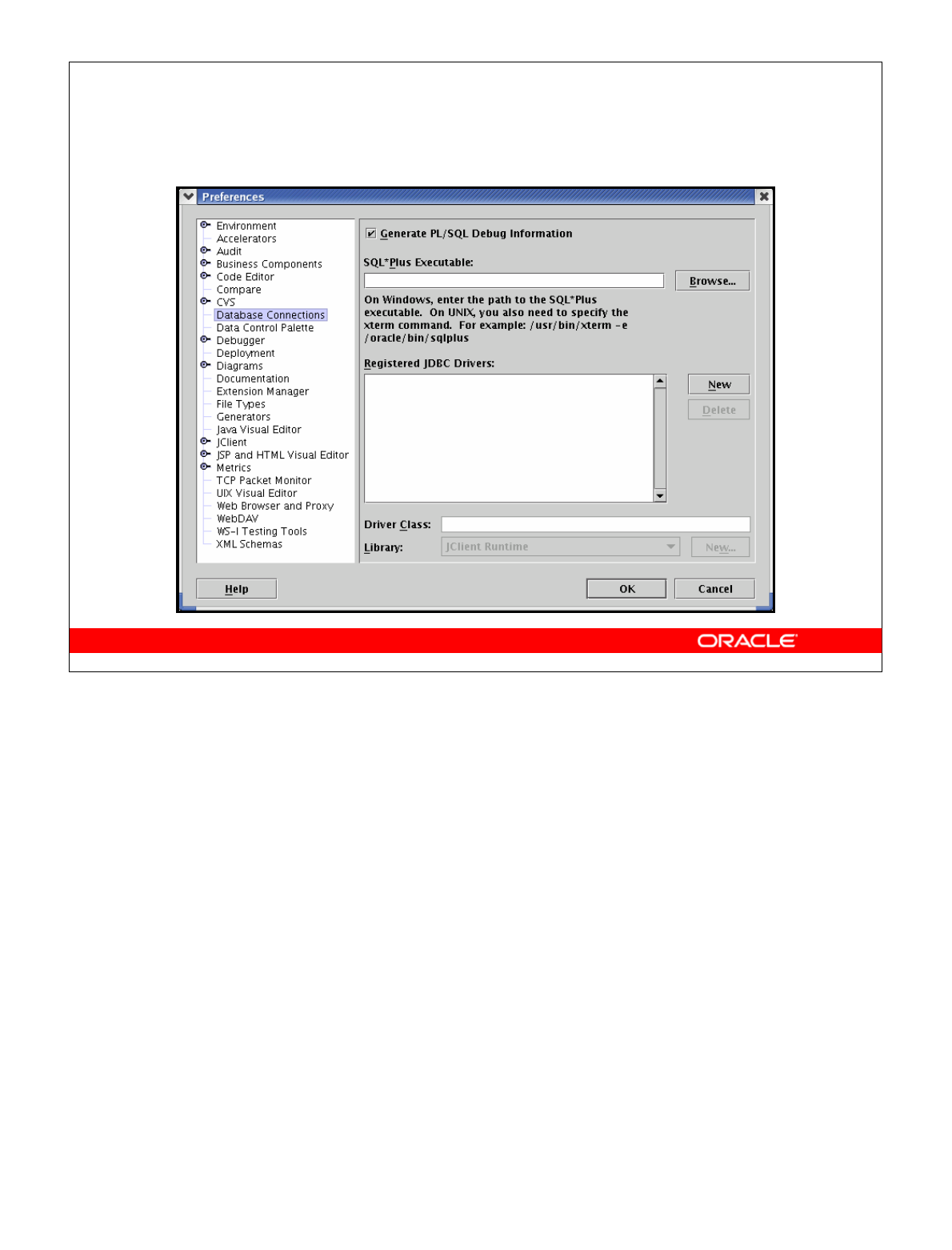
Oracle Database 10g: Develop PL/SQL Program Units E-14
E-14 Copyright © 2004, Oracle. All rights reserved.
Debugging PL/SQL Programs
Debugging PL/SQL Programs (continued)
Before you start with debugging, make sure that the Generate PL/SQL Debug Information check
box is selected. You can access the dialog box by using Tools > Preferences > Database
Connections.
Instead of manually testing PL/SQL functions and procedures as you may be accustomed to
doing from within SQL*Plus or by running a dummy procedure in the database, JDeveloper
enables you to test these objects in an automatic way. With this release of JDeveloper, you can
run and debug PL/SQL program units. For example, you can specify parameters being passed or
return values from a function giving you more control over what is run and providing you output
details about what was tested.
Note: The procedures or functions in the Oracle database can be either stand-alone or within a
package.

Oracle Database 10g: Develop PL/SQL Program Units E-15
Debugging PL/SQL Programs (continued)
To run or debug functions, procedures, and packages:
1. Create a database connection using the Database Wizard.
2. In the Navigator, expand the Database node to display the specific database username and
schema name.
3. Expand the Schema node.
4. Expand the appropriate node depending on what you are debugging: Procedure, Function,
or Package body.
5. (Optional for debugging only) Select the function, procedure, or package that you want to
debug and double-click to open it in the Code Editor.
6. (Optional for debugging only) Set a breakpoint in your PL/SQL code by clicking to the left
of the margin.
Note: The breakpoint must be set on an executable line of code. If the debugger does not
stop, the breakpoint may have not been set on an executable line of code (verify that the
breakpoint was verified). Also, verify that the debugging PL/SQL prerequisites were met.
In particular, make sure that the PL/SQL program is compiled in the INTERPRETED
mode.
7. Make sure that either the Code Editor or the procedure in the Navigator is currently
selected.
8. Click the Debug toolbar button, or, if you want to run without debugging, click the Run
toolbar button.
9. The Run PL/SQL dialog box is displayed.
- Select a target that is the name of the procedure or function that you want to debug.
Note that the content in the Parameters and PL/SQL Block boxes change dynamically
when the target changes.
Note: You will have a choice of target only if you choose to run or debug a package
that contains more than one program unit.
- The Parameters box lists the target’s arguments (if applicable).
- The PL/SQL Block box displays code that was custom generated by JDeveloper for
the selected target. Depending on what the function or procedure does, you may need
to replace the NULL values with reasonable values so that these are passed into the
procedure, function, or package. In some cases, you may need to write additional
code to initialize values to be passed as arguments. In this case, you can edit the
PL/SQL block text as necessary.
10. Click OK to execute or debug the target.
11. Analyze the output information displayed in the Log window.
In the case of functions, the return value will be displayed. DBMS_OUTPUT messages will also
be displayed.

Oracle Database 10g: Develop PL/SQL Program Units E-16
E-16 Copyright © 2004, Oracle. All rights reserved.
Setting Breakpoints
Setting Breakpoints
Breakpoints help you to examine the values of the variables in your program. It is a trigger in a
program that, when reached, pauses program execution allowing you to examine the values of
some or all of the program variables. By setting breakpoints in potential problem areas of your
source code, you can run your program until its execution reaches a location you want to debug.
When your program execution encounters a breakpoint, the program pauses, and the debugger
displays the line containing the breakpoint in the Code Editor. You can then use the debugger to
view the state of your program. Breakpoints are flexible in that they can be set before you begin
a program run or at any time while you are debugging.
To set a breakpoint in the code editor, click the left margin next to a line of executable code.
Breakpoints set on comment lines, blank lines, declaration and any other non-executable lines of
code are not verified by the debugger and are treated as invalid.

Oracle Database 10g: Develop PL/SQL Program Units E-17
E-17 Copyright © 2004, Oracle. All rights reserved.
Stepping Through Code
Debug Resume
Stepping Through Code
After setting the breakpoint, start the debugger by clicking the Debug icon. The debugger will
pause the program execution at the point where the breakpoint is set. At this point you can check
the values of the variables. You can continue with the program execution by clicking the Resume
icon. The debugger will then move on to the next breakpoint. After executing all the breakpoints,
the debugger will stop the execution of the program and display the results in the Debugging –
Log area.
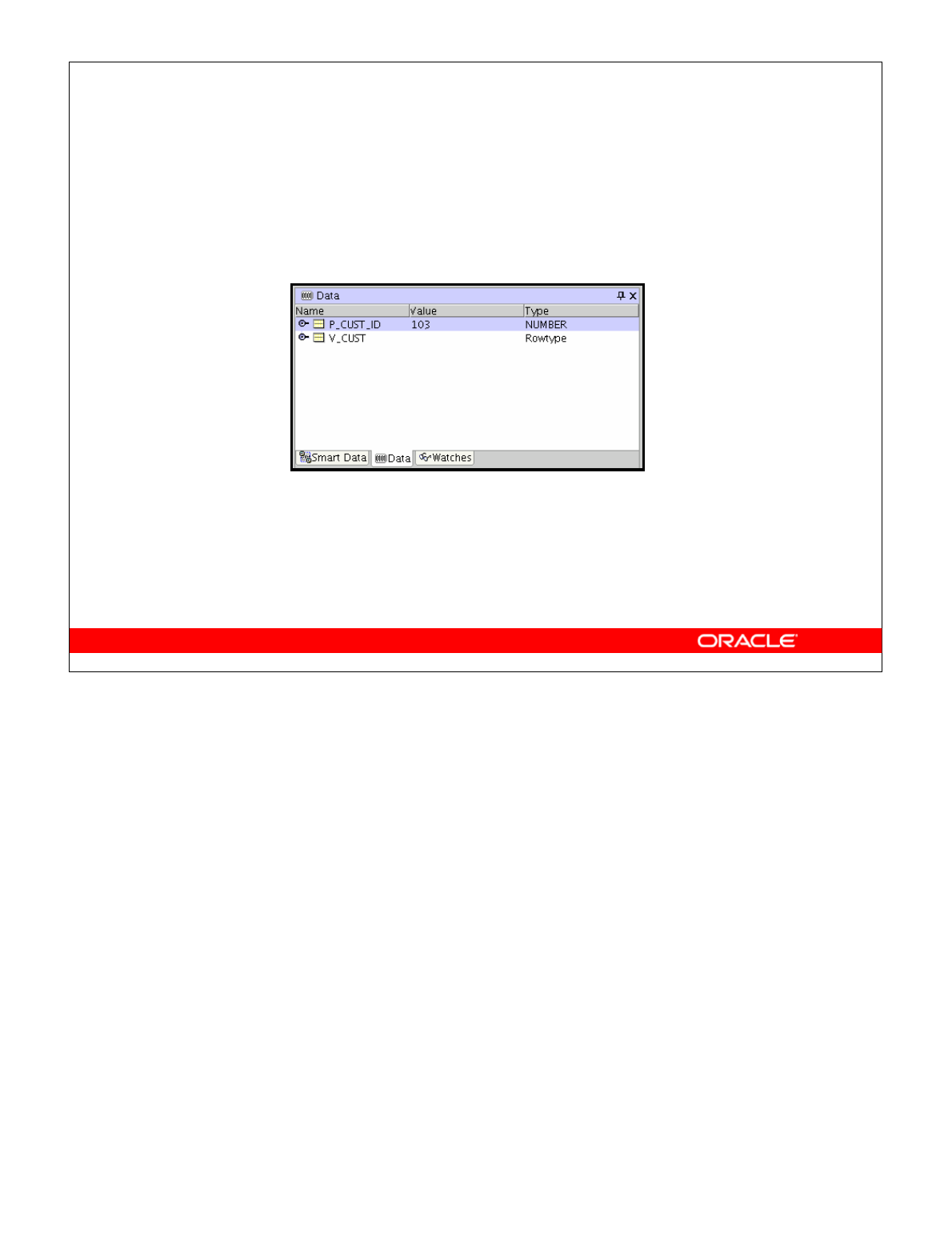
Oracle Database 10g: Develop PL/SQL Program Units E-18
E-18 Copyright © 2004, Oracle. All rights reserved.
Examining and Modifying Variables
Data window
Examining and Modifying Variables
When the debugging is ON, you can examine and modify the value of the variables using the
Data, Smart Data, and Watches windows. You can modify program data values during a
debugging session as a way to test hypothetical bug fixes during a program run. If you find that a
modification fixes a program error, you can exit the debugging session, fix your program code
accordingly, and recompile the program to make the fix permanent.
You use the Data window to display information about variables in your program. The Data
window displays the arguments, local variables, and static fields for the current context, which is
controlled by the selection in the Stack window. If you move to a new context, the Data window
is updated to show the data for the new context. If the current program was compiled without
debug information, you will not be able to see the local variables.
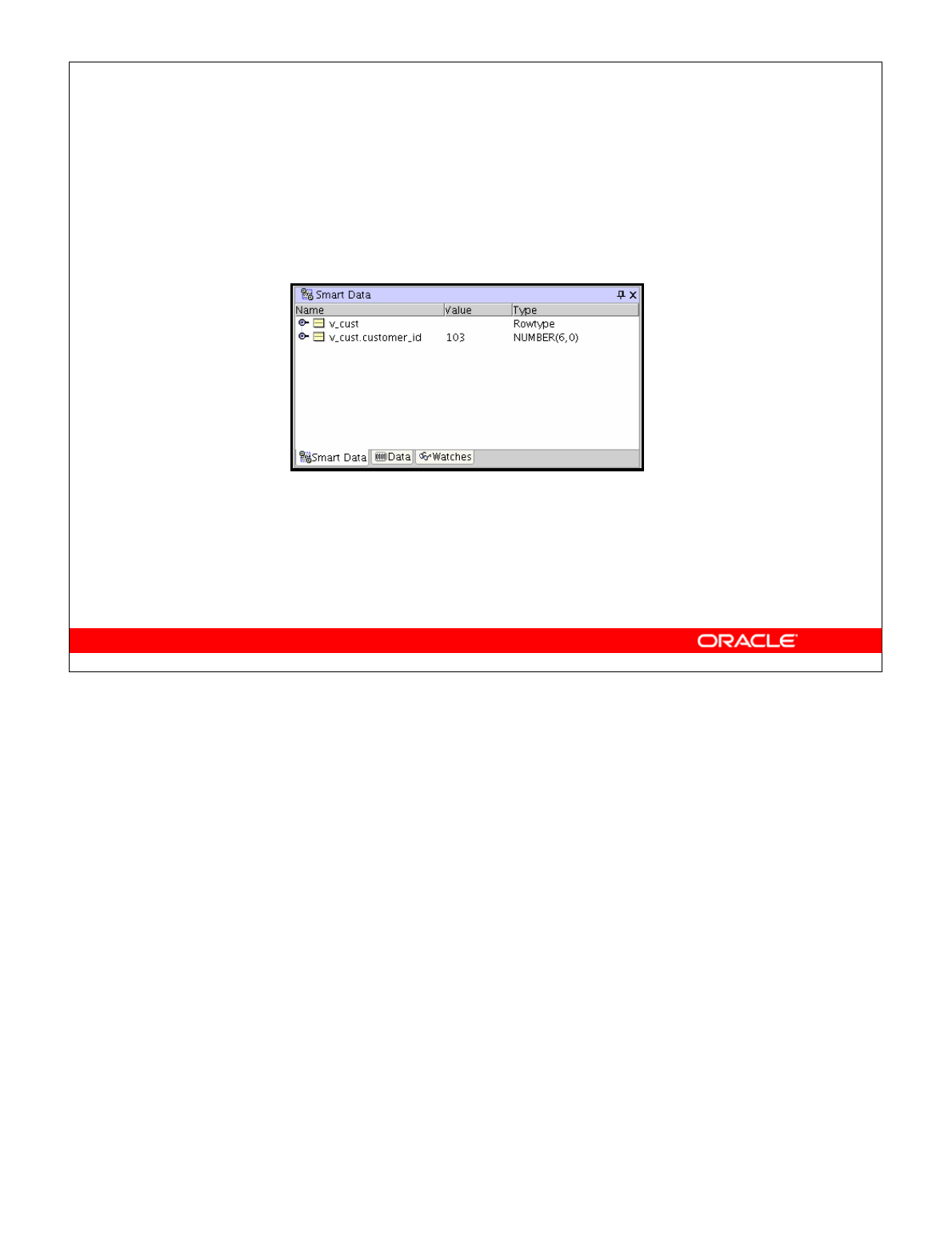
Oracle Database 10g: Develop PL/SQL Program Units E-19
E-19 Copyright © 2004, Oracle. All rights reserved.
Examining and Modifying Variables
Smart Data window
Examining and Modifying Variables (continued)
Unlike the Data window that displays all the variables in your program, the Smart Data window
displays only the data that is relevant to the source code that you are stepping through.

Oracle Database 10g: Develop PL/SQL Program Units E-20
E-20 Copyright © 2004, Oracle. All rights reserved.
Examining and Modifying Variables
Watches window
Examining and Modifying Variables (continued)
A watch enables you to monitor the changing values of variables or expressions as your program
runs. After you enter a watch expression, the Watch window displays the current value of the
expression. As your program runs, the value of the watch changes as your program updates the
values of the variables in the watch expression.
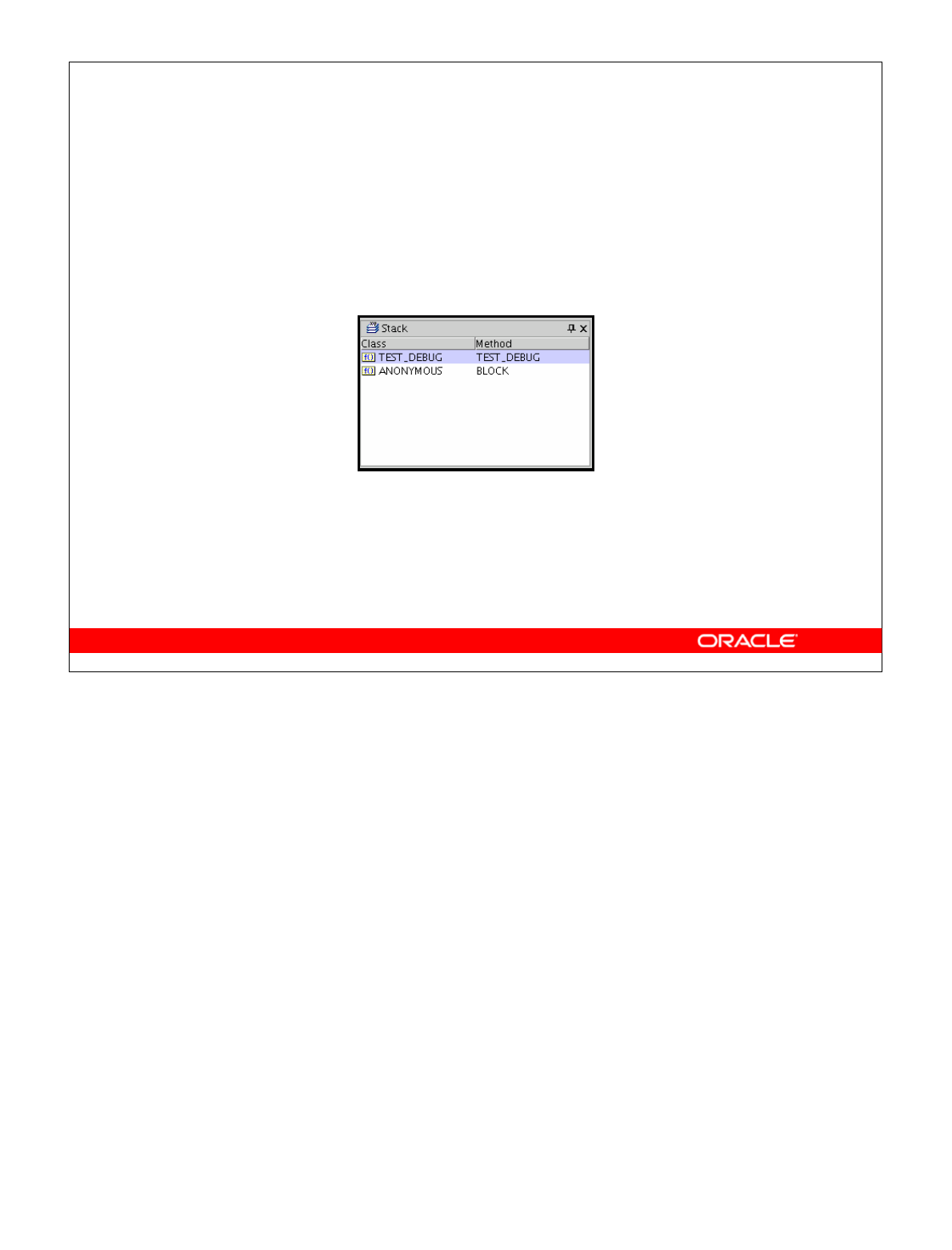
Oracle Database 10g: Develop PL/SQL Program Units E-21
E-21 Copyright © 2004, Oracle. All rights reserved.
Examining and Modifying Variables
Stack window
Examining and Modifying Variables (continued)
You can activate the Stack window by using View > Debugger > Stack. It displays the call stack
for the current thread. When you select a line in the Stack window, the Data window, Watch
window, and all other windows are updated to show data for the selected class.
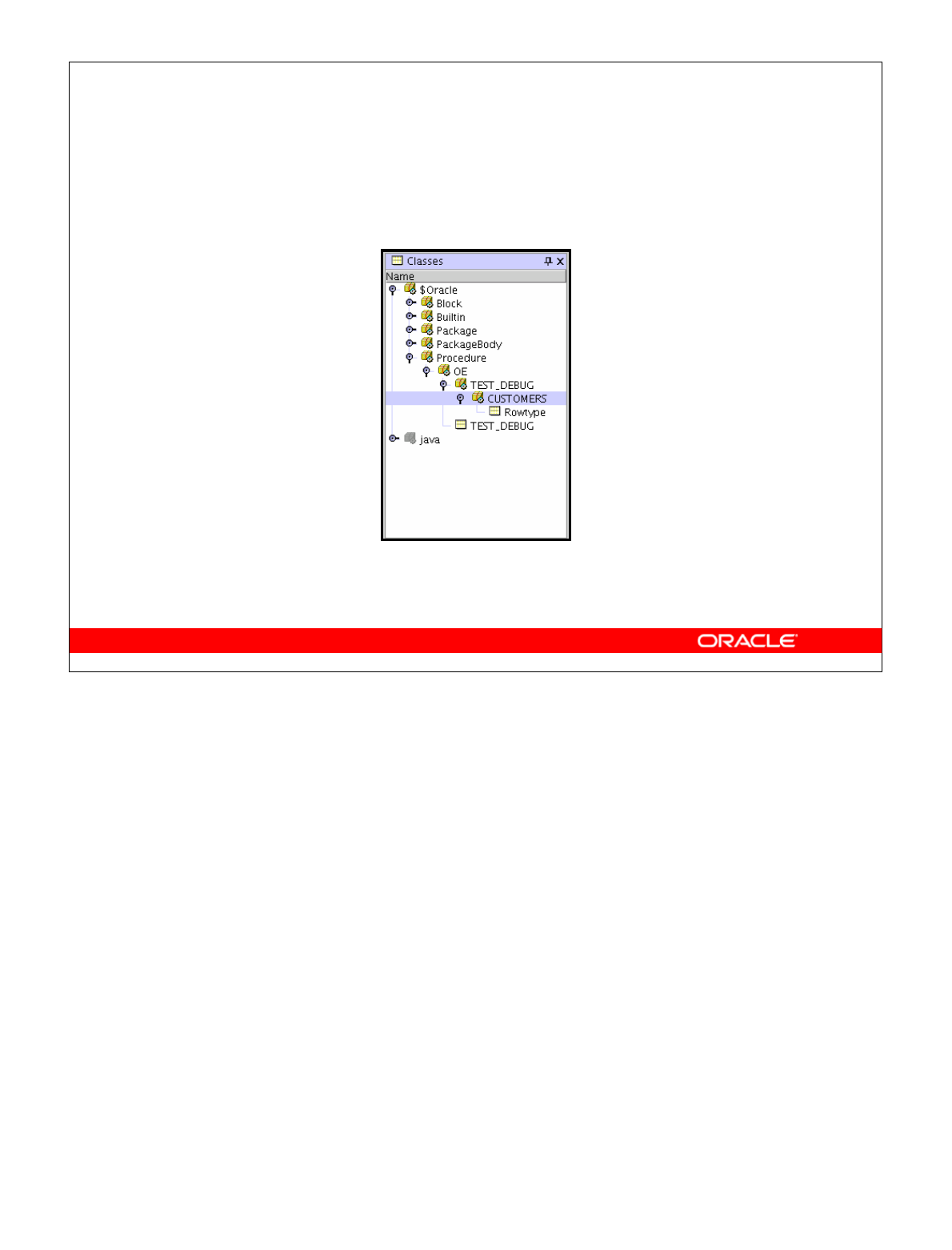
Oracle Database 10g: Develop PL/SQL Program Units E-22
E-22 Copyright © 2004, Oracle. All rights reserved.
Examining and Modifying Variables
Classes window
Examining and Modifying Variables (continued)
The Classes window displays all the classes that are currently being loaded to execute the
program. If used with Oracle Java Virtual Machine (OJVM), it also shows the number of
instances of a class and the memory used by those instances.

Copyright © 2004, Oracle. All rights reserved.
Introduction

Oracle Database 10g: Develop PL/SQL Program Units I-2
I-2 Copyright © 2004, Oracle. All rights reserved.
Lesson Objectives
After completing this lesson, you should be able to do
the following:
•Discuss the goals of the course
•Identify the modular components of PL/SQL:
–Anonymous blocks
–Procedures and functions
–Packages
•Discuss the PL/SQL execution environment
•Describe the database schema and tables that are
used in the course
•List the PL/SQL development environments that
are available in the course
Lesson Aim
PL/SQL supports many program constructs. In this lesson, you review program units in the
form of anonymous blocks, and you are introduced to named PL/SQL blocks. The named
PL/SQL blocks are also referred to as subprograms. The named PL/SQL blocks include
procedures and functions.
The tables from the Human Resources (HR) schema (which is used for the practices in this
course) are briefly discussed. The development tools for writing, testing, and debugging
PL/SQL are listed.

Oracle Database 10g: Develop PL/SQL Program Units I-3
I-3 Copyright © 2004, Oracle. All rights reserved.
Course Objectives
After completing this course, you should be able to do
the following:
•Create, execute, and maintain:
–Procedures and functions with OUT parameters
–Package constructs
–Database triggers
•Manage PL/SQL subprograms and triggers
•Use a subset of Oracle-supplied packages to:
–Generate screen, file, and Web output
–Schedule PL/SQL jobs to run independently
•Build and execute dynamic SQL statements
•Manipulate large objects (LOBs)
Course Objectives
You can develop modularized applications with database procedures by using database
objects such as the following:
• Procedures and functions
• Packages
• Database triggers
Modular applications improve:
• Functionality
• Security
• Overall performance

Oracle Database 10g: Develop PL/SQL Program Units I-4
I-4 Copyright © 2004, Oracle. All rights reserved.
Course Agenda
Lessons that are to be covered on day 1:
Introduction
1. Creating Stored Procedures
2. Creating Stored Functions
3. Creating Packages
4. Using More Package Concepts

Oracle Database 10g: Develop PL/SQL Program Units I-5
I-5 Copyright © 2004, Oracle. All rights reserved.
Course Agenda
Lessons that are to be covered on day 2:
5. Utilizing Oracle-Supplied Packages in Application
Development
6. Dynamic SQL and Metadata
7. Design Considerations for PL/SQL Code
8. Managing Dependencies

Oracle Database 10g: Develop PL/SQL Program Units I-6
I-6 Copyright © 2004, Oracle. All rights reserved.
Course Agenda
Lessons that are to be covered on day 3:
9. Manipulating Large Objects
10. Creating Triggers
11. Applications for Triggers
12. Understanding and Influencing the PL/SQL
Compiler
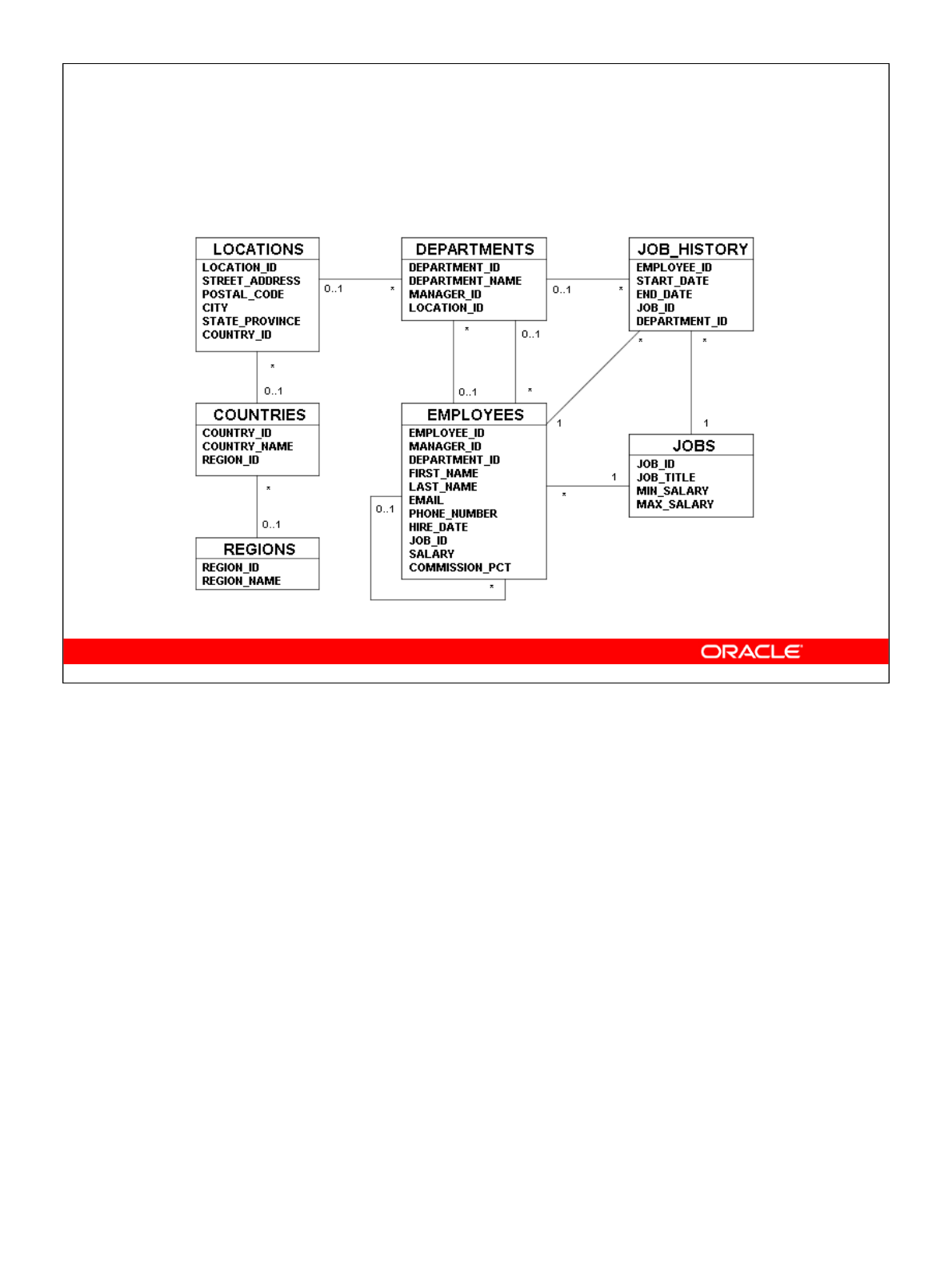
Oracle Database 10g: Develop PL/SQL Program Units I-7
I-7 Copyright © 2004, Oracle. All rights reserved.
Human Resources (HR) Schema
Human Resources (HR) Schema
The Human Resources (HR) schema is part of the Oracle Sample Schemas that can be
installed in an Oracle database. The practice sessions in this course use data from the HR
schema.
Table Descriptions
•REGIONS contains rows that represent a region such as Americas, Asia, and so on.
•COUNTRIES contains rows for countries, each of which is associated with a region.
•LOCATIONS contains the specific address of a specific office, warehouse, or
production site of a company in a particular country.
•DEPARTMENTS shows details of the departments in which employees work. Each
department may have a relationship representing the department manager in the
EMPLOYEES table.
•EMPLOYEES contains details about each employee working for a department. Some
employees may not be assigned to any department.
•JOBS contains the job types that can be held by each employee.
•JOB_HISTORY contains the job history of the employees. If an employee changes
departments within a job or changes jobs within a department, then a new row is
inserted into this table with the old job information of the employee.

Oracle Database 10g: Develop PL/SQL Program Units I-8
I-8 Copyright © 2004, Oracle. All rights reserved.
Creating a Modularized and Layered
Subprogram Design
•Modularize code into subprograms.
1. Locate code sequences repeated more than once.
2. Create subprogram P containing the repeated code.
3. Modify original code to invoke the new subprogram.
•Create subprogram layers for your application.
–Data access subprogram layer with SQL logic
–Business logic subprogram layer, which may or
may not use data access layer
xx xxx xxx
xx xxx xxx
----- --- ---
----- --- ---
xx xxx xxx
xx xxx xxx
----- --- ---
xx xxx xxx
xx xxx xxx
P
----- --- ---
----- --- ---
P
----- --- ---
123
P
Creating a Modularized and Layered Subprogram Design
The diagram illustrates the principle of modularization with subprograms: the creation of
smaller manageable pieces of flexible and reusable code. Flexibility is achieved by using
subprograms with parameters, which in turn makes the same code reusable for different
input values. To modularize existing code, perform the following steps:
1. Locate and identify repetitive sequences of code.
2. Move the repetitive code into a PL/SQL subprogram.
3. Replace the original repetitive code with calls to the new PL/SQL subprogram.
Subprogram Layers
Because PL/SQL allows SQL statements to be seamlessly embedded into the logic, it is
too easy to have SQL statement spread all over the code. However, it is recommended that
you keep the SQL logic separate from the business logic, that is, create a layered
application design with a minimum of two layers:
• Data access layer: For subroutines to access the data by using SQL statements
• Business logic layer: For subprograms to implement the business processing rules,
which may or may not call on the data access layer routines.
Following this modular and layered approach can help you create code that is easier to
maintain, particularly when the business rules change. In addition, keeping the SQL logic
simple and free of complex business logic can benefit from the work of Oracle Database
Optimizer, which can reuse parsed SQL statements for better use of server-side resources.

Oracle Database 10g: Develop PL/SQL Program Units I-9
I-9 Copyright © 2004, Oracle. All rights reserved.
Modularizing Development
with PL/SQL Blocks
•PL/SQL is a block-structured language. The
PL/SQL code block helps modularize code by
using:
–Anonymous blocks
–Procedures and functions
–Packages
–Database triggers
•The benefits of using modular program constructs
are:
–Easy maintenance
–Improved data security and integrity
–Improved performance
–Improved code clarity
Modularizing Development with PL/SQL Blocks
A subprogram is based on standard PL/SQL structures. It contain a declarative section, an
executable section, and an optional exception-handling section (for example, anonymous
blocks, procedures, functions, packages, and triggers). Subprograms can be compiled and
stored in the database, providing modularity, extensibility, reusability, and maintainability.
Modularization converts large blocks of code into smaller groups of code called modules.
After modularization, the modules can be reused by the same program or shared with other
programs. It is easier to maintain and debug code comprised of smaller modules than it is
to maintain code in a single large program. Modules can be easily extended for
customization by incorporating more functionality, if required, without affecting the
remaining modules of the program.
Subprograms provide easy maintenance, because the code is located in one place and any
modifications required to the subprogram can therefore be performed in this single
location. Subprograms provide improved data integrity and security. The data objects are
accessed through the subprogram, and a user can invoke the subprogram only if the
appropriate access privilege is granted to the user.
Note: Knowing how to develop anonymous blocks is a prerequisite for this course. For
detailed information about anonymous blocks, see the Oracle 10g: PL/SQL Fundamentals
course.

Oracle Database 10g: Develop PL/SQL Program Units I-10
I-10 Copyright © 2004, Oracle. All rights reserved.
Review of Anonymous Blocks
Anonymous blocks:
•Form the basic PL/SQL block structure
•Initiate PL/SQL processing tasks from applications
•Can be nested within the executable section of
any PL/SQL block
[DECLARE -- Declaration Section (Optional)
variable declarations; ... ]
BEGIN -- Executable Section (Mandatory)
SQL or PL/SQL statements;
[EXCEPTION -- Exception Section (Optional)
WHEN exception THEN statements; ]
END; -- End of Block (Mandatory)
Review of Anonymous Blocks
Anonymous blocks are typically used for:
• Writing trigger code for Oracle Forms components
• Initiating calls to procedures, functions, and package constructs
• Isolating exception handling within a block of code
• Nesting inside other PL/SQL blocks for managing code flow control
The DECLARE keyword is optional, but it is required if you declare variables, constants,
and exceptions to be used within the PL/SQL block.
BEGIN and END are mandatory and require at least one statement between them, either
SQL, PL/SQL, or both.
The exception section is optional and is used to handle errors that occur within the scope
of the PL/SQL block. Exceptions can be propagated to the caller of the anonymous block
by excluding an exception handler for the specific exception, thus creating what is known
as an unhandled exception.
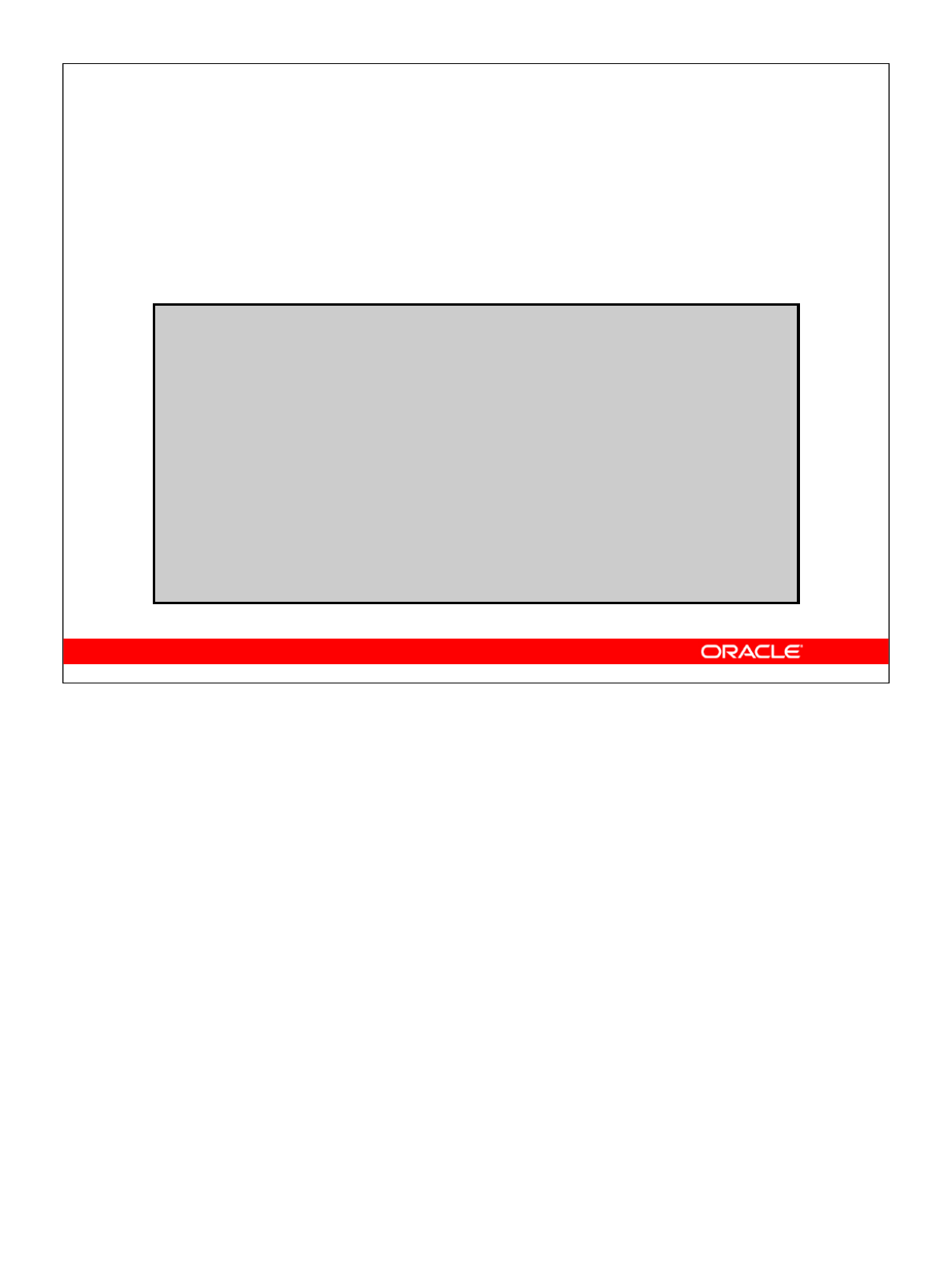
Oracle Database 10g: Develop PL/SQL Program Units I-11
I-11 Copyright © 2004, Oracle. All rights reserved.
Introduction to PL/SQL Procedures
Procedures are named PL/SQL blocks that perform a
sequence of actions.
CREATE PROCEDURE getemp IS -- header
emp_id employees.employee_id%type;
lname employees.last_name%type;
BEGIN
emp_id := 100;
SELECT last_name INTO lname
FROM EMPLOYEES
WHERE employee_id = emp_id;
DBMS_OUTPUT.PUT_LINE('Last name: '||lname);
END;
/
Introduction to PL/SQL Procedures
A procedure is a named PL/SQL block that is created by using a CREATE PROCEDURE
statement. When called, or invoked, a procedure performs a sequence of actions. The
anatomy of the procedure includes:
• The header: “PROCEDURE getemp IS”
• The declaration section: With variable declarations emp_id and lname
• The executable section: Contains the PL/SQL and SQL statements used to obtain the
last name of employee 100. The executable section makes use of the
DBMS_OUTPUT package to print the last name of the employee.
• The exception section: Optional and not used in the example
Note: Hard-coding the value of 100 for emp_id is inflexible. The procedure would be
more reusable if used as a parameter to obtain the employee ID value. Using parameters is
covered in the lesson titled “Creating Stored Procedures.”
To call a procedure by using an anonymous block, use:
BEGIN
getemp;
END;
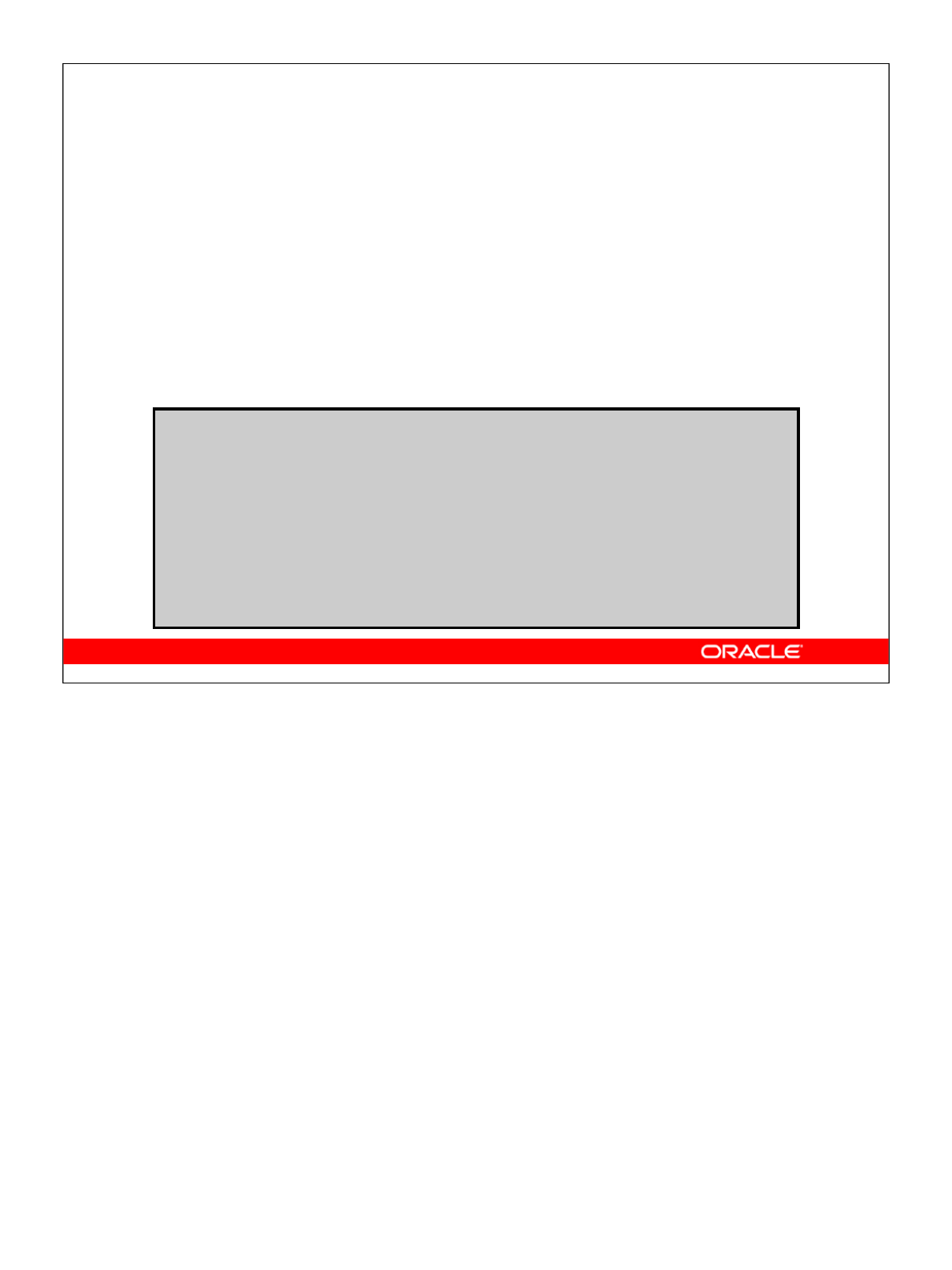
Oracle Database 10g: Develop PL/SQL Program Units I-12
I-12 Copyright © 2004, Oracle. All rights reserved.
Introduction to PL/SQL Functions
Functions are named PL/SQL blocks that perform a
sequence of actions and return a value. A function can
be invoked from:
•Any PL/SQL block
•A SQL statement (subject to some restrictions)
CREATE FUNCTION avg_salary RETURN NUMBER IS
avg_sal employees.salary%type;
BEGIN
SELECT AVG(salary) INTO avg_sal
FROM EMPLOYEES;
RETURN avg_sal;
END;
/
Introduction to PL/SQL Functions
A function is a named PL/SQL block that is created with a CREATE FUNCTION
statement. Functions are used to compute a value that must be returned to the caller.
PL/SQL functions follow the same block structure as procedures. However, the header
starts with the keyword FUNCTION followed by the function name. The header includes
the return data type after the function name (using the keyword RETURN followed by the
data type). The example declares a variable called v_total_salary in the declaration
section, and uses the RETURN statement to return the value retrieved from the SELECT
statement. The value returned represents the total salary for all employees.
A function can be called from:
• Another PL/SQL block where its return value can be stored in a variable or supplied
as a parameter to a procedure
• A SQL statement, subject to restrictions (This topic is covered in the lesson titled
“Creating Stored Functions.”)
To call a function from an anonymous block, use the following:
BEGIN
dbms_output.put_line('Average Salary: ' ||
avg_salary);
END;

Oracle Database 10g: Develop PL/SQL Program Units I-13
I-13 Copyright © 2004, Oracle. All rights reserved.
Introduction to PL/SQL Packages
PL/SQL packages have a specification and an optional
body. Packages group related subprograms together.
CREATE PACKAGE emp_pkg IS
PROCEDURE getemp;
FUNCTION avg_salary RETURN NUMBER;
END emp_pkg;
/
CREATE PACKAGE BODY emp_pkg IS
PROCEDURE getemp IS ...
BEGIN ... END;
FUNCTION avg_salary RETURN NUMBER IS ...
BEGIN ... RETURN avg_sal; END;
END emp_pkg;
/
Introduction to PL/SQL Packages
A PL/SQL package is typically made of of two parts:
• A package specification declaring the public (accessible) components of the package
• A package body that implements public and private components of the package
A package is used to group related PL/SQL code and constructs together. This helps
developers manage and maintain related code in one place. Packages are powerful
constructs and provide a way to logically modularize code into application-specific or
functional groups.
The example declares a package called emp_package that comprises a procedure
getemp and a function total_salary. The specification defines the procedure and
function heading. The package body provides the full implementation of the procedure and
function declared in the package specification. The example is incomplete but provides an
introduction to the concept of a PL/SQL package. The details of PL/SQL packages are
covered in the lesson titled “Creating Packages.”
To call the package procedure from an anonymous block, use the following:
BEGIN
emp_pkg.getemp;
END;

Oracle Database 10g: Develop PL/SQL Program Units I-14
I-14 Copyright © 2004, Oracle. All rights reserved.
Introduction to PL/SQL Triggers
PL/SQL triggers are code blocks that execute when a
specified application, database, or table event occurs.
•Oracle Forms application triggers are standard
anonymous blocks.
•Oracle database triggers have a specific structure.
CREATE TRIGGER check_salary
BEFORE INSERT OR UPDATE ON employees
FOR EACH ROW
DECLARE
c_min constant number(8,2) := 1000.0;
c_max constant number(8,2) := 500000.0;
BEGIN
IF :new.salary > c_max OR
:new.salary < c_min THEN
RAISE_APPLICATION_ERROR(-20000,
'New salary is too small or large');
END IF;
END;
/
Introduction to PL/SQL Triggers
A trigger is a PL/SQL block that executes when a particular event occurs.
A PL/SQL trigger has two forms:
• Application triggers, which are created as blocks of code that execute when a
nominated application event occurs in an Oracle Forms execution environment
• Database triggers, which are named blocks of code that are associated and execute
when a nominated database or table event occurs
The check_salary trigger example shows a database trigger that executes before either
an INSERT or an UPDATE operation occurs on the EMPLOYEES table. The trigger code
checks whether the salary column value is within an acceptable range. If the value is
outside the specified range, then the code uses the RAISE_APPLICATION_ERROR
built-in procedure to fail the operation. The :new syntax, which is used in the example, is
a special bind/host variable that can be used in row-level triggers.
Triggers are covered in detail in the lesson titled “Creating Triggers.”

Oracle Database 10g: Develop PL/SQL Program Units I-15
I-15 Copyright © 2004, Oracle. All rights reserved.
PL/SQL Execution Environment
The PL/SQL run-time architecture:
PL/SQL
Block
PL/SQL engine
Procedural
Statement
Executor
PL/SQL
Block
Oracle Server
SQL Statement Executor
sql
procedural
PL/SQL Execution Environment
The diagram shows a PL/SQL block being executed by the PL/SQL engine. The PL/SQL
engine resides in:
• The Oracle database for executing stored subprograms
• The Oracle Forms client when running client/server applications, or in the Oracle
Application Server when using Oracle Forms Services to run Forms on the Web
Irrespective of the PL/SQL run-time environment, the basic architecture remains the same.
Therefore, all PL/SQL statements are processed in the Procedural Statement Executor, and
all SQL statements must be sent to the SQL Statement Executor for processing by the
Oracle server processes.
The PL/SQL engine is a virtual machine that resides in memory and processes the PL/SQL
m-code instructions. When the PL/SQL engine encounters a SQL statement, a context
switch is made to pass the SQL statement to the Oracle server processes. The PL/SQL
engine waits for the SQL statement to complete and for the results to be returned before it
continues to process subsequent statements in the PL/SQL block.
The Oracle Forms PL/SQL engine runs in the client for the client/server implementation,
and in the application server for the Forms Services implementation. In either case, SQL
statements are typically sent over a network to an Oracle server for processing.

Oracle Database 10g: Develop PL/SQL Program Units I-16
I-16 Copyright © 2004, Oracle. All rights reserved.
PL/SQL Development Environments
This course provides the following tools for
developing PL/SQL code:
•Oracle SQL*Plus (either the GUI or command-line
versions)
•Oracle iSQL*Plus (used from a browser)
•Oracle JDeveloper IDE
PL/SQL Development Environments
There are many tools that provide an environment for developing PL/SQL code. Oracle
provides several tools that can be used to write PL/SQL code. Some of the development
tools that are available for use in this course are:
•Oracle iSQL*Plus: a browser-based application
• Oracle SQL*Plus: a window or command-line application
• Oracle JDeveloper: a window-based integrated development environment (IDE)
Note: The code and screen examples presented in the course notes were generated from
output in the iSQL*Plus environment.
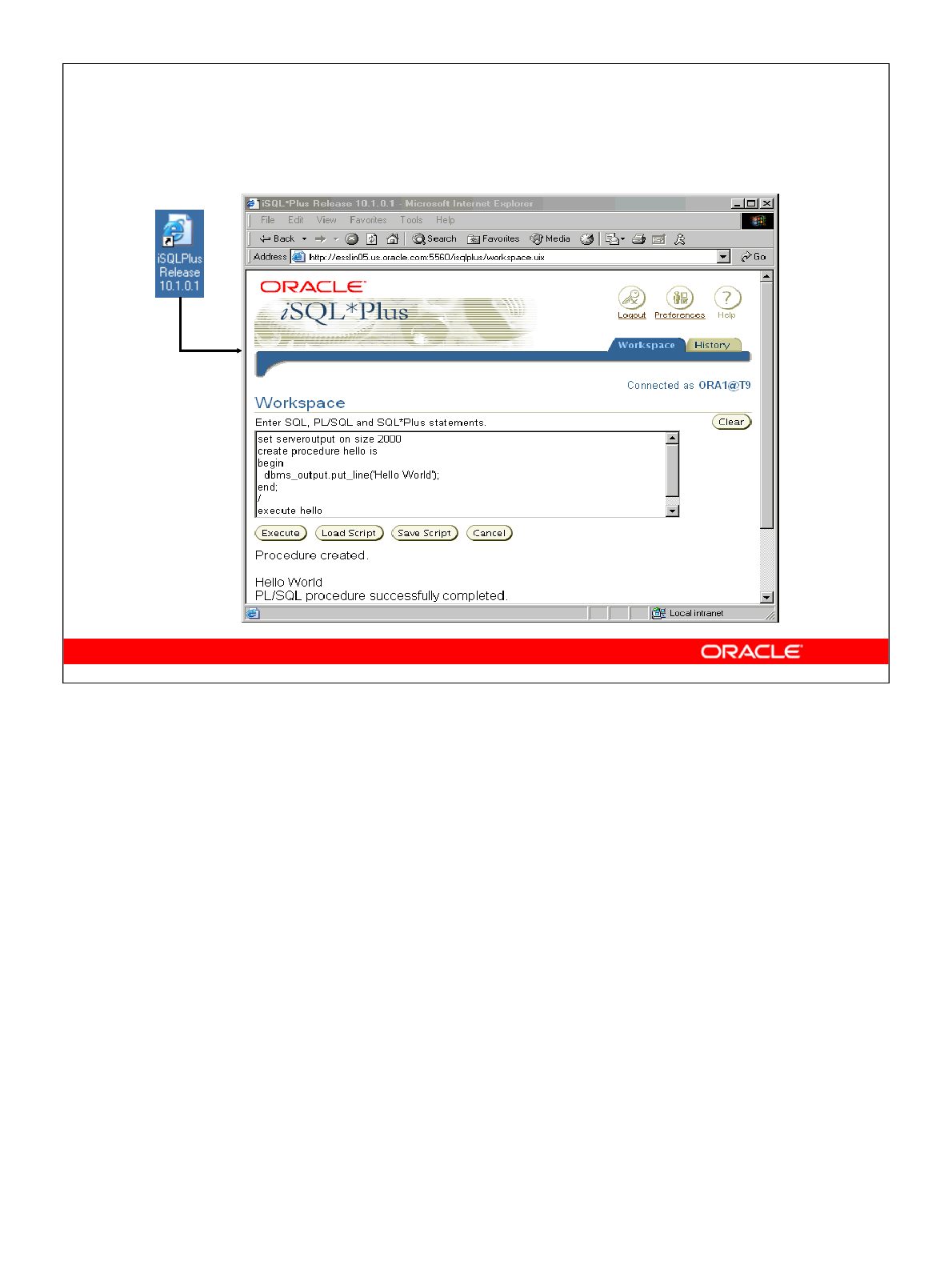
Oracle Database 10g: Develop PL/SQL Program Units I-17
I-17 Copyright © 2004, Oracle. All rights reserved.
Coding PL/SQL in iSQL*Plus
Coding PL/SQL in iSQL*Plus
Oracle iSQL*Plus is a Web application that allows you to submit SQL statements and
PL/SQL blocks for execution and receive the results in a standard Web browser.
iSQL*Plus is:
• Shipped with the database
• Installed in the middle tier
• Accessed from a Web browser by using a URL format that is similar to the following
example:
http://host:port/isqlplus
The host and port are for the Web server name and HTTP listener port.
When coding PL/SQL subprograms in the iSQL*Plus tool, consider the following:
• You create subprograms by using the CREATE SQL statement.
• You execute subprograms by using either an anonymous PL/SQL block or the
EXECUTE command.
• If you use the DBMS_OUTPUT package procedures to print text to the screen, you
must first execute the SET SERVEROUTPUT ON command in your session.
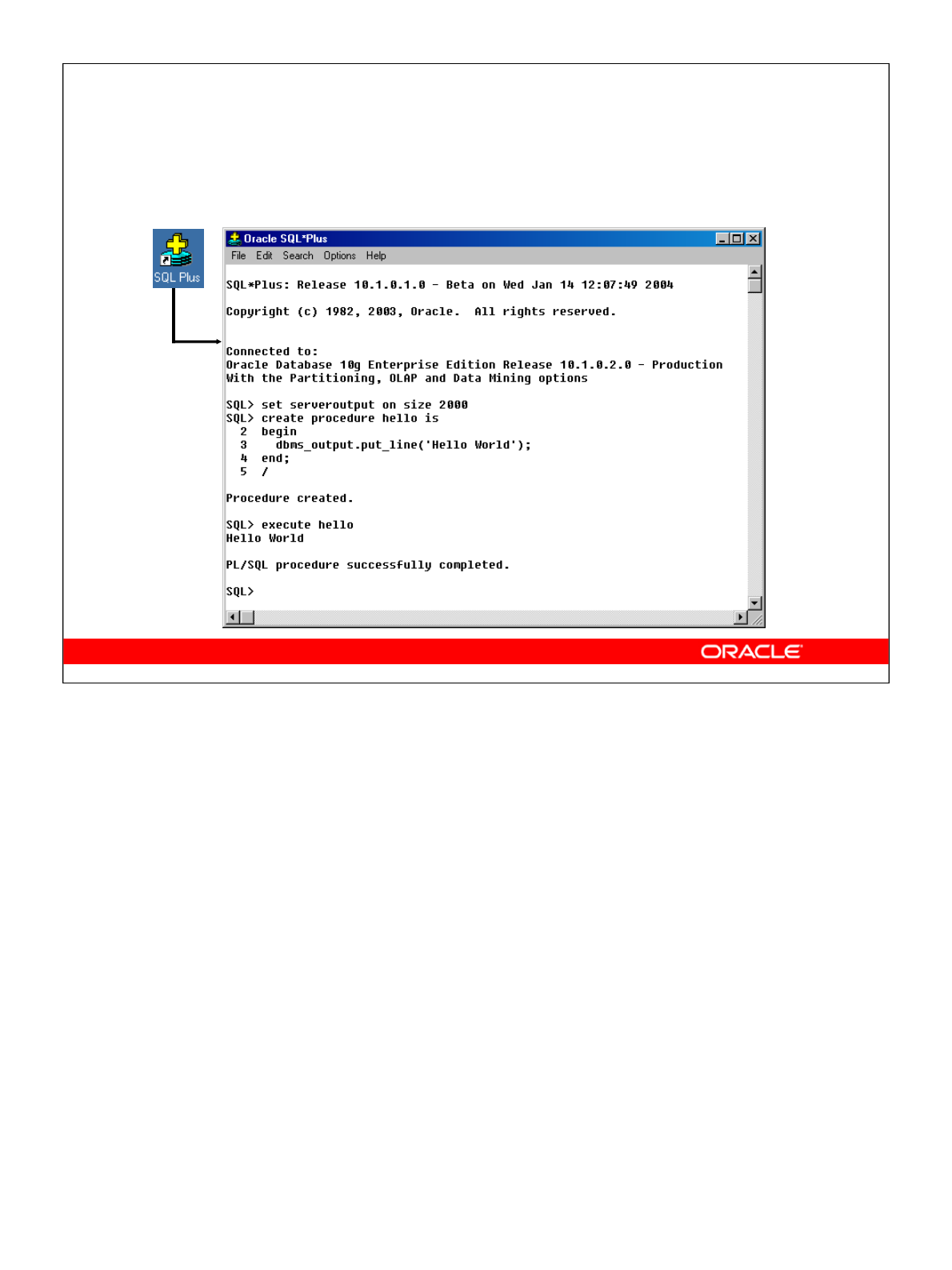
Oracle Database 10g: Develop PL/SQL Program Units I-18
I-18 Copyright © 2004, Oracle. All rights reserved.
Coding PL/SQL in SQL*Plus
Coding PL/SQL in SQL*Plus
Oracle SQL*Plus is a graphical user interface (GUI) or command-line application that
enables you to submit SQL statements and PL/SQL blocks for execution and receive the
results in an application or command window.
SQL*Plus is:
• Shipped with the database
• Installed on a client and on the database server system
• Accessed from an icon or the command line
When coding PL/SQL subprograms using SQL*Plus, consider the following:
• You create subprograms by using the CREATE SQL statement.
• You execute subprograms by using either an anonymous PL/SQL block or the
EXECUTE command.
• If you use the DBMS_OUTPUT package procedures to print text to the screen, you
must first execute the SET SERVEROUTPUT ON command in your session.
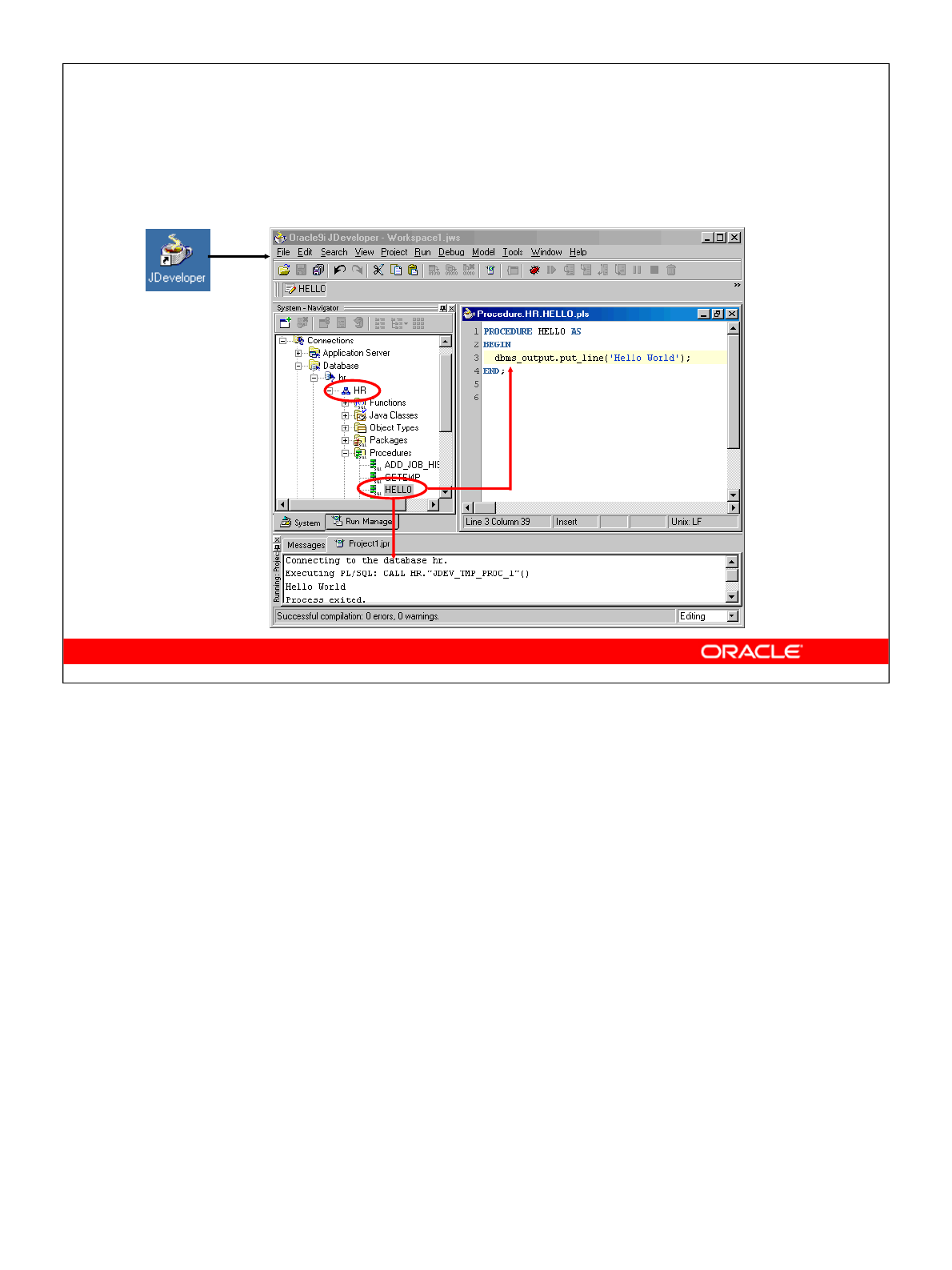
Oracle Database 10g: Develop PL/SQL Program Units I-19
I-19 Copyright © 2004, Oracle. All rights reserved.
Coding PL/SQL in Oracle JDeveloper
Edit
Run
Coding PL/SQL in Oracle JDeveloper
Oracle JDeveloper allows developers to create, edit, test, and debug PL/SQL code by using
a sophisticated GUI. Oracle JDeveloper is a part of Oracle Developer Suite and is also
available as a separate product.
When coding PL/SQL in JDeveloper, consider the following:
• You first create a database connection to enable JDeveloper to access a database
schema owner for the subprograms.
• You can then use the JDeveloper context menus on the Database connection to create
a new subprogram construct using the built-in JDeveloper Code Editor. The
JDeveloper Code Editor provides an excellent environment for PL/SQL
development, with features such as the following:
- Different colors for syntactical components of the PL/SQL language
- Code insight to rapidly locate procedures and functions in supplied packages
• You invoke a subprogram by using a Run command on the context menu for the
named subprogram. The output appears in the JDeveloper Log Message window, as
shown at the bottom of the screenshot.
Note: JDeveloper provides color-coding syntax in the JDeveloper Code Editor and is
sensitive to PL/SQL language constructs and statements.

Oracle Database 10g: Develop PL/SQL Program Units I-20
I-20 Copyright © 2004, Oracle. All rights reserved.
Summary
In this lesson, you should have learned how to:
•Declare named PL/SQL blocks: Procedures,
functions, packages, and triggers
•Use anonymous (unnamed) PL/SQL blocks to
invoke stored procedures and functions
•Use iSQL*Plus or SQL*Plus for developing PL/SQL
code
•Explain the PL/SQL execution environment:
–The client-side PL/SQL engine for executing PL/SQL
code in Oracle Forms and Oracle Reports
–The server-side PL/SQL engine for executing
PL/SQL code stored in an Oracle database
Summary
The PL/SQL language provides different program constructs for blocks of reusable code.
Unnamed or anonymous PL/SQL blocks can be used to invoke SQL and PL/SQL actions,
procedures, functions, and package components. Named PL/SQL blocks, otherwise known
as subprograms, include:
• Procedures
• Functions
• Package procedures and functions
• Triggers
Oracle supplies several tools to develop your PL/SQL functionality.
Oracle provides a client-side or middle-tier PL/SQL run-time environment for Oracle
Forms and Oracle Reports, and provides a PL/SQL run-time engine inside the Oracle
database. Procedures and functions inside the database can be invoked from any
application code that can connect to an Oracle database and execute PL/SQL code.

Oracle Database 10g: Develop PL/SQL Program Units I-21
I-21 Copyright © 2004, Oracle. All rights reserved.
Practice I: Overview
This practice covers the following topics:
•Browsing the HR tables
•Creating a simple PL/SQL procedure
•Creating a simple PL/SQL function
•Using an anonymous block to execute the PL/SQL
procedure and function
Practice I: Overview
In this practice, you use iSQL*Plus to execute SQL statements to examine data in the HR
schema. You also create a simple procedure and function that you invoke by using an
anonymous block or the EXECUTE command in iSQL*Plus. Optionally, you can
experiment by creating and executing the PL/SQL code in SQL*Plus.
Note: All written practices use iSQL*Plus as the development environment. However, you
can use any of the tools that are provided in your course environment.

Oracle Database 10g: Develop PL/SQL Program Units I-22
Practice I
1. Launch iSQL*Plus using the icon that is provided on your desktop.
a. Log in to the database by using the username and database connect string details
provided by your instructor (you may optionally write the information here for
your records):
Username: ora__
Password: oracle
Database Connect String/Tnsname: T__
b. Execute basic SELECT statements to query the data in the DEPARTMENTS,
EMPLOYEES, and JOBS tables. Take a few minutes to familiarize yourself with
the data, or consult Appendix B, which provides a description and some data from
each table in the Human Resources schema.
2. Create a procedure called HELLO to display the text “Hello World”.
a. Create a procedure called HELLO.
b. In the executable section, use the DBMS_OUTPUT.PUT_LINE procedure to print
the text “Hello Word”, and save the code in the database.
Note: If you get compile time errors, edit the PL/SQL to correct the code and
replace the CREATE keyword with the text CREATE OR REPLACE.
c. Execute the SET SERVEROUTPUT ON command to ensure that the output from
the DBMS_OUTPUT.PUT_LINE procedure is displayed in iSQL*Plus.
d. Create an anonymous block to invoke the stored procedure.
3. Create a function called TOTAL_SALARY to compute the sum of all employee
salaries.
a. Create a function called TOTAL_SALARY that returns a NUMBER.
b. In the executable section, execute a query to store the total salary of all employees
in a local variable that you declare in the declaration section. Return the value
stored in the local variable. Save and compile the code.
c. Use an anonymous block to invoke the function. To display the result computed
by the function, use the DBMS_OUTPUT.PUT_LINE procedure.
Hint: Either nest the function call inside the DBMS_OUTPUT.PUT_LINE
parameter, or store the function result in a local variable of the anonymous block
and use the local variable in the DBMS_OUTPUT.PUT_LINE procedure.
If you have time, complete the following exercise:
4. Launch SQL*Plus using the icon that is provided on your desktop.
a. Invoke the procedure and function that you created in exercises 2 and 3.
b. Create a new procedure called HELLO_AGAIN to print “Hello World
again”.
c. Invoke the HELLO_AGAIN procedure with an anonymous block.

Additional
Practices

Oracle Database 10g: Develop PL/SQL Program Units AP-2
Additional Practices: Overview
These additional practices are provided as a supplement to the course Oracle Database 10g:
Develop PL/SQL Program Units. In these practices, you apply the concepts that you learned
in the course.
The additional practices comprise two parts:
Part A provides supplemental exercises to create stored procedures, functions, packages, and
triggers, and to use the Oracle-supplied packages with iSQL*Plus as the development
environment. The tables used in this portion of the additional practice include EMPLOYEES,
JOBS, JOB_HISTORY, and DEPARTMENTS.
Part B is a case study that can be completed at the end of the course. This part supplements
the practices for creating and managing program units. The tables used in the case study are
based on a video database and contain the TITLE, TITLE_COPY, RENTAL,
RESERVATION, and MEMBER tables.
An entity relationship diagram is provided at the start of part A and part B. Each entity
relationship diagram displays the table entities and their relationships. More detailed
definitions of the tables and the data contained in them is provided in the appendix titled
“Additional Practices: Table Descriptions and Data.”
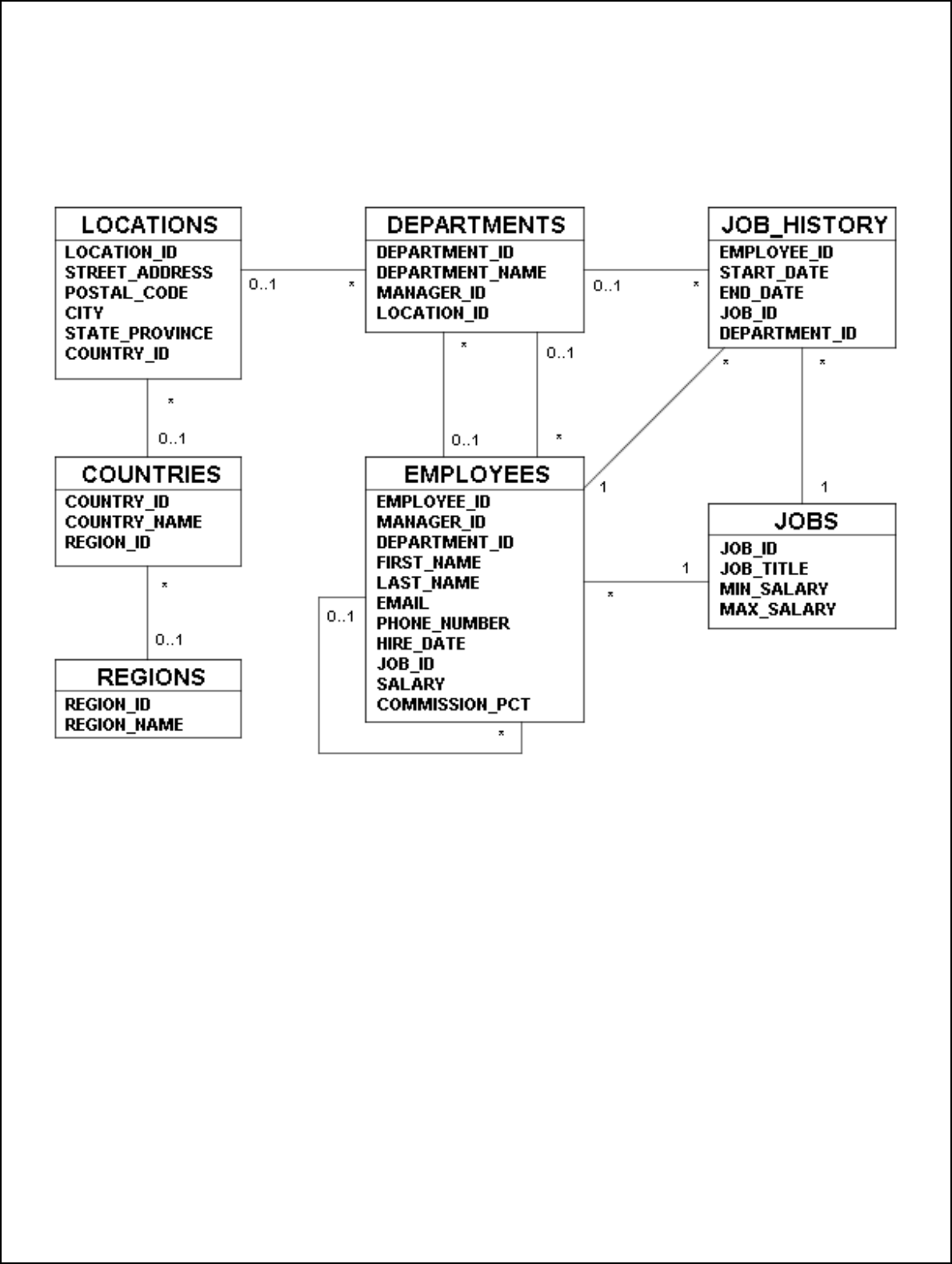
Oracle Database 10g: Develop PL/SQL Program Units AP-3
Part A: Entity Relationship Diagram
Human Resources

Oracle Database 10g: Develop PL/SQL Program Units AP-4
Part A (continued)
Note: These exercises can be used for extra practice when discussing how to create
procedures.
1. In this exercise, create a program to add a new job into the JOBS table.
a. Create a stored procedure called NEW_JOB to enter a new order into the JOBS
table. The procedure should accept three parameters. The first and second
parameters supply a job ID and a job title. The third parameter supplies the
minimum salary. Use the maximum salary for the new job as twice the minimum
salary supplied for the job ID.
b. Invoke the procedure to add a new job with job ID 'SY_ANAL', job title
'System Analyst', and minimum salary of 6,000.
c. Verify whether a row was added and note the new job ID for use in the next
exercise. Commit the changes.
2. In this exercise, create a program to add a new row to the JOB_HISTORY table, for an
existing employee.
a. Create a stored procedure called ADD_JOB_HIST to add a new row into the
JOB_HISTORY table for an employee who is changing his job to the new job ID
('SY_ANAL') that you created in question 1b.
The procedure should provide two parameters, one for the employee ID who is
changing the job, and the second for the new job ID. Read the employee ID from
the EMPLOYEES table and insert it into the JOB_HISTORY table. Make hire
date of this employee as start date and today’s date as end date for this row in the
JOB_HISTORY table.
Change the hire date of this employee in the EMPLOYEES table to today’s date.
Update the job ID of this employee to the job ID passed as parameter (use the
'SY_ANAL' job ID ) and salary equal to minimum salary for that job ID + 500.
Note: Include exception handling to handle an attempt to insert a nonexistent
employee.
b. Disable all triggers on the EMPLOYEES, JOBS, and JOB_HISTORY tables
before invoking the ADD_JOB_HIST procedure.
c. Execute the procedure with employee ID 106 and job ID 'SY_ANAL' as
parameters.
d. Query the JOB_HISTORY and EMPLOYEES tables to view your changes for
employee 106, and then commit the changes.
e. Re-enable the triggers on the EMPLOYEES, JOBS, and JOB_HISTORY tables.
3. In this exercise, create a program to update the minimum and maximum salaries for a
job in the JOBS table.
a. Create a stored procedure called UPD_JOBSAL to update the minimum and
maximum salaries for a specific job ID in the JOBS table. The procedure should
provide three parameters: the job ID, a new minimum salary, and a new
maximum salary. Add exception handling to account for an invalid job ID in the
JOBS table. Raise an exception if the maximum salary supplied is less than the
minimum salary, and . Provide a message that will be displayed if the row in the
JOBS table is locked.
Hint: The resource locked/busy error number is –54.

Oracle Database 10g: Develop PL/SQL Program Units AP-5
Part A (continued)
b. Execute the UPD_JOBSAL procedure by using a job ID of 'SY_ANAL', a
minimum salary of 7000, and a maximum salary of 140.
Note: This should generate an exception message.
c. Disable triggers on the EMPLOYEES and JOBS tables.
d. Execute the UPD_JOBSAL procedure using a job ID of 'SY_ANAL', a
minimum salary of 7000, and a maximum salary of 14000.
e. Query the JOBS table to view your changes, and then commit the changes.
f. Enable the triggers on the EMPLOYEES and JOBS tables.
4. In this exercise, create a procedure to monitor whether employees have exceeded their
average salaries for their job type.
a. Disable the trigger SECURE_EMPLOYEES.
b. In the EMPLOYEES table, add an EXCEED_AVGSAL column to store up to three
characters and a default value of ‘NO’. Use a check constraint to allow the values
‘YES’or ‘NO’.
c. Write a stored procedure called CHECK_AVGSAL which checks if each
employee’s salary exceeds the average salary for the JOB_ID. The average
salary for a job is calculated from information in JOBS table. If the employee’s
salary exceeds the average for their job then update their EXCEED_AVGSAL
column in the EMPLOYEES table to a value of YES, otherwise, set the value to
NO. Use a cursor to select the employees rows using the FOR UPDATE option in
the query. Add exception handling to account for a record being locked.
Hint: The resource locked/busy error number is –54. Write and use a local
function called GET_JOB_AVGSAL to determine the average salary for a job ID
specified as a parameter.
d. Execute the CHECK_AVGSAL procedure. Then, to view the results of your
modifications, write a query to display the employee’s ID, job, the average salary
for the job, the employee’s salary and exceed_avgsal indicator column for
employees whose salaries exceed the average for their job, and finally commit
the changes.
Note: These exercises can be used for extra practice when discussing how to create
functions.
5. Create a subprogram to retrieve the number of years of service for a specific employee.
a. Create a stored function called GET_YEARS_SERVICE to retrieve the total
number of years of service for a specific employee. The function should accept
the employee ID as a parameter and return the number of years of service. Add
error handling to account for an invalid employee ID.
b. Invoke the GET_YEARS_SERVICE function in a call to
DBMS_OUTPUT.PUT_LINE for an employee with ID 999.
c. Display the number of years service for employee 106 with
DBMS_OUTPUT.PUT_LINE invoking the GET_YEARS_SERVICE function.
d. Query the JOB_HISTORY and EMPLOYEES tables for the specified employee to
verify that the modifications are accurate. The values represented in the results
on this page may differ from those you get when you run these queries.

Oracle Database 10g: Develop PL/SQL Program Units AP-6
Part A (continued)
6. In this exercise, create a program to retrieve the number of different jobs that an
employee worked during his or her service.
a. Create a stored function called GET_JOB_COUNT to retrieve the total number
of different jobs on which an employee worked.
The function should accept the employee ID in a parameter, and return the
number of different jobs that employee worked until now, including the present
job. Add exception handling to account for an invalid employee ID.
Hint: Use the distinct job IDs from the JOB_HISTORY table, and exclude the
current job ID, if it is one of the job IDs on which the has employee has already
worked. Write a UNION of two queries and count the rows retrieved into a
PL/SQL table. Use a FETCH with BULK COLLECT INTO to obtain the
unique jobs for the employee.
b. Invoke the function for employee with ID of 176.
Note: These exercises can be used for extra practice when discussing how to create
packages.
7. Create a package called EMPJOB_PKG that contains your NEW_JOB,
ADD_JOB_HIST, UPD_JOBSAL procedures, as well as your
GET_YEARS_SERVICE and GET_JOB_COUNT functions.
a. Create the package specification with all the subprogram constructs public. Move
any subprogram local-defined types into the package specification.
b. Create the package body with the subprogram implementation, remember to
remove, from the subprogram implementations, any types that you moved into
the package specification.
c. Invoke your EMPJOB_PKG.NEW_JOB procedure to create a new job with ID
PR_MAN, job title Public Relations Manager, and salary of 6,250.
d. Invoke your EMPJOB_PKG.ADD_JOB_HIST procedure to modify the job of
employee ID 110 to job ID PR_MAN.
Note: You will need to disable the UPDATE_JOB_HISTORY trigger before you
execute the ADD_JOB_HIST procedure, and re-enable the trigger after you have
executed the procedure.
e. Query the JOBS, JOB_HISTORY, and EMPLOYEES tables to verify the results.
Note: These exercises can be used for extra practice when discussing how to create
database triggers.
8. In this exercise, create a trigger to ensure that the minimum and maximum salaries of a
job are never modified such that the salary of an existing employee with that job ID is
out of the new range specified for the job.
a. Create a trigger called CHECK_SAL_RANGE that is fired before every row that is
updated in the MIN_SALARY and MAX_SALARY columns in the JOBS table.
For any minimum or maximum salary value that is changed, check if the salary
of any existing employee with that job ID in the EMPLOYEES table falls within
the new range of salaries specified for this job ID. Include exception handling to
cover a salary range change that affects the record of any existing employee.

Oracle Database 10g: Develop PL/SQL Program Units AP-7
Part A (continued)
b. Test the trigger using the SY_ANAL job, setting the new minimum salary to
5000, and the new maximum salary to 7000. Before you make the change,
write a query to display the current salary range for the SY_ANAL job ID, and
another query to display the employee ID, last name, and salary for the same job
ID. After the update, query the change (if any) to the JOBS table for the specified
job ID.
c. Using the SY_ANAL job, set the new minimum salary to 7000, and the new
maximum salary to 18000. Explain the results.
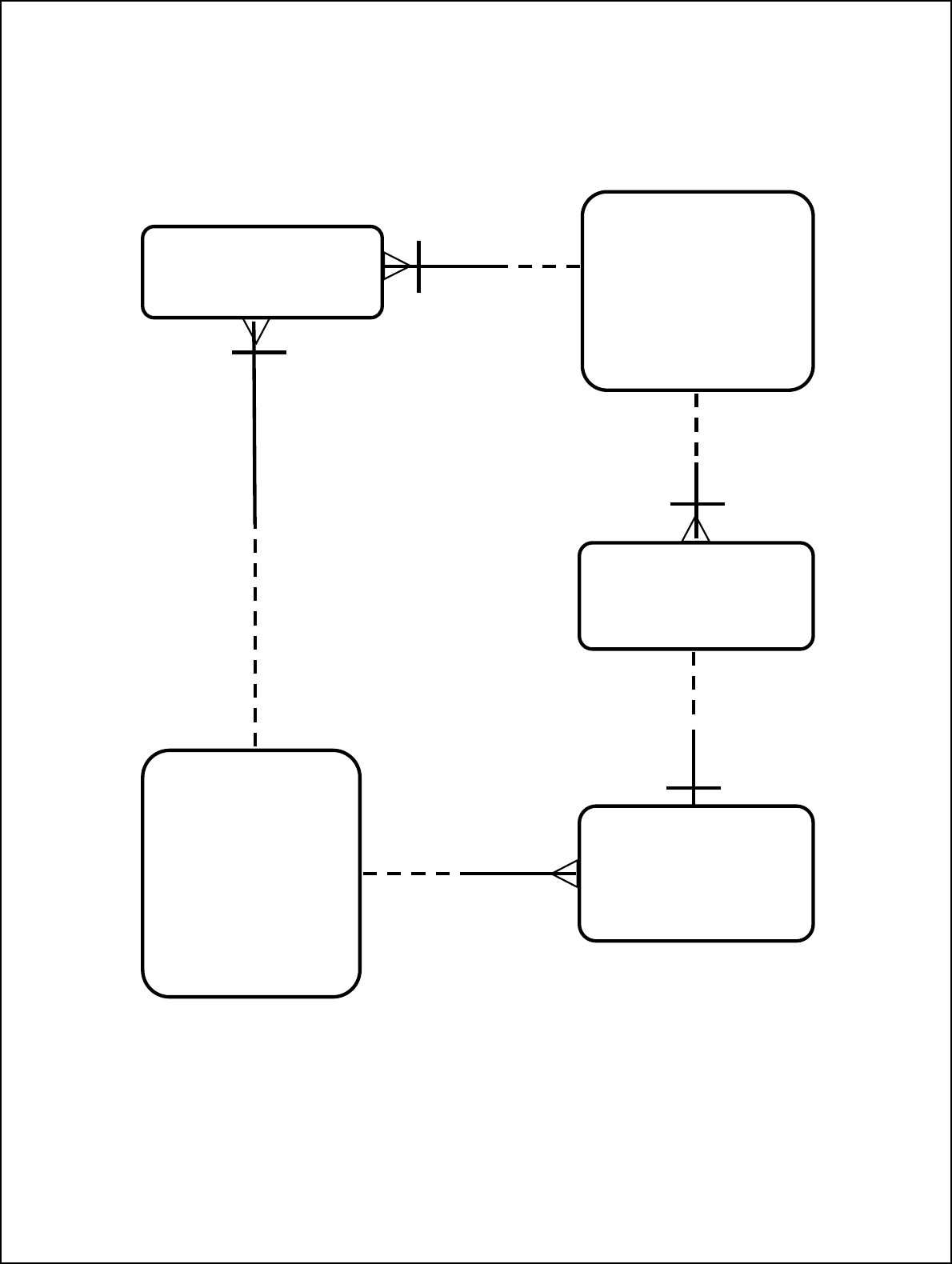
Oracle Database 10g: Develop PL/SQL Program Units AP-8
Part B: Entity Relationship Diagram
TITLE
#* ID
* title
* description
o rating
o category
o release date
TITLE_COPY
#* ID
* status
RENTAL
#* book date
o act ret date
o exp ret date
MEMBER
#* ID
* last name
o first name
o address
o city
o phone
* join date
RESERVATION
#* reservation date
for
the subject
of
available as
a copy
the subject of
made against
responsible
for
created
for
responsible
for
set up for

Oracle Database 10g: Develop PL/SQL Program Units AP-9
Part B (continued)
In this case study, you create a package named VIDEO_PKG that contains procedures and
functions for a video store application. This application enables customers to become a
member of the video store. Any member can rent movies, return rented movies, and reserve
movies. Additionally, you create a trigger to ensure that any data in the video tables is
modified only during business hours.
Create the package by using iSQL*Plus and use the DBMS_OUTPUT Oracle-supplied
package to display messages.
The video store database contains the following tables: TITLE, TITLE_COPY, RENTAL,
RESERVATION, and MEMBER. The entity relationship diagram is shown on the previous
page.

Oracle Database 10g: Develop PL/SQL Program Units AP-10
Part B (continued)
1. Load and execute the script E:\labs\PLPU\labs\buildvid1.sql to create all
the required tables and sequences that are needed for this exercise.
2. Load and execute the script E:\labs\PLPU\labs\buildvid2.sql to populate
all the tables created through by the buildvid1.sql script.
3. Create a package named VIDEO_PKG with the following procedures and functions:
a. NEW_MEMBER:A public procedure that adds a new member to the MEMBER
table. For the member ID number, use the sequence MEMBER_ID_SEQ; for the
join date, use SYSDATE. Pass all other values to be inserted into a new row as
parameters.
b. NEW_RENTAL:An overloaded public function to record a new rental. Pass the
title ID number for the video that a customer wants to rent, and either the
customer’s last name or his member ID number into the function. The function
should return the due date for the video. Due dates are three days from the date
the video is rented. If the status for a movie requested is listed as AVAILABLE in
the TITLE_COPY table for one copy of this title, then update this TITLE_COPY
table and set the status to RENTED. If there is no copy available, the function
must return NULL. Then, insert a new record into the RENTAL table identifying
the booked date as today's date, the copy ID number, the member ID number,
the title ID number and the expected return date. Be aware of multiple customers
with the same last name. In this case, have the function return NULL, and display
a list of the customers’ names that match and their ID numbers.
c. RETURN_MOVIE:A public procedure that updates the status of a video
(available, rented, or damaged) and sets the return date. Pass the title ID, the
copy ID and the status to this procedure. Check whether there are reservations
for that title, and display a message, if it is reserved. Update the RENTAL table
and set the actual return date to today’s date. Update the status in the
TITLE_COPY table based on the status parameter passed into the procedure.
d. RESERVE_MOVIE:A private procedure that executes only if all the video
copies requested in the NEW_RENTAL procedure have a status of RENTED. Pass
the member ID number and the title ID number to this procedure. Insert a new
record into the RESERVATION table and record the reservation date, member
ID number, and title ID number. Print a message indicating that a movie is
reserved and its expected date of return.
e. EXCEPTION_HANDLER:A private procedure that is called from the exception
handler of the public programs. Pass the SQLCODE number to this procedure,
and the name of the program (as a text string) where the error occurred. Use
RAISE_APPLICATION_ERROR to raise a customized error. Start with a
unique key violation (-1) and foreign key violation
(-2292). Allow the exception handler to raise a generic error for any other
errors.

Oracle Database 10g: Develop PL/SQL Program Units AP-11
Part B (continued)
4. Use the following scripts located in the E:\labs\PLPU\soln directory to test your
routines:
a. Add two members using sol_apb_04_a_new_members.sql.
b. Add new video rentals using sol_apb_04_b_new_rentals.sql.
c. Return movies using the sol_apb_04_c_return_movie.sql script.
5. The business hours for the video store are 8:00 a.m. to 10:00 p.m., Sunday through
Friday, and 8:00 a.m. to 12:00 a.m. on Saturday. To ensure that the tables can only be
modified during these hours, create a stored procedure that is called by triggers on the
tables.
a. Create a stored procedure called TIME_CHECK that checks the current time
against business hours. If the current time is not within business hours, use the
RAISE_APPLICATION_ERROR procedure to give an appropriate message.
b. Create a trigger on each of the five tables. Fire the trigger before data is inserted,
updated, and deleted from the tables. Call your TIME_CHECK procedure from
each of these triggers.


Additional Practices:
Table Descriptions
and Data

Oracle Database 10g: Develop PL/SQL Program Units Table Description-2
Part A
The tables and data used in part A are the same as those in Appendix B, “Table
Descriptions and Data.”

Oracle Database 10g: Develop PL/SQL Program Units Table Description-3
Part B: Tables Used

Oracle Database 10g: Develop PL/SQL Program Units Table Description-4
Part B: MEMBER Table
DESCRIBE member
SELECT * FROM member;
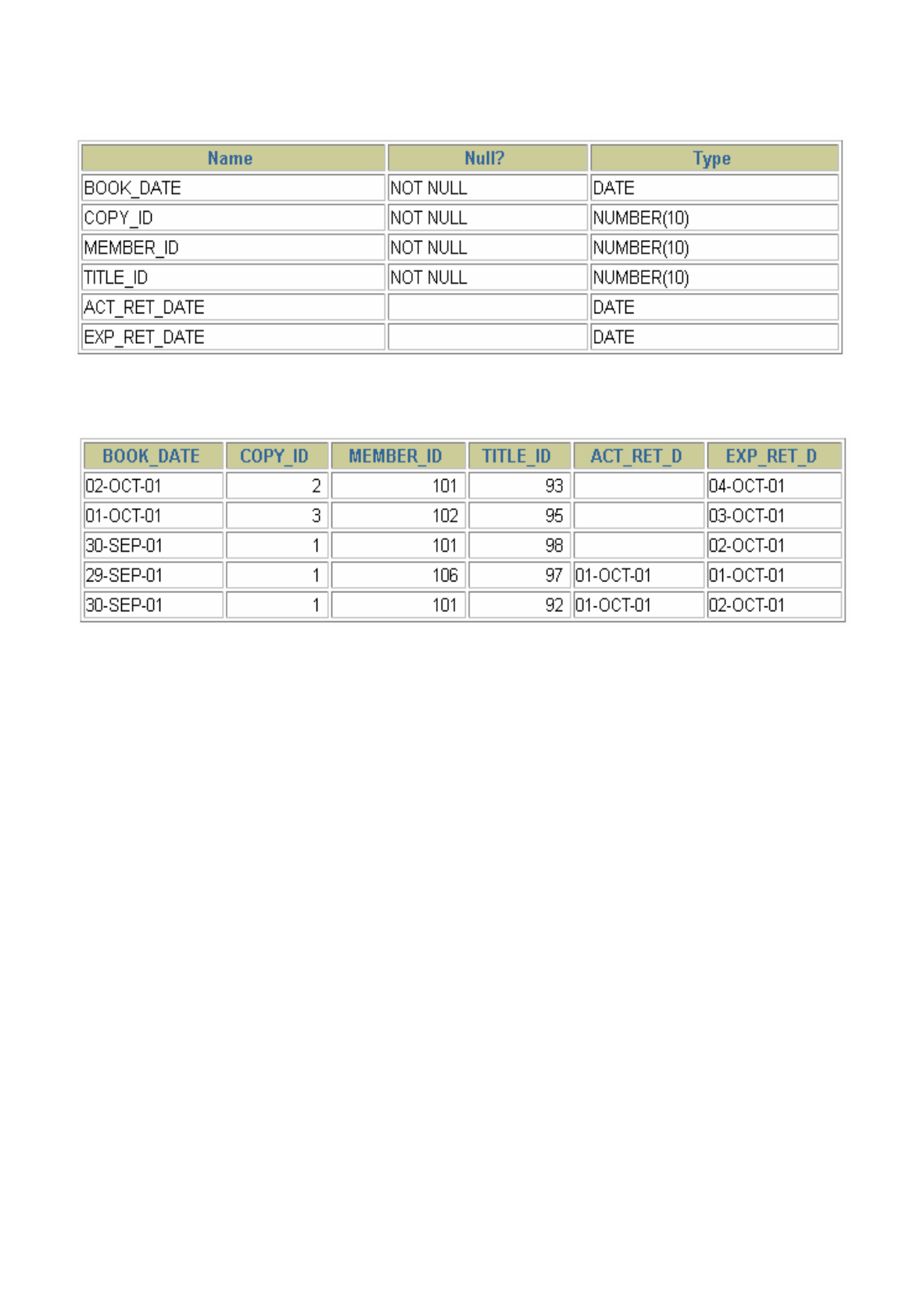
Oracle Database 10g: Develop PL/SQL Program Units Table Description-5
Part B: RENTAL Table
DESCRIBE rental
SELECT * FROM rental;

Oracle Database 10g: Develop PL/SQL Program Units Table Description-6
Part B: RESERVATION Table
DESCRIBE reservation
SELECT * FROM reservation;
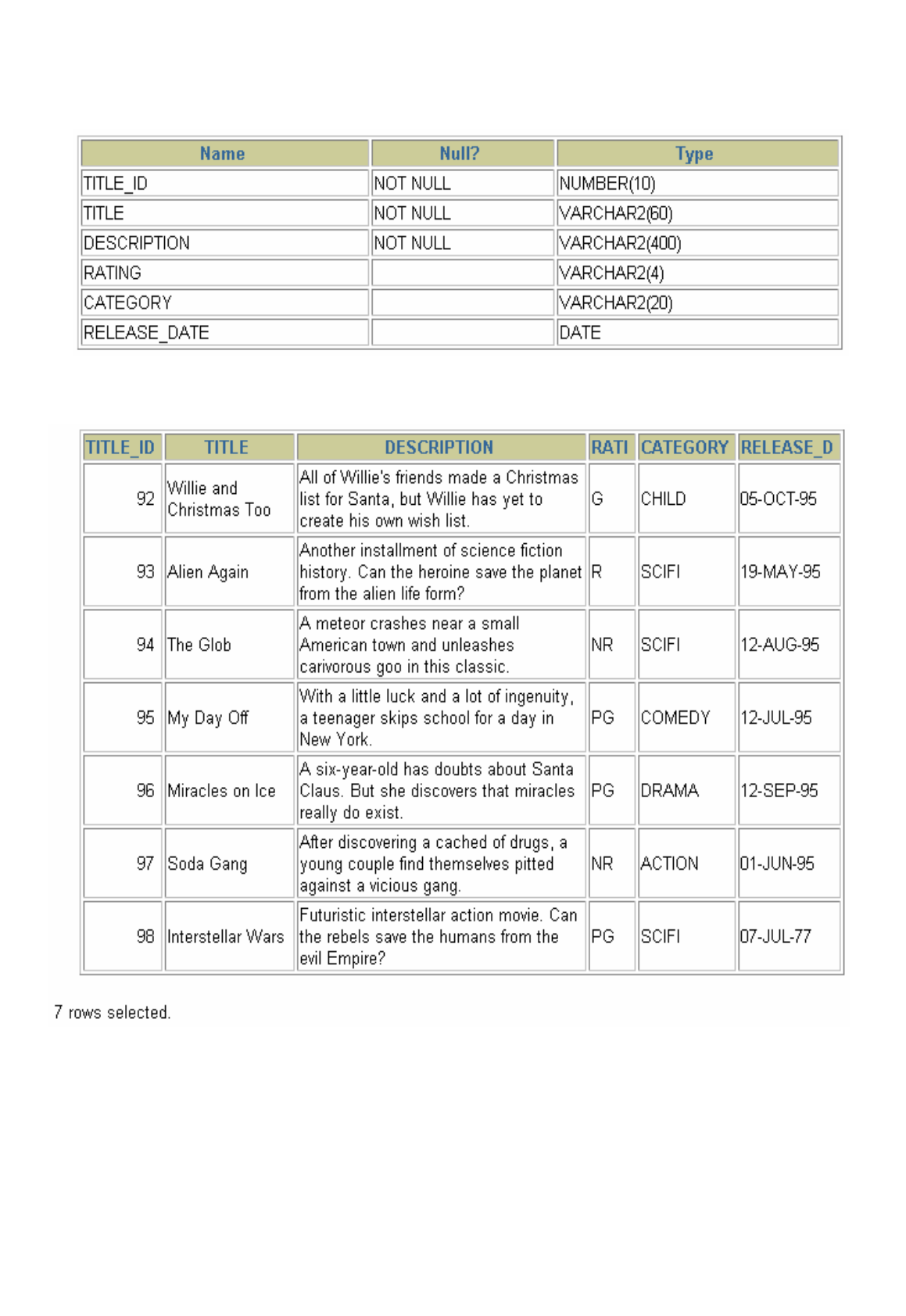
Oracle Database 10g: Develop PL/SQL Program Units Table Description-7
Part B: TITLE Table
DESCRIBE title
SELECT * FROM title;
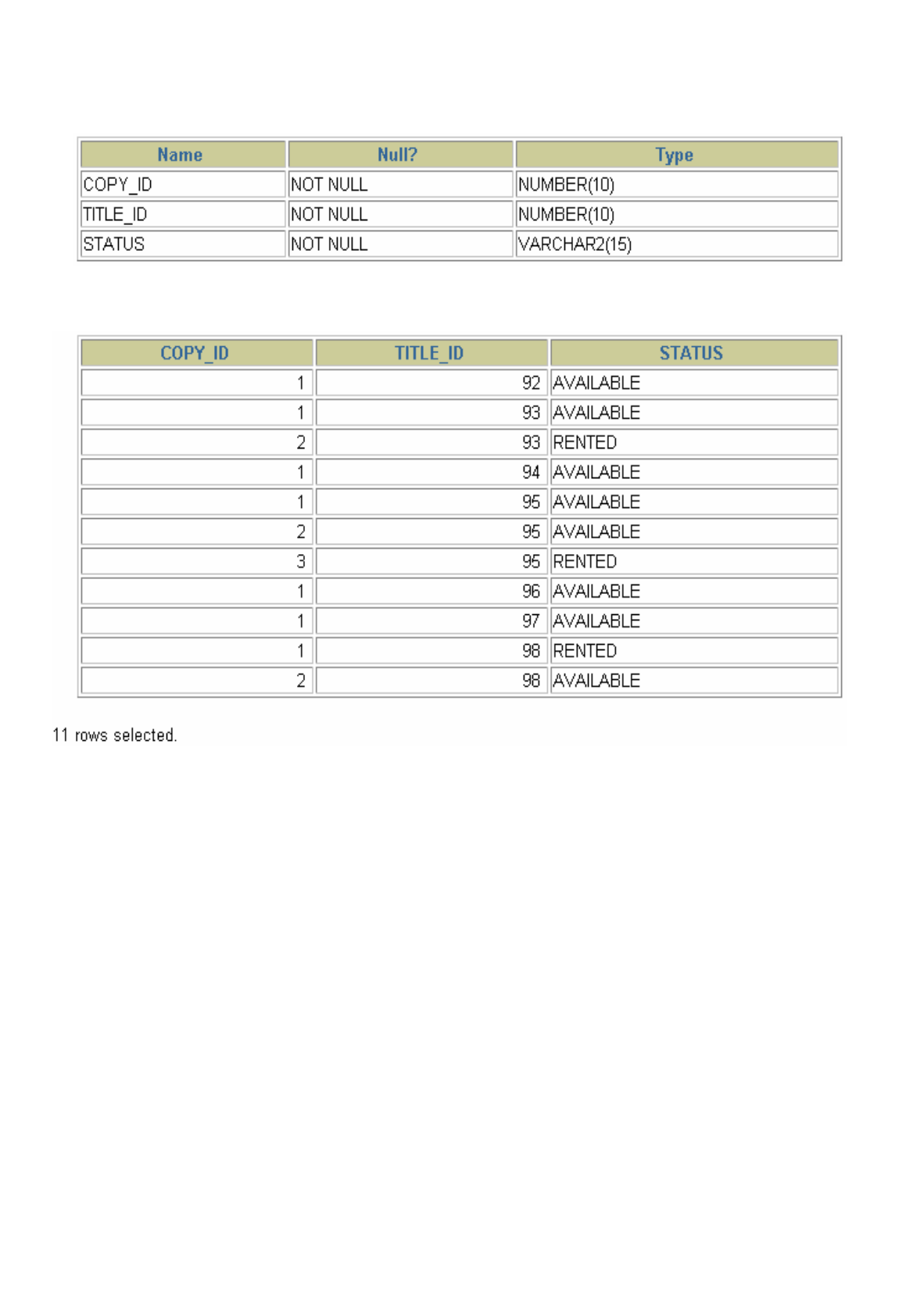
Oracle Database 10g: Develop PL/SQL Program Units Table Description-8
Part B: TITLE_COPY Table
DESCRIBE title_copy
SELECT * FROM title_copy;